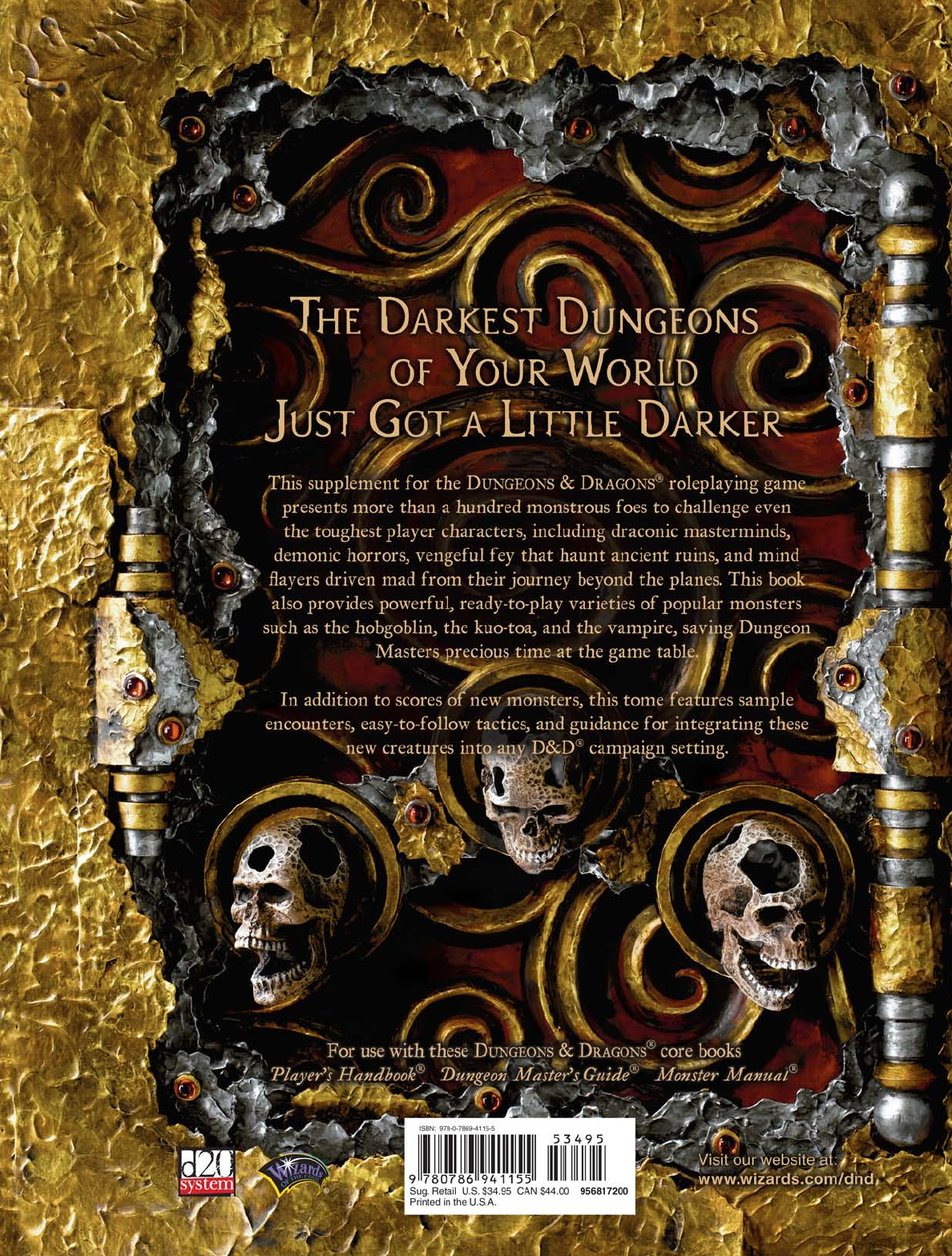Monster Manual V
User Manual:
Open the PDF directly: View PDF ![]() .
.
Page Count: 224 [warning: Documents this large are best viewed by clicking the View PDF Link!]
- Front Cover
- Table of Contents
- Monsters by CR
- Monsters by ECL
- Introduction
- Reading the Entries
- Identification and Encounter
- Defensive Information
- Offensive Information
- Other Information
- Special Ability Descriptions
- Strategies and Tactics
- Sample Encounters
- Ecology
- Lore
- Society
- Sample Lair
- Typical Treasure
- Creatures as Characters
- Creatures with Class Levels
- Advanced Creatures
- For Player Characters
- Creatures in Eberron or Creatures in Faerûn
- Reading the Entries
- Arcadian Avenger
- B
- D
- E
- F
- G
- H
- Illurien
- Jaebrin
- Kuo-toa
- M
- Malastor
- Merchurion
- Mind Flayers of Thoon
- Thoon Disciple
- Shadow Flayer
- Thoon Infiltrator
- Thoon Thrall
- Creating a Thoon Thrall
- Thoon Soldier
- Madcrafter of Thoon
- Scyther of Thoon
- Stormcloud of Thoon
- Thoon Hulk
- Thoon Elder Brain
- Sample Encounters
- Typical Treasure
- Thoon in Eberron
- Thoon in Faerûn
- Sidebar: How Quintessence Works
- Sidebar: Introducing Thoon into Your Game
- Sidebar: Why not a Template?
- Mockery Bugs
- Phantom
- R
- S
- Sanguineous Drinker
- Scouring Construct
- Shaedling
- Shardsoul Slayer
- Siege Beetle
- Skull Lord
- Spawn of Juiblex
- Spirrax
- Steelwing
- T
- Ushemoi
- V
- Wild Hunt
- Monster Feats
- Glossary
- Sidebar: Monsters by Type (and Subtype)
- Back Cover
- Maps:
- Sidebars:
- A - F
- A Battle of Wits
- Adaru Lore
- An Elder Brain at CR 15?
- Arcadian Avenger Lore
- Arkamoi Lore
- Banshrae Lore
- Behind the Curtain: Why Xorvintaal?
- Blackwing Lore
- Bladerager Troll Lore
- Bonespur Lore
- Bridge Haunt Lore
- Burrow Root Lore
- Carnage Demon Lore
- Chorranathau Lore
- Dalmosh Lore
- Deadborn Vulture Lore
- Demonthorn Mandrake Lore
- Designing Madcrafter Encounters
- Draudnu Lore
- Elemental Mage Lore
- Ember Guard Lore
- Ethereal Defiler Lore
- Fetid Fungus Lore
- Force Golem Lore
- Forest Haunt Lore
- Frostwind Virago Lore
- G - L
- Gadacro Lore
- Garngrath Lore
- Gem Scarab Lore
- God-blooded Lore
- Graveyard Sludge Lore
- Greenspawn Zealot Lore
- Gulthir Lore
- Guulvorg Lore
- Hadrimoi Lore
- Hands of the Tirbanas
- Hobgoblin Lore
- How Quintessence Works
- Howling Helm
- Illurien Lore
- Introducing Thoon into Your Game
- Jaebrin Lore
- Kuo-toan Harpoon
- Kuo-toa Lore
- Lashemoi Lore
- M - R
- Madcrafter of Thoon Lore
- Magmacore Golem Lore
- Malastor Lore
- Merchurion Lore
- Mockery Bug Lore
- Monsters by Type (and Subtype)
- Monstrous Humanoid (Goblinoid)
- Morlicantha Lore
- New Condition: Immobilized
- New Feat: Battle Magic Tactics
- New Feat: Brutal Throw
- New Feat: Daunting Presence
- New Feat: Mage Slayer
- New Feat: Sense Quintessence
- New Feats
- New Spell: Earthbind
- PCs as Exarchs
- Phantom Incorporeality
- Phantom Lore
- Remmanon Lore
- Ruin Chanter Lore
- Ruin Elemental Lore
- Rylkar Lore
- S - Z
- Sanguineous Drinker Lore
- Scouring Construct Lore
- Scouring Insects
- Scyther of Thoon Lore
- Serpentir Lore
- Shadow Flayer Lore
- Shaedling Lore
- Shardsoul Slayer Lore
- Siege Beetle Lore
- Singh Lore
- Skull Lord Lore
- Solamith Lore
- Spawn of Juiblex Lore
- Spectral Rider Lore
- Spirrax Lore
- Steelwing Lore
- Stitched Devil Lore
- Stormcloud of Thoon Lore
- Taunting Haunt Lore
- Thoon Disciple Lore
- Thoon Elder Brain Lore
- Thoon Hulk Lore
- Thoon Infiltrator Lore
- Thoon Soldier Lore
- Thoon Thrall Lore
- Thrym Hound Lore
- Tirbana Lore
- Turlemoi Lore
- Tusk Terror Lore
- Vampire Lore
- Verdant Reaver Lore
- Vinespawn Lore
- Vivisector Lore
- Vrakmul?
- Weary Grass
- What is Thoon?
- Why not a Template?
- Wild Hunt Lore
- Xorvintaal Lore
- A - F
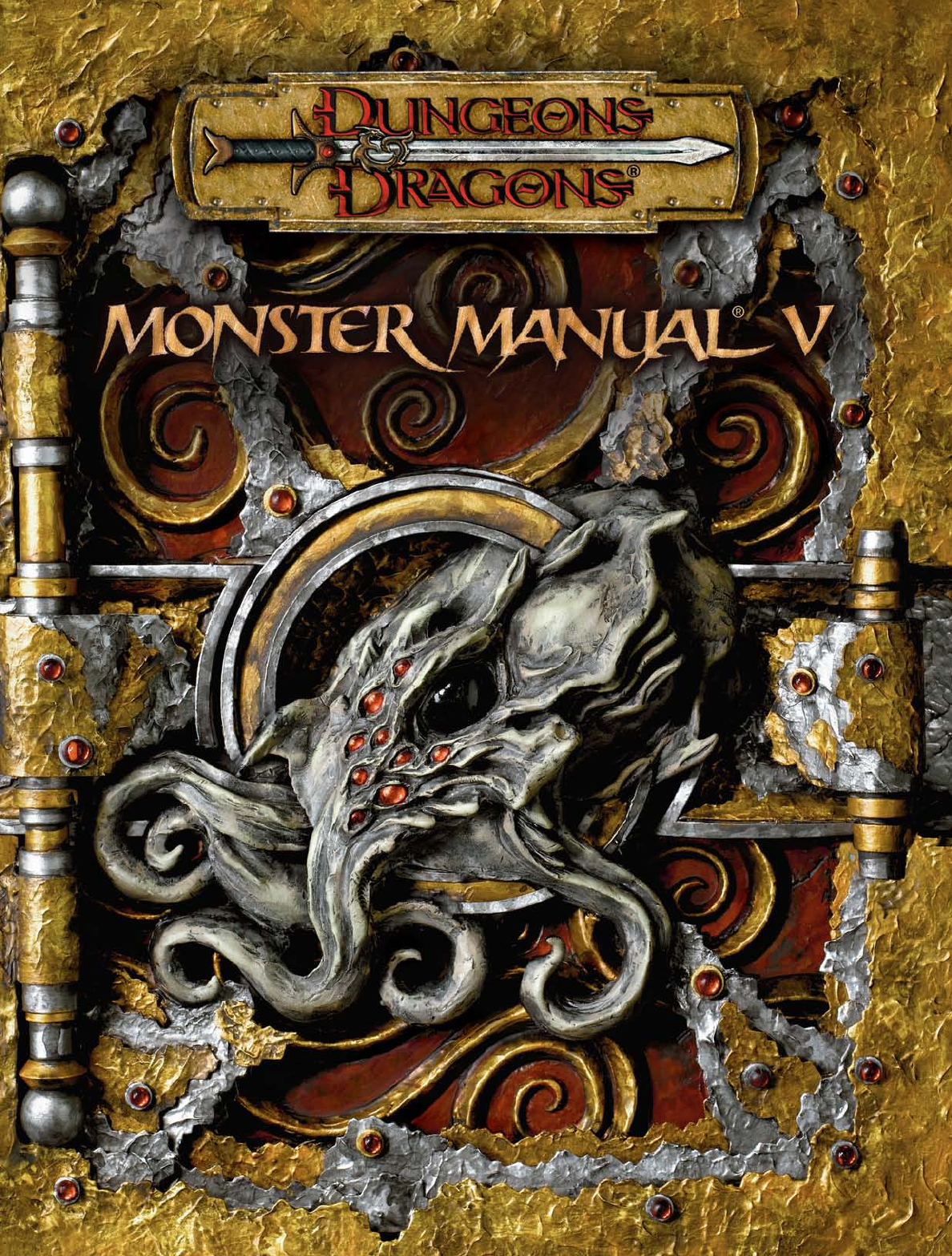
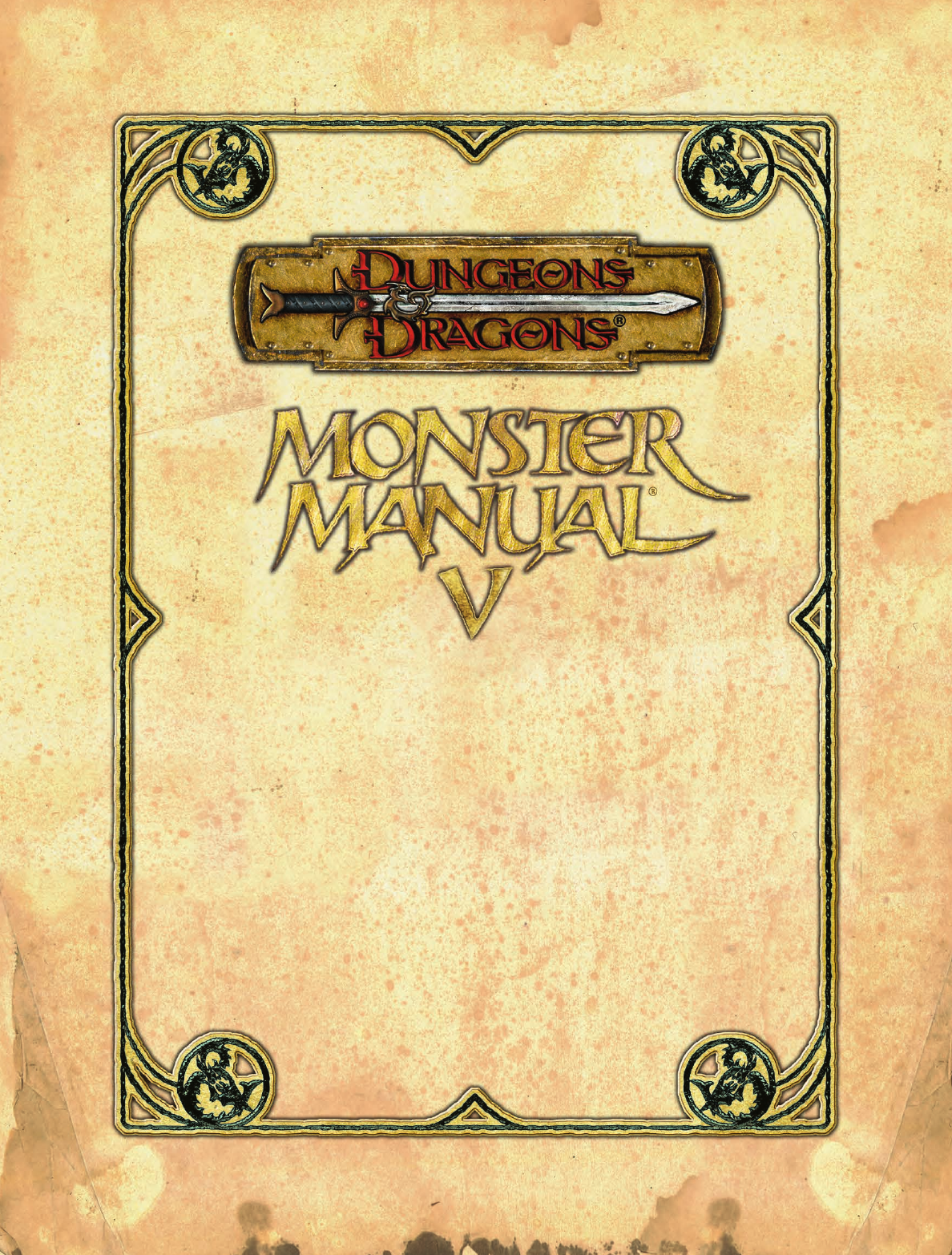
MMV_01.indd 1 4/19/07 2:29:46 PM
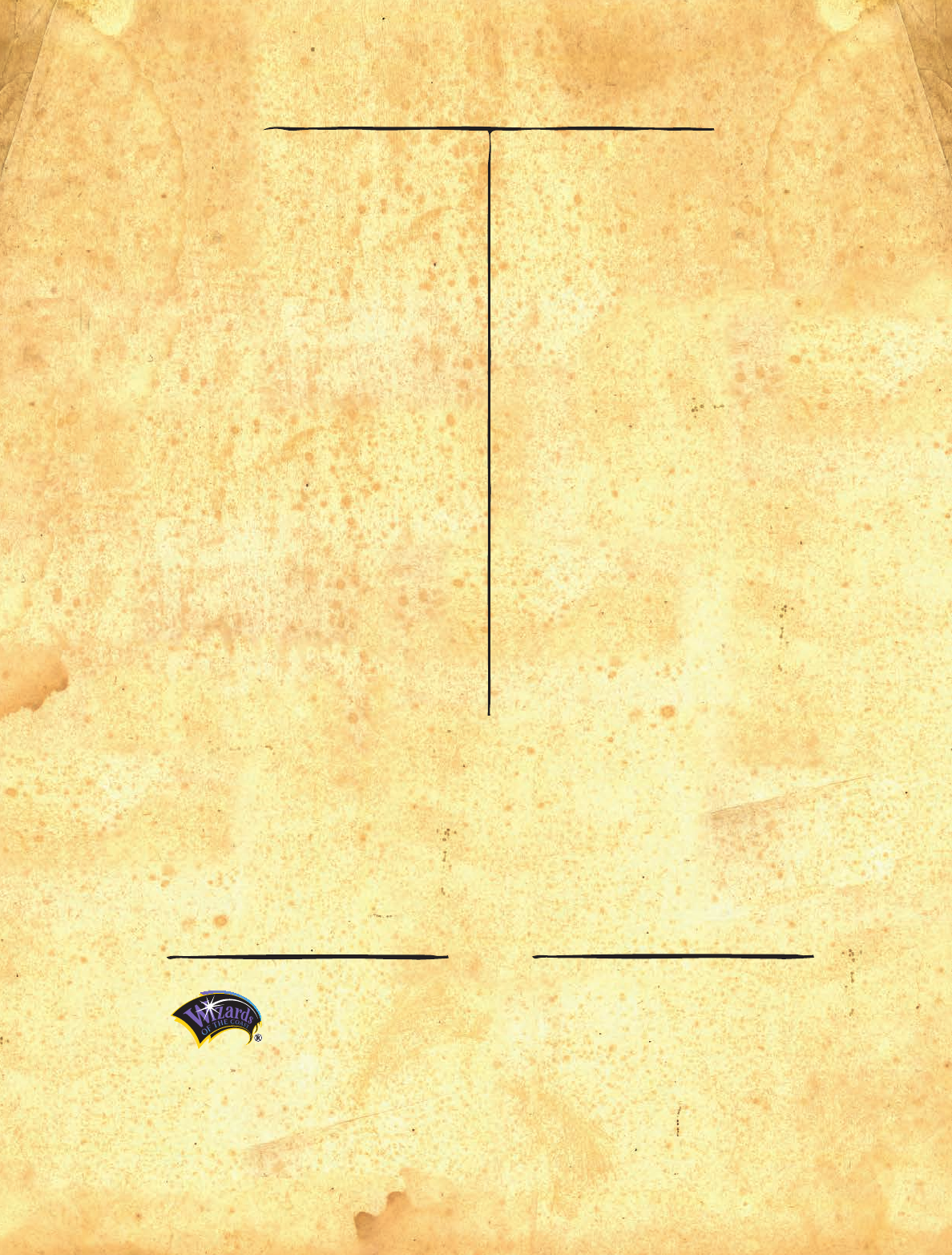
CREDITS
LEAD DESIGNER
DAVID NOONAN
ADDITIONAL DESIGN
CREIGHTON BROADHURST, JASON BULMAHN,
DAVID CHART, B. MATTHEW CONKLIN III,
JESSE DECKER, JAMES “GRIM” DESBOROUGH,
ROB HEINSOO, STERLING HERSHEY,
TIM HITCHCOCK, LUKE JOHNSON,
NICOLAS LOGUE, MIKE MCARTOR,
AARON ROSENBERG, ROBERT J. SCHWALB,
RODNEY THOMPSON, WIL UPCHURCH
DEVELOPMENT TEAM
STEPHEN SCHUBERT, GWENDOLYN F.M. KESTREL,
MIKE MEARLS, MATTHEW SERNETT
EDITORS
CHRIS SIMS, LOGAN BONNER,
SCOTT FITZGERALD GRAY
FREELANCE MANAGER
GWENDOLYN F.M. KESTREL
EDITING MANAGER
KIM MOHAN
DESIGN MANAGER
CHRISTOPHER PERKINS
DEVELOPMENT MANAGER
JESSE DECKER
DIRECTOR OF RPG R&D
BILL SLAVICSEK
SENIOR ART DIRECTOR D&D
STACY LONGSTREET
ART DIRECTOR
KARIN POWELL
COVER ARTIST
HENRY HIGGINBOTHAM
INTERIOR ARTISTS
DAVID ALLSOP, JASON CHAN,
MIGUEL COIMBRA, CARL CRITCHLOW,
DAARKEN, WAYNE ENGLAND, TOMÁS GIORELLO,
RALPH HORSLEY, WARREN MAHY,
IZZY MEDRANO, STEVE PRESCOTT,
WAYNE REYNOLDS, SKAN SRISUWAN,
RON SPEARS, ANNE STOKES, ARNIE SWEKEL,
FRANZ VOHWINKEL, ANTHONY WATERS,
EVA WIDERMANN, JAMES ZHANG
CARTOGRAPHER
JASON ENGLE
GRAPHIC DESIGNER
MICHAEL MARTIN
GRAPHIC PRODUCTION SPECIALISTS
ANGELIKA LOKOTZ, ERIN DORRIES
IMAGE TECHNICIAN
SVEN BOLEN
PRODUCTION MANAGERS
JOSH FISCHER, RANDALL CREWS
Playtesters: Joe Beatty, Curtis Cameron, Tom Castelli, Brandon Crowley, Donna Desborough, Jon Dobbie, Don Early, Andy Glenn, Philip
Greeley, Jason Hale, Mary Hershey, Geoff Hinkle, Christa Hinkle, Carol Hooper, Seth House, James Johnson, Toby Latin-Stoermer,
Andy Lewis, Jason Nilsen, Michael O’Day, Joe Quarles, Joseph Quarles Jr., James Sullivan, Steve Wolbrecht, Neil Wright, Troy Yost
Some information in this book is taken from or derived from “Paragons of War: The Ecology of the Hobgoblin” by Terry Edwards
in Dragon Magazine #309.
Based on the original DUNGEONS & DRAGONS® rules created by E. Gary Gygax and Dave Arneson and the new DUNGEONS & DRAGONS
game designed by Jonathan Tweet, Monte Cook, Skip Williams, Richard Baker, and Peter Adkison.
This product uses updated material from the v.3.5 revision.
This WIZARDS OF THE COAST® game product contains no Open Game Content. No portion of this work may be reproduced in any
form without written permission. To learn more about the Open Gaming License and the d20 System License, please visit www.
wizards.com/d20.
Visit our website at www.wizards.com/dnd
DUNGEONS & DRAGONS, D&D, DUNGEON MASTER, d20, d20 System, WIZARDS OF THE COAST, Player’s Handbook, Dungeon Master’s
Guide, Monster Manual, all other Wizards of the Coast product names, and their respective logos are trademarks of Wizards of the
Coast, Inc., in the U.S.A. and other countries.
This material is protected under the copyright laws of the United States of America. Any reproduction or unauthorized use of the
material or artwork contained herein is prohibited without the express written permission of Wizards of the Coast, Inc.
This product is a work of fiction. Any similarity to actual people, organizations, places, or events is purely coincidental. Printed in
the U.S.A. ©2007 Wizards of the Coast, Inc.
U.S., CANADA, ASIA, PACIFIC,
& LATIN AMERICA
Wizards of the Coast, Inc.
P.O. Box 707
Renton WA 98057-0707
+1-800-324-6496
EUROPEAN HEADQUARTERS
Hasbro UK Ltd
Caswell Way
Newport, Gwent NP9 0YH
GREAT BRITAIN
Please keep this address for your records
WIZARDS OF THE COAST,
BELGIUM
’t Hofveld 6D
1702 Groot-Bijgaarden
Belgium
+32 2 467 3360
620-95681720-001-EN
ISBN: 978-0-7869-4115-5
9 8 7 6 5 4 3 2 1
First Printing: July 2007
MMV_01.indd 2 4/19/07 2:29:50 PM
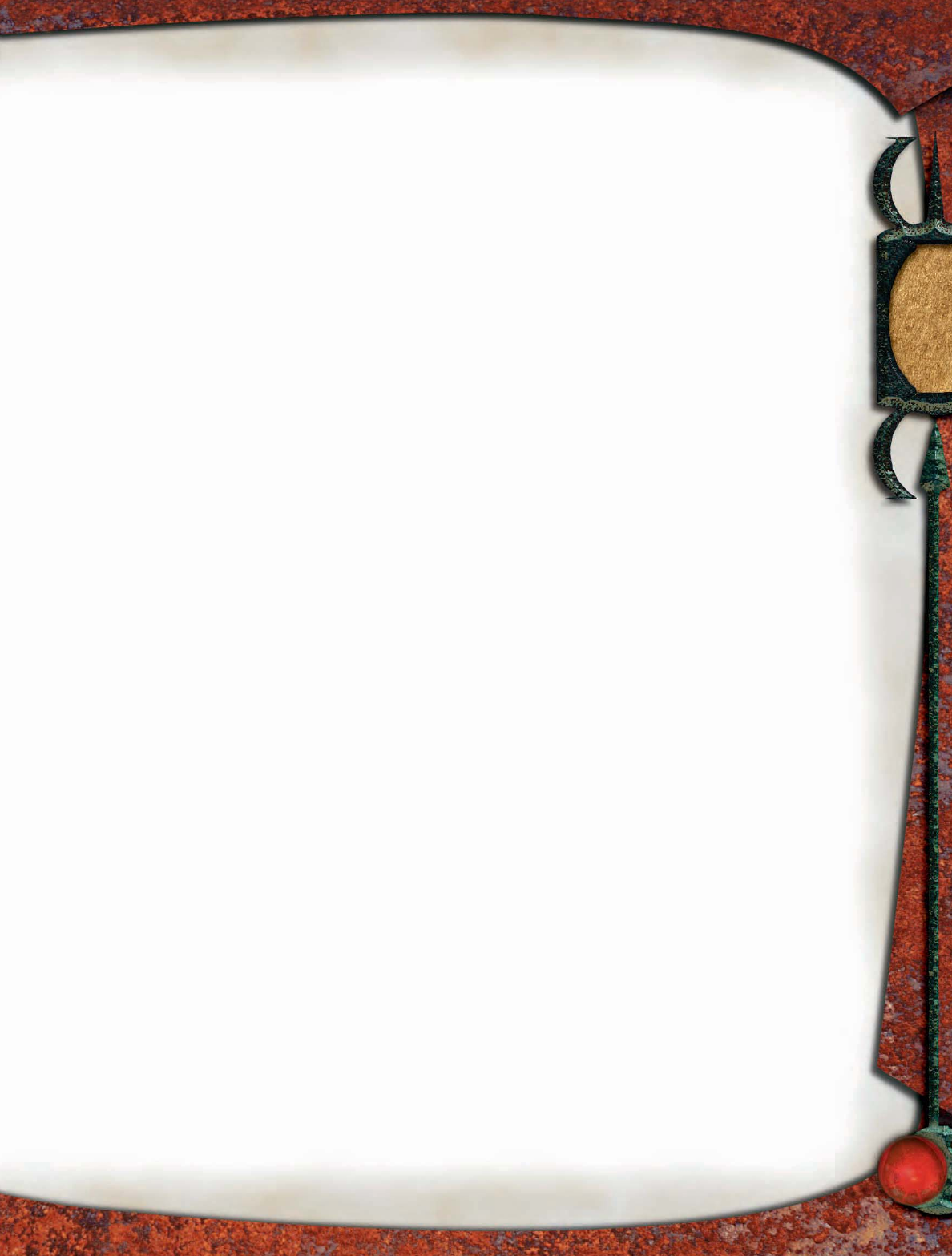
3
TABLE OF
CONTENTS
Contents
Monsters by Challenge Rating . . . . . . . . . . . . .4
Monsters by ECL . . . . . . . . . . . . . . . . . . . . . . . . . . .4
Introduction. . . . . . . . . . . . . . . . . . . . . . . . . . . . . . . .5
Reading the Entries . . . . . . . . . . . . . . . . . . . . . . . .5
The Monsters
Arcadian Avenger . . . . . . . . . . . . . . . . . . . . . . . . . .8
Banshrae . . . . . . . . . . . . . . . . . . . . . . . . . . . . . . . . . .10
Blackwing . . . . . . . . . . . . . . . . . . . . . . . . . . . . . . . .12
Burrow Root . . . . . . . . . . . . . . . . . . . . . . . . . . . . . .14
Dalmosh . . . . . . . . . . . . . . . . . . . . . . . . . . . . . . . . . .16
Deadborn Vulture . . . . . . . . . . . . . . . . . . . . . . . . .18
Deadborn Vulture Zombie . . . . . . . . . . . . . .18
Demon . . . . . . . . . . . . . . . . . . . . . . . . . . . . . . . . . . .20
Adaru . . . . . . . . . . . . . . . . . . . . . . . . . . . . . . . . . .20
Carnage Demon . . . . . . . . . . . . . . . . . . . . . . . .22
Draudnu . . . . . . . . . . . . . . . . . . . . . . . . . . . . . . .24
Gadacro . . . . . . . . . . . . . . . . . . . . . . . . . . . . . . . .26
Solamith . . . . . . . . . . . . . . . . . . . . . . . . . . . . . . .28
Demonthorn Mandrake . . . . . . . . . . . . . . . . . . .30
Devil . . . . . . . . . . . . . . . . . . . . . . . . . . . . . . . . . . . . .32
Gulthir . . . . . . . . . . . . . . . . . . . . . . . . . . . . . . . .32
Remmanon . . . . . . . . . . . . . . . . . . . . . . . . . . . .34
Stitched Devil . . . . . . . . . . . . . . . . . . . . . . . . . .36
Dragons of the Great Game . . . . . . . . . . . . . . . .38
Chorranathau the Inscrutable. . . . . . . . . . .40
Morlicantha . . . . . . . . . . . . . . . . . . . . . . . . . . . .42
Singh the Immense . . . . . . . . . . . . . . . . . . . .45
Elemental Mage . . . . . . . . . . . . . . . . . . . . . . . . . . .48
Ken-Kuni . . . . . . . . . . . . . . . . . . . . . . . . . . . . . .48
Ken-Li . . . . . . . . . . . . . . . . . . . . . . . . . . . . . . . . .48
Ken-Sun . . . . . . . . . . . . . . . . . . . . . . . . . . . . . . .49
Ember Guard . . . . . . . . . . . . . . . . . . . . . . . . . . . . .52
Ethereal Defi ler . . . . . . . . . . . . . . . . . . . . . . . . . . .54
Fetid Fungus . . . . . . . . . . . . . . . . . . . . . . . . . . . . . .56
Frostwind Virago . . . . . . . . . . . . . . . . . . . . . . . . .58
Garngrath . . . . . . . . . . . . . . . . . . . . . . . . . . . . . . . .60
Gem Scarab . . . . . . . . . . . . . . . . . . . . . . . . . . . . . . .62
God-Blooded . . . . . . . . . . . . . . . . . . . . . . . . . . . . . .64
Nozgûg, Gruumsh-Blooded Orc . . . . . . . . .64
Creating God-Blooded Templates . . . . . . .67
Golem . . . . . . . . . . . . . . . . . . . . . . . . . . . . . . . . . . . .68
Force Golem . . . . . . . . . . . . . . . . . . . . . . . . . . .68
Magmacore Golem . . . . . . . . . . . . . . . . . . . . .70
Graveyard Sludge . . . . . . . . . . . . . . . . . . . . . . . . . .72
Greenspawn Zealot . . . . . . . . . . . . . . . . . . . . . . .74
Guulvorg . . . . . . . . . . . . . . . . . . . . . . . . . . . . . . . . .76
Haunt . . . . . . . . . . . . . . . . . . . . . . . . . . . . . . . . . . . .78
Bridge Haunt . . . . . . . . . . . . . . . . . . . . . . . . . .78
Forest Haunt . . . . . . . . . . . . . . . . . . . . . . . . . . .80
Taunting Haunt . . . . . . . . . . . . . . . . . . . . . . . .82
Hobgoblin . . . . . . . . . . . . . . . . . . . . . . . . . . . . . . . .84
Hobgoblin Duskblade . . . . . . . . . . . . . . . . . .84
Hobgoblin Spellscourge . . . . . . . . . . . . . . . .85
Hobgoblin Warcaster . . . . . . . . . . . . . . . . . . .86
Hobgoblin Warsoul . . . . . . . . . . . . . . . . . . . .87
Illurien . . . . . . . . . . . . . . . . . . . . . . . . . . . . . . . . . . .90
Jaebrin . . . . . . . . . . . . . . . . . . . . . . . . . . . . . . . . . . . .92
Kuo-toa . . . . . . . . . . . . . . . . . . . . . . . . . . . . . . . . . . .94
Kuo-toa, Crazed . . . . . . . . . . . . . . . . . . . . . . . .94
Kuo-toa Exalted Whip . . . . . . . . . . . . . . . . . .95
Kuo-toa Harpooner . . . . . . . . . . . . . . . . . . . . .96
Kuo-toa Monitor . . . . . . . . . . . . . . . . . . . . . . .97
Malastor . . . . . . . . . . . . . . . . . . . . . . . . . . . . . . . . 100
Merchurion . . . . . . . . . . . . . . . . . . . . . . . . . . . . . .102
Mind Flayers of Thoon . . . . . . . . . . . . . . . . . . 104
Thoon Disciple . . . . . . . . . . . . . . . . . . . . . . . 104
Shadow Flayer . . . . . . . . . . . . . . . . . . . . . . . . .107
Thoon Infi ltrator . . . . . . . . . . . . . . . . . . . . . 109
Thoon Thrall . . . . . . . . . . . . . . . . . . . . . . . . . .111
Thoon Soldier . . . . . . . . . . . . . . . . . . . . . . . . .113
Madcrafter of Thoon . . . . . . . . . . . . . . . . . .114
Scyther of Thoon . . . . . . . . . . . . . . . . . . . . . .116
Stormcloud of Thoon . . . . . . . . . . . . . . . . . .118
Thoon Hulk . . . . . . . . . . . . . . . . . . . . . . . . . . 120
Thoon Elder Brain . . . . . . . . . . . . . . . . . . . . 121
Mockery Bug . . . . . . . . . . . . . . . . . . . . . . . . . . . 126
Mockery Monarch . . . . . . . . . . . . . . . . . . . 126
Mockery Drone . . . . . . . . . . . . . . . . . . . . . . 127
Phantom . . . . . . . . . . . . . . . . . . . . . . . . . . . . . . . . 130
Kugan, Phantom Ghast Ninja . . . . . . . . . 130
Ruin Chanter . . . . . . . . . . . . . . . . . . . . . . . . . . . .132
Ruin Elemental . . . . . . . . . . . . . . . . . . . . . . . . . 134
Rylkar . . . . . . . . . . . . . . . . . . . . . . . . . . . . . . . . . . 136
Rylkar Harridan . . . . . . . . . . . . . . . . . . . . . . 136
Rylkar Madclaw . . . . . . . . . . . . . . . . . . . . . . 137
Rylkar Tormentor . . . . . . . . . . . . . . . . . . . . 138
Rylkspawn Swarm . . . . . . . . . . . . . . . . . . . . 138
Sanguineous Drinker . . . . . . . . . . . . . . . . . . . .142
Scouring Construct . . . . . . . . . . . . . . . . . . . . . 144
Scouring Slinger . . . . . . . . . . . . . . . . . . . . . 144
Slinger Scorpion . . . . . . . . . . . . . . . . . . . . . .145
Scouring Stanchion . . . . . . . . . . . . . . . . . . .145
Shaedling . . . . . . . . . . . . . . . . . . . . . . . . . . . . . . . .148
Shardsoul Slayer . . . . . . . . . . . . . . . . . . . . . . . . 150
Siege Beetle . . . . . . . . . . . . . . . . . . . . . . . . . . . . . 152
Skull Lord . . . . . . . . . . . . . . . . . . . . . . . . . . . . . . 154
Skull Lord . . . . . . . . . . . . . . . . . . . . . . . . . . . 154
Bonespur . . . . . . . . . . . . . . . . . . . . . . . . . . . . 156
Serpentir. . . . . . . . . . . . . . . . . . . . . . . . . . . . . 158
Spectral Rider . . . . . . . . . . . . . . . . . . . . . . . . 160
Spawn of Juiblex . . . . . . . . . . . . . . . . . . . . . . . . .162
Lesser Spawn of Juiblex . . . . . . . . . . . . . . . .162
Greater Spawn of Juiblex . . . . . . . . . . . . . . .163
Elder Spawn of Juiblex . . . . . . . . . . . . . . . . 164
Spirrax . . . . . . . . . . . . . . . . . . . . . . . . . . . . . . . . . .166
Steelwing . . . . . . . . . . . . . . . . . . . . . . . . . . . . . . . .168
Thrym Hound . . . . . . . . . . . . . . . . . . . . . . . . . . 170
Tirbana . . . . . . . . . . . . . . . . . . . . . . . . . . . . . . . . . 172
Tirbana Eyewing . . . . . . . . . . . . . . . . . . . . . 172
Tirbana Drowser . . . . . . . . . . . . . . . . . . . . . 173
Tirbana Slayer . . . . . . . . . . . . . . . . . . . . . . . . 173
Tirbana Spawner . . . . . . . . . . . . . . . . . . . . . .174
Troll, Bladerager . . . . . . . . . . . . . . . . . . . . . . . . 180
Tusk Terror . . . . . . . . . . . . . . . . . . . . . . . . . . . . . .182
Ushemoi . . . . . . . . . . . . . . . . . . . . . . . . . . . . . . . . 184
Arkamoi . . . . . . . . . . . . . . . . . . . . . . . . . . . . . 184
Hadrimoi . . . . . . . . . . . . . . . . . . . . . . . . . . . . .185
Lashemoi . . . . . . . . . . . . . . . . . . . . . . . . . . . . 186
Turlemoi . . . . . . . . . . . . . . . . . . . . . . . . . . . . . 188
Vampire . . . . . . . . . . . . . . . . . . . . . . . . . . . . . . . . 190
The Black Duke . . . . . . . . . . . . . . . . . . . . . . 190
The Red Widow . . . . . . . . . . . . . . . . . . . . . . 193
Verdant Reaver . . . . . . . . . . . . . . . . . . . . . . . . . . 196
Vinespawn . . . . . . . . . . . . . . . . . . . . . . . . . . . . . . 198
Vivisector . . . . . . . . . . . . . . . . . . . . . . . . . . . . . . . 200
Wild Hunt . . . . . . . . . . . . . . . . . . . . . . . . . . . . . . 202
Master of the Hunt . . . . . . . . . . . . . . . . . . . 202
Hound of the Hunt . . . . . . . . . . . . . . . . . . . 202
Monster Feats. . . . . . . . . . . . . . . . . . . . . . . . . . . . 204
Glossary . . . . . . . . . . . . . . . . . . . . . . . . . . . . . . . . . 206
Monsters by Type (and Subtype) . . . . . . . . . 222
Feats
Battle Magic Tactics . . . . . . . . . . . . . . . . . . . . . . .84
Brutal Throw . . . . . . . . . . . . . . . . . . . . . . . . . . . 134
Daunting Presence . . . . . . . . . . . . . . . . . . . . . . . .80
Kuo-Toan Monasticism . . . . . . . . . . . . . . . . . . . .97
Mage Slayer . . . . . . . . . . . . . . . . . . . . . . . . . . . . . . .85
Mind-Shattering Strike . . . . . . . . . . . . . . . . . . .97
Sense Quintessence . . . . . . . . . . . . . . . . . . . . . .110
Spell
Earthbind . . . . . . . . . . . . . . . . . . . . . . . . . . . . . . . . .26
Templates
God-Blooded . . . . . . . . . . . . . . . . . . . . . . . . . . . . . .65
Gruumsh-Blooded . . . . . . . . . . . . . . . . . . . . . . . .65
Imix-Blooded . . . . . . . . . . . . . . . . . . . . . . . . . . . . .65
Kord-Blooded . . . . . . . . . . . . . . . . . . . . . . . . . . . . .66
Orcus-Blooded . . . . . . . . . . . . . . . . . . . . . . . . . . . .66
Phantom . . . . . . . . . . . . . . . . . . . . . . . . . . . . . . . . 130
Thoon Thrall . . . . . . . . . . . . . . . . . . . . . . . . . . . . .112
Vecna-Blooded . . . . . . . . . . . . . . . . . . . . . . . . . . . .66
Yeenoghu-Blooded . . . . . . . . . . . . . . . . . . . . . . . .67
Xorvintaal Dragon . . . . . . . . . . . . . . . . . . . . . . . .43
Xorvintaal Exarch . . . . . . . . . . . . . . . . . . . . . . . . .47
For Player Characters
Creatable Creatures
Blackwing (create undead) . . . . . . . . . . . . . . . . . .13
Bonespur (create undead) . . . . . . . . . . . . . . . . . 156
Force Golem (construct) . . . . . . . . . . . . . . . . . . .69
Magmacore Golem (construct) . . . . . . . . . . . . .71
Sanguineous Drinker (create undead) . . . . . .143
Scouring Slinger (construct) . . . . . . . . . . . . . .147
Scouring Stanchion (construct) . . . . . . . . . . .147
Serpentir (create undead) . . . . . . . . . . . . . . . . . 159
Shardsoul Slayer (construct) . . . . . . . . . . . . . .151
Spectral Rider (create greater undead) . . . . . . .161
Mounts/Companion Creatures
Blackwing . . . . . . . . . . . . . . . . . . . . . . . . . . . . . . . .13
Deadborn Vulture . . . . . . . . . . . . . . . . . . . . . . . . .19
Gem Scarab (Improved Familiar) . . . . . . . . . .63
Steelwing . . . . . . . . . . . . . . . . . . . . . . . . . . . . . . . .169
Tirbana Eyewing (Improved Familiar) . . . 172
Race
Jaebrin . . . . . . . . . . . . . . . . . . . . . . . . . . . . . . . . . . . .93
Summonable Creatures
Arcadian Avenger (IV) 1 . . . . . . . . . . . . . . . . . . . .9
Demon, Adaru (IX) 1 . . . . . . . . . . . . . . . . . . . . . . .22
Demon, Carnage (IV) 1 . . . . . . . . . . . . . . . . . . . . .24
Demon, Gadacro (IV) 1 . . . . . . . . . . . . . . . . . . . . .28
Demon, Solamith (VII) 1 . . . . . . . . . . . . . . . . . . .29
Devil, Gulthir (VI) 1 . . . . . . . . . . . . . . . . . . . . . . .33
Fetid Fungus (II) 2 . . . . . . . . . . . . . . . . . . . . . . . . .57
1 Requires a summon monster spell.
2 Requires a summon monster or summon
nature’s ally spell.
Items
Kuo-Toan Harpoon . . . . . . . . . . . . . . . . . . . . . . . .96
Razorfeather Ammuntion . . . . . . . . . . . . . . . .169
Siege Chitin Armor . . . . . . . . . . . . . . . . . . . . . 153
Howling Helm . . . . . . . . . . . . . . . . . . . . . . . . . . 191
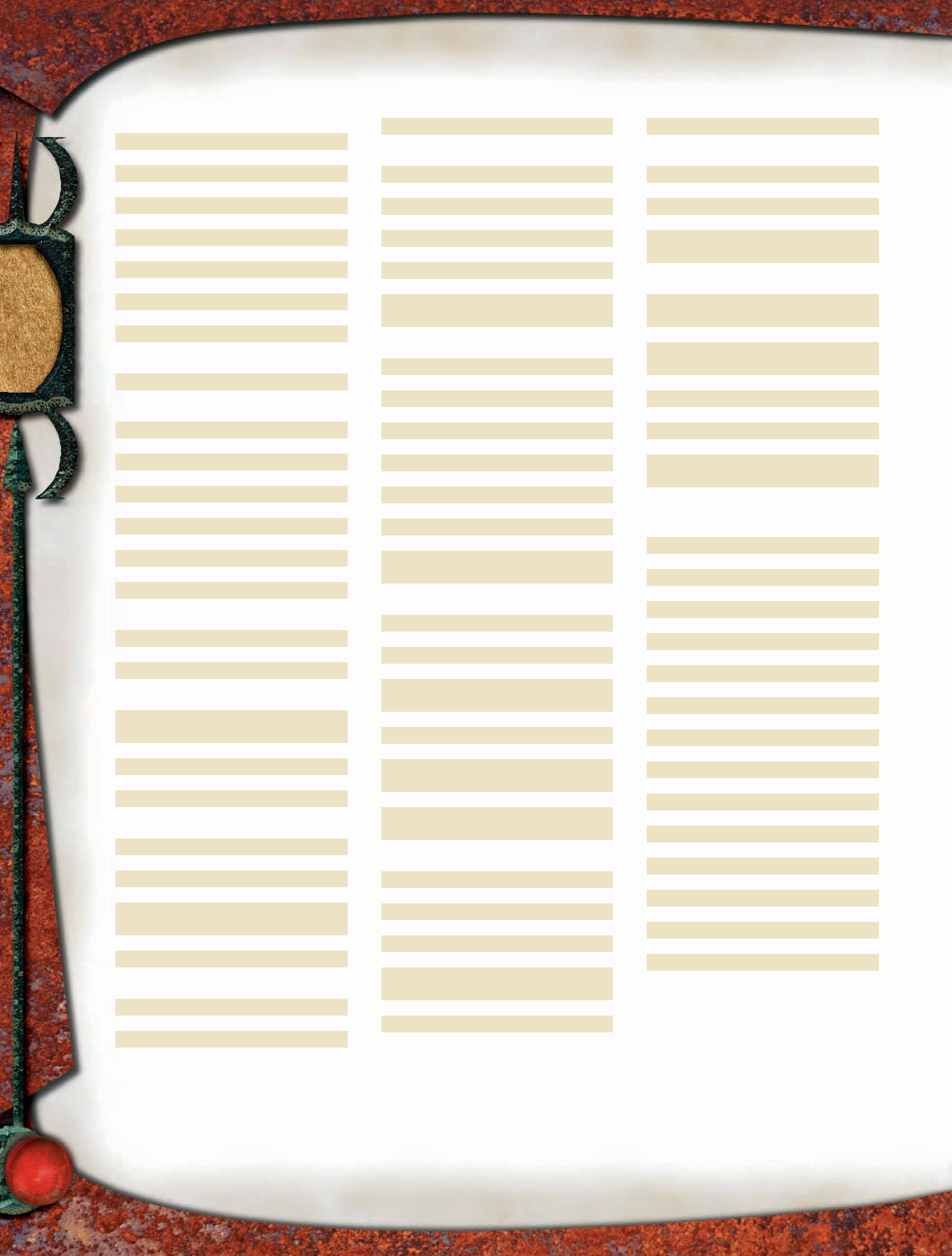
MONSTER
TABLES
4
MONSTERS BY CR
Monster CR
Tirbana eyewing 1/2
Fetid fungus 1
Jaebrin 1
Ushemoi, lashemoi 1
Gem scarab 2
Shaedling 2
Tirbana drowser 2
Demon, gadacro 3
Hobgoblin duskblade 3
Kuo-toa, crazed 3
Mind Flayer of Thoon,
Thoon thrall 3
Rylkar madclaw 3
Skull lord, bonespur 3
Demon, carnage 4
Golem, force 4
Golem, magmacore 4
Graveyard sludge 4
Haunt, taunting 4
Hobgoblin warcaster 4
Kuo-toa harpooner 4
Rylkspawn swarm 4
Skull lord, serpentir 4
Tirbana slayer 4
Ushemoi, arkamoi 4
Vivisector 4
Demonthorn mandrake 5
Greenspawn zealot 5
Hobgoblin spellscourge 5
Mind Flayer of Thoon,
Thoon infi ltrator 5
Mind Flayer of Thoon,
stormcloud of Thoon 5
Sanguineous drinker 5
Shardsoul slayer 5
Tirbana spawner 5
Ushemoi, hadrimoi 5
Verdant reaver 5
Arcadian avenger 6
Deadborn vulture zombie 6
Devil, gulthir 6
Kuo-toa monitor 6
Mind Flayer of Thoon,
scyther of Thoon 6
Rylkar tormentor 6
Skull lord, spectral rider 6
Spawn of Juiblex, lesser 6
Haunt, bridge 7
Kugan, phantom ghast ninja 7
Kuo-toa exalted whip 7
Monster CR
Skull lord 7
Vinespawn 7
Banshrae 8
Blackwing 8
Burrow root 8
Deadborn vulture 8
Demon, solamith 8
Elemental magi, ken-kuni 8
God-blooded, Nozgûg 8
Hobgoblin warsoul 8
Mind Flayer of Thoon,
shadow flayer 8
Mind Flayer of Thoon,
Thoon soldier 8
Troll, bladerager 8
Tusk terror 8
Ushemoi, turlemoi 8
Devil, stitched 9
Mockery bug, mockery drone 9
Rylkar harridan 9
Demon, adaru 10
Demon, draudnu 10
Elemental magi, ken-li 10
Haunt, forest 10
Mind Flayer of Thoon,
madcrafter of Thoon 10
Mind Flayer of Thoon,
Thoon disciple 10
Ruin elemental 10
Spawn of Juiblex, greater 10
Thrym hound 10
Dragons of the great game,
Morlicantha 13
Elemental magi, ken-sun 13
Ember guard 13
Guulvorg 13
Mind Flayer of Thoon,
Thoon hulk 13
Dragons of the great game,
Singh the Immense 14
Mockery bug,
mockery monarch 14
Ruin chanter 14
Spawn of Juiblex, elder 14
Steelwing 14
Devil, remmanon 15
Illurien 15
Mind Flayer of Thoon,
Thoon elder brain 15
Ethereal defiler 16
Frostwind virago 16
Monster CR
Malastor 16
Siege beetle 16
Dalmosh 17
Merchurion 17
Vampire, Red Widow 17
Dragons of the great game,
Chorranathau 18
Scouring construct,
scouring slinger 18
Scouring construct,
scouring stanchion 18
Spirrax 18
Wild hunt,
hound of the hunt 18
Vampire, Black Duke 19
Garngrath 20
Wild Hunt,
master of the hunt 22
MONSTERS BY ECL
Monster HD LA ECL
Arcadian avenger 8 2 10
Banshrae 15 4 19
Elemental magi:
Ken-kuni 8 5 13
Ken-li 12 5 17
Ken-sun 17 5 22
Ethereal defiler 22 4 26
Greenspawn zealot 6 2 8
Hobgoblin:
Duskblade 3 1 4
Spellscourge 5 2 7
Warcaster 4 3 7
Warsoul 10 4 14
Jaebrin 1 1 2
Kuo-toa:
Crazed 4 3 7
Exalted whip 10 4 14
Harpooner 4 3 7
Monitor 6 3 9
Nozgûg 7 1 8
Shaedling 4 3 7
Singh the Immense 13 2 15
Troll, bladerager 6 5 11
Ushemoi:
Arkamoi 4 4 8
Hadrimoi 9 4 13
Lashemoi 2 2 4
Turlemoi 12 4 16
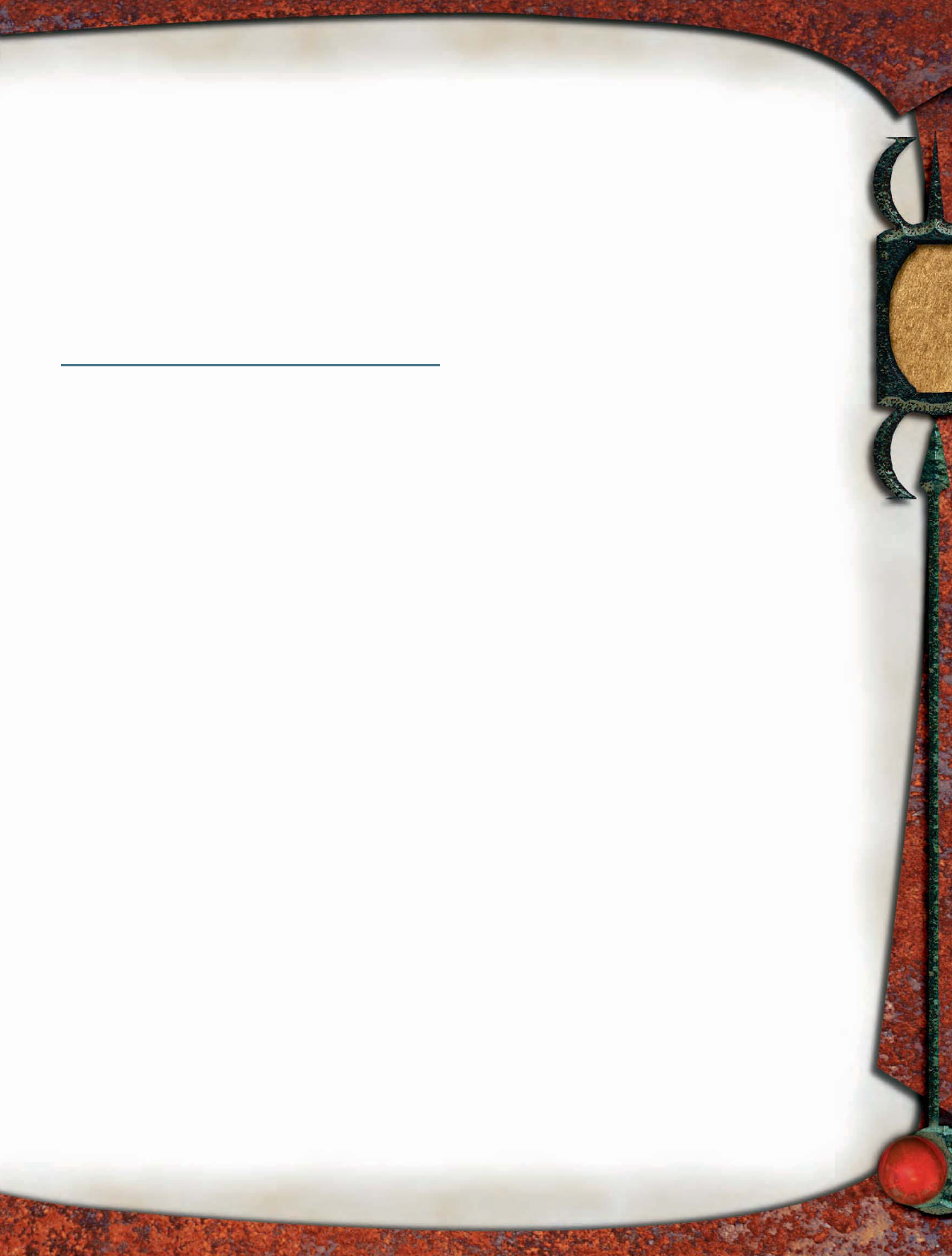
5
INTRODUCTION
Introduction
Welcome to Monster Manual V. This book contains new
creatures for use in the DUNGEONS & DRAGONS® game. The
monster entries are generally alphabetical by name, but
closely related monsters are grouped together under a single
heading. In addition to the table of contents at the front of
this book, monsters are listed by type and subtype on page
222, and by Challenge Rating and ECL on page 4.
This introduction explains how to read each creature’s
entry. Refer to the glossary on pages 206–222 for defi nitions
of terms you are not familiar with.
READING THE ENTRIES
Each monster entry is organized in the same format,
as outlined below. For complete information about the
characteristics of monsters, consult the glossary of this
book, the Player’s Handbook (PH), or the Dungeon Master’s
Guide (DMG).
We want this book to be as useful to DMs as possible, so the
statistics are presented in a format that makes them easier to
use right off the page. This format is divided into fi ve sections
separated by horizontal lines. Each section serves a specifi c
purpose; you need to reference different sections at different
times during an encounter.
IDENTIFICATION AND ENCOUNTER
The top section identifi es the creature and gives the informa-
tion you need at the start of an encounter.
Name: This word or phrase identifi es the creature.
CR: This value is the Challenge Rating of an individual
creature of this kind.
Race, Class, and Level: This information is provided only
for creatures that have class levels.
Alignment: The one- or two-letter abbreviation that
appears here denotes the creature’s alignment. A term that
describes how likely this alignment is to apply, as defi ned
in the glossary, might also appear here. Specifi c NPCs don’t
include the extra term.
Size and Type: The creature’s size category and its type
(and subtype or subtypes, if applicable) are given here.
Init: This value is the creature’s modifi er on initiative
checks.
Senses: The Senses entry indicates whether the creature
has darkvision, low-light vision, scent, or some other sen-
sory special quality, along with the creature’s modifiers on
Listen and Spot checks (even if the creature has no ranks
in those skills).
Aura: This indicates special abilities that take effect
anytime another creature comes within a certain distance,
such as a devil’s fear aura.
Languages: This entry gives the languages the creature
speaks or understands, as well as any special abilities relat-
ing to communication (such as telepathy or an inability
to speak).
DEFENSIVE INFORMATION
This section provides the information you need when char-
acters are attacking the creature.
AC: This entry gives the creature’s Armor Class against
most attacks, followed by its AC against touch attacks and its
AC when fl at-footed. If the creature has feats or other abilities
that modify its Armor Class under specifi c circumstances
(such as the Mobility feat), they are noted here.
hp: This entry consists of the creature’s full normal hit
point total (usually average rolls on each Hit Die), followed
by the creature’s Hit Dice in parentheses. If the creature has
fast healing, regeneration, damage reduction (DR), or some
other ability that affects the amount of damage it takes or
the rate at which it regains hit points, that information also
appears here.
Immune: Any immunities the creature has are indicated
here. This includes immunity to specifi c types of energy as
well as other immunities (such as immunity to poison or to
sleep effects).
Resist and SR: If the creature has resistance to certain
kinds of attacks, that information is given here. The creature’s
spell resistance, if any, appears after the other resistances on
the same line.
Fort, Ref, Will: This entry gives the creature’s saving
throw modifi ers. Altered saving throw bonuses for specifi c
circumstances also appear on this line.
Weakness: This entry details any weaknesses or vul-
nerabilities the creature has, such as light sensitivity or
vulnerability to a type of energy.
OFFENSIVE INFORMATION
Refer to this section when it’s the creature’s turn to act in
combat. All a creature’s combat options are detailed here,
even those that are not strictly offensive.
Speed: This entry begins with the creature’s base land
speed in feet and in squares on the battle grid, followed by
speeds for other modes of movement, if applicable.
Melee/Ranged: Typically, these entries give all the
physical attacks the creature can make when taking a full
attack action. The fi rst attack described is the creature’s
preferred form of attack, usually a melee attack of some sort
but possibly (as in the example below) a ranged attack. If the
creature can make only a single attack (for instance, when
it is taking an attack action), use the fi rst indicated attack
bonus. Occasionally, a creature has separate options indicated
for single attacks and for full attacks. For example, a Small
creature with the Manyshot and Rapid Shot feats might have
the following entries:
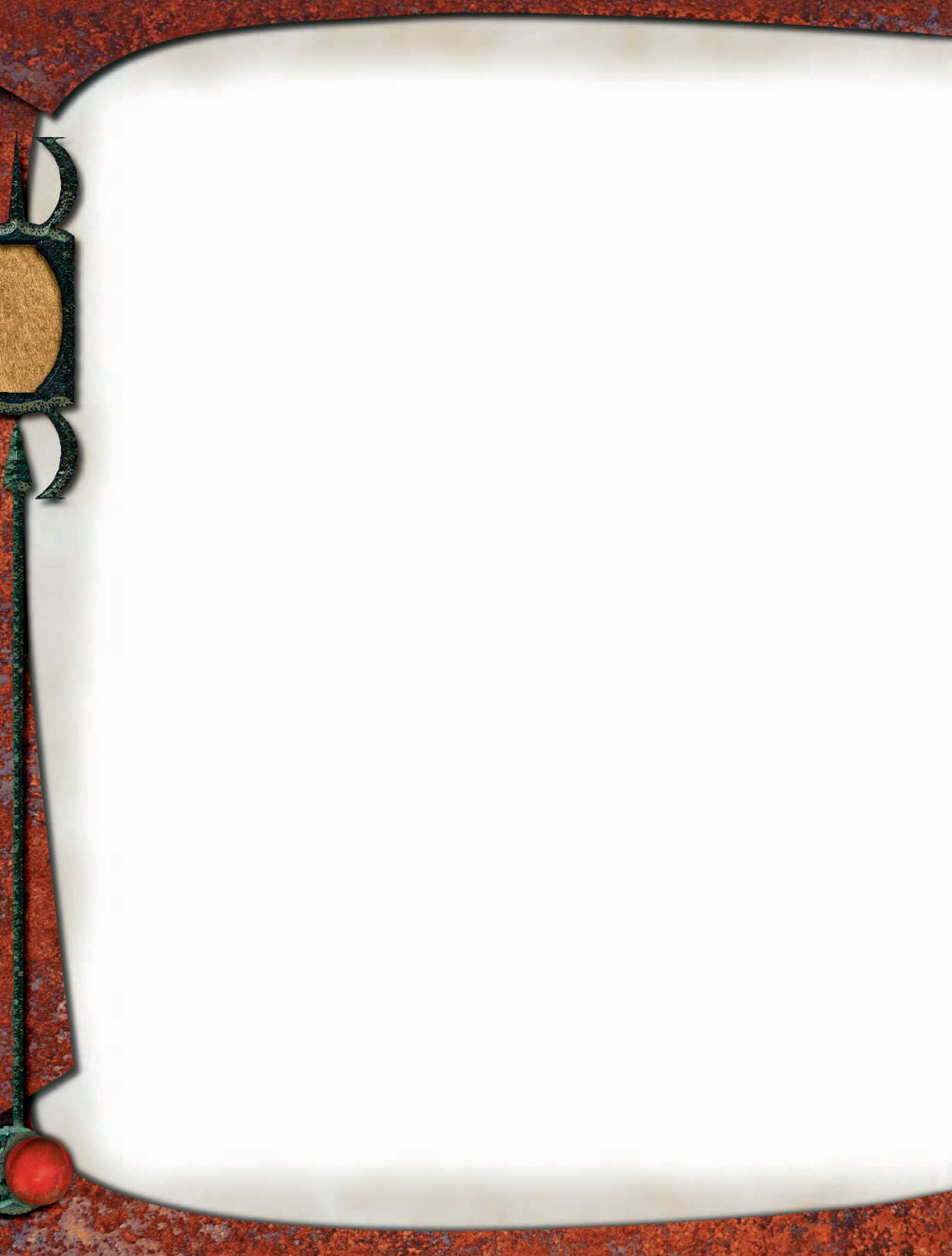
6
INTRODUCTION
Melee masterwork longsword +8/+3 (1d6/19–20)
Ranged +1 longbow +8 (2d6+2/×3) with Manyshot or
Ranged +1 longbow +10/+10/+5 (1d6+1/×3) with Rapid Shot
Each set of attack routines is prefaced by a boldface word
indicating whether the attacks are melee or ranged. Next
comes the weapon used for the attack, the modifi ed attack
bonus, the amount of damage the attack deals, and informa-
tion about critical hits. If the weapon has the “default” critical
hit characteristics (threat on a 20 and ×2 damage), this portion
of the entry is omitted.
Space and Reach: These entries defi ne how large an area
the creature takes up on the battle grid, as well as how far
a creature’s natural reach extends and any reach weapons it
might use.
Base Atk: The Base Atk entry gives the creature’s base
attack bonus without any modifi ers.
Grp: This entry gives the creature’s grapple modifi er.
Atk Options: Special abilities that the creature can employ
to modify its normal attacks appear here. Such abilities might
include feats such as Power Attack or special abilities such
as smite evil.
Special Actions: This entry gives any special actions
that the creature can take on its turn in place of making
attacks.
Combat Gear: Possessions that the creature can use
an action to employ on its turn appear here. Such items
might include doses of poison (applied poisons, not natural
ones), scrolls, potions, oils, wands, staffs, rods, and other
wondrous items.
Spells Known or Spells Prepared: This entry appears
for spellcasters. It occurs as “spells known” for sorcerers
and members of other classes who do not prepare spells,
and “spells prepared” for wizards, clerics, and others who
do prepare them in advance. It begins with the creature’s
caster level for spells. If a creature’s rolls to overcome spell
resistance are based on a number other than its caster
level (because of the Spell Penetration feat, for example),
the creature’s total modifier is given after the expression
“spell pen.” Spells known are detailed from highest level
to 0 level, and each includes an attack bonus and a saving
throw DC, if appropriate. If the character casts some spells
at a different caster level than others, that information is
also specified here.
A cleric’s statistics block also includes the name of his deity
(if applicable) and the domains to which he has access. Each
domain spell he has prepared is marked with a superscript D.
The granted powers of his domains might appear as combat
options or resistances, or not at all if they only modify
information presented elsewhere.
Spell-Like Abilities: Any spell-like abilities the crea-
ture possesses appear here. The entry begins with the
creature’s caster level for these abilities. As with spells,
this entry includes attack bonuses and saving throw DCs
when appropriate.
OTHER INFORMATION
Information presented in this section is rarely specifically
relevant during an encounter, but it’s useful for other
purposes.
Abilities: The creature’s ability scores appear here in the
customary order (Str, Dex, Con, Int, Wis, Cha).
SA: For the purpose of determining the effect of feats and
the application of templates, the creature’s special attacks
are given here even if they appear elsewhere in the statistics
block. Specifi c NPCs don’t include this information.
SQ: Only those special qualities not shown elsewhere
in the statistics block are included here. For each creature,
special qualities include any abilities that aren’t delineated
as special attacks.
Feats: This entry lists all the feats the creature pos-
sesses, including those that appear elsewhere in the
statistics block.
Skills: This entry shows all the skill modifi ers for skills
in which the creature has ranks. Modifi ers are also provided
for skills to which racial modifi ers, bonuses from synergy,
or other modifi ers apply, even if the creature has no ranks
in those skills.
Possessions: This entry lists the items the creature is
wearing or carrying that aren’t considered combat gear. If the
creature has combat gear, the expression “combat gear plus”
appears to remind you to refer to the Combat Gear entry.
Spellbook: This entry gives the spells in the creature’s
spellbook, if it has one. The notation “spells prepared plus”
indicates that the spells the creature has prepared are part of
this list, but those spells are not reiterated here.
SPECIAL ABILITY DESCRIPTIONS
The final portion of the statistics block consists of para-
graphs explaining special abilities noted earlier. When
you’re running a monster, it’s good to be familiar with these
descriptions beforehand. However, they are written for ease
of use and include important information such as save DCs
and damage.
STRATEGIES AND TACTICS
This section contains guidance for running the creature.
Does the creature favor charging into combat or attacking
at range? Does it prefer weapons or spells?
SAMPLE ENCOUNTERS
This section briefl y describes the groups a creature forms
and the relationship it might have to other creatures. Is it a
solitary monster, or does it tend to gather in hordes? Sample
encounters detail the Encounter Levels of groups or even
specifi c adventure seeds.
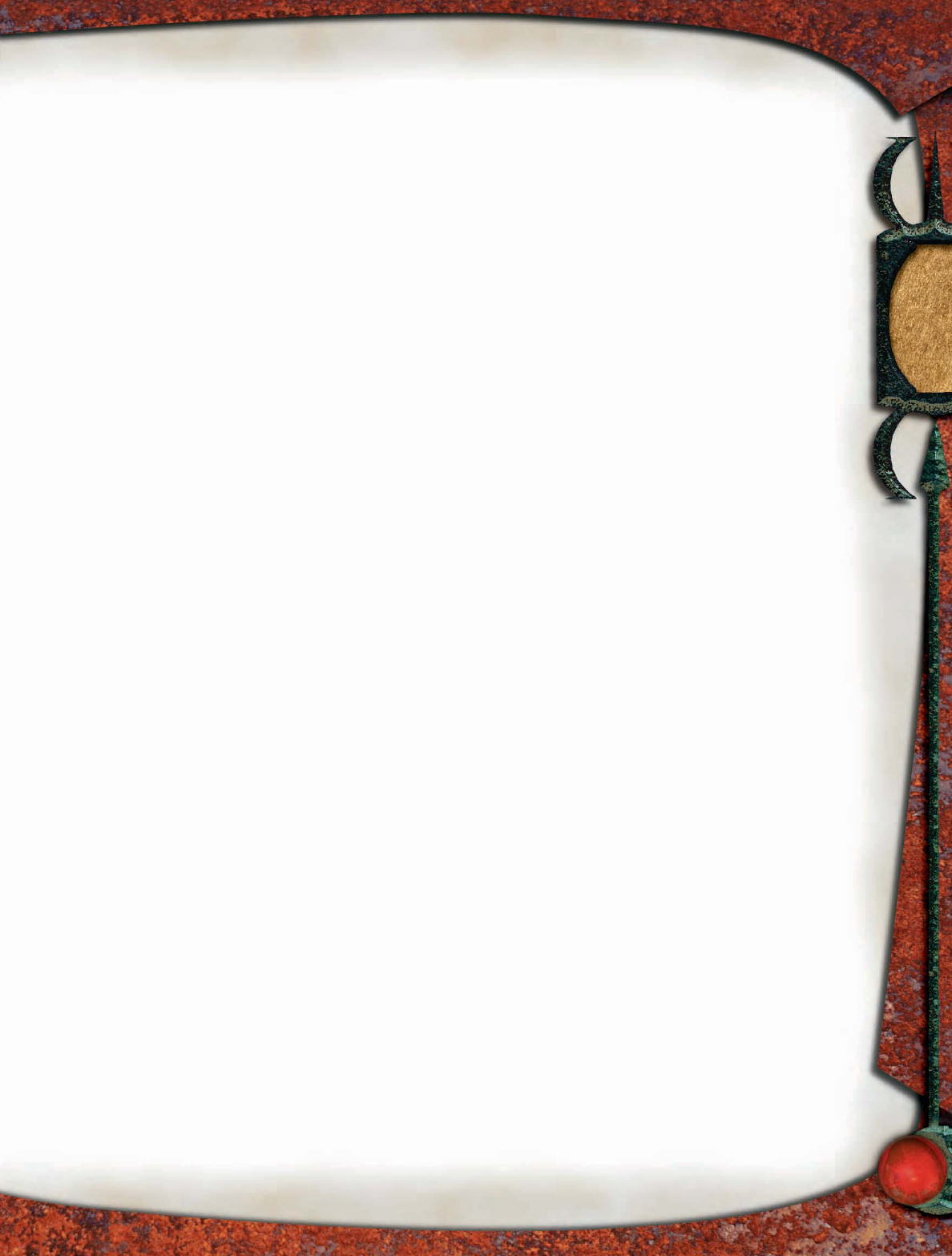
7
ECOLOGY
Where does the creature live? What does it hunt or eat? What
hunts or eats it? When appropriate, the ecology section offers
insights into the creature’s life cycle.
Environment: Specifi c terms to describe climate (warm,
temperate, or cold) and terrain (plains, hills, forests, marshes,
mountains, or deserts) are used to let you know where a
creature prefers to live. Some creatures are subterranean.
Others have no place in the natural environment (particu-
larly constructs and undead) and might be found anywhere.
Extraplanar outsiders are assigned a plane of origin.
Typical Physical Characteristics: This section states
the average height of a bipedal creature, or whatever’s most
appropriate for a nonbipedal one, and the creature’s weight.
It discusses any signifi cant physical differences between ages
or genders.
Alignment: The creature’s statistics block indicates its
alignment. Here is a discussion of the creature’s philosophy
or its general behavior within the gamut that an alignment
offers.
LORE
Monster Manual V offers a table of lore with each monster’s
entry. That lore can be gleaned by a character who makes an
appropriate Knowledge check. The baseline DC to identify
a monster and remember one bit of information about
its special abilities or vulnerabilities is equal to 10 + the
monster’s CR. (This is a change from the description of the
Knowledge skill, PH 78.) As can be seen on individual tables
in the monster entries, every 5 points by which the check
result exceeds the DC yields another piece of information.
Information specifi c to the creature, such as its type of
damage reduction, spell-like abilities, or immunities, comes
with higher check results.
The preceding rule addresses specifi c creatures well, but
more can to be said about creatures of general types. Consider
the adaru demon (page 20) as an example. It’s a CR 10 crea-
ture. Identifying it specifi cally requires a successful DC 20
Knowledge (the planes) check. However, since lowly CR 2
demons such as the dretch are out there, sharing outsider and
tanar’ri traits with the adaru, it’s reasonable to assume that
identifying those outsider and tanar’ri traits is a relatively
easy task.
Except when otherwise noted, an appropriate and suc-
cessful DC 15 Knowledge check reveals all of a creature’s
type and subtype traits as defined in the glossary. This
often includes information about energy resistance or
various immunities. For instance, a DC 15 Knowledge
(arcana) check reveals that dragons are hard to kill
(12-sided HD) and resilient (all good saves). They have
darkvision out to 60 feet and low-light vision, and they
are immune to sleep effects and paralysis effects. They eat,
sleep, and breathe.
SOCIETY
Intelligent creatures often form societies and have particular
worldviews. Here are details about their thoughts, social
interactions, religion, and government. How do creatures
view themselves, each other, and other races? What do they
value? What’s “normal” for them?
SAMPLE LAIR
Some creatures (the rylkars and the tirbanas) have an entry
showing a sample lair complete with area descriptions.
TYPICAL TREASURE
This information expresses typical treasure values and trea-
sure preferences. Some creatures don’t have treasure. Others
have their treasure merely expressed in their Possessions
entries. This section of the description is where you can fi nd
more information if it applies. For cultured societies, sample
art objects, jewelry, and other creature-specifi c fl avor pieces
might be described.
A creature that has been advanced by class levels has trea-
sure equal to an NPC of its Challenge Rating, not its ECL.
CREATURES AS CHARACTERS
If a creature offers exciting possibilities for play as a character,
this section provides the statistics and level adjustment.
CREATURES WITH CLASS LEVELS
If the creature advances by class, but is not suitable for play as
a character, this section discusses its favored class and associ-
ated classes (if any), and it might offer information about its
deity and domains or other class-based information.
ADVANCED CREATURES
If a creature advances by Hit Dice, the Advancement line in
its statistics block gives the break points. This section of the
description, when present, discusses the whys and wherefores
of the creature’s increased size and abilities. For example,
given a subterranean creature, are the larger specimens found
deeper in the earth? Is its growth a result of good feeding,
good environment, age, or simple happenstance?
FOR PLAYER CHARACTERS
If the creature can be useful to a player character as an animal
companion, familiar, planar ally, mount, or summoned
monster, relevant information is included here.
CREATURES IN EBERRON
OR CREATURES IN FAERÛN
These sections (not present for every creature) describe the
creature’s niche in the EBERRON campaign setting or in the
FORGOTTEN REALMS campaign setting.
INTRODUCTION

8
ARCADIAN AVENGER
A female with angular features and bright, metallic fl esh stalks
toward you, her wings as sharp and threatening as her two readied
swords. Each of her movements is framed by perfect symmetry—she
never moves her right blade forward without moving the left blade
back in equal measure. Sparing a glance for each part of the room
in turn, she starts the cycle over again.
Arcadian Avenger CR 6
Usually LG Medium outsider (extraplanar, good, lawful)
Init +6; Senses darkvision 60 ft.; Listen +12, Spot +12
Languages Celestial, Common
AC 19, touch 12, flat-footed 17
(+2 Dex, +1 shield, +6 natural)
hp 60 (8 HD)
Fort +9, Ref +8, Will +7
Speed 30 ft. (6 squares); fly 30 ft. (good)
Melee mwk longsword +12/+7 (1d8+3/19–20) or
Melee mwk longsword +8/+3 (1d8+3/19–20) and
mwk longsword +8 (1d8+1/19–20)
Space 5 ft.; Reach 5 ft.
Base Atk +8; Grp +11
Atk Options aligned strike (lawful, good), blade rend, magic
strike, wrath
Special Actions elude chance
Abilities Str 16, Dex 15, Con 16, Int 10, Wis 12, Cha 12
SA aligned strike, blade rend, elude chance, magic strike,
wrath
Feats Improved Initiative, Two-Weapon Defense, Two-
Weapon Fighting
Skills Balance +13, Diplomacy +14, Heal +12, Intimidate +12,
Knowledge (the planes) +11, Listen +12, Sense
Motive +12, Spot +12
Advancement by character class; Favored Class crusader;
see text
Possessions 2 masterwork longswords
Blade Rend (Ex) If an Arcadian avenger hits a single target
with at least one attack from each of her swords during a
full attack, she deals an extra 2d6 points of damage.
Wrath (Ex) Any time the Arcadian avenger sees an ally fall in
battle, she gains a +2 morale bonus on melee damage
rolls. The bonus lasts for 1 minute.
Elude Chance (Su) Three times per day, as an immediate
action, an Arcadian avenger can tap directly into the
power of law, allowing her to avoid the uncertainty of
chance. When an Arcadian avenger activates this ability,
her next melee attack or saving throw is treated as if the
result of the die roll were 10.
Arcadian avengers populate the grand legions of Arcadia,
providing the force necessary to protect the utopian plane.
Although they have humanoid features, Arcadian avengers
spring forth from the pure forces of law, and as such their
outlook and thoughts are as alien to the mortal races as are
those of demons and devils. Arcadian avengers see all situ-
ations as a series of applied rules, and are free of hesitation,
doubt, and remorse. Because of this, they come into confl ict
even with good creatures that have broken rules or laws.
STRATEGIES AND TACTICS
Arcadian avengers approach combat as a systematic series of
calculations, constantly assessing the most logical means of
attack. They weigh each foe’s ability to harm them and bal-
ance that against their ability to take that foe down quickly.
This usually means that Arcadian avengers focus fi rst on
spellcasters and other nonmelee types, attempting to nullify
these powerful fi gures before they can unleash their magic.
An Arcadian avenger spends a round measuring her ability
to hit a foe before employing her elude chance ability—her
preferred tactic is to wait until she has hit with her fi rst attack
in a round and then use elude chance to ensure that her blade
rend ability affects the foe.
Multiple Arcadian avengers move in perfect concert, using
5-foot adjustments to create situations when each fl anks a foe
she is attacking.
SAMPLE ENCOUNTER
Arcadian avengers are usually encountered with a spellcaster
or other creature capable of summoning them away from
Arcadia. They are drawn to outbreaks of chaos and disorder,
and they fi nd their way to mortal realms more frequently in
times of strife and war.
Punishers (EL 10): A group of four Arcadian avengers has
been sent to apprehend the party because of a past action that
disturbed law or order. The characters must decide whether
to fi ght the avengers. To avoid doing so, they need to fi nd
some way to atone for their crimes.
ECOLOGY
Arcadian avengers defend the perfect harmony of Arcadia,
specifi cally the lawful edicts of that plane. With their strict
code of conduct and adherence to law over good, it would
seem at fi rst that Arcadian avengers should be more at home
within the rigid lockstep of Mechanus than as a part of the
pqqqqqqqqqrs
ARCADIAN AVENGER LORE
Characters who have ranks in Knowledge (the planes) can
learn more about Arcadian avengers. When a character makes
a successful skill check, the following lore is revealed, includ-
ing the information from lower DCs.
Knowledge (the Planes)
DC Result
16 This creature is a lawful good outsider called an
Arcadian avenger. Such creatures are the primary
soldiers in the legions that defend Arcadia.
21 Arcadian avengers are dangerous in melee
combat. Their attacks become more powerful if
one of their allies is slain. They can be summoned
to serve lawful creatures.
26 Their affi nity with law allows Arcadian avengers to
strike more reliably.
pqqqqqqqqqrs
ARCADIAN
AVENGER
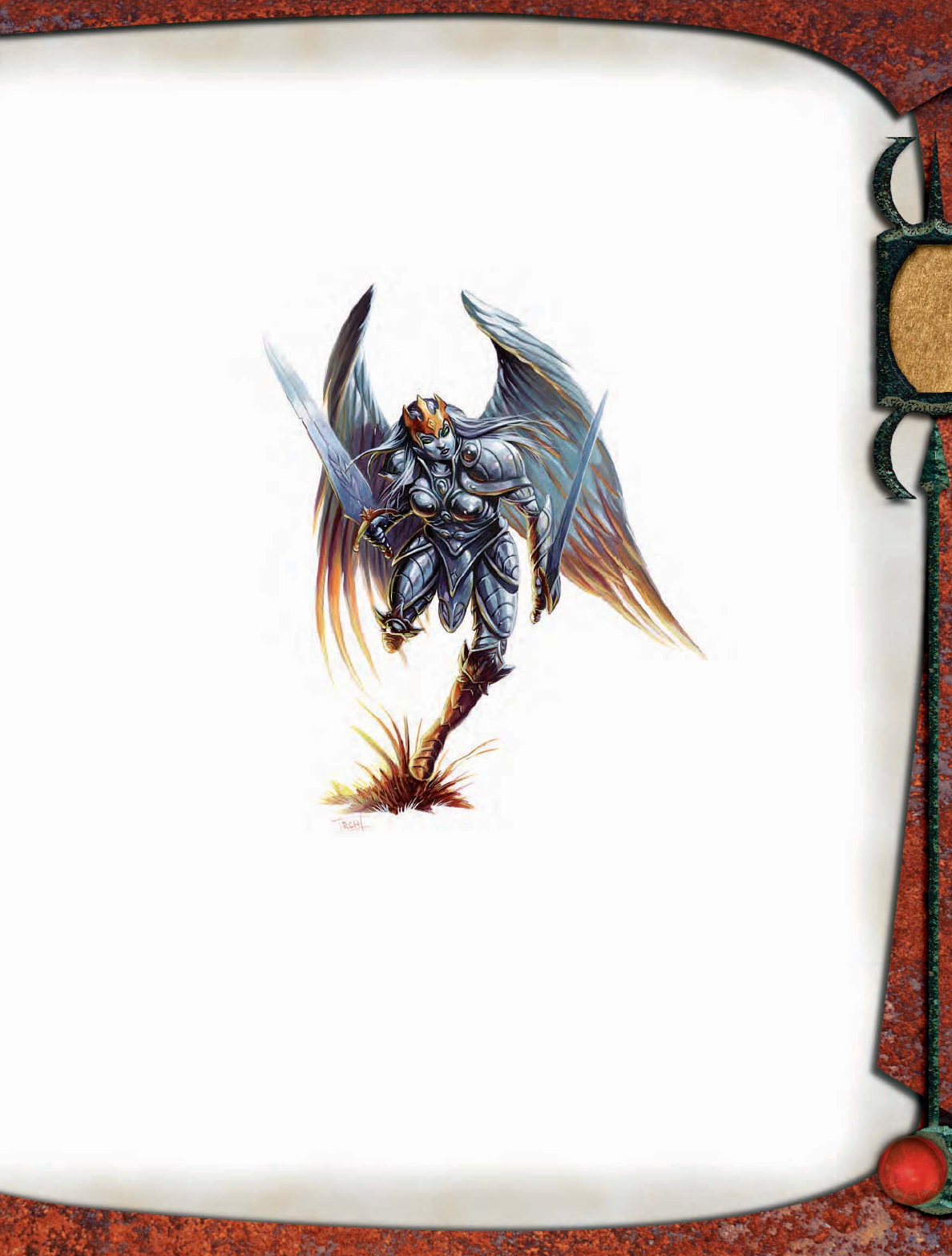
9
peaceful harmony of Arcadia. Certainly, their extreme views
on law occasionally bring them in confl ict with other forces
of good. These incidents are rare, however, since the avengers
hold to the ideals of Arcadia, where laws are created for the
greater good. It is in mortal realms where Arcadian avengers
often fi nd these forces at odds.
Environment: Arcadian avengers are extraplanar crea-
tures from the Peaceable Kingdoms of Arcadia. They live
there in great barracks, as befi ts their role in the legions that
defend the plane. However, like all areas of
Arcadia, the military housing of the Arca-
dian avengers is beautiful by
almost any standard, with
practice yards and train-
ing areas set amid carefully
sculpted gardens and orderly
rows of fl owering trees.
Typical Physical Character-
istics: Arcadian avengers all stand
5 feet 8 inches tall and weigh 125
pounds, resembling attractive, ath-
letic female humans with full wings.
Their fl esh, wings, and armor seem
made of the same silvery metal. Ar-
cadian avengers are similar to one
another in appearance.
Alignment: Arcadian avengers
are benevolent and helpful, but they
see adherence to the rules as more
important than kindness. They are
usually lawful good, but some fall
into lawful neutral behavior, for-
going compassion in the execution of
their duties.
SOCIETY
Arcadian avengers live a simple,
ascetic lifestyle among the ordered
bounty of Arcadia. Their lives are
as structured as the laws they defend.
Arcadian avengers are divided into legions,
and each legion is given a specific task that defines its
purpose within the grand armies of law. The avengers are
perfect embodiments of the harmony of Arcadia—free
of ambition and inner conflict, they live in peace within
their homes despite their occasional bloody tasks. Arca-
dians avengers are much more strongly aligned with law
than with good, and as such, they are housed on Buxenus,
the second layer of Arcadia.
TYPICAL TREASURE
Arcadian avengers have little use for treasure. Like other
Arcadians, they fi nd that the bounty of their native plane
provides them with all they need. Each Arcadian avenger
possesses two masterwork longswords. These functional
weapons are the tools of the avengers’ job and are seldom
seen as anything more than utilitarian goods.
ARCADIAN AVENGERS WITH
CLASS LEVELS
Arcadian avengers advance in the crusader class (Tome
of Battle 8), relying on faith and martial power to work
their will. If you don’t use Tome of Battle in your cam-
paign, advance Arcadian avengers as paladins.
Both classes are considered associated for an
Arcadian avenger.
Level Adjustment: +2.
FOR PLAYER
CHARACTERS
A non-evil, lawful spellcaster can
summon an Arcadian avenger
using summon monster IV or a
higher-level summon monster
spell. Treat the Arcadian aveng-
er as if it were on the 4th-level
list on the Summon Monster
table (PH 287). Non-evil,
lawful clerics can use a
planar ally spell to call
an Arcadian avenger,
who demands pay-
ment in the form
of a task further-
ing the cause of law.
ARCADIAN AVENGERS
IN EBERRON
Arcadian avengers are native to Daanvi, the Perfect
Order. They commonly venture to Shavarath to lend
their swords and hone their skills in battle. On
Eberron itself, Arcadian avengers hunt those who
work chaos, so they can be found in the Demon
Wastes and similar places across the world. More
than one Arcadian avenger participated in the Last War, and
some of these remain in Khorvaire in self-imposed exile or
as centers of celestial cults.
ARCADIAN AVENGERS IN FAERÛN
In the House of the Triad, legions of Arcadian avengers make
their home, protecting the petitioners of Toril’s heaven from
the infl uences of other planes and entities. Although the
avengers are bound in duty to the House of the Triad, a great
number of them are loyal to Helm. All Arcadian avengers take
their duty as watchers and protectors of the law extremely
seriously, and Helm’s dogma suits them well.
ARCADIAN
AVENGER
Arcadian
avenger
Illus. by R. Horsley

10
BANSHRAE
A willowy fi gure dressed in dark green fi nery approaches, a lustrous
topknot decorated with gold ornaments draped over its shoulder.
Except for its golden, insectile eyes, the creature’s oval face is eerily
featureless, yet it raises a carved wooden fl ute to its chin and begins
to play a haunting tune.
Banshrae CR 8
Usually CE Medium fey
Init +7; Senses low-light vision; Listen +16, Spot +16
Languages understands Common, Elven, Sylvan; cannot
speak; telepathy 100 ft.
AC 22, touch 22, flat-footed 22; Deflect Arrows, Dodge,
Mobility, sylvan warrior
(+7 Dex, +5 deflection)
hp 97 (15 HD); DR 10/cold iron
Fort +8, Ref +16, Will +11
Speed 60 ft. (12 squares); Spring Attack
Melee unarmed strike +15/+10 (2d6+3)
Ranged mwk greater blowgun +15/+10 (1d3)
Space 5 ft.; Reach 5 ft.
Base Atk +7; Grp +10
Atk Options Stunning Fist 3/day (DC 19)
Special Actions blowgun flute, dart cone, locust dart
Spell-Like Abilities (CL 10th):
1/day — bestow curse (DC 19)
Abilities Str 16, Dex 24, Con 17, Int 14, Wis 15, Cha 20
SA blowgun flute, dart cone, locust dart, spell-like abilities
Feats Combat Expertise, Deflect ArrowsB, Dodge, Improved
Unarmed StrikeB, Mobility, Spring Attack, Stunning FistB,
Weapon Finesse, Weapon Focus (unarmed strike)
Skills Balance +17, Bluff +15, Climb +8, Diplomacy +7,
Disguise +13 (+15 acting), Escape Artist +24, Hide +19,
Intimidate +7, Jump +25, Knowledge (nature) +8,
Listen +16, Move Silently +19, Perform (wind
instruments) +23 (+25 with blowgun flute), Spot +16,
Survival +2 (+4 in aboveground natural environments),
Tumble +21, Use Rope +7 (+9 bindings)
Advancement by character class; Favored Class fighter
Sylvan Warrior (Su) A banshrae applies its Charisma bonus
as a deflection bonus to its Armor Class. It doesn’t lose
its Dexterity bonus to AC when flat-footed.
Blowgun Flute (Su) At will, as an immediate action, a
banshrae can call into being a masterwork flute that also
functions as a masterwork greater blowgun (10-foot
range increment). A banshrae can have only one such
flute at a time, and the instrument disappears if the fey
loses possession of it.
Each round, a banshrae can play its flute as a swift
action to create one of the effects detailed below.
Opponents within a 60-foot-radius spread who can hear
the flute can be affected (Will DC 22 negates)—the effect
ends if an enemy can no longer hear the music creating
it. The save DC is Charisma-based. The tunes are sonic
mind-affecting abilities.
Dread Dirge: This mournful tune creates deep unease.
Affected creatures are shaken. This is a fear effect.
Gibbering Sing-Along: This catchy melody forces
listeners to blather meaningless sounds. Affected
creatures fail Move Silently checks, give away their
positions if invisible or hidden, cannot talk, and cannot
cast spells that have verbal components.
Traveler’s Tune: This sprightly ditty forces affected
creatures to move at least 20 feet on their turns.
Dart Cone (Ex) Once per day per point of Charisma bonus a
banshrae possesses, as a full-round action, the creature
can create a 15-foot cone of blowgun darts. Those caught
in the cone take 4d6 points of damage (Reflex DC 24
half). The save DC is Dexterity-based.
Locust Dart (Su) Once per day, a banshrae can fire a special
dart. An opponent struck by this dart is sickened for 1
round and takes 2d6 points of damage as locusts emerge
from its body (Fortitude DC 20 negates). The locusts
form a swarm (MM 239) that obeys the banshrae’s
commands for 2d6 rounds before dispersing. The save
DC is Constitution-based.
Bestow Curse (Sp) Once per day, a banshrae can produce
a bestow curse effect. Victims of this curse inspire anger
in those around them, taking a –6 penalty on Bluff and
Diplomacy checks as well as a –2 penalty to Armor Class.
Banshraes are spiteful, musically inclined fey that use their
supernatural tunes to torment other creatures. Their taste for
melodic mischief belies their incredible martial skill.
STRATEGIES AND TACTICS
When combat is joined, a banshrae summons its blowgun
fl ute and begins playing. It then uses its speed and maneu-
verability to command the battlefield, dancing around
opponents to gain advantageous positions from which to
use its considerable combat skills. It takes out dangerous
opponents fi rst, so it can later toy with weaker foes. Using
Combat Expertise to ensure safety without seriously com-
promising its fi ghting prowess, a banshrae never strikes
from the same place twice. It uses its locust dart and the
resultant swarm to help control the fight, focusing the
swarm on troublesome spellcasters.
SAMPLE ENCOUNTER
Banshraes are individualistic, but they do live among evil fey
and serve strong leaders.
Murderous Messenger (EL 8): A banshrae carries im-
portant missives and supplies between enclaves of evil fey
on a regular route. It makes stops at villages along the way
pqqqqqqqqqrs
BANSHRAE LORE
Characters who have ranks in Knowledge (nature) can learn
more about banshraes. When a character makes a successful
skill check, the following lore is revealed, including the infor-
mation from lower DCs.
Knowledge (Nature)
DC Result
18 This creature is a banshrae, a wicked fey that can
play music to bewilder and harm mortals.
23 Banshraes are powerful combatants that can
play their fl utes while fi ghting. They can use
those fl utes to fi re clouds of darts, and they are
vulnerable to cold iron.
28 A banshrae can sometimes cause a target struck
by a special dart to spontaneously spew forth a
swarm of locusts. It can also affl ict an unlucky soul
with a curse that draws the ire of others.
pqqqqqqqqqrs
BANSHRAE
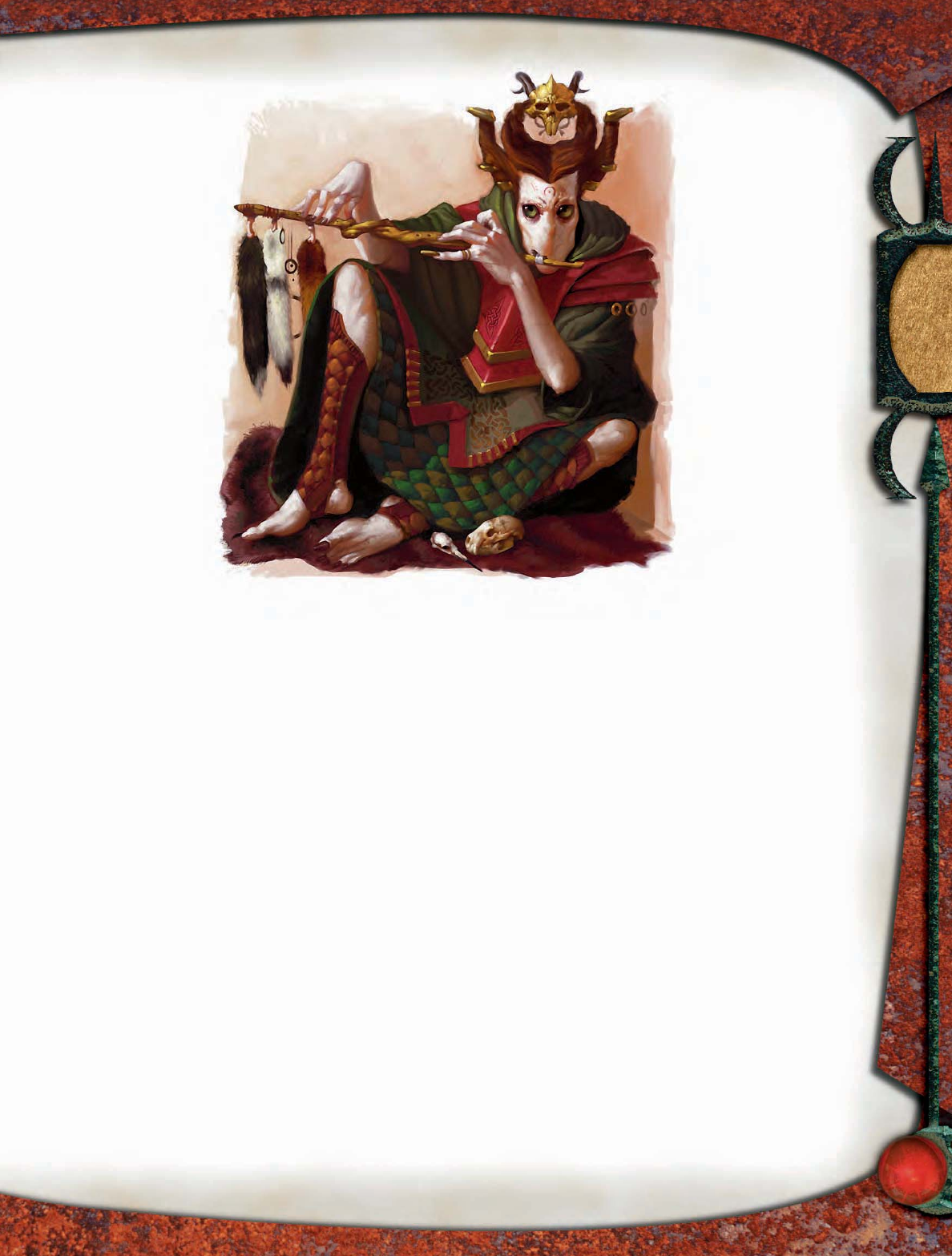
11
to rob, harass, and murder
innocent citizens. The last
time through, the ban-
shrae killed a hunter who
was the local lord’s friend.
That lord now seeks cou-
rageous individuals to
waylay the fey and pun-
ish it for this crime.
ECOLOGY
Originally less harm-
ful fey who sang and
reveled among their
more benevolent kin,
banshraes became
what they are through
the treachery of an
elder of their kind.
This banshrae, whose
name and actual
crime are forgotten,
betrayed a capricious
fey queen, who in
turn cursed all ban-
shraes, stealing their
mouths. A mighty and
terrible verdant prince (MM4 172) made a
compact with the banshraes, interceding with dark spirits
and allowing the banshraes to have back a measure of their
musical ability. Since then, banshraes have bred true, form-
ing a new fey race devoted to grief and fear.
Banshraes “eat” while they rest, absorbing sustenance from
nearby plants and the earth. They breathe through holes in
the sides of their heads, under the hair.
Environment: Banshraes prefer temperate forests, but
they can live in any environment that can sustain fey. They
enjoy tormenting humanoids, so they often live close to
humanoid settlements.
Typical Physical Characteristics: Banshraes resemble
particularly lithe elves, a little over 5 feet tall and about 100
pounds in weight. Their faces are smooth and featureless,
except for their golden insectile eyes. Their frail appearance
masks their physical power and martial skill.
Alignment: Banshraes are embittered souls, and they
hate most creatures except other banshraes. Even powerful
evil fey must watch their banshrae servants—treachery is
in a banshrae’s nature. Jealous and vindictive, banshraes
destroy that which is beautiful and wholesome. They ruin
or pollute that which they can never enjoy, such as food and
water. Banshraes are usually chaotic evil.
SOCIETY
Banshraes dwell in communities among other black-
hearted fey. They serve as minstrels, spies, and soldiers for
malevolent fey leaders
or other iniquitous and
powerful creatures. Ver-
dant princes and evil
nymphs enjoy such ser-
vice, and they repay a
banshrae’s loyalty with
honor and treasure, re-
warding treachery with
swift death.
Even among wick-
ed fey, banshraes are
notorious for abusing
those weaker than they,
as their whims dictate.
Banshraes respect only
other banshraes and
the strong. Nonfey can
expect torment and
murder at their hands.
TYPICAL
TREASURE
Banshraes adore fi ne
clothing and jewel-
ry. Their love for music
inspires them to collect master-
work instruments made from—or extravagantly
decorated with—precious materials. They have standard trea-
sure for their Challenge Rating.
BANSHRAES WITH CLASS LEVELS
Banshraes are soldiers that revel in battle and turmoil. They
usually augment their considerable combat skills by advanc-
ing as fi ghters, though some advance as rogues. Both classes
are considered associated for a banshrae. These fey never use
divine magic—they despise the gods and have no conscious
connection to nature.
Level Adjustment: +4.
BANSHRAES IN EBERRON
Banshraes were residents of Thelanis, the Faerie Court,
but an unnamed treachery by the banshraes of old brought
the mouthless curse and banishment upon the entire
race. Exiled banshraes then spread throughout Khorvaire
and beyond, existing as deceitful vagabonds. A few still
dwell in the Twilight Demesne in the Eldeen Reaches,
but they are unwelcome there. Some fled north to the
Demon Wastes to offer their services as spies to the
Lords of Dust. More joined with the dark fey that rule
the Watching Wood in Droaam, and some of these have
pledged their flutes to the service of the Daughters of Sora
Kell. It is said that banshraes also inhabit the Whisper
Woods of Aundair.
Banshrae
BANSHRAE
Illus. by I. Medrano

12
BLACKWING
This large skeletal bird’s ragged, ebony wings end in masses
of sharp, broken-off bones. Its red eyes seem full of malice and
malign intelligence. Talons and a curved beak make up its
natural armaments.
Blackwing CR 8
Always NE Large undead
Init +7; Senses darkvision 60 ft.; Listen +17, Spot +21
Languages Auran, Common
AC 20, touch 12, flat-footed 17
(–1 size, +3 Dex, +8 natural)
hp 78 (12 HD); DR 5/bludgeoning
Immune cold, undead immunities
Resist evasion
Fort +4, Ref +9, Will +10
Speed 30 ft. (6 squares), fly 80 ft. (average); Hover
Melee 2 claws +13 each (1d6+8) and
bite +8 (1d8+4)
Space 10 ft.; Reach 5 ft.
Base Atk +6; Grp +18
Atk Options Blind-Fight
Special Actions frightful dive, wail of despair
Abilities Str 26, Dex 17, Con —, Int 10, Wis 14, Cha 14
SA frightful dive, wail of despair
SQ undead traits
Feats Blind-Fight, Hover, Improved Initiative, Lightning
Reflexes, Weapon Focus (claw)
Skills Hide +14, Listen +17, Search +7, Sense Motive +10,
Spot +21
Advancement 13–24 HD (Large); 25–28 HD (Huge)
Frightful Dive (Su) When a flying blackwing charges a target
below it, that foe must succeed on a DC 18 Will save or
be shaken for 1 round (or frightened if already shaken). In
addition, a blackwing can make two claw attacks against
a target that fails its save. The save DC is Charisma-
based. This is a mind-affecting fear effect.
Wail of Despair (Su) When two or more blackwings within
30 feet of one another scream, their cries combine to
create a wail of despair, which affects all creatures within
100 feet of any wailing blackwing. Any creature in the
area must succeed on a DC 18 Will save or cower for
1d4 rounds and be shaken for 4 rounds thereafter. For
every additional two blackwings participating in a wail
of despair, the DC increases by 2. The effect of multiple
wails does not stack. The save DC is Charisma-based.
This is a mind-affecting fear ability.
Skills A blackwing has a +4 racial bonus on Spot checks.
Blackwings are the keen-eyed undead guardians of a fallen
civilization.
STRATEGIES AND TACTICS
Blackwings spend much of their time patrolling the hills and
mountains surrounding their lairs. When they spot prey, they
immediately plummet down to attack, using their frightful
dive to enter combat.
They use differing tactics based on the nature of their foes.
Blackwings facing fl ying opponents fi ght a hit-and-run battle,
using their superior speed to divide their enemies before
picking off stragglers. Against land-bound opponents, they
prefer to hover close to the ground, creating debris clouds
using their Hover feat (see page 204). Spellcasting within
this cloud requires a DC 16 Concentration check.
Unless dealt signifi cant damage by other opponents,
black wings focus their attacks on foes shaken or frightened
because of frightful dives. Once they have slain their foes,
blackwings carry the bodies back to their lair to search for
shiny trinkets. Blackwings fi ght until destroyed.
Members of a fl ock of blackwings fi ght in concert, keeping
as many foes as possible within debris clouds. They use wail
of despair at the beginning of the battle, then gang up on
one enemy at a time. Only when all enemies appear free of
fear does a fl ock of blackwings bother wailing again.
If their lair is invaded, blackwings bull rush lightly armored
or Small foes out of the cave and down the mountainside.
Heavily armored enemies are then cornered and ripped apart.
Blackwings mercilessly hunt down fl eeing invaders.
SAMPLE ENCOUNTERS
Blackwings can be encountered as individuals or in fl ocks
of up to six members. Individuals or fl ocks patrol the ter-
ritory around the ancient sites they were created to guard,
maintaining tireless vigils. They know the terrain around
their lairs intimately.
An undead spellcaster of great power—typically a lich or
a vampire—might bend a blackwing to its will, command-
ing that blackwing to act as a mount or a spy. Intelligent
and malevolent, a blackwing might instead willingly ally
itself with another undead creature. Since undead are
immune to wail of despair, they can even ride blackwings
into battle.
A Deadly Duo (EL 10): A particularly bloodthirsty
mohrg (MM 189) and a blackwing dwell in an isolated
cavern hidden deep within a mountain range. Together,
they have been terrorizing a nearby community of gnome
miners. They attack under cover of darkness. Flying toward
the gnome settlement, they spot the PCs’ campfire and
pqqqqqqqqqrs
BLACKWING LORE
Characters who have ranks in Knowledge (religion) can learn
more about blackwings. When a character makes a success-
ful skill check, the following lore is revealed, including the
information from lower DCs.
Knowledge (Religion)
DC Result
18 This is a blackwing, a powerful, undead bird. It is a
swift fl yer and can create great dust clouds with its
wings.
23 Blackwings are tough, but this resilience is
overcome by bludgeoning weapons. They are
immune to cold.
28 Blackwings terrify their prey by plummeting down
to attack from above. Groups of blackwings can
create a terrible wailing to incapacitate their foes.
pqqqqqqqqqrs
BLACKWING
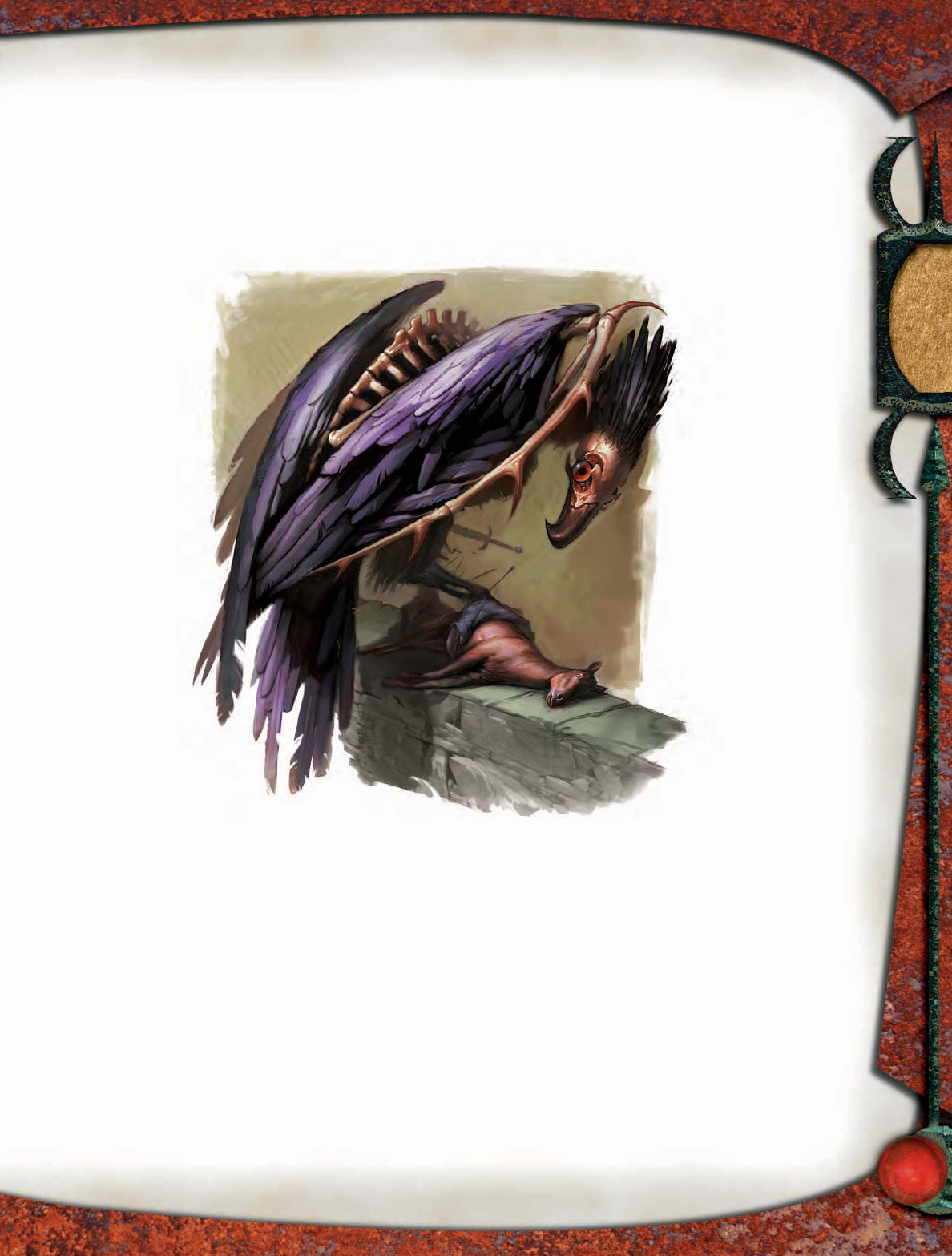
13
investigate, approaching from different directions. As soon
as the mohrg moves in, the blackwing uses its frightful
dive against an opponent near the campfire. In subsequent
rounds, it hovers over the fire, plunging the battlefield
into darkness.
Cold Vengeance (EL 10): Three blackwings patrol the
area around a lich’s lair. When they spot interlopers, two
dive down to attack while the third observes the battle. If
its companions are destroyed,
the survivor retreats to
warn the lich. Quick-
witted and sharp-eyed
PCs can locate the
lich’s lair by follow-
ing the retreating
blackwing. If the
characters do not
pursue, the black-
wing and its master
appear later that
same night, intent
on revenge.
ECOLOGY
Centuries ago, a
powerful orc tribe
claimed a rugged
mountain range,
constantly war-
ring against the
giant eagles and
elves living in
the surrounding
forests. The orcs
caught and brutal-
ized eagles for sport until
their depraved mystics dis-
covered the necessary ritual
to create powerful undead servitors—the
fi rst blackwings.
Environment: Blackwings guard tombs hidden high
up on treacherous mountains. Such locales have only one
entrance—usually a tunnel leading from a narrow ledge
downward into the mountain’s depths. Blackwings never
enter the tomb itself, instead lairing on the ledge and in the
entrance tunnel. The dismembered bodies of inquisitive
explorers often fi ll a blackwing’s lair.
Typical Physical Characteristics: The necromantic ritual
used to create blackwings requires the intact body of a giant
eagle. The process stains the creature’s feathers and plumage
a deep black and imbues the creature with unnatural vitality.
Feathers hang limply from lumps of dry, leathery skin, and
bones are exposed in places. A typical blackwing stands 10
feet tall and has a wingspan of about 20 feet. Its beak and
claws are curved and extremely sharp.
Alignment: A blackwing is corrupt to its core, tainted by
negative energy. It has no concern for law, but its actions are
not unpredictable. Blackwings are always neutral evil.
SOCIETY
A blackwing that is not destroyed during the despoilment
of its original lair has no true purpose, and it embarks on an
odyssey of destruction. If it survives this violent rampage,
the displaced blackwing settles in
a new location from which
it terrorizes the sur-
rounding countryside.
Multiple displaced
blackwings might
congregate, forming a
mockery of a natural
bird flock. Members
of a fl ock stick together
even if they are forced to
abandon a lair.
TYPICAL
TREASURE
Blackwings do not covet
treasure for its value, but
they have standard trea-
sure for their Challenge
Rating because they are at-
tracted to shiny items. They
prominently display such
objects to catch sunlight fi l-
tering in from outside.
In a twisted parody
of their former lives,
they preen in front
of particularly refl ective
items. Other valuables
lie forgotten among their
victims’ remains.
FOR PLAYER CHARACTERS
Blackwings offer a couple of prospects for characters.
Creation: Blackwings are created from the corpses of
giant eagles. The corpse must be buried within the area of an
unhallow spell for at least six months. Then, a spellcaster of
18th level or higher must cast create undead on the remains.
Mounts: A blackwing must willingly submit to training
as a mount. Training the creature requires four weeks of
work and a DC 25 Handle Animal check. Riding a blackwing
requires an exotic saddle. A blackwing can fi ght when car-
rying a rider, but the rider must succeed on a Ride check to
attack while the blackwing does so.
Carrying Capacity: A light load for a blackwing is up to 612
pounds; a medium load, 613–1,226 pounds; and a heavy load,
1,227–1,840 pounds.
Blackwing
BLACKWING
Illus. by I. Medrano

14
BURROW ROOT
A massive ripple churns through the topsoil with great speed and
fl uidity. Suddenly, a strange, serpentine root—twice the length of
a grown human—bursts through the surface. Its massive, thorny
jaws snap at you with a ravenous hunger.
Burrow Root CR 8
Always N Large plant
Init +6; Senses blind, blindsight 30 ft., tremorsense 60 ft.;
Listen +1
Languages —
AC 22, touch 11, flat-footed 20
(–1 size, +2 Dex, +11 natural)
hp 114 (12 HD)
Immune plant immunities
Fort +13, Ref +6, Will +5
Speed 30 ft. (6 squares), burrow 20 ft.; speed burrow
Melee bite +16 (2d6+12/19–20 plus wounding) or
Melee tail spike +16 (1d6+4 plus 1 Con plus wounding)
Space 10 ft.; Reach 5 ft.
Base Atk +9; Grp +21
Atk Options Improved Bull Rush, Power Attack
Special Actions split
Abilities Str 26, Dex 15, Con 20, Int 2, Wis 12, Cha 7
SA split, wounding
SQ plant traits
Feats Improved Bull Rush, Improved Critical (bite), Improved
Initiative, Improved Natural Attack (bite), Power Attack
Skills Hide +13, Listen +1
Advancement 13–16 HD (Large); 17–25 HD (Huge)
Speed Burrow (Ex) A burrow root can move quickly through
loose soil. Three times per day, as an immediate
action, a burrow root can move 20 feet through the
ground. This movement does not provoke attacks of
opportunity.
Wounding (Ex) Any living creature damaged by a burrow
root continues to bleed, losing 1 hit point per round
thereafter. Multiple wounds do not result in cumulative
blood loss. The bleeding can be stopped by a DC 21 Heal
check or the application of healing magic.
Split (Ex) When a burrow root is reduced to half of its full
normal hit points or fewer, it splits in half. The new root’s
game statistics are identical to those of its parent. Divide
the parent creature’s remaining hit points evenly between
the two organisms. The older burrow root cannot split
again for 24 hours, and the younger burrow root cannot
split for 24 hours after it emerges.
Burrow roots are animate plants that feed on blood. They
attack to spill blood on the ground, then burrow underground
and consume their food in safety.
STRATEGIES AND TACTICS
A burrow root attacks in three stages. Upon sensing prey,
the creature burrows rapidly toward that quarry, springing
from the earth and delivering a powerful bite. If multiple
opponents are nearby, the burrow root attacks each one with
the goal of spilling as much blood on the ground as possible.
It uses its speed burrow ability to quickly move between
opponents or to escape from a particularly nasty foe or effect.
A burrow root can instinctively determine if a creature has
blood—it ignores a bloodlesss creature unless that creature
seriously harms it.
A burrow root needs to be split to reproduce, so it fi ghts
until it has lost half of its hit points. If an individual burrow
root is reduced to 9 hit points or fewer, it retreats beneath
the surface, content to nourish itself with the blood seeping
down from above.
SAMPLE ENCOUNTERS
Burrow roots often hunt in groups, moving into a terri-
tory and infesting it. In civilized areas, they are hunted
and either killed outright or driven back into the remote
wilderness.
Beholders, harpies, and other intelligent fl ying creatures
use burrow roots to drive earthbound foes from behind
cover. Less intelligent fl ying predators roost above burrow
root infestations, swooping down as the burrow roots attack
or scavenging remains after a battle.
Trail of Blood (EL 9): A trail of tilled soil—the path of a
burrow root—leads deep into a forest. The burrow root has
been following a briarvex (MM4 26), despite the fact that it
must go deep into hard, forested terrain, since it fi nds that
blood is easier to come by when the briarvex is near. The
burrow root’s burrowing and the briarvex’s woodland stride
allow them full mobility even in dense vegetation.
In battle, the briarvex uses entangle to hold enemies still,
then allows the burrow root to attack those opponents,
making it more likely for those foes to bleed out from the
burrow root’s wounding attacks.
Minion Colony (EL 14): A harpy archer (MM 151) has
strategically seeded a small gully with six burrow roots to
target passing caravans. She uses her captivating song to
lure opponents through the colony. As soon as the burrow
pqqqqqqqqqrs
BURROW ROOT LORE
Characters who have ranks in Knowledge (nature) can learn
more about burrow roots. When a character makes a suc-
cessful skill check, the following lore is revealed, including
the information from lower DCs.
Knowledge (Nature)
DC Result
18 This is a burrow root, a strange, burrowing plant.
Wounds caused by a burrow root continue to
bleed, spilling blood into the soil and providing
the creature with food.
23 A burrow root can quickly burrow underground
to escape its enemies. Its tail is a spiked root that
can drain blood and small amounts of vitality from
creatures it pierces.
28 When severely wounded, a burrow root becomes
two independent creatures.
pqqqqqqqqqrs
BURROW ROOT
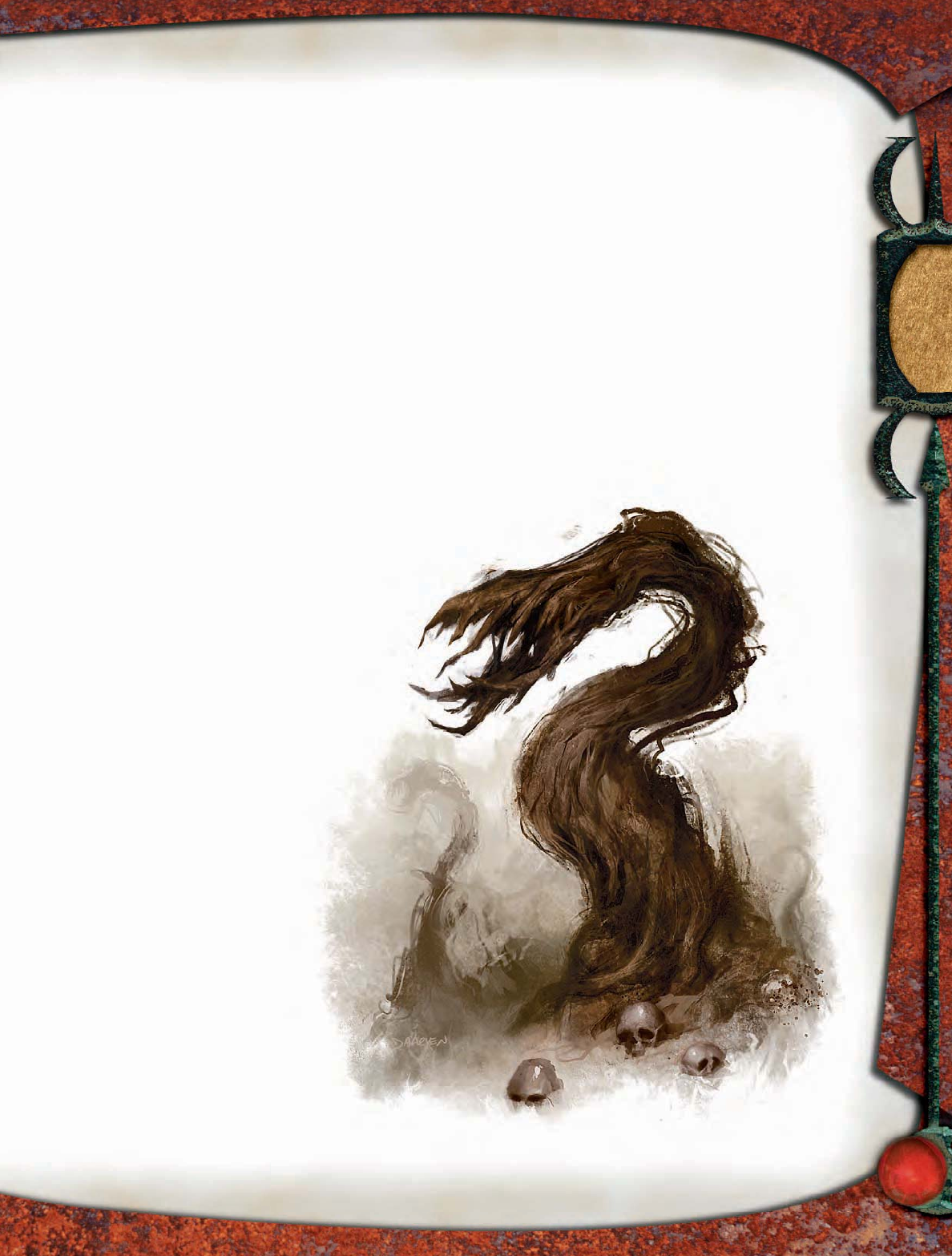
15
roots close in on their targets, she swoops in from above,
peppering her opponents with arrows.
ECOLOGY
Burrow roots are predators that live just beneath the
topsoil. The blood of living creatures sustains them, so
unless they are provided with a steady food source by
a third party, they root in areas that have high traffic.
Once they find an appropriate spot, they colonize it and
begin reproducing. Desiccated corpses mark burrow
root territory.
Burrow roots reproduce asexually, splitting apart into
separate creatures once they have grown too large or have
taken significant damage. Since they are easy to cultivate,
a few wily and powerful creatures breed burrow roots
as guardians.
Environment: A burrow root’s environment is limited
to regions where food is plentiful. They colonize warm or
temperate regions, and they prefer areas with soft, treeless
terrain, such as marshes, plains, and hills. They live near
roads, agricultural fi elds, bodies of water, and other prey-
attracting features.
A burrow root’s usual mode of travel leaves behind large
trails of upturned soil. From a distance, these trails look like
twisted patches of veins bulging from the earth’s surface. The
tilled earth is soft, making for treacherous travel (diffi cult
terrain) along a burrow root’s trail.
Typical Physical Characteristics: A burrow root
is between 12 and 14 feet long. The bulk of its gray-
brown body is about the width of a human head,
and its posterior tapers to a sharp spike. Dozens
of thorny branches split the anterior, creating the
appearance of an exaggerated maw about the size
of a barrel. It uses its mouth to wound its prey,
but it can absorb nutrients by imbedding
its spiked taproot into an opponent’s flesh,
draining that creature’s blood.
Alignment: Because they behave
solely based on survival instincts,
burrow roots are always neutral.
TYPICAL TREASURE
Burrow roots have no concept of
material wealth. Still, treasure lies
among the remains of the victims
that fertilize burrow root territories.
The enzyme-rich soil quickly decom-
poses soft, organic materials such as
paper, cloth, and leather, so only harder
items remain. Searching the surround-
ing soil reveals coins, gems, and other
solid objects equivalent to standard trea-
sure for a creature of the burrow root’s
Challenge Rating.
BURROW ROOTS IN EBERRON
In Khorvaire, the earliest references to burrow roots are
found in pre-Galifar guild documents of House Deneith.
Some have even suggested that Deneith magically bred
these creatures to provide a quick and mobile fortification
system for its troops in occupied territories. Of course,
House Deneith formally denounces such conjecture.
Driven far from most civilized lands, burrow roots can
be found in the Shadow Marches, the Demon Wastes, the
Mournland, and other such desolate places.
BURROW ROOTS IN FAERÛN
Burrow roots are sacred to the church of Urdlen. It is widely
speculated that the spriggans (Fiend Folio 162) of his highest
order fi rst cultivated the plant. Urdlen’s most devout followers
seed burrow roots near their temples and delight in offering
the plants living sacrifi ces as a highlight of their Feeding
ceremonies. Burrow roots have claimed more than a few
worshipers during the Night of Blood.
Burrow root
BURROW ROOT
Illus. by Daarken

16
DALMOSH
Before you stands an enormous humanlike fi gure, at least 50 feet
tall, whose brown, leathery skin is covered in scars. Each scar is
straight and has a row of tiny spikes on either side, as if it’s a sealed
mouth through which sharp teeth have poked. The creature has
no hair on his massive body. His face—little more than a pair
of blue eyes set just above a massive maw—is soft, as if no bones
support the fl esh. More spiny scars cross the palms of the gigantic
creature’s hands.
Dalmosh CR 17
CE Gargantuan outsider (chaotic, evil, extraplanar)
Init +1; Senses darkvision 120 ft., low-light vision, scent;
Listen +30, Spot +30
Languages Abyssal
AC 13, touch 3, flat-footed 13
(–4 size, –3 Dex, +10 natural)
hp 461 (26 HD); rejuvenation
Immune acid, disease, poison, suffocation
Resist cold 10, electricity 10, fire 10
Fort +29, Ref +14, Will +18
Speed 50 ft. (10 squares)
Melee bite +39 (10d6+24)
Space 20 ft.; Reach 20 ft.
Base Atk +26; Grp +54
Atk Options aligned strike (chaotic, evil), improved grab,
swallow whole
Special Actions feeding frenzy, spawn maw
Abilities Str 42, Dex 5, Con 34, Int 4, Wis 13, Cha 12
SA aligned strike, feeding frenzy, improved grab, spawn
maw, swallow whole
Feats Great Fortitude, Improved Initiative, Improved
Toughness, Iron Will, Lightning Reflexes, Toughness (2),
Track, Weapon Focus (bite)
Skills Climb +36, Intimidate +20, Jump +40, Listen +30,
Search +10, Spot +30, Survival +20 (+22 following tracks)
Rejuvenation (Su) If slain, Dalmosh restores himself to life
on the Flesh Mountains in the Abyss two days later. He
returns to the same peaks in two days if called to the
Material Plane.
Improved Grab (Ex) To use this ability, Dalmosh must hit
an opponent of up to Large size with a bite. He can
then attempt to start a grapple as a free action without
provoking attacks of opportunity.
Swallow Whole (Ex) Dalmosh can swallow a grabbed
opponent of up to Large size by making a successful
grapple check.
A swallowed creature takes 8d8 points of
bludgeoning damage and 10 points of acid damage per
round from Dalmosh’s gizzard. The creature can cut its
way out by using a light slashing or piercing weapon to
deal 75 points of damage to the gizzard (AC 15). Once the
creature exits, muscular action closes the hole; another
swallowed opponent must cut its own way out.
A creature in Dalmosh’s gizzard can see a portal to
the Gullet (see Ecology) and is aware of where the portal
leads. Exiting the gizzard to move into the Gullet requires
making a successful DC 26 Escape Artist check or dealing
half the damage required to cut out of Dalmosh’s gizzard.
The DC is Strength-based.
Dalmosh’s gizzard can hold 2 Large, 8 Medium, 32
Small, 128 Tiny, or 512 Diminutive or smaller opponents.
Inanimate objects pass through the gizzard into the
Gullet immediately, but dead creatures stay until ground
into bits.
Feeding Frenzy (Ex) Once per minute, as a full-round action,
Dalmosh can move up to his speed, simultaneously
attacking all creatures that come within his reach with a
single bite attack.
Spawn Maw (Ex) When dealt 20 or more points of damage
in a single attack, Dalmosh can take an immediate action
to spawn a new mouth where the attack damaged him,
granting him an additional bite attack for the duration of
the encounter. If an opponent adjacent to Dalmosh made
the attack that caused a new mouth to appear, Dalmosh
can make a bite attack against that foe as a free action.
Dalmosh of the Infinite Maws, a gluttonous being of
destruction, is an immortal denizen of the Abyss. He lum-
bers through the Flesh Mountains he calls home, chewing
through anything that obstructs his path, sculpting the peaks
into a strange arrangement of swirling arcs. Any creatures
that visit those forsaken summits are potentially Dalmosh’s
prey—he grabs and eats any creature that comes within reach,
and he tracks those whose trails he fi nds.
When called to the Material Plane, Dalmosh gorges him-
self, leaving behind nothing but bare dirt. Creatures, plants,
and even structures disappear into his bottomless Gullet. For
some reason, though, Dalmosh doesn’t eat the unshaped rock
and earth of the Material Plane.
STRATEGIES AND TACTICS
Dalmosh simply bites anything that comes close. If he desires
a morsel that is beyond his reach, he chases it until he catches
it or spots something tastier.
SAMPLE ENCOUNTER
Though Dalmosh is dull, brutal, and indiscriminately
destructive, he has managed to accumulate admirers. Trolls
pqqqqqqqqqrs
DALMOSH LORE
Characters who have ranks in Knowledge (the planes) can
learn more about Dalmosh. When a character makes a suc-
cessful skill check, the following lore is revealed, including the
information from lower DCs.
Knowledge (the Planes)
DC Result
27 This is Dalmosh of the Infi nite Maws, an outsider
and Abyssal avatar of hunger that can eat any
material. When he suffers an injury, he grows a
new mouth, which bites when Dalmosh attacks.
32 Dalmosh is immune to acid, disease, poison, and
suffocation. He is resistant to cold, electricity, and
fi re.
37 Dalmosh can swallow creatures whole, and his
gizzard leads to a fi nite planar space known as
Dalmosh’s Gullet.
42 If killed, Dalmosh merely rejuvenates, reappearing
on the Flesh Mountains in the Abyss within two
days. He is easily called to the Material Plane. This
result reveals the required ritual.
pqqqqqqqqqrs
DALMOSH
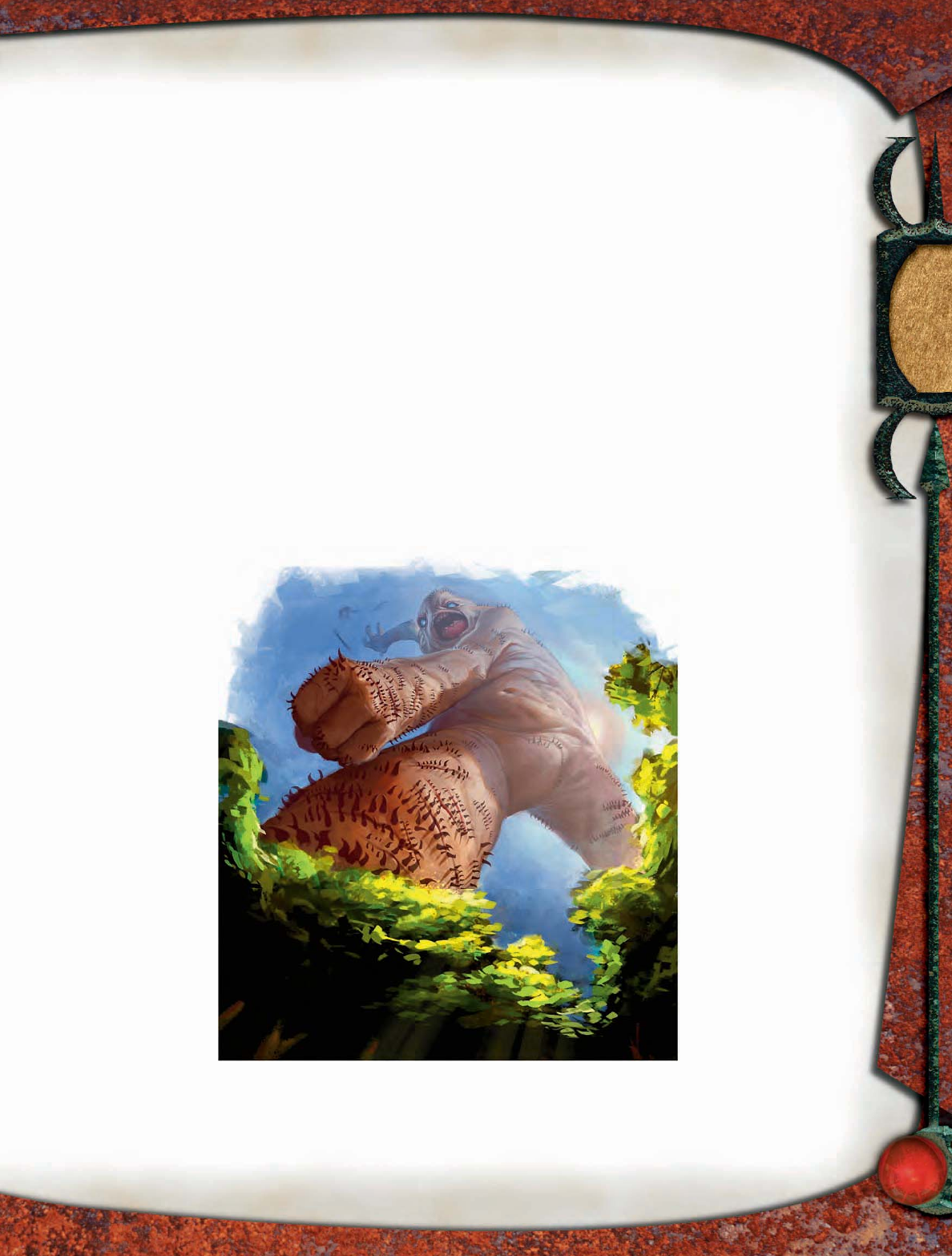
17
and ogres view Dalmosh as the ultimate expression of their
vicious, avaricious natures. Some orcs do the same, but
they see Dalmosh as a potential weapon, not as an object
of worship.
Those who summon Dalmosh do so to destroy their
enemies. No sane creature believes that Dalmosh is capable
of more than this. In fact, Dalmosh’s summoners know they
risk their lives, for he of the Infi nite Maws readily eats those
who remain nearby after a summoning ritual.
Grotesque Escape (EL 17): Dalmosh appears on the
Material Plane in response to the summoning spell of a
demonologist who is trying to escape the PCs. The spellcaster
allows himself to be eaten, slipping into the Gullet. Dalmosh
then rampages through the area, requiring the characters
to quell his violence. They then have to fi nd a way to follow
their enemy.
ECOLOGY
Dalmosh has no ecological niche. He simply devours every-
thing in his path, following the movement and noise that
attract him to a potential meal.
The Flesh Mountains, Dalmosh’s Abyssal home, stretch across
several layers of the Abyss. His dwelling is a vast cave eaten out
of those same mountains, where he lounges
and takes brief moments to
digest. The mountains eter-
nally grow larger, and only
Dalmosh’s endless eating
keeps them in check.
Some say that Dal-
mosh is the living will
of the Flesh Moun-
tains, a strange entity
that has existed as
long as the Abyss.
It is clear that Dal-
mosh can neither be
permanently killed,
nor can he remain
far from his bizarre
home for long. Two
days after his death
or his departure from
the Flesh Mountains,
he appears there
once again.
Dalmosh eats
endlessly, but he
is never full. His
gizzard contains a
gate that is the only
known entrance to
a demiplane known as Dalmosh’s Gullet.
The ground within the Gullet is like the interior of a great
beast’s guts. When a creature or item passes into the Gullet,
it appears 10 feet above the ground and falls. Howling gales
(severe winds, DMG 95) twist through the Gullet, picking
up debris and creatures. Those winds sometimes cross pla-
nar boundaries, depositing what they carry onto the Flesh
Mountains or elsewhere.
Creatures that Dalmosh swallows sometimes knowingly
choose to enter the Gullet rather than perish in his giz-
zard. Those unfortunate creatures that lack the means to
travel the planes become trapped. They survive by eating
the remains that fall from the sky, gathering magic items,
building materials, and other tools that survive the trip into
the Gullet. Here and there, crude settlements have arisen,
and Garnamastra is the largest of these. A rakshasa known
as the Eyeless Tyrant rules this place, backed by a small cabal
of assassins and spellcasters.
Environment: Dalmosh can survive in any earthly envi-
ronment, but he is most comfortable in temperate climes.
His home is the Flesh Mountains of the Abyss.
Physical Characteristics: Dalmosh is an enormous
humanoid-shaped creature covered in leathery fl esh and
scars. His head is all mouth except for his blue eyes. He is
50 feet tall and weighs ten tons.
Alignment: Dalmosh is ruthless and gluttonous. He has
no concern other than feeding his insatiable hunger, and
he is driven to destroy and infl ict
suffering. He is chaotic evil.
TYPICAL
TREASURE
Dalmosh has no trea-
sure, but ruins dot
the landscape within
the Gullet. Suppos-
edly, the lost treasures
of ancient civilizations
that Dalmosh de-
voured remain hidden
within those ruins.
If this is true, Dal-
mosh’s actual wealth
is incalculable.
CALLING
DALMOSH
Calling Dalmosh
requires a simple cer-
emony that involves
fine food and drink
worth 10,000 gp. The
summoner must mix
the food in a massive
vat, then perform a rit-
ual chant that lasts an hour. At the end of this
time, Dalmosh appears, devours the food, and then seeks
other sustenance.
Dalmosh of the Infi nite Maws
DALMOSH
Illus. by I. Medrano

18
DEADBORN VULTURE
This gigantic bird has black feathers, but like a vulture, its plum-
age doesn’t cover the ebony skin of its head. Its wings shine with
an oily substance. A pair of glowing red eyes peers out from above
a jagged beak.
Deadborn Vulture CR 8
Always NE Large magical beast
Init +3; Senses darkvision 60 ft., low-light vision; Listen +11,
Spot +15
Languages understands Common; cannot speak
AC 18, touch 12, flat-footed 15
(–1 size, +3 Dex, +6 natural)
hp 67 (9 HD); deadborn
Fort +8, Ref +11, Will +4
Speed 10 ft. (2 squares), fly 70 ft. (poor); Flyby Attack
Melee 2 claws +14 each (1d6+6 plus disease) and
bite +12 (1d8+3)
Space 10 ft.; Reach 5 ft.
Base Atk +9; Grp +19
Special Actions foul breath
Abilities Str 22, Dex 17, Con 14, Int 10, Wis 12, Cha 10
SA disease, foul breath
Feats Alertness, Flyby Attack, Lightning Reflexes, Multiattack
Skills Intimidate +8, Listen +11, Spot +15
Advancement 10–16 HD (Large); 17–27 HD (Huge)
Deadborn (Su) When a deadborn vulture is reduced to 0
hit points, it immediately dies and becomes a deadborn
vulture zombie that retains the vulture’s disease ability.
This transformation does not cause a flying deadborn
vulture to fall.
Disease (Ex) Claw, Fort DC 16 negates, incubation period 1
day, damage 1d4 Str. The save DC is Constitution-based.
Foul Breath (Ex) 30-foot cone, 1/day, nauseated 1d6 rounds,
Fort DC 16 negates. The save DC is Constitution-based.
Skills Deadborn vultures have a +4 racial bonus on Spot
checks.
Deadborn Vulture Zombie CR —
Always NE Large undead
Init +2, single actions only; Senses darkvision 60 ft.;
Listen +0, Spot +0
Languages —
AC 20, touch 11, flat-footed 18
(–1 size, +2 Dex, +9 natural)
hp 120 (18 HD); DR 5/slashing
Immune undead immunities
Fort +6, Ref +8, Will +11
Speed 10 ft. (2 squares), fly 70 ft. (clumsy)
Melee claw +15 (1d6+7 plus disease) or
Melee bite +15 (1d8+7) or
Melee slam +15 (1d8+7)
Space 10 ft.; Reach 5 ft.
Base Atk +9; Grp +20
Abilities Str 24, Dex 15, Con —, Int —, Wis 10, Cha 1
SA disease
SQ undead traits
Skills Listen +0, Spot +0
Feats Toughness
Advancement 19–32 HD (Large); 33–54 HD (Huge)
Single Actions Only (Ex) A deadborn vulture zombie can
perform only a single move action or standard action
each round. It can still charge.
Disease (Ex) Claw, Fort DC 19 negates, incubation period 1
day, damage 1d4 Str. The save DC is Constitution-based.
Necromancers create deadborn vultures from the eggs of
giant eagles and giant owls. Once grown, the resulting black
birds make excellent mounts that become undead creatures
when they die.
STRATEGIES AND TACTICS
A deadborn vulture attacks from above by making a diving
charge. It prefers to take out fl ying opponents fi rst, using its
claws in a Flyby Attack. It does the same to earthbound foes,
maintaining the advantage of airborne assaults. When it fears
for its life, a deadborn vulture uses its foul breath, catching
as many enemies in the cone as possible.
After death, a deadborn vulture becomes a zombie. It
continues to attack, but in its mindless state, it might land
and attack from the ground.
SAMPLE ENCOUNTERS
Deadborn vultures are most often encountered in the service
of powerful necromancers or infl uential blackguards. In
such servitude, they might congregate in large numbers.
Left on their own, they are loners that occasionally form
pair bonds.
When a live deadborn vulture becomes a zombie during
an encounter, the zombie’s Challenge Rating is not consid-
ered as part of the Encounter Level. However, a deadborn
vulture zombie has a CR of 6 when encountered solely in
that form.
Dark Wings (EL 8–10): From a crooked tower in the
center of an ancient forest, a wizard named Zeluzuss (NE
male human necromancer 10) plots his revenge against
the kingdom whose people drove him from his home and
killed his wife and servants. He has slain a few giant eagles
pqqqqqqqqqrs
DEADBORN VULTURE LORE
Characters who have ranks in Knowledge (arcana) can learn
more about deadborn vultures. When a character makes a
successful skill check, the following lore is revealed, including
the information from lower DCs.
Knowledge (Arcana)
DC Result
18 This creature is a deadborn vulture, a magical
beast that has two lives. It reanimates as a zombie
after it dies.
23 A deadborn vulture carries disease and can
breathe out a foul, nauseating cloud.
28 Those who know the proper formulas can make
deadborn vultures from the eggs of giant eagles or
giant owls. This result reveals those formulas.
pqqqqqqqqqrs
DEADBORN
VULTURE
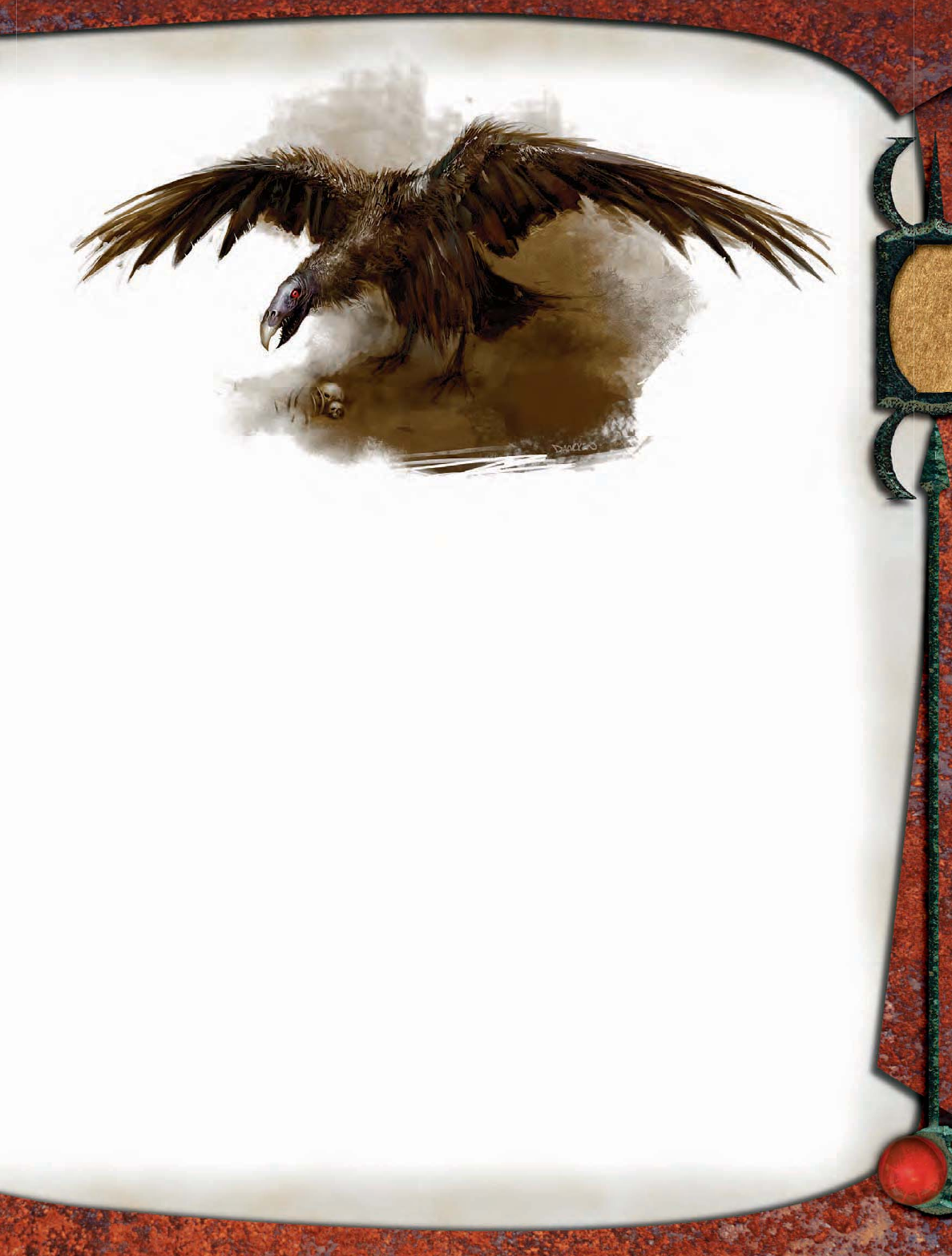
19
in the nearby mountains
and collected their eggs,
which he uses to main-
tain a small clutch of
deadborn vultures.
Zeluzuss has released
a few of them into the
wild to harry other
giant birds and spread
the pestilence of his new breed of
raptor. Even the wild vultures return to
Zeluzuss’s tower bearing the corpses of
those they’ve slain. One or two of the vile birds might
be encountered in the wilderness or in settlements near
Zeluzuss’s tower.
Darker Rider (EL 12): Zeluzuss sometimes wings about
the area on the back of one of his deadborn vultures, gather-
ing fresh corpses for his work and terrorizing any who carry
the banner of his hated homeland. A second deadborn vulture
accompanies him on these forays.
ECOLOGY
Deadborn vultures are loathsome, murderous creatures, cor-
rupted by the process that makes them. Unlike the mundane
vultures they resemble, deadborn vultures prefer live and
intelligent prey. They especially enjoy killing and feasting
upon other giant birds, a task they are well suited to.
Deadborn vultures are sterile. One reason they seek out
other giant birds is that a giant eagle or giant owl egg brooded
over by a deadborn vulture is corrupted, and the chick is born
a deadborn vulture.
After being reanimated as zombies, deadborn vultures do
not eat, sleep, or reproduce. Unlike most other zombies, they
remain loyal to creatures they were friendly with in life.
Environment: As created creatures, deadborn vultures
can be found anywhere, but they are usually found near
the temperate habitats of other giant raptors—forests or
mountains.
Typical Physical Characteristics: A deadborn vulture
stands just over 9 feet tall, has a 20-foot wingspan, and re-
sembles a giant vulture. Its oily black feathers, disheveled
appearance, and glowing red eyes identify it as something far
more sinister. After death, a deadborn vulture zombie looks
normal, but its
fl esh rapidly rots.
In either form, a dead-
born vulture weighs
about 450 pounds.
Alignment: All its
nobility stripped from it, a
deadborn vulture is a rapa-
cious creature that thrives
on death. Deadborn vultures
are always neutral evil.
TYPICAL TREASURE
Deadborn vultures don’t value treasure and have none. Their
masters are often wealthier for having such mighty raptors
in their service.
FOR PLAYER CHARACTERS
Deadborn vultures can’t be trained unless they are willing,
requiring one to be reared to the saddle or infl uenced to a
friendly attitude with a successful Diplomacy check. Training
a deadborn vulture requires four weeks of work and a DC 25
Handle Animal check. Riding a deadborn vulture requires
an exotic saddle. A deadborn vulture can fi ght when carrying
a rider, but the rider must succeed on a Ride check to attack
while the vulture does so.
A giant eagle egg or giant owl egg is worth 2,500 gp, and the
formulas and components necessary to make the egg hatch
a deadborn vulture cost 5,000 gp. Few trainers are willing
to rear or train a deadborn vulture, but those that are charge
2,000 gp to do so.
Carrying Capacity: A light load for a deadborn vulture is
up to 520 pounds; a medium load, 521–1,040 pounds; and a
heavy load, 1,041–1,560 pounds. A light load for a deadborn
vulture zombie is up to 700 pounds; a medium load, 701–1,400
pounds; and a heavy load, 1,401–2,100 pounds.
DEADBORN VULTURES IN FAERÛN
The drow of Cormanthor, who desire the corruption of all
the elves hold dear, created deadborn vultures. House Jaelre’s
necromancers devised these raptors, and the formulas have
spread to other drow houses. Now, a few deadborn vultures
live in the wilds of the ancient forest.
Deadborn vulture
DEADBORN
VULTURE
Illus. by Daarken
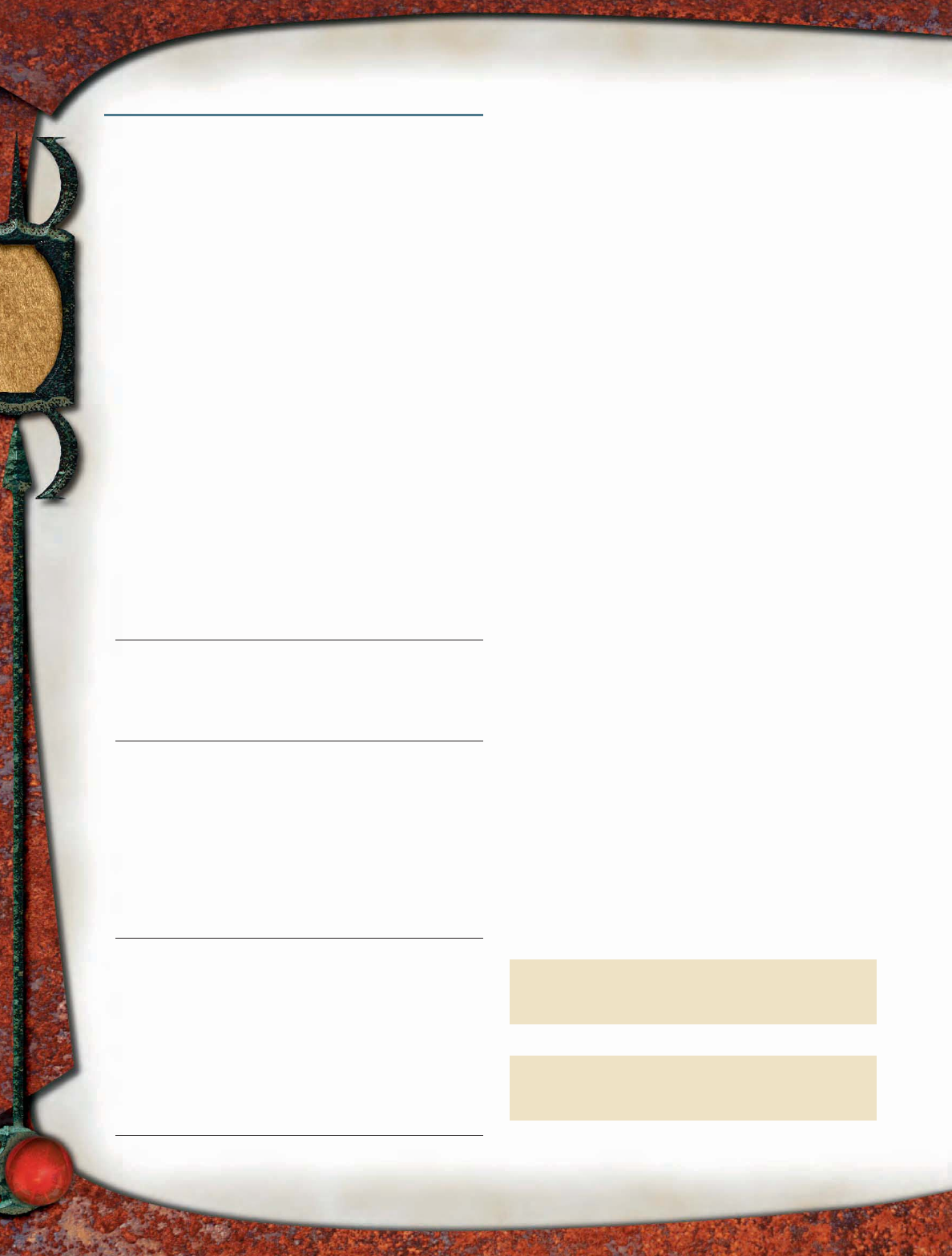
20
DEMON
As creatures aligned with evil and chaos, demons are
native to the Infinite Layers of the Abyss. They revel in
fear and destruction, following their depravity wherever
it leads.
A large number of demons belong to a race (and subtype)
known as tanar’ri. The tanar’ri form the largest and most
diverse group of demons, and they are the unchallenged
masters of the Abyss (at least in their eyes). Tanar’ri pos-
sess a number of racial traits that are summarized in the
glossary.
Some demons belong to other races, some of which predate
the rise of the tanar’ri. One of these is the obyrith race (and
subtype). Like tanar’ri, obyriths share racial traits as defi ned
in the glossary.
ADARU
A blue millipedelike creature rushes headlong on countless orange
insectile legs. Weeping dimples crusted with fi lth cover its body, and
it emits a cloud of foul vapor. As the creature moves, its grotesque
parody of a child’s face gnashes its dripping brown fangs.
Adaru CR 10
Always CE Medium outsider (chaotic, evil, extraplanar,
tanar’ri)
Init +6; Senses darkvision 60 ft.; Listen +17, Spot +17
Aura fetid cloud (30 ft.)
Languages Abyssal, Celestial, Common, Draconic, Infernal,
Terran; telepathy 100 ft.
AC 24, touch 12, flat-footed 22; Dodge, Mobility
(+2 Dex, +12 natural)
hp 110 (13 HD); DR 10/good
Immune electricity, poison
Resist acid 10, cold 10, fire 10; SR 18
Fort +12, Ref +10, Will +9
Speed 50 ft. (10 squares), burrow 30 ft., climb 50 ft., swim
30 ft.; Spring Attack
Melee bite +16 (1d8+4 plus poison)
Space 5 ft.; Reach 5 ft.
Base Atk +13; Grp +16
Atk Options aligned strike (chaotic, evil), poison (DC 22, 2d6
damage/1d6 Con)
Special Actions summon tanar’ri
Spell-Like Abilities (CL 13th):
At will—freedom of movement, greater teleport (self plus 50
pounds of objects only)
3/day—charm monster (tanar’ri only, DC 18)
Abilities Str 17, Dex 14, Con 19, Int 16, Wis 13, Cha 18
SA aligned strike, fetid cloud, poison, spell-like abilities,
summon tanar’ri
Feats Ability Focus (poison), Dodge, Improved Initiative,
Mobility, Spring Attack
Skills Balance +20, Bluff +20, Climb +19, Concentration +11,
Diplomacy +8, Disguise +4 (+6 acting), Escape Artist +10,
Hide +18, Intimidate +22, Jump +21, Knowledge (the
planes) +11, Listen +17, Move Silently +18, Sense
Motive +17, Spot +17, Survival +1 (+3 on other planes),
Swim +19, Tumble +20
Advancement 14–26 HD (Medium); 27–39 HD (Large)
Fetid Cloud (Su) An adaru constantly sprays a thin cloud
of vile mist in a 30-foot-radius spread. All non-evil
creatures in the area are sickened while within the
cloud. All evil-aligned creatures other than adarus
gain a +2 profane bonus on attack rolls, damage rolls,
saving throws, skill checks, and ability checks when in
the cloud.
This mist slicks the ground around the adaru, and
its wounds spray the same vile fluid. When an adaru
is reduced to half of its full normal hit points or fewer,
each square within 30 feet of it requires 2 squares of
movement for a non-evil creature to enter. This effect
doesn’t stack with that of any existing difficult terrain.
Summon Tanar’ri (Sp) 50% chance to summon 1d4 babaus;
1/day; caster level 10th. This ability is the equivalent of a
4th-level spell.
Skills An adaru has a +8 racial bonus on Balance, Climb,
Escape Artist, and Swim checks. It can take 10 on
Climb checks, even if rushed or threatened, and it can
choose to take 10 on a Swim check, even if distracted
or endangered. An adaru can use the run action when
swimming, provided it swims in a straight line.
Adarus are cunning demons that function best when leading
bands of other tanar’ri into battle. They are beings of utter
corruption, as well as capable leaders that bolster their fol-
lowers and hinder their foes.
Strategies and Tactics
An adaru always has a cadre of fawning followers that it has
charmed or lured into service. When battle is joined, the
adaru fi rst orders its minions to engage. It then moves to a
position where its fetid cloud turns the tide against its foes
and benefi ts the greatest number of its allies.
Of all its abilities, the adaru’s greatest asset is its speed.
Adarus can scuttle across nearly any terrain, swim though
most types of fl uid, and even burrow through solid rock.
An adaru’s freedom of movement ability gives it even more
mobility, defying the snares opponents might try against
pqqqqqqqqqrs
ADARU LORE
Characters who have ranks in Knowledge (the planes) can
learn more about adarus. When a character makes a success-
ful skill check, the following lore is revealed, including the
information from lower DCs.
Knowledge (the Planes)
DC Result
20 This tanar’ri demon from the Abyss is an adaru.
No terrain presents a serious obstacle for
adarus. They use their mobility to slip past their
opponents’ defenses to land a poisoned bite.
25 Adarus are resistant to spells, but good-aligned
weapons can penetrate their dense hides.
30 An adaru can use the special organs dimpling its
body to release a spray that sickens the good and
emboldens the wicked. This substance slicks the
ground, further hindering those who aren’t evil.
pqqqqqqqqqrs
DEMON
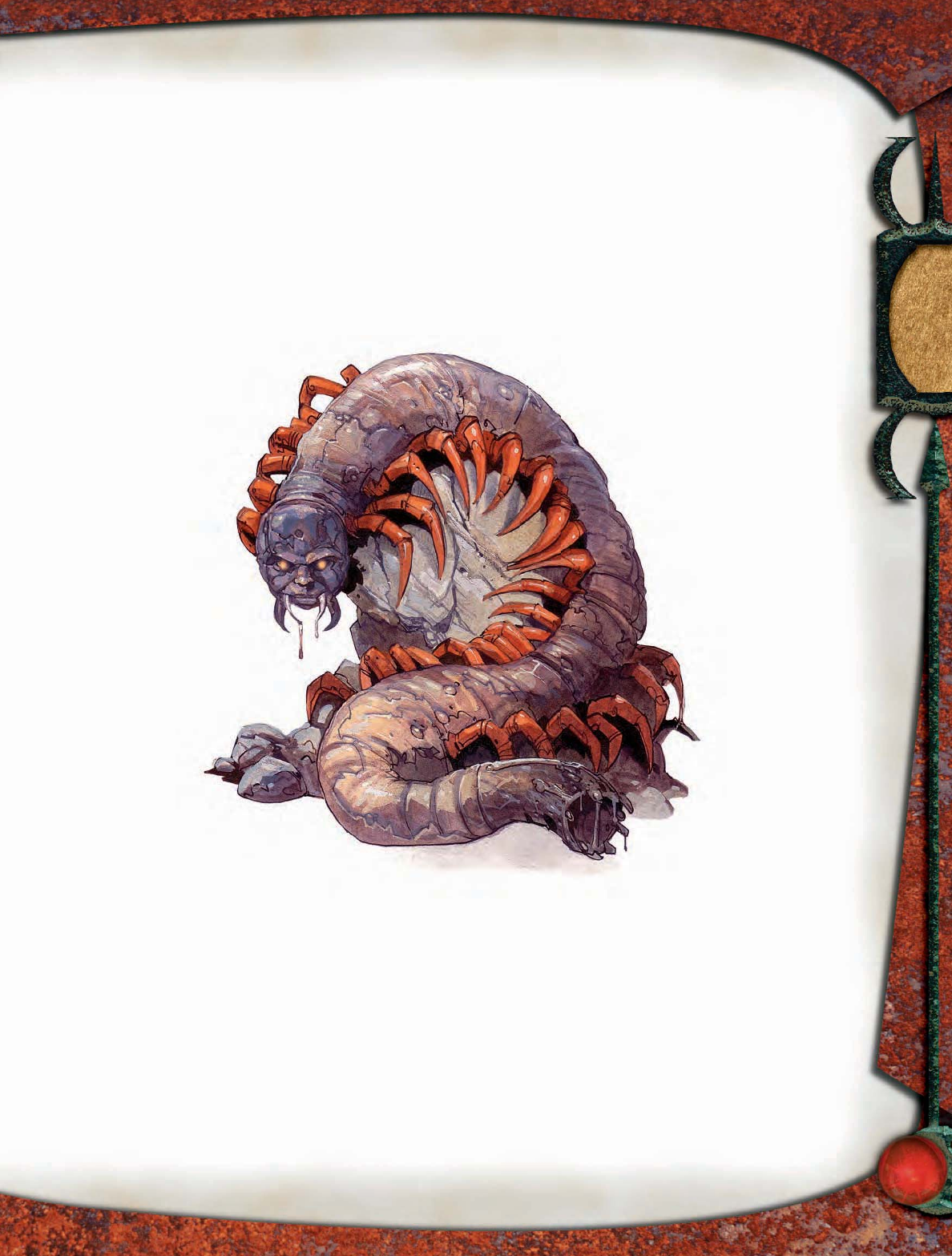
21
it. It fearlessly combines Dodge, Mobility, and Tumble to
move to any position it desires on the battlefi eld; it prefers
fl anking positions that aid its underlings. Spring Attack
allows it to deliver nasty bites while avoiding immediate
retaliation, possibly crawling up a wall to a place unreach-
able by its opponents. It uses greater teleport to escape an
unfavorable battle.
Sample Encounter
Adarus are never found alone. In the Abyss and else-
where, they have a following of demons and other wicked
creatures. Adarus are not above using any creature as a
crony, but they prefer babaus. Those cruel fiends
mirror the adaru’s sensibilities, and
the two complement each other
in combat.
Cult of Mal’tanx (EL 12):
When a foolish cult lead-
er opened a gate under a
peaceful city, the adaru
Mal’tanx slipped from
the Abyss with its four
babau minions (MM
40). Displeased with
the sacrifi ce the cult of-
fered, Mal’tanx murdered
and devoured the cult’s
leader and assumed her role.
Now the adaru sits at the cen-
ter of a web of depraved cultists
that hold positions throughout
the city. When innocent
folk start to disappear
to feed Mal’tanx’s
degeneracy, and a
few good-hearted
leaders in the city
are murdered with-
in the safety of secured
homes, evidence points to fi endish infl u-
ence. Who can uncover the conspiracy and
deal with the fi ends at its center?
Ecology
Adarus are treachery and deception given form. When a
mortal speaks an untruth that has grave consequences, it is
said that a new adaru is born, taking shape in the bowels of
the Abyss. It experiences a sudden awareness and a powerful
urge to work wickedness. A number of adarus spend their
existence searching for the mortals that awakened them,
scouring the planes to reward their creators with excruciating
pain and endless torment.
As tanar’ri, adarus have no need for food or drink, but
they feast all the same. They savor the bloody gobbets torn
from their victims, exclaiming at the savory fluids and
relishing the morsels that slide into their gullets. Adarus
are also famed for taking trophies. Fascinated by other shapes
and forms of fl esh, adarus take and keep body parts they do
not possess.
Environment: Adarus are native to the Infi nite Layers
of the Abyss. They are most common on the 444th layer,
where their terrifying corruption has transformed the
barren landscape into a soupy morass of sticky mud. On it
fl oat dismembered body parts harvested from the countless
petitioners cursed to spend an eternity of torment in the
mud’s depths.
Typical Physical Characteristics: An adaru’s body grows
up to 8 feet long and weighs as much as 250 pounds. At its
hind end is a great sucking organ crusted with fi lth,
while at the other snaps a face like that of a
human child, but with long brown fangs.
Adarus have scaly bodies, marred with
scores of orifices, each one spraying
corruption. Hundreds of bright or-
ange, armored legs extend from
its underside, each narrowing to
a sharpened point. The de-
mon uses these appendages
to run, swim, tumble, and
climb with eerie grace, and
to burrow through almost
any surface.
Alignment: Ada-
rus are born chaotic
evil. They are pitiless
creatures whose exis-
tence is defined by
the suffering they
inflict on others.
Adarus carelessly
use their minions,
expending them
in great numbers.
Such massacres amuse
adarus, and they giggle
throughout a battle, even if they
are losing.
Society
Adarus are intimately aware of their standing when com-
pared to the more powerful denizens of the Abyss. They
pale before the sheer brutality of the balors and the sav-
agery of the goristros (Fiendish Codex I 40). However, many
wise and mighty demons have a use for the cunning ada-
rus, who employ all sorts of trickery to form squads of
brutal minions.
To make up their lack of raw power, adarus worm their
way into the minds of lesser fiends, lying and making
false promises. Some see through the cheap ploys, but
the weak and desperate are easily fooled, especially when
Adaru
DEMON
Illus. by C. Critchlow
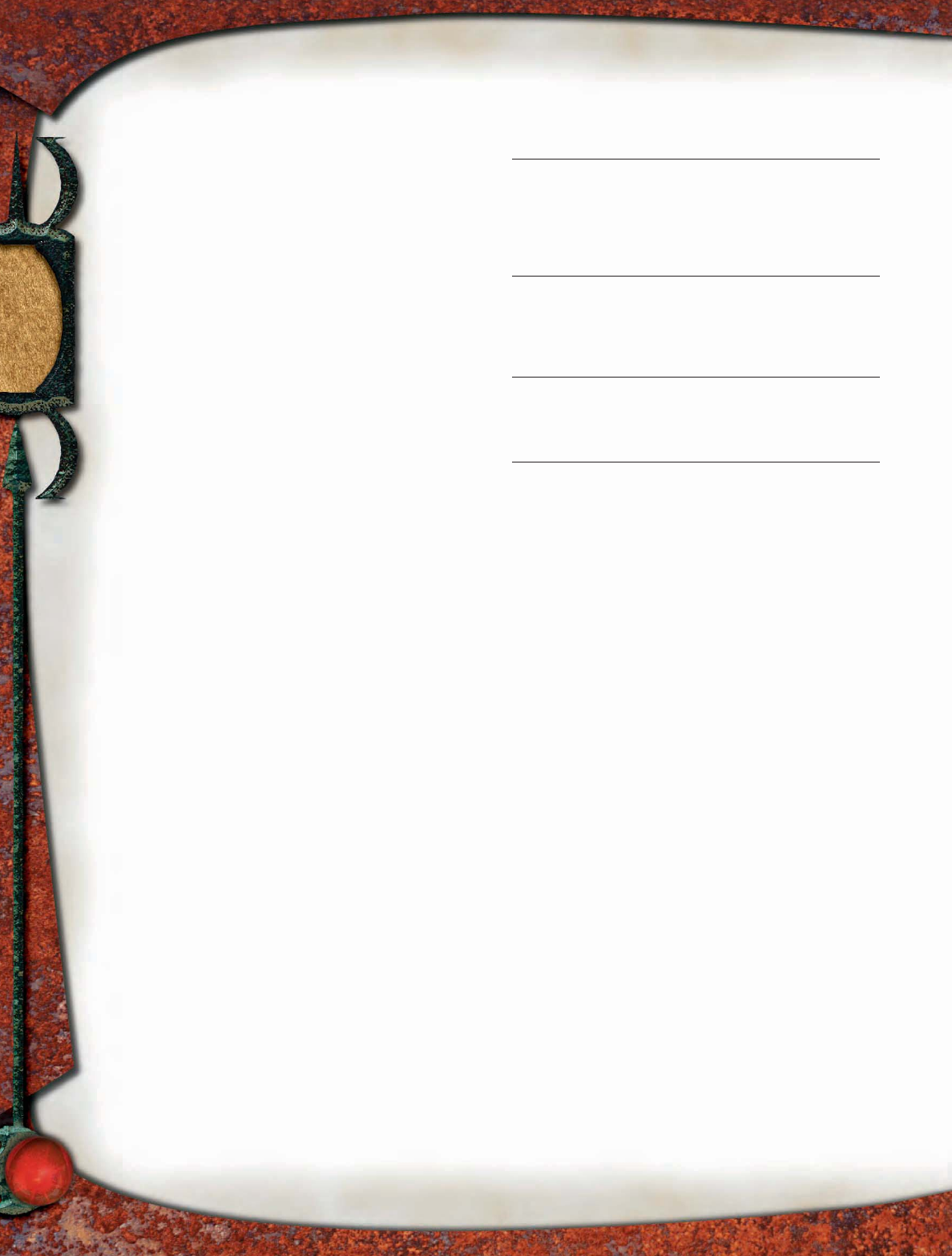
22
faced with an opportunity to increase their own standing.
Thus, adarus recruit heavily from lesser demons, exploit-
ing them and discarding them with caprice. Those that
can’t be cajoled are charmed and end up doing the adaru’s
bidding anyway.
Typical Treasure
Adarus love wealth and collect it as a sign of their impor-
tance. They equally enjoy grisly trophies, keeping all sorts
of body parts that are adorned with the belongings of the
fallen. Such mementos remind the adaru of its specific
victims as it picks over its treasures, chuckling and recall-
ing the fond memories of the torment it inflicted. An
adaru possesses standard treasure for a creature of its
Challenge Rating. It favors jewelry and items that bring
up memories of its misdeeds, but it also keeps coins and
gems to use as bribes.
For Player Characters
An evil spellcaster can summon an adaru using a summon
monster IX spell. Treat the adaru as if it were on the 9th-level
list on the Summon Monster table (PH 287). Evil clerics
can use a greater planar ally spell to call an adaru, but the
adaru’s payment demand involves the sacrifice of intel-
ligent beings.
Adarus in Eberron
Adarus are native to Xoriat. Eons ago, they were rivals of
the kaortis (Fiend Folio 108), and they were powerful enough
to wage all-out war. The campaign was doomed from the
start—the adarus could not form a solid coalition against
their enemies. Individual adarus betrayed the war effort to
further their own ends. This turn of events led to a series of
devastating defeats, and the adarus were driven almost to
extinction. In the intervening centuries, they have recovered,
and they now seek places on Eberron to work their wicked-
ness. More than a few adarus wish to free imprisoned daelkyr,
hoping to earn a place in the terrestrial courts of the mighty
lords of madness.
Adarus in Faerûn
Adarus are native to the Barrens of Doom and Despair,
where they scour the varied landscapes for larvae and
gather armies of lesser fiends to throw at one another in
internecine war. Talona created them, and large numbers of
adarus infest the swamps around the Palace of Poison Tears.
There they spread their corruption, working to expand the
swamp and their mistress’s infl uence on the Barrens and
other planes.
CARNAGE DEMON
Rushing forward, uttering an unintelligible battle cry, is a broad-
shouldered creature with overlong arms that end in massively
oversized, clawed hands. Similar creatures follow it, seemingly
drawing strength from their proximity to one another.
Carnage Demon CR 4
Always CE Medium outsider (chaotic, evil, extraplanar)
Init +0; Senses darkvision 60 ft.; Listen +4, Spot +4
Languages Abyssal
AC 13, touch 10, flat-footed 13
(+3 natural)
hp 19 (3 HD); DR 5/silver
Immune electricity, poison
Resist acid 10, cold 10, fire 10
Fort +7, Ref +3, Will +3
Weakness destructive appetite
Speed 30 ft. (6 squares)
Melee 2 slams +8 each (1d4+5)
Space 5 ft.; Reach 5 ft.
Base Atk +3; Grp +8
Atk Options aligned strike (chaotic, evil), carnage, reaving
fists
Abilities Str 20, Dex 10, Con 14, Int 5, Wis 6, Cha 6
SA aligned strike, carnage, reaving fists
Feats Great Fortitude, Iron Will
Skills Climb +11, Jump +11, Listen +4, Spot +4, Survival +4
Advancement 4–9 HD (Medium)
Destructive Appetite (Ex) A carnage demon is a threat
even to its allies. After every successful melee attack, a
carnage demon must succeed on a DC 14 Will save. If it
fails, it attacks the nearest creature that is not a carnage
demon whenever it is unable to attack an enemy during a
given round.
Carnage (Su) For each other carnage demon within 30 feet,
a carnage demon gains a +1 bonus on attack rolls and
damage rolls, up to a maximum of +5.
Reaving Fists (Ex) A carnage demon’s slams ignore damage
reduction that can be overcome by any metallic material
such as silver, cold iron, or adamantine.
Carnage demons exist only to destroy, and they revel in the
ruin they wreak.
Strategies and Tactics
Despite having massive claws, which they use to climb,
carnage demons prefer to pummel their opponents. A
lone carnage demon is still a brutal adversary, but such a
loner flees if reduced to half of its full normal hit points
or fewer. All carnage demons prefer to fight alongside
individuals of their kind, venting their hatred on all
other creatures.
In a group, carnage demons remain close to each other as
they attack. Each one lets its fury rather than any sense of
tactics dictate where its next attack is aimed, usually pound-
ing whoever damaged it the most during the previous round.
If fi ghting opponents that have no silvered weapons, carnage
demons gladly provoke attacks of opportunity to get in among
their enemies, quickly overwhelming softer targets such
as spellcasters.
Carnage demons are a danger to all creatures that aren’t
carnage demons. A carnage demon that has succumbed to its
destructive appetite attacks nearby allies for no better reason
than being unable to move to an enemy and attack it during
the current round.
DEMON
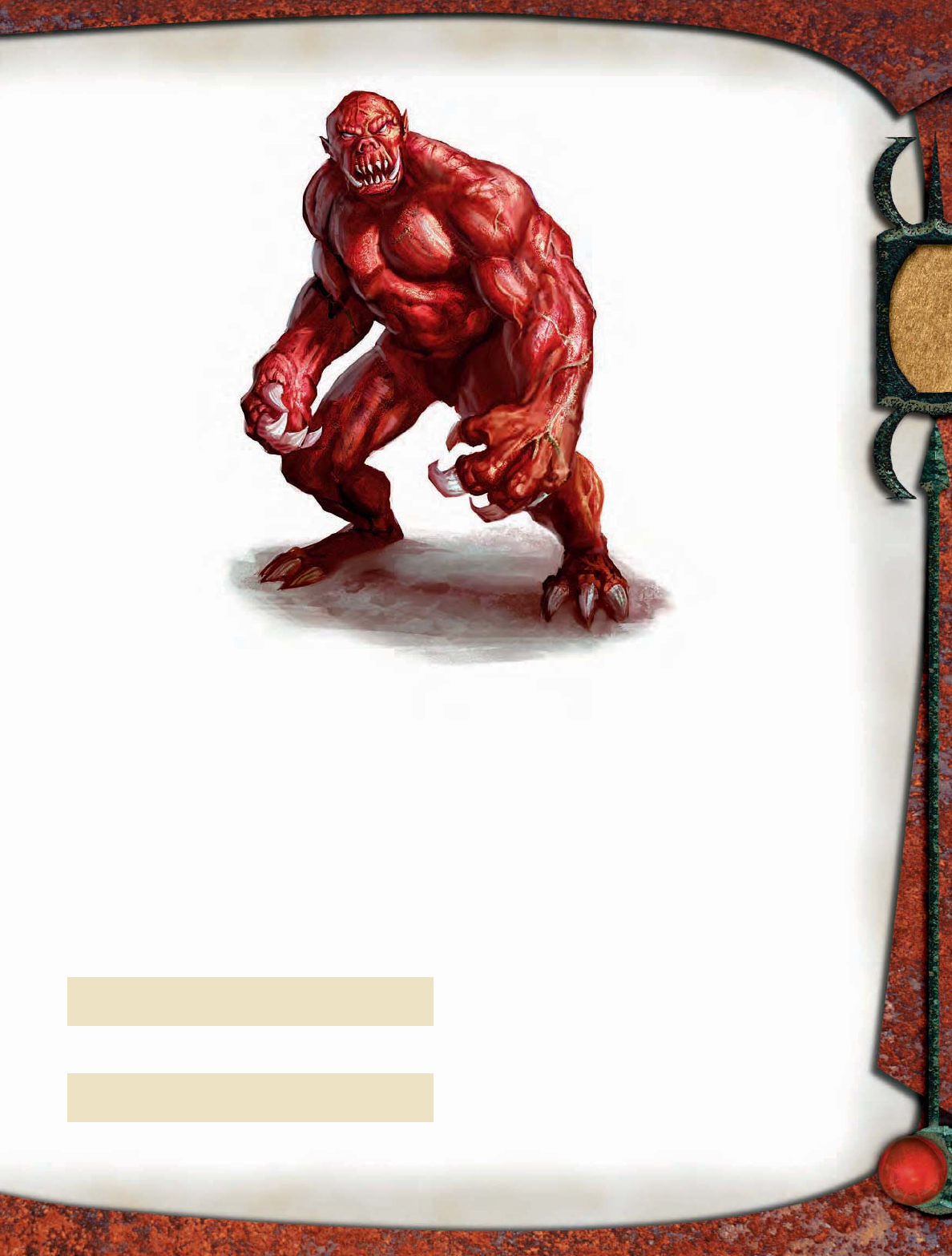
23
Sample Encounters
Carnage demons are encountered in
groups, ranging from a pair of lackeys
to mobs of thousands. Most groups,
however, are made up of two to ten
of these creatures. Other demons
might use carnage demons as min-
ions, but such demonic leaders
wisely keep the carnage demons at
a distance.
Any demon that has the abil-
ity to summon dretches can
instead choose to summon
half that number of car-
nage demons.
Arrogant Assassin
(EL 6): A powerful en-
emy of the PCs has
dispatched a vrock (MM
48) to eliminate them.
The vrock appears in their
midst, but the fickle fiend
deems the characters un-
worthy foes. It instead
summons three car-
nage demons to do
the deed, then uses
greater teleport to find
more entertaining prey.
Rampage (EL 9): Fourteen
carnage demons made it to the Material
Plane through an ancient portal that func-
tions only when the stars are right. They’ve destroyed a
small outpost and a trading thorp, losing six of their num-
ber in the process. The pack of eight’s current path leads
to an unsuspecting village. PCs have to track the fi ends and
destroy them before they tear through the town, killing
and destroying all they see.
Ecology
Carnage demons are the brutes among the
lesser fi ends of the Abyss. They are the de-
structive manifestation of chaos, spurred
on by a burning desire to batter other
creatures in the bloodiest and most
painful ways possible. Although they
are similar in power to dretches,
they don’t share the aimlessness of
those dull fi ends. Instead, carnage
demons are fi lled with the singular
purpose of pure destruction.
Some consider carnage demons
to be a forced evolution of the pathet-
ic dretches, the product of a demon
lord’s attempt to create a more use-
ful lesser demon. This theory gains
some credence from the fact that,
unlike most demons, carnage
demons are not tanar’ri. Their vul-
nerability to silvered weapons
suggests they might have
been created using ma-
terials from or related
to devils.
Environment: Car-
nage demons, like most
demons, are extraplanar creatures
that are native to the Infi nite Layers of the
Abyss. Mobs of carnage demons can be found anywhere on
that plane. They are always eager to spread destruction and
slaughter, so they use any portal or gate they encounter,
having no concern for where it might lead. As such, car-
nage demons can also be found near any place that harbors
a gateway to the Abyss.
Typical Physical Characteristics: A carnage demon has
a powerful humanoid build that borders on apelike, with
long arms hanging nearly to the ground. Those arms end in
forearms the size of tree trunks, as well as stubby hands with
thick fi ngers and claws. The fi end’s fanged mouth takes up
most of its face, and its head seems slightly smaller than is
proportional for its body.
Carnage demons have skin that ranges from a bloody
crimson to a darker red-brown. A typical carnage demon
stands nearly 6 feet tall and weighs over 300 pounds.
Alignment: Carnage demons embody destructive malevo-
lence. Not only do they spread wanton violence, they also
enjoy infl icting suffering.
Society
The carnage demon’s particular purpose of mad destruction
doesn’t lend itself to fi tting into any organized society, even
pqqqqqqqqqrs
CARNAGE DEMON LORE
Characters who have ranks in Knowledge (the planes) can
learn more about carnage demons. When a character makes
a successful skill check, the following lore is revealed, includ-
ing the information from lower DCs.
Knowledge (the Planes)
DC Result
14 This is a carnage demon, a fi end from the Abyss
that lives only to kill in as injurious a manner as
possible. This result reveals all outsider traits.
19 Carnage demons are resistant to most forms of
energy, and they have skin that only silver can cut
through reliably.
24 A carnage demon’s fi sts can pound through nearly
any material. The more carnage demons present,
the more powerful their attacks become.
pqqqqqqqqqrs
Carnage demon
DEMON
Illus. by M. Coimbra
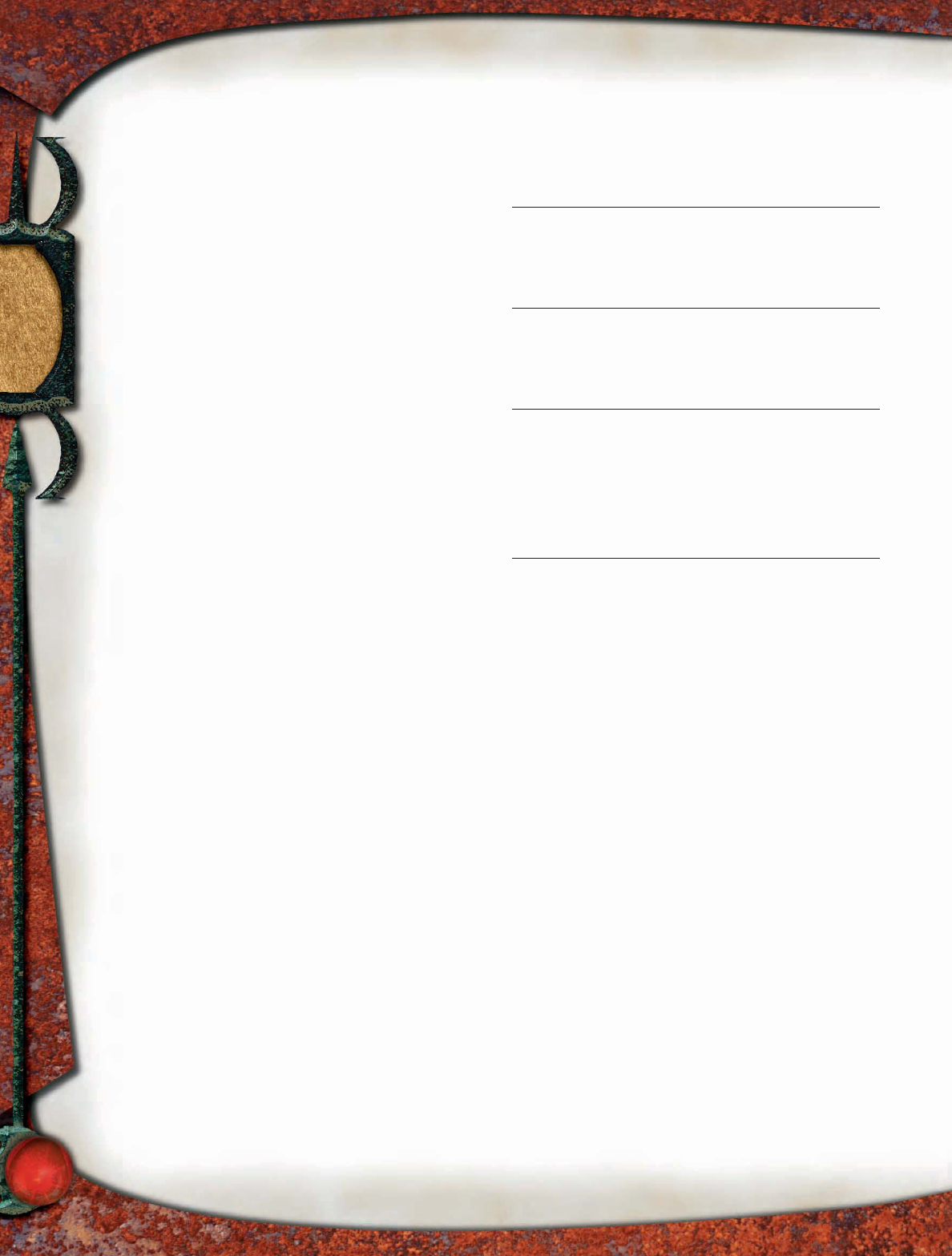
24
a demonic one. Its dim intellect allows it to be easily enticed
by the promise of devastation. In many cases, more powerful
fi ends, especially the more cunning demons such as adarus
or succubi, loosely control groups of carnage demons.
In the vast hordes of fi endish armies that battle on the
Lower Planes, demonic generals send mobs of carnage
demons behind the fi rst waves of dretches, since dretches
are more likely to rush toward the enemy if the threat of
death at the fi sts of carnage demons is spurring them onward.
Carnage demons are perfect shock troops—their savagery
brings fear, death, and confusion to the opposing forces.
Typical Treasure
Carnage demons carry no possessions. Greater demons that
employ these fi ends might send scavengers to scrounge for
valuables from the victims of the carnage demons, so such
overlords have additional treasure equal to what a creature of
the carnage demon’s Challenge Rating might carry.
For Player Characters
An evil spellcaster can summon a carnage demon using
summon monster IV or a higher-level summon monster spell.
Treat the carnage demon as if it were on the 4th-level list on
the Summon Monster table (PH 287).
Carnage Demons in Eberron
Carnage demons are native to Shavarath, the Battleground,
where they are the vanguard of demonic forces that assault
the fortresses of that plane. During the Last War, conjurers
from a group known as the Shavarath Cabal offered their
services as experts in siege warfare. Once employed, these
spellcasters could overwhelm nearly any fortifi cation, leav-
ing no survivors. Rumors persist that the members of the
Shavarath Cabal traffi cked with fi ends from the Battleground,
using mobs of carnage demons, letting them loose on targeted
strongholds. None yet live to substantiate those claims.
Where the members of the cabal are now, in the aftermath
of the Last War, remains a mystery.
DRAUDNU
A hairless creature about the size of a human surges forward on three
muscular legs attached to its top. Swollen sacs of fl uid bulge from its
body. A single pulsing red eye stares out from a mass of featureless
wrinkled fl esh that must be the creature’s head, but that mass is at
the creature’s bottom. From around its eye extend three arms, each
ending in a hook of bone.
Draudnu CR 10
Always CE Medium outsider (chaotic, evil, extraplanar,
obyrith)
Init +4; Senses darkvision 60 ft., true seeing; Listen +20,
Spot +20
Aura form of madness (60 ft.)
Languages Abyssal, Common; telepathy 100 ft.
AC 21, touch 14, flat-footed 17; Dodge, Mobility
(+4 Dex, +7 natural)
hp 119 (14 HD); fast healing 5; DR 10/lawful
Immune acid, mind-affecting spells and abilities, poison
Resist cold 10, electricity 10, fire 10; SR 18
Fort +13, Ref +13, Will +12
Speed 50 ft. (10 squares)
Melee 3 flesh hooks +18 each (2d6+4/19–20 plus immobilize)
Space 5 ft.; Reach 5 ft. (20 ft. with flesh hooks)
Base Atk +14; Grp +18
Atk Options Combat Reflexes, aligned strike (chaotic, evil)
Special Actions acid spray
Abilities Str 18, Dex 19, Con 18, Int 13, Wis 16, Cha 17
SA acid spray, aligned strike, form of madness, immobilize
Feats Combat Expertise, Combat Reflexes, Dodge, Improved
Critical (flesh hooks), Mobility, TrackB
Skills Balance +30, Climb +21, Escape Artist +21, Jump +31,
Knowledge (the planes) +10, Listen +20, Search +18,
Spot +20, Survival +20 (+22 on other planes, +22
following tracks), Tumble +23, Use Rope +4 (+6 bindings)
Advancement 19–36 HD (Medium); 37–54 HD (Large)
Form of Madness (Su) When a draudnu comes within 60
feet of a creature, that creature must succeed on a DC 20
Will save or believe that something is growing inside it,
becoming sickened. The sickened condition is permanent
until the insanity is cured by greater restoration, heal,
miracle, or wish. A creature that successfully saves cannot
be affected again by that same draudnu’s form for 24
hours, and a creature that fails can be affected only once
until cured. Chaotic evil outsiders are immune to this
ability. This is a mind-affecting ability. The save DC is
Charisma-based.
Immobilize (Ex) When a draudnu deals damage with a
flesh hook, it can detach the end of that hook in the
foe it struck, fastening that opponent to a surface such
as a floor or wall. (The draudnu’s hook end regrows
immediately.) That enemy must succeed on a DC 21
Reflex save or be immobilized (see sidebar). This ability
doesn’t work if the hook can’t fasten a creature to a
surface. The save DC is Strength-based.
An immobilized opponent can pull itself free by
taking a move action and making a DC 21 Strength
check or Escape Artist check. However, the act of pulling
free deals that foe 1d10 points of damage, unless it or
someone else takes a standard action and succeeds on
a DC 21 Heal check to dislodge the hook first. The check
DCs are Strength-based.
DEMON
pqqqqqqqqqqqqqqqqqqqqrs
NEW CONDITION: IMMOBILIZED
Introduced in Tome of Magic, the immobilized condition pre-
vents a creature from moving from the space in which it starts
its turn. An immobilized creature can attack and cast spells,
and it keeps its Dexterity bonus to Armor Class. Flying crea-
tures that become immobilized when aloft can control their
descent so they don’t take falling damage, but they are incapa-
ble of moving from their current space until the condition ends,
descending at a rate of 20 feet per round. If an immobilized
flying creature can hover, it can maintain its altitude, but it still
can’t move from its space until the condition ends.
pqqqqqqqqqqqqqqqqqqqqrs
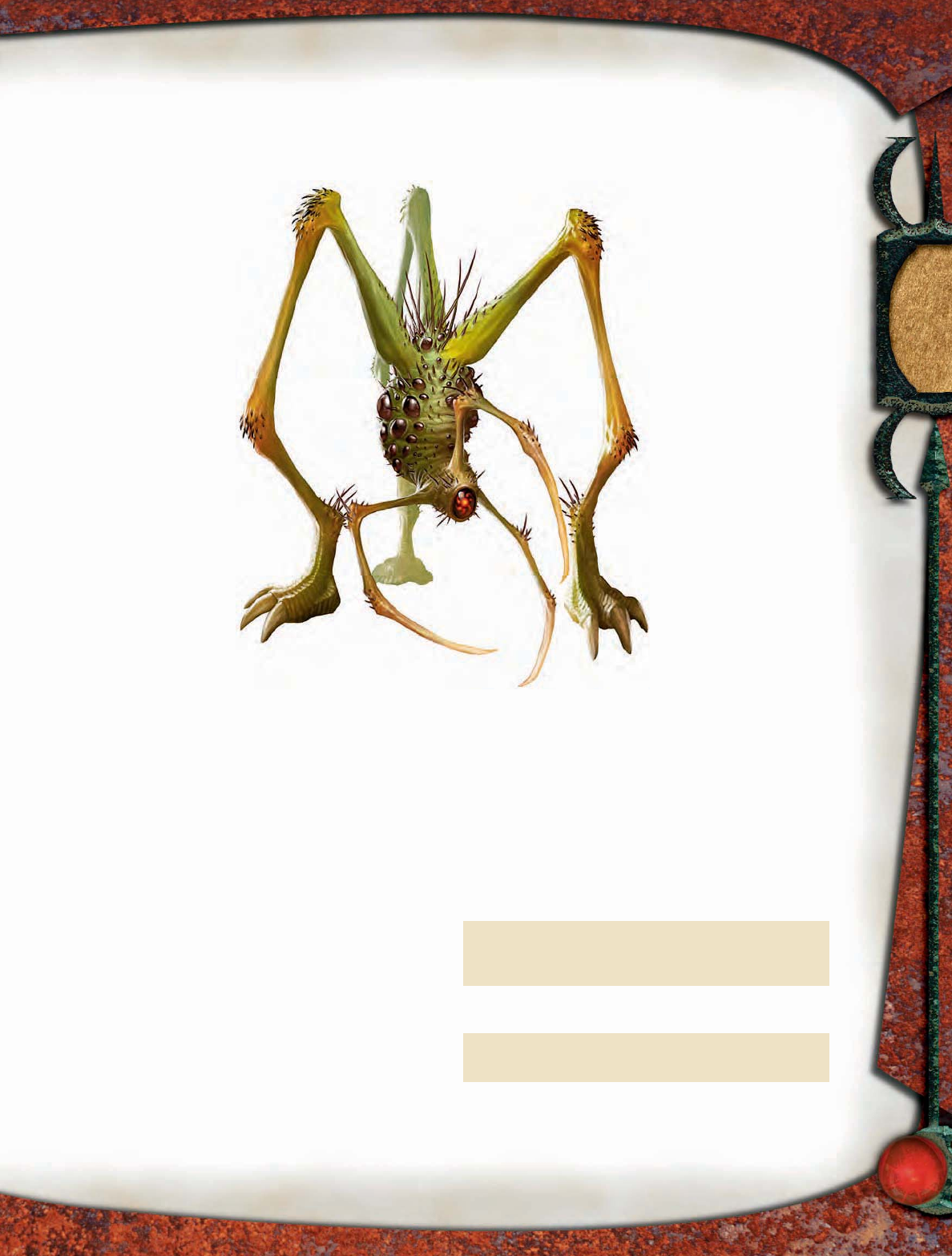
25
Acid Spray (Ex) Whenever a draudnu takes damage, it
sprays acidic fluid from the sacs on its body, dealing
2d4 points of acid damage to all creatures in a 5-
foot-radius burst (Reflex DC 21 half). The save DC is
Constitution-based.
Skills Draudnus have a +8 racial
bonus on Balance and Jump
checks.
Draudnus are ruthless killers
created to rid the Abyss of
non-obyriths. They fight an
eternal but hopeless war in
the fi elds of ruin and misery
that make up the vile home
of demons.
Strategies
and Tactics
A draudnu charges to
within reach of its foes,
then begins madly hack-
ing away with its hooks. When
facing multiple enemies, the
draudnu tries to immobilize two.
It then focuses its ire on im-
mobilized targets, felling
them as quickly as pos-
sible before moving on
to new foes.
A draudnu uses its speed
and Mobility to command the fi ght. It rarely
eschews attacking, instead making a single
attack and using Combat Expertise to increase its AC if it
needs to close the gap between itself and a chosen target.
Sample Encounter
Draudnus, like other obyriths, are scarce, having been
hunted nearly to extinction by the tanar’ri. Antisocial by
nature, they are rarely encountered in groups that contain
more than four members.
A Hard Place (EL 12): A pack of three draudnus
emerged onto the Material Plane through an ancient gate,
pursuing a gang of five babaus (MM 40). An evil conjurer
activated the gate and dispatched the babaus to kill a
priest of a mountaintop church of Pelor and retrieve an
item housed there. Unaware that the draudnus slew their
employer, the babaus snuck into the church, leaving their
tracks about the grounds. The draudnus soon followed and
assaulted the church directly, one of their number falling
in a pitched battle that took the lives of a large number of
clerics and monks. Reveling in the chaos, the babaus have
hidden within the church’s catacombs while the draudnus
lay siege to the church’s sanctuary. Only once the draudnus
are killed or driven away do the babaus make their play
for their target.
Ecology
Since the terrifying days when Obox-Ob, Demon Prince of
Vermin, ruled in the Abyss, before the tanar’ri rose up and cast
their creators down, draudnus have always been born in the
bone fi elds surrounding the nameless castle of Pale Night,
the Mother of Demons. Formed from
the remains of eladrins who fool-
ishly waged a campaign against
demons all the way into the 600th
layer of the Abyss, draudnus are
created by Pale Night. She steps
out onto a fragile balcony of her
fearsome citadel and gazes over
the skeletons that litter her do-
main. With a dreadful whisper,
she breathes life into eladrin
bones, recasting them in a
form conceived in the very
heart of lunacy.
Environment: Draud-
nus, also called Children of Pale
Night, are native to the Infinite
Layers of the Abyss. They are com-
mon on the 600th layer, enslaved
to the Mother of Demons.
Typical Physical Char-
acteristics: Draudnus stand
7 feet tall and weigh about
300 pounds. They have
thick and rubbery skin,
three powerful legs, and three
arms, each ending in a hook of bone wrapped
in hardened, scaly fl esh. Their bodies, which seem to be
biologically reversed, are covered in dark blisters that pop
pqqqqqqqqqrs
DRAUDNU LORE
Characters who have ranks in Knowledge (the planes) can
learn more about draudnus. When a character makes a suc-
cessful skill check, the following lore is revealed, including the
information from lower DCs.
Knowledge (the Planes)
DC Result
20 A draudnu, as this creature is called, is a demon
from the Abyss. The draudnu is a fi erce fi ghter that
can extend its hooks up to 15 feet. It can detach
hooks to hold its prey in place.
25 Draudnus have acid-fi lled sacs all over their skin,
and these sacs burst when the demon is struck.
Lawful-aligned weapons are effective against them.
30 The draudnu belongs to a rare race of demon
known as obyriths. All draudnus are resistant to
spells. This result reveals all obyrith traits.
35 Those who look upon a draudnu come to believe
that they have something growing inside them, a
sickening thought that can’t be shaken.
pqqqqqqqqqrs
Draudnu
DEMON
Illus. by J. Zhang
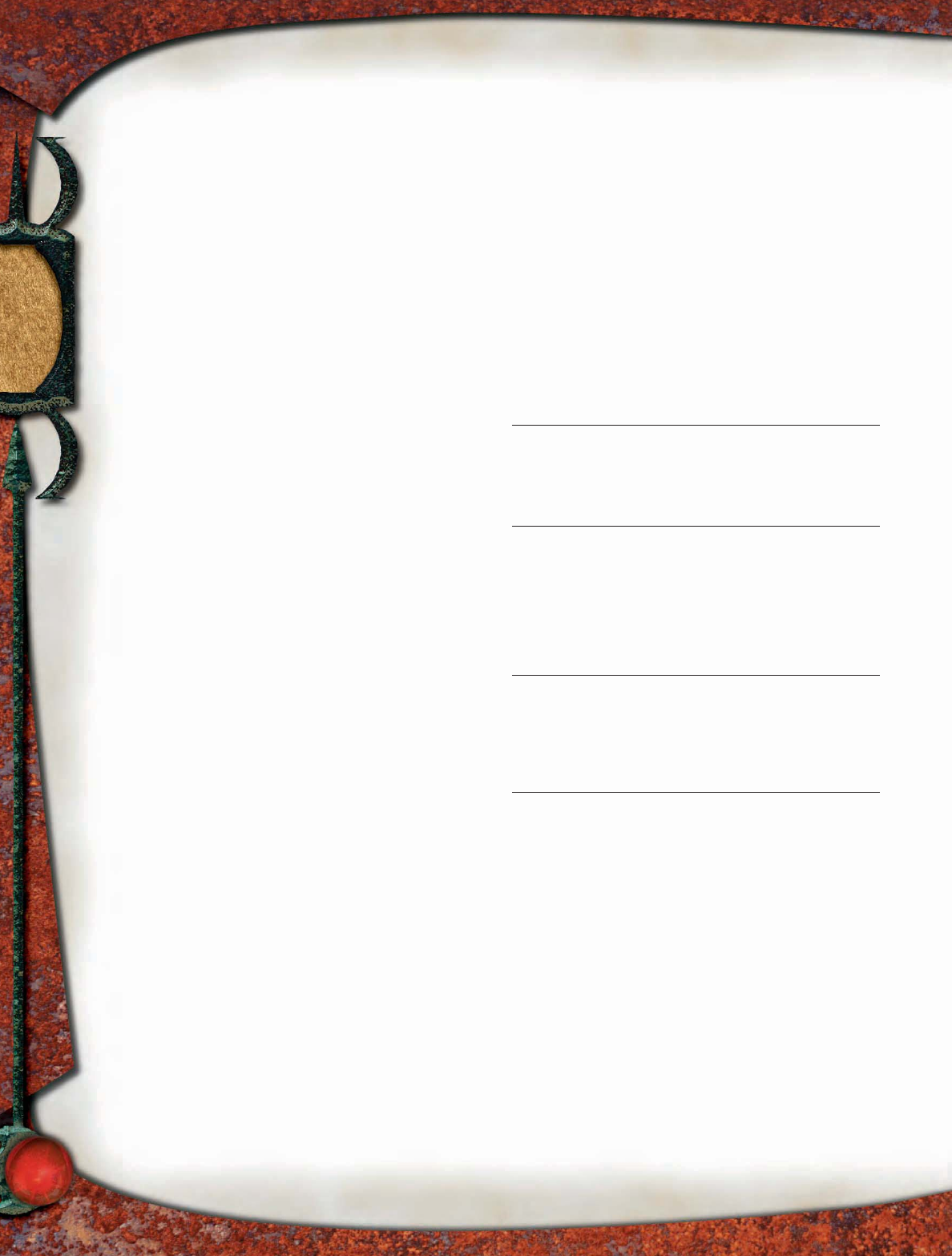
26
when struck. On its face, a draudnu has a bloody red eye
where its mouth should be.
Alignment: Draudnus are born without an ounce of
kindness, wild with a thirst for vengeance and bloodshed.
They are always chaotic evil.
Society
Draudnus were created to hunt and to kill. These fi ends go
forth bent on murder, fi lled with a hatred of all creatures
except obyriths. They mercilessly slay anything they can,
especially the minions of Baphomet on the 600th layer of
the Abyss, reveling in destruction and bloody torment. Born
from the corruption of the remains of celestials, they retain
little of the memories and none of the harmonious virtues
of their former selves. They fear only their ancient mother,
Pale Night.
Typical Treasure
Draudnus have no use for wealth, treasure, or anything of
the kind. They have none.
Draudnus in Eberron
Xoriat, the Realm of Madness, is home to the obyriths of
Eberron. Although a great and varied number of creatures
call this plane home, none so accurately reflect its charac-
ter like this race of demons. Divorced from the constant
scheming of the daelkyr, free from the machinations of
the kaorti, obyriths stalk the dim places, destroying any
who cross their paths. Even the potent daelkyr accord
these odd fiends respect and have been known to use
them as go-betweens when treating with their inexpli-
cable masters.
Draudnus in Faerûn
Demonologists in Faerûn speculate that obyriths predated
the existence of the tanar’ri in the Abyss, but during a
terrifying rebellion, they were nearly driven to extinction.
For eons they have lurked on the fringes, watching their
rightful home being torn asunder by the legions of tanar’ri
in their endless Blood War. But it is fast becoming clear,
with the sudden resurgence of these ancient fiends, that
the obyriths are no longer content to wait and watch, for
an army gathers in the Barrens of Doom and Despair. This
army, made up of horrors that defy description, musters
under the fiery sky, and the most numerous of all in the
ranks are the draudnus.
GADACRO
A creature that looks like a bat-winged child with purple skin
dives from the air, its black talons stretching out for your eyes.
A necklace that appears to be fashioned from eyeballs dangles
about its neck.
Gadacro CR 3
Always CE Small outsider (chaotic, evil, extraplanar, tanar’ri)
Init +4; Senses darkvision 120 ft., superior low-light vision;
Listen +7, Spot +11
Languages Abyssal, Celestial, Draconic; telepathy 100 ft.
AC 15, touch 15, flat-footed 11
(+1 size, +4 Dex)
hp 26 (4 HD); DR 5/cold iron or good; sudden escape
Immune electricity, poison
Resist acid 10, cold 10, fire 10
Fort +6, Ref +8, Will +4
Speed 20 ft. (4 squares), fly 40 ft. (perfect); Flyby Attack
Melee talon +9 (1d6–2/18–20/×3)
Space 5 ft.; Reach 5 ft.
Base Atk +4; Grp –2
Atk Options aligned strike (chaotic, evil), eyethief, sneak
attack +1d6
Special Actions summon tanar’ri
Spell-Like Abilities (CL 4th):
1/day — earthbind (DC 13, see sidebar), mirror image
Abilities Str 7, Dex 18, Con 15, Int 8, Wis 10, Cha 12
SA aligned strike, eyethief, sneak attack, spell-like abilities,
sudden escape, summon tanar’ri
Feats Flyby Attack, Weapon Finesse
Skills Balance +11, Escape Artist +15, Hide +15, Listen +7,
Move Silently +11, Search +6, Spot +11
Advancement 5–8 HD (Small); 9–12 HD (Medium)
Superior Low-Light Vision (Ex) An gadacro sees four times as
well as a human does in shadowy illumination.
Sudden Escape (Ex) If an gadacro takes damage from a
melee attack, it can, as an immediate action, disappear
DEMON
pqqqqqqqqqqqqqqqqqqqqrs
NEW SPELL: EARTHBIND
Transmutation
Level: Druid 2, sorcerer/wizard 2
Components: V, S
Casting Time: 1 standard action
Range: Medium (100 ft. + 10 ft./level)
Target: One creature
Duration: 1 minute/level (D)
Saving Throw: Fortitude negates
Spell Resistance: Yes
You intone words of binding and point at your foe. Yellow strings of
magical energy loop about its wings, dragging it to ground.
You hinder the subject’s ability to fly (whether through natural
or magical means) for the duration of the spell. If the target
fails its saving throw, its fly speed (if any) becomes 0 feet. An
airborne creature subjected to this spell falls to the ground as if
under the effect of a feather fall spell. Even if a new effect would
grant the creature the ability to fly, that effect is suppressed for
the duration of the earthbind spell.
Earthbind has no effect on other forms of movement, or
even on effects that might grant airborne movement with-
out granting a fly speed (such as jumping or levitate or air
walk spells).
pqqqqqqqqqqqqqqqqqqqqrs
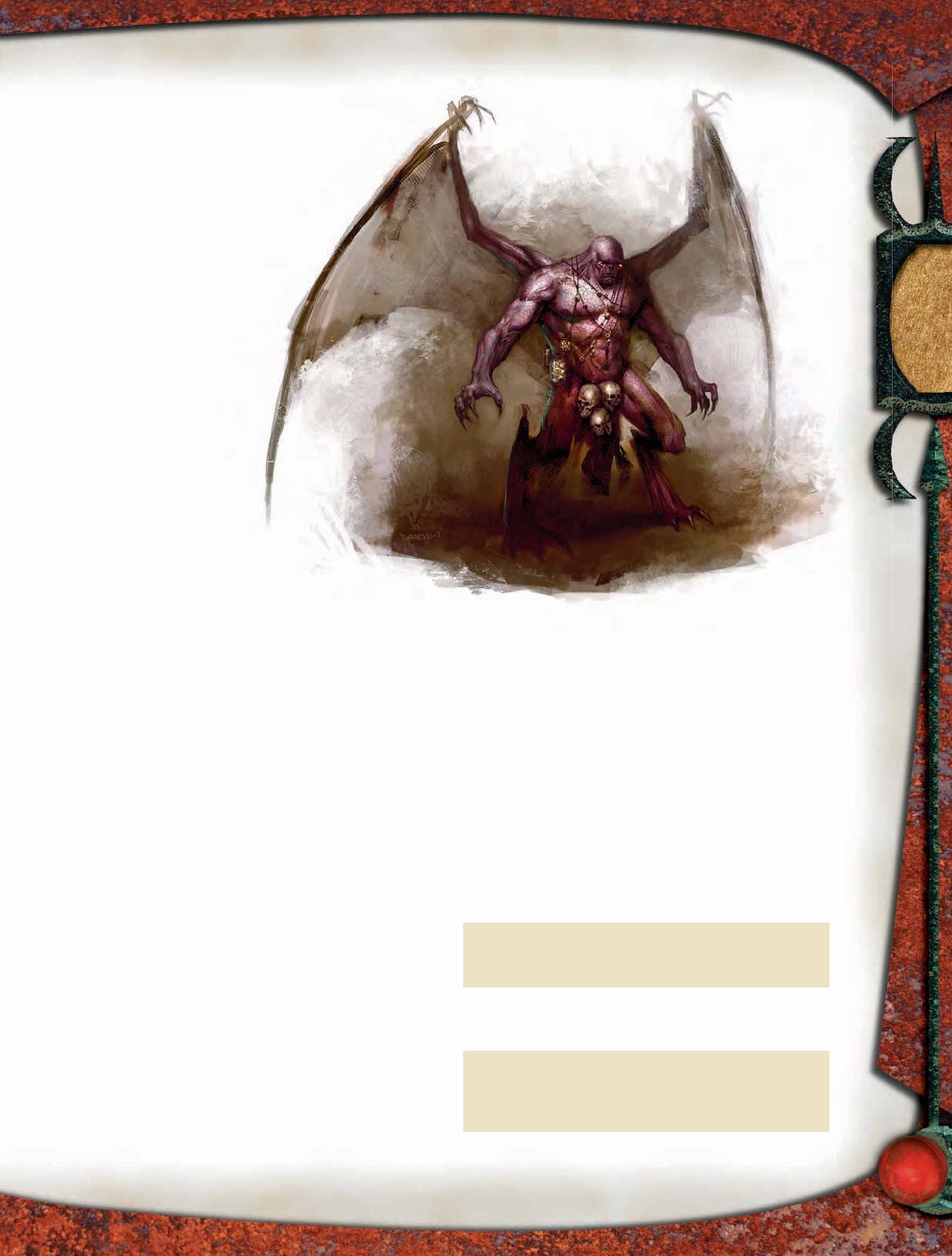
27
in a puff of smoke and brimstone and reappear in
a square up to 20 feet away to which it has line
of sight.
Eyethief (Ex) An gadacro can forgo its sneak
attack damage or extra damage on a
confirmed critical hit to instead blind its
opponent for 5 rounds. A creature that
has been blinded in this way cannot be
affected again until it has recovered
from the current effect. Creatures
that lack eyes are immune.
Summon Tanar’ri (Sp) 35% chance
to summon 1d2 gadacros;
1/day; caster level 4th. This
ability is the equivalent of a
2nd-level spell.
Skills Gadacros have a +4
racial bonus on Escape
Artist and Spot checks.
A gadacro is a vicious lesser
demon that torments its foes
by blinding them.
Strategies and Tactics
Gadacros are wild and reck-
less, using Flyby Attack to
slash and harry their opponents.
Once they blind a foe, the gadacros in
a group surround that creature, intent on tearing
it apart. If the battle turns against them, they fall back
to use mirror image and summon tanar’ri to seemingly and
literally infl ate their numbers.
Sample Encounter
Gadacros are like carrion birds, following demonic hosts
to pick off the stragglers or torment the survivors left in the
wake of war. These demons collect in clutches of two to six,
or murders of seven to twelve.
Murder of Eyes (EL 9): A moderately skilled wizard
fascinated with seeing and eyes discovered information
about the gadacro in a codex he recently acquired. Fas-
cinated, he engaged in a ritual designed to call and bind
one of the creatures so he could study it. He botched the
ceremony, and a murder of nine gadacros burst through
the brief rift to the Abyss created thereafter. The wizard’s
manor contains enough other creatures that the gadacros
have been entertained, but one person who went to call
on the wizard has disappeared, and a few creatures that
could have come only from the wizard’s home have troubled
the town.
Ecology
Despite having no need for sustenance, gadacros crave the
fl esh of the living all the same. Specifi cally, they relish their
victims’ eyes, preferably plucked from the skull of a victim
that still lives. Gadacros rarely agree on who among them
should have the right to eat the tastiest bits.
Environment: Gadacros can be found anywhere in
the Infinite Layers of the Abyss, though they are com-
mon in the Screaming Peaks of Yeenoghu’s Realm on
the 422nd layer.
pqqqqqqqqqrs
GADACRO LORE
Characters who have ranks in Knowledge (the planes) can
learn more about gadacros. When a character makes a suc-
cessful skill check, the following lore is revealed, including the
information from lower DCs.
Knowledge (the Planes)
DC Result
13 A demon from the Abyss, this creature is known as
a gadacro. It is cowardly yet savage, and its talons
are deadly. This result reveals all outsider and
tanar’ri traits.
18 When a gadacro hits an opponent solidly, that
foe goes temporarily blind. The demon can also
make illusory duplicates of itself and bind fl ying
creatures to the earth.
23 Gadacros are hard to kill and extremely mobile.
They can transport themselves away from danger
immediately, and their scaly skin turns away
normal weapons. Good-aligned or cold iron
weapons can easily harm them.
pqqqqqqqqqrs
Gadacro
DEMON
Illus. by Daarken
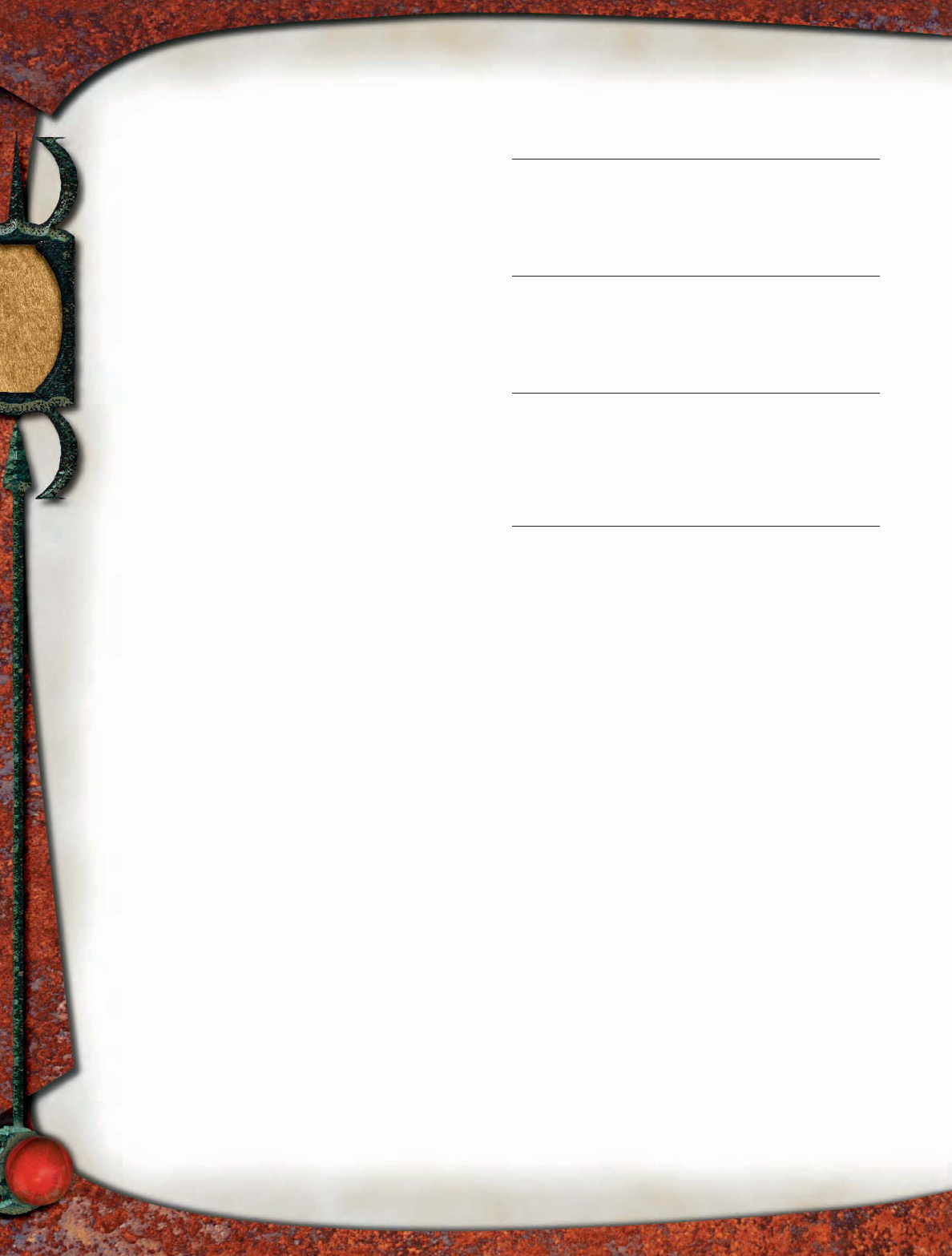
28
Typical Physical Characteristics: Gadacros are small,
with cherubic features and purple scaled skin. Their large
heads bear horns. A typical gadacro stands 4 feet tall and
weighs 35 pounds.
Alignment: Like other demons, gadacros are always
chaotic evil. They betray one another whenever doing so is
benefi cial, and they slay any creature they can, prolonging
the ordeal as long as it is safe to do so.
Society
Each gadacro group has a single leader. Smarter, stronger,
and quicker than the rest, the leader attains its position by
assassinating its rivals. It then pits the other members of
the group against one another, using favoritism to engender
loyalty in certain members. Of course, the disaffected resent
this treatment, and eventually replace the leader with one
of theirs.
Typical Treasure
Gadacros love shiny objects, and they favor baubles they can
wear or easily carry. A gadacro has standard treasure for its
Challenge Rating.
For Player Characters
An evil spellcaster can summon a gadacro using summon
monster IV or a higher-level summon monster spell. Treat the
gadacro as if it were on the 4th-level list on the Summon
Monster table (PH 287).
Gadacros in Eberron
Gadacros haunt the ruins left in the aftermath of the
eternal struggles of Shavarath. Although they torture the
injured outsiders they fi nd, they actually perform a useful
service. Once a warrior dies and is consumed, its essence
is absorbed into the plane and eventually reborn to fi ght
once more.
Gadacros in Faerûn
Gadacros gather on the ledges and crevices of the Blood Rift.
Having nothing to do with the Blood War, they instead tor-
ment the lost and unwary and pick the eye sockets of the slain.
A few gadacros act as spies for balors, but these informants
are unreliable at best.
SOLAMITH
A corpulent monstrosity at least 10 feet tall lumbers forward on
slablike legs. Rings of fl abby fl esh cradle its horned head. Pressing
out against the green-veined and pallid skin of its great gut are
screaming faces.
Solamith CR 8
Always CE Large outsider (chaotic, evil, extraplanar, tanar’ri)
Init +3; Senses darkvision 60 ft.; Listen +15, Spot +15
Languages Abyssal, Celestial, Draconic; telepathy 100 ft.
AC 21, touch 12, flat-footed 18
(–1 size, +3 Dex, +9 natural)
hp 115 (11 HD); fast healing 5; DR 5/magic or good
Immune electricity, fire, poison
Resist acid 10, cold 10; SR 16
Fort +13, Ref +10, Will +8
Weakness vulnerability to cold
Speed 40 ft. (8 squares)
Melee 2 slams +14 each (1d8+4)
Space 10 ft.; Reach 10 ft.
Base Atk +11; Grp +19
Atk Options Cleave, Power Attack, aligned strike (chaotic,
evil), magic strike
Special Actions soulfire, soulfire retort, summon tanar’ri
Abilities Str 19, Dex 16, Con 23, Int 4, Wis 13, Cha 8
SA aligned strike, magic strike, soulfire, soulfire retort,
summon tanar’ri
Feats Ability Focus (soulfire), Cleave, Improved Natural
Attack (slam), Power Attack
Skills Balance +17, Climb +18, Intimidate +13, Jump +8,
Listen +15, Spot +15
Advancement 12–22 HD (Large); 23–33 HD (Huge)
Soulfire (Su) As a standard action that provokes attacks
of opportunity, a solamith can deal itself 5 points of
damage to tear flesh from its body and hurl that flesh up
to 100 feet with perfect accuracy. When it lands, the flesh
explodes in a 20-foot-radius burst, dealing 4d6 points
of damage, half of which is fire damage (Reflex DC 23
half). Solamiths are immune to soulfire. The save DC is
Constitution-based.
By dealing itself an extra 5 points of damage, a
solamith can widen the burst to a 40-foot radius. By
dealing itself an extra 10 points of damage, a solamith
can make the burst deal maximum damage. A solamith
can use both of these abilities on the same soulfire
attack, but takes damage for each.
Soulfire Retort (Su) Whenever a solamith takes damage from
an opponent’s melee attack, it can unleash a 15-foot cone
of soulfire as a swift action on its next turn. The cone
deals damage as soulfire, above (Reflex DC 21 half). The
save DC is Constitution-based.
Summon Tanar’ri (Sp) 40% chance to summon 1d2
solamiths; 1/day; caster level 11th. This ability is the
equivalent of a 4th-level spell.
A solamith is a manifestation of depraved gluttony and burning
hunger, drawing energy from the spirits it devours. That power
charges its fl esh with spiritual fi re, which it uses against its
enemies by tearing away and hurling bits of its own body.
Strategies and Tactics
Solamiths don’t bother to close with enemies, instead hurling
soulfi re from the beginning of combat. Although dim-witted,
they have keen spatial awareness and an intuitive sense of how to
best use this ability. A solamith opens with a soulfi re attack that
deals maximum damage, and it increase the area of its soulfi re
burst whenever doing so allows it to catch more enemies in
the blast. If it can, it maneuvers to continue using its soulfi re
DEMON
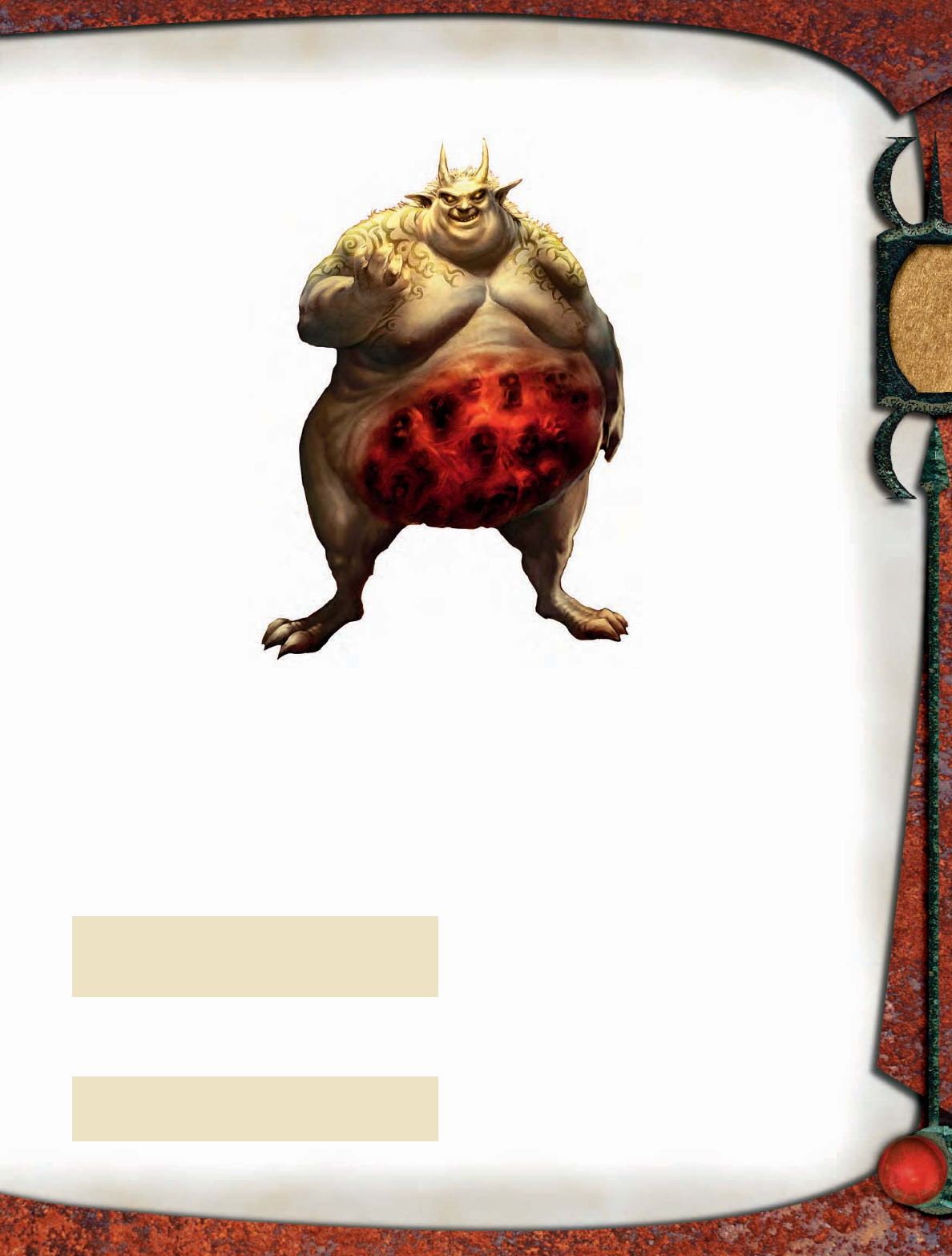
29
as long as possible. A solamith that has lost more than half its
hit points makes the smallest soulfi re attacks it can.
When forced into melee, a solamith might still use
soulfi re, but it can also use its formidable slam. It uses a
soulfi re cone whenever it can, but fi rst maneuvers
to catch other foes in the blast.
Sample Encounter
Solamiths roam singly or in pairs,
but they are commonly found
among the troops of mightier
fiends.
Quinix’s Gatehouse Guards
(EL 10): Quinix the glabrezu lives
in a ruined city where gnolls and
lesser fi ends serve him. Above the
ruined gates of the city’s central
citadel where Quinix holds court,
two solamiths keep watch. A bit
too zealous, the solamiths some-
times attack gnolls and Quinix’s
other servants.
Ecology
Solamiths prowl the Abyss in search
of lesser demons and petitioners to
eat, even though they require
no sustenance. A solamith
tears its victims to pieces,
but then becomes a dainty
eater, chewing slowly and ap-
preciating the spiritual effervescence of each morsel. Once
a meal is fi nished, a new face appears just under the skin on
a solamith’s gut, silently pleading for release.
Environment: Solamiths can be found throughout the
Infi nite Layers of the Abyss, wandering as fi erce hunt-
ers across the blasted landscape. Large numbers of
solamiths, enslaved by more powerful demons,
serve as artillery in armies or as sentries.
Typical Physical Characteristics: A sol-
amith is an obese fi end that stands 10 feet
tall and weighs up to a ton. Its horned
head, set with burning eyes and full of
fl at teeth, seems to fl oat on a pile of
sagging skin. That skin is pale with
bright green veins.
Alignment: Solamiths are
animalistic and savage, except
when they eat. Born of the
Abyss, they are always cha-
otic evil.
Society
Solamiths don’t have strong
egos. They are content to prowl
the Abyss, devouring other creatures
instinctively and paying no heed to
the suffering they cause. When in the
presence of a more powerful demon
or evil entity, a solamith fawns and
snivels, hoping to be taken in as
a pet or prized soldier.
Typical Treasure
Solamiths do not collect treasure. They have
no need for the baubles coveted by others. However, a
solamith’s commander or master usually has more trea-
sure because of the added success brought by having a
solamith soldier.
For Player Characters
An evil spellcaster can summon a solamith using summon
monster VIII or a higher-level summon monster spell. Treat
the solamith as if it were on the 8th-level list on the Sum-
mon Monster table (PH 287).
Solamiths in Eberron
On the Battleground of Shavarath, solamiths form ragtag
squads to lay waste to the angelic host—specifi cally archons.
Under the watchful guidance of hezrou commanders, they
have great success as mobile artillery. Particularly successful
units tattoo their kills on their guts.
Solamiths in Faerûn
Solamiths are rare in the Abyss, offering little to the
armies of the Blood War. The few solamiths to be found
are usually in the employ of balors, and are used to do
away with troublesome prisoners and to ward off attacks
by extraplanar threats.
pqqqqqqqqqrs
SOLAMITH LORE
Characters who have ranks in Knowledge (the planes) can
learn more about solamiths. When a character makes a suc-
cessful skill check, the following lore is revealed, including the
information from lower DCs.
Knowledge (the Planes)
DC Result
18 This is a solamith, a demon from the Infi nite
Layers of the Abyss. Stupid but tough, solamiths
are, unlike other tanar’ri, immune to fi re. They are
susceptible to cold, even though they are resistant
to minor amounts of cold damage.
23 A solamith can pound its foes with slams, but it
normally attacks by tearing chunks out of its body
and throwing them. Those fl eshy bits explode into
fl ames that can harm even those who are normally
immune to fi re.
28 A solamith’s injuries knit closed at a remarkable
rate. Magic weapons or good-aligned weapons work
best against a solamith, but whenever it is injured
in melee, it can emit a cone of its corrupt fi re.
pqqqqqqqqqrs
Solamith
DEMON
Illus. by J. Zhang

30
DEMONTHORN
MANDRAKE
Thorny red stalks grow out of a cluster of crimson roots that twitch
and shudder. Star-shaped leaves ring the plant around a large,
spiny seedpod at its heart. Two bristly vines sprout from either side
of this pod.
Demonthorn Mandrake CR 5
Always NE Large plant (extraplanar)
Init +4; Senses darkvision 60 ft., low-light vision,
tremorsense 40 ft.; Listen +4, Spot +4
Languages —
AC 17, touch 9, flat-footed 17
(–1 size, +8 natural)
hp 52 (7 HD)
Immune plant immunities
Resist electricity 10, fire 10
Fort +8, Ref +2, Will +1
Speed 20 ft. (4 squares)
Melee 2 slams +8 each (2d6+4)
Space 10 ft.; Reach 10 ft.
Base Atk +5; Grp +13
Atk Options Power Attack
Special Actions spore pod, tangle root
Abilities Str 18, Dex 11, Con 16, Int 7, Wis 9, Cha 12
SA spore pod, tangle root
SQ plant traits
Feats Alertness, Improved Initiative, Power Attack
Skills Climb +12, Listen +4, Move Silently +4, Spot +4
Advancement 8–12 HD (Large); 13–21 HD (Huge)
Spore Pod (Ex) As a standard action, a demonthorn
mandrake can spit a spore pod to a range of 30 feet. The
pod then explodes in a 10-foot-radius burst. All living
creatures in the area take 1d8 points of damage as thorny
growths burst from their faces. At the start of each of the
demonthorn mandrake’s turns, these thorns continue to
grow, dealing 5 points of damage.
Each affected opponent is allowed a DC 16 Fortitude
save each round. If that save is successful, the thorns
become brittle and fall off the creature’s face. The thorns
can also be pulled from a creature as a full-round action
that deals 1d8 points of damage. Applying a vial of holy
water to the thorns causes them to shrivel and die. The
save DC is Constitution-based.
If a creature is already infested with spore pod thorns,
it is immune to the damage and effect of this attack.
If a Medium or larger creature is killed by damage from
a demon thorn mandrake’s thorns, a fully grown demon-
thorn mandrake emerges from the corpse in 1d4 hours.
Tangle Root (Ex) A demonthorn mandrake can extend its
roots to a radius of 30 feet as a standard action. At the
start of the demonthorn mandrake’s turn, opponents in
the area must make a DC 16 Reflex save or be entangled.
A mandrake can’t move when its roots are extended,
but can retract the roots as a free action. The save DC is
Constitution-based.
When a mandrake’s roots are extended, they scream
with humanlike voices until retracted.
Demonthorn mandrakes are vile plant creatures that dwell
on the Lower Planes. They are often brought to the Material
Plane to serve as guardians or to start a plague.
STRATEGIES AND TACTICS
If used as a guardian, a demonthorn mandrake hides on
a ceiling or wall, waiting for prey. Once combat begins, a
demonthorn mandrake spits spore pods until all its enemies
are infested with thorns, then it closes to engage in melee.
In melee combat, a demonthorn mandrake uses its tangle
root ability to prevent escape and thrashes opponents
with slams.
In groups, demonthorn mandrakes fire spore pods to
hit as many creatures as possible with little or no overlap.
Then, groups of the plants single out enemies to attack, fi rst
targeting those who are suffering from spore pod thorns.
Demonthorn mandrakes rarely retreat, having little sense
of self-preservation.
SAMPLE ENCOUNTERS
Demonthorn mandrakes can be encountered alone or in
groups ranging from two to an overwhelming horde. A
demonthorn mandrake can be coaxed to work as part of
a group with other creatures.
Glade of Corruption (EL 5): An area within a forest
is said to be place of dark evil, littered with the remains
of animals and haunted by angry tree spirits. In reality, a
powerful wizard hid something valuable in a secret cave in
the center of the woods. To guard the entrance, the wizard
called a demonthorn mandrake from the Abyss. The wizard
has not been back for many years, but the lone demonthorn
mandrake still waits in the area surrounding the cave. The
few who have encountered it have died before the spores
could produce another demonthorn mandrake.
Creeping Doom (EL 10): Long ago, a doomsday cult
brought a group of devils to the Material Plane. The devils
and their cult were eventually destroyed, but a demon-
thorn mandrake brought by the devils was never found.
Hidden away in a sealed chamber beneath the city, the
plant laid dormant for years until a druid named Kalmir-
kas (NE male human druid 7) sensed and released it.
pqqqqqqqqqrs
DEMONTHORN MANDRAKE LORE
Characters who have ranks in Knowledge (the palnes) can
learn more about demonthorn mandrakes. When a character
makes a successful skill check, the following lore is revealed,
including the information from lower DCs.
Knowledge (the Planes)
DC Result
15 This is a demonthorn mandrake, a plant from the
Lower Planes. Its roots can hamper those who
approach it.
20 A demonthorn mandrake can shoot a deadly pod
fi lled with spores that cause living creatures struck
by them to sprout thorns.
25 The only ways to stop the growth of a demonthorn
mandrake’s thorns are by pulling them out or
dousing them in holy water.
pqqqqqqqqqrs
DEMONTHORN
MANDRAKE
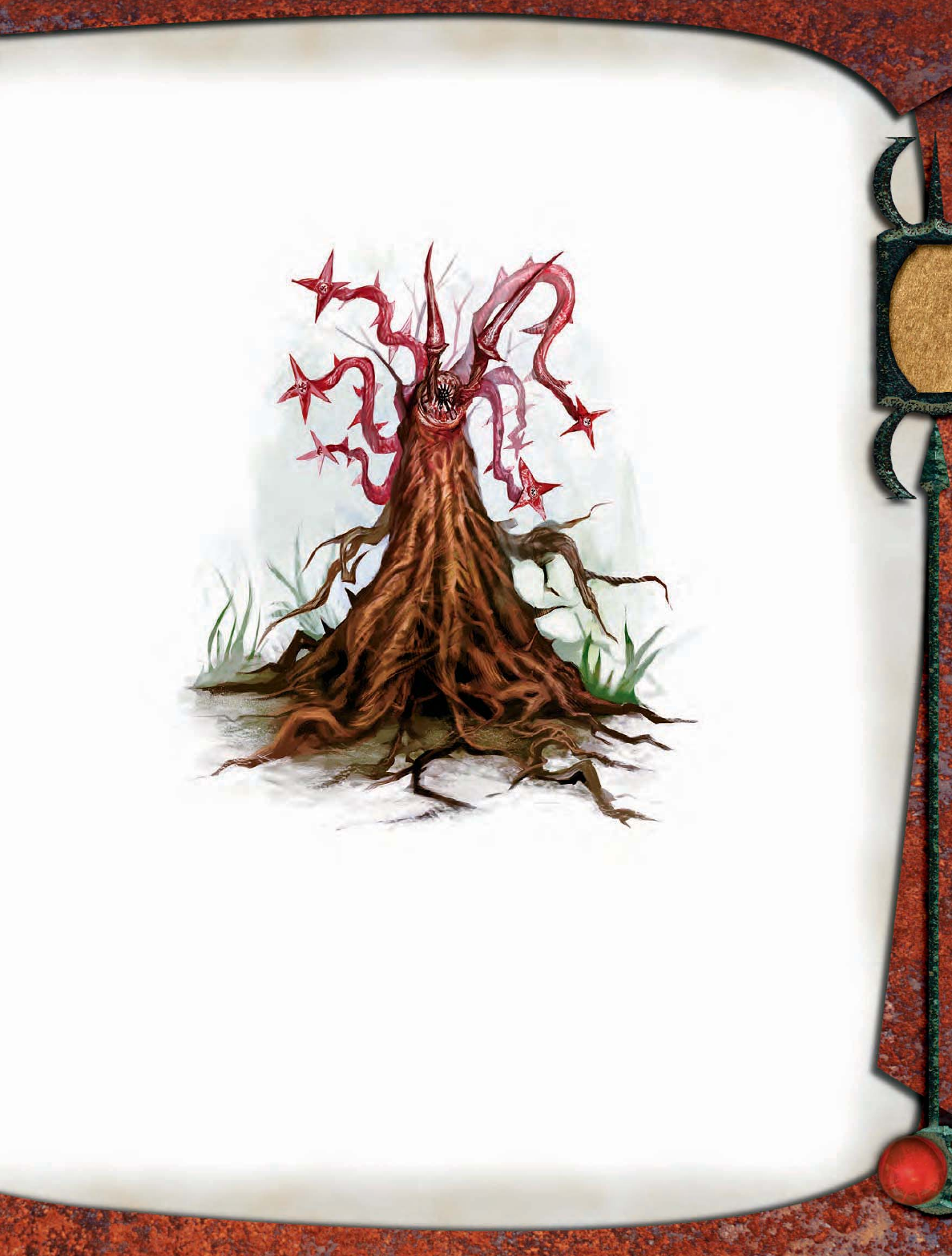
31
Taking the plant as a sign of the rebirth of nature, the
twisted druid has since kidnapped three victims to sac-
rifice to it, creating a new mandrake with each sacrifice.
Now, four demonthorn mandrakes, led by the mad druid,
prowl the sewers of the city. They hunt for more prey to
increase their numbers before reaching their insidious
vines to the surface.
ECOLOGY
Demonthorn mandrakes do not
need water or light to live—
they derive nourishment from
the fl esh of their victims. If
starved of this food source
for more than a month, a
plant goes dormant and can
continue to live for years
without sustenance be-
fore fi nally withering and
dying. A demonthorn
mandrake’s roots are
extremely sensitive,
allowing it to sense
nearby creatures
that are touch-
ing the ground
even when it is
dormant.
Demonthorn
mandrakes re-
produce by
using other
living crea-
tures as hosts.
Medium or
larger victims
slain by man-
drake spore pod thorns
play host to a sapling plant,
which grows to maturity in 1d4 hours,
consuming most of the host creature’s
blood and fl esh to fuel the process.
Environment: Demonthorn mandrakes are most com-
monly found on the Lower Planes, including the Abyss,
the Nine Hells, and Gehenna. In these places, demonthorn
mandrakes congregate in large groups.
On the Material Plane, demonthorn mandrakes are found
guarding a specifi c place, under the direct control of a con-
jurer who called them, or wandering about, free to do as they
please. Uncontrolled mandrakes hide in secluded places such
as sewers, caverns, or forest glades, waiting for unsuspecting
victims to wander by.
Typical Physical Characteristics: An average demon-
thorn mandrake stands about 8 feet tall and weighs 300
pounds. When rooted in place and motionless, demon-
thorn mandrakes appear more like odd plants than
creatures. When it is moving, a demon thorn mandrake’s
roots extend and retract at a rapid pace, pulling the body
of the plant along.
Alignment: A demonthorn mandrake is neither chaotic
nor lawful, but its connection to the Lower Planes makes
it absolutely evil.
SOCIETY
Demonthorn mandrakes get along well
with others of their kind unless the
group has not fed for some time, in
which case they fi ght over every
last scrap of food. Such battles
rarely turn deadly.
As plant creatures, demon-
thorn mandrakes do not form
societies, but a great demon-
thorn mandrake, the Mother
Seed, exists somewhere in a
particularly verdant locale
in the Abyss. This Moth-
er Seed is larger than any
other demon thorn man-
drake, and it possesses
a cruel and cunning
intellect. It is an au-
thority that other
demonthorn man-
drakes obey without
hesitation.
TYPICAL
TREASURE
Demonthorn man-
drakes do not use gear
or magic items of any
kind, so wandering plants
are rarely found with any
treasure. Most, however,
have a lair where the bones of their victims
lie. Scattered among these remains, any manner of treasure
might be found, so demonthorn mandrakes in their lairs have
standard treasure for their Challenge Rating.
DEMONTHORN MANDRAKES
IN EBERRON
Demonthorn mandrakes can be found on the planes
of Lamannia and Shavarath. On the Material Plane,
demonthorn mandrakes are most often encountered in
the Demon Wastes, wandering the Labyrinth. Explorers
in the deepest regions of Xen’drik have also reported
encountering demonthorn mandrakes, some in the service
of a particularly vicious cult of giants said to be in league
with demons.
Demonthorn mandrake
DEMONTHORN
MANDRAKE
Illus. by M. Coimbra
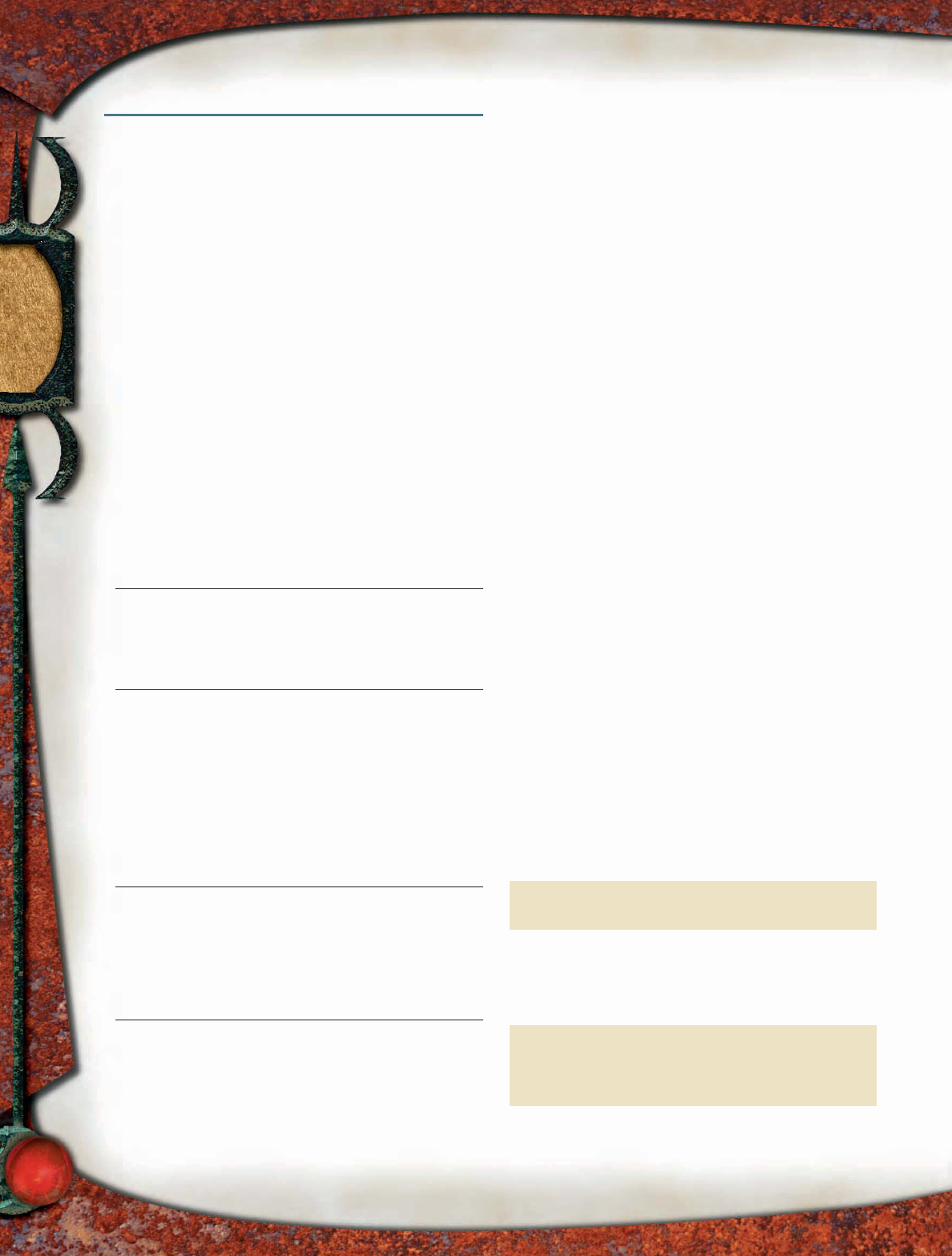
32
DEVIL
Devils are creatures of law and evil, native to the Nine
Hells of Baator. They inflict misery on mortals and other
creatures through wicked schemes and convoluted ploys
for power.
Baatezu are the predominant race (and subtype) among
devils. Fiends that belong to the baatezu race are also part of
a rigid hierarchy in the Hells, where they strive for authority
and infl uence. Accomplishments can advance a devil’s station,
but such deeds can also arouse the suspicion and ire of those
higher in rank. Preemptive curbing of ambition through
violence can come quicker than reward in the infernal realm.
Baatezu possess a number of racial traits, summarized in
the glossary.
GULTHIR
Like a towering skeleton draped in folds of ruddy skin, this creature
has a bald, warty head covered in lesions and tumors. An oozing
wound serves as its mouth, and twin points of crimson light are
its eyes.
Gulthir CR 6
Always LE Large outsider (baatezu, evil, extraplanar, lawful)
Init +6; Senses darkvision 60 ft., see in darkness; Listen +11,
Spot +11
Languages Celestial, Draconic, Infernal; telepathy 100 ft.
AC 21, touch 11, flat-footed 19
(–1 size, +2 Dex, +10 natural)
hp 51 (6 HD); DR 10/good
Immune fire, poison
Resist acid 10, cold 10
Fort +9, Ref +7, Will +9
Speed 20 ft. (4 squares)
Melee bite +10 (2d6+6)
Space 10 ft.; Reach 10 ft.
Base Atk +6; Grp +14
Atk Options aligned strike (evil, lawful), improved grab
Special Actions ingest evil, summon baatezu, swallow of
domination
Spell-Like Abilities (CL 6th):
At will—greater teleport (self plus 50 pounds of objects
only), see invisibility
5/day—ray of enfeeblement (+8 ranged touch), scare
(DC 16)
Abilities Str 19, Dex 14, Con 19, Int 8, Wis 15, Cha 18
SA aligned strike, improved grab, ingest evil, spell-like
abilities, summon baatezu, swallow of domination
Feats Improved Initiative, Iron Will, Weapon Focus (bite)
Skills Hide +7, Intimidate +13, Knowledge (the planes) +8,
Listen +11, Move Silently +11, Spot +11, Survival +11 (+13
on other planes)
Advancement 7–12 HD (Large); 13–18 HD (Huge)
Improved Grab (Ex) To use this ability, a gulthir must hit
an opponent of its size or smaller with a bite. It can
then attempt to start a grapple as a free action without
provoking attacks of opportunity.
Swallow of Domination (Ex) A gulthir can swallow a grabbed
opponent smaller than itself by making a successful
grapple check.
A gulthir’s gizzard can hold one creature at a time. A
foe swallowed by a gulthir is immediately affected as if by
a dominate monster spell (CL 17th, no save). A gulthir can
take a full-round action to spew a swallowed opponent
into an adjacent unoccupied square.
The disgorged foe is covered in slime, and as long
as that opponent is controlled by the gulthir, its eyes are
coated with an even thicker layer of white slime. Once
disgorged, a dominated foe can attempt a DC 17 Will
save at the end of each of its turns to end the effect. The
effect also ends if the gulthir is killed or if the victim’s
eyes are washed with holy water (a full-round action
that provokes attacks of opportunity). The save DC is
Charisma-based.
Ingest Evil (Su) If a gulthir swallows an evil outsider,
it can take a full-round action to digest that fiend.
If a swallowed foe fails a DC 17 Fortitude save, it is
immediately destroyed, adding its essence to the gulthir.
The gulthir gains temporary hit points equal to that
outsider’s full normal hit points and a bonus on saving
throws equal to half the swallowed fiend’s Hit Dice. The
save DC is Constitution-based, and the save bonus and
temporary hit points last for 1 minute.
Summon Baatezu (Sp) 75% chance to summon 1d4 lemures;
1/day; caster level 6th. This ability is the equivalent of a
3rd-level spell.
Devils who fail their masters are, if not slain outright,
transformed into wretched shadows of their former selves.
Among the new forms a devil might take is the gulthir.
These unclean devils continue to serve their displeased
masters as methods of punishment for other lesser devils,
because their gullets are certain doom for baatezu that
are swallowed. Such creatures are destroyed or become
gulthirs themselves.
pqqqqqqqqqrs
GULTHIR LORE
Characters who have ranks in Knowledge (the planes) can
learn more about gulthirs. When a character makes a suc-
cessful skill check, the following lore is revealed, including
the information from lower DCs.
Knowledge (the Planes)
DC Result
16 This creature is a gulthir, a fi end from the Nine
Hells of Baator. In battle, gulthirs bite and swallow
their foes.
21 A gulthir can mentally control those it swallows,
spitting them out into a fight. This result
reveals the nature of the slime covering a
dominated creature’s eyes, and the ways to
remove it. Gulthirs are vulnerable to good-
aligned weapons.
26 Gulthirs can summon lemures to aid them. If a
gulthir swallows another devil, including a lemure,
it can add that devil’s power to its own. It can
instead slowly digest a devil, transforming it into
another gulthir.
pqqqqqqqqqrs
DEVIL
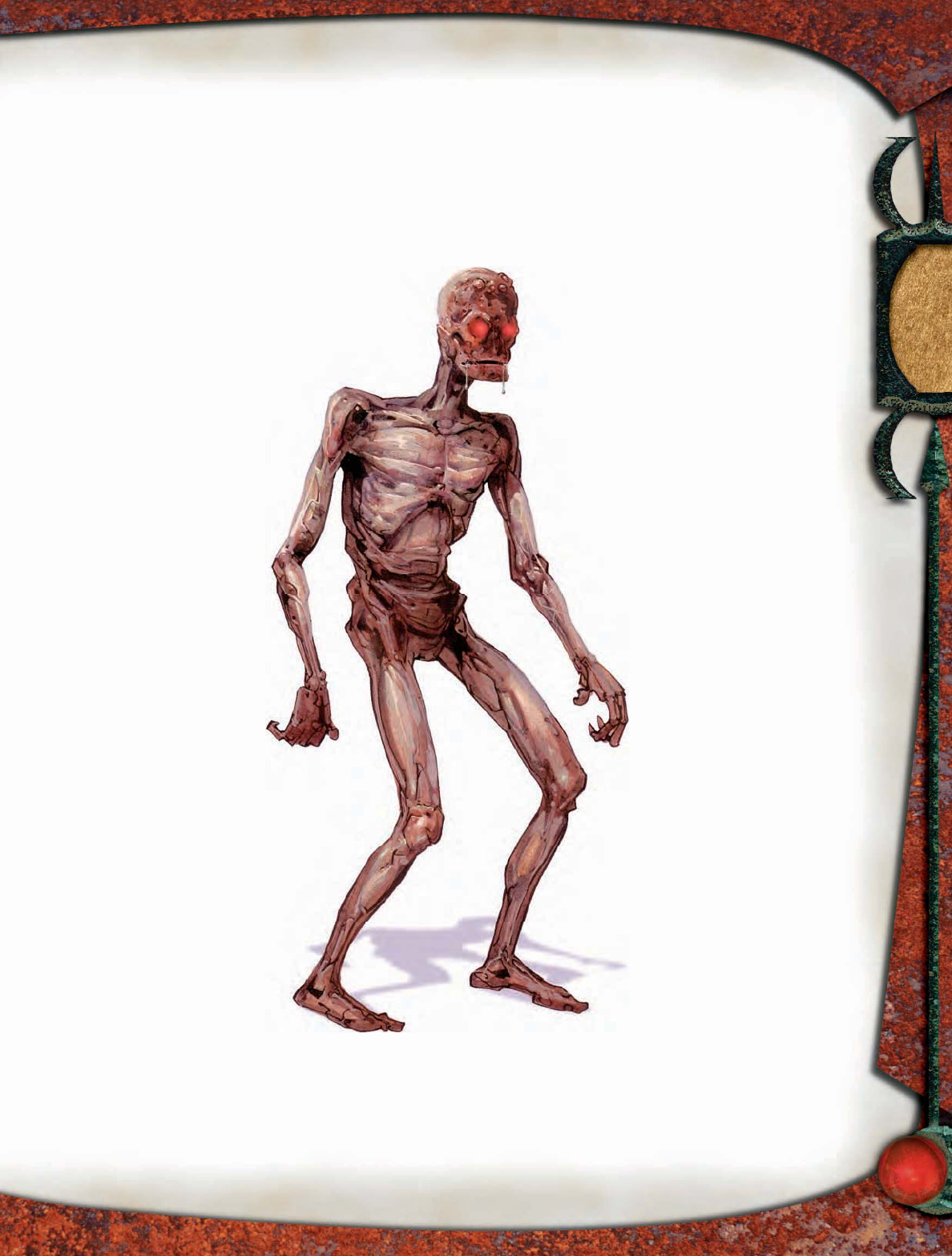
33
Strategies and Tactics
A gulthir has lost so much that it has little fear, so it charges
into battle recklessly, chooses an enemy, and tries to swallow
that opponent as soon as possible. It zaps strong foes with
ray of enfeeblement, hoping to weaken those opponents for
when it comes time to grapple and swallow them. It uses
scare to scatter its enemies so it can focus on its chosen target.
If faced with numerous adversaries, a gulthir summons
lemures to act as distractions and to consume to enhance
its own abilities.
Sample Encounter
Gulthirs are pariahs, and when not in the service of
a greater devil, they stalk through the Hells gather-
ing packs of lemures as pets and food.
The lemures mindlessly mill about
the gulthir, unaware of the danger
they face.
Gublestald’s Gang (EL 7): A glut-
tonous gulthir named Gublestald
and his gang of four lemures (MM
57) haunt the fetid landscape of a
corrupted swamp. These fi ends
serve a lich that lives in a
sinking tower in the swamp’s
interior, but they are free to
harry anyone they fi nd in the
lich’s domain.
Ecology
Gulthirs are outside the normal
order of fiends that populate
the Nine Hells. Formed
from those devils that have
raised the ire of their infer-
nal masters, they are transformed into a lower
form until they somehow regain the confi-
dence of the baatezu.
Instead of instantly ingesting the essence
of a swallowed fiend, a gulthir can instead
slowly digest the swallowed opponent,
a process that transforms the creature
into another gulthir. Devils that have
displeased their masters are often
fed to gulthirs, as punishment
as well as a way to maintain the
gulthir population. Display-
ing a small amount of pride,
gulthirs never willingly trans-
form lesser fiends into gulthirs
this way.
A newly created gulthir is shattered by its transforma-
tion, experiencing waves of pain as its body acclimates to
its new form. From the moment it reawakens, it knows its
function and all its abilities, and it sets out to regain its mas-
ter’s favor.
Environment: Gulthirs are native to the Nine Hells of
Baator. They infest all the layers but are common on Dis, the
second layer, where Dispater, the Iron Duke, dispenses his
paranoid brand of justice.
Typical Physical Characteristics: A gulthir stands 10
feet tall and weighs about 800 pounds. Its sallow skin hangs
loosely from its skeletal frame. The loose mouth
on a gulthir’s square head lies over a hinged jaw
that the devil can unlock to accommodate crea-
tures of up to Medium size.
Alignment: Like all baatezu, gulthirs are
always lawful evil. They take every opportunity
to lord what little power they have over others,
swallowing those that don’t bow down.
Society
Gulthirs lament their fate. They despise their
altered forms, a punishment they undoubt-
edly feel was unjust. To vent their hatred and
loathing, they turn on other devils, revel-
ing in the horror that their abilities elicit.
Ironically, gulthirs are among the most
loyal servants in the Hells, acting like
a policing force as well as a method of
punishment. Other devils keep their
distance from gulthirs, letting them
enjoy the diversion of wreaking hav-
oc on lesser fiends.
Typical Treasure
Treasure is a symbol of status
that gulthirs cling to. They
adorn themselves with jewels,
and they covet items of pow-
er. They swallow valuables carried
by their victims to keep such items
out of the hands of potential rivals.
Gulthirs have standard treasure for their
Challenge Rating.
Advanced Gulthirs
Unless a gulthir somehow regains the favor
of the devil that caused its demo-
tion, it is condemned to spend
eternity in its present form.
Exceptionally old gulthirs are far
larger than their counterparts, and
they can consume larger creatures.
For Player Characters
An evil spellcaster can summon a gulthir using summon
monster VI or a higher-level summon monster spell. Treat the
Gulthir
DEVIL
Illus. by C. Critchlow
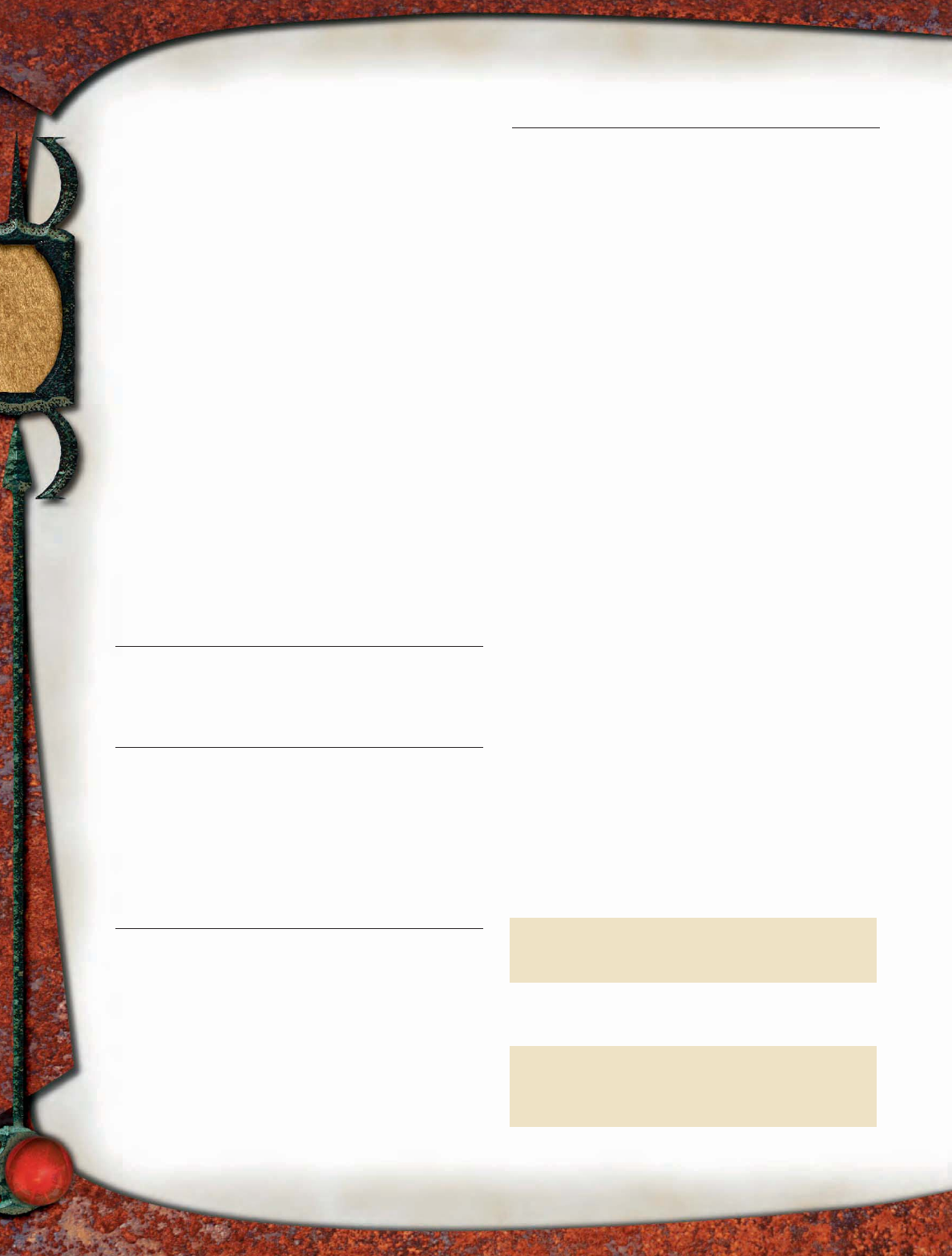
34
gulthir as if it were on the 6th-level list on the Summon
Monster table (PH 287).
Gulthirs in Faerûn
Gulthirs are all too common on the wasted battlefields
of the Blood Rift, where they serve as commissars and
expendable shock troops. Pit fiends sometimes dispatch
squads of gulthirs into the wilds of the Rift to hunt weaker
yugoloths and turn them into gulthirs, thereby bolstering
the devil army without resorting to the mercenary contracts
yugoloths (MM2 202) prefer. Of course, the greater devils
deny that these gulthir “press gangs” work in any official
capacity. Regardless, yugoloths slay gulthirs whenever they
can get away with doing so.
REMMANON
Hovering just a few feet above the ground is a nude, hairless human-
like creature. It is genderless. Hooks, barbs, and chains decorate
its fl esh, and long horns curl from each side of its head, the two
meeting just below the creature’s chin. Solid black eyes stare out
from its unreadable face.
Remmanon CR 15
Always LE Medium outsider (baatezu, evil, extraplanar,
lawful)
Init +8; Senses darkvision 60 ft., see in darkness; Listen +28,
Spot +28
Aura insidious (30 ft.)
Languages Abyssal, Celestial, Common, Draconic, Infernal;
telepathy 100 ft.
AC 32, touch 18, flat-footed 28
(+4 Dex, +2 shield, +4 deflection, +12 natural)
hp 153 (18 HD); DR 15/good and silver
Immune fire, poison
Resist acid 10, cold 10; SR 25
Fort +15, Ref +15, Will +18
Speed 30 ft. (6 squares), fly 30 ft. (good); Flyby Attack,
Wingover
Melee hellfire touch +23 (2d6+4 plus 1d6 fire)
Space 5 ft.; Reach 5 ft.
Base Atk +18; Grp +22
Atk Options Improved Feint, aligned strike (evil, lawful)
Special Actions summon baatezu
Spell-Like Abilities (CL 18th):
At will—detect good, disguise self, greater teleport (self plus
50 pounds of objects only), plane shift (willing targets
only)
Abilities Str 18, Dex 19, Con 18, Int 23, Wis 24, Cha 25
SA aligned strike, insidious aura, spell-like abilities, summon
baatezu
Feats Combat Expertise, Flyby Attack, Improved Feint,
Improved Initiative, Quicken Spell-Like Ability (greater
teleport), Weapon Focus (hellfire touch), Wingover
Skills Bluff +28, Concentration +25, Diplomacy +34,
Disguise +28 (+30 acting), Escape Artist +25,
Intimidate +30, Knowledge (arcana) +27, Knowledge
(history) +27, Knowledge (nobility and royalty) +27,
Knowledge (the planes) +27, Listen +28, Search +27,
Sense Motive +28, Spot +28, Survival +7 (+9 on other
planes, following tracks), Use Rope +4 (+6 bindings)
Advancement 19–36 HD (Medium)
Possessions ring of force shield, ring of protection +4
Insidious Aura (Su) A remmanon emanates a telepathic aura
that plays on the doubts and fears of its foes. Opponents
that begin their turn within 30 feet of a remmanon must
succeed on a DC 26 Will save or suffer the effect of a
confusion spell for that round. An affected foe never treats
a remmanon as the nearest creature for the purpose
of determining the confusion effect. The save DC is
Charisma-based.
A remmanon and allies within 30 feet of it gain a +4
bonus on attack rolls against opponents affected by this
aura.
Summon Baatezu (Sp) 75% chance to summon 1d3
bearded devils; 2/day; caster level 18th. This ability is the
equivalent of a 9th-level spell.
Remmanons are devils that sow discord and distrust in
mortals. Using cunning words, magical manipulation, and
servitors loyal to them, they can bring down the strongest of
fortifi cations by weakening them from the inside.
Strategies and Tactics
A remmanon is rarely unprotected and enjoys the support
of mortal or fiendish minions, depending on where it is
encountered. It hovers over the battlefi eld, causing doubt
and uncertainty among its foes while commanding its ser-
vants to rend and destroy confused enemies. If at any time
a remmanon’s minions are overwhelmed, it adds to their
numbers with summon baatezu.
Sample Encounter
Remmanons insulate themselves with minions, using cult-
ists on the Material Plane or lesser fi ends when in the Nine
Hells of Baator. When possible, they keep the company of
pqqqqqqqqqrs
REMMANON LORE
Characters who have ranks in Knowledge (the planes) can
learn more about remmanons. When a character makes a
successful skill check, the following lore is revealed, including
the information from lower DCs.
Knowledge (the Planes)
DC Result
25 This devil is a remmanon, a fi end from the Nine
Hells. They are the devils of discord, which make
bloody deals with mortals. A remmanon’s touch
burns victims with hellfi re.
30 A remmanon’s presence can befuddle its enemies
and bolster its allies. It uses minions to keep
its foes off balance in battle, but it doesn’t fear
wading into combat.
35 Like a lot of potent fiends, a remmanon has
skin that can turn aside a stout blade, and only
good-aligned weapons treated with alchemical
silver can easily wound it. It is also highly
resistant to spells.
pqqqqqqqqqrs
DEVIL
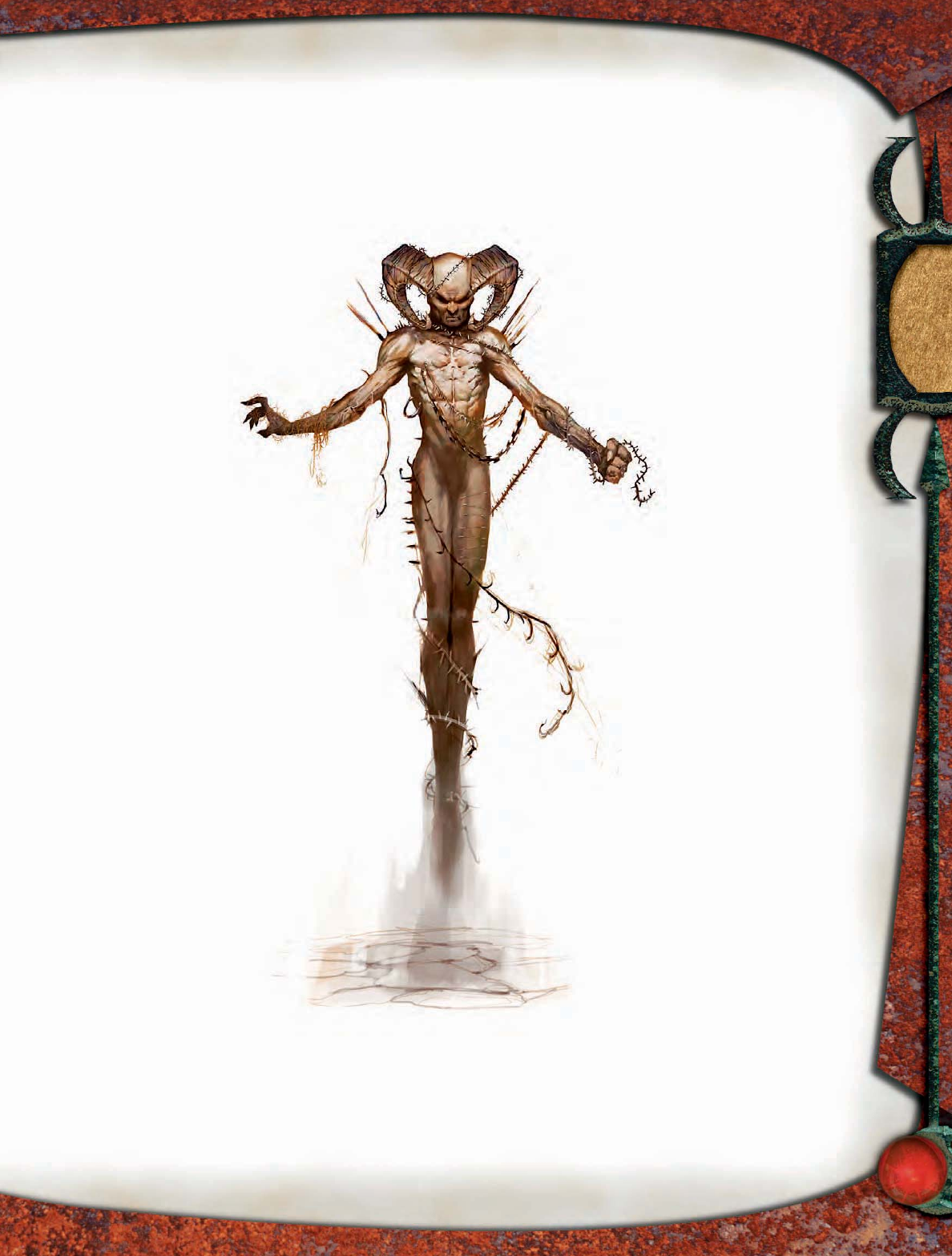
35
erinyes and other devils that have capabilities complement-
ing their own.
Against the Middle (EL 15 or higher): Gorathron
came to the Material Plane with six erinyes (MM 54) and
quickly united several tribes of goblinoids deep in a vast
mountain range. The goblinoids named the fiend their god,
built it a mountaintop fortress, and accepted Gorathron’s
erinyes soldiers as generals. The devils have
bided their time for generations, infusing
their followers with fiendish blood and ac-
quiring other allies, including a few blue
dragons. At the same time, Gorathron
and its other minions have sown friction,
iniquity, and weakness into the human
kingdoms of nearby lands. The time draws
near for the remmanon’s
chosen people to invade
those fractious realms,
where no alliance can
possibly emerge to stand in
their way.
Ecology
Remmanons are fi ends of dissonance, per-
sonifying the qualities of jealousy, greed,
and lust. They are among the devils least
likely to engage in combat with mortals
or other fiends, as their bodies indicate.
Instead, they prefer manipulation and influence,
their bodily might hidden in an androgynous form
that appears deceptively mortal.
Environment: Remmanons are native to
the Nine Hells of Baator. Given their spell-like
abilities, they have far more freedom than other
fiends, and they can be encountered on just about
any plane.
Typical Physical Characteristics: A rem-
manon has the height and weight of an average adult
human male. Its body looks supple and beauti-
ful, but seems to lack strength. Piercing
its flesh are iron hooks, rings, and bars,
from which hang small scraps of pa-
per containing the names of those
mortals who have entered into
contracts with it.
Alignment: Remmanons are
crafty, patient, and farsighted.
They worm their way into agree-
ments with mortals, exploiting the letter
of such contracts when they come due.
Enjoying taking advantage of and destroying mortals, rem-
manons never hesitate to harm or pervert those they can.
These fi ends are always lawful evil.
Society
Even when compared to other baatezu, remmanons are arro-
gant. They believe they cannot fail, and that they personify
the greatest aspects of their wicked race. Few lesser devils
appreciate the subtleties of seduction and manipulation,
and remmanons are quick to point out that failing in their
lessers. Remmanons command respect, however, and lesser
baatezu join a remmanon for the potential profi t
and instruction they can receive as the lackeys
of such an ambitious devil.
Remmanons travel the planes looking for
foes to trick and thwart. They take their time,
working all sides against the others in a con-
fl ict, planning a decisive blow at some point to
spell the ruin of all that is good and holy in
a locale. When no confl icts exist, a rem-
manon creates them. Its only desires
are the downfall of goodness
and purity, along with the
subjugation of the weak
under the iron fi st of ter-
rible evil.
Typical Treasure
Remmanons collect valuables for personal de-
fense, as well as for the sake of appearances
and bribery. They have triple standard trea-
sure for their Challenge Rating.
The remmanon in this entry has pro-
tective magic items worth 40,500 gp,
which is about two-thirds of its 66,000
gp total. The rest of its wealth is in
the form of coinage and art objects,
or mundane jewelry.
For Player Characters
Remmanons have an uncanny ability to hear magical
cries for aid. Whenever a nongood spellcaster casts a
greater planar ally spell, a remmanon appears instead of
the expected creature 5% of the time. When it answers
such a call, a remmanon offers a contract to the caster.
Bold remmanons have been known to voluntarily
interfere with greater planar binding spells, offer-
ing services in exchange for a contract even
if not trapped by the calling.
Remmanons in Eberron
In Eberron, remmanons are native to the
Material Plane. Rare descendants of the quori
that invaded Xen’drik some 40,000 years ago,
remmanons have hidden themselves throughout the shat-
tered continent, working their wickedness on the drow
and giants of that land. A few have spread to other realms,
including Khorvaire, where they infect the dragonmarked
races with corruption.
Remmanon
DEVIL
Illus. by R. Spears
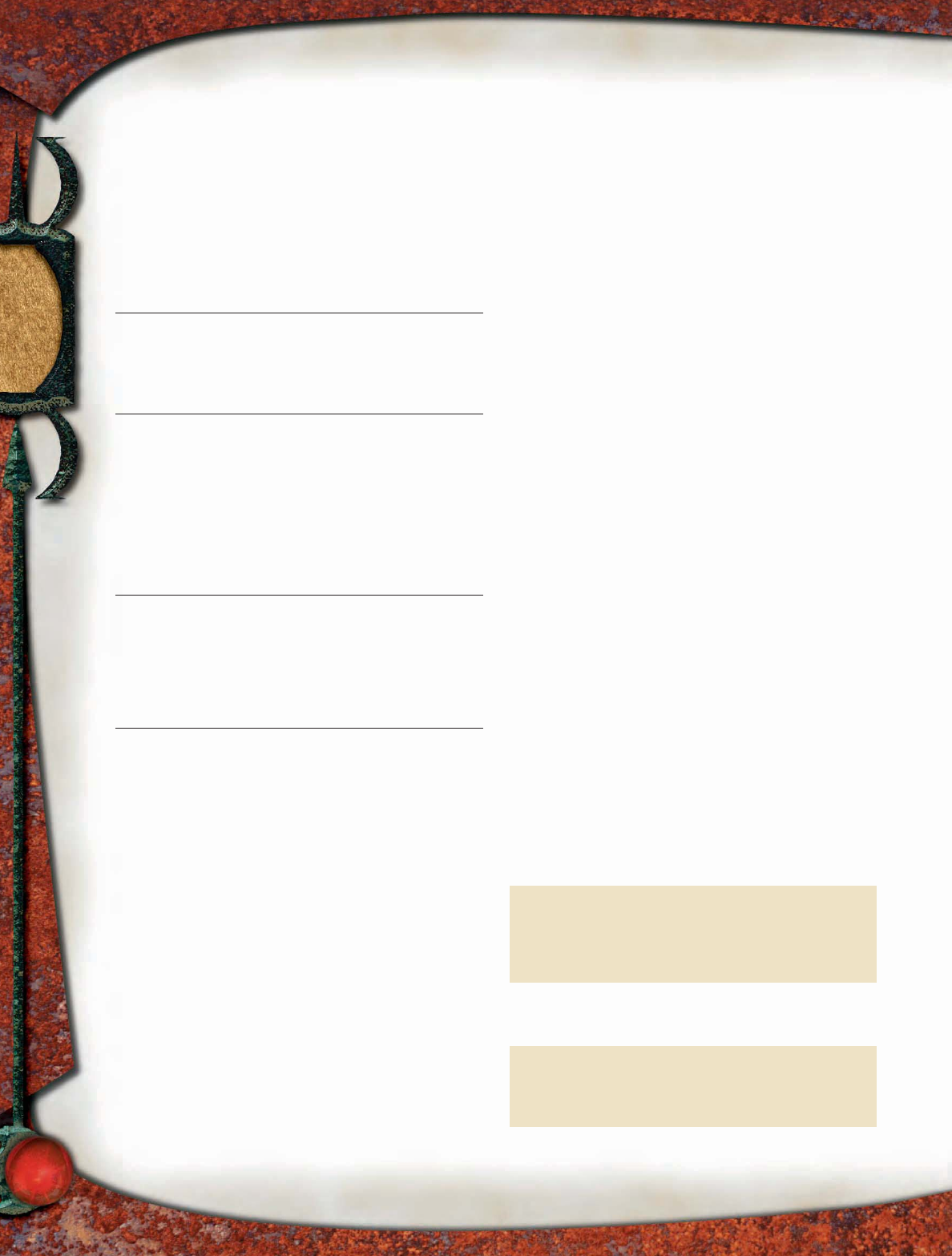
36
STITCHED DEVIL
Creeping forward is a tortured patchwork creature, its fi endish
body a knot of devilish arms, legs, and faces held together by sinewy
thread.
Stitched Devil CR 9
Always LE Large outsider (evil, extraplanar, lawful)
Init +2; Senses darkvision 60 ft., see in darkness; Listen +14,
Spot +14
Aura pain (30 ft.)
Languages Abyssal, Celestial, Common, Infernal; telepathy
100 ft.
AC 27, touch 11, flat-footed 25
(–1 size, +2 Dex, +16 natural)
hp 84 (8 HD); DR 10/good
Immune fire, poison
Resist acid 10, cold 10; SR 19
Fort +12, Ref +10, Will +9
Speed 30 ft. (6 squares), climb 20 ft.
Melee bite +14 (1d8+7) and
4 claws +12 each (1d6+3)
Space 10 ft.; Reach 10 ft.
Base Atk +8; Grp +19
Atk Options aligned strike (evil, lawful)
Spell-Like Abilities (CL 8th):
At will—greater teleport (self plus 50 pounds of objects
only)
1/day—phantasmal killer (DC 17), dispel magic, unholy
blight (DC 17)
Abilities Str 24, Dex 15, Con 22, Int 7, Wis 17, Cha 17
SA aligned strike, pain aura, spell-like abilities
Feats Ability Focus (pain aura), Lightning Reflexes,
Multiattack, TrackB
Skills Climb +15, Diplomacy +5, Intimidate +14, Listen +14,
Search +9, Sense Motive +14, Spot +14, Survival +14 (+16
following tracks)
Advancement 9–16 HD (Large); 17–24 HD (Huge)
Pain Aura (Su) Living creatures must attempt a DC 21
Fortitude save when they come within 30 feet of a
stitched devil. Those that fail take an extra 1d6 points
of damage whenever they take damage from any other
source while within the pain aura’s area. The save DC is
Charisma-based and includes a +2 racial bonus.
When a creature that is affected by multiple pain
auras would take extra damage from the auras, it takes
an extra 1d6 points of damage from one of the auras
affecting it. All other pain auras affecting that creature
cause it to take only 1 extra point of damage apiece. For
example, a creature affected by three pain auras takes
an extra 1d6+2 points of damage each time that creature
takes damage from any other source.
A creature that successfully saves cannot be affected
again by that same stitched devil’s pain aura for 24 hours.
Night hags and lawful evil outsiders are immune to this
aura.
Skills Stitched devils have a +8 racial bonus on Climb checks.
A stitched devil can choose to take 10 on Climb checks,
even if rushed or threatened.
Night hags that know the proper techniques gather the
parts of slain devils and sew them together to create stitched
devils. These fi ends are tormented beyond what is normal
for their kind, imprisoned by their agony and the will of
their makers.
Strategies and Tactics
A stitched devil fi rst uses phantasmal killer on the creature
that looks strongest among its enemies. It then rushes into
melee, heedless of its own safety. If amid combatants it
assumes are not evil—a distinction it might not be correct
about—a stitched devil uses unholy blight, unconcerned with
catching evil allies within the area. It uses greater teleport to
gain advantageous positions during a battle.
Stitched devils encountered in a group use greater teleport to
surround opponents and overlap their auras. Thereafter, they
close the noose, scrambling forward to shred their enemies
with claws and teeth.
Stitched devils rarely use their dispel magic ability unless
directed to do so or a foe has obvious magical defenses that
are thwarting the devil’s attacks.
Sample Encounter
Stitched devils are found in the company of night hags or
abroad doing a night hag’s bidding. A particular night hag
commands groups of two to four stitched devils, depending
on her status and wealth. A night hag purchases devil fl esh
by trading larvae and petitioners to the baatezu.
Elocin’s Pets (EL 13): Elocin, a particularly ambitious
and powerful night hag (12 HD; MM 193)), recently came
into possession of a pair of petitioners bound for the
Heroic Domains of Ysgard. Elocin traded these creatures,
despite their protests, to an amnizu (Fiendish Codex II 112)
that delighted in stealing souls that deserved better. In
exchange, the amnizu gave Elocin a substantial amount
pqqqqqqqqqrs
STITCHED DEVIL LORE
Characters who have ranks in Knowledge (the planes) can
learn more about stitched devils. When a character makes a
successful skill check, the following lore is revealed, including
the information from lower DCs.
Knowledge (the Planes)
DC Result
19 This creature is a stitched devil, a wretched
creature created by a night hag from the Gray
Waste of Hades. It is not a baatezu, but it shares
traits and resiliencies with that hateful race.
Its multiple limbs allow it to attack quickly and
fi ercely.
24 Stitched devils emit waves of pain that cause those
injured in its presence to suffer more intensely.
They can transport themselves great distances in
an instant.
29 Despite its dull intellect, a stitched devil has
command of spell-like abilities that can scare foes
to death or call a greasy cloud of unholy energy
to harm non-evil foes in an area. Good-aligned
weapons can pierce its hide effectively.
pqqqqqqqqqrs
DEVIL
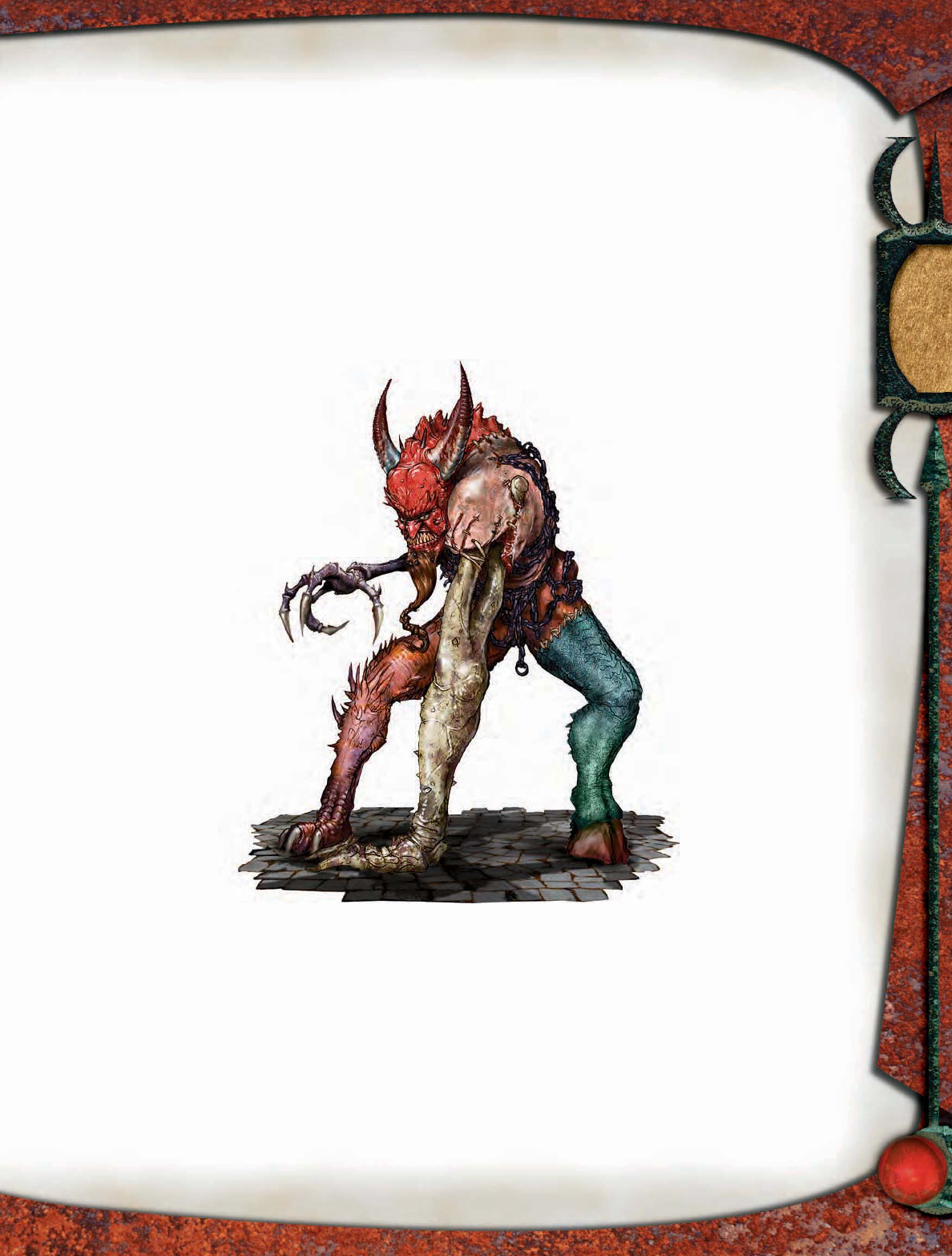
37
of devil flesh. The night hag stitched the parts together to
form a pair of stitched devils to guard her and carry out
her will. She can be found in Sigil (Manual of the Planes
151), brokering for more petitioners in the shadowy alleys
of that city.
Ecology
Devils are part of the cosmic order, if outside natural ecol-
ogy, but stitched devils are apart even from the hierarchy
of the infernal realms. Sewn together from the pieces of
dismembered fi ends, stitched devils live in constant misery.
Though they are, in a sense, constructed, as soon as they
are pieced together they fuse into their distinctive forms,
becoming new creatures with their own personalities,
motives, and pain.
Environment: The twisted pets of night
hags, stitched devils are native to the Gray
Waste of Hades. However, since night hags
prowl the planes, stitched devils can be found
just about anywhere.
Typical Physical Characteristics: Un-
gainly fi ends assembled from whatever hunks of
fl esh the night hags can acquire, stitched devils
never look the same. All are patch-
work creatures of fi endish fl esh.
A typical stitched devil stands
just over 10 feet tall. It weighs
about 800 pounds.
Alignment: Stitched devils
channel their pain into others,
cackling madly at the torment they in-
fl ict. Despite their tendency and desire
to hurt other creatures, they are in-
tensely loyal and obedient to their
night hag creators. Stitched devils are
always lawful evil.
Society
When a devil fails and is
destroyed, its essence
is reabsorbed into the
plane to be spawned
anew in the belching vats
of Hell’s breeding pits. This is the way
the process is supposed to work, but the baat-
ezu are famous for bending the rules to advance their status
in the rigid hierarchy of their dreadful home. Kocrachons
(Book of Vile Darkness 175) are particularly noted for selling
parts of their victims in exchange for valuable larvae and
lost souls, which they then use to procure more interesting
subjects. Stitched devils are therefore abominations in the
eyes of the baatezu.
From the moment they awaken, stitched devils bear
the agony of the disjointed parts that make them up,
as well as the sinew piercing their hides. These crafted
devils have every reason to despise their makers, but they
don’t know that they should, so they simper and whine to
their night hag mistress for affection and mercy. Stitched
devils nurture the vain hope of somehow escaping their
lowly lot and attaining importance, freedom, or—failing
that—final death.
Night hags whisper false promises of relief to their pets,
goading them to commit audacious acts of villainy. The hags
dispatch their stitched devils for all sorts of purposes, using
them as guards and hunters, soldiers and gladiators.
Typical Treasure
Stitched devils search for treasure, taking valuables
from those they slay, much of which they give to
their mistress. Generate standard treasure for
their Challenge Rating, but put most of it
into the mistress’s hoard.
Stitched Devils in Eberron
Night hags of Eberron deal with fiends
and other outsiders, and through their
transactions, they come into posses-
sion of rare and unusual materials
and items. Some hags know how to
imbue the body parts of fiends
with life, creating stitched
devils or “hag dolls.” These
creatures resemble the
stitched devil presented
here, except they are usu-
ally lawful neutral.
Stitched Devils in Faerûn
Stitched devils in Faerûn
are typical for their
kind. A Red Wizard
named Alabrast Rue
stole the technique
for making them from a
night hag he imprisoned and
subsequently slew. By trading the
formula with other night hags in exchange
for a steady stream of extraplanar reagents, Alabrast has
managed to create six of these fiends. The devils serve as
protectors of his hidden redoubt in the city of Sefriszar,
where Alabrast harbors ambitions of becoming Delhu-
mide’s next tharcion.
Stitched devil
DEVIL
Illus. by A. Swekel
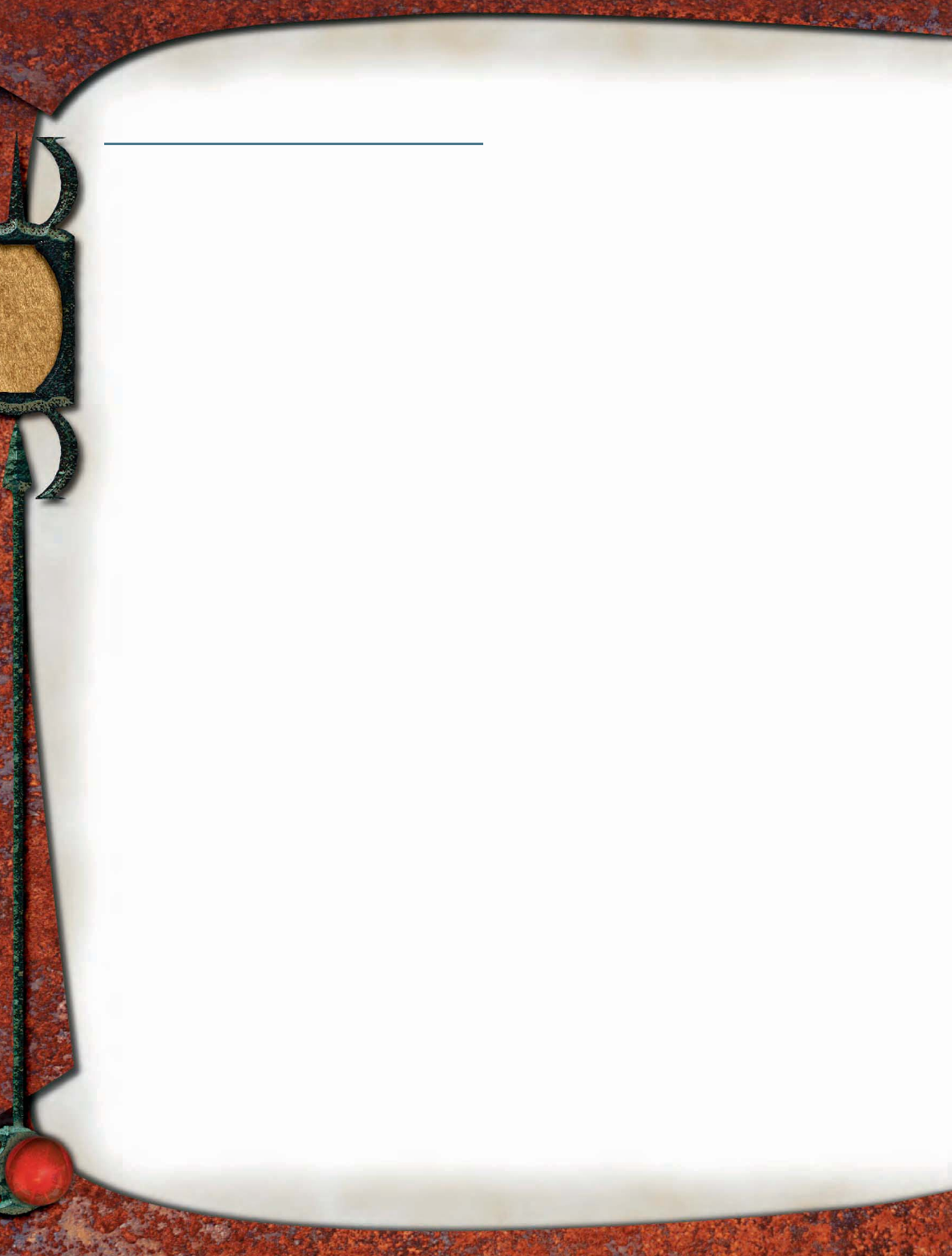
38
DRAGONS OF THE
GREAT GAME
A few dragons, young and old, devote their lives to a competi-
tion called xorvintaal, the “great game.” They scheme against
their fellows, wagering their hoards and manipulating their
minions like chess pieces. Sometimes those that don’t directly
serve a dragon fi nd themselves caught up in the game.
Dragons choose to take up xorvintaal when they’re young
adults, drawn by the allure of besting their fellow dragons
and the promise of vast treasure. But the great game demands
commitment from its players. Dragons are proud and solitary
creatures, so xorvintaal is one of the few ways a dragon can
earn draconic prestige. Masters of xorvintaal are regarded as
the fi nest minds among dragonkind.
To join the great game, a dragon must fi rst research and
perform the Ritual of Xorvintaal. The ritual requires the
dragon to spend a month meditating in a magic cocoon.
When the dragon emerges, it is forever marked as a dragon
of the great game, having sacrifi ced its innate spellcasting
ability for the ability to manipulate its minions, to interact
telepathically with other xorvintaal dragons, and to gain
power as it advances in the great game.
HOW XORVINTAAL WORKS
Xorvintaal takes years to learn and centuries to play. Only
dragons understand the fi ner points of the rules. At its heart,
xorvintaal is a combination of chess and poker, played with
the world as the board and “lesser” creatures as the pieces.
Dragons use lackeys to take over one another’s territories
and hoards, but they must also place their own hoards and
lairs at risk.
Xorvintaal has a feudal element as well, with older, suc-
cessful players taking new players under their wings. A new
player that does well earns esteem and infl uence for its older
draconic patrons, and the older dragon earns a share of the
younger dragon’s hoard and of its future conquests.
The rules of xorvintaal forbid dragon-to-dragon confl ict
except under rare circumstances. Most players act subtly to
divert attention from themselves, avoiding the direct ire of
other players.
Because they join the great game through a transforma-
tive ritual, xorvintaal dragons are incapable of breaking the
rules, but they have potent minions and the unusual abilities
granted by the Ritual of Xorvintaal. They manipulate adven-
turers and other creatures to raid the lairs of their opponents.
These pieces in the great game draw attention to themselves
rather than to their manipulator. After a successful move,
such pieces might fi nd themselves the target of a more
powerful xorvintaal dragon that had a stake in the defeated
dragon’s treasure and winnings.
The exact scoring and rules of engagement are not as
important as the effects that you, as DM, want xorvintaal to
have on your ongoing campaign. In most cases, the mechanics
of the great game can be portrayed as beyond the knowledge
of the PCs.
Those characters who manage to penetrate the mystery
should receive evocative but garbled blends of maneuvers
and strategy from any game you know well enough to speak
eloquently about. Consistency and clarity should be your last
priority—portray xorvintaal as a tortured mess of contradic-
tory rules and exceptions that only a dragon with centuries
to study could understand. Some ideas for PC-relevant moves
for any xorvintaal dragon follow.
Castling: Moving a xorvintaal dragon’s personal hoard
should be an incredibly complex maneuver, requiring years
of preparation and multiple levels of fail-safe and coun-
terstrike plotting. That’s the impression some xorvintaal
dragons like to give. So, how do a few players move their
hoards so quickly, easily, and regularly? Are they moving
into prepared positions? Are their networks of xorvintaal
resources laid out across the world in a way that few if any
rivals can see?
Claw Test: On precise dates that only players of the great
game can fathom, exarchs and unwitting agents of different
players are maneuvered into prearranged locations. The
engagement seems reasonable to each of the combatants at
the time, but if anyone survives to investigate the true causes,
the origins of the confl ict quickly grow murky. Apparently,
the winning player in these small contests is the player whose
agents are deemed to have accomplished the most while
possessing the fewest resources or least power.
DRAGONS OF THE
GREAT GAME
pqqqqqqqqqqqqqqqqqqqqrs
BEHIND THE CURTAIN:
WHY XORVINTAAL?
Applying the xorvintaal template to a dragon is essentially trad-
ing away spellcasting for a few supernatural abilities, most of
which make the dragon a better climactic encounter. Because
the xorvintaal template improves classic dragon abilities such
as breath weapons and melee attacks, it makes dragons act
more like dragons and less like mighty sorcerers who happen
to be dragons.
Handling a dragon’s breath weapon, array of melee attacks,
and special abilities is enough work for a DM. By eliminating
spellcasting, xorvintaal abilities remove a level of complexity.
The xorvintaal abilities are powerful enough to make the tem-
plate a power-neutral choice.
Some of the xorvintaal abilities have specific triggers or timing
associated with them. Some make the dragon seem more
active in combat, improving the feel of the encounter. Others
reward characters who notice that the dragon roars before it
breathes.
The story behind the xorvintaal template is an excuse to
populate a dragon’s lair with all sorts of interesting monsters
and NPCs—the dragon’s exarchs. Encounter design is easier
if the dragon has a loyal exarch that handles spellcasting for it.
Design a dedicated spellcaster for the task, leaving the dragon
free to breathe fire and bite victims in half.
pqqqqqqqqqqqqqqqqqqqqrs
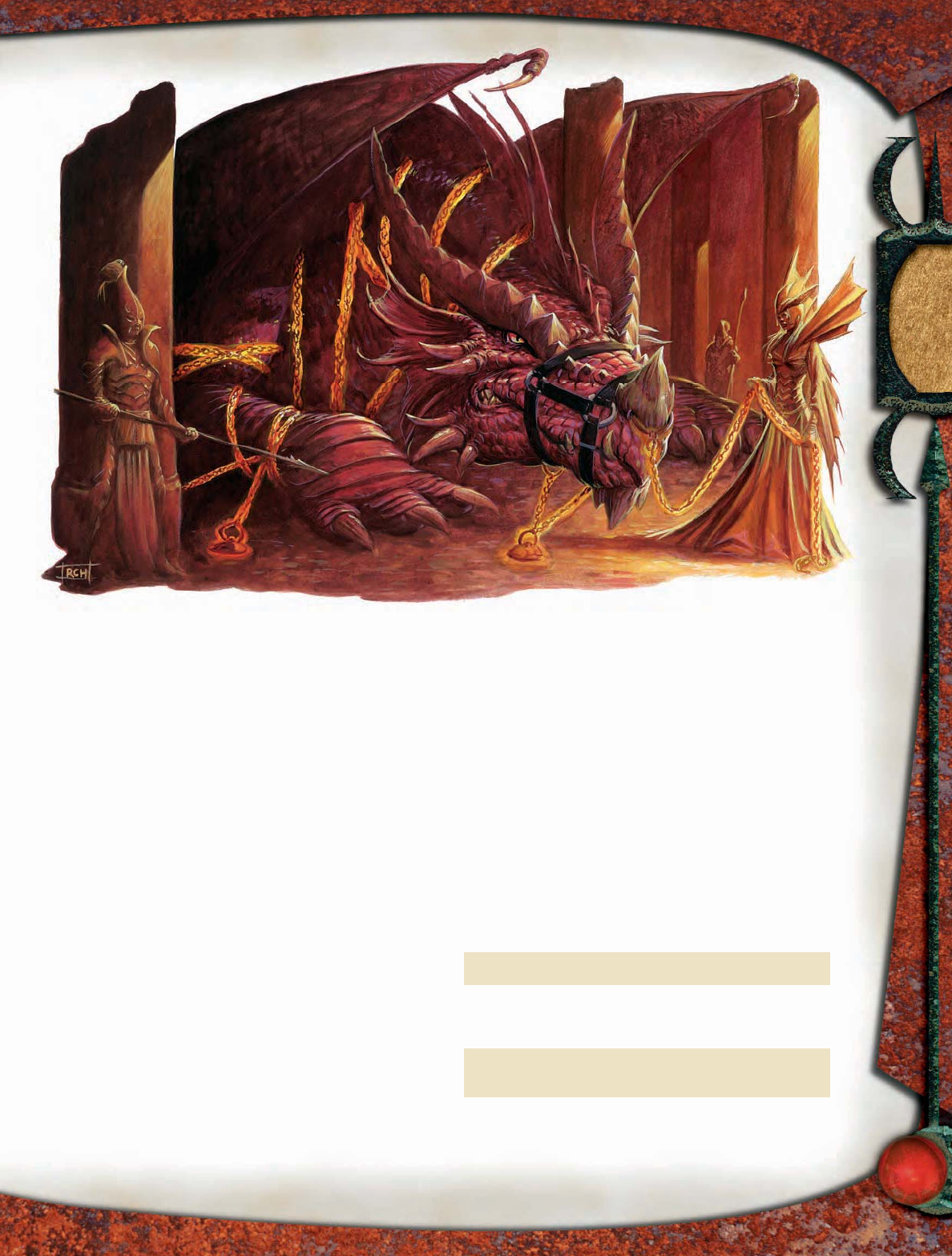
39
Survivors of such arranged confl icts have a way of growing
into positions of power that make them even better exarchs
than agents who start with all the advantages. Would-be PC
exarchs are sure to be involved in a claw test.
Seed Hoard: One of the most aggressive moves in xor-
vintaal is establishing a new hoard in an area the dragon
player doesn’t intend to personally occupy. Relying on
exarchs and pawns to protect this so-called seed hoard
earns high points, especially if the seed hoard is near a
rival player’s personal hoard. Moving a seed hoard within
the 10-mile radius in which a xorvintaal dragon can com-
municate telepathically with its own exarchs (see page 47)
is a bold maneuver, leading to great losses if the rival can’t
locate and eliminate the seed hoard within a reasonable
amount of time.
In the PCs’ lives, a seed hoard creates an odd situation in
which a dragon’s hoard seems to be defended by everything
but the dragon.
Seed Sham: Some seed hoards are bluffs. Instead of
consisting of an actual hoard, they are mixtures of bizarre
traps and threats designed to cut away at the rival dragon’s
resources. Such trickery might be why xorvintaal dragons
seem reluctant or unable to move directly to investigate
curious happenings near their territory.
The best and highest-scoring seed shams are played in such
a fashion that the target of the bluff should be able to fi gure
out that the supposed seed hoard might be a bluff, using all
the rules of the game. But calling a bluff that turns out to be
a true seed hoard can have disastrous consequences, so lesser
players are prone to using newly acquired and expendable
assets to investigate questionable seeds. That sounds like a
job for the PCs.
Xorvintaal has clear winners and losers
DRAGONS OF THE
GREAT GAME
pqqqqqqqqqrs
XORVINTAAL LORE
Characters who have ranks in Knowledge (arcana) can learn
more about xorvintaal. When a character makes a success-
ful skill check, the following lore is revealed, including the
information from lower DCs. Though the specific rules of
the game are incredibly esoteric, its general principles are
understood.
Knowledge (Arcana)
DC Result
20 Xorvintaal is the great game that dragons play,
trying to steal each other’s treasure.
25 Some dragons play xorvintaal, wagering their
hoards against each other. It’s essentially a
struggle over territory, played out with humanoids
and monsters as the game pieces.
30 Dragons that play xorvintaal can perform a
ritual that grants other creatures extra power in
exchange for helping the dragon in the great game.
35 Xorvintaal has a feudal element to it, with younger
players doing the bidding of older dragons in
exchange for protection and assistance.
pqqqqqqqqqrs
Illus. by R. Horsley
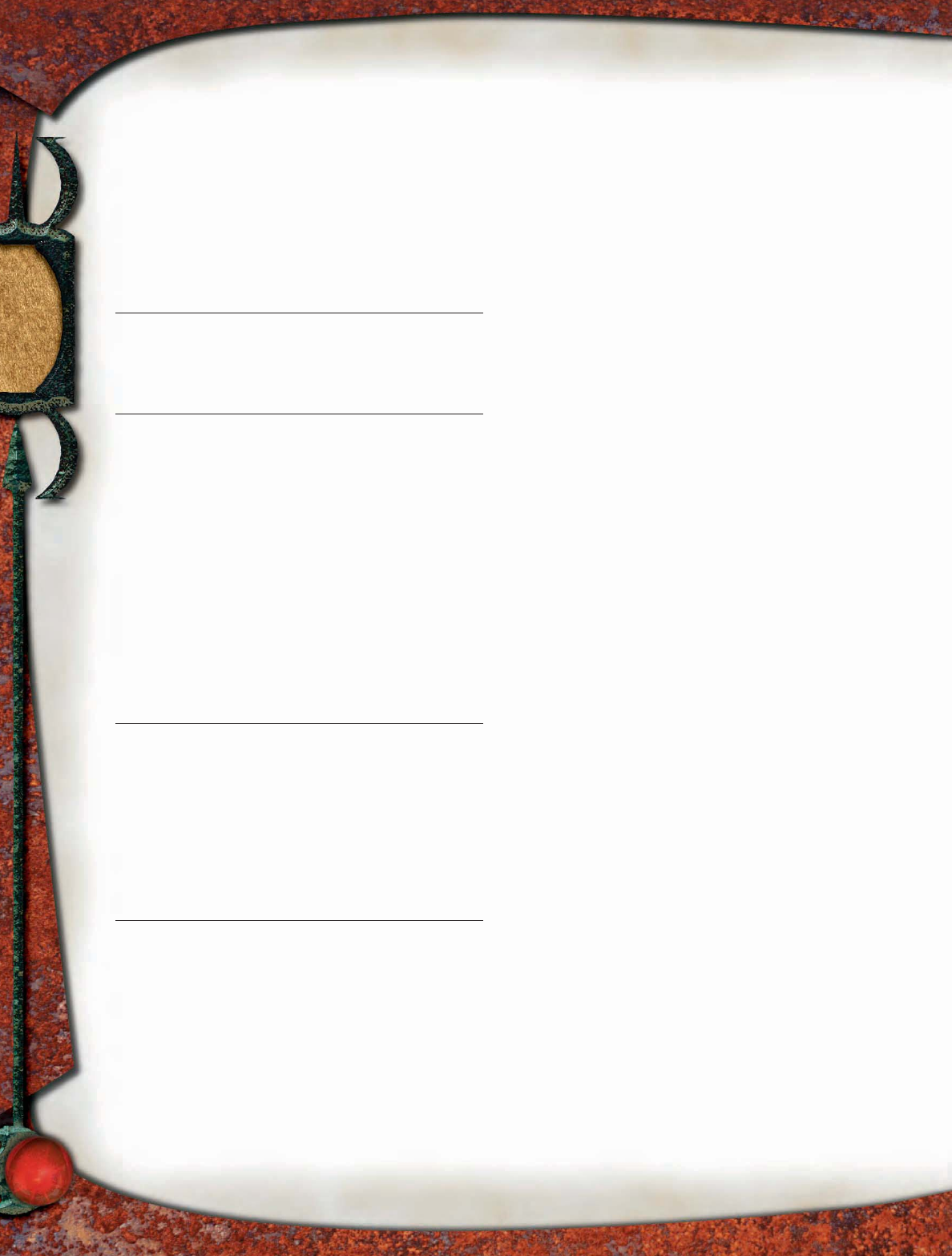
40
CHORRANATHAU
THE INSCRUTABLE
This immense dark dragon is covered in sharp spikes and has over-
sized fangs. It moves with a sinuous grace as it stalks toward you.
Chorranathau the Inscrutable CR 18
Male ancient fang dragon
CN Gargantuan dragon
Init +0; Senses blindsense 60 ft., darkvision 120 ft., keen
senses; Listen +38, Spot +38
Languages Common, Draconic, Elven, Dwarven, Infernal,
Giant; telepathy (see text)
AC 35, touch 6, flat-footed 35
(–4 size, +29 natural)
hp 375 (30 HD); fast healing 2; DR 15/magic; berserker
power
Immune divination (see text)
Fort +28, Ref +26, Will +27
Speed 60 ft. (12 squares), fly 150 ft. (clumsy)
Melee bite +37 (4d8+11 plus Con drain plus dragon toxin)
and
2 claws +38 each (4d6+5/19–20 plus dragon toxin plus
trip) and
2 wings +37 each (2d8+5) and
tail slap +37 (4d6+16 plus trip)
Space 20 ft.; Reach 15 ft. (20 ft. with bite)
Base Atk +30; Grp +53
Atk Options Cleave, Great Cleave, Devastating Critical (claw),
Overwhelming Critical, Power Attack, frightful presence,
magic strike
Special Actions crush, tail sweep, twist of fate
Spell-Like Abilities (CL 11th):
At will—charm monster (DC 17, his exarchs only, CL 18th),
detect magic, read magic
3/day—scrying (DC 17, on his exarchs only, CL 18th)
2/day—shield, telekinesis (DC 18)
1/day — dispel magic, spell turning, globe of invulnerability
Abilities Str 33, Dex 10, Con 23, Int 19, Wis 21, Cha 16
SQ create exarchs, sound imitation
Feats Cleave, Devastating Critical (claw)*, Draconic
Knowledge*, Epic Reflexes*, Great Cleave, Improved
Critical (claw), Improved Multiattack*, Multiattack,
Overwhelming Critical*, Power Attack, Weapon Focus
(claw)
* These feats appear in Draconomicon.
Skills Bluff +12, Concentration +21, Diplomacy +40,
Intimidate +38, Knowledge (arcana) +37, Knowledge
(geography) +37, Knowledge (history) +37, Listen +38,
Search +37, Sense Motive +38, Spot +38
Keen Senses (Ex) See four times as well as a human in
shadowy illumination; see twice as well in normal light.
Telepathy (Su) Chorranathau can communicate telepathically
with any of his exarchs (10-mile range) and with other
willing xorvintaal dragons (100-mile range).
Berserker Power (Su) When Chorranathau is reduced to 186
hit points or fewer, he gains a +5 bonus on attack rolls
and damage rolls.
Divination Immunity (Ex) Nobody can learn about
Chorranathau’s future xorvintaal moves through
divination spells and similar effects. Such effects can still
reveal other information about him.
Constitution Drain (Su) Chorranathau’s bite deals 2d4 points
of Constitution drain (Fortitude DC 28 negates).
Dragon Toxin (Su) When Chorranathau hits a creature,
that creature is exposed to dragon toxin and takes 25
points of damage at the start of each of Chorranathau’s
turns. Multiple wounds don’t stack. Magical healing
ends this effect but doesn’t protect against subsequent
exposure. The dragon toxin dissipates 1 round after
Chorranathau dies.
Frightful Presence (Ex) 300-foot radius, 29 HD or fewer, Will
DC 28 negates.
Trip (Ex) If Chorranathau hits with a claw or tail attack, he
can attempt to trip (+33 check modifier) that opponent
as a free action. If the attempt fails, the opponent cannot
react to trip Chorranathau.
Crush (Ex) As a standard action, Chorranathau can land
on Large or smaller creatures within in an area equal
to his space. Those creatures take 4d8+16 points of
bludgeoning damage and must succeed on a DC 28
Reflex save or be pinned. Pinned creatures take
4d8+16 points of bludgeoning damage each round
they remain pinned.
Tail Sweep (Ex) As a standard action, Chorranathau can
sweep his tail through a half-circle that has a 30-foot
radius. The sweep deals 2d6+16 points of bludgeoning
damage (Reflex DC 28 half).
Twist of Fate (Su) Chorranathau can spend an immediate
action to produce one of the following effects.
When targeted by a spell that affects one or more
targets (as opposed to an area spell), he can gain
a +10 bonus on the saving throw against that spell. He
subsequently loses his +5 insight bonus on saves for
1d4 rounds.
He can move 30 feet to avoid an area effect, but only
if that movement would take him out of the effect’s area.
If he does so, he cannot move on his next turn.
When Chorranathau could make an attack of
opportunity, he can instead flap his wings and blast
wind at the foe that provoked the attack. The wing flap
functions like a bull rush attempt (+11 bonus on the
opposed check), except that Chorranathau doesn’t move
along with the foe being pushed (though the victim
can still be pushed as far as the maximum distance
Chorranathau could normally bull rush it). If the target is
airborne, it is treated as one size smaller for the purpose
of resolving the opposed check. This immediate action
doesn’t use up Chorranathau’s attack of opportunity.
Devastating Critical (Ex) If Chorranathau confirms a critical
threat with a claw attack, the opponent struck must
succeed on a DC 36 Fortitude saving throw or die
instantly (Draconomicon 68).
Draconic Knowledge (Ex) Chorranathau can make the
equivalent of a bardic knowledge check (PH 28, +14)
to reveal information about an item, event, or locale
(Draconomicon 69).
Overwhelming Critical (Ex) If Chorranathau confirms a
critical threat with a claw attack, he deals an extra 1d6
points of damage with that attack (Draconomicon 72).
Create Exarchs (Sp) Chorranathau can perform an hour-long
ritual to designate a creature as his exarch in the ongoing
great game. Doing so gives the xorvintaal exarch template
(see page 47) to the designated creature.
Sound Imitation (Ex) Chorranathau can mimic any sound he
has heard (Will DC 28 detects the ruse).
Chorranathau is a master of xorvintaal, and he is known
widely among the other dragons of the great game. He counts
dozens of younger dragons as his vassals.
DRAGONS OF THE
GREAT GAME
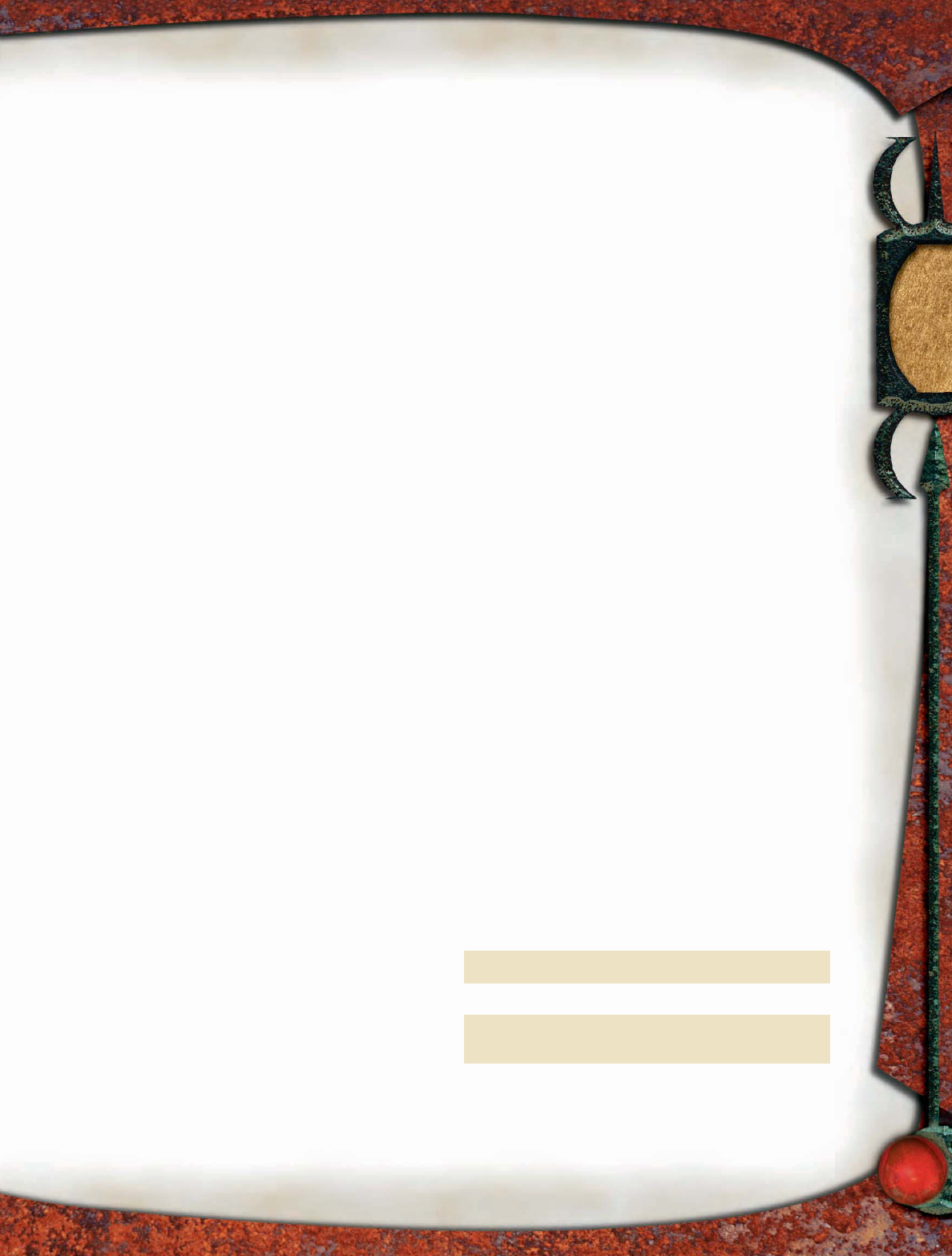
41
Strategies and Tactics
Chorranathau arrays high-level spellcaster exarchs (such as the
Shrouded Vizier) to force foes closer to him. He also employs ter-
rain and sound imitation to ensure that enemies don’t encounter
him until they’re practically standing next to him.
Once an adversary approaches to what Chorranathau
feels is a suffi ciently close distance, he attacks, evoking his
frightful presence. He makes a full attack whenever possible,
spreading his attacks around at fi rst so that every one has to
deal with his dragon toxin ability. He then focuses on the
opponent that dealt him the largest amount of damage.
Whenever he would otherwise make an attack of oppor-
tunity for the fi rst time in a round, he instead uses his twist
of fate ability to buffet a foe. He then has another attack of
opportunity available.
Sample Encounters
Chorranathau has several dozen exarchs, a testament to his
numerous victories in the great game. He’s best used as a
powerful but distant force. Chorranathau rarely leaves his
lair, so only after dealing with layers of exarchs and braving
the dangers of the fang dragon’s abode might the PCs actu-
ally meet him.
The Master’s Test (EL 18): Working through intermediar-
ies and exarchs, Chorranathau has had his eye on the PCs for
some time. Impressed with their power, the fang dragon has
decided that the characters might make good exarchs, but
he wants to test their mettle fi rsthand. Chorranathau meets
the PCs in an immense courtyard and explains the nature
of the test—a trial by combat that any participant can exit
at any time by saying “I yield.” The dragon then engages the
characters in battle. Chorranathau doesn’t pull punches in
the fi ght, except to avoid targets so weak that he can kill them
with a single blow. Chorranathau yields when reduced to
74 hit points or fewer, and he has a high-level cleric exarch
restore slain PCs to life when the battle is over.
Called onto the Carpet (EL 20): Chorranathau and his
Shrouded Vizier (female human necromancer 18) invite
the PCs into the ancient fang dragon’s lair to explain recent
actions the characters have perpetrated that hindered
Chorranathau’s progress in the great game. The PCs have
to negotiate a solution or otherwise mollify Chorranathau,
while the vizier employs a battery of divination spells to make
sure they speak truly and deal fairly. The PCs might walk
out as Chorranathau’s newest exarchs, they might walk out
chastened and warned against further interference, or they
might not walk out at all.
Ecology
Chorranathau is physically typical for a fang dragon of his
size and age. He is patient and calculating compared to any
younger fang dragon, and he tempers his appetites to suit his
desires in the great game.
Environment: Chorranathau uses an ancient mountain
temple as his lair. His Knights of the Teeth (low-level mer-
cenary fi ghters) scour the nearby valleys for elk, deer, and
other delicacies so that Chorranathau doesn’t have to leave
his home.
Over centuries spent fending off xorvintaal rivals, Chor-
ranathau has installed a wide array of deadly traps throughout
the temple. At any given time, about a dozen high-level
exarchs reside in the temple, ready to defend their master
and otherwise do his bidding.
Physical Characteristics: Chorranathau is 85 feet long
from snout to tail tip. He stands 16 feet tall on all fours and
has a wingspan of 70 feet. He weighs eighty tons.
Alignment: In Chorranathau’s mind, the battle between
good and evil is a philosophical trifl e that pales in com-
parison to the all-encompassing passion that is xorvintaal.
All other creatures are pieces in the game. Chorranathau is
chaotic neutral.
Society
Chorranathau’s interest in the great game has grown into
an obsession. He’s always plotting the future moves of his
exarchs and the younger xorvintaal dragons under his patron-
age, trying to think ahead as many moves as possible.
But at this point in the game, the only xorvintaal dragons
that can challenge Chorranathau are likewise brilliant and
capable. So Chorranathau has started cultivating a reputation
for being ruthless and unpredictable. The reputation fi ts his
natural proclivities, and Chorranathau fi nds that a lot of his
xorvintaal rivals would rather contend with more predictable
opposition, leaving Chorranathau free to chip away at their
territories with less risk of reprisal.
Typical Treasure
In his lair, Chorranathau has an immense pile of treasure. Start
with quintuple standard for Chorranathau himself, or 235,000
gp, and put the bulk of the treasure from other encounters
within Chorranathau’s temple into his hoard as well.
DRAGONS OF THE
GREAT GAME
pqqqqqqqqqrs
CHORRANATHAU LORE
Characters who have ranks in Knowledge (arcana) can learn
more about Chorranathau. When a character makes a suc-
cessful skill check, the following lore is revealed, including the
information from lower DCs. The DCs for this check are lower
than normal because of Chorranathau’s renown.
Knowledge (Arcana)
DC Result
15 Chorranathau is a reclusive dragon held in high
esteem by other dragons.
20 A fang dragon, Chorranathau is a master player in
xorvintaal, the great game of dragons.
25 Chorranathau’s lair is an ancient temple high in
the southern mountains. To venture there is to
invite certain death.
30 Chorranathau is a powerful patron to various
younger dragons playing the great game. Because
some of those vassals are good and others are
evil, he sometimes has to intervene to keep them
from fi ghting one another.
pqqqqqqqqqrs

42
MORLICANTHA
With a fl ash of light, the beautiful female before you transforms into
a dragon the size of a horse, its silver scales fl ashing and glittering
as it coils its tail around itself.
Morlicantha CR 13
Female young adult silver dragon
LG Large dragon (cold)
Init +0; Senses blindsense 60 ft., darkvision 120 ft., keen
senses; Listen +26, Spot +26
Aura energy (5 ft.)
Languages Celestial, Common, Draconic, Dwarven, Giant,
Sylvan; telepathy (see text)
AC 27, touch 9, flat-footed 27
(–1 size, +18 natural)
hp 199 (19 HD); DR 5/magic
Immune acid, cold, divination (see text)
Fort +17, Ref +13, Will +19
Speed 40 ft. (8 squares), fly 150 ft. (poor); cloudwalking
Melee bite +24 (2d6+6) and
2 claws +24 each (1d8+3) and
2 wings +24 each (1d6+3) and
tail slap +24 (1d8+9)
Space 10 ft.; Reach 5 ft. (10 ft. with bite)
Base Atk +19; Grp +29
Atk Options Power Attack, frightful presence, magic strike
Special Actions cold breath weapon, paralysis gas breath
weapon
Spell-Like Abilities (CL 5th):
At will—charm monster (DC 18, her exarchs only, CL 13th)
3/day—scrying (DC 18, her exarchs only, CL 13th)
2/day—feather fall
Abilities Str 23, Dex 10, Con 19, Int 18, Wis 19, Cha 18
SQ alternate form, create exarchs
Feats Improved Multiattack*, Iron Will, Maximize Breath*,
Multiattack, Overcome Weakness*, Power Attack,
Suppress Weakness*
* These feats appear in Draconomicon.
Skills Bluff +15, Diplomacy +32, Knowledge (arcana) +26,
Knowledge (local) +26, Knowledge (nobility and
royalty) +26, Listen +26, Search +26, Sense Motive +26,
Spellcraft +15, Spot +26
Keen Senses (Ex) See four times as well as a human in
shadowy illumination; see twice as well in normal light.
Energy Aura (Su) At will, Morlicantha can surround her body
with an icy nimbus. At the start of each of Morlicantha’s
turns, the nimbus deals 25 points of cold damage to
adjacent creatures. If Morlicantha uses her cold breath
weapon, she loses her energy aura until the end of her
next turn.
Telepathy (Su) Morlicantha can communicate telepathically
with any of her exarchs (10-mile range) and with other
willing xorvintaal dragons (100-mile range).
Divination Immunity (Ex) Nobody can learn about
Morlicantha’s future xorvintaal moves through divination
spells and similar effects. Such effects can still reveal
other information about her.
Cloudwalking (Su) Morlicantha can tread on clouds or fog as
if the surface were solid.
Frightful Presence (Ex) 150-foot radius, 19 HD or fewer, Will
DC 23 negates.
Cold Breath Weapon (Su) 40-foot cone, once every 1d4
rounds, damage 10d8 cold, Reflex DC 23 half.
Paralysis Gas Breath Weapon (Su) 40-foot cone, once
every 1d4 rounds, paralysis 1d6+5 rounds, Reflex DC 23
negates.
Maximize Breath Morlicantha can maximize the effect
of either breath weapon (dealing 80 points of cold
damage or paralyzing for 11 rounds). If she does so,
she can’t use either breath weapon for 1d4+3 rounds
(Draconomicon 71).
Overcome Weakness Morlicantha is no longer vulnerable
to fire (Draconomicon 72). Suppress Weakness is a
prerequisite for this feat but has no additional effect.
Alternate Form (Su) Morlicantha can assume any animal or
humanoid form.
Create Exarchs (Sp) Morlicantha can perform an hour-long
ritual to designate a creature as her exarch in the ongoing
great game. Doing so gives the xorvintaal exarch template
(see page 47) to the designated creature.
Morlicantha is an ambitious but principled xorvintaal dragon
that is relatively new to the great game. She’s actively seeking
worthy members of the “unwinged races” to aid her efforts
and, in time, become her exarchs.
Strategies and Tactics
In battle, resolve Morlicantha’s frightful presence as soon
as the fight starts. If she wants to kill her enemies, she
uses a maximized cold breath weapon right away. Doing
so puts the breath weapon on the shelf for a longer time,
but it puts her energy aura into play starting in round 3
(assuming she breathes in round 1). She behaves evasively
or tries to seize advantageous terrain in round 2, hoping
the PCs catch up to her just in time for her energy aura to
deal damage at the start of round 3. Then she lays down
the law with her natural attacks, using Power Attack only
conservatively.
If Morlicantha doesn’t want to kill her attackers, then
she employs her paralysis breath weapon instead. Some of
her foes have recovered from paralysis to fi nd themselves
pinned underneath Morlicantha’s considerable bulk. Then
the questioning begins.
Sample Encounters
Morlicantha travels a great deal, trying to learn as much as
she can about her rivals in the great game. She goes incognito
as a beautiful half-elf female or a wizened human crone.
Encounters with Morlicantha walk a fine line between
outright combat and a test for suitability as an ally.
Here Comes the Cavalry (EL 11): Morlicantha appears
in half-elf form and offers the PCs a bargain. She’s willing
to get them out of their current dilemma if they accept a
short detour to slay a ten-headed pyrohydra in its nearby
lair. The creature is a pawn in another xorvintaal dragon’s
plans, and Morlicantha doesn’t want to move against the
dragon directly.
You Don’t Look So Tough (EL 13): In her crone form,
Morlicantha observes the PCs in a public setting. Then she
approaches a thin-skinned or impulsive PC and attempts
to goad him or her into an arm-wrestling match, footrace,
DRAGONS OF THE
GREAT GAME
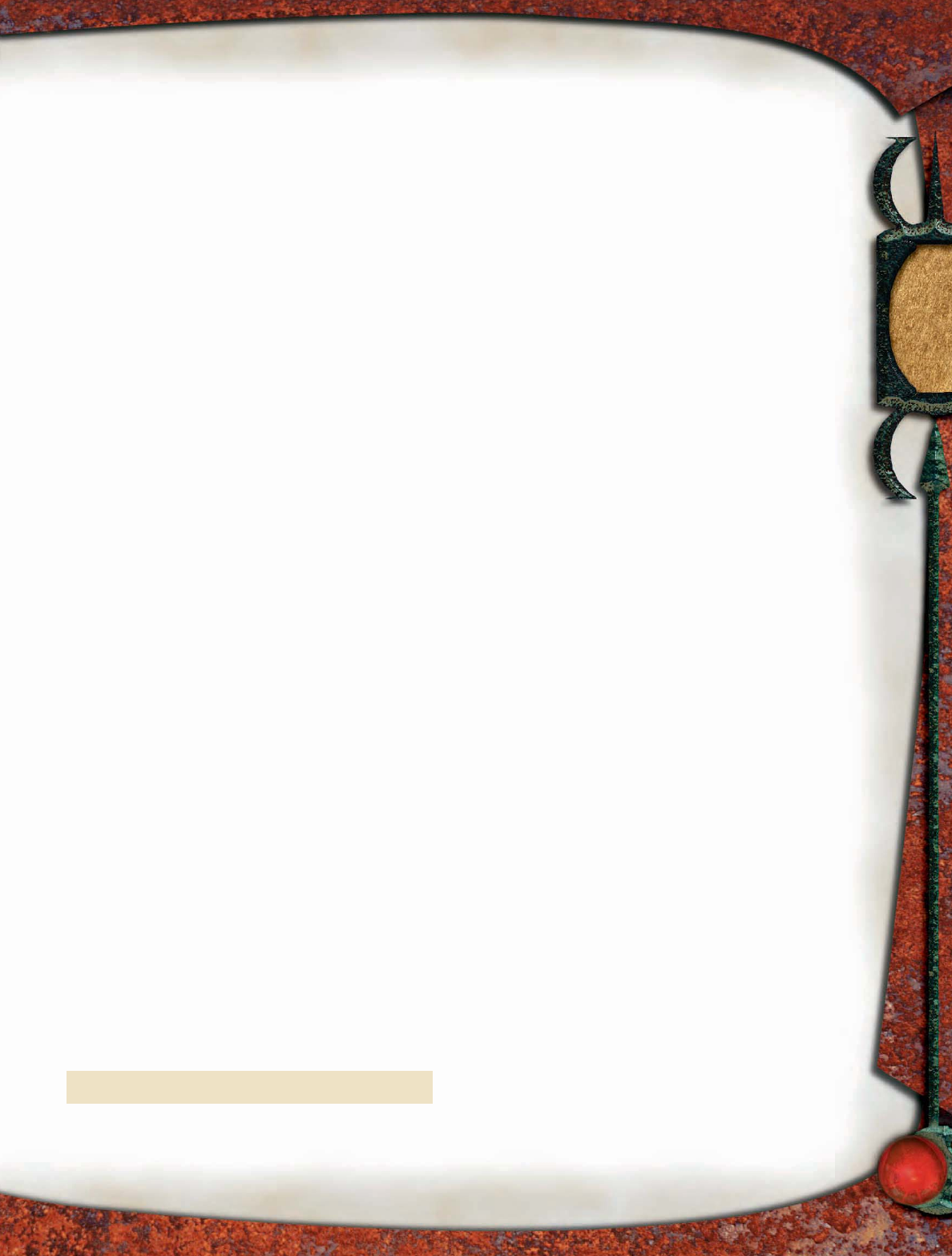
43
or other athletic feat. If the character demurs, Morlicantha
taunts and belittles that PC loud enough for everyone to hear.
If a fi ght breaks out, Morlicantha participates until reduced
to 50 hit points or fewer. Then she fl ies away, shouting, “We’ll
meet again!” If the characters win the competition or defeat
her in combat, Morlicantha might return to offer them a role
in her next xorvintaal move.
Ecology
An inveterate traveler, Morlicantha is often on the road
spying on her rivals or making moves against their territory.
Because Morlicantha spends so much time in her favorite
alternate forms, she has developed a taste for food favored
by humanoids.
Environment: Unusual for a silver dragon, Morlican-
tha’s lair is on a small coral atoll off a forbidding coast.
Morlicantha is often away playing the great game, but a
band of tritons guards her island. A network of tunnels
extends from the atoll to below the seafloor. Morlicantha
isn’t the first dragon to call this atoll home, and because
of her obsession with xorvintaal, she hasn’t fully explored
all the tunnels yet.
Physical Characteristics: In her true form, Morlicantha
is 35 feet long and has a wingspan of 50 feet. She weighs 2,500
pounds. Her alternate forms adhere to racial averages.
Alignment: Morlicantha has a deep and abiding respect
for the rules of xorvintaal, but her sense of fair play doesn’t
dull her competitive edge one bit. When it comes to xor-
vintaal, she acts as aggressively as the rules allow. She is
lawful good.
Society
Morlicantha is obsessed with xorvintaal, but she has opted
for a risky play style. She refuses to ally herself with more
powerful dragons, choosing to go it alone. This choice affords
her great freedom, but any other dragon can move on her
territory and lair without having to worry about a powerful
patron. Of course, other dragons don’t necessarily know
Morlicantha is a loner.
Morlicantha is exceedingly wary of other dragons, and
that’s one reason why she’s so keen to get allies from what
she calls the “unwinged races.” Among humans and their ilk,
she can be helpful and even gregarious. But in the presence
of dragons or their exarchs, she watches her words carefully
and tries to remain as unobtrusive as possible.
Typical Treasure
In her lair, Morlicantha has triple standard treasure for a
CR 13 monster, or 39,000 gp. In addition, when she travels
as a maiden or a crone, Morlicantha is equipped as a 10th-
level NPC.
CREATING A XORVINTAAL DRAGON
“Xorvintaal dragon” is an acquired template that can be added
to any young adult or older true dragon (referred to hereafter
as the base dragon).
Challenge Rating: Same as base creature or higher,
depending on how many xorvintaal abilities it has (see
below).
Languages: A xorvintaal dragon can communicate tele-
pathically with any of its exarchs (10-mile range) and with
willing xorvintaal dragons (100-mile range).
Immune: Nobody can learn about a xorvintaal dragon’s
future game moves through divination spells and similar
effects. Such effects can still reveal other information about
a xorvintaal dragon.
Spell Resistance: Xorvintaal dragons do not have spell
resistance.
Saving Throws: A xorvintaal dragon gains a +1 insight
bonus on saving throws for every two age categories it has.
A young adult, for example, gains a +2 insight bonus.
Spells: Xorvintaal dragons lose the ability to cast spells.
Spell-Like Abilities: A xorvintaal dragon retains all spell-
like abilities, and it gains the following.
Charm Monster (Sp): At will, a xorvintaal dragon can use
charm monster on its exarchs (caster level 8th + the dragon’s
age category).
Scrying (Sp): Three times per day, a xorvintaal dragon can
use scrying with one of its exarchs as the target (caster level
8th + the dragon’s age category).
Special Qualities: A xorvintaal dragon has all the special
qualities of the base dragon, plus the following special
qualities.
Create Exarchs (Sp): A xorvintaal dragon can perform an
hour-long ritual to designate a creature as an exarch in the
ongoing great game. Doing so gives the xorvintaal exarch
template (page 47) to the designated creature or gives fi ve
favor tokens to a creature that is already an exarch.
Xorvintaal Abilities (Su): A xorvintaal dragon chooses
one of these abilities after it completes the Ritual of Xor-
vintaal, and it earns more by achieving victories in the
great game.
The average xorvintaal dragon has one of these abilities,
plus another one for every two age categories it attains beyond
young adult. But if you’re creating a particularly successful
xorvintaal dragon, you can add more xorvintaal abilities,
DRAGONS OF THE
GREAT GAME
pqqqqqqqqqrs
MORLICANTHA LORE
Characters who have ranks in Knowledge (arcana) can learn
more about Morlicantha. When a character makes a success-
ful skill check, the following lore is revealed, including the
information from lower DCs. Because she’s new to xorvintaal,
little is known about her.
Knowledge (Arcana)
DC Result
23 Morlicantha is a silver dragon fond of taking
humanoid form and manipulating people.
28 She plays xorvintaal, the dragons’ great game, and
is unaffi liated with any powerful dragons.
pqqqqqqqqqrs
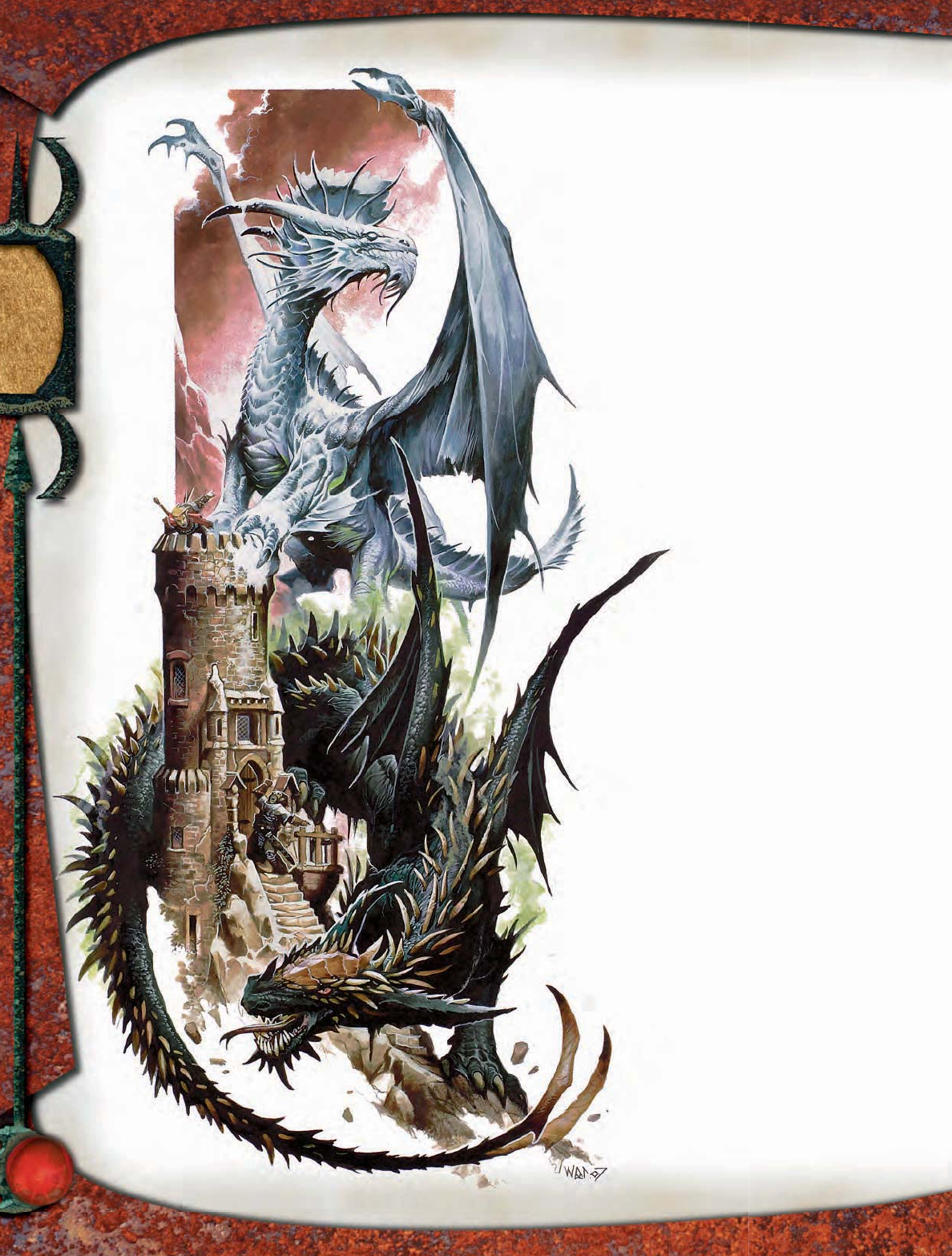
44
adding 1 to the Challenge Rating of the dragon for each extra
xorvintaal ability.
Alternate Form: Three times per day, a xorvintaal dragon
can assume any animal or humanoid form of Medium size
or smaller.
Berserker Power: Once reduced to half of its full normal
hit points or fewer, a xorvintaal dragon receives a +1 bonus
on melee attack rolls and damage rolls for every two age
categories it has. The bonus lasts until the dragon heals
to half its full normal hit points or higher.
Deep Breath: If a xorvintaal dragon spends a move
action to visibly inhale, it can deliver its breath weap-
on the following round with extra potency, dealing
an extra 4 dice of damage (of whatever dice the
breath weapon ordinarily deals) and increasing
the DC of the Refl ex save by 4. The deep breath
ability doesn’t change the recharge time for the
breath weapon.
Draconic Roar: As a swift action, a xorvintaal
dragon can emit an astounding roar. Doing
so deals half the dragon’s breath weapon
damage in sonic damage and deafens all
creatures within 30 feet of the dragon. A
successful Fortitude saving
throw (same DC as the breath
weapon) halves the damage and
negates the deafening. Deafened
characters naturally regain their hear-
ing after 1 hour.
Once a xorvintaal dragon uses its dracon-
ic roar, it can’t use it again until after it uses its
breath weapon. When rolling to see how long it
takes the breath weapon to recharge, use the same
result – 1 to determine when the roar is avail-
able again.
Dragon Eyes: A xorvintaal dragon can keep
tabs on its lair and territory with an array of
fl oating magic eyes that patrol and report back
to the dragon. This effect functions like the
prying eyes spell, except that a xorvintaal dragon
receives two fl oating eyes per age category it has.
The dragon eyes last indefi nitely; when one is
destroyed, another one forms next to the dragon
at the start of its next turn. Whenever an eye re-
turns to the dragon, the dragon can give the eye
new instructions.
Dragon Toxin: When it is in combat, a
xorvintaal dragon’s fangs and claws drip
a corrosive fluid called dragon toxin.
Any creature dealt damage by the xor-
vintaal dragon’s bite or claw attacks is
affected by dragon toxin. At the start
of each of the dragon’s turns, each crea-
ture affected by dragon toxin takes an
extra 5 points of damage for every two
age categories the dragon has. Multiple
DRAGONS OF THE
GREAT GAME
Chorranathau
and Morlicantha
Illus. by W. Reynolds
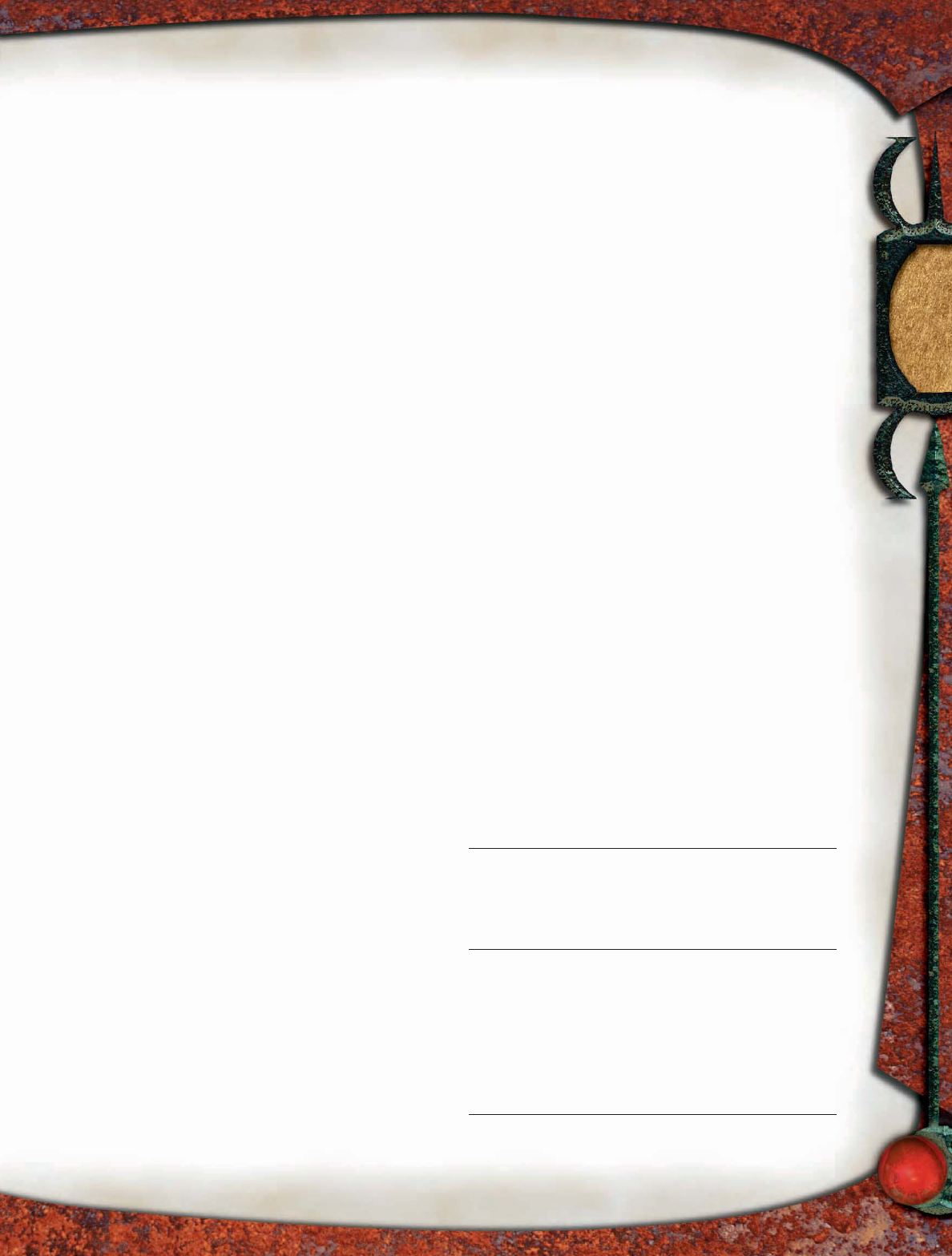
45
wounds don’t deal damage multiple times—a creature is
either affected by dragon toxin or not. Any form of magi-
cal healing eliminates dragon toxin currently affecting
a creature but doesn’t protect against subsequent expo-
sure. Its dragon toxin harmlessly dissipates 1 round after
a xorvintaal dragon dies.
Energy Aura: The potent energy within a xorvintaal dragon
pours out of its body, damaging everyone nearby. At the
start of each of the dragon’s turns, this energy deals 5 points
of damage (of the same type as its breath weapon) per age
category to all creatures adjacent to the dragon. The aura
is obvious to all who can see the dragon. A red dragon, for
example, is wreathed in fl ame; a blue dragon has a corona of
electricity; and green and black dragons vent corrosive gas.
If the dragon uses its breath weapon, it loses its energy until
the end of its next turn. Dragons that have no breath weapon
cannot acquire this power.
Intimidating Presence: This ability replaces the base dragon’s
frightful presence. When another NPC comes within a
distance of 30 feet × the dragon’s age category away from
a xorvintaal dragon, that dragon can make an Intimidate
check opposed by the NPC’s level check (1d20 + Hit Dice +
Wis modifi er + modifi ers on saves against fear). If the dragon
beats the NPC’s level check result, then that NPC’s attitude
improves to friendly as long as it’s within range and for
1d6×10 minutes after it’s out of range. After this time, the
NPC’s attitude shifts to unfriendly (or, if already unfriendly,
to hostile).
Recall Exarch: A xorvintaal dragon can recall an exarch.
This ability functions like the word of recall spell, except
that the dragon, not the exarch, instigates it. The exarch
receives forewarning—enough time to grab any adjacent
objects or touch any willing adjacent creatures. Using this
ability normally takes a standard action, but the dragon
can take 10 points of damage per age category to use it as
a swift action.
When building an encounter with a xorvintaal dragon
that has this ability, award experience points separately
for each exarch called, and calculate the overall encounter
level by including the called creatures as well. After all,
they’re a significant part of the challenge, and once they’re
called, they’re with the xorvintaal dragon for the rest of
the encounter.
Rejuvenation: When a xorvintaal dragon reaches –10 hit
points, it doesn’t actually die. All life functions cease, how-
ever, and the dragon is functionally a corpse for the purpose
of resolving all spells that affect dead bodies. It takes a Heal
check (DC 20 + dragon’s age category) to detect any vital
signs. It remains at –10 hit points no matter what damage
or healing it receives. Death effects still affect the dragon
normally, and dismembering or skinning the corpse is suf-
fi cient to kill it.
When 10 minutes have passed since the dragon last took
damage, it gains fast healing 10. It still appears dead until it
reaches its full normal hit points.
Twist of Fate: Taking this ability gives a xorvintaal dragon
an array of benefi ts, each activated as an immediate action
in response to a specifi c trigger.
• When subject to a targeted spell, a xorvintaal dragon can
take an immediate action to try to disrupt the incoming
spell. The effort grants the dragon a bonus on the saving
throw equal to its age category. Once the dragon uses the
saving throw bonus, its insight bonus on saves disappears
for 1d4 rounds.
• When subject to an area spell or effect, a xorvintaal dragon
can take an immediate action to move up to 30 feet, but only
if doing so would take it out of the effect’s area. The dragon
must take the most direct available route to the nearest safe
squares, and it provokes attacks of opportunity as normal
for its movement. If the dragon makes this move, it can’t
move during its next turn.
• When the dragon could make an attack of opportunity,
it can instead fl ap its wings and blast wind at the foe that
provoked the attack. The wing fl ap functions like a bull
rush attempt, except that the dragon doesn’t move along
with the foe being pushed (though the victim can still be
pushed as far as the maximum distance the dragon could
normally bull rush it). If the other creature is airborne, then
it counts as one size smaller for the purpose of resolving
the opposed check.
If a xorvintaal dragon takes this immediate action, it
can’t use its wing attacks during its next turn. However,
this immediate action doesn’t use up one of the dragon’s
attacks of opportunity.
SINGH THE IMMENSE
The human stepping out of the shadows is clearly obese, but he moves
with a catlike quickness despite his bulk. He is dressed regally, his
shining breastplate fi tted to his girth.
Singh the Immense CR 14
Male human rogue 7/shadowdancer 6
N Medium humanoid
Init +4; Senses darkvision 60 ft.; Listen +1, Spot +1
Languages Common; telepathy (see text)
AC 20, touch 14, flat-footed 20; Dodge, Mobility, improved
uncanny dodge
(+6 armor, +4 Dex)
hp 106 (13 HD); defensive roll
Resist evasion
Fort +8, Ref +14, Will +7
Speed 30 ft. (6 squares); Spring Attack, shadow jump
Melee short sword +13/+8 (1d6+4/19–20) or
Melee short sword +11/+6 (1d6+4/19–20) and
short sword +11 (1d6+2/19–20)
Base Atk +9; Grp +12
Atk Options Combat Reflexes, sneak attack +4d6
Special Actions dragon’s favor, hide in plain sight, summon
shadow
Spell-Like Abilities (CL 6th):
1/day — silent image (DC 10)
Abilities Str 17, Dex 18, Con 18, Int 10, Wis 12, Cha 8
SQ trapfinding, trap sense +2
DRAGONS OF THE
GREAT GAME
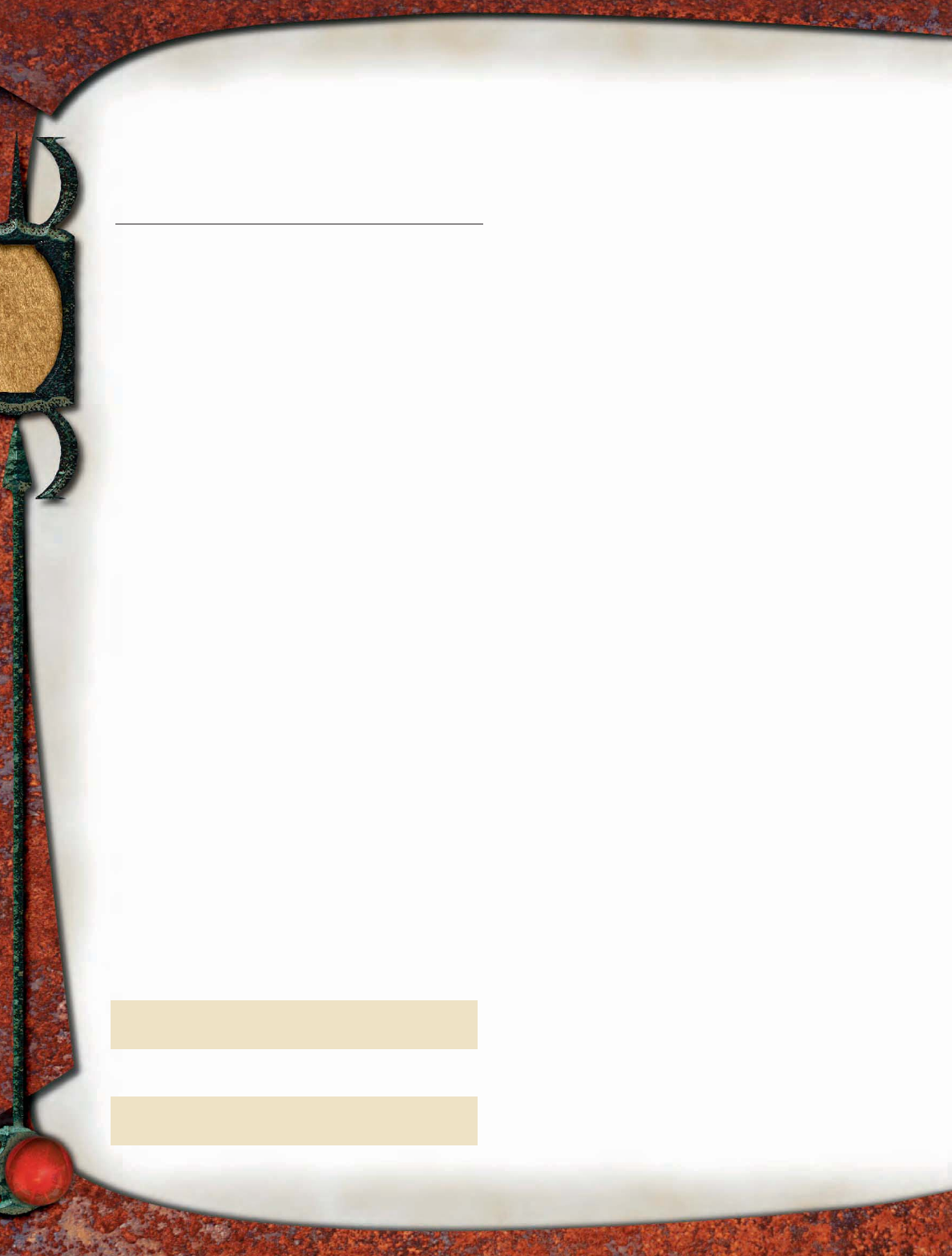
46
Feats Combat Reflexes, Dodge, Iron Will, Mobility, Spring
Attack, Two-Weapon Fighting
Skills Balance +20, Climb +11, Disable Device +11, Hide +24,
Jump +19, Listen +1, Move Silently +24, Open Lock +15,
Perform (dance) +14, Search +13, Spot +1, Tumble +20
Possessions +1 mithral breastplate, 2 +1 short swords, amulet
of health +4, belt of giant strength +4, boots of elvenkind,
cloak of elvenkind, masterwork thieves’ tools
Telepathy (Su) Singh can communicate telepathically with
Chorranathau at a range of up to 100 miles.
Defensive Roll (Ex) Once per day, when Singh would take
damage reducing him to 0 hit points or fewer, he can
instead roll with the blow by making a Reflex save
(DC equal to damage dealt). If he succeeds, he takes half
damage from the blow.
Shadow Jump (Su) Singh can move as if using a dimension
door effect as long as the origin and arrival points contain
some shadow. He can transport himself up to 40 feet per
day, broken up between jumps as Singh sees fit. Jumps
shorter than 10 feet still count as 10 feet.
Dragon’s Favor (Su) Singh has five favor tokens he can
spend to do Chorranathau’s bidding or get out of a
tough situation. He can spend one or more tokens as an
immediate action to gain one of the following benefits.
Frightful Presence: One token, 300-foot radius, 12 HD
or fewer, Will DC 15 negates.
Dragon Wing: If Singh clasps hands with one or
more other exarchs of Chorranathau, and each spends
one token, they all gain a fly speed of 150 feet (clumsy)
for as long as they keep holding the hand of at least one
fellow exarch.
Draconic Reverie: By expending one token, Singh can
gain a +4 bonus on his next saving throw or a +4 bonus
on his next attack roll.
Lair’s Return: Singh can spend two tokens to cast word
of recall. His sanctuary is Chorranathau’s mountain temple.
Lair’s Rebirth: If Singh takes damage that would
reduce him to –10 hit points, he can instead spend all his
remaining tokens (at least one) to return to Chorranathau’s
mountain temple, unconscious and with 0 hit points.
Hide in Plain Sight (Su) Singh can hide when being observed
as long as he is within 10 feet of a shadow other than his
own.
Summon Shadow (Su) Singh has a 4 HD shadow, which is
neutral and has no create spawn ability, as a companion.
A former thief, adventurer, and hired killer, Singh the
Immense is now an exarch doing the bidding of Chorra-
nathau the Inscrutable.
Strategies and Tactics
Singh attacks from the shadows whenever possible,
accompanied by his shadow minion. His shadow flanks
foes, allowing Singh to use sneak attack often. Tumble
and Mobility help keep Singh out of harm’s way as he
moves, and he uses Spring Attack and shadow jump to
change his position when he needs to. He’s not afraid of
toe-to-toe combat, making full attacks until his safety is
compromised. He uses silent image primarily to confuse
his enemies in combat.
Sample Encounters
Singh works alone (not counting his shadow), and he values
discretion over valor.
Message from the Master (EL 14): If the PCs interfere
with Chorranathau’s xorvintaal plans, Singh stalks them
until they’re resting or otherwise off guard. Then he
attacks, whispering dire warnings and unsavory oaths as
he fi ghts. After he has delivered his message and bloodied
the PCs, he employs shadow jump and, if necessary, lair’s
return to escape.
Sweep the Pawns from the Board (EL 16): Singh and
two troll hunters (MM 247) are on a straightforward mission:
assassinate the PCs. They maximize the element of surprise,
but they fl ee when reduced below 25% of their full normal
hit points.
Ecology
Singh is human. He loves food, eating as much in a day as
several average people, and he relishes the chance to experi-
ence a new delicacy or gourmet dish.
Environment: Singh splits his time between his mas-
ter’s lair and a series of countryside manors and city town
houses. He’s particularly fond of a villa that has an adjacent
vineyard, and he has started teaching the shadowdancer’s
art to some promising students there.
Physical Characteristics: Singh has earned his
nickname—he’s nearly 7 feet tall and weighs 550 pounds.
But beneath the rolls of fat are rock-hard muscle, and
relentless training has enabled Singh to retain his grace
and agility.
Alignment: Singh’s neutrality represents amoral indif-
ference to ethical matters, not any sort of reverence for a
cosmic balance. Singh acts to keep himself safe, powerful,
and sated.
Society
Singh is cautious and a little paranoid when on a mission
for his master. He speaks only when he must—he’d rather
interact with a fine bottle of wine or a rare delicacy than
another person—and even then he usually whispers. A
mercenary at heart, Singh is satisfied with his current
DRAGONS OF THE
GREAT GAME
pqqqqqqqqqrs
SINGH LORE
Characters who have ranks in Knowledge (local) can learn
more about Singh. When a character makes a successful skill
check, the following lore is revealed, including the informa-
tion from lower DCs.
Knowledge (Local)
DC Result
24 They call Singh “the immense” because he’s so
fat. But don’t be fooled. He’s a stone cold killer
with the grace of a tiger.
29 Singh used to be a thief and a mercenary, and
he knows some esoteric magic that lets him
manipulate the shadows.
34 It is said that Singh serves Chorranathau the
Inscrutable, a mighty fang dragon. He is known for
his love of huge amounts of the fi nest food.
pqqqqqqqqqrs
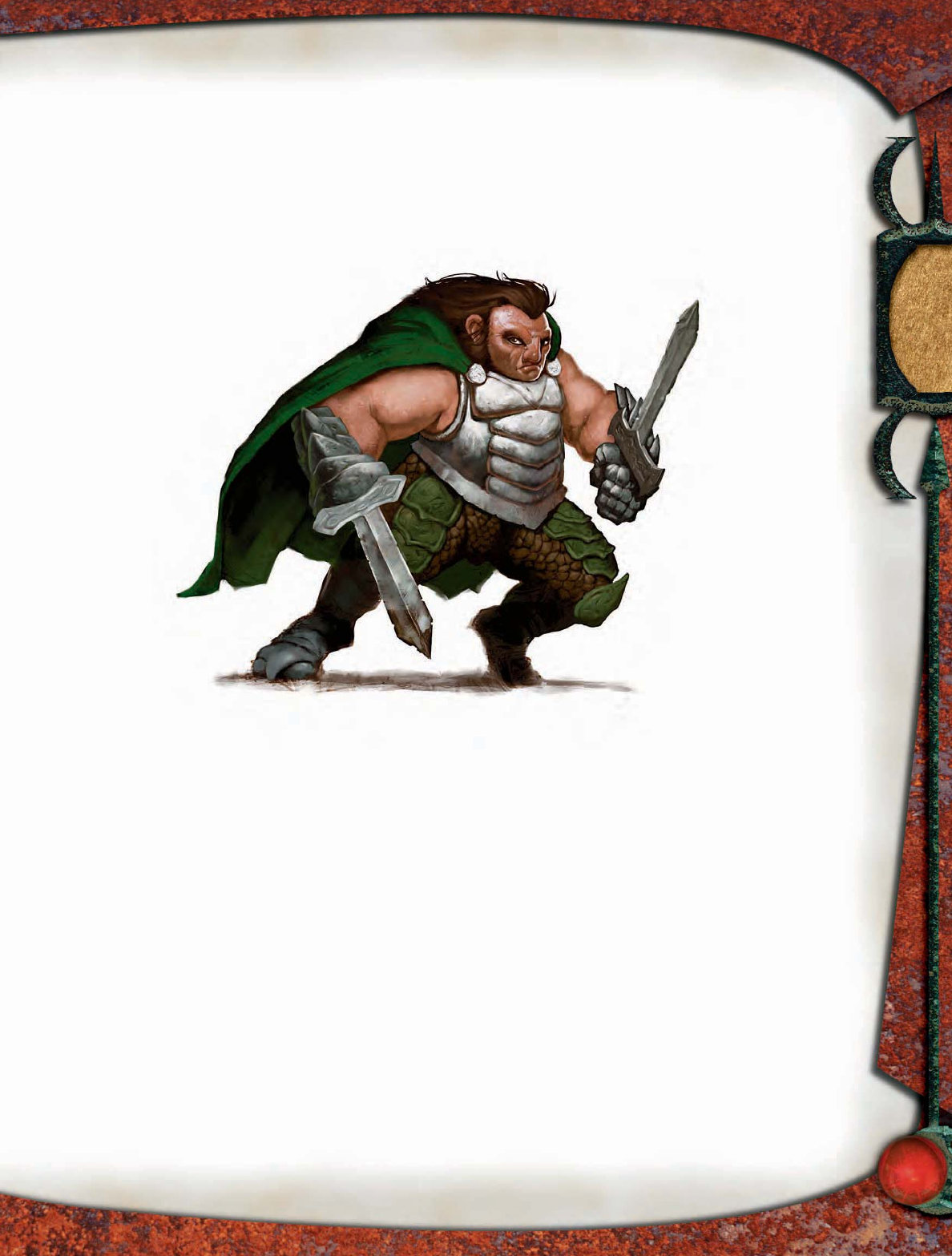
47
role. Chorranathau the Inscrutable cares for his exarchs
well, and Singh is accustomed to living an extravagant
lifestyle.
Typical Treasure
Singh carries nearly all of his magic items on his person,
but he has even more wealth in his various town houses
and villas, which are guarded by his personal soldiers. In
any given home are enough valuables to equal standard
coins and double goods for a creature of Singh’s
Challenge Rating.
CREATING A
XORVINTAAL
EXARCH
“Xorvintaal exarch” is an ac-
quired template that can
be added to any human-
oid, living construct,
monstrous human-
oid, fey, giant, or
undead (referred
to hereafter as the
base creature).
Challenge
Rating:
Same as base
creature +1.
Languages: A xor-
vin taal exarch can
communicate tele-
pathically at a range
of 100 miles with
the xorvintaal dragon that turned it into
an exarch.
Dragon’s Favor (Su): A xorvintaal exarch has fi ve favor
tokens. It can spend any number of tokens as an immediate
action to gain one of the following benefi ts.
Energy Immunity: A xorvintaal exarch can spend a favor
token to gain immunity to the same type of energy type
that its master’s breath weapon is made up of. The immunity
lasts 10 minutes. If an exarch’s dragon does not have a breath
weapon, the exarch cannot gain this benefi t.
Frightful Presence: A xorvintaal exarch can spend a token
to gain frightful presence to the same range as its draconic
master. Whenever the exarch attacks or charges, creatures
that have fewer Hit Dice than it must succeed on a Will save
(DC 10 + 1/2 the exarch’s HD + its Cha modifi er) or become
shaken for as long as they remain within range. A creature
that successfully saves cannot be affected by that same
exarch’s frightful presence for 24 hours.
Dragon Wing: If a xorvintaal exarch clasps
hands with at least one other exarch of
the same dragon,
and each spends
one token, they all
gain the fly speed
of their xorvintaal
dragon master for as
long as they keep hold-
ing the hand of at least
one fellow exarch. Since
holding hands makes
fighting difficult, ex-
archs commonly use this
fl ight only as a means of
overland travel.
Draconic Reverie: A xorvin-
taal exarch can spend a token
to tap into the draconic wisdom
that fl ows through all those con-
nected by the Ritual of Xorvintaal.
Doing so provides a glimpse of a
possible future—enough to
grant a +4 bonus on the exarch’s
next saving throw or a +4 bonus
on the exarch’s next attack roll.
Lair’s Return: A xorvintaal exarch can spend two tokens to
use word of recall. The exarch’s sanctuary is always the lair of
its xorvintaal dragon master.
Lair’s Rebirth: If a xorvintaal exarch takes damage that
would reduce it to –10 hit points, it can instead spend all
its remaining tokens (at least one) to instantly return to
the lair of its xorvintaal dragon master, unconscious and
with 0 hit points.
Level Adjustment: +2.
Singh the Immense
DRAGONS OF THE
GREAT GAME
pqqqqqqqqqqqqqqqqqqqqrs
PCS AS EXARCHS
Rewards inherent in the great game might attract the PCs. A
xorvintaal dragon can give them the xorvintaal exarch template.
That dragon can renew the ritual on an exarch to restore five
favor tokens, but the dragon’s ability to do so is limited by that
dragon’s success in the great game.
Rather than trying to score the great game, use the characters’
performance as a determining factor, rewarding their success
with more favor tokens. PCs who fail might be denied tokens
not because their master wishes them ill, but because that
dragon has insufficient stature in the great game to repeat the
exarch ritual.
The dragon can be subtly used to tell the characters how to
use their tokens. “Just defeat Roallaxathan, and my position in
the great game will be secure enough to restore my favor,” a
dragon might say. Or the dragon might say, “Our position is
tenuous; probe Roallaxathan’s defenses, but do not overextend
yourself or me.” Either message tells the characters how likely
they are to gain more favor tokens, indicating how freely the
PCs should spend the ones they have.
pqqqqqqqqqqqqqqqqqqqqrs
Illus. by R. Spears

48
ELEMENTAL MAGE
Elemental magi are giants descended from ogres, similar in
appearance to ogre mages. Despite their rarity, elemental
magi are not unique individuals, but rather different mem-
bers of the same race with varying appearances and abilities.
From the highlands, they emerge without warning, either
singly or as a group, to conquer and scourge the lands of
weaker people.
KEN-KUNI
The ground splits in front of you, and rocks tumble down into
your path. Sliding down in a shower of dust and pebbles comes a
horned giant clad in banded armor, carrying an enormous sword
in its hand. “Trespassers!” it intones in a voice that shakes the earth
beneath your feet.
Ken-Kuni CR 8
Usually NE Large giant (earth)
Init +0; Senses low-light vision; Listen +7, Spot +7
Languages Common, Giant
AC 23, touch 9, flat-footed 23
(–1 size, +6 armor, +8 natural)
hp 84 (8 HD); fast healing 5; DR 10/magic
Fort +12, Ref +2, Will +3
Speed 30 ft. (6 squares) in banded mail, base speed 40 ft.,
burrow 10 ft.
Melee mwk greatsword +15/+10 (3d6+12/19–20) or
Melee 2 slams +13 each (1d4+8) or
Melee gore +13 (1d8+8)
Space 10 ft.; Reach 10 ft.
Base Atk +6; Grp +18
Atk Options Cleave, Power Attack, magic strike
Special Actions earthshock
Abilities Str 27, Dex 11, Con 23, Int 10, Wis 12, Cha 11
SA earthshock, magic strike
SQ shared strength
Feats Cleave, Power Attack, Weapon Focus (greatsword)
Skills Climb +3, Intimidate +4, Knowledge (nature) +2,
Listen +7, Search +2, Spot +7
Advancement by character class; Favored Class fighter
Possessions masterwork banded mail, masterwork
greatsword
Earthshock (Su) Once every 1d4 rounds, a ken-kuni can
cause an earth tremor. This can affect either every
square adjacent to the ken-kuni or a 30-foot line
extending out from the creature. Anyone in the area
must succed on a DC 20 Reflex save or be knocked prone
and take 1d4 points of nonlethal damage. The save DC is
Constitution-based.
If a ken-li and a ken-sun are both within 60 feet, the
ken-kuni can use this ability every round. Elemental magi
are immune to this ability.
Shared Strength (Su) When a ken-kuni is within 60 feet of
one or more elemental mages and must make a saving
throw, it uses the highest save bonus among the group.
Ken-kunis are three-horned, ogrelike giants of great strength
and martial prowess. Not as clever or as ambitious as the
other elemental magi, they prefer to stake a claim and
defend it.
Most often encountered alone on hillside paths or in
rocky terrain where they have settled, ken-kunis demand
tribute from anyone passing through their territory. Other
elemental magi press ken-kunis into military service. At war,
ken-kunis shatter settlement defenses and break up enemy
troop formations.
KEN-LI
A wave of heat presages the arrival of this towering, horned giant.
Smoke fl ows from the creature’s mouth and spirals around its body
as it laughs, long and deep, at the sight of you. Firelight gleams from
its bronzed fl esh. Raising its sword, it inhales deeply, and fl ame
quickens in its gaping mouth.
Ken-Li CR 10
Usually CE Large giant (fire)
Init +3; Senses low-light vision; Listen +8, Spot +8
Aura wreathed in flame (5 ft.)
Languages Common, Giant
AC 20, touch 12, flat-footed 17
(–1 size, +3 Dex, +8 natural)
hp 138 (12 HD); fast healing 10
Immune fire
Fort +15, Ref +7, Will +11
Weakness vulnerability to cold
Speed 50 ft. (10 squares)
Melee +1 greatsword +15/+10 (3d6+8) or
Melee 2 slams +13 each (1d4+5) or
Melee gore +13 (1d8+5)
Space 10 ft.; Reach 10 ft.
Base Atk +9; Grp +18
Atk Options Cleave, Great Cleave, Power Attack
Special Actions flame breath
Abilities Str 20, Dex 17, Con 25, Int 10, Wis 18, Cha 10.
SA flame breath, wreathed in flame
SQ shared strength
Feats Cleave, Great Cleave, Iron Will, Power Attack, Weapon
Focus (greatsword)
Skills Balance +5, Climb +9, Handle Animal +4,
Intimidate +4, Knowledge (nature) +4, Listen +8,
Search +4, Spot +8
Advancement by character class; Favored Class fighter
Possessions +1 greatsword
Wreathed in Flame (Su) Creatures take 1d3 points of fire
damage at the end of a ken-li’s turn if they are within
5 feet of it. Furthermore, creatures that strike or touch
a ken-li with their body or a weapon take 1d3 points of
fire damage. A creature can take damage from touching
or striking a ken-li only once per turn. The creature can
suppress this ability at will.
Elemental magi are immune to this ability.
Flame Breath (Su) 30-foot line, once every 1d4 rounds,
damage 6d6 fire, Reflex DC 23 half. The save DC is
Constitution-based.
If a ken-kuni and a ken-sun are both within 60 feet,
the ken-li can use this ability every round. Elemental magi
are immune to this ability.
Shared Strength (Su) When a ken-li is within 60 feet of one or
more elemental mages and must make a saving throw, it
uses the highest save bonus among the group.
ELEMENTAL
MAGE
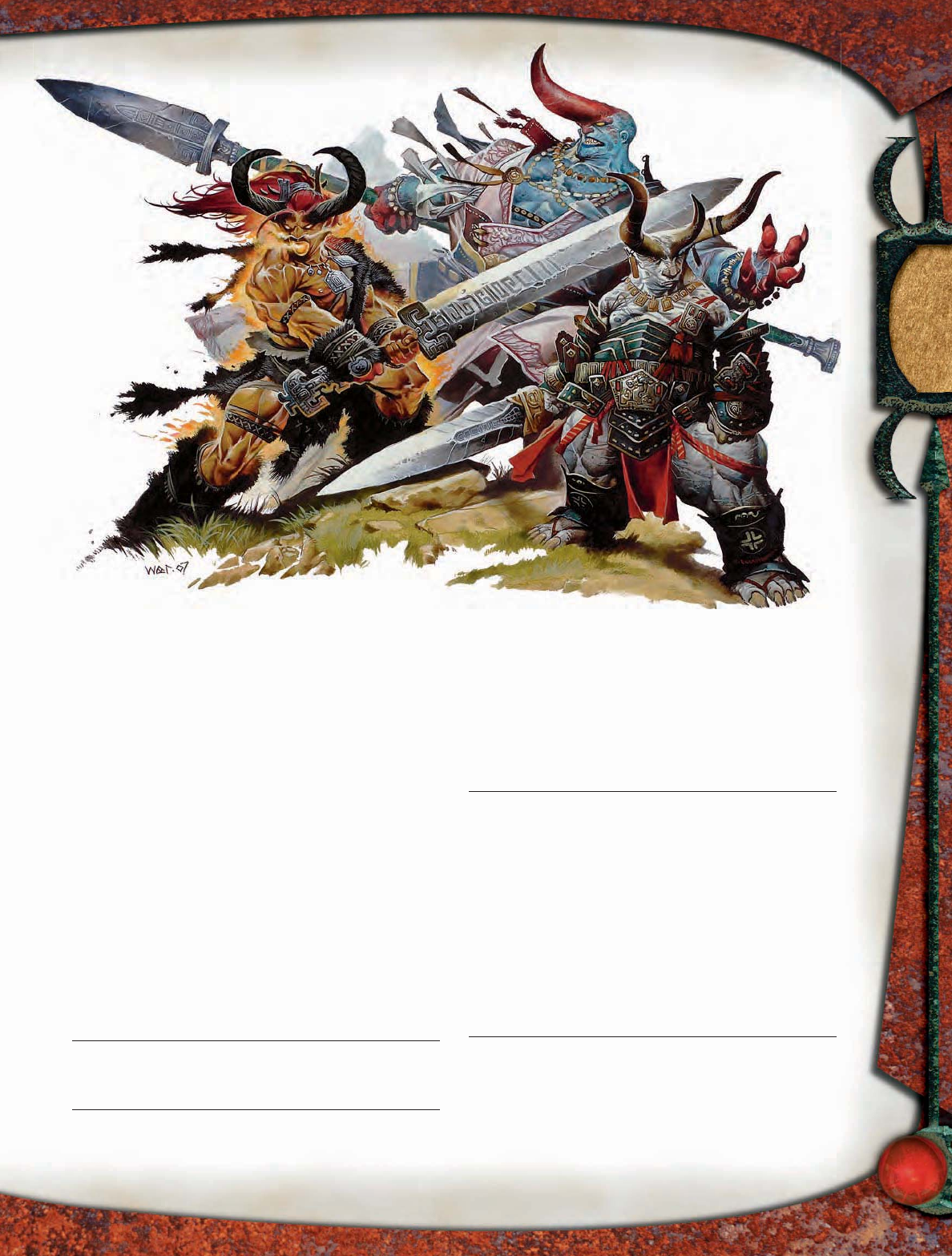
49
Ken-lis are two-horned, ogrelike giants of keen insight and
malicious temperament. This behavior is tempered by an
arrogance that prevents them from using their perceptive-
ness to the fullest.
Without leadership of some kind, a ken-li lives to destroy,
indulging that desire at every opportunity. Left to its whims,
it burns villages, roasts herds of cattle, and torches forests
simply for enjoyment. When encountered alone, ken-lis are
almost always engaged in one of these rampages. Otherwise,
they are found as troops in ken-sun armies, where they are
kept under control.
KEN-SUN
A craggy, horned giant turns its baleful gaze upon you, blue lips
curling into a wicked smile and exposing sharp, serrated teeth. Its
pale robe swirls around it as it gestures to summon its allies.
Ken-Sun CR 13
Usually LE Large giant (air)
Init +7; Senses low-light vision; Listen +12, Spot +12
Aura deflecting winds
Languages Common, Giant
AC 21, touch 12, flat-footed 18
( –1 size, +3 Dex, +9 natural)
hp 161 (17 HD); fast healing 10
Fort +15, Ref +8, Will +13
Speed 50 ft. (10 squares), fly 20 ft. (perfect); freedom of
movement
Melee +2 spear +21/+16/+11 (2d6+14/×3) or
Melee 2 slams +19 each (1d6+8) or
Melee gore +19 (1d8+8)
Space 10 ft.; Reach 10 ft.
Base Atk +12; Grp +24
Atk Options Awesome Blow, Improved Bull Rush, Power
Attack
Special Actions wind breath
Spell-Like Abilities (CL 17th):
2/day—control weather
1/day — sleet storm
Abilities Str 27, Dex 17, Con 20, Int 21, Wis 21, Cha 21
SA deflecting winds, spell-like abilities, wind breath
SQ shared strength
Feats Alertness, Awesome Blow, Improved Bull Rush,
Improved Initiative, Iron Will, Power Attack
Skills Balance +9, Bluff +18, Climb +18, Concentration +15,
Decipher Script +11, Diplomacy +17, Disguise +5
(+7 acting), Gather Information +11, Handle Animal +11,
Heal +9, Intimidate +21, Jump +22, Knowledge
(arcana) +14, Knowledge (nature) +9, Listen +12, Ride +5,
Search +11, Sense Motive +15, Spellcraft +17, Spot +12,
Survival +5 (+7 following tracks, +7 in aboveground
natural environments)
Advancement by character class; Favored Class fighter
Possessions +2 spear
Deflecting Winds (Su) A ken-sun is surrounded by a
tempest of air that affects every square adjacent to it
with windstorm-level effects (DMG 95). The creature can
suppress this ability at will.
Elemental magi are immune to this ability.
Freedom of Movement (Su) As the freedom of movement
spell; continuous; caster level 15th. The effect can be
ELEMENTAL
MAGE
Ken-kuni, ken-li, ken-sun
Illus. by W. Reynolds
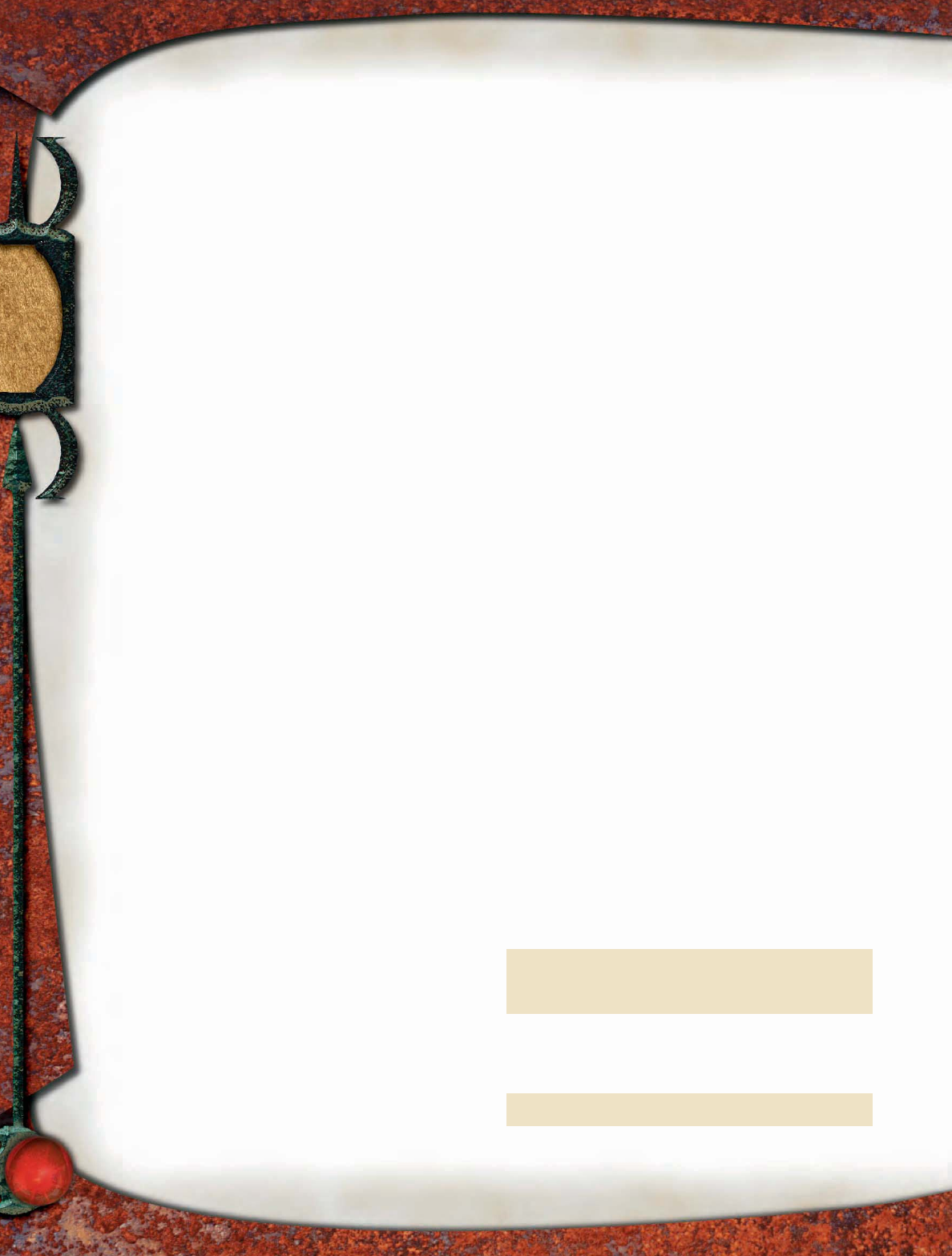
50
dispelled, but a ken-sun can create it again on its next
turn as a free action.
Wind Breath (Su) 30-foot line, once every 1d4 rounds,
Fortitude DC 23 negates. An opponent that fails the save
is pushed to the end of the effect, taking 1d4 points of
nonlethal damage per 10 feet it is pushed. The save DC is
Constitution-based.
If a ken-kuni and a ken-li are both within 60 feet, the
ken-sun can use this ability every round. Elemental magi
are immune to this ability.
Shared Strength (Su) When a ken-sun is within 60 feet of one
or more elemental mages and must make a saving throw,
it uses the highest save bonus among the group.
Ken-suns are one-horned, ogrelike giants possessed of wicked
intelligence and magical prowess. They descend from the
highlands at the head of armies or raiding parties, bringing
ruin to the settlements below.
Living to lead and to rule, ken-suns desire complete
dominion over everything that comes before them. They use
their strength, size, and magic to gather armies, both to give
them a sense of authority and to fuel their megalomaniacal
plans. Sometimes these warbands can swell in size to become
true armies, and ken-suns can even become absolute lords
of their domains.
Ken-lis and ken-kunis often serve as trusted retainers and
siege breakers within a ken-sun’s army.
STRATEGIES AND TACTICS
Elemental magi are very different enemies depending
whether they are encountered singly or together. Individu-
ally, they are quite formidable, but as a group they are
far stronger.
Ken-kunis, when met alone, are usually defending their
homes—a place from which they can control their sur-
roundings and collect tribute from those who pass through.
This home is typically a cave, a foothill or mountain path, or
a ruin. A ken-kuni fi rst prevents retreat, then panics its foes
with an earthshock. It makes its demands from a position
of strength.
Single ken-lis wander as ravagers on the outskirts of
civilization. They raid and destroy villages, isolated temples,
and roving caravans, then move on to fi nd new playthings.
Aggressive and straightforward, their only tactic is to strike
hard and fast, making liberal use of their fl ame breath to lay
waste to any opposition.
Ken-suns are rarely found without followers. They
prefer to send their warbands after powerful enemies,
then join the battle themselves after those foes are worn
out. Frequently, ken-suns set up ambushes and use terrain
to their advantage, especially when they think they have
the upper hand. They use their breath weapon to control
the battlefield, pushing back or trapping enemies to buy
time, or to make a particular opponent easier prey for
their minions.
When encountered together, elemental magi strike as a
team. Ken-lis and ken-kunis join the ken-sun’s followers,
smashing down defenses with their great strength and
destructive powers. The ken-sun directs the whole affair
from the rear.
SAMPLE ENCOUNTERS
Individually or together, elemental magi make challenging
opponents.
Ken-Kuni Toll Booth (EL 9): A ken-kuni lives in a cave
overlooking a long, narrow road that winds through rocky
hills. It has set up two traps 200 feet apart across a section
of the road (these act as CR 5 falling block traps, DMG 72).
The first one is delayed until travelers move past the place
where it goes off. If triggered, the trap sends rocks down
the slope, blocking the road behind the intruders. The
second trap activates almost immediately upon whoever
sets it off, cutting off the way forward. If the party is
trapped, the ken-kuni demands a toll, attacking if it is not
paid. The toll is 250 gp per person, but if travelers take
too long to decide whether to pay, the ken-kuni steadily
increases the price.
Ken-Li Squatter (EL 11): A ken-li has burned out a fi re
wizard’s tower and taken up occupancy, along with a gang of
fi ve Medium fi re elementals (MM 99) that were released when
the ken-li’s breath interacted with the wizard’s alchemical
ingredients. The evoker wants revenge upon the interloper,
who is still there, experimenting with the reactive reagents
and playing with its elemental “children.”
Tribal Paragon (EL 14): A ken-sun has been born to a
wandering ogre band and is being apprenticed, warily, by
the group’s ogre mage leader. The little tribe consists of a
4th-level ogre barbarian (MM 199), eight ogres (MM 199),
the ogre mage (MM 200), and the ken-sun. If the band runs
into any enemies, the ken-sun is eager to prove itself.
Elemental Mage Siege (EL 14): A ken-sun has descended
from the mountains with its warband, including a ken-li
and a ken-kuni, to lay siege to a city. The raiders quickly
ELEMENTAL
MAGE
pqqqqqqqqqrs
ELEMENTAL MAGE LORE
Characters who have ranks in Knowledge (nature) can learn
more about elemental magi. When a character makes a suc-
cessful skill check, the following lore is revealed, including the
information from lower DCs.
Knowledge (Nature)
DC Result
20 This is one of the elemental magi, an interrelated
group of giants who often form warbands.
Elemental magi are descended from ogres, and
they are like ogre mages.
25 Elemental magi come in three varieties. Ken-kunis
are creatures of stone with the power to cause
tremors. Ken-lis are fi re-breathing monstrosities
capable of great destruction. Ken-suns are natural
leaders that have power over the air.
30 Elemental magi are strong and resilient, and they
heal extremely quickly.
pqqqqqqqqqrs
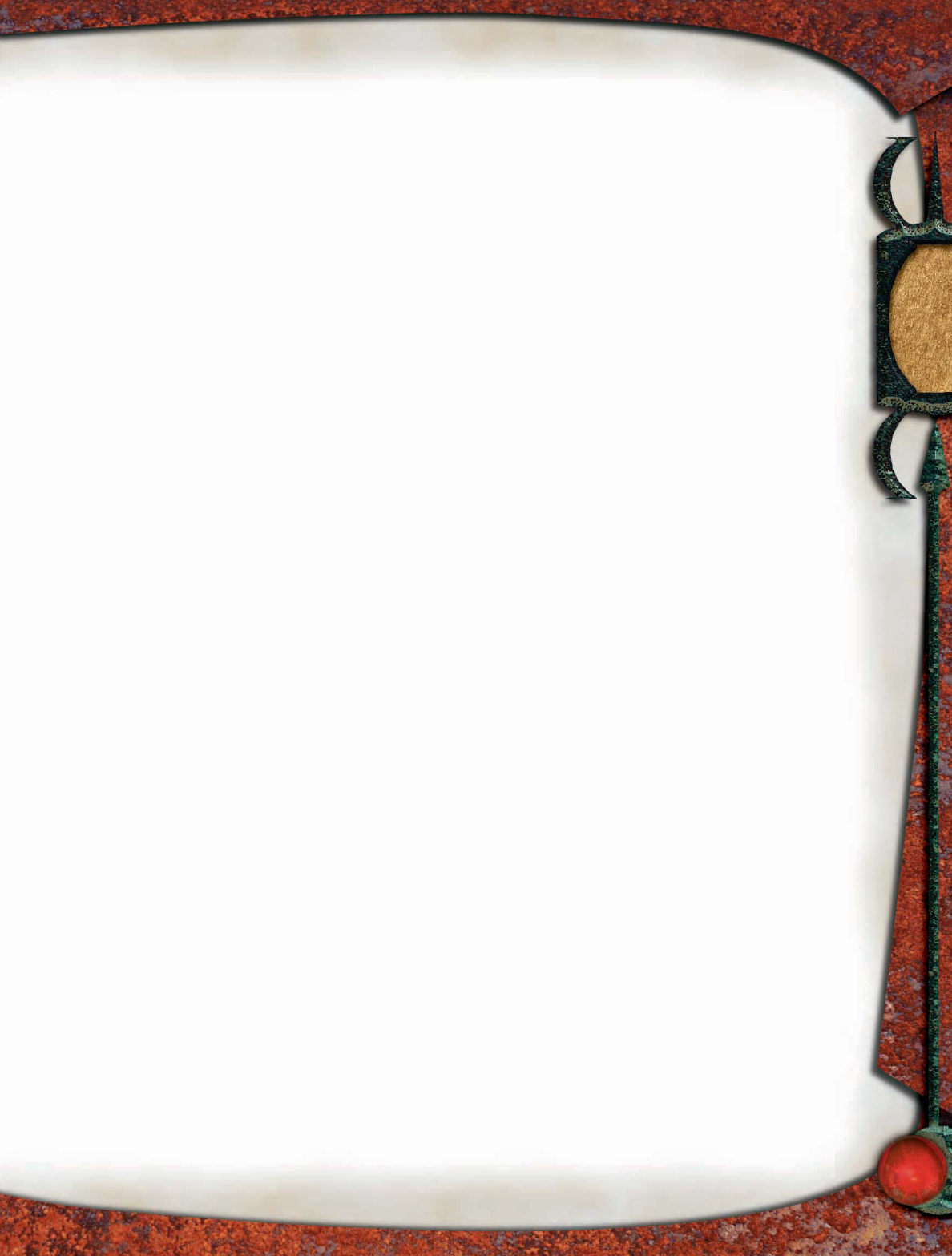
51
overran the inhabitants and firmly established a tyran-
nical regime.
To lead up to the climax, the PCs need to infi ltrate the
city or defeat the guards—several encounters of EL 10 or
lower. A typical encounter contains seven ogres led by an
ogre barbarian.
The climactic encounter is against all three elemental magi
and takes place in the town square. Surrounded by low-lying
buildings, the square is a perfect spot for concealed fi ghters
to hide. If given warning of the characters’ approach, the
ken-sun and the other elemental magi hide inside various
structures, waiting in ambush.
ECOLOGY
Elemental magi are born among ogres, and they are very
rare. Speculated to be types of ogre mages, elemental magi
are fascinated by their own peculiar abilities and tendencies
from a very young age. The three kinds of magi seem made
to fi t together as an effective force. Some sages believe that
the elemental magi were created by old gods to avenge the
worship they lost to newer divinities.
No female elemental magi exist, but elemental magi
and ogres can interbreed. Such unions do not necessarily
produce more elemental magi. That gift is entirely random,
not hereditary.
Environment: Elemental magi are most common in
foothills and other highlands that support ogres and ogre
mages. Ken-suns also ascend to higher elevations, taking to
the peaks to isolate themselves as they scheme and gather
their forces.
Typical Physical Characteristics: All elemental
magi are of a similar size—10 to 12 feet tall—and all are
horned. Beyond that, each is quite distinctive in look and
in powers.
Ken-kunis are the shortest and broadest of the elemental
magi. Their fl esh is marbled gray. Each has two horns like
those of a bull, and a third horn juts from the center of its
forehead. Their dull features and powerful muscles are usually
hidden under banded mail, and ken-kunis prefer helms that
allow their horns to protrude.
Ken-lis are broad-shouldered and have massive chests.
Their flesh is the color of burnished bronze, and two
black horns curve backward, extending out of a red mane.
Flames dart and whirl about them. Fire fills their lungs
as well, which causes smoke to pour from their mouth
and nostrils.
Ken-suns are the slimmest of the elemental magi and
the tallest. A ken-sun’s skin is blue-white in color, and a
single great horn protrudes from the center of its forehead,
measuring 2 to 3 feet in length. Hardened, bony fl esh forms
a carapacelike structure over the giant’s entire body, giving
it a rocky appearance. A ken-sun is typically clad in robes,
which fl ap in the breeze created by the giant’s powers.
Alignment: Elemental magi are usually evil, though each
has a strong tendency to be of a specifi c alignment. Ken-kunis
tend to be neutral evil, ken-lis chaotic evil, and ken-suns
lawful evil.
SOCIETY
Ken-lis and ken-kunis are loners unless brought together
by ken-suns. All elemental magi are the enemies of civili-
zation and civilized peoples. Elemental magi seem born
to a purpose, the ken-kunis and ken-lis being naturally
subservient to the ken-suns. That purpose appears to be
pure destruction.
Ken-suns impose only a little order on the territories
they take control of—enough that their minions can be
relied on to defend the area and enough that no one tries to
usurp power. Otherwise, their followers are left to their own
devices, remaining content.
TYPICAL TREASURE
All elemental magi have valuable gear. These trappings are
not considered part of the giant’s treasure when determining
its other wealth. Elemental magi who have levels in character
classes have equipment normal for NPCs of their Challenge
Rating, but ken-suns usually have additional wealth to reward
their followers.
Ken-kunis keep hoards in their lairs, the loot taken from
those who pass through their territory. They take coins, but
they prefer gems, sculptures, and other items of beauty or
utility, which they can more easily trade. They have half
coins, double goods, and half items.
Ken-lis have little use for treasure and almost never have
any with them. A town a ken-li has laid to waste might still
have some recoverable treasure among the ruins. Thus, a
ken-li has half standard treasure.
Ken-suns use treasure as compensation for their followers,
distributing magic items they fi nd among their minions and
keeping some for themselves. Most ken-suns have double
standard treasure for their Challenge Rating.
When together in a warband, all three combine their talents
and wealth, creating a greater hoard to supply and pay their
followers. This hoard is often carried on an armored wagon
along with the troops while they march. When the army
takes over a town, the treasure is stored in the most secure
building, as determined by the ken-sun.
ELEMENTAL MAGI
WITH CLASS LEVELS
Elemental magi are warriors, despite their supernatural
powers. They usually advance as fighters, though some
advance in other martial classes. Ken-lis often become
barbarians, while ken-suns favor leader roles that make
classes such as the marshal (Miniatures Handbook 11)
attractive. Only those classes that improve an elemental
mage’s base attack bonus by HD × 3/4 or better and have
at least a d8 Hit Die are considered associated for an
elemental mage.
Level Adjustment: +5.
ELEMENTAL
MAGE
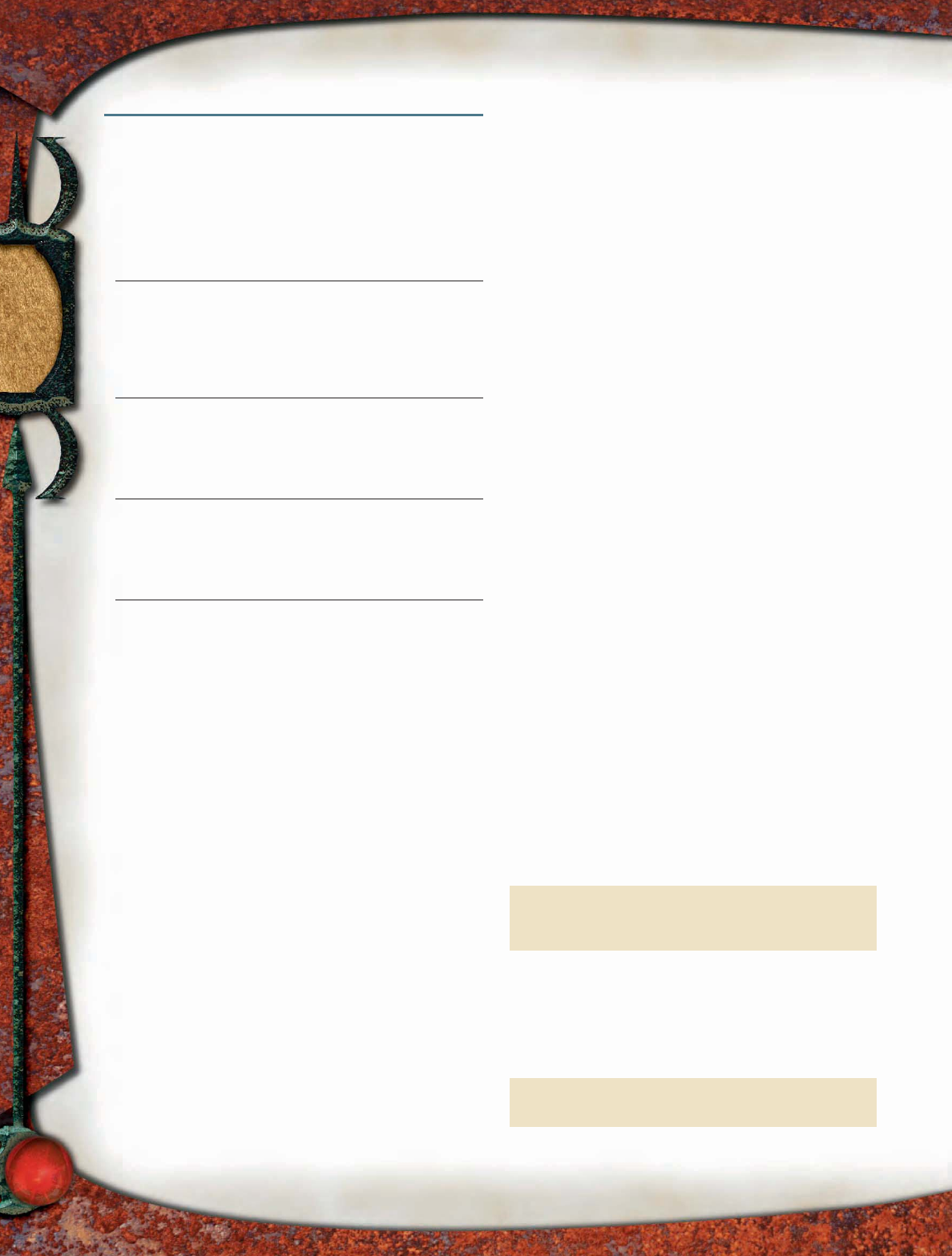
52
EMBER GUARD
A hulking mass of stone and brass surges forward, puffs of acrid
smoke leaking from its maw. Intense heat radiates from its surface,
and smoke rises where it treads.
Ember Guard CR 13
Always LE Huge outsider (evil, extraplanar, fire, lawful)
Init +6; Senses darkvision 60 ft.; Listen +20, Spot +20
Aura fire (30 ft.); see text
Languages Infernal, Ignan
AC 33, touch 10, flat-footed 31; 25% fortification
(–2 size, +2 Dex, +23 natural)
hp 162 (13 HD); fast healing 5; DR 15/good; death throes
Immune fire, poison
Resist acid 10, cold 10; SR 23
Fort +18, Ref +12, Will +12
Weakness vulnerability to cold
Speed 30 ft. (6 squares)
Melee 2 slams +22 each (1d8+10 plus 1d6 fire)
Space 15 ft.; Reach 15 ft.
Base Atk +13; Grp +31
Atk Options aligned strike (evil, lawful)
Special Actions fire breath
Abilities Str 30, Dex 15, Con 26, Int 3, Wis 18, Cha 9
SA aligned strike, death throes, fire aura, fire breath
Feats Ability Focus (fire breath), Great Fortitude, Improved
Initiative, Lightning Reflexes, Weapon Focus (slam)
Skills Balance +18, Climb +26, Listen +20, Spot +20
Advancement 14–26 HD (Huge)
Fire Aura (Su) If an ember guard is reduced to half of its full
normal hit points or fewer, it emits a fire aura as flames
start leaking from its body. Creatures take 1d6 points of
fire damage at the end of each of the ember guard’s turns
if they are within 30 feet of it. Creatures within range can
attempt DC 24 Fortitude saves for half damage. The save
DC is Constitution-based.
Fortification (Ex) 25% chance to ignore the extra damage
dealt by a critical hit or sneak attack.
Death Throes (Su) When killed, an ember guard explodes
in a 60-foot-radius burst that deals 3d6 points of
bludgeoning damage and 3d6 points of fire damage to
everything in the area (Reflex DC 24 half). The save DC is
Constitution-based.
Fire Breath (Su) 30-foot cone, once every 4 rounds, damage
6d6 fire plus slow, as the spell, for 4 rounds, Reflex DC 24
half. The save DC is Constitution-based.
Gifts of Imix, the Prince of Evil Fire Elementals, ember
guards are dim-witted creatures of fathomless evil that spread
the dark will of their master by serving the efreet and other
evil fi re creatures.
STRATEGIES AND TACTICS
Ember guards are typically minions of other creatures in
the service of Imix, usually working with salamanders, fi re
giants, and efreet. Their purpose is to spread pain and suf-
fering, so they gladly engage anyone they encounter. They
start by spewing a cone of fi re to slow their foes. Then, they
wade into the thick of battle, swinging their fi sts to buy time
until they can next use their breath.
SAMPLE ENCOUNTERS
Imix gives ember guards to his faithful servants. No creature
would refuse such a gift, even though ember guards have
little purpose outside of killing. Their masters are quick to
bring them along on forays into other planes. Efreeti pashas
employ ember guards as mercenaries and guardians, selling
their services to other creatures in exchange for treasures
and slaves.
Flamebrother’s Keeper (EL 14): A fl amebrother salaman-
der (MM 219) has been prophesied to become a great sorcerer
and spread evil across the world in a tide of fl ame. It is cur-
rently in a caravan traveling to a great temple on the Material
Plane, where its magical potential can be unleashed.
When the PCs find the caravan, no trace of the flame-
brother can be seen. Instead, an ember guard tramps forward
in the middle of the caravan. Three average salamanders lead,
and two more bring up the rear. The rest of the caravan is
made up of fourteen cultists (all humanoid adept 1), who
serve only as fodder.
The fl amebrother is actually inside the ember guard, kept
safe by its immunity to fi re. The characters can either use
divination to detect the salamander or simply fi nd it once
they defeat the ember guard.
Bortrax’s Mercenaries (EL 18): A pit fi end named Bortrax
made a pact with an efreeti pasha from the City of Brass to
gain the service of fi ve ember guards. Bortrax intends to send
the pack to the Material Plane to take vengeance on a town
that found and immolated several of his cultists.
The town is located in a river valley, so PCs who can lure the
ember guards to the water (or stop them before they cross it)
might gain an advantage by slowing them down and reducing
the danger of their fi re-based attacks.
pqqqqqqqqqrs
EMBER GUARD LORE
Characters who have ranks in Knowledge (the planes) can
learn more about ember guards. When a character makes a
successful skill check, the following lore is revealed, including
the information from lower DCs.
Knowledge (the Planes)
DC Result
23 This is an ember guard, a creature from the
Elemental Plane of Fire. An ember guard can
breathe a cone of fl ame that magically slows those
it burns. Cold is this creature’s major weakness.
28 Ember guards are spawned by Imix, Prince of Evil
Fire Elementals. Their essential nature—fi re—lies
trapped within a skin of brass and stone that is
resilient against all but good weapons. Despite
amazing healing abilities, ember guards lose their
ability to contain their inner fi re as they suffer
injuries, causing those nearby to burn as heat and
fl ame escape.
33 If an ember guard is slain, it explodes in a
tremendous burst, showering the area with fi ery
cinders.
pqqqqqqqqqrs
EMBER GUARD
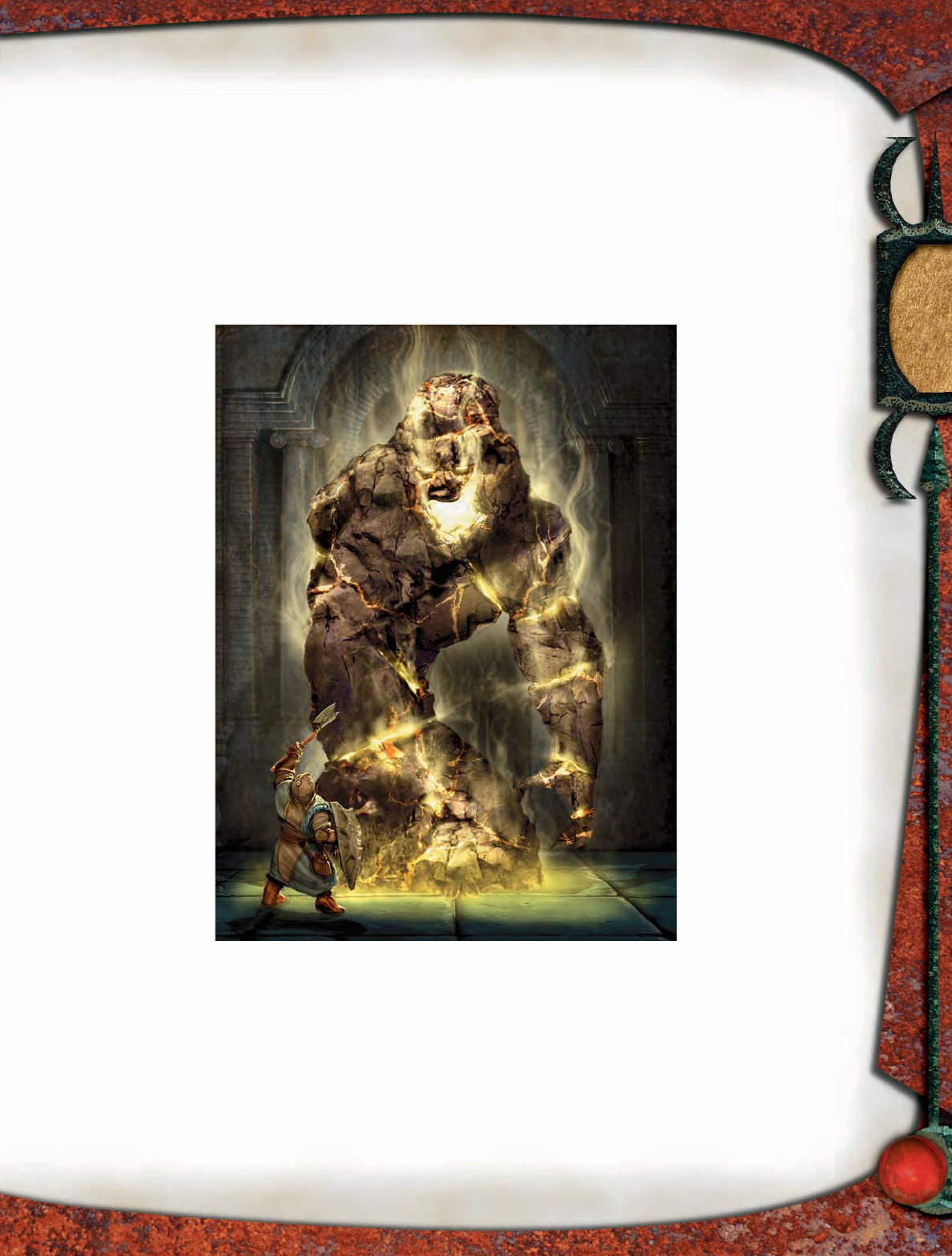
53
ECOLOGY
It is said that when a minion of Imix pleases his master, the
Elemental Prince causes ember guards to rise from a lake of
fi re. Formed from the hottest fl ames and contained in a shell
of brass and rock, they shuffl e forward, eager to serve. They
have no need for nourishment, nor do they truly have desires.
Instead, they go where directed, venting the wickedness that
burns hotly within them.
Environment: Ember guards are native to the Elemental
Plane of Fire, where they can be found guarding the palac-
es of the mightiest
nobles. They are sel-
dom encountered
elsewhere on the
plane, though some
bold planar travelers
have claimed to spy
legions of these crea-
tures spawned from
pockets of elemental
earth that bob in the
molten seas.
Typical Physical
Characteristics: A
typical ember guard
stands 18 feet tall
and weighs about
four tons. Its rocky
body is fl ecked with
brassy deposits, look-
ing very much like
the body of a Huge
earth elemental. The
differences manifest
themselves in the
fl ames fl ickering in
its eyes and maw,
as well as the heat
that escapes its body
when it is wounded.
Alignment:
Though only dimly
intelligent, ember
guards seethe with
malevolence, as ev-
idenced by the chortling noises they make
when they slay their enemies. Ember guards are always law-
ful evil.
SOCIETY
Ember guards are fl awlessly obedient, following just about
any order from anyone or anything they see as a legitimate
authority. They are as dense in mind as they are in body,
but their nature and the circumstances of their birth give
them evil inclinations and a desire to do harm. Nothing of
camaraderie or companionship is known to them, though
they eerily gather with others of their kind when directed
along no other course of action.
TYPICAL TREASURE
At a glance, it seems veins of brass fl eck an ember guard’s
hide. On closer inspection, it becomes obvious that this is
not valuable material.
Ember guards do not collect treasure. Divide standard
treasure of a monster that has the ember guard’s Challenge
Rating between treasure found on the ember guard’s
companions and its
commander, and re-
wards from grateful
people the PCs save
from the creature.
EMBER
GUARDS IN
EBERRON
During the last cen-
tury, when the seas
of Fernia were co-
terminous with the
Material Plane, a mad
efreeti named Ayim
broke free and led a
force of ember guards
to carve out a new
kingdom in northern
Xen’drik. The months
that followed saw
countless battles with
neighboring drow,
but eventually Ayim
was defeated and his
armies scattered.
Drow scouts claim
that ember guards still
haunt the islands of the
Thunder Sea, await-
ing the return of their
master to lead them
home. Little do these
drow know that a fi re
giant wizard named
Jyanta is gathering the ember guards for her
own nefarious ends.
EMBER GUARDS IN FAERÛN
Spawned from the forges of Hammergrim, ember guards
punish duergar who offend Deep Duerra. Vast catacombs
lie beneath the Citadel of Thought, and from the bowels
of the fiery tunnels, one can hear incredible screams of
suffering rising above the rumbling laughter of ember
guard torturers.
Ember guard
EMBER GUARD
Illus. by A. Swekel

54
ETHEREAL DEFILER
A hulking abomination at least 10 feet tall steps out of a whirl-
ing maelstrom of black energy. Green and black scales cover the
hunched monstrosity’s bipedal body, which ripples with corded
muscles. It has clawed hands and feet. A long snout that has two
dangling tendrils caps the creature’s lizardlike face, and a thick
tail hangs behind it.
Ethereal Defiler CR 16
Always CE Large aberration (extraplanar)
Init +10; Senses blindsense 60 ft., darkvision 60 ft.;
Listen +12, Spot +12
Aura anchoring (20 ft.)
Languages Common, Undercommon; telepathy 100 ft.
AC 33, touch 17, flat-footed 27
(–1 size, +6 Dex, +2 deflection, +16 natural)
hp 253 (22 HD); DR 10/cold iron
Resist cold 20, fire 20; SR 29
Fort +14, Ref +13, Will +15
Speed 40 ft. (8 squares)
Melee 2 claws +24 each (1d8+8) and
tail +18 (1d8+4) or
Melee claw +24 (1d8+8) and
tainted energy claw +24 (1d8+8 plus 6d6) and
tail +18 (1d8+4)
Ranged tainted energy +21 ranged touch (6d6)
Space 10 ft.; Reach 10 ft.
Base Atk +16; Grp +28
Atk Options Cleave, Far Shot, Point Blank Shot, Power
Attack, Precise Shot
Special Actions ethereal bore
Abilities Str 27, Dex 22, Con 24, Int 6, Wis 14, Cha 16
SA anchoring aura, ethereal bore, tainted energy
Feats Cleave, Empower Spell-Like Ability (tainted energy), Far
Shot, Improved Initiative, Point Blank Shot, Power Attack,
Precise Shot, Weapon Focus (claws)
Skills Climb +13, Jump +12, Listen +12, Spot +12
Advancement by character class; Favored Class warlock;
see text
Anchoring Aura (Su) Effects that have the teleportation
descriptor don’t function within 20 feet of an ethereal
defiler. Further, opponents must succeed on a DC 24 Will
save to move more than 20 feet from the creature. The
save DC is Charisma-based.
A creature that successfully saves need not save
against that same ethereal defiler’s anchoring aura for 24
hours. Other ethereal defilers are immune to this aura.
Tainted Energy (Sp) As a swift action, an ethereal defiler
can fire a blast of eldritch energy as a ranged touch
attack to a range of up to 120 feet. The blast deals 6d6
points of damage. An ethereal defiler can instead use
that swift action to imbue a claw with eldritch energy,
dealing an extra 6d6 points of damage if that claw attack
hits. An opponent that takes damage from this energy
must succeed on a DC 24 Fortitude save or be sickened
for 1d4 rounds. Caster level 22nd. The save DC is
Charisma-based.
Ethereal Bore (Su) Once every 10 rounds, an ethereal
defiler can shift between the Ethereal Plane and the
Material Plane as a full-round action that doesn’t
provoke attacks of opportunity. An ethereal defiler’s
arrival on the Material Plane is accompanied by an
eruption of eldritch energy that deals 10d6 points of
damage in a 20-foot-radius burst (Reflex DC 24 half)
centered on the ethereal defiler. The burst doesn’t harm
the ethereal defiler that created it. This ability otherwise
works like an ethereal jaunt spell (caster level 22nd). The
save DC is Charisma-based.
Ethereal defi lers are murderous predators that shift between
the Material Plane and the Ethereal Plane in bursts of foul
energy. Bulky and strong, ethereal defi lers also have control
over eldritch energy like that which a warlock commands.
STRATEGIES AND TACTICS
An ethereal defi ler prowls the Ethereal Plane, seeking food
and sport. From the Ethereal, it maneuvers among groups of
foes, then uses its ethereal bore ability to emerge and catch as
many as possible in the tainted energy burst that accompanies
its shift. It follows up by targeting the foe that seems most
injured with an empowered tainted energy claw or ray.
The ethereal defi ler then focuses on brutally eliminating
one foe at a time with its physical attacks. Recklessly, it uses its
full Power Attack regularly, scaling back only after it realizes
it can’t hit with such vicious blows. It reserves empowered
tainted energy attacks to use on blows it thinks might kill or
disable an enemy. When it makes a tainted energy claw attack,
it doesn’t use Power Attack.
SAMPLE ENCOUNTER
Ethereal defi lers prefer to live and hunt alone, though they
can occasionally be found in pairs. They are rarely caught on
the Material Plane unless they’re attacking prey or eating, so
almost every encounter with an ethereal defi ler begins with
an ambush by the creature. Ethereal defi lers prefer to attack
their foes in enclosed spaces.
pqqqqqqqqqrs
ETHEREAL DEFILER LORE
Characters who have ranks in Knowledge (dungeoneering) or
Knowledge (the planes) can learn more about ethereal defilers.
When a character makes a successful skill check, the following
lore is revealed, including the information from lower DCs.
Knowledge (Dungeoneering)
or Knowledge (the Planes)
DC Result
26 This is an ethereal defi ler, a corrupt extraplanar
predator that travels between the Ethereal Plane
and the Material Plane. It has powerful claws and a
mighty tail.
31 When an ethereal defi ler arrives on the Material
Plane, it creates an explosion of eldritch energy.
It uses that same energy to shoot potent rays or
charge its claws.
36 Ethereal defi lers emanate a fi eld that prevents
teleportation effects. That same fi eld prevents
even strong-willed creatures from leaving the
ethereal defi ler’s immediate vicinity.
pqqqqqqqqqrs
ETHEREAL
DEFILER
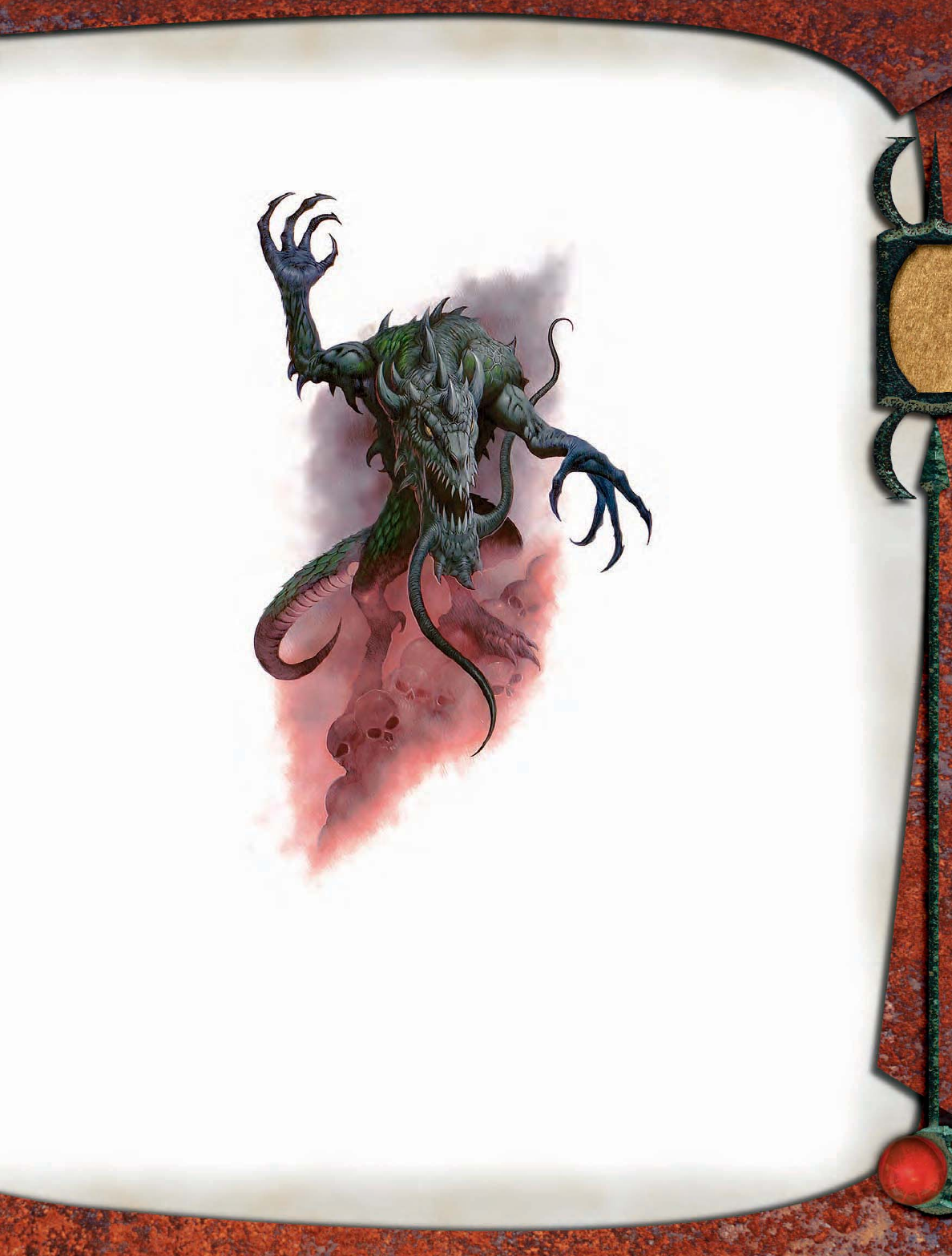
55
Portal Predator (EL 16): An ethereal defi ler lies in wait
on one side of a magic portal in the Underdark—a gate
said to lead to centuries-old ruins. It preys on those who
come to investigate the gateway, as well as creatures that
pass through the surrounding
caverns, which the defiler
considers its territory. Sev-
eral factions in the deep
earth know that a danger-
ous creature stalks and kills
those who come near the por-
tal. More than one of them is
willing to pay dearly to have
that problem solved and the
path to the portal cleared.
ECOLOGY
Ethereal defi lers belong to an an-
cient and rare race that comes from
beyond the known realms of the
Material Plane. Built to hunt and
kill, their bizarre nature imbues
them with corrupt energy that al-
lows them to tunnel between the
Material Plane and the Ethereal
Plane. They use that same
energy to slaughter their
foes with blasts and dev-
astating claw attacks.
It’s likely that ethereal
defilers are somehow re-
lated to ethereal filchers,
ethereal marauders, and
ethereal slayers (MM2 96),
but ethereal defilers are al-
together more purposeful and
malevolent.
Not only are ethereal defil-
ers carnivores, they also derive
particular pleasure from slaying
and devouring sentient crea-
tures. Ethereal defilers prefer to
prey on creatures that put up a good
fi ght. They also enjoy cat-and-mouse games with their vic-
tims, reveling in inspiring terror beyond that experienced
by mere animals.
Interaction between ethereal defi lers is instinctually driven.
They fi ght over territory, seeing others of their kind as rivals.
Pairs of ethereal defi lers come together briefl y to mate, each
laying dark eggs that the other fertilizes. Even mating is risky,
since one ethereal defi ler often slays the other as a convenient
meal when mating is done.
Young ethereal defi lers are born in explosions of eldritch
energy. The strongest among the hatchlings slays and eats
its siblings.
Environment: Ethereal defilers live primarily on the
Ethereal Plane, appearing on the Material Plane only to feed.
No climate deters them, though they prefer temperate areas
that have ample prey.
Typical Physical Characteristics: Ethereal defilers
are 12-foot-tall, muscular creatures covered with shining
green and black scales. Their hands and feet are capped
in vicious claws. They have lizardlike
heads, which have two long tendrils
hanging beneath the chin, and sub-
stantial tails.
Alignment: Although ethereal defi l-
ers are hunters, they are wantonly cruel
and seek intelligent prey. Instead of hunt-
ing merely to eat, ethereal defi lers kill
for fun, considering the suffering they
cause a show of cleverness and strength.
These warped creatures are always
chaotic evil.
TYPICAL
TREASURE
Normal ethereal defi lers
have little use for trea-
sure, so they collect none.
Ethereal defiler warlocks col-
lect magic items, and they have
standard equipment for NPCs of their
Challenge Rating, all in magic items.
ETHEREAL DEFILERS
WITH CLASS LEVELS
Though dull, ethereal defi lers have an innate
connection to tainted magical energy, allowing
them to advance in the warlock class (Complete
Arcane 5). When they do so, they gain nearly all of the
warlock’s class features normally. However, the
damage dealt by the warlock’s eldritch blast class
feature stacks with that dealt by the ethereal de-
fi ler’s tainted energy ability. The damage reduction
a warlock gains also stacks with the ethereal defi ler’s innate
damage reduction.
An ethereal defi ler that doesn’t advance as a warlock usually
advances as a barbarian, a fi ghter, or a rogue.
Level Adjustment: +4.
ETHEREAL DEFILERS IN EBERRON
Ethereal defi lers are found throughout Eberron, though they
are rare in civilized countries. In Khorvaire, ethereal defi lers
are most common in the Shadow Marches, where they are
attracted to dimensional seals and weird overlapping manifest
zones. Some suggest that the daelkyr created ethereal defi l-
ers from another creature native to the Ethereal Plane, and
the druids of the Gatekeeper sect consider ethereal defi lers
among their worst enemies.
Ethereal
defi ler
ETHEREAL
DEFILER
Illus. by W. England

56
FETID FUNGUS
An amorphous mass of colorful, lichen-crusted bubbles lumbers
toward you. Its outer layer is mottled with bright red, amber,
and fl esh-colored blotches, and covered with a slick coat of leafy,
hairlike stalks. As the bubbles writhe to the surface, some of them
pop, releasing the unmistakable stench of decomposing matter and
swamp gas.
Fetid Fungus CR 1
Always N Medium plant
Init –1; Senses blind, blindsight 60 ft.; Listen +0
Aura sickening gas (30 ft.)
Languages —
AC 13, touch 9, flat-footed 13
(–1 Dex, +4 natural)
hp 12 (2 HD); death throes
Immune acid, gaze attacks, illusions, plant immunities,
visual effects
Fort +4, Ref –1, Will +0
Weakness vulnerability to fire
Speed 20 ft. (4 squares)
Melee acid touch +1 (1d6 acid)
Space 5 ft.; Reach 5 ft.
Base Atk +1; Grp +1
Atk Options decomposing slime
Special Actions engulf
Abilities Str 11, Dex 8, Con 13, Int 1, Wis 10, Cha 5
SA death throes, decomposing slime, engulf, sickening gas
SQ plant traits
Feats Track
Skills Hide +2 (+12 in swampy terrain), Listen +0, Survival +2
Advancement 3 HD (Medium); 4–6 HD (Large)
Sickening Gas (Ex) A fetid fungus’s amorphous body is filled
with gases given off by decomposing matter. All living
creatures within 30 feet of a fetid fungus must succeed
on a DC 12 Fortitude save or be sickened for 10 rounds.
The save DC is Constitution-based.
Creatures that successfully save cannot be affected
by that same fetid fungus’s gas for 24 hours. A delay
poison or neutralize poison spell removes the effect from
the sickened creature. Creatures that have immunity to
poison are unaffected, and creatures resistant to poison
receive their normal bonus on their saving throws.
Death Throes (Ex) When destroyed, a fetid fungus explodes
in a 10-foot-radius burst of corrosive ichor that deals 1d4
points of acid damage (Reflex DC 12 half) to all creatures
in the area. The save DC is Constitution-based.
Decomposing Slime (Ex) A fetid fungus’s body produces a
decomposing slime. Any creature that strikes or touches
a fetid fungus with its body, or that grapples a fetid
fungus, takes 1 point of acid damage. A creature takes
damage from this ability only once per round.
Engulf (Ex) As a standard action, a fetid fungus can
envelop creatures of its size or smaller, entrapping
them within itself. The fungus simply moves into
the opponent’s space; any creature whose space it
completely covers is subject to the engulf attack. A
fungus cannot make a touch attack during a round in
which it engulfs. It can engulf as many creatures as can
fit in its space.
Opponents can make attacks of opportunity against
the fungus, but if they do so, they are not entitled to
a saving throw. Those who do not attempt attacks of
opportunity must succeed on a DC 12 Reflex save or be
engulfed. On a success, a creature moves aside or back
(opponent’s choice) to move out of the fungus’s path.
The save DC is Constitution-based.
Engulfed creatures are considered to be grappled
within the fungus’s body, they are subject to its touch
attack, and they take 1 point of acid damage per round
from its decomposing slime.
Skills Fetid fungi have a +10 racial bonus on Hide checks
when in marsh or swamp terrrain.
A fetid fungus is a foul lichen that feeds off the decomposing
flesh of its prey. These rootless creatures gain sustenance
by enveloping and digesting fl esh, and therefore travel con-
stantly to fi nd new food sources. Though barely intelligent,
they are skilled hunters and trackers. Once a fetid fungus
latches onto the trail of potential prey, it is relentless.
STRATEGIES AND TACTICS
As soon as a fetid fungus discovers signs of prey, it tracks the
potential meal, attacking when it senses a foe. A fetid fungus
gravitates toward slower targets. At the fi rst opportunity,
it engulfs an opponent, defending itself with acid touch
attacks while its decomposing slime digests the engulfed
individual. If it fi nishes its meal—or the prey escapes—a
fetid fungus immediately seeks another opponent to decom-
pose. Fetid fungi never retreat, continuing to feed and attack
until destroyed.
SAMPLE ENCOUNTER
Fetid fungi rarely congregate in large numbers unless cul-
tivated by a more powerful creature. They can be found in
pods of one to four members.
pqqqqqqqqqrs
FETID FUNGUS LORE
Characters who have ranks in Knowledge (nature) or Knowl-
edge (religion) can learn more about fetid fungi. When a
character makes a successful skill check, the following lore is
revealed, including the information from lower DCs.
Knowledge (Nature)
DC Result
11 This is a fetid fungus, an aggressive plant that
envelops opponents, smothering and digesting
them with its amorphous body. This result reveals
all plant traits.
16 A fetid fungus’s stench is caused by decomposing
matter and can sicken people. Fetid fungus
gas is fl ammable, making the fungus extremely
susceptible to fi re attacks.
21 Fetid fungi spew acid when attacking, and they
explode in a shower of acidic ichor when slain.
Knowledge (Religion)
DC Result
11 Evil druids sometimes summon fetid fungi.
16 Fetid fungi are sacred to worshipers of the demon
Zuggtmoy, Lady of Fungi.
21 Some cults breed fetid fungi in large pits and use
them in the performance of ritual sacrifi ces.
pqqqqqqqqqrs
FETID FUNGUS
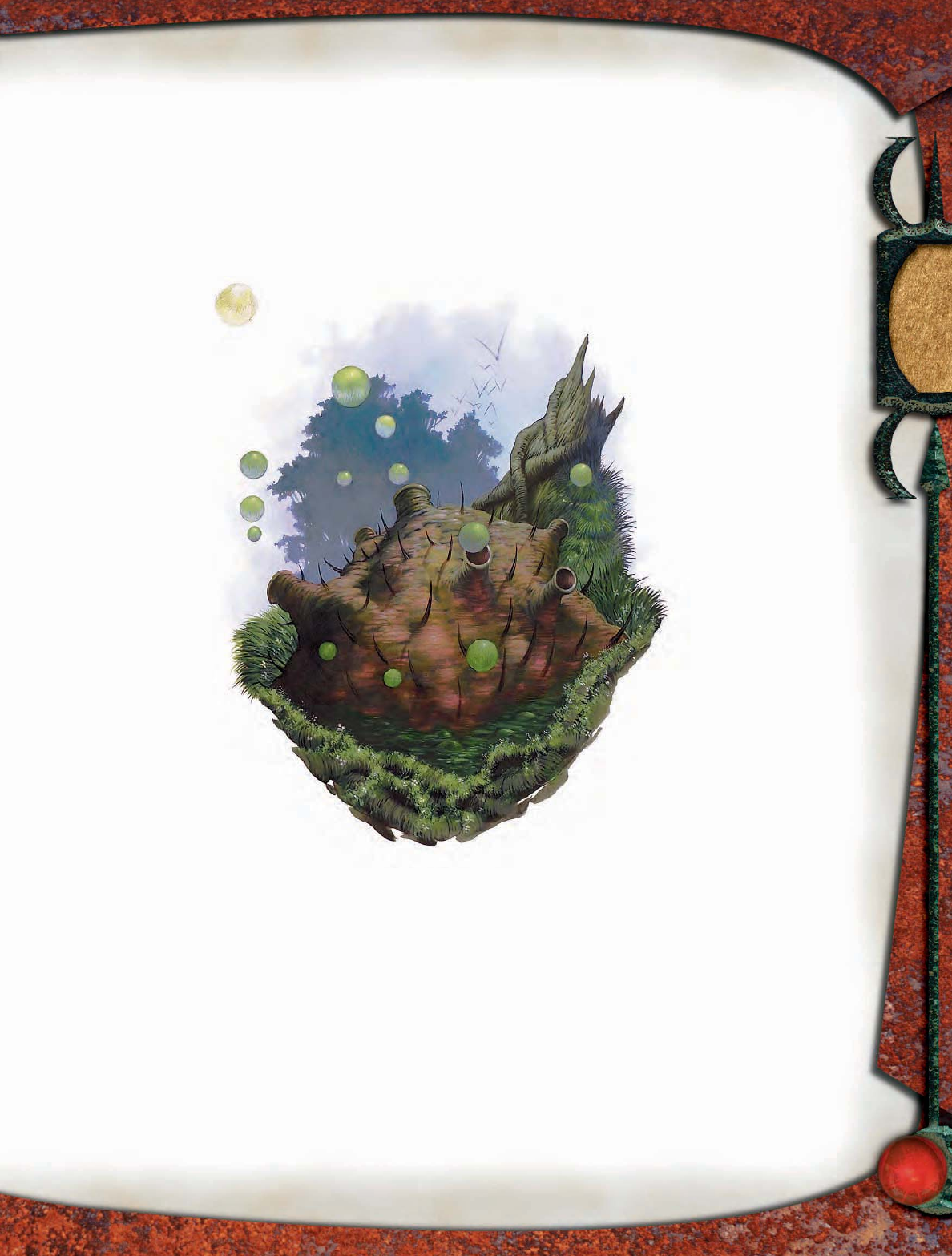
57
Swamp Surprise (EL 3): The PCs need to take a shortcut
through a swamp. Halfway through, a druid named Alkarn
(NE male half-elf druid 2) offers himself to the characters
as a guide. Unknown to them, the druid believes he is the
chosen of Zuggtmoy, the demonic Lady of Fungi, and at the
fi rst opportunity, he tries to sacrifi ce the PCs by leading them
into a deep bog inhabited by a fetid fungus.
ECOLOGY
A fetid fungus is a
predatory lichen
colony that feeds
by rapidly digest-
ing living creatures.
Gases and enzymes released
through decomposition give
the creature its form and
help it move, so it needs a
constant source of fl esh
to survive. The shifting
gases allow it to move
in a wallowing motion,
rolling forward in an
awkward undulation.
Environment: Fet-
id fungi live in moist,
shadowy regions, such
as caverns and forest-
ed marshes, bogs,
swamps, as well as
other places where
death and decay are
prevalent. Their terri-
tory is sometimes marked
with partially decomposed an-
imal bones, unique in that they
are rubbery and smell especially
foul. A successful DC 16 Knowledge
(nature) check reveals that these types
of skeletal remains are left by fetid fungi.
Typical Physical Characteristics: A fetid
fungus is a hairy plant creature that comes in
hues from a pale flesh tone to red. Multiple colors are
common on one specimen. The fungus seems to be a clump
of bubbles, some of which occasionally pop. Beneath a
fetid fungus’s outer layer is a mass of putrid organic matter,
which is a constant source of energy that releases the
gases the fungus needs to move. These gases also make
the fungus stink.
As a fungus consumes more matter, it continues to grow.
Some reach the size of a large ox, but even these massive
colonies weigh only 20 pounds. Eventually, the buildup of
gases causes the creature to increase beyond a maintainable
size. At this point, the fungus breaks apart into smaller
colonies about the size of a small keg of wine, each weighing
less than 5 pounds.
Alignment: Fetid fungi have no sense of morality, and
they are therefore always neutral.
TYPICAL TREASURE
Fetid fungi don’t value material objects and therefore do not
deliberately acquire treasure. Large items are ejected as waste,
but smaller pieces can become embedded in the creature’s
skin of lichen. This treasure amounts to standard coins and
goods (gems only), but no items.
FOR PLAYER
CHARACTERS
A neutral or evil druid can sum-
mon a fetid fungus using summon
nature’s ally II or a higher-level
summon nature’s ally spell. Treat
the fetid fungus as if it were
on the 2nd-level list on the
Summon Nature’s Ally table
(PH 288).
A cleric of Zuggtmoy can
likewise summon a fetid fun-
gus using summon monster
II or a higher-level summon
monster spell. Treat the fetid
fungus as if it were on
the 2nd-level list on the
Summon Monster table
(PH 287).
FETID FUNGI
IN EBERRON
Few doubt the popular spec-
ulation that the daelkyr are
responsible for the creation of
fetid fungi. Many daelkyr consider
fetid fungi works of art and keep them
in sizable collections. They fi nd the slow
churning of their amorphous forms relaxing.
It is also said that they fi nd the plants’ sickening
gas intoxicating.
Some of the more powerful daelkyr minions
breed the fungus, hoping to earn their patron’s favor. Fetid
fungi have been traded as currency on more than one
occasion. Lesser creatures, such as dolgaunts and dolgrims,
sometimes attempt to cultivate the fungus by seeding the
perimeter of their territories with corpses.
FETID FUNGI IN FAERÛN
Though they can be encountered in swamps and caverns,
fetid fungi are most plentiful in Rethhild. Some theorize that
fetid fungi are linked to the lost city there, though whether
they contributed to the city’s downfall or emerged as a result
of the collapse is unknown. The lizardfolk king Ghassis has
his druids cultivate these creatures in deep pits, where he
throws the remains of his enemies to decompose.
Fetid fungus
FETID FUNGUS
Illus. by W. England

58
FROSTWIND VIRAGO
A pale female with smooth, attractive features and glossy blue eyes,
this creature is draped in a fur cloak. Despite the fact that fl akes of
frost dust her shoulders, face, and arms, she seems charming.
Frostwind Virago CR 16
Usually NE Medium fey
Init +6; Senses low-light vision; Listen +30, Spot +30
Aura mind freeze (30 ft.)
Languages Auran, Common, Elven, Sylvan
AC 30, touch 24, flat-footed 24; Dodge, Mobility
(+6 Dex, +8 deflection, +6 natural)
hp 285 (30 HD); DR 10/cold iron
Immune cold
SR 25
Fort +15, Ref +23, Will +22
Speed 30 ft. (6 squares); fly 60 ft. (perfect), swim 20 ft.;
Flyby Attack, Spring Attack
Melee 2 frostbite touches +21 each (2d6+10 plus 2d6+10
cold)
Space 5 ft.; Reach 5 ft.
Base Atk +15; Grp +18
Atk Options Improved Disarm, Whirlwind Attack
Special Actions captivating call, icy vortex
Abilities Str 17, Dex 22, Con 20, Int 16, Wis 17, Cha 20
SA captivating call, frostbite touch, icy vortex, mind freeze
aura
Feats Combat Expertise, Dodge, Flyby Attack, Improved
Disarm, Improved Toughness, Iron Will, Mobility, Track,
Spring Attack, Weapon Finesse, Whirlwind Attack
Skills Bluff +30, Diplomacy +30, Escape Artist +30,
Hide +30, Intimidate +30, Move Silently +30, Knowledge
(nature) +15, Listen +30, Move Silently +30, Sense
Motive +30, Spot +30, Survival +30 (+32 in aboveground
natural environments), Swim +23
Advancement 31–40 HD (Medium)
Mind Freeze Aura (Su) At the end of each of a frostwind
virago’s turns, creatures within 30 feet of her must
succeed on a DC 30 Will save or be shaken for 1 round.
Those who fail by 5 or more are dazed for 1 round, and
those who fail by 10 or more are stunned for 1 round.
The save DC is Charisma-based. A frostwind virago can
suppress this ability at will as a free action. Frostwind
viragos are immune to this aura.
Frostbite Touch (Su) A frostwind virago’s touch disrupts
matter and freezes it. Each die of damage is modified by
the frostwind virago’s Charisma bonus.
Captivating Call (Su) When a frostwind virago speaks and
wills it to be so, all creatures (other than frostwind
viragos) within a 300-foot-radius spread must succeed
on a DC 30 Will save or become captivated. This is a
language-based, sonic mind-affecting ability. A creature
that successfully saves cannot be affected again by that
same frostwind virago’s call for 24 hours. The save DC is
Charisma-based.
A captivated victim walks toward the frostwind virago,
taking the most direct route available. If the path leads
into a dangerous area, that opponent receives a second
saving throw. Captivated foes can take no actions other
than to avoid attack. A captivated victim within 5 feet of a
frostwind virago stands there and offers no resistance to
the fey’s attacks. The effect continues for as long as the
frostwind virago speaks and for 1d4 rounds thereafter. A
bard’s countersong ability allows a captivated victim to
attempt a new Will save.
Icy Vortex (Su) A frostwind virago can produce a whirling
mass of ice shards that lasts 1 round in a 30-foot radius
around herself. Creatures in the area take 4d6 points of
piercing damage plus 4d6 points of cold damage (Reflex
DC 30 half). The save DC is Charisma-based.
Skills A frostwind virago has a +8 racial bonus on any Swim
check to perform some special action or avoid a hazard.
She can choose to take 10 on a Swim check, even if
distracted or endangered. She can use the run action
when swimming, provided she swims in a straight line.
Frostwind viragos are embodiments of the unforgiving and
indiscriminately cruel heart of deep winter.
STRATEGIES AND TACTICS
A frostwind virago prefers to look like a fur-clad maiden and
lure her victims in with a captivating call, suppressing her
mind freeze aura until her victims are close by. The schem-
ing fey then activates her aura, focusing her attacks on those
who are not affected by her call. She uses Whirlwind Attack
whenever this allows her to make more than two attacks,
and she favors this technique when surrounded by enemies,
even if those opponents are captivated, dazed, or stunned.
If her adversaries are spread out, she uses her icy vortex to
deal with them.
SAMPLE ENCOUNTER
Frostwind viragos are rare. They are usually found alone, but
some ally themselves with frost giants or rule over weaker
malevolent creatures in cold climes.
A Cold Welcome (EL 16): A frostwind virago lights a
lantern at the top of her ice tower during mountain blizzards.
The dark mountain path to her lair is treacherous, and she
rewards with icy death any who make it to her door.
pqqqqqqqqqrs
FROSTWIND VIRAGO LORE
Characters who have ranks in Knowledge (nature) can learn
more about frostwind viragos. When a character makes a suc-
cessful skill check, the following lore is revealed, including the
information from lower DCs.
Knowledge (Nature)
DC Result
26 This creature is a frostwind virago, a coldhearted
fey that can captivate a creature just by speaking
to it. Her touch chills to the bone.
31 A frostwind virago can daze and stun those who
merely come near her. She can call forth a vortex of
ice shards in a wide area around herself.
36 Cold cannot hurt frostwind viragos, and they are
so cold that fi re doesn’t unduly harm them. They
are highly resistant to spells, and only weapons
made of cold iron can easily damage their icy
forms.
pqqqqqqqqqrs
FROSTWIND
VIRAGO
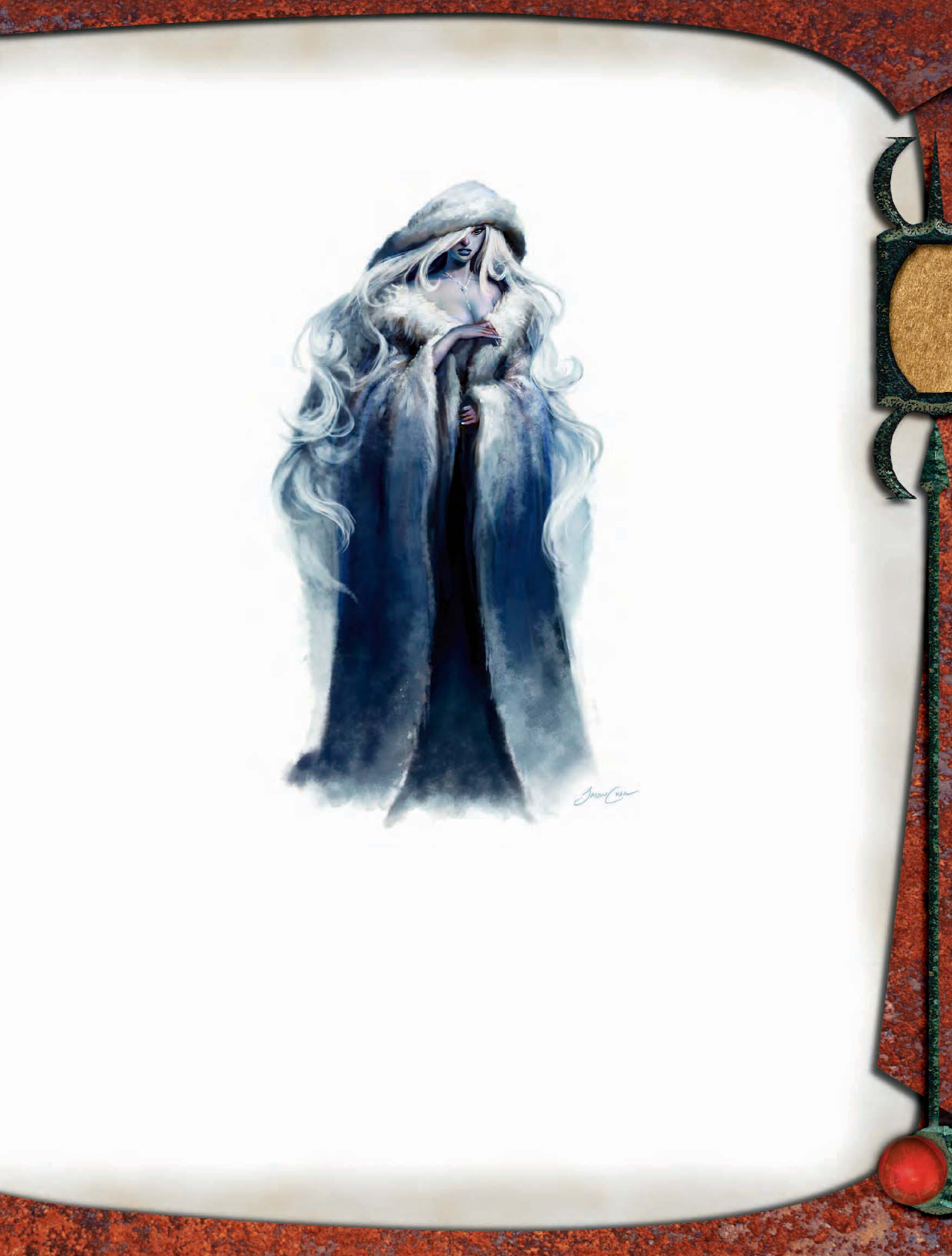
59
ECOLOGY
Frostwind viragos are imbued with the essence of bitter
winter. Their blood is freezing to the touch and thick like
molasses, and even their touch imparts a bitter chill. They
live in remote cold locales, where they subsist on the
frozen fl esh of mammals they have slain, consum-
ing snow and ice for water.
A frostwind virago is devoid of love, but
she can experience desire, often taking a
frost folk (Frostburn 130) champion or
other humanoid as a lover in such
cases. The relationship is short
and stormy, resulting in a frost-
wind virago child.
Environment: Frostwind
viragos prefer to live in cold
mountains, usually within a
carved cave of ice or a natural
cavern overlooking a pass.
The virago claims those who
wander into her territory.
Typical Physical Charac-
teristics: Frostwind viragos
are the size of female elves,
about 5 feet tall and 90 pounds.
Their skin is pale, and their hair
is blonde to stark white. A frost-
wind virago’s eyes are solid blue,
lacking any hint of white.
Alignment: Frostwind viragos
despise warm-blooded intelligent
creatures that use their cleverness
to avoid the freezing grasp of the
cold months. They are remorse-
less killers who toy with their
prey, but they can be reasoned
with, and they see the value of
working toward a common cause
with other creatures. These fey are usu-
ally neutral evil.
SOCIETY
Frostwind viragos consider themselves the handmaidens of
Auril (Frostburn 42), the sinister Frostmaiden of the frostfell.
They desire nothing less than the domination of the world
by ice. From their homes in the frozen wilderness, these fey
act as lone and heartless agents of winter, hunting wanderers
and ill-fated locals. Such frostwind viragos enjoy the hunt
and the kill, but even they can be swayed by a humble offer
of tribute.
Others of these fey set themselves up as monarchs in
snow-covered lands, ruling over other creatures native to
cold climes, including frost folk who revere the virago as
semidivine. Within such malign courts, frostwind viragos
scheme to control other lands. Their subjects carry out
complex plots of destruction and misfortune constructed to
show the implacable nature of the cold season.
A few frostwind viragos fi nd a place among
frost giants. The giants respect the frostwind
virago as a mighty spirit of winter, and the fey
resides among them as a protector and advisor.
More than one frost giant monarch has a frost-
wind virago as a counselor.
Universal among frostwind vira-
gos is their hatred for fey of temperate
and warm climes. Such fey that wander
into a frostwind virago’s territory are
doomed to prolonged suffering be-
fore they are allowed to succumb to
the cold.
TYPICAL TREASURE
Given that their prey is human-
oid, and that tribute is the only way
to stay their icy hands, frostwind
viragos amass quite a collection of
treasure. They have standard treasure
for their Challenge Rating, mostly
in the form of goods and items taken
from travelers.
FROSTWIND VIRAGOS
IN EBERRON
Frostwind viragos can be found in
the Icehorn Mountains north of
the Eldeen Reaches, as well as the
northern Ironroot Mountains of
Karrnath and the Mror Holds. At
least one of these malevolent
fey lives in the Icewood of
northern Karrnath, where she
draws travelers toward the Madstone. The
dwarves of the Mror Holds and the people
of the mainland Lhazaar Principalities suf-
fer the depredations of frostwind viragos in the Hoarfrost
Mountains as well.
FROSTWIND VIRAGOS IN FAERÛN
Among the most feared creatures in the North, these hand-
maidens of Auril (Faiths and Pantheons 91) above) are found
throughout Icewind Dale and the lands of the Frozenfar.
Frostwind viragos prefer to live in the treacherous reaches
of the Spine of the World. Though some frostwind viragos
have been seen as far south as the Sword Coast during the
winter, they prefer to stay well to the north, preying on the
folk of the Savage Frontier.
Frostwind virago
FROSTWIND
VIRAGO
Illus. by J. Chan

60
GARNGRATH
Atop this monster’s reptilian snout, an enormous horn of sparkling
crystal scatters beams of multicolored light. Below that is a gaping
maw full of crystalline teeth. The hulking monstrosity’s black fur
shifts unnaturally, and a shimmering haze shrouds its colossal form.
Its six legs end in jagged claws of crystal.
Garngrath CR 20
Always CE Colossal magical beast (extraplanar)
Init +5; Senses darkvision 120 ft.; Listen +14, Spot +14
Languages understands Common; cannot speak
AC 38, touch 18, flat-footed 37
(–8 size, +1 Dex, +15 deflection, +20 natural);
dimensional shield
Miss Chance 20% (dimensional shield)
hp 462 (28 HD); DR 15/epic
Immune ability damage, electricity, energy drain, fire,
illusions, insanity, sonic
Resist acid 20, cold 20; SR 33
Fort +29, Ref +19, Will +15
Speed 80 ft. (16 squares), burrow 60 ft.; Run
Melee bite +33 (6d6+28)
Space 30 ft.; Reach 20 ft.
Base Atk +28; Grp +56
Atk Options Awesome Blow, Improved Bull Rush, Power
Attack, Snatch, epic strike, improved grab
Special Actions crystal horn, devastating roar, swallow whole,
swallowing charge
Spell-Like Abilities (CL 20th):
1/day — plane shift (self only)
Abilities Str 48, Dex 12, Con 32, Int 6, Wis 18, Cha 12
SA crystal horn, devastating roar, improved grab, spell-like
abilities, swallow whole, swallowing charge
Feats Awesome Blow, Great Fortitude, Improved Bull Rush,
Improved Initiative, Iron Will, Lightning Reflexes, Power
Attack, Run, Snatch, Weapon Focus (bite)
Skills Listen +14, Spot +14, Survival +15
Advancement 29–40 HD (Colossal)
Dimensional Shield (Su) A garngrath is shrouded by a field of
extraplanar energy, granting the beast its deflection bonus
to AC and miss chance. Once per day, the shield can be
focused to generate the garngrath’s spell-like ability.
Improved Grab (Ex) To use this ability, a garngrath must hit
an opponent with its bite. It can then attempt to start
a grapple as a free action without provoking attacks of
opportunity.
Crystal Horn (Sp) As a swift action, a garngrath can use its
horn to generate a prismatic spray, as the spell—roll 1d8
on the table below. Caster level 20th. The save DCs are
Wisdom-based.
1d8 Color Effect
1 Red 20 points fire damage (Reflex DC 21 half)
2 Orange 40 points acid damage (Refl ex DC 21 half)
3 Yellow 80 points electricity damage (Reflex DC 21
half)
4 Green Poison (Kills; Fortitude DC 21 to take 1d6
points of Con damage instead)
5 Blue Turned to stone (Fortitude DC 21 negates)
6 Indigo Insane, as insanity spell (Will DC 21
negates)
7 Violet Sent to another plane (Will DC 21 negates)
8 Struck by two rays; roll twice more, ignoring any
“8” results
Devastating Roar (Ex) As a full-round action, a garngrath can
unleash a roar of such ferocity that it damages creatures
and structures. The roar deals 20d6 points of sonic
damage in a 60-foot-radius spread (Reflex DC 35 half).
In addition, this roar levels all terrain adjacent to the
garngrath, reducing it to light rubble and increasing the
DC of Balance checks and Tumble checks by 2. The save
DC is Constitution-based.
Swallow Whole (Ex) A garngrath can swallow a grappled
opponent of up to Gargantuan size by making a
successful grapple check.
A swallowed creature takes 6d6 points of
bludgeoning damage and 6d6 points of acid damage per
round from the garngrath’s gizzard. The creature can cut
its way out by using a light slashing or piercing weapon
to deal 50 points of damage to the gizzard (AC 23; DR
15/epic). Once the creature exits, muscular action closes
the hole; another swallowed opponent must cut its own
way out.
A garngrath’s gizzard can hold 2 Gargantuan, 8
Huge, 32 Large, 128 Medium, or 512 Small or smaller
opponents.
Swallowing Charge (Ex) As a full-round action, a garngrath
can open its crushing jaws, lay its gaping maw upon
the ground, and rush forward 80 feet, swallowing
everything in its path. Every creature in its 30-foot-wide
path must make a grapple check as if being swallowed
whole or immediately pass into the garngrath’s gizzard.
Unattended objects and structures of Gargantuan or
smaller size are swallowed as well.
Garngraths are titanic creatures created by Erythnul as ever-
hungering engines of destruction. A garngrath’s incredible
might and brutish appetite are complemented by the terrify-
ing power of its crystal horn.
pqqqqqqqqqrs
GARNGRATH LORE
Characters who have ranks in Knowledge (the planes) can
learn more about garngraths. When a character makes a suc-
cessful skill check, the following lore is revealed, including the
information from lower DCs.
Knowledge (the Planes)
DC Result
30 This is a garngrath, a destructive magical beast
from Pandemonium. On that plane, garngraths
are apex predators capable of swallowing several
creatures in one gulp. In fact, a garngrath can
charge headlong, swallowing all in its path.
35 The horn on a garngrath’s head can rapidly emit
prismatic rays. Its hide is shrouded in extraplanar
energy that makes it hard to hit. It is highly
resistant to acid and cold, and it’s immune to
ability damage, electricity, energy drain, fi re,
illusions, insanity, and sonic damage.
40 A garngrath is resistant to spells of all sorts, and
only epic weapons can effectively harm it. It can
unleash a devastating roar capable of rendering
the ground to rubble when it’s threatened. If the
beast is slain, its horn can be claimed as a potent
prize.
pqqqqqqqqqrs
GARNGRATH
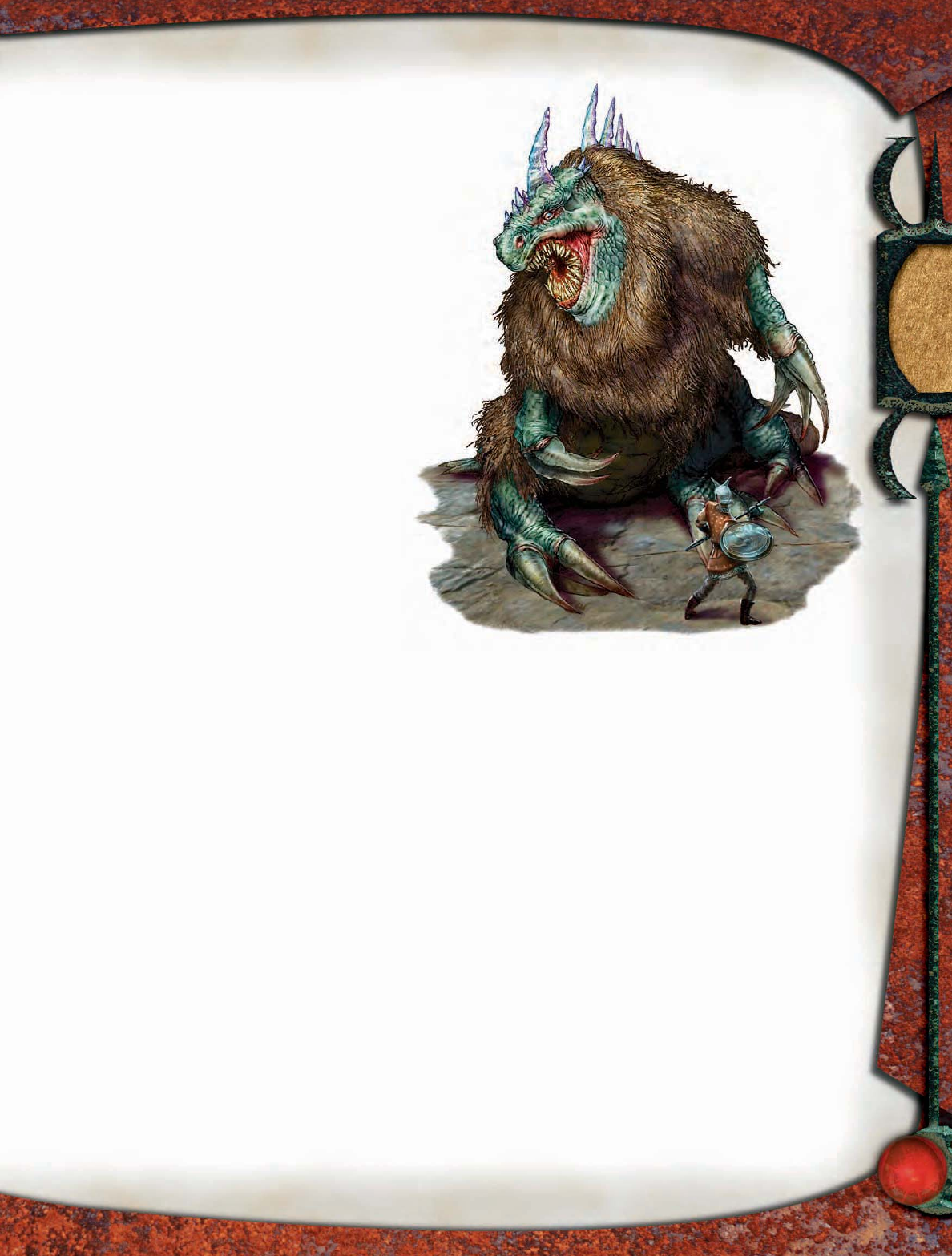
61
STRATEGIES AND TACTICS
When a garngrath spots prey, it burrows toward its quarry
and erupts from the ground nearby. It then uses its swal-
lowing charge, wading into melee with survivors afterward.
Its only goal is to slay and devour its foes, so it uses Power
Attack liberally and tries to swallow any creature it man-
ages to grab. Every round it unleashes a prismatic spray. A
garngrath favors melee over using its devastating roar unless
it plans to retreat. If dangerous enemies remain after the
ear-splitting bellow, a garngrath might fl ee using its plane
shift ability.
SAMPLE ENCOUNTER
Garngraths appear in numbers greater than one only when
they precede a great extraplanar army.
Slaughter Cometh (EL 20): It approaches on the horizon—a
great garngrath unleashed by an extraplanar entity bent on
the destruction of the PCs’ entire civilization. The voracious
monstrosity has already reduced three cities to rubble,
and the characters’ haven is next. Unless the characters
slay the garngrath, thousands will perish before its
other worldly gluttony.
ECOLOGY
Erythnul created the first garngraths to accompany
and amuse him, attaching crystal horns to them to add
to the mayhem. He purposefully let some garngraths slip
into the wilds of Pandemonium, along with the mystery of
crafting and grafting the crystal horns. Extremely powerful
extraplanar entities have used this knowledge and garngraths
in warfare since then.
When Erythnul created the garngraths, he made them
to withstand Pandemonium’s environment as the plane’s
ultimate predators. These beasts can eat and digest any
matter that doesn’t kill them fi rst. They burrow by chewing,
tunneling by eating whatever they move through.
Garngraths are rare. Though they do mate, two garngraths
are more likely to fi ght to the death than engage in courtship.
The victor slaughters and consumes the loser. Even garngrath
young are killed by their mothers if they do not burrow into
the ground soon after being born.
Young garngraths are born Gargantuan and grow to adult
size within a matter of weeks during a fl urry of unabated
feeding. After a garngrath reaches Colossal size, its metabo-
lism churns at an amazing rate. Garngraths rarely live to see
30 years of life, however, aging rapidly due to this consump-
tive vitality.
Environment: Garngraths are native to the Wind-
swept Depths of Pandemonium. They burrow into the mass
of matter that makes up the plane’s ground, adding to the
innumerable tunnels therein. The garngraths’ ability to
plane shift means they can be found just about anywhere,
but few garngraths use this ability to leave Pandemonium.
The beasts must be trained to go to other planes, except
when fl eeing a losing battle.
Typical Physical Characteristics: A typical garngrath
is 70 feet long, 20 feet tall, and weighs more than fi fty tons.
Shaggy black fur covers its body in dreadlocked tendrils.
The air around a garngrath shifts and roils under the sway
of its dimensional shield, giving its hide an unnatural
appearance as though its fur and skin possessed a life of
their own. Six muscular legs concealed beneath patches of
fur and scale end in claws of a mineral composition similar
to quartz, but far stronger. The creature’s oversized reptil-
ian head is crowned with an enormous horn of shining
prismatic crystal and ringed in a long mane of black fur.
Rows of teeth in its maw resemble jagged pieces of glass
jutting in all directions.
Alignment: Garngraths revel in wanton butchery and
massive destruction. They are always chaotic evil.
TYPICAL TREASURE
A garngrath leaves nothing in its wake, and it digests what-
ever it swallows. But if a garngrath is slain, its horn falls off
and can be retrieved. If this is done, the horn immediately
fi xes itself to the head of the creature that retrieved it, resiz-
ing to match the skull of its new owner (Fortitude DC 35
negates). The horn then acts as a helm of brilliance, falling
as powder from the new owner’s skull when its last “jewel”
is depleted.
Garngrath
GARNGRATH
Illus. by A. Swekel
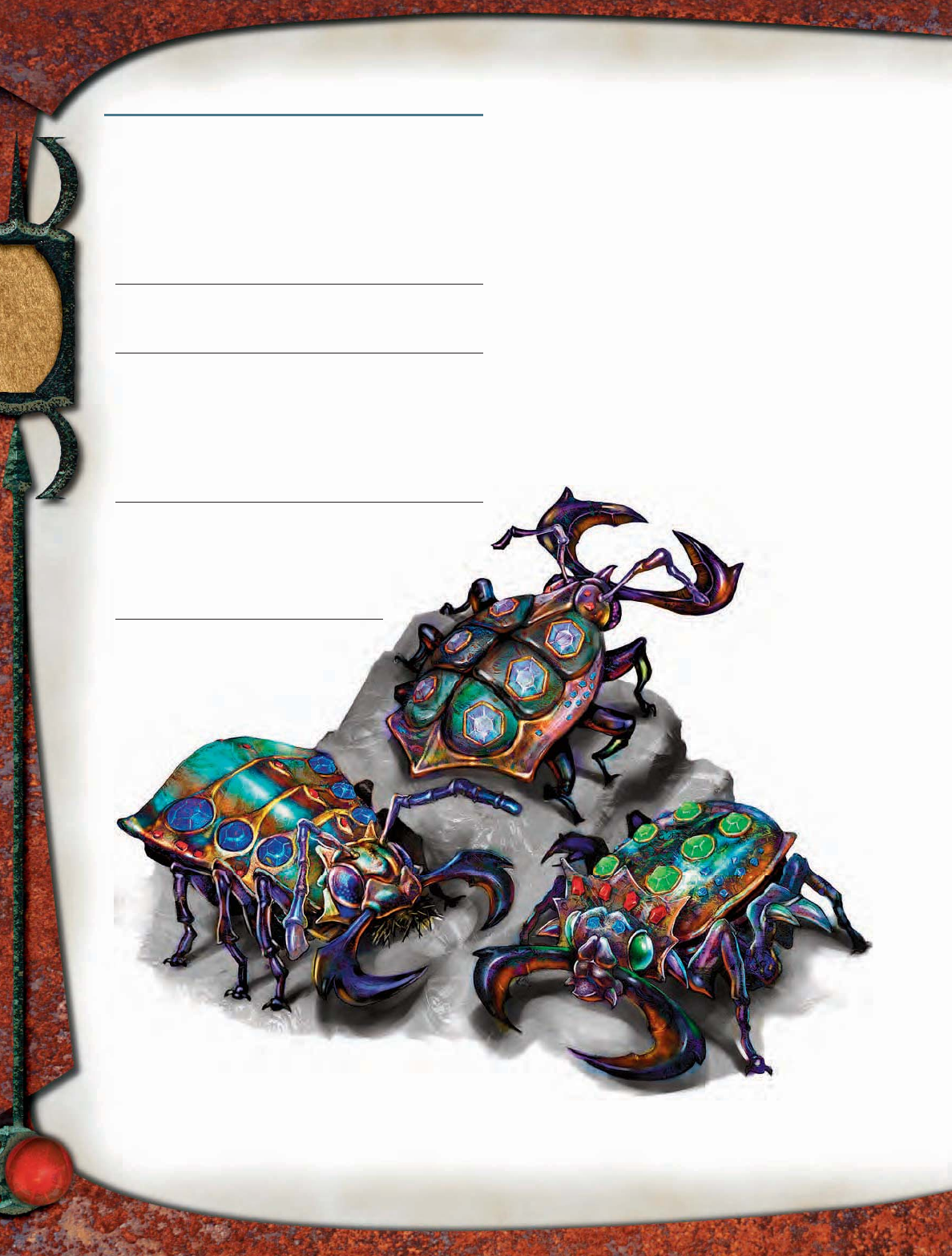
62
GEM SCARAB
A brightly shining beetle emerges from the ground in a shower of
dirt and pebbles. Metallic and iridescent, it’s almost painful to look
at. Its back is encrusted with what look like gemstones, and its
wicked mandibles clack menacingly.
Gem Scarab CR 2
Always N Small magical beast
Init +1; Senses tremorsense 30 ft.; Listen +6, Spot +4
Languages —
AC 16, touch 11, flat-footed 16
(+1 size, +5 natural)
hp 17 (2 HD)
Fort +6, Ref +3, Will +2
Speed 40 ft. (8 squares), fly 60 ft. (average), burrow 15 ft.,
climb 10 ft.
Melee bite +2 (1d4–1)
Space 5 ft.; Reach 5 ft.
Base Atk +2; Grp –3
Spell-Like Abilities (CL 2nd):
Diamond scarab: 6/day—flare (DC 14)
Emerald scarab: 6/day—acid splash (+3 ranged touch)
Sapphire scarab: 6/day—ray of frost (+3 ranged touch)
Abilities Str 9, Dex 10, Con 16, Int 1, Wis 15, Cha 10
SA spell-like abilities
Feats Alertness
Skills Climb +9, Hide +7 (+15 in sand), Listen +6,
Spot +4
Advancement 3–4 HD (Small); 5–6 HD
(Medium)
Skills A gem scarab has a +8 racial
bonus on Hide checks in sand. It
has a +10 racial bonus on Climb
checks and can always choose to
take 10 on Climb checks, even if
rushed or threatened.
Gem scarabs are burrowing, insectlike creatures that dwell
in arid and sandy lands.
STRATEGIES AND TACTICS
Gem scarabs form subterranean packs and attack as a group.
They launch their ambush from the soil beneath their target,
attempting to deal as much damage as possible in the fi rst
moments to maximize the advantage of surprise. If this is not
suffi cient to bring down their prey, they use their gemstone
powers to dazzle or kill their opponents.
Gem scarabs are tenacious, refusing to give up the fi ght
until they are all killed.
SAMPLE ENCOUNTER
Gem scarabs live and hunt in packs. These groups range in
size from two to ten scarabs.
Grazing Ground (EL 5): A small colony of gem scarabs
has set up a nest at the edge of a grazing area, and the
creatures have begun terrorizing the local peasants who
feed and water their animals there. The nest contains three
full-grown scarabs, and the peasants
want them gone. As a reward,
the locals offer a master-
work sword that
belonged to a wise
adventurer who
saved the people in
this area long ago.
ECOLOGY
Diurnal, insectlike predators,
gem scarabs are not truly
insects. Their peculiar nature
is known to desert folk.
Such people dislike
Gem scarabs
GEM SCARAB
Illus. by R. Spears
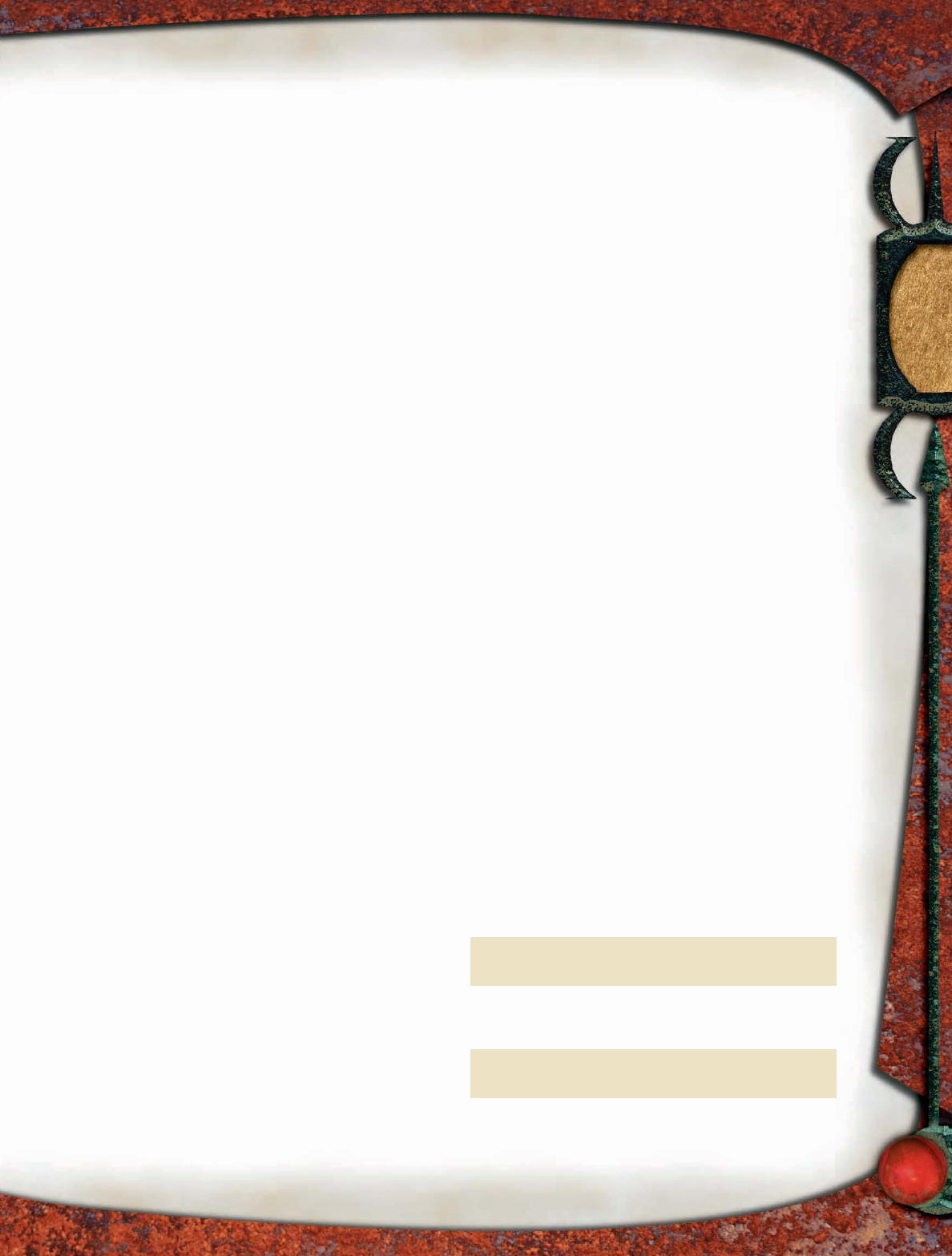
63
gem scarabs, because the beetles eat valuable minerals and
rob the soil of nutrients, ruining it for farming.
Gem scarabs spend part of their time in tunnels, burrowing
through the grit in search of minerals to digest and add to
their carapaces. They also prey on living creatures, sentient
or not, for meat. With an uncanny ability to fi nd valuable
minerals, gem scarabs attack trade convoys or wandering
merchants, from which they can acquire both of the types
of food they crave.
The minerals a gem scarab eats go into its carapace and
gemlike growths on that shell. Within the largest of these
crystalline structures, a gem scarab stores magical energy to
power its spell-like abilities. When a scarab uses the energy
stored within a gem, that gem crumbles to dust and the beetle
sheds it. Other gems on the scarab become big enough to
hold more energy for the creature within a day.
Environment: Gem scarabs prefer to live in hot, dry, dusty
climates, typically deserts and parched scrublands. They have
also been known to settle in fringes of grasslands during
the summer.
They dig their burrows near water holes, oases, rivers,
and other places where animals are likely to pass. Some
learn the routes and trails where people take their animals
to market, and such scarabs burrow beneath the road to
await their next meal.
Typical Physical Characteristics: Gem scarabs come
in a wide variety of hues and have an equally wide variety
of gemstones upon their backs. Each scarab has six fully
formed stones.
A gem scarab’s carapace can be silver, gold, copper, or
any other metallic sheen, often subtly shifting in color
from one end of the beetle to the other. Upon their
wing cases grow encrustations of what appear to be
gemstones—crystallized minerals that are as radiant and
lovely as any jewel.
Normal gem scarabs are 2 feet in length, with six barbed
legs and fi erce mandibles that are adapted to breaking up
minerals. This adaptation also makes the mandibles suitable
for hurting animals and people.
Alignment: Gem scarabs are almost instinctual, operating
with no regard for morality. They are always neutral.
TYPICAL TREASURE
Gem scarabs don’t collect treasure—they eat it. Those whose
treasure hoards have been nibbled at by an infestation of
gem scarabs can take some consolation from the fact that,
once the beetles are killed, their gems and carapaces can be
worth a small fortune.
When removed from slain scarabs, the gemstones are no
longer magical, but they retain some value. If a scarab is
killed before it uses its daily allotment of spell-like abili-
ties, the remaining fully formed gems on its carapace can be
harvested and are worth 100 gp each. For each time a slain
scarab used its spell-like ability, reduce the number of intact
gems by one.
Gems removed from living scarabs crumble to dust, since
the creature immediately transfers the energy within a
harvested gem to another one on its back. Such harvesting
also deals the scarab 1 point of damage.
The metallic carapaces of gem scarabs are valued for use in
jewelry, inks, makeup, and dye. A few desert folk know how
to make the carapace into thread as well, replacing actual
metallic thread. Each slain scarab has enough undamaged
carapace left to sell for 1–100 gp.
When gem scarabs catch sentient creatures, they eat all
minerals of a nonmagical nature along with the fl esh. Other
items might remain at the site.
All these possibilities work together to give a gem scarab
standard treasure for its Challenge Rating.
FOR PLAYER CHARACTERS
A gem scarab can be acquired as an improved familiar
(DMG 200). A spellcaster of any alignment can have a gem
scarab familiar, but that character must have an arcane
spellcaster level of 5th and the Improved Familiar feat.
The gem scarab’s master can select the 0-level spell the
familiar uses as its spell-like ability before summoning
the creature, but that choice cannot be changed after the
familiar is summoned.
pqqqqqqqqqrs
NEW GEM SCARABS
Gem scarabs can come in other varieties. Just about any
cantrip or orison is acceptable as a spell-like ability for a par-
ticular gem scarab. For example, a topaz scarab might have
cure minor wounds as its spell-like ability, while an onyx scarab
could have inflict minor wounds.
pqqqqqqqqqrs
pqqqqqqqqqrs
GEM SCARAB LORE
Characters who have ranks in Knowledge (nature) can learn
more about gem scarabs. When a character makes a success-
ful skill check, the following lore is revealed, including the
information from lower DCs.
Knowledge (Nature)
DC Result
12 This insectlike creature is a gem scarab, a vicious
desert predator. This result reveals all magical
beast traits.
17 Gem scarabs dig their burrows near water holes
or on paths that animals or people are likely to
tread. Their carapaces can be worth a good deal
of money.
22 Gem scarabs are encrusted with gemstones that
allow them to power magical attacks. These gems
can be valuable if harvested from a slain scarab.
pqqqqqqqqqrs
GEM SCARAB

64
GOD-BLOODED CREATURE
When a deity, its avatar, or its aspect appears on the Material
Plane, any blood it sheds retains part of its divine essence.
Gathered in suffi cient quantities, this blood can be used
to bathe as part of a special ritual, creating a god-blooded
creature.
NOZGÛG, GRUUMSH-BLOODED ORC
A web of blackened veins pulse across this orc’s rippling muscles, his
left eye a scarred socket. As he lifts a great spear above his head, he
unleashes a piercing war cry.
Nozgûg (Raging) CR 8
Male Gruumsh-blooded orc barbarian 5/fighter 2
CE Medium humanoid
Init +5; Senses darkvision 60 ft.; Listen +4, Spot +0
Languages Common, Orc
AC 14, touch 9, flat-footed 14; 25% fortification, improved
uncanny dodge
(+1 Dex, +4 armor, +1 natural, –2 raging)
hp 84 (7 HD); divine endurance
Fort +11, Ref +2, Will +3
Speed 30 ft. (6 squares) in hide armor, base speed 40 ft.
Melee +1 spear +16/+11 (1d8+11/×3)
Ranged javelin +8/+3 (1d6+7)
Base Atk +7; Grp +14
Atk Options Cleave, Power Attack, rage 2/day (7 rounds)
Special Actions Gruumsh’s fury, Gruumsh’s glare
Combat Gear potion of blur, potion of jump
Abilities Str 24, Dex 13, Con 18, Int 6, Wis 10, Cha 8
SQ trap sense +1
Feats CleaveB, Improved Initiative, Improved Toughness,
Power AttackB, Weapon Focus (spear)
Skills Climb +9, Jump +9, Intimidate +3, Listen +4, Spot +0,
Swim +5
Possessions combat gear plus +1 hide armor of light
fortification, +1 spear, 6 javelins, amulet of natural
armor +1 (shaped like a symbol of Gruumsh)
Fortification (Ex) 25% chance to ignore the additional
damage dealt by a critical hit or sneak attack. This benefit
comes from Nozgûg’s armor.
Divine Endurance (Su) Nozgûg can take a free action to gain
damage reduction 10/—. He can suppress this ability
with another free action. Once the damage reduction has
prevented 40 points of damage, Nozgûg loses all benefits
of the god-blooded template, including this ability.
Gruumsh’s Fury (Su) Once per day, as a swift action, Nozgûg
can draw upon the power of the divine blood within his
body to gain a +4 bonus (+8 against elves) on melee
damage rolls for the rest of his turn.
Gruumsh’s Glare (Su) Once per day, Nozgûg can cause
a baleful, glowing red eye to appear in his empty eye
socket. The eye creates a 60-foot cone of red energy. All
creatures in this area must succeed on a DC 17 Fortitude
save or be paralyzed for 1 round. Elves take a –4 penalty
on this save. The save DC is Constitution-based.
When not raging, Nozgûg has the following changed
statistics:
AC 16, touch 11, flat-footed 16
hp 70
Fort +9, Will +1
Melee +1 spear +14/+9 (1d8+8/×3)
Ranged javelin +8/+3 (1d6+5)
Grp +12
Abilities Str 20, Con 14
Skills Climb +7, Jump +7, Swim +3
Gruumsh’s Glare (Su) DC 15
Nozgûg is an independent raider covered in glory—a paragon
among his people. He had the following ability scores before
Hit Dice and racial ability score adjustments: Str 15, Dex 13,
Con 14, Int 8, Wis 12, Cha 10.
Strategies and Tactics
Nozgûg has only two purposes in life—to slay and to pillage.
He uses his Gruumsh’s glare ability to paralyze his enemies,
then charges in to murder a helpless foe. Gruumsh’s fury he
reserves for a worthy enemy or an elf. Wishing to keep his
divine talents, he activates his divine endurance only if he
thinks he might lose the fi ght otherwise.
Sample Encounters
Becoming god-blooded is invariably a great honor, and god-
blooded creatures serve as warlords and champions. Sites
where creatures can acquire the god-blooded template are
protected fi ercely.
Nozgûg’s Raiders (EL 9): Nozgûg raids accompanied by
an orc berserker (MM4 114), an orc war howler (MM4 114),
and six orc warriors (MM 203). His warriors provide fl anks
and sometimes use the aid another action to give Nozgûg
more of an advantage. The berserker wades in independently,
and the war howler provides support. Nozgûg focuses his
attacks on elves, moving to other targets only after all elves
are slain.
Neversleep Citadel (EL 9+ per encounter): High in
the Altan Tepes Mountains, an ancient order of orc priests
watches over a bubbling cauldron filled with blood spilled
by Gruumsh. According to legend, Gruumsh bled on this
spot when Corellon cut the orc god’s eye from its socket.
The clerics allow orc champions who perform great deeds
in Gruumsh’s name and can make it to the cauldron to
bathe within, granting them a measure of the god’s power.
Nozgûg is one such champion, and the citadel is now
his home.
The citadel protecting the cauldron houses a small army
of orc barbarians, fighters, and clerics. Some of these are
half-dragons. A young adult red dragon protects the place
due to an ancient pact between Gruumsh and Tiamat. This
dragon leaves and is replaced by another when it reaches
adulthood.
CREATING A GOD-BLOODED
CREATURE
“God-blooded” is an acquired template that can be added
to a creature (referred to hereafter as the base creature)
favored by the deity in question, as defi ned in the specifi c
deity entries.
GOD-BLOODED
CREATURE
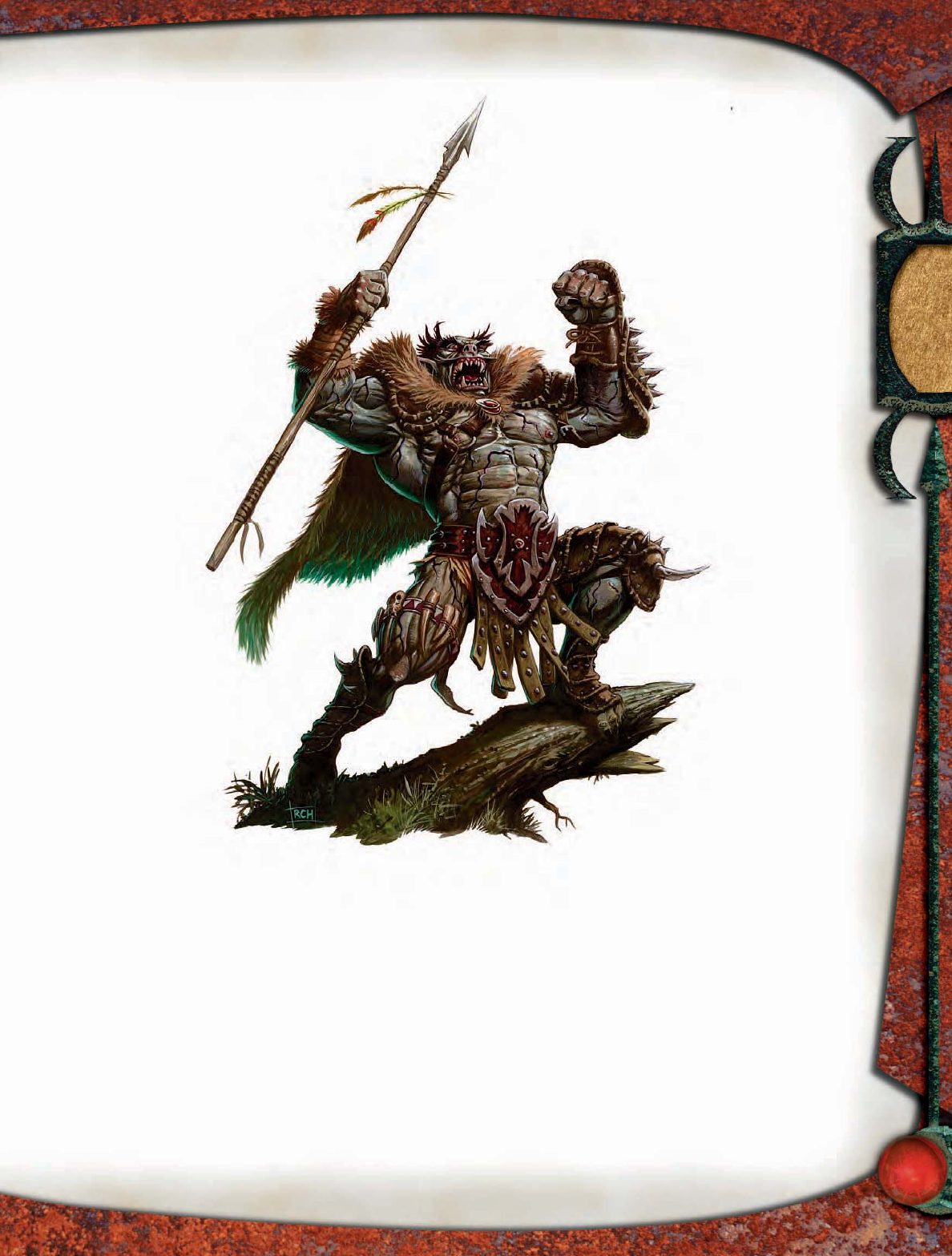
65
Challenge Rating: Same as the base creature +1.
Special Actions: The base creature gains the following
special action.
Divine Endurance: A god-blooded creature can take
a free action to gain damage reduction
10/— from the mingling of divine blood
with its material form. The creature can
suppress this ability with another free
action. Once the damage reduction has
prevented 40 points of damage, the
creature loses all benefits of the
god-blooded template, including
this ability, except when oth-
erwise noted.
Other Abilities: All god-
blooded creatures receive other
abilities based on the blood
they bathe in. See the deity
entries below.
Level Adjustment: +1.
Gruumsh-Blooded
“Gruumsh-blooded”
is an acquired tem-
plate that can be
added to any orc.
Gruumsh-blooded
orcs are typically created
at unholy sites, where
clerics of Gruumsh tend
iron cauldrons fi lled
with their god’s bubbling
green blood. When an orc
bathes in the blood, his left
eye shrivels and falls
out, leaving an empty
socket. The eye doesn’t
regrow even if the
orc subsequently loses
this template.
Special Actions: A Gruumsh-
blooded orc gains the following special
actions.
Gruumsh’s Glare (Su): Once per day, a Gruumsh-blooded
orc can cause a baleful, glowing red eye to appear in his
empty eye socket. The eye creates a 60-foot cone of red
energy. All creatures in this area must succeed on Forti-
tude saves (DC 10 + 1/2 the orc’s HD + his Con modifier)
or be paralyzed for 1 round. Elves take a –4 penalty on
this save.
Gruumsh’s Fury (Su): Once per day, as a swift action, a
Gruumsh-blooded orc can draw upon the power of the divine
blood within his body to gain a +4 bonus (+8 against elves)
on damage rolls for the rest of his turn.
Imix-Blooded
“Imix-blooded” is an acquired template that can
be added to any evil creature. A creature gains this
template through service to Imix, Prince of Evil Fire
Elementals. The creature must perform a great deed
in the name of Imix, and then, when the signs and omens
are promising, stand in a brass cauldron fi lled with oil and
set it alight. If Imix is pleased, he
appears and squeezes a single
drop of his fi ery blood into the
cauldron, granting the crea-
ture this template.
Subtype: An Imix-
blooded creature gains
the fi re subtype.
Special Actions: An
Imix-blooded creature
gains the following spe-
cial action.
Imix’s Wrath (Su): An Imix-
blooded creature is wreathed in
fl ames that don’t harm its
equipment. Once per day,
as a swift action, an
Imix-blooded crea-
ture can cause fi re
to flow from its
body over its weapons.
All the creature’s melee
attacks deal an ex-
tra 4 points of fi re
damage until the
end of its turn. If an
Imix-blooded creature
casts a fi re spell while
affected by this quality,
that spell deals an extra
number of points of dam-
age equal to the Imix-blooded creature’s
caster level.
Special Qualities: An Imix-blooded
creature gains the following special qualities.
Burn (Su): The fi res that cloak an Imix-blooded creature lash
out to harm those who would dare attack it. Any creature that
hits an Imix-blooded foe with a melee attack takes 3 points
of fi re damage.
Death Throes (Su): Imix is quick to reward those who
follow him, but his fiery anger is legendary. When killed,
an Imix-blooded creature explodes in a 30-foot-radius
burst that deals fire damage to each creature or object in
the area equal to 1d6 × 1/2 the Imix-blooded creature’s
Challenge Rating. A successful Reflex save (DC 10 + 1/2
the Imix-blooded creature’s HD + its Cha modifier) halves
this damage.
Nozgûg, Gruumsh-blooded orc
GOD-BLOODED
CREATURE
Illus. by R. Horsley
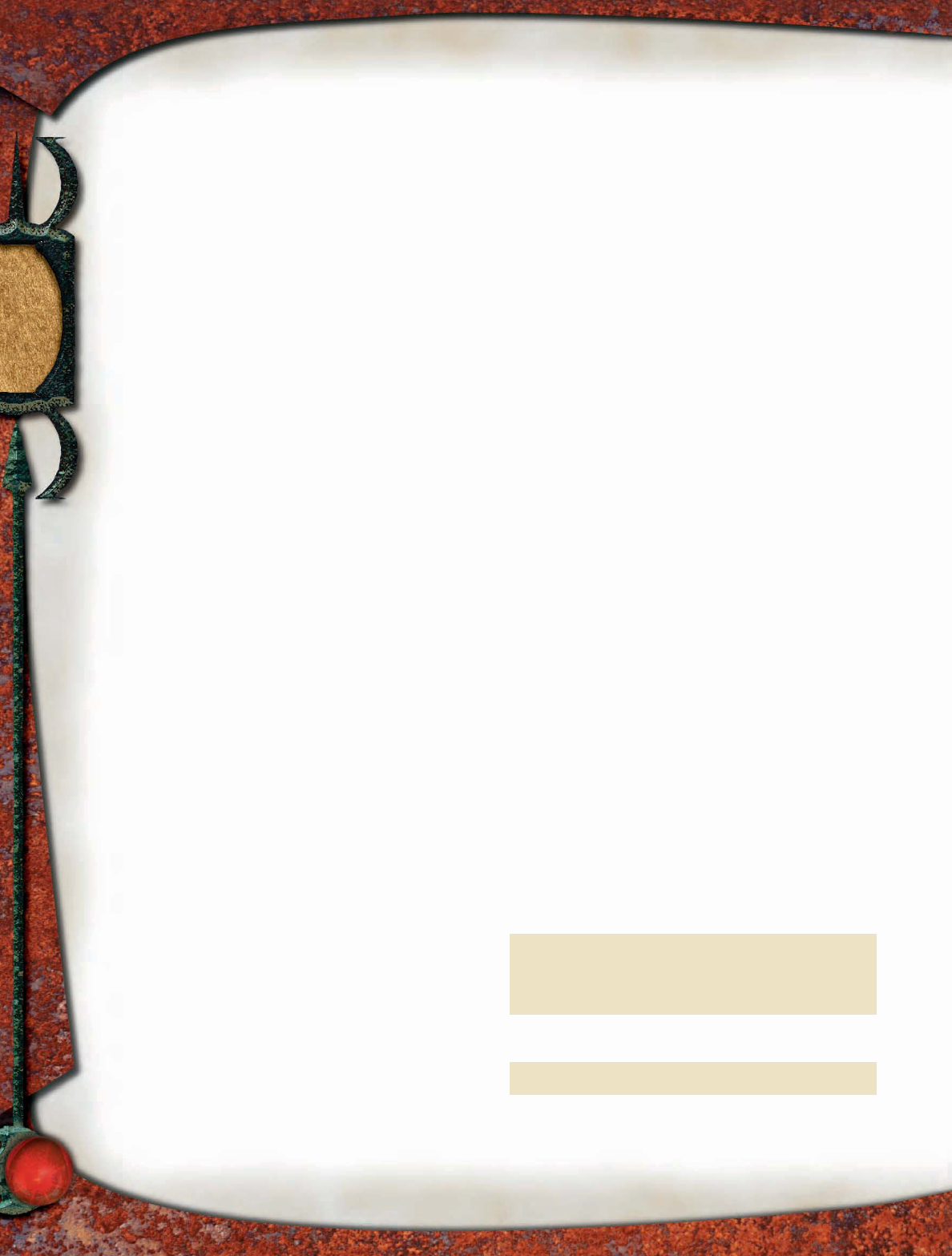
66
Kord-Blooded
“Kord-blooded” is an acquired template that can be added to
any non-evil living creature that has a Strength score of 16
or higher. Each year, the major temples to Kord hold a great
wrestling tournament, and the tournament’s winner wrestles
an aspect of Kord. Whoever pins the other wins. If Kord’s
aspect loses, he cuts his palm and drips a drop of blood on
the victor’s brow, bestowing this template. Sometimes Kord
bestows this honor on a skilled, relentless competitor that
lost the match.
Saves: A Kord-blooded creature gains a +4 bonus on saves
against poison and disease.
Special Actions: A Kord-blooded creature gains the fol-
lowing special action.
Kord’s Athleticism (Su): Once per day, as a swift action, a
Kord-blooded creature can call upon the blood invested
in him to gain a tremendous surge of prowess. For the
next minute, the Kord-blooded creature gains a +4 bonus
on Strength and Dexterity checks, Strength- and Dexter-
ity-based skill checks, and grapple checks. The creature
also gains a +1 bonus on damage rolls to which Strength
normally applies.
Special Qualities: A Kord-blooded creature gains the
following special quality.
Kord’s Toughness (Su): Whenever a Kord-blooded creature
would take Constitution damage, that damage is halved.
Orcus-Blooded
“Orcus-blooded” is an acquired template that can be added
to any evil undead creature. The sacrifi ce of good-aligned
creatures totaling 20 or more Hit Dice causes an aspect of
Orcus to appear and bathe the petitioner with black, tarry
blood poured from a golden chalice. The undead creature
covered in this blood then grows goatlike horns and gains
the Orcus-blooded template. The horns disappear when the
template is lost.
Resist: An Orcus-blooded creature gains +4 turn resistance.
Special Qualities: An Orcus-blooded creature gains the
following special qualities.
Herald of Orcus (Su): An Orcus-blooded creature gains
a +1 bonus to the save DCs of necromancy spells it casts,
as well as a +1 bonus to the save DCs of its spell-like and
supernatural abilities.
Wand of Orcus (Su): Once per day, as a swift action, an Orcus-
blooded creature can summon a minor wand of Orcus. The
wand appears in the creature’s hand and lasts for 1 minute.
It functions as a +2 morningstar.
Once per day, while the wand exists, the Orcus-blooded
creature can use it to deliver a melee touch attack. An oppo-
nent so touched must succeed on a Fortitude save (DC 10 +
1/2 the Orcus-blooded creature’s HD + its Cha modifi er) or
take 4 points of Constitution damage. If that foe fails the save,
the Orcus-blooded creature gains 2 temporary hit points per
HD that enemy possesses. These temporary hit points last
for 1 hour.
Vecna-Blooded
“Vecna-blooded” is an acquired template that can be added to
any evil creature capable of casting 2nd-level or higher arcane
spells. When an arcane spellcaster manages to unravel the
Seven Riddles of Vecna, that individual can become Vecna-
blooded. None know the true nature of these riddles, but
solving them sends a caster to a pocket dimension known as
the Oubliette of Secrets. There, after exposure to a number
of bizarre tortures and ordeals at the hands of a strange
creature known as the Anchorite, the caster emerges as a
Vecna-blooded creature. The creature loses all distinguishing
characteristics, hair, and other traits, keeping only a small,
thin mouth, the faintest trace of a nose, and eyes. These
changes are permanent and remain even after the creature
loses this template.
Some sages believe that several Anchorites exist, and that
they are the most powerful of Vecna’s servants. They seek out
lost secrets and forgotten lore. Several point to the disappear-
ance of Delether of Hardby as the Anchorites’ work. Every
page of the books in Delether’s library had been carefully
removed and replaced with cured human skin—apparently
taken from Delether, judging by the faint remnants of his
tattoos found in several of the volumes.
Special Actions: A Vecna-blooded creature gains the
following special actions.
Enigma Aura (Su): Once per day, as a standard action, a
Vecna-blooded creature can wrap itself in an aura that makes
creatures within 120 feet intermittently forget it’s there. At
the start of each affected creature’s turn, that creature has a
50% chance to be unable to attack the Vecna-blooded creature
in any way, including with spells and special abilities. The
aura lasts for 1 minute after it’s activated.
Hidden Spell (Su): Once per day, as a swift action, a Vecna-
blooded creature can cause fl at-footed opponents to take a
pqqqqqqqqqrs
GOD-BLOODED LORE
Characters who have ranks in Knowledge (religion) can learn
more about god-blooded creatures. When a character makes
a successful skill check, the following lore is revealed, includ-
ing the information from lower DCs.
Knowledge (Religion)
DC Result
15 God-blooded creatures are divine champions
infused with the essence of their deity. The god’s
blood within them makes them incredibly durable,
but if they are sorely wounded, the god’s power
fades from them.
20 This result reveals one randomly chosen special
action or special quality that the specifi c template
grants.
25 This result reveals a second, randomly chosen
special action or special quality.
30 This result reveals a third, randomly chosen
special action or special quality.
pqqqqqqqqqrs
GOD-BLOODED
CREATURE
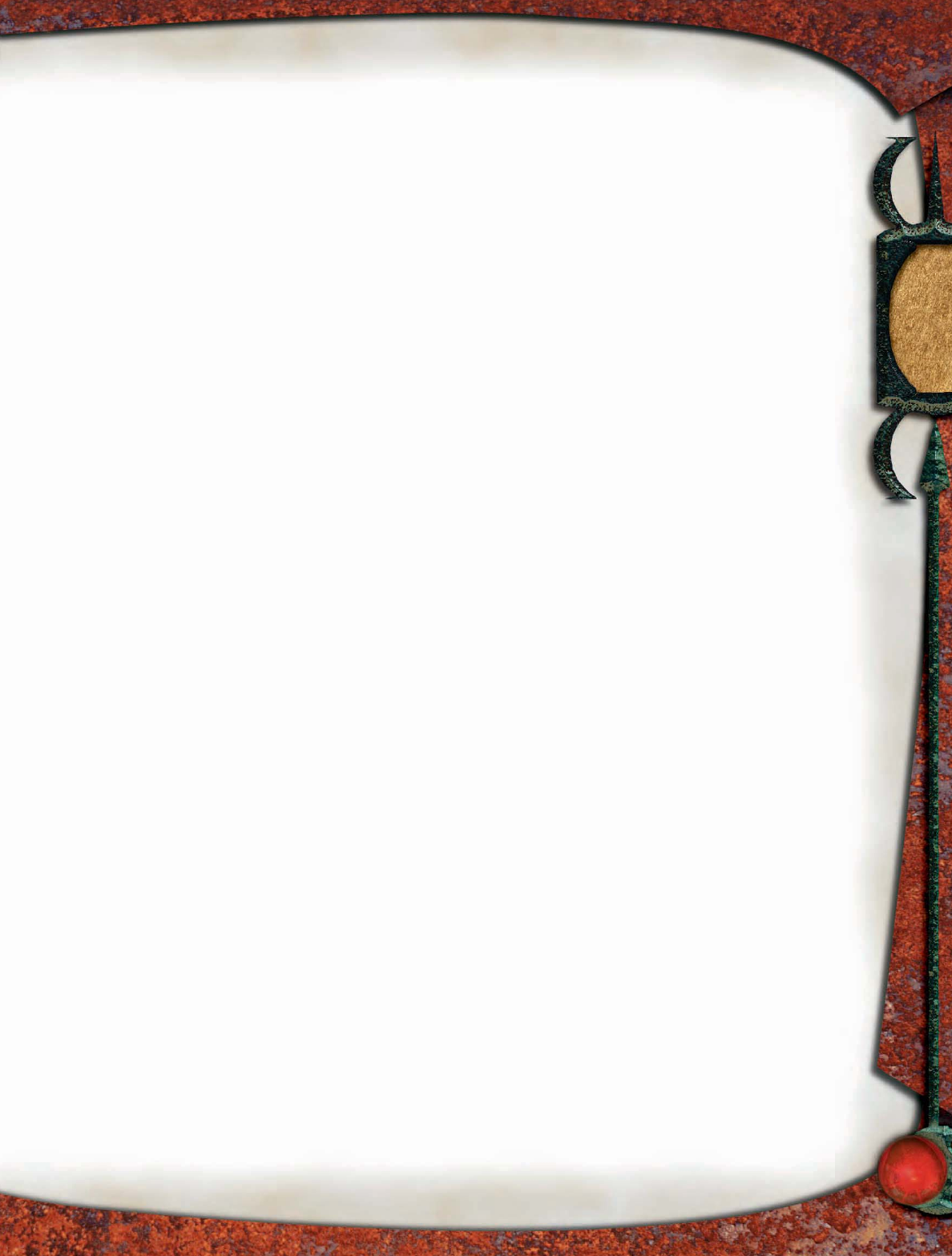
67
–4 penalty on saves against spells the creature casts on that
same turn.
Special Qualities: A Vecna-blooded creature gains the
following special qualities.
Cloak of Mystery (Su): All knowledge of the Vecna-blooded
creature fades from the world. Its original name, its deeds
before becoming Vecna-blooded, and so forth, disappear from
memory. Only Vecna and the Vecna-blooded creature retain
this knowledge.
A Vecna-blooded creature gains immunity to all divination
spells cast against it or cast to learn information about it.
Such divination fails to reveal any information. The Vecna-
blooded creature immediately learns the name, appearance,
and location of the caster who attempted the divination.
Unlike other god-blooded abilities, the Vecna-blooded
creature retains this special quality after it loses other abilities
from this template.
Yeenoghu-Blooded
“Yeenoghu-blooded” is an acquired template that can be added
to any gnoll. A gnoll champion gains the Yeenoghu-blooded
template by killing a fellow gnoll who has this template and
drinking his blood. In this manner, Yeenoghu ensures that
his children continually strive to prove themselves against
each other and their enemies. Occasionally, when an aspect
of Yeenoghu appears before a tribe, the gnolls attack it in a
frenzy to become Yeenoghu-blooded. Those who survive and
devour the aspect’s fl esh gain this template.
A creature that gains this template becomes shrouded in
noxious, putrid air. Flies and maggots swarm over its body,
marking its link to the fearsome Demon Prince of Gnolls.
It grows long, yellow fangs, and a mixture of pus and drool
spills over its lower lip.
Melee: A Yeenoghu-blooded creature gains a secondary
bite attack that deals 1d6 points of damage.
Special Actions: A Yeenoghu-blooded creature gains the
following special actions.
Rot Fangs (Ex): Once per day, as a swift action, a Yeenoghu-
blooded creature can imbue its bite with a dreadful necrotic
energy. The next time the gnoll hits an opponent with a bite,
that foe must succeed on a Fortitude save (DC 10 + 1/2 the
gnoll’s HD + its Con modifi er) or take 1d6 points of Constitu-
tion damage.
Special Quality: A Yeenoghu-blooded creature gains the
following special quality.
Gore Stench (Su): A Yeenoghu-blooded creature is caked with
putrid fi lth, dried blood, and gore. Maggots crawl through
its fur, and a horrifi c stench and a swarm of fl ies surround it
all times. Living creatures (except for gnolls) within 10 feet
of a Yeenoghu-blooded creature must succeed on a Fortitude
save (DC 10 + 1/2 the gnoll’s HD + its Con modifi er) or be
sickened for 1 minute. If a creature successfully saves against
this ability, that creature need not save again for 24 hours. A
delay poison or neutralize poison spell removes the effect from
a sickened creature. Creatures that are immune to poison or
that have a saving throw bonus against poison receive those
benefi ts against the stench.
TYPICAL TREASURE
A god-blooded creature usually carries icons of its faith,
to mark the favor of the gods and to display its piety. God-
blooded NPCs have equipment appropriate to NPCs of
their Challenge Rating—slightly more than normal for
their level.
CREATING GOD-BLOODED
TEMPLATES
The example templates given in this entry cover some of
the entities found in the D&D world. If you wish to add
god-blooded creatures to Eberron, Faerûn, or your campaign
setting, use the following guidelines.
A god-blooded template should physically alter its recipient
in a manner in keeping with the god’s ethos and important
physical traits. Powers granted by the template might further
change the recipient. In the examples given in this entry,
Gruumsh’s single eye, Imix’s fi ery body, and Orcus’s horns
mark the creature that receives the deity’s blood. Similar
traits should be gained from templates you create.
All god-blooded templates share the divine endurance
special quality. This ability refl ects a combination of the
supernatural protection offered by divine blood. As pre-
sented, the template produces a creature that seems incredibly
diffi cult to harm at the start of an encounter. If the characters
persist in attacking, though, they eventually strip away that
defense. If you prefer a permanent template, change the
damage reduction to 5/magic and remove the limit on the
damage it can absorb.
The template should grant two special abilities in addition
to divine endurance. You can add a third if that ability has
little direct effect on combat. The Vecna-blooded template
provides a good example of such an ability with its cloak of
mystery. The cloak adds some interesting story elements to
the creature, but it has little effect during a fi ght.
The creature’s abilities should be useful regardless of its
fi nal Challenge Rating. Abilities that deal a fi xed amount of
damage are diffi cult to judge, since that damage doesn’t scale
as the creature’s CR increases. Instead of such abilities, focus
on attacks that require saving throws and impose conditions,
since save DCs improve as Hit Dice increase, forcing the
PCs to make saving throws appropriate for the creature’s
challenge. Keep the duration conditions such as paralyzed,
dazed, or stunned short—they take a target out of the fi ght.
Longer durations are fi ne for dazzled, sickened, and other
conditions that impose penalties.
Avoid abilities that add static bonuses to ability scores,
attacks, or AC, instead choosing abilities that make it apparent
to the characters and players that the god-blooded creature is
infused with the power of its deity. The PCs (and the players)
should see a clear link between the creature’s altered form,
the power it calls upon, and the effects it can create.
GOD-BLOODED
CREATURE

68
GOLEM
Golems are magically created automatons of great power.
Constructing one involves the employment of mighty magic
and elemental forces. Golems are summarized on page 134
of the Monster Manual.
FORCE GOLEM
Humanoid in shape but covered in reflective blue-green metal
plates, this creature looks as though it has been mangled or rent by
powerful hands. Its body sags as though its armor has melted, or
perhaps was reshaped by great force.
Force Golem CR 4
Usually N Large construct
Init +7; Senses darkvision 60 ft., low-light vision; Listen +2,
Spot +3
Languages Common, Terran
AC 18, touch 16, flat-footed 15
(–1 size, +3 Dex, +4 deflection, +2 natural)
hp 52 (4 HD); DR 5/adamantine
Immune construct immunities, magic
Resist sonic 10
Fort +1, Ref +6, Will +1
Weakness force vulnerability
Speed 30 ft. (6 squares)
Melee 2 slams +6 each (1d8+4)
Ranged pulse +5 ranged touch (knock back)
Space 10 ft.; Reach 10 ft.
Base Atk +3; Grp +11
Atk Options Point Blank Shot
Special Actions force burst, force reactive
Abilities Str 19, Dex 16, Con —, Int 12, Wis 10, Cha 14
SA force burst, force reactive, pulse
SQ construct traits
Feats Improved Initiative, Point Blank Shot
Skills Balance +8, Jump +11, Listen +2, Spot +3, Tumble +9
Advancement 5–10 HD (Large); 11–15 HD (Huge)
Immunity to Magic (Ex) A force golem is immune to spells
and spell-like abilities that allow spell resistance. This
immunity does not extend to force effects.
Force Vulnerability (Ex) Force effects deal half again as much
(+50%) damage to a force golem.
Force Burst (Su) Once every 3 rounds, a force golem can
create a 30-foot-radius burst of force centered on itself.
Creatures in the area take 2d6 points of damage and
are knocked prone. Those who succeed on a DC 14
Reflex save take half damage and remain standing.
Force golems are immune to this ability. The save DC is
Charisma-based.
Force Reactive (Su) Whenever an opponent attacks and
misses a force golem with a melee attack, the force golem
can turn the kinetic energy of the attack back on the
attacker as an immediate action. The attacker is pushed
5 feet into an empty square of the force golem’s choice.
This movement does not provoke attacks of opportunity.
Pulse (Sp) A force golem can target any corporeal opponent
within 60 feet with a ranged touch attack. If the force
golem hits, it and its target make opposed Strength
checks. If the force golem wins the opposed check, the
opponent is pushed 10 feet in a direction of the golem’s
choice and falls prone in the square it ends up in. This
movement does not provoke attacks of opportunity.
A force golem can push an opponent only in a
straight line, and it cannot push an opponent closer to
it than the square that foe started in. If an intervening
obstacle prevents the opponent from being pushed 10
feet, the foe and the obstacle each take 1d6 points of
damage. The opponent then falls prone in the square it
was in before striking the obstacle.
Any feat or special ability that grants a bonus on
resisting bull rush attempts (such as a dwarf’s stability)
applies to this opposed Strength check.
Force golems are imbued with the power to manipulate
kinetic energy and raw force. They can turn opponents’
attacks back against them and knock foes flying with a
thought.
Strategies and Tactics
A force golem’s unusual intelligence has a specifi c purpose,
allowing it to make the best use of its force burst and pulse
abilities. These constructs are capable of complex tactical
analysis, and they never simply lash out at random foes.
The key to a force golem’s success in combat lies in keeping
enemies at a distance. Already immune to a lot of magical
attacks, force golems ward off melee attackers, using their
force burst ability and their pulse attack, knocking foes
against walls or other obstacles if possible. A force golem
does its best to knock opponents over pitfalls or drop-offs on
the battlefi eld.
If attackers close to melee range, a force golem uses its force
burst to keep from being surrounded or fl anked. It uses its
force reactive ability to push combatants away as well, keeping
smaller combatants at a disadvantage.
A group of force golems can be devastating in combat.
They stagger the use of their force bursts to attack foes in
each round and prevent those enemies from gaining strategic
position. They target different ranged foes with their pulse
ability, breaking up the opposing force.
pqqqqqqqqqrs
FORCE GOLEM LORE
Characters who have ranks in Knowledge (arcana) can learn
more about force golems. When a character makes a suc-
cessful skill check, the following lore is revealed, including
the information from lower DCs.
Knowledge (Arcana)
DC Result
14 This is a force golem, an unusually intelligent
construct. This result reveals all construct traits.
19 A force golem can knock groups of foes prone
with a damage-dealing burst of force. It can target
individual creatures and push them backward with
a pulse of force.
24 Force golems can absorb and redirect the kinetic
energy of missed melee attacks, knocking
opponents out of melee range. They are immune
to most magic but vulnerable to force effects.
pqqqqqqqqqrs
GOLEM
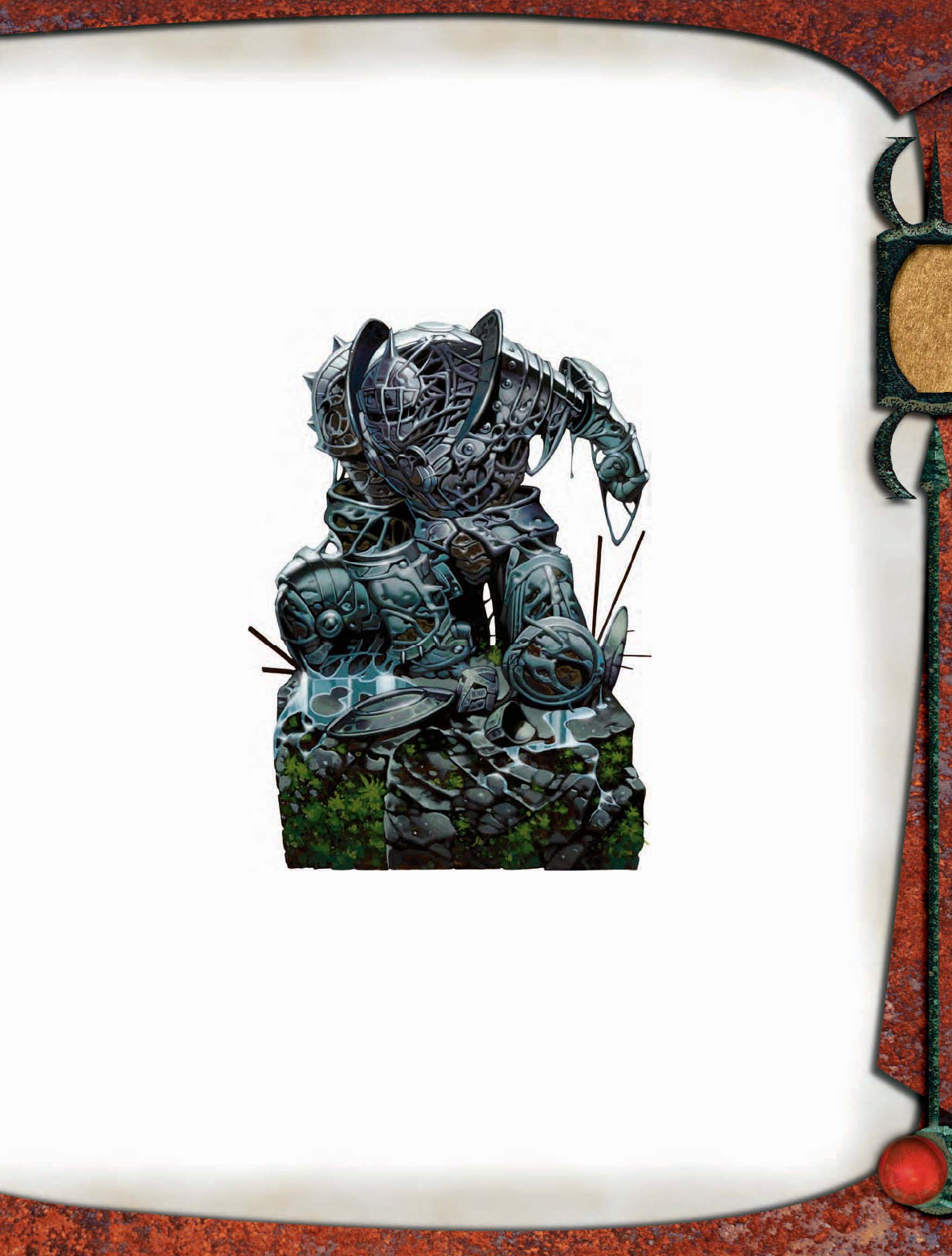
69
Sample Encounter
Though force golems are typically deployed as guardians,
wizards and sorcerers sometimes use these creatures as
combat support. Able to push foes away from a spellcaster or
prevent enemies from fl eeing, a force golem makes a great
bodyguard. It can also help an arcane spellcaster maximize
the number of creatures affected by area spells. These intel-
ligent golems are commonly found in pairs, but they might
appear in larger gangs.
Trap Masters (EL 8): Three force golems guard a huge
antechamber to a wizard’s ancient vault. On the floor of
the antechamber is a circle of sigils that
functions as a fireball trap (DMG 72).
Immune to the trap’s effect, the
force golems use their abilities
to move opponents around, set-
ting off the trap as many times as
possible during any battle against
interlopers.
Ecology
A force golem is a construct body in-
habited by an elemental spirit that
made a pact with the golem’s cre-
ator, requiring the golem to
follow orders but allowing the
elemental spirit some inde-
pendence and awareness.
As such, force golems can
be controlled more effec-
tively than other types of
golems—they can follow
complex orders and carry out
sophisticated tasks. Though
they think independently,
force golems usually carry
out their commands unfail-
ingly. However, if a master
proves overly domineering, a
force golem might make life
more diffi cult for that creature
or even rebel against it.
Environment: Force golems function
in any environment, though they prefer places where they
can use their abilities to their best advantage. Wide-open
spaces allow them to maximize the number of enemies
they can affect. Force golems avoid confined areas when
they can.
Typical Physical Characteristics: Force golems appear to
have been created with an orderly design in mind—a design
somehow ruined by the powerful forces these constructs
control. Their armor is bent and has a melted quality, an
effect of the residual energy that radiates constantly from
their bodies.
Force golems are tall but stout. They stand about 8 feet tall
and weigh 1,200 pounds.
Alignment: Though they have greater intelligence than
others of their kind, nearly all force golems remain steadfastly
neutral. A rare few of these constructs willingly take on the
morals of good or evil masters, and some fl ee from any control
that attempts to subvert their neutral nature.
Society
When not controlled, these intelligent constructs are drawn
to populated areas. Barring prejudice against them,
force golems can develop relationships with other
creatures. Some even seem to need compan-
ionship, which is why they usually
appear in groups.
Though they have no soci-
ety or culture, force golems
share a common bond of un-
derstanding. They consider
other force golems to be al-
lies. Force golems that have
broken away from their
masters sometimes form
small bands, defending each
other from common foes.
Typical Treasure
A force golem has usually has
no wealth of its own, but it
might guard its master’s
valuables. One that is free
of outside control could de-
velop a taste for riches and
acquire standard treasure for
its Challenge Rating.
For Player
Characters
Arcane spellcasters create
force golems as guardians
for specific locations, as
bodyguards, or both. With
their high intelligence and force-manipulation
abilities, these constructs are diffi cult to thwart, and they
can contain foes rather than destroy them. They are also able
to differentiate malicious intruders from simple trespassers
who might be indiscriminately slain by nonintelligent
golems or magic traps.
Force Golem Construction: A force golem’s metal body
is composed of several different alloys, blended together in
a precise combination before being poured into specially
created molds that cost 2,000 gp. Raw materials and sup-
plies for this process cost 2,250 gp. A mold can be used only
once; it is destroyed in the process of creating the golem.
Force golem
GOLEM
Illus. by T. Giorello
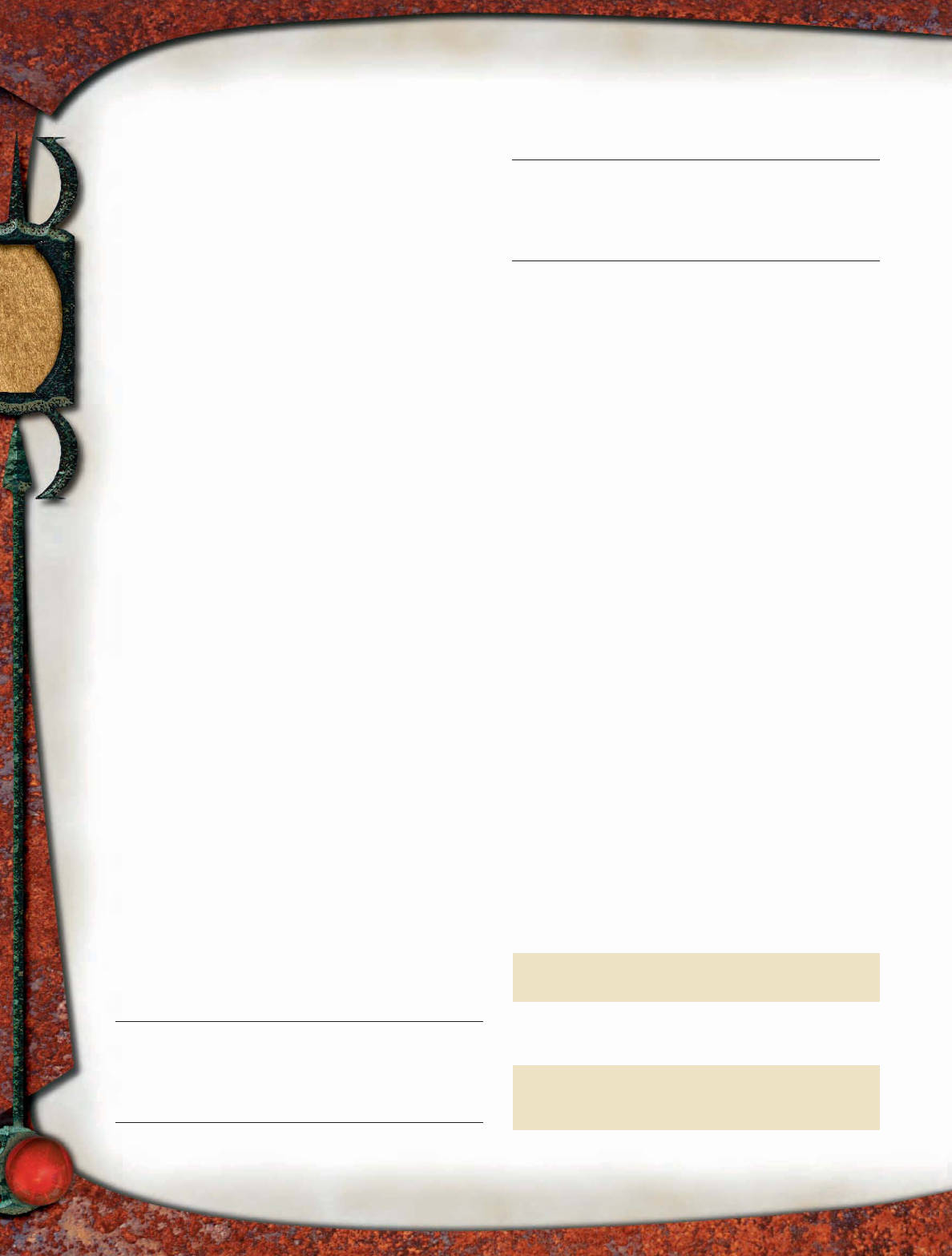
70
Creating the body from the shaped pieces requires a DC 20
Craft (armorsmithing) check.
Once the body is fi nished, the creator of a force golem
must lure an elemental spirit from the Elemental Plane of
Earth. The spirit agrees to obey the creator in exchange for
being able to remain sentient, and the creator bonds the
spirit with the golem body. When the bonding process is
complete, the elemental spirit warps and shapes the body to
its own liking.
CL 12th; Craft Construct, animate objects, contact other plane,
lesser planar binding, caster must be at least 12th level; Price
50,000 gp; Cost 29,250 gp + 2,000 XP.
Force Golems in Eberron
The process of creating a force golem is different from
that of creating golems that contain bound elementals, but
some believe that force golems represent an advancement
in elemental binding. Artificers of House Cannith are
rumored to pay for information leading to the discovery of
force golems in unaffi liated hands, lending some credence
to these rumors.
Though force golems are merely elemental spirits bound
into an artifi cial body, they display a level of awareness similar
to that of living constructs. As a result, numerous warforged
are curious about these golems, seeing them as kindred
spirits. A few warforged, however, distrust force golems.
Force Golems in Faerûn
Though not unheard of in Faerûn, force golems are exceed-
ingly rare. More than few arcane spellcasters are distrustful
of constructs that have such a high degree of sentience and
autonomy, and a lot of wizard organizations forbid their
members from creating such creatures. Perhaps the fear
of rebellious constructs overrides arcane creativity in this
case. Despite these generalities, the Red Wizards of Thay
are known to use force golems as guardians for their most
important magical sites.
MAGMACORE GOLEM
Overlapping plates of gleaming metal cover the body of this human-
oid fi gure, the air around it rippling where it radiates heat. As the
creature moves, you see what appears to be molten rock fl owing
between the gaps of its armor.
Magmacore Golem CR 4
Always N Medium construct
Init +2; Senses darkvision 60 ft., low-light vision; Listen –1,
Spot –1
Languages understands creator’s orders
AC 20, touch 12, flat-footed 18
(+2 Dex, +8 natural)
hp 47 (4 HD); DR 5/adamantine; shattered armor, volcanic
death throes
Immune construct immunities, electricity, fire, magic
Fort +1, Ref +3, Will +0
Speed 30 ft. (6 squares)
Melee slam +7 (1d8+4)
Space 5 ft.; Reach 5 ft.
Base Atk +3; Grp +6
Special Actions molten step
Abilities Str 16, Dex 14, Con —, Int —, Wis 8, Cha 6
SA molten step, volcanic death throes
SQ construct traits
Feats Weapon Focus (slam)B
Skills Listen –1, Spot –1
Advancement 5–10 HD (Medium)
Shattered Armor (Ex) When a magmacore golem is reduced
to half of its full normal hit points or fewer, its outer
armored layer shatters to expose the creature’s molten
core. The magmacore golem’s statistics change as
follows:
The creature’s natural armor bonus to AC is reduced
to +1, decreasing its AC by 7.
It gains concealment as if under a permanent blur
effect.
It loses its damage reduction 5/adamantine.
Any creature that touches or makes a melee attack
against the golem takes 1d4 points of fire damage.
Volcanic Death Throes (Su) When destroyed, a magmacore
golem releases one last blast of molten energy. The
square occupied by the magmacore golem and all
adjacent squares become molten as if affected by the
molten step ability.
Immunity to Magic (Ex) A magmacore golem is immune to
any spell or spell-like effect that allows spell resistance.
However, any spell or effect that deals cold damage deals
normal damage to a magmacore golem.
Molten Step (Su) As a swift action, once every 3 rounds, a
magmacore golem can infuse its essence into any two
adjacent squares. These squares explode into molten
flame for 2 minutes. Molten squares cost 2 squares of
movement to enter, and creatures can’t run or charge
across them. Any creature passing through a molten
square takes 1d6 points of fire damage.
If 10 or more points of cold damage are directed at
a molten square, it returns to normal. Affected squares
cool immediately when the effect ends, but they retain a
blasted and burned appearance.
pqqqqqqqqqrs
MAGMACORE GOLEM LORE
Characters who have ranks in Knowledge (arcana) can learn
more about magmacore golems. When a character makes a
successful skill check, the following lore is revealed, including
the information from lower DCs.
Knowledge (Arcana)
DC Result
14 This is a magmacore golem, a construct bound
with spirits from the Elemental Planes of Earth and
Fire. This result reveals all construct traits.
19 Magmacore golems can infuse the ground around
them with magical fi re, turning it molten. They are
immune to fi re, electricity, and most magic, but
cold can harm them.
24 A magmacore golem becomes more dangerous
as it weakens, fi rst dealing fi re damage when its
armor fails, then turning all adjacent squares
molten as it dies.
pqqqqqqqqqrs
GOLEM
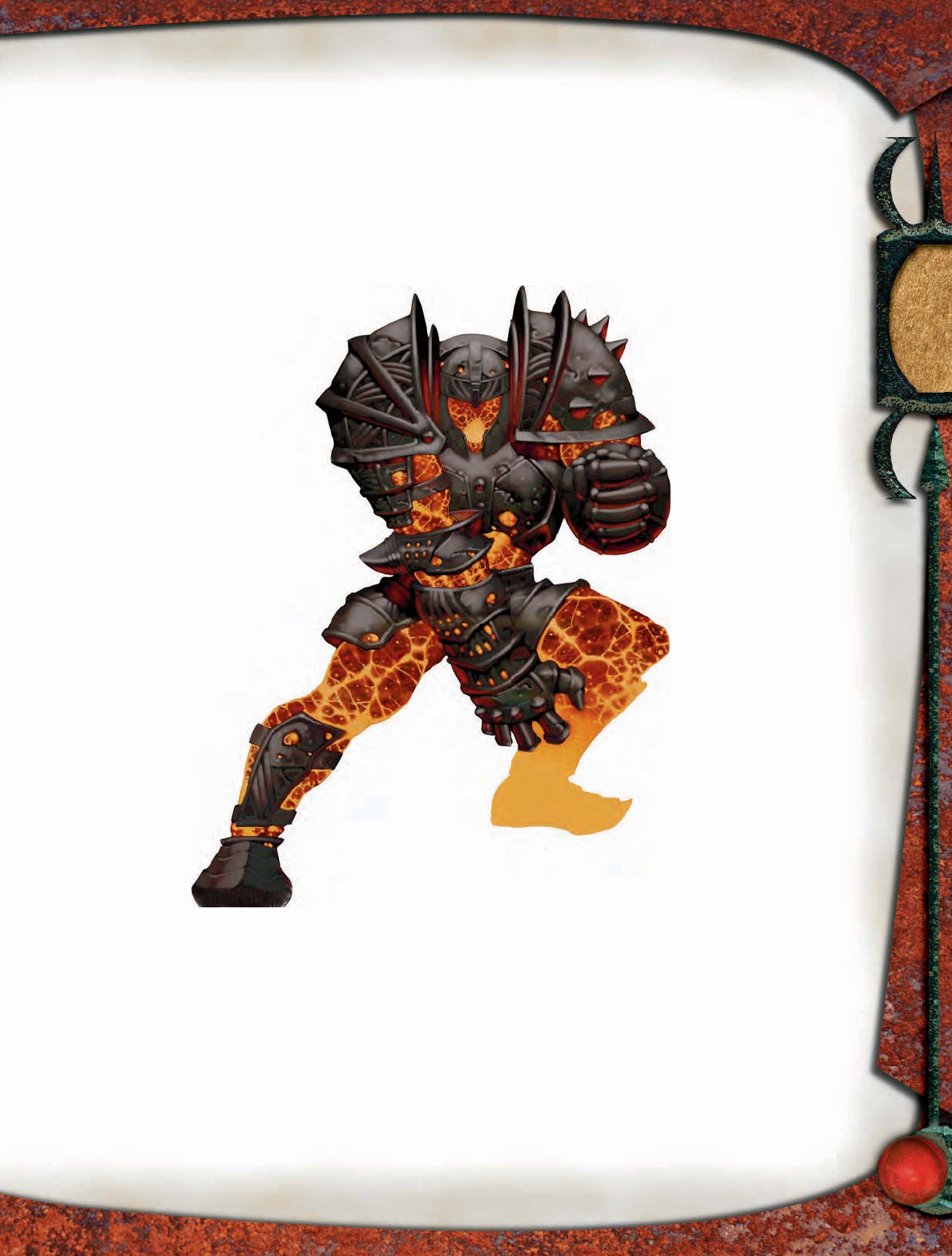
71
A magmacore golem is a humanoid-shaped construct crafted
from molten rock and surrounded by an armored shell. It is
a strange amalgamation of fi re and earth.
Strategies and Tactics
Due to the blending of fi re and earth elemental spirits with-
in it, a magmacore golem is fi erce and charges headlong into
battle. It uses its molten step ability to create patches of mol-
ten ground, preventing opponents from easily fl anking it.
If possible, a magmacore golem also cuts off poten-
tial melee opponents by creating patches of molten
ground in their path, forcing them to take fi re
damage in order to close to melee range.
When fighting alongside others of
their kind, magmacore golems are
particularly deadly. They use their
molten step ability to create a treach-
erous battlefi eld for foes that can be
harmed by fi re.
Having no sense of self-preservation,
magmacore golems fi ght until destroyed.
Sample Encounters
Magmacore golems serve as watchers and
guardians. Less of a threat individually than
other golems, they often appear in gangs
or in groups with other constructs.
Lone Guardian (EL 4): A magmacore
golem guards the entrance to a ruined
mine where a valuable magic relic is
hidden. The magmacore golem
initially reserves its molten step
ability, drawing intruders
into the mine’s narrow
passages. It then hedges
them in with patches of
molten stone.
Fire and Force (EL
6–8): Magmacore
golems are some-
times paired with
force golems (see
above). The force
golem can com-
mand the magmacore golems, and the creatures combine
their abilities for maximum effect.
EL 7: A force golem and two magmacore golems stand guard
over the tomb of an ancient sorcerer. When they engage
intruders, the force golem uses its kinetic abilities to push
enemies toward squares affected by molten step.
Ecology
A magmacore golem is created when an arcane spellcaster
binds a spirit from the Elemental Plane of Earth into a
construct body, then draws another spirit from the Elemental
Plane of Fire to create the golem’s molten core. The pairing of
these spirits makes magmacore golems more readily violent
than other similar constructs.
Environment: Magmacore golems can be found any-
where, though they work best in areas where they can use
their ability to turn their surroundings molten. As such, these
creatures are typically deployed in locations where they do
not risk damaging part of a permanent structure.
Typical Physical Character-
istics: Magmacore golems stand
roughly 6 feet tall and weigh over
2,000 pounds. Plates of their
armor are fused over a mol-
ten rock core, and their heads
have no discernible features
except a smooth, eyeless
faceplate.
Alignment: Magma-
core golems always
follow their master’s or-
ders without question.
They are neutral.
Typical Treasure
A magmacore golem has no
treasure, but it is sometimes
charged with guarding
valuables.
For Player
Characters
Magmacore golems are typ-
ically created as guardians
for out-of-the-way locations, but
they sometimes serve as the
personal guardians of spell-
casters dedicated to the arts
of fire.
Magmacore Golem Con-
struction: A magmacore golem’s body
must be carved from a single stone slab weighing no fewer
than 2,000 pounds. Before carving, the slab is treated with
rare oils and powders worth 500 gp, and it is shaped by
someone who must succeed on a DC 10 Craft (sculpting)
check. Then the armor is attached—a suit of masterwork
full plate specially crafted for the creation process at a cost
of 1,650 gp. When the spirits of fi re and earth are bound
within the armored body, the stone melts into a mass of
molten rock.
CL 9th; Craft Construct, animate objects, commune, lesser
planar binding, caster must be at least 9th level; Price 35,000
gp; Cost 19,650 gp + 1,400 XP.
Magmacore golem
GOLEM
Illus. by T. Giorello
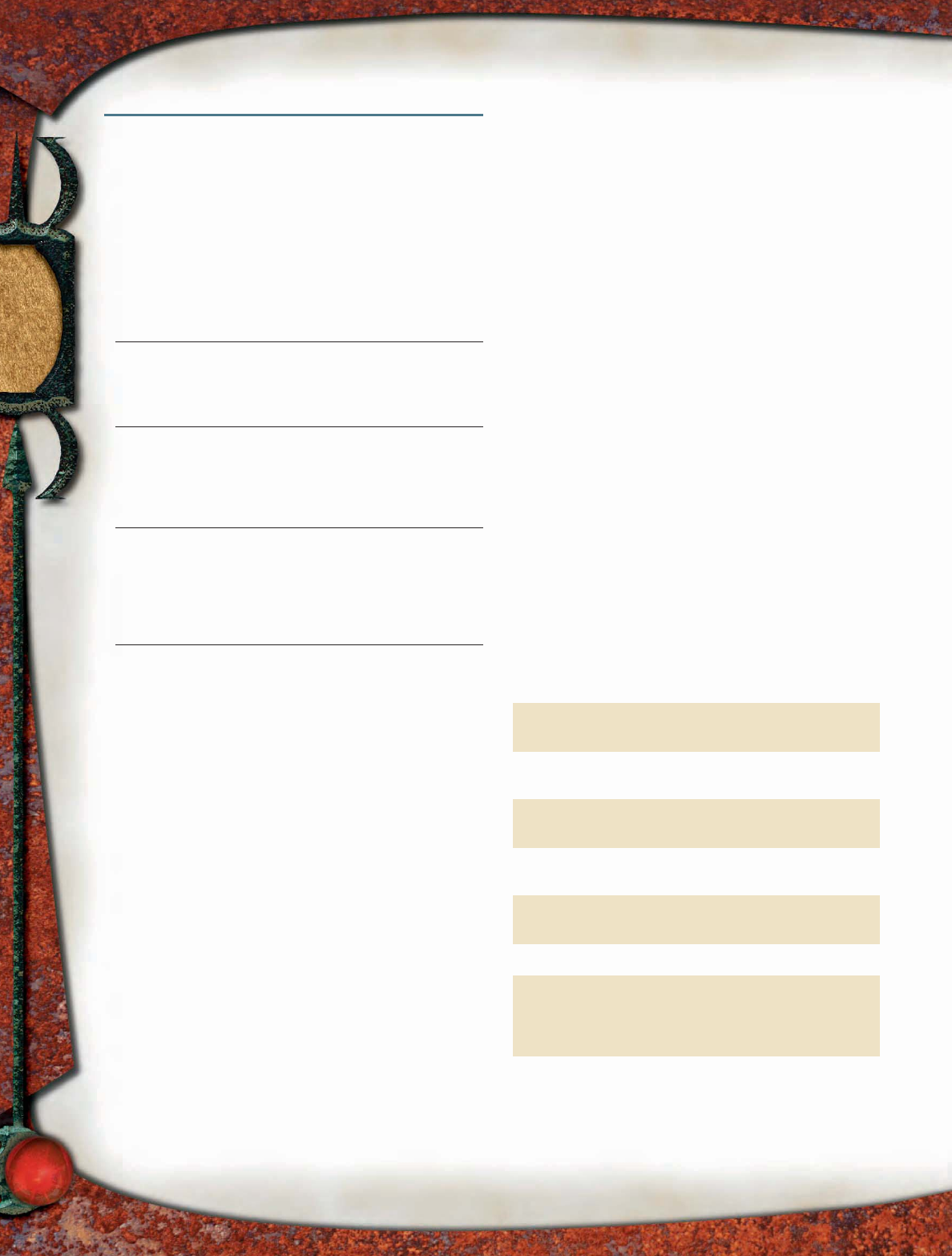
72
GRAVEYARD SLUDGE
A writhing puddle of black and green sludge twists and squirms as
though animated by a supernatural force. Within the disgusting
liquid are the limp body parts of a variety of dead humanoids. Here
and there, chunks of fl esh can be seen—a severed head protruding
from one side, a leg extending from the top of the creature. As the
sludge slides across the ground, human faces and hands appear to
be pressing outward from within.
Graveyard Sludge CR 4
Always N Large ooze
Init +1; Senses blind, blindsight 120 ft.; Listen –5
Languages —
AC 17, touch 14, flat-footed 16
(–1 size, +1 Dex, +4 deflection, +3 natural)
hp 63 (6 HD); between worlds
Immune acid, ooze immunities
Fort +7, Ref +3, Will –3
Speed 30 ft. (6 squares)
Melee slam +7 (1d6+6 plus 1d6 acid)
Space 10 ft.; Reach 5 ft.
Base Atk +4; Grp +12
Special Actions oozespawn zombies, spirit resurgence, vigor
of the dead
Abilities Str 18, Dex 12, Con 20, Int —, Wis 1, Cha 1
SA oozespawn zombies, spirit resurgence, vigor of the dead
SQ ooze traits
Feats —
Skills Listen –5
Advancement 7–11 HD (Large); 12–16 HD (Huge); 17–21 HD
(Gargantuan)
Between Worlds (Su) Graveyard sludges are healed by both
cure spells and inflict spells. They take no damage from
inflict spells.
Oozespawn Zombies (Su) Whenever a creature that can
acquire the zombie template (MM 265) dies within 20
feet of a graveyard sludge, that creature rises as a zombie
1d4 rounds later. However, the graveyard sludge imparts
some of its own unique physiology to the zombie,
causing each of the zombie’s natural attacks to deal an
extra 1d6 points of acid damage.
Spirit Resurgence (Su) A graveyard sludge can release its
latent spiritual energy, causing the spirits trapped within
it to reach out at the sludge’s enemies. All adjacent
opponents must succeed on a DC 18 Will save or be
subject to the effect of a fear spell for 1 round. The save
DC is Constitution-based.
Vigor of the Dead (Su) A graveyard sludge possesses a great
deal of negative energy, and it can sacrifice its actions
to transfer that energy to nearby undead. As a full-round
action, a graveyard sludge can target a single adjacent
undead creature. That creature gains a +2 bonus on
saving throws, a +2 bonus on caster level checks made
when casting spells from the necromancy school, DR
5/good, and +2 turn resistance. These benefits last for
1 round.
A graveyard sludge is an ooze that forms in an area where
the remains of the dead are defiled. Its body is composed
of a disgusting muck interspersed with the flesh and
bones of corpses it has absorbed. The sludge is awash in
latent spiritual energy siphoned from devoured remains,
which gives viewers the impression that humanoid
creatures trapped within it are pushing out and trying
to escape.
STRATEGIES AND TACTICS
Since graveyard sludges are mindless, they put no thought
into their tactics beyond attacking obvious threats.
However, graveyard sludges can sense necromancy and
negative energy, including that which animates undead,
so they know when sentient undead are in the area.
When they sense an intelligent undead creature nearby,
graveyard sludges willingly sacrifice themselves for that
creature’s benefit.
When undead creatures that can benefi t from its abilities
are near, a graveyard sludge uses vigor of the dead to enhance
the most powerful creature among them. That creature usu-
ally protects the graveyard sludge as well, if only to continue
gaining the benefi ts the ooze provides.
If a graveyard sludge finds itself surrounded or under
intense melee assault, it uses spirit resurgence to force
pqqqqqqqqqrs
GRAVEYARD SLUDGE LORE
Characters who have ranks in Knowledge (dungeoneering)
or Knowledge (religion) can learn more about graveyard
sludges. When a character makes a successful skill check,
the following lore is revealed, including the information
from lower DCs.
Knowledge (Dungeoneering)
DC Result
14 This is a graveyard sludge, an ooze that lives
where dead bodies can be found. This result
reveals all ooze traits.
19 Graveyard sludges form spontaneously in places
where corpses lie. Like many oozes, their slams
deliver acid.
24 Somehow, graveyard sludges can cause fear in
their attackers. They usually do so just before
retreating themselves.
Knowledge (Religion)
DC Result
14 This is a graveyard sludge, an ooze that
spontaneously appears in areas where negative
energy collects.
19 Any creature slain by a graveyard sludge rises as a
zombielike creature with an acidic touch.
24 Undead creatures are strengthened by the
presence of a graveyard sludge. Such undead are
more resistant to almost every form of attack as
well as to turning. They gain a small amount of
magical potency if they’re spellcasters.
29 Graveyard sludges are at once living and dead.
They are healed by both cure spells and infl ict
spells.
pqqqqqqqqqrs
GRAVEYARD
SLUDGE
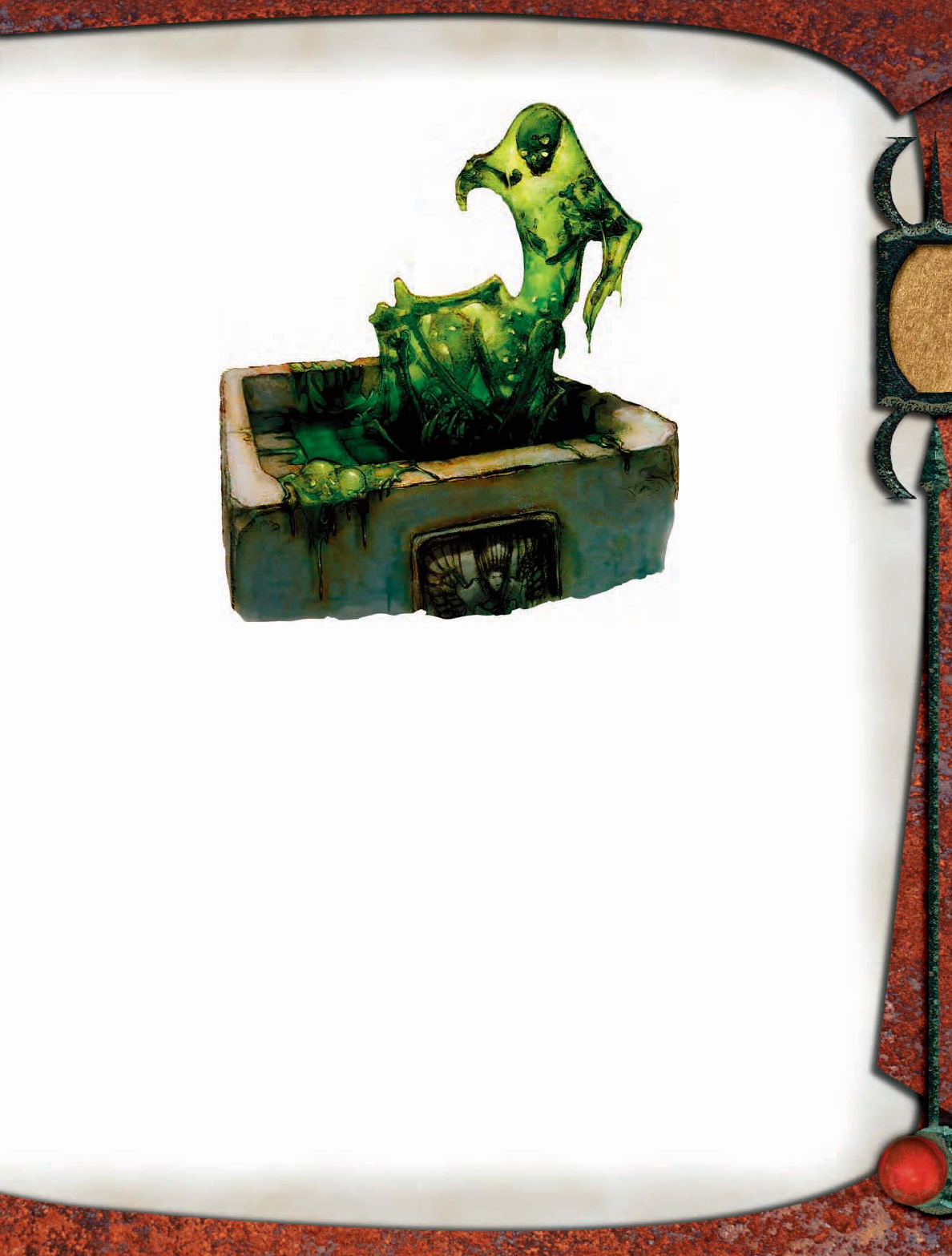
73
enemies to fl ee. Once it has sent its attackers running, the
graveyard sludge retreats to a place where it can avoid fur-
ther harm. If its opponents do not fl ee for some reason, the
graveyard sludge continues to fi ght until destroyed.
Graveyard sludges instinctively attempt to kill dying
creatures that can gain the zombie template. The resultant
oozespawn zombies also protect the sludge.
SAMPLE ENCOUNTER
Graveyard sludges work best when they can give
a temporary boost to undead. Though they are
sometimes encountered alone, most graveyard
sludges are found in the company of liches and
other undead spell-
casters, who prize
the oozes as living
sources of necro-
mantic power.
Skull Lord’s
Minions (EL 10):
A skull lord (page
154) has created two
bonespurs (page
156) and gathered
a following of four
graveyard sludges.
Believing the char-
acters have an object
it wants, the skull lord
attacks the thorp where the PCs are resting.
It first sends the graveyard sludges and bonespurs after
the villagers, creating skeletons and oozespawn zombies
in the process, hoping to draw out the characters. Adja-
cent to the skull lord at all times is one graveyard sludge,
using vigor of the dead.
ECOLOGY
Unlike most other living creatures, graveyard sludges
are not the result of reproduction—they spontaneously
spawn wherever an abundance of negative energy collects.
Desecrated graveyards, corrupted battlefields, and other
places where the dead lie improperly make perfect breed-
ing grounds for graveyard sludges. When enough negative
energy builds up, that energy coalesces in the form of a
disgusting ooze, which then proceeds to assimilate nearby
cadavers and skeletons.
Graveyard sludges have within their bodies the remains
of at least a dozen different creatures at any given time, if
not more. Surges in the energy drawn from these remains
create ghostly images within the body of a graveyard
sludge, though these spiritual manifestations are not
actually creatures.
A graveyard sludge feeds on the dead, but a corpse is little
more than a container for what the sludge is really after. The
sludge sucks out the remaining spiritu-
al energy inside a cadaver like a beast
sucking the marrow from a bone. As
a result, speak with dead doesn’t work
on the bodies absorbed by a grave-
yard sludge.
A graveyard sludge feeds
off residual spiritual ener-
gy, and once it has gained
its nourishment, it stores the
excess. It releases this energy
by bolstering and creating
undead, or by invoking fear
in its attackers.
Environment: Though
graveyard sludges can go
for long periods be-
tween meals, they
prefer to remain with-
in striking distance of
graveyards and tombs
where they can gather
more food. A grave-
yard sludge seeks dark,
damp environments
where it can rest. Since
a graveyard sludge’s body
is composed of muck drawn from
the soil around a grave site, these creatures
are frequently found inhabiting open graves
or disturbed sepulchers.
Typical Physical Characteristics: Graveyard sludges
resemble large piles of mud, blood, and pus. They are amor-
phous, moving by undulating their formless bodies. Random
fragments of bone and fl esh protrude in all directions from
within the body of a graveyard sludge, and the slow-moving
forms of “spirits” constantly push outward from within the
creature’s body.
Alignment: Graveyard sludges have no intelligence, no
sense of right and wrong. Though they assist evil creatures,
they do so from an instinctual compulsion. They are always
neutral.
GRAVEYARD SLUDGES IN EBERRON
Graveyard sludges roam the Mournland, absorbing spiritual
energy and gorging themselves on the remains of the dead.
From points in Karrnath, undead that serve the state or the
Blood of Vol capture sludges on the edge of Cyre’s corpse,
employing the oozes as bolstering pets.
It is whispered among the members of the Blood of Vol
that Vol herself sends agents to the Mournland to capture
graveyard sludges. Perhaps some of these oozes make it
to Vol’s lair somewhere on the island of Farlnen in the
Lhazaar Principalities.
Graveyard sludge
GRAVEYARD
SLUDGE
Illus. by A. Waters

74
GREENSPAWN ZEALOT
Draconic yellow eyes glow within this creature’s helm, and green
scales glisten between the gaps in its banded mail. With a heavy
mace in hand, it raises a shield emblazoned with the symbol of
Tiamat and shouts a war cry.
Greenspawn Zealot CR 5
Always LE Medium monstrous humanoid (dragonblood)
Init +4; Senses darkvision 60 ft.; Listen +1, Spot +10
Languages Common, Draconic
AC 21, touch 10, flat-footed 21
(+6 armor, +2 shield, +3 natural)
Immune acid
hp 45 (6 HD)
Fort +5, Ref +5, Will +8; Tiamat’s grace, zealotry
Speed 20 ft. (4 squares) in banded mail, base speed 30 ft.
Melee heavy mace +10/+5 (1d8+3)
Ranged light crossbow +6 (1d8/19–20)
Space 5 ft.; Reach 5 ft.
Base Atk +6; Grp +9
Attack Options favored enemy humans +2
Special Actions touch of Tiamat (+9 melee touch)
Abilities Str 16, Dex 11, Con 16, Int 10, Wis 12, Cha 12
Feats Improved Initiative, Iron Will, Weapon Focus (heavy
mace)
Skills Listen +1, Sense Motive +10, Spot +10
Advancement by character class; Favored Class favored soul;
see text
Possessions banded mail, heavy steel shield, heavy mace,
light crossbow with 10 bolts
Tiamat’s Grace (Su) When a greenspawn zealot is adjacent
to one or more other greenspawn zealots, it gains a +2
bonus on saving throws.
Zealotry (Ex) Once per day, as an immediate action, a
greenspawn zealot can reroll one saving throw.
Favored Enemy (Ex) A greenspawn zealot gains a +2 bonus
on Bluff, Listen, Sense Motive, Spot, and Survival
checks when using these skills against humans.
Likewise, it gains a +2 bonus on weapon damage rolls
against humans.
Touch of Tiamat (Su) A greenspawn zealot can damage
living creatures with its touch attack. It can deal up to
18 points of damage per day in this way (Will DC 16
half), divided among as many touches as it chooses.
When a greenspawn zealot deals damage with its touch,
it simultaneously heals one dragon or dragonblood
creature of its choice (including itself) within 30
feet of the same amount of damage. The save DC is
Constitution-based.
A greenspawn zealot that has levels in a divine
spellcasting class and worships Tiamat can apply this
effect to inflict spells it casts. The inflict spell deals
normal damage, simultaneously healing a nearby
dragon or dragonblood creature the greenspawn
zealot chooses.
Greenspawn zealots are the battle captains, chaplains, and
war leaders of the spawn of Tiamat (MM4 128). They have a
natural affi nity for divine magic, and many take up the path
of cleric or favored soul (Complete Divine 6). Such zealots use
their religious fervor to motivate dragonspawn and other
worshipers of Tiamat.
STRATEGIES AND TACTICS
A greenspawn zealot’s primary role in battle is to aid, sup-
port, and lead other dragonspawn. Its touch of Tiamat ability
allows it to harm the enemy while bolstering its allies.
Because this ability requires a touch attack, a greenspawn
zealot can use it against even heavily armored foes with a
good chance of success.
A greenspawn zealot is less effective in combat than some
other dragonspawn. As such, a zealot fighting alongside
stronger allies typically holds back while those allies engage
the enemy. Only when both sides have taken damage does a
zealot step in with touch of Tiamat or an infl ict spell, hoping
to strike down a foe while simultaneously restoring an ally
to full fi ghting potential.
A zealot leading weaker creatures wades into melee at the
start of the fi ght. It saves its touch of Tiamat ability until it
has suffered a grievous injury, then targets a weak opponent
and heals itself. Once its touch of Tiamat is expended, a
zealot typically fl ees if threatened, leaving its minions to
their fate.
SAMPLE ENCOUNTERS
Greenspawn zealots are encountered alone only when they
are stranded far from their allies, most often in the aftermath
of a defeat. At all other times, they are surrounded by other
dragonspawn.
Ambush Party (EL 6): Two greenspawn sneaks (MM4 148)
and a greenspawn zealot prowl the countryside, ambush-
ing and killing small groups of non-evil creatures. With its
heavy armor, the greenspawn zealot acts as a decoy, making
enough noise to draw enemy scouts to its location. When
the zealot comes under attack, the greenspawn sneaks
spring an ambush, darting in to flank and use their sneak
attack ability.
pqqqqqqqqqrs
GREENSPAWN ZEALOT LORE
Characters who have ranks in Knowledge (nature) can learn
more about greenspawn zealots. When a character makes a
successful skill check, the following lore is revealed, including
the information from lower DCs.
Knowledge (Nature)
DC Result
15 This creature is a greenspawn zealot, a monstrous
humanoid related to green dragons.
20 Greenspawn zealots are the spiritual leaders
and religious enforcers of Tiamat’s armies. They
command other dragonspawn and Tiamat’s allies
in battle, ensuring that dragonspawn remain
faithful to Tiamat. A greenspawn zealot is more
resilient when near another of its kind.
25 A zealot has a damage-dealing touch attack that
also allows it to heal itself or a nearby draconic
creature.
pqqqqqqqqqrs
GREENSPAWN
ZEALOT
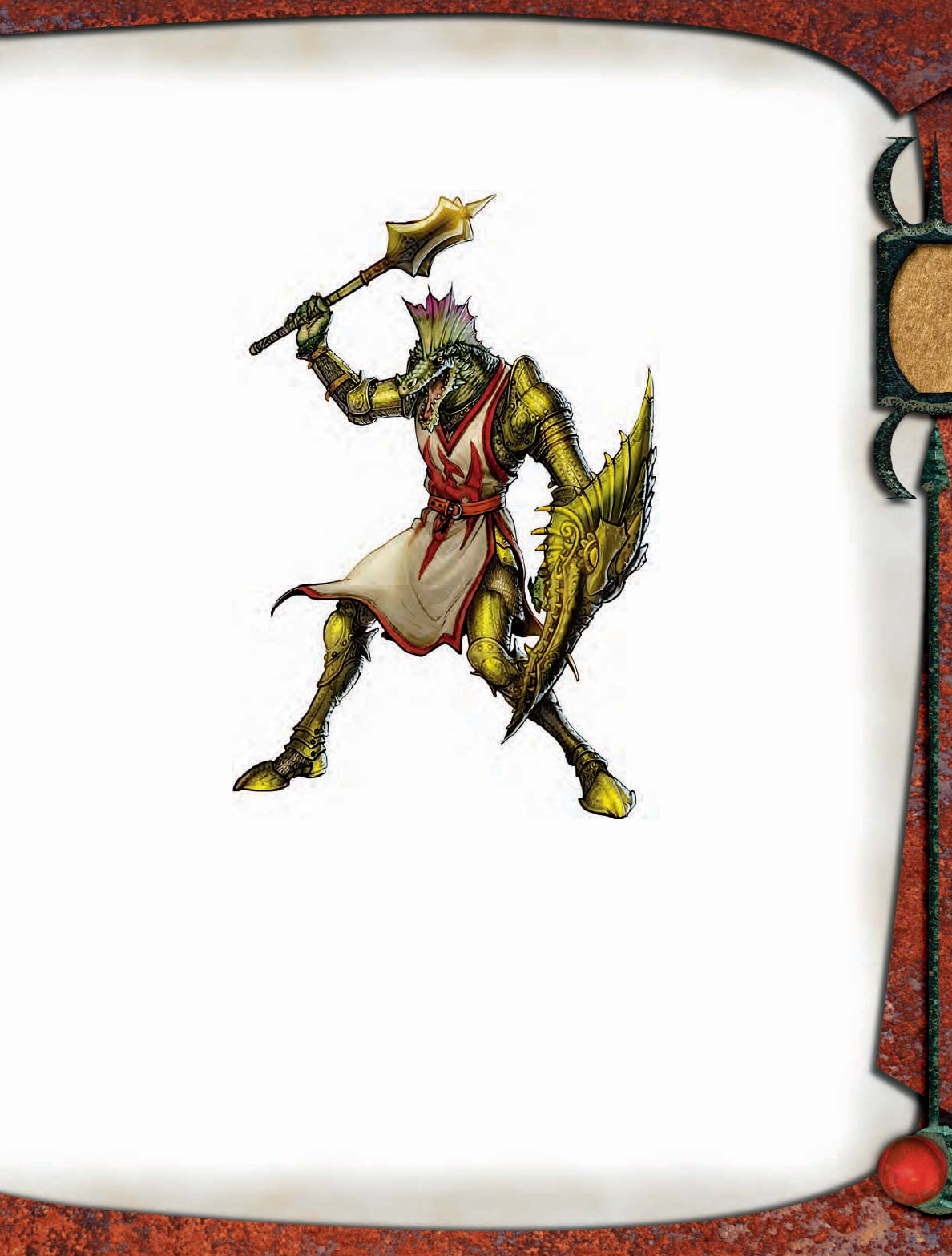
75
War Party (EL 7): A greenspawn zealot commands a
detachment of eight hobgoblin warriors (MM 193) and an
ogre (MM 199). The zealot cares little for the lives of its
underlings, and it is happy to sacrifi ce them as long as doing
so guarantees success in combat.
ECOLOGY
Unlike other spawn of Tiamat, greenspawn
zealots are intentionally created rather than
born by chance. Zealots gather eggs
from other dragonspawn, ritually
bathing them in a mixture of
Tiamat’s blood, the blood
of an ancient green drag-
on, and crushed emeralds
worth 200 gp. Such eggs
hatch greenspawn zealots.
Environment: Zealots can be
found in any area where Tiamat’s will must
be enforced. Their missions require them to defend
the faith of the dragonspawn across the world and even
on other planes.
Typical Physical Characteristics: A typical
greenspawn zealot is about 6 feet tall and
weighs a little over 200 pounds.
Males and females are the same
size, and only a practiced eye
can tell the two apart.
Alignment: Greenspawn
zealots are always lawful evil. Their
dedication to Tiamat is matched only
by their capacity for sadism and cru-
elty. Zealots rarely turn against
each other, instead showing
the utmost devotion to
the chain of command
of which they are a
part. They focus their
efforts on destroying Tiamat’s enemies, as well as on un-
covering and punishing lapses in faith among the members
of her legions.
SOCIETY
Greenspawn zealots are indoctrinated in the teachings
of Tiamat from a young age and shaped into fanatical
devotees to her cause. They are the commissars of Tiamat’s
legions—defenders of the faith responsible for ensuring a
proper level of dedication and enthusiasm among the troops.
Scores also serve as higher-level offi cers and warlords. Other
dragonspawn, particularly the chaotic blackspawn raiders
and redspawn arcanisses, frequently come to resent the
zealots’ power. However, few are willing to rise against these
chosen of Tiamat.
In some ways, greenspawn zealots are the most danger-
ous of Tiamat’s children. Though they lack the destructive
capability of bluespawn godslayers and the like, their place in
the hierarchy of power allows them to marshal and command
other dragonspawn against their enemies. Even a godslayer
could fall to superior numbers.
When Tiamat’s legions launch an invasion,
greenspawn zealots build small monasteries and
temples dedicated to her glory in the areas the
dragon spawn have secured. These monasteries serve
as command posts and refuges for the zealots. There,
they train in the arts of war, study Tiamat’s holy texts, and
commune with their goddess.
Great pools of swirling energy occupy the
lowest levels of such places. Greenspawn zeal-
ots use these to communicate
with Tiamat and her vas-
sals. One moment, fire
roils from these pools; the
next, they might freeze
solid, erupt with bolts
of electricity, or vent
plumes of acid. From the
pools, greenspawn zealots
receive orders, religious
edicts, and tidings from
across the planes, then go
forth to spread the word
and their religion.
The tunnels beneath these
monasteries also contain dungeons
that house captured opponents, mon-
sters bound for experiments or set to
be tamed as beasts of war, and renegade
dragonspawn awaiting execution. The
upper floors house shrines, living
quarters, and classrooms where
greenspawn zealots study mat-
ters of faith and practice their
combat skills.
TYPICAL TREASURE
Greenspawn zealots covet light, portable forms of wealth
such as gems and jewelry. They also actively seek out magic
items, hoping to deny them to the enemy even as such objects
are turned to Tiamat’s cause. They have standard treasure
for their Challenge Rating, and they equip themselves as
NPCs of their CR when they gain class levels.
GREENSPAWN ZEALOTS
WITH CLASS LEVELS
Greenspawn zealots are devoted to the faith of Tiamat, and
they usually become divine spellcasters. Their favored class
is favored soul from Complete Divine. If you do not use that
book, use cleric as the favored class. Both classes are associ-
ated for a greenspawn zealot.
Level Adjustment: +2.
Greenspawn zealot
GREENSPAWN
ZEALOT
Illus. by J. Zhang

76
GUULVORG
The mouth of this gigantic black wolf can’t contain the scythelike
fangs that emerge from the top and bottom. Bony protrusions
jut from its spine, skull, and ribs, running down its serpentine
tail, which ends in a bulb of bone. The creature’s eyes burn with a
malevolent red glow.
Guulvorg CR 13
Usually NE Huge magical beast
Init +4; Senses darkvision 120 ft., low-light vision, scent;
Listen +10, Spot +10
Languages Goblin, Worg
AC 26, touch 12, flat-footed 22
(–2 size, +4 Dex, +14 natural)
Immune cold
Resist fire 15
hp 175 (14 HD); boiling blood; DR 10/magic
Fort +16, Ref +13, Will +9
Speed 60 ft. (12 squares)
Melee bite +21 (2d6+9/19–20/×4 plus trip) and
tail +19 (4d8+13)
Space 15 ft.; Reach 10 ft. (15 ft. with tail)
Base Atk +14; Grp +31
Atk Options magic strike, quick tail
Abilities Str 28, Dex 18, Con 24, Int 6, Wis 16, Cha 12
SA boiling blood, quick tail, trip
Feats Alertness, Improved Critical (bite), Iron Will,
Multiattack, Track
Skills Jump +21, Listen +10, Spot +10, Survival +10
Advancement 15–17 HD (Huge); 18–25 HD (Gargantuan)
Boiling Blood (Ex) A guulvorg’s blood runs steaming hot. If
an opponent adjacent to a guulvorg damages the creature
with a melee weapon that deals piercing or slashing
damage, that foe takes 1d10 points of fire damage (Reflex
DC 24 half) from a spray of hot blood. The save DC is
Constitution-based.
Quick Tail (Ex) A guulvorg needs only a standard action
to make a bite attack and a tail attack. The tail deals
the indicated damage plus 1-1/2 times the guulvorg’s
Strength bonus despite it being a secondary attack.
Trip (Ex) A guulvorg that hits with a bite can attempt to
trip the opponent (+17 check modifier) as a free action
without making a touch attack or provoking attacks of
opportunity. If the attempt fails, the opponent cannot
react to trip the guulvorg.
Horrifying lupine monstrosities bred for war, guulvorgs are
the pride of the hobgoblin war machine. Their name means
“war worg” in Goblin.
STRATEGIES AND TACTICS
Guulvorgs are cunning, tracking their quarry, guessing at
their destination, and waylaying them along the path. They
charge into melee and then go to work with their vicious
jaws and powerful tail. Intelligent enough to take out one foe
before paying attention to another, guulvorgs are still easily
distracted by opponents that hurt them, focusing their ire
on such adversaries. These lupines are not fools, though, and
they retreat if they are losing a fi ght. They then bide their
time to make a decisive blow when their opponents are at
a disadvantage.
SAMPLE ENCOUNTER
Guulvorgs are so large and gluttonous that they don’t con-
gregate in groups larger than a mated pair in the wild. They
are most numerous in goblinoid lands, where domesticated
guulvorgs might be found in larger groups. Enough guulvorgs
exist, however, that a few menace civilized realms. Regions
plagued by these terrifying monstrosities offer a hefty bounty
for the destruction of one.
Coils and Fangs (EL 14): While journeying through
a dreary forest of enormous ancient trees, the characters
discern the sounds of a tremendous fray nearby. Closing,
they spot a guulvorg and a purple worm (MM 211) locked
in furious battle, uprooting the trees about them in their
chaotic struggle. Starving due to a lava vent that wiped
out its supply of underground prey, the purple worm
attacked the guulvorg out of desperate hunger. As soon
as it senses the PCs, the purple worm turns to them as
easier prey. The guulvorg retreats into the woods, lurking
casually nearby and waiting to finish off survivors of the
purple worm’s attack. If the guulvorg is pulled into the
battle before the purple worm dies, this encounter has
an EL of 15.
ECOLOGY
No doubt the work of a goblinoid transmuter with too much
time on his hands and too little sanity in his head, guulvorgs
are not natural creatures. The fi rst guulvorgs appeared only
recently in goblinoid realms. Despite their magical origin,
these massive lupines bred true, and a few have escaped into
the wild.
pqqqqqqqqqrs
GUULVORG LORE
Characters who have ranks in Knowledge (nature) can learn
more about guulvorgs. When a character makes a successful
skill check, the following lore is revealed, including the infor-
mation from lower DCs.
Knowledge (Nature)
DC Result
23 Guulvorgs are magical beasts that are related to
and as smart as worgs. These creatures are among
the largest wolfl ike monsters in existence. Their
fangs are oversized even for their huge mouths.
28 A guulvorg’s tail ends in a huge bulb of hardened
bone, and the beast can use this tail extremely
quickly in battle.
33 Protecting it from fi re and making it immune to
cold, a guulvorg’s blood runs boiling hot. If the
creature is wounded, which is hard to do without
magic weapons, its blood scalds its attacker.
pqqqqqqqqqrs
GUULVORG
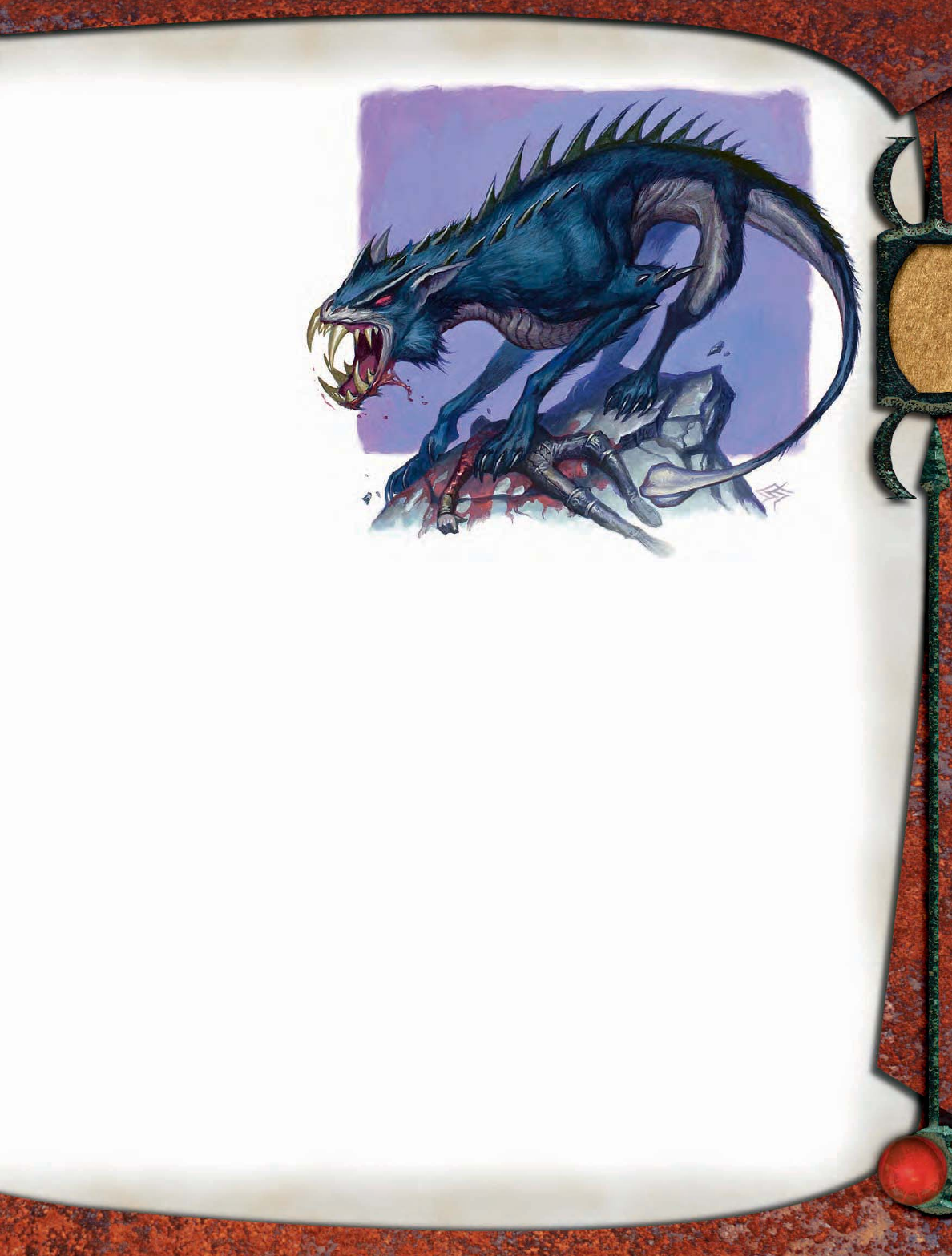
77
Like worgs, guulvorgs are baleful wolf-
like creatures with cunning minds and
malicious dispositions. A guulvorg has an
incredibly high metabolism, its body giving
off a great amount of heat and requiring an
enormous quantity of food. A wild guulvorg
is always on the hunt, and it eats every part
of its kill.
Fortunately for good-hearted folk,
guulvorgs reproduce slowly and age
quickly. In the wild, numerous
adult guulvorgs starve in the pro-
cess of breeding and caring for
their single pup. A newborn pup
is the size of a normal worg, but its
voracious eating allows it to grow
quickly, reaching adult size within six
months. A guulvorg continues to grow
during its life, the oldest reaching Gargan-
tuan size. But few live that long, dying before
they reach fi fteen years of age. None live to
see their early twenties.
Environment: Guulvorgs prefer old tem-
perate forests where towering trees mask
their enormity. Within their forest homes, they
create a complex system of trails that makes it hard to track
them despite their size. The tracks on the trails are convo-
luted and run over many times by the same creature. Those
tracking a guulvorg in its home territory get no bonus due
to the creature’s size.
Typical Physical Characteristics: One of the largest
lupine creatures in existence, the average guulvorg out-
classes even the most tremendous dire wolves. They are
usually 15 to 20 feet long. Reports of older males reaching
40 feet in length and standing 20 feet at the shoulder have
been confirmed.
Guulvorgs look like outsized worgs. They have gray or
black pelts and lupine features. Their unnatural attributes
begin with the spurs of bone that jut from the creature’s
pelt and continue with the monster’s glowing red eyes.
The guulvorg’s aberrant features continue with its enor-
mous fangs, which resemble scythe blades. These teeth
are too large for the guulvorg’s maw and jut outward along
the gums and snout.
Another oddity is the guulvorg’s tail. Long and sinewy, it
ends in a bulb of bone. It has a complex nervous system and
musculature, allowing the guulvorg to wield it with remark-
able speed and power.
Alignment: Though possessed of impressive physical
might and considerable intelligence for a beast, guulvorgs
are still animalistic. Guulvorgs torment their prey before
the kill, and they have no mercy or empathy in them. They
are usually neutral evil.
SOCIETY
Created by goblinoids, guulvorgs are still tied to that human-
oid subtype. Hobgoblins maintain guulvorgs as cruel siege
beasts that can clean the battlefield of its dead and keep
moving. Even the richest goblinoid kings can afford to main-
tain only a few guulvorgs in peacetime. A few simply allow
loyal guulvorgs to hunt and return home at their leisure.
Guulvorgs are highly territorial, and they obsessively
defend their domains from one another and other encroach-
ers. They willingly share territory with a single mate and
worgs, treating these lesser lupine monstrosities as pups to
be protected. A goblinoid settlement in which a domesticated
guulvorg lives is also that guulvorg’s territory, so the guulvorg
defends the community fi ercely.
Guulvorgs mate for life. Only if a guulvorg’s mate dies
does that guulvorg seek another. Although guulvorgs are
nasty toward most other creatures, they are doting and self-
sacrifi cing parents. Young guulvorgs are vicious by nature,
and they learn further brutality by watching their parents.
TYPICAL TREASURE
Guulvorgs have little use for treasure, but their lairs are
littered with the goods carried by their victims. They have
10% of the coins, 50% of the goods, and 50% of the items that
would be standard treasure for their Challenge Rating. A
guulvorg’s master is likely to have more treasure than usual,
since the guulvorg makes the master more able to kill and
collect valuables from the fallen.
Guulvorg
GUULVORG
Illus. by S. Prescott
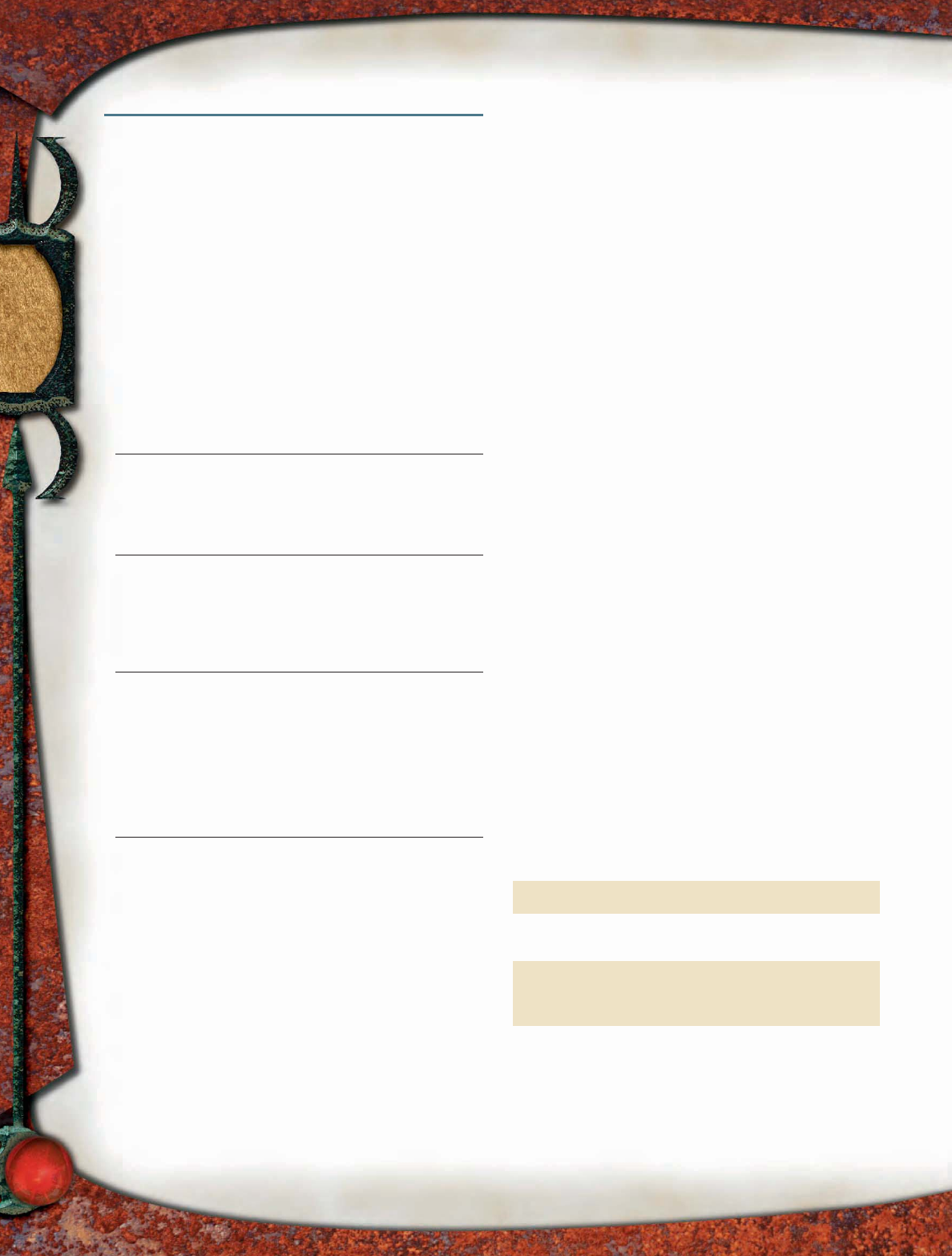
78
HAUNT
Haunts are spirits that left unfi nished business in life and
have returned to seek recompense. Victims of injustice,
haunts have no qualms about causing others to suffer as
they did. A haunt can’t be permanently defeated by normal
means, instead, someone must right the wrongs that led to
its grim state.
BRIDGE HAUNT
An old man leans against the railing of the bridge ahead, whittling
a piece of wood into the shape of a fi sh. He looks up from his work
to see you and smiles as he pockets both his knife and the piece of
woodwork. He begins to speak in a genial tone.
Bridge Haunt CR 7
Usually NE Medium undead (incorporeal)
Init +7; Senses darkvision 60 ft.; Listen +13, Spot +8
Aura unnatural (30 ft.)
Languages Common
AC 17, touch 17, flat-footed 14
(+3 Dex, +4 deflection)
Miss Chance 50% (incorporeal)
hp 90 (12 HD); rejuvenation
Immune incorporeal immunities, undead immunities
Fort +4, Ref +9, Will +9
Speed 30 ft. (6 squares), fly 30 ft. (perfect)
Melee 2 incorporeal touches +10 each (3d6 plus push)
Space 5 ft.; Reach 5 ft.
Base Atk +6; Grp —
Spell-Like Abilities (CL 12th):
3/day—mass suggestion (DC 20)
1/day — mirage arcana (DC 19)
Abilities Str —, Dex 16, Con —, Int 10, Wis 13, Cha 19
SA push, spell-like abilities, unnatural aura
SQ bridge dependent, incorporeal traits, living visage,
undead traits
Feats Alertness, Improved Initiative, Improved Toughness,
Lightning Reflexes, Weapon Focus (incorporeal touch)
Skills Bluff +14, Diplomacy +13, Disguise +4 (+6 acting),
Hide +13, Intimidate +16, Listen +13, Sense Motive +11,
Spot +8
Advancement 13–18 HD (Medium); 19–24 HD (Large)
Unnatural Aura (Su) Animals, whether wild or domesticated,
can sense the unnatural presence of a bridge haunt at
a distance of 30 feet. They will not willingly approach
nearer than that and panic if forced to do so; they remain
panicked as long as they are within range.
Rejuvenation (Su) A bridge haunt cannot be permanently
destroyed through combat. The “destroyed” spirit
restores itself and returns to the bridge it haunts in
1d4 days. Taking a haunt more than 1,000 feet from its
bridge can destroy it, as can destroying a haunt’s bridge.
A bridge haunt is laid to rest by taking a piece of the
corporeal remains of its former body, or a possession
important to it in life, and delivering that item to the
place where the creature that became the haunt was
headed before its demise.
Push (Su) A creature damaged by a bridge haunt’s
incorporeal touch attack must succeed on a DC 20
Will save or be telekinetically pushed 10 feet away from
the creature. If a bridge haunt makes a full attack, it
can attack a single creature with both touch attacks,
resolving the push after it is determined if both attacks
deal damage. If both attacks deal damage, the creature
must succeed on a DC 22 Will save or be pushed 20 feet
away. Movement from a push does not provoke attacks of
opportunity.
Bridge Dependent (Ex) Each bridge haunt is mystically
bound to a single bridge and cannot stray more than
1,000 feet from it. If somehow forced to do so, a bridge
haunt is instantly destroyed.
Living Visage (Ex) A bridge haunt seems to be corporeal and
alive until it flies or attacks, when it becomes partially
transparent and appears as the rotting corpse of the
person it was in life.
A bridge haunt is a ghostly undead that lingers near the
bridge where it came into being after the death of the
living creature it once was. Embittered and vengeful,
bridge haunts come in many forms, but all have the same
irrational and murderous intent: They seek to lure others
to their deaths.
Strategies and Tactics
Bridge haunts lure their victims into vulnerable positions
in numerous ways. A haunt can use mirage arcana either to
make its bridge look more or less stable than it truly is, or
to make the terrain below appear more or less dangerous.
A bridge haunt uses mass suggestion only if it must, since
it prefers unwitting victims. It can use the spell to cause a
whole group to stumble into danger or to prevent the remain-
der of the group from coming to a single member’s aid. In
combat, a bridge haunt attacks with its incorporeal touch
pqqqqqqqqqrs
BRIDGE HAUNT LORE
Characters who have ranks in Knowledge (religion) can learn
more about bridge haunts. When a character makes a suc-
cessful skill check, the following lore is revealed, including
the information from lower DCs. If the bridge haunt has not
yet revealed that it is not alive and not corporeal, increase all
DCs by 10.
Knowledge (Religion)
DC Result
17 This is a bridge haunt, the incorporeal spirit of
someone who died at this bridge.
22 In combat, a bridge haunt can push its opponents
off the bridge. Its incorporeal touch also disrupts
fl esh.
27 Masters of deception through magical trickery,
bridge haunts can change the appearance of their
bridge or nearby terrain. They can make their
words seem true to all who hear them.
32 A bridge haunt can be destroyed only if it is
moved more than 1,000 feet from its bridge, if
its bridge is destroyed, or if a piece of its former
body is delivered to the location to which it was
traveling when it died. Otherwise, it returns in a
few days.
pqqqqqqqqqrs
HAUNT
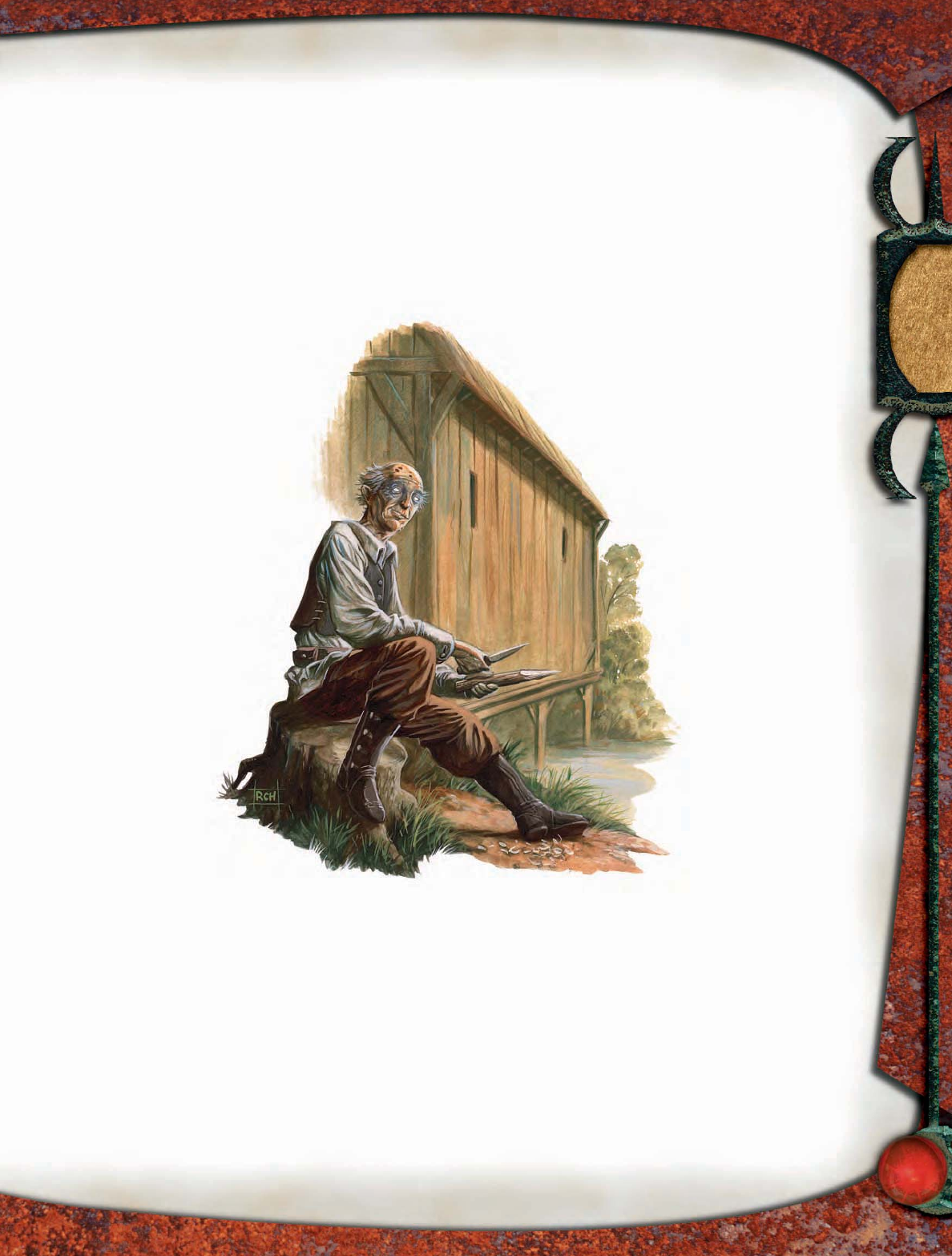
79
attacks, hoping to push foes off the bridge if doing so can
result in a deadly fall. It does the same to continually push
a foe deeper beneath the water near a bridge that crosses a
river or deep creek.
Sample Encounters
A bridge haunt seeks to cause deaths in the manner it was
killed and prevent others from reaching their destinations
across the bridge. Bridge haunts appear as they did in life,
so their shapes and the means by which they lure victims
vary greatly.
Because each bridge haunt is tied to a
bridge, and each has a different reason for
being there, fi nding more than one bridge
haunt at a location is extremely rare.
However, if two or more people were
emotionally bound to one another,
were traveling to the same place,
and died near a bridge in a simi-
lar manner, this can cause more
than one bridge haunt to linger at
a single bridge.
The Bride (EL 7): Lanara, an elf
maiden in a beautiful dress, sings
a mournful song as she walks
along the riverbank. When
someone hails her, she seems
startled and scared, and she
runs under a nearby bridge
to hide. Suddenly, a terrifi ed
scream comes from beneath
the bridge, then is cut off
by a strangling sound.
Elves or females of any
race who investigate
find Lanara wait-
ing to push them
beneath the water
to drown.
Lanara was murdered
on her wedding day by thugs
sent by her husband-to-be so he
could marry another. She can be perma-
nently destroyed only by fi nding her wedding ring in the
mud beneath the bridge and bringing it to her once-fi ancé,
or by bringing him to her.
The Wrestler (EL 7): Thaven Firehammer, a dwarf paladin
of Kord, challenges warriors who wish to cross his bridge
across a mountain chasm. He awaits victims at the middle
of the bridge and offers a friendly challenge to one person
in the group: a wrestling match. If he wins, they cannot
cross. If he loses, he offers his full plate armor and weapon
in addition to passage. He seems to lack a weapon, but he
says he left his axe on the other side of the bridge. Anyone
who takes his offer or tries to pass him suffers his wrath
as he tries to push that person off the bridge. Once he has
succeeded, Thaven moves inside the bridge until someone
else comes along.
To free Thaven and end his deadly game, the PCs must
fi nd his bones in the rocky vale below the bridge and bring
them to the temple of Kord in the mountains. Alternatively,
they can seek his magic axe, taken from him by the man who
pushed him off the bridge during what was supposed to be
a friendly challenge, and return it to the side of the bridge
where Thaven left it when he wrestled his foe.
The Fisher and the Serpent (EL 8): Cedrik, a young
human boy with a fi shing pole and fi sh basket, used to
come to the river to fi sh all the time. He would bal-
ance on the railing of the bridge to cross, rather
than walk the boards. One day he slipped, and
a giant constrictor snake (MM 280) living
under the bridge made short work of him.
When people approach the bridge, Ce-
drik uses mirage arcana to make the
railings look solid and the bridge
itself shoddy. Then he encourag-
es travelers to balance along
the railing—they can even
follow him across if they
like. When someone has
reached the center, Cedrik
pushes that person off
the bridge into the wait-
ing coils of the snake.
Cedrik can be per-
manently destroyed by
taking one of his fi sh-
hooks from inside
the snake’s belly and
bringing the hook to
the boy’s former home.
Ecology
Bridge haunts have lit-
tle effect on the nearby
ecology, but they do pos-
sess an ecology of sorts in
their choice of prey and the frequency of their attacks. Many
bridge haunts seem content to set upon anyone who wanders
their way, while others show a preference for certain types of
victims. Some bridge haunts linger near their bridges con-
tinually, while others rest inside the structure of the bridge,
emerging on certain nights or at particular times during the
day. Each bridge haunt has its own habits, so discovering its
patterns requires observation.
Environment: A bridge haunt can exist at a bridge in any
environment. Unless an appealing target is nearby, the haunt
doesn’t leave its bridge.
Bridge haunt
HAUNT
Illus. by R. Horsley
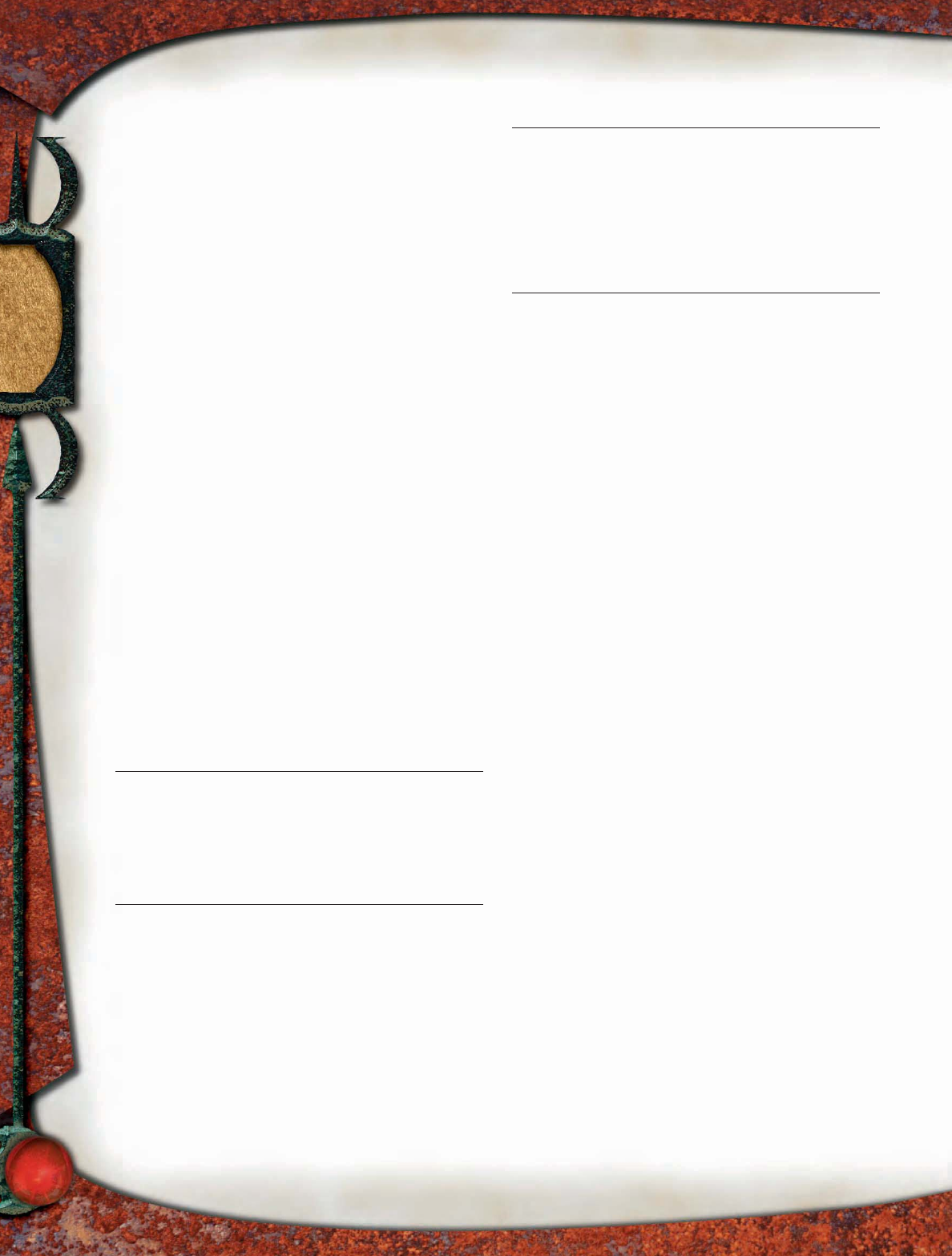
80
Typical Physical Characteristics: Bridge haunts have
the height and appearance they possessed in life. Being
incorporeal, they are weightless.
Alignment: Bridge haunts are usually neutral evil,
but some are chaotic or lawful if they possessed strong
tendencies toward one or the other of those alignments
in life. Good bridge haunts are unheard of, but neutral
haunts do exist.
Neutral bridge haunts attempt to keep people away
from their bridges, scaring them away or warning them
off. To those who show sympathy, such haunts relate how
they can be freed to go to their eternal rest. Still, even a
neutral bridge haunt is compelled to kill those who try
to cross its bridge.
Typical Treasure
Bridge haunts cannot manipulate treasure, nor do they typi-
cally show any desire to possess it. Nevertheless, a bridge
haunt’s victims often bore items that become lost beneath the
bridge, awaiting discovery by any brave enough to confront
the structure’s undead inhabitant. The items beneath the
bridge are equivalent to standard treasure for a creature of
the bridge haunt’s Challenge Rating.
FOREST HAUNT
A shimmering form emerges from the woods, looking like a dead
tree with purplish-green veins of sap winding across its surface.
It crashes its way forward as if moving large obstacles from its
path, but it glides through all such impediments as if they were
mere illusions.
Forest Haunt CR 10
Usually NE Huge undead (incorporeal)
Init +0; Senses darkvision 60 ft., low-light vision; Listen +18,
Spot +18
Languages Common, Sylvan, Treant
AC 11, touch 11, flat-footed 11
(–2 size, +3 deflection)
Miss Chance 50% (incorporeal)
hp 78 (12 HD); DR 10/slashing; rejuvenation
Immune incorporeal immunities, undead immunities
Resist +2 turn resistance
Fort +4, Ref +4, Will +13
Weakness vulnerability to fire
Speed fly 30 ft. (perfect) (6 squares)
Melee incorporeal touch +5 (1d4 Cha)
Space 15 ft.; Reach 15 ft.
Base Atk +6; Grp —
Special Actions arboreal vengeance, Daunting Presence
(DC 19)
Abilities Str —, Dex 10, Con —, Int 12, Wis 16, Cha 16
SA arboreal vengeance
SQ incorporeal traits, undead traits
Feats Ability Focus (arboreal vengeance), Daunting
Presence*, Iron Will, Track, Weapon Focus (incorporeal
touch)
* New feat; see sidebar.
Skills Hide +7, Listen +18, Move Silently +15, Spot +18,
Survival +18
Advancement 13–30 HD (Huge)
Arboreal Vengeance (Su) A forest haunt can temporarily
animate trees and undergrowth around it. When it
activates this ability, each tree within 60 feet makes
a melee attack against the nearest enemy. Trees have
a reach of 20 feet. Each attack is made with a +9
bonus and deals 2d6+4 points of damage. In addition,
undergrowth within 60 feet begins to writhe and grasp
at creatures in the area. Any creature attempting to
move out of a space containing undergrowth must
succeed on a DC 21 Reflex save or be entangled for
1 round. The attack bonus, damage bonus, and save
DC are Charisma-based.
Rejuvenation A forest haunt is not destroyed if reduced to 0
hit points. It instead reappears in its grove 1d4 days later.
Each forest haunt has a specific condition that must be
fulfilled to lay it to rest.
Forest haunts are the spirits of fey-touched trees that seek
vengeance on intruders within their forest domain. When
a dryad is killed, she can curse those who slew her with her
dying breath. This curse fuels the spirit of the oak to which
she is tied, causing it to stalk the forest until her killers are
slain, and sometimes beyond.
Strategies and Tactics
A forest haunt silently approaches enemies, staying within
the cover of trees to avoid being noticed. Even if it is
seen, it is typically mistaken for a trick of the light or a
play of shadow in the forest. Once it is in range, it uses
arboreal vengeance to batter foes that stand near trees.
If an opponent spots the forest haunt, the haunt tries
to intimidate that foe with Daunting Presence, while
staying close to other trees so that opponents must come
into range of the trees’ attacks if they wish to fight the
haunt directly. It uses its touch attack only if it is severely
damaged. Since it knows it can rejuvenate, a forest haunt
fights until destroyed.
HAUNT
pqqqqqqqqqqqqqqqqqqqqrs
NEW FEAT: DAUNTING PRESENCE
You are skilled at inducing fear in your opponents.
Prerequisites: Cha 13, base attack bonus +1.
Benefit: You can take a standard action to awe an oppo-
nent. The opponent must be within 30 feet, have line of sight
to you, and have an Intelligence score. If the opponent fails a
Will saving throw (DC 10 + 1/2 your character level + your Cha
modifier), it is shaken for 10 minutes. This feat has no effect
on a creature that is already shaken.
Special: A fighter can select Daunting Presence as one of his
fighter bonus feats.
pqqqqqqqqqqqqqqqqqqqqrs
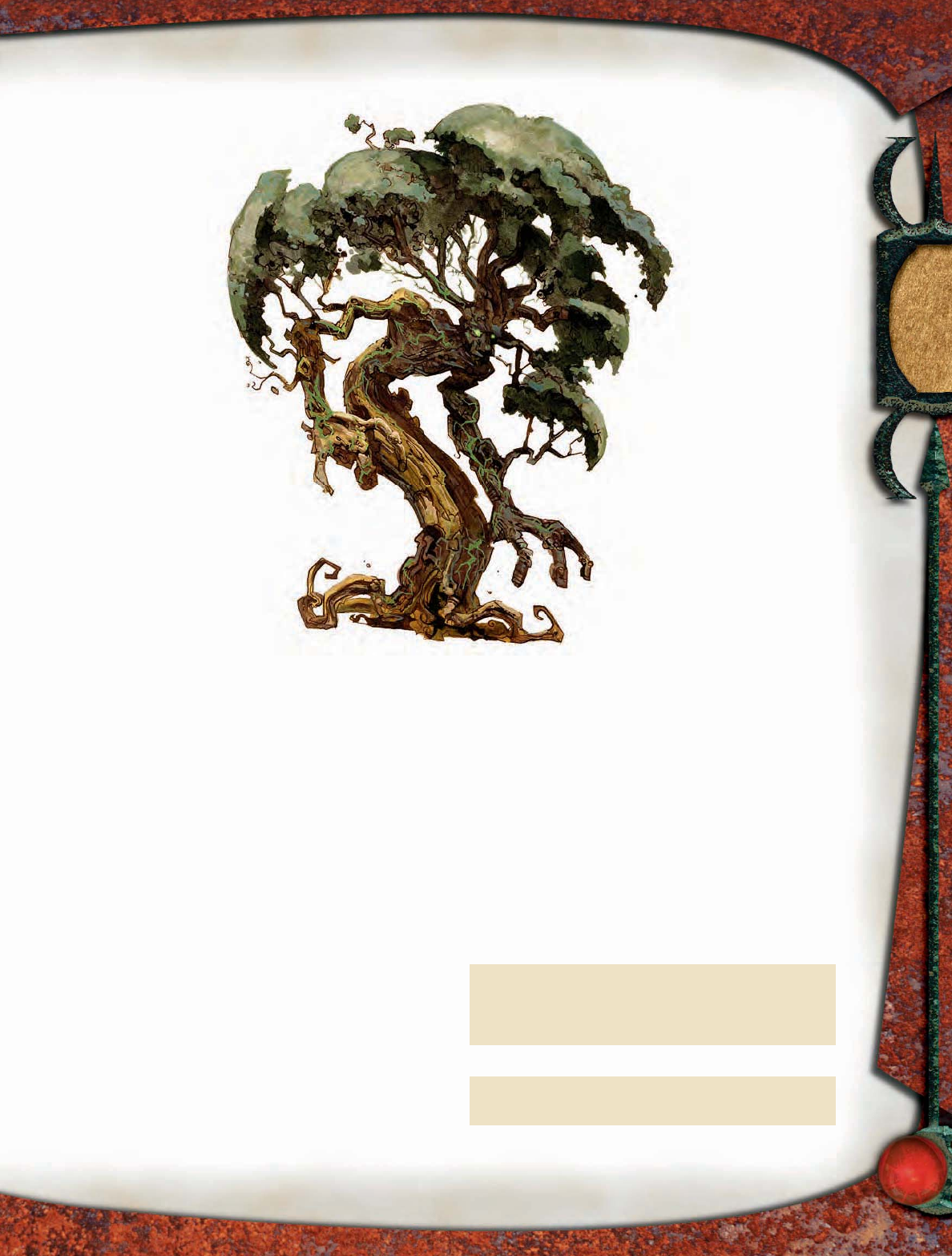
81
Sample Encounters
A forest haunt waits for opponents to ven-
ture into the forest before it unleashes its
vengeance. Only rarely does
more than one of these
creatures appear in a
given area, and groups
larger than four are
unheard of.
Orc Murderers
(EL 10): A group of
trappers has been
missing for several
days, and the trail leads
into a dark, forbidding
part of a nearby wood. A
forest haunt rampages in the
deepest part of the wood, where
trees are thick and the ground is
covered in underbrush.
The dryad that once lived in the
wood was killed by a group of orc
marauders, and the orc shaman now
uses her bones for fortune-telling.
The marauders consist of six orc
berserkers (MM4 114) and a 4th-
level orc druid. This encounter is
EL 10, but PCs can also attempt
to negotiate for the dryad’s bones
or steal them.
Only by retrieving the bones and return-
ing them to the dryad’s grove can the PCs put the forest haunt
to rest. Of course, they have to deal with an irate forest haunt
on the way to the grove.
Ecology
Forest haunts are subject to outbursts of rage as they try
to cope with the loss of their dryad companions. Thus,
although a forest haunt coexists with natural flora, it
tends to drive away or accidentally kill most wildlife. A
recently awakened forest haunt causes a steady migration
away from its grove, a clear indication that something is
wrong. The area roamed by a forest haunt might eventu-
ally begin to change. As the unnatural aura of the haunt
bleeds into the surrounding terrain, it turns the foliage a
dark—almost black—green and causes trees to warp into
unsettling shapes.
A forest haunt can be destroyed only by meeting a par-
ticular condition. This condition can range from returning
the body of its dryad to her grove, to defeating an evil power
at work in the forest, to destroying the tree from which the
forest haunt sprang.
Environment: Forest haunts are found exclusively in
forests. A forest haunt roams throughout the forest as though
on patrol, but returns to its dryad’s grove at least once every
day. Some roam during the night and some
during the daytime. Chaotic forest
haunts vary this pattern, but neutral
haunts are more predictable.
Typical Physical Char-
acteristics: A forest haunt
appears to be a deformed,
translucent tree, with a
trunk nearly 5 feet wide
and a span of branches
greater than 20 feet. It
has veins of violet sap
running along its trunk.
Alignment: A forest
haunt is interested in noth-
ing but the destruction of the
living, and most are difficult to
reason with. Forest haunts are
usually neutral evil or chaotic
evil, though some are neutral (es-
pecially those whose dryads were
especially sympathetic toward hu-
mans and other civilized intruders).
Non-evil forest haunts are likely to
try to scare off invaders instead of
killing them outright.
Typical Treasure
Though a forest haunt doesn’t care for
wealth, the area it roams might be littered
with the gear of those who did not escape
its wrath. Such treasure is usually the arms, armor, or other
equipment associated with would-be heroes. The scattered
treasure can also serve as a warning to any who would enter
the forest haunt’s domain. Such items add up to standard
treasure for the forest haunt’s Challenge Rating.
pqqqqqqqqqrs
FOREST HAUNT LORE
Characters who have ranks in Knowledge (nature) can learn
more about forest haunts. When a character makes a suc-
cessful skill check, the following lore is revealed, including
the information from lower DCs.
Knowledge (Religion)
DC Result
20 This is a forest haunt, the spirit of a tree touched
by the fey. When a dryad is destroyed and speaks a
curse with her dying breath, a forest haunt is born.
It is incorporeal, but nonetheless it can be harmed
more easily by slashing weapons.
25 A forest haunt can animate nearby trees to attack
its enemies.
30 A forest haunt can be destroyed only if a specifi c
condition is met. Otherwise, it returns to existence
in a few days.
pqqqqqqqqqrs
Forest haunt
HAUNT
Illus. by C. Critchlow
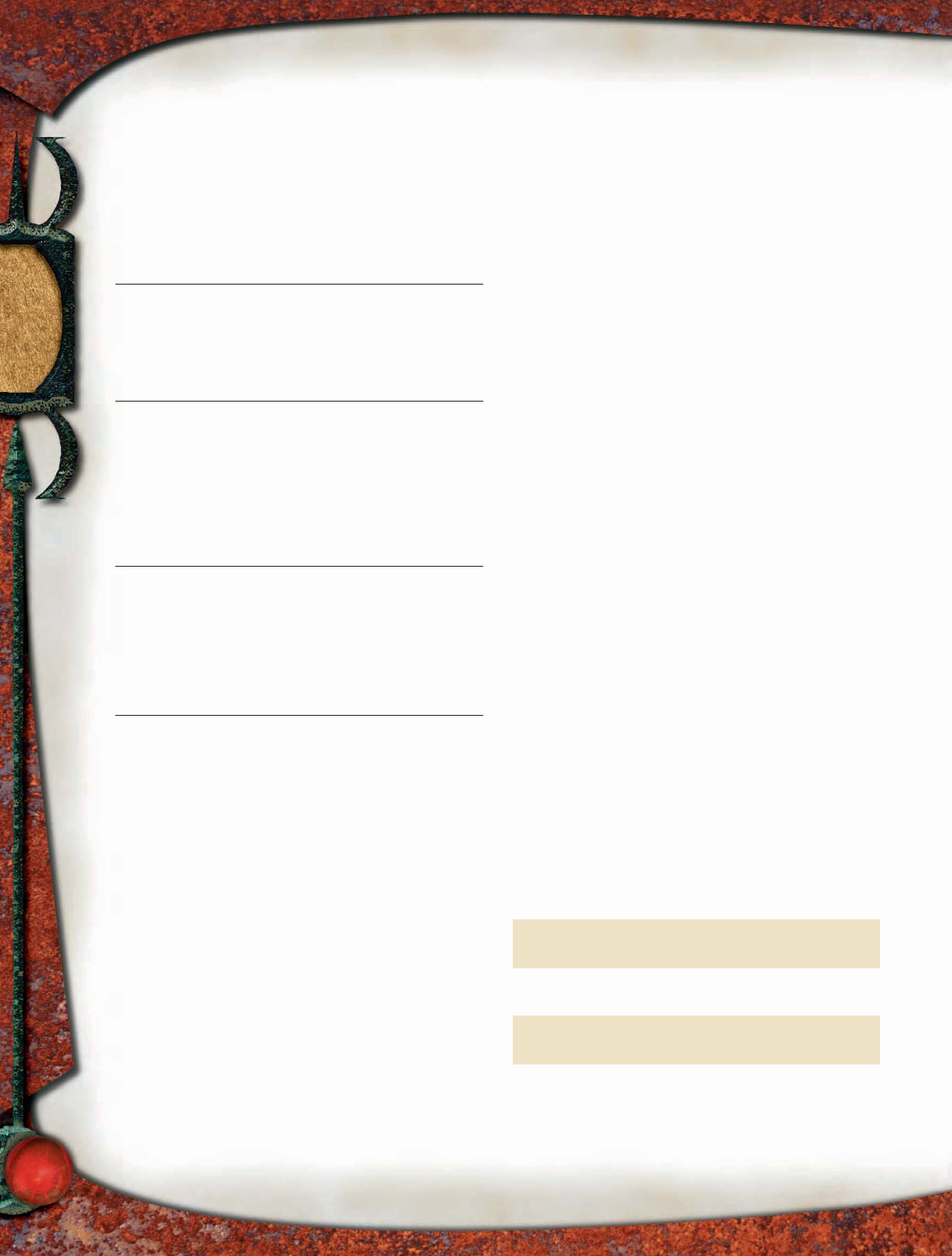
82
TAUNTING HAUNT
The spectral image of a short, rotund human wearing a tattered
jester’s outfi t appears before you. It bursts into laughter and points
at you. Its laughter grows so violent that it falls to the fl oor, still
laughing and pointing.
Taunting Haunt CR 4
Usually CN Medium undead (incorporeal)
Init +6; Senses darkvision 60 ft.; Listen +5, Spot +4
Languages Common
AC 14, touch 14, flat-footed 12
(+2 Dex, +2 deflection)
Miss Chance 50% (incorporeal)
hp 39 (6 HD); encore
Immune incorporeal immunities, undead immunities
Resist +2 turn resistance
Fort +2, Ref +4, Will +5
Speed fly 40 ft. (perfect)
Melee incorporeal touch +5 (1 Cha)
Space 5 ft.; Reach 5 ft.
Base Atk +3; Grp —
Special Actions tripping tongue, vicious lampoon
Spell-Like Abilities (CL 6th):
At will—daze (DC 12), ghost sound, summon instrument
3/day—grease (DC 13), invisibility, Tasha’s hideous laughter
(DC 13)
1/day — fear (DC 16), glibness
Abilities Str —, Dex 14, Con —, Int 13, Wis 11, Cha 15
SA spell-like abilities, tripping tongue, vicious lampoon
SQ font of knowledge, incorporeal traits, undead traits
Feats Dodge, Improved Initiative, Skill Focus (Perform
[comedy])
Skills Bluff +11, Diplomacy +13, Disguise +2 (+4 acting),
Intimidate +13, Knowledge (all) +10, Listen +5, Perform
(comedy) +14, Spot +4
Advancement 7–12 HD (Medium)
Encore (Ex) Fueled by anger and bitterness, a taunting haunt
is difficult to send to its final rest. A taunting haunt that
is destroyed by any means returns to existence after 24
hours. These creatures can be driven away only when
defeated in a battle of wits or put to rest only when their
final wishes are met (see below).
Tripping Tongue (Su) A taunting haunt can force an
opponent to speak the opposite of an intended
statement. An entreaty for peace becomes a challenge
to battle. A friendly greeting becomes an insulting
threat. Three times per day, as an immediate action, a
taunting haunt can attempt to reverse an opponent’s
intended words. If that foe succeeds on a DC 15 Will
save, this ability has no effect. Anyone listening to
a creature affected by this ability can make a DC 15
Sense Motive check to notice that the affected
creature has been compelled to speak unintended
words. The save DC is Charisma-based. This is a
mind-affecting ability.
Vicious Lampoon (Su) When an opponent within 30 feet
misses with an attack, a taunting haunt can, as an
immediate action, deliver a short, scathing commentary
on that foe’s competence (or lack thereof). The subject
must succeed on a DC 15 Will save or take a –2 penalty
on attack rolls, ability checks, and skill checks for 1
round. The save DC is Charisma-based.
Font of Knowledge (Ex) A taunting haunt is considered to
be trained in all Knowledge skills and to have maximum
ranks in those skills.
A taunting haunt is the twisted, jealous spirit of a deceased
bard, jester, or other performer. Bitter and angry, and resent-
ful of the living, a taunting haunt uses its sharp wit, cruel
humor, and spiteful performances to create havoc and chaos
wherever it goes.
Taunting haunts pose a minimal physical threat, yet they
are dreaded by almost anyone unfortunate enough to encoun-
ter them. With their biting sense of humor and relentless
spirit, they can prove more diffi cult to handle than foes in a
stand-up fi ght.
Strategies and Tactics
A taunting haunt exists to spread misery, anger, and con-
fusion. In life, it used its talents to bring happiness and
amusement to others. In death, this desire has warped into
a compulsion to make others miserable. Taunting haunts
use a variety of schemes to humiliate the foolish, trusting,
or greedy.
A typical taunting haunt picks out an important fi gure for
continual harassment. The haunt introduces itself, insults
its mark, and uses its Perform (comedy) skill to poke fun.
It follows its target, offering running commentary on that
person’s ineptitude.
Not a murderous spirit, a taunting haunt takes care to avoid
killing anyone. After all, a corpse can’t wince at a barbed
comment or provide endless amusement as it tries to muddle
through negotiations while its words are being twisted.
A taunting haunt might even help particularly enjoyable
victims of its torments stay alive.
pqqqqqqqqqrs
TAUNTING HAUNT LORE
Characters who have ranks in Knowledge (religion) or who
have the bardic knowledge class feature can learn more about
taunting haunts. When a character makes a successful check,
the following lore is revealed, including the information from
lower DCs. A bard gains a +4 bonus on this check.
Knowledge (Religion) or Bardic Knowledge
DC Result
14 This is a taunting haunt, the bitter spirit of a
troubadour, jester, or bard. This result reveals all
undead traits and incorporeal traits.
19 When a taunting haunt decides to shadow a
victim, it can cause that person to speak the
opposite of what is intended.
24 Taunting haunts are expert liars. Never believe
what one says unless you defeat it in a battle of
wits.
29 A taunting haunt can be defeated only if it
loses a battle of wits or its fi nal wishes are met.
Otherwise, it returns within a day.
pqqqqqqqqqrs
HAUNT
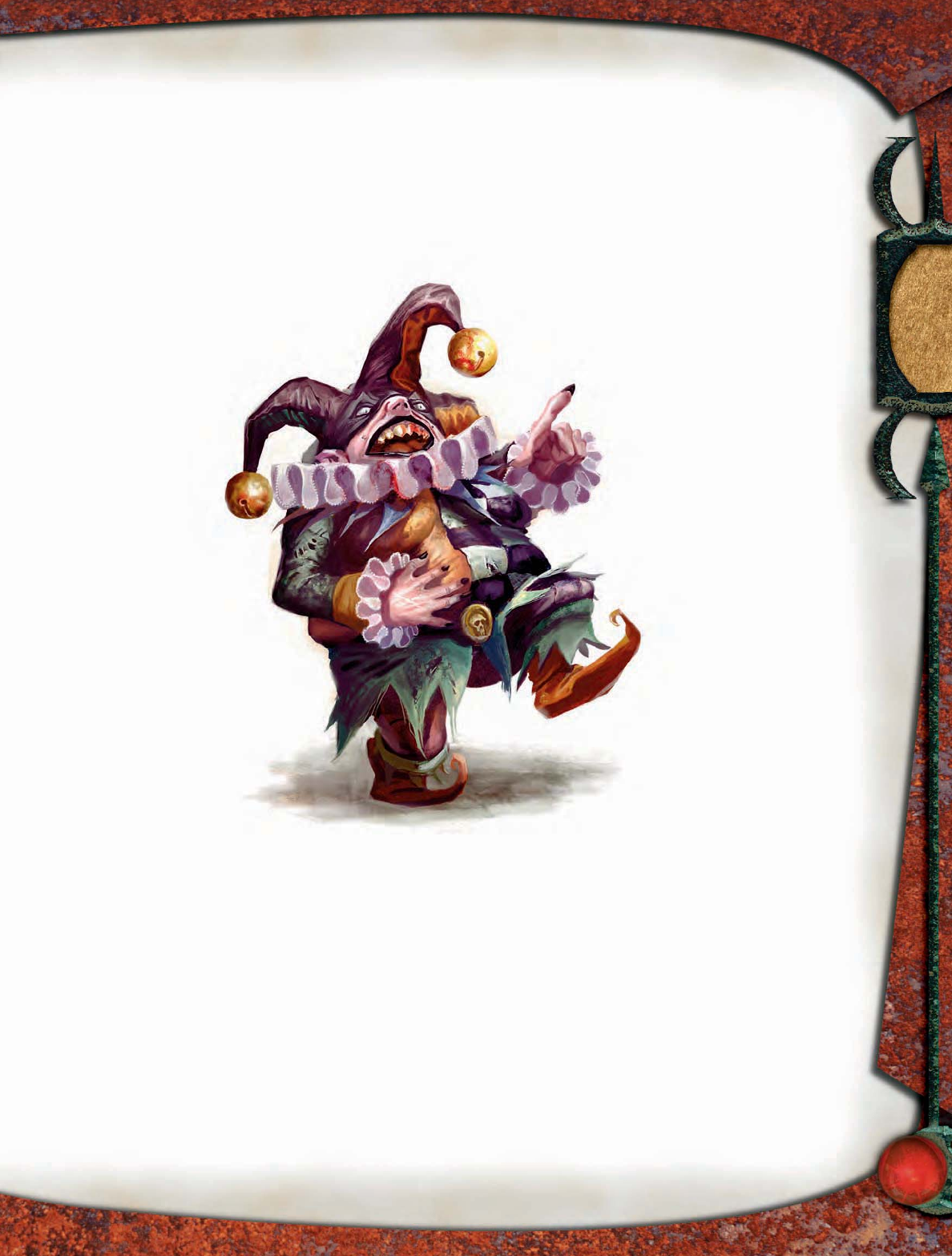
83
Taunting haunts are roleplaying challenges. They can
prove annoying, but they lack attacks or abilities to directly
kill. Their immortal nature and access to Knowledge
skills makes them useful sources of (perhaps unreliable)
information.
Each taunting haunt is an individual with a distinct—
often warped or crazy—personality. A haunt might take a
liking to a PC, egg on another one with taunts, and needle
another with endless pranks. In the hands of a skilled DM,
a haunt becomes a foil for the characters. With good
roleplaying and quick thinking, PCs can turn a
taunting haunt into a useful informant or even
an ally.
A taunting haunt can go to
its final rest if someone re-
solves whatever caused
it to become undead. A
wandering bard killed
by a cruel tyrant might
pass on if a party over-
throws the tyrant’s
descendants.
Sample Encounter
Taunting haunts do not
travel in groups. The only
time a taunting haunt is
seen with other creatures
is when it is being a nuisance
to them.
The Staff of the Sewers (EL
4): Bertrose Bignose was a jester who
was killed for making one joke too
many at the expense of a visiting
archmage. He uses his abili-
ties to make spellcasters
look foolish, particularly
in front of superiors or
allies. If possible, he uses
glibness to convince spellcasters
he is a friendly spirit who knows the location of a lost magic
staff. Invariably, this staff is supposedly hidden at the bottom
of a garbage dump or outhouse pit. More than one greedy
wizard has ended up knee deep in sewage before Bertrose
revealed his lie.
Ecology
Taunting haunts add nothing to the local ecosystem except
cruel humor, practical jokes, and humiliating schemes.
Environment: Taunting haunts can thrive anywhere,
but they prefer civilized areas. Those that used to live
in cities can usually fi nd easy targets there. They are
seldom found in the wilderness.
Typical Physical Characteristics: Taunting
haunts are humanoid in appearance.
They wear outrageous or ostentatious
clothes to draw attention to themselves.
Though the taunting haunt in this
entry is Medium, gnomes and oth-
er Small creatures can also become
taunting haunts.
Alignment: More mischie-
vous than malicious, most taunting
haunts can’t be considered evil. How-
ever, exceptions exist, and some
taunting haunts are even good-
aligned. They are, without
exception, chaotic.
Typical Treasure
A taunting haunt requires
anyone it defeats in a battle of
wits to bury all treasure wagered
on the outcome in an isolated spot.
These haunts have no use for
treasure, but since mortals love
gold and magic items, taunting
haunts do what they can to remove
such wealth from circulation.
Taunting haunt
HAUNT
pqqqqqqqqqqqqqqqqqqqqrs
A BATTLE OF WITS
The only way to defeat a taunting haunt is in a battle of wits.
Usually, a victim gets rid of a haunt when it grows bored and
moves on to a new audience. Adventurers who turn or de-
stroy the spirit win the honor of a repeat performance soon
thereafter.
A battle of wits with a taunting haunt involves riddles, jokes,
and other competitions. In game terms, the haunt and its op-
ponent take turns choosing Knowledge and Perform skills,
then make opposed checks involving the chosen skill. The first
person to win three checks wins the competition.
A haunt expects a magic item worth 500 gp from the PCs if
it wins. If the characters win, the haunt leads them to a hidden
treasure with a value appropriate to its CR and agrees to leave
them alone.
When resolving a battle of wits, you can replace the skill
checks with riddles and questions for an interesting roleplaying
encounter. Regardless of how you handle the battle, the PCs
should gain experience points for defeating a taunting haunt
whether they drive it off, send it against someone else, or oth-
erwise remove it as an annoyance.
pqqqqqqqqqqqqqqqqqqqqrs
Illus. by M. Coimbra
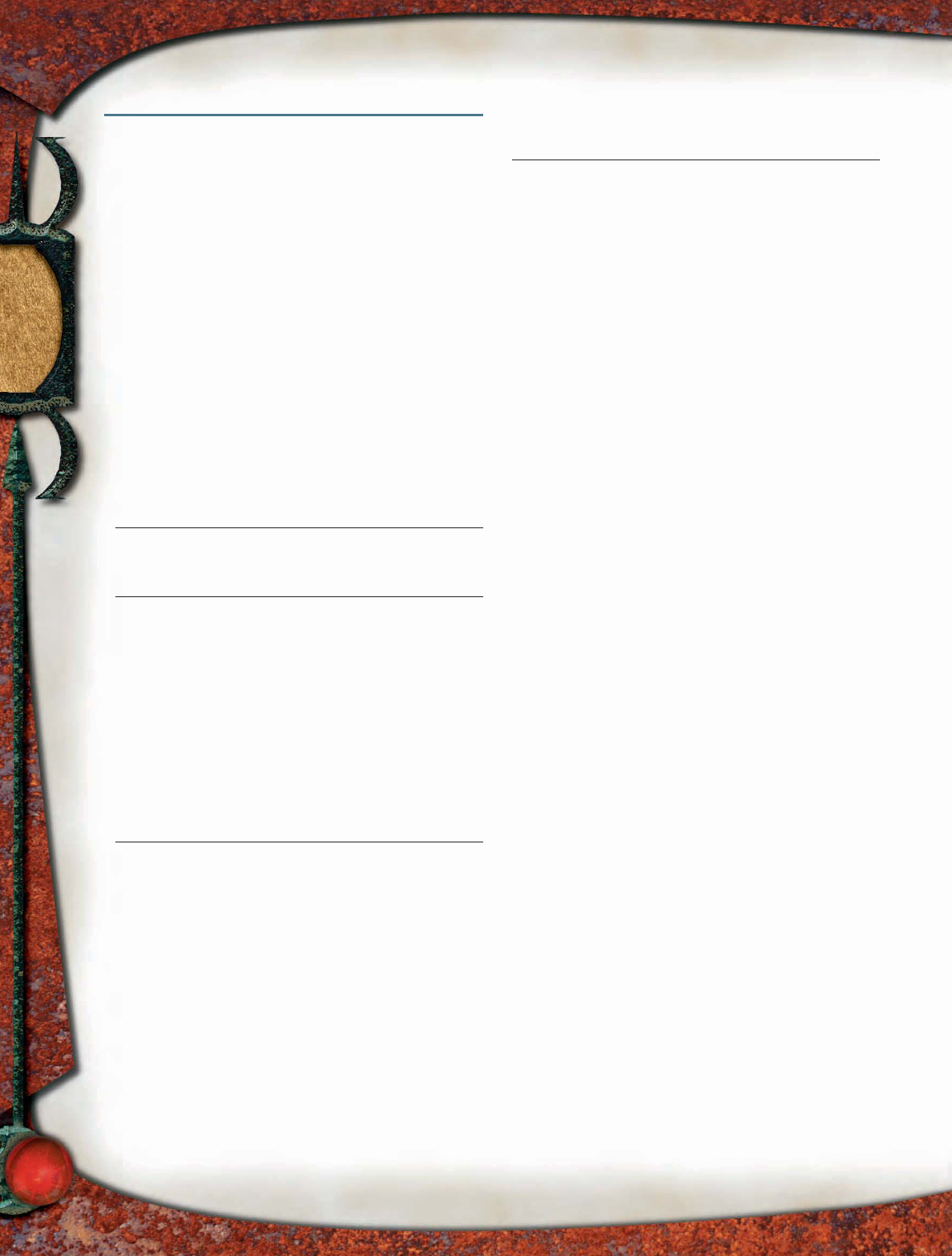
84
HOBGOBLIN
Hobgoblins are brutal and disciplined evil humanoids
that form highly organized, conquest-driven kingdoms.
They also willingly serve as mercenaries for other evil
creatures.
This section presents four sample members of hobgoblin
society and expands on the social order of these creatures.
Hobgoblins are so ruthless in their training that the
process alters their bodies. The results are nothing short
of monstrous.
Hobgoblin traits are summarized on page 154 of the
Monster Manual.
HOBGOBLIN DUSKBLADE
A hobgoblin clad in a chain shirt marches toward you. He holds his
longsword out threateningly, and his shield is covered in runes.
Hobgoblin Duskblade CR 3
Male hobgoblin duskblade* 3
* Class described in PH2
LE Medium humanoid (goblinoid)
Init +2; Senses darkvision 60 ft.; Listen +0, Spot +0
Languages Common, Draconic, Goblin
AC 19, touch 12, flat-footed 17
(+2 Dex, +5 armor, +2 shield)
hp 26 (3 HD)
Fort +6, Ref +3, Will +3
Speed 30 ft. (6 squares)
Melee mwk longsword +7 (1d8+2)
Ranged longbow +5 (1d8)
Base Atk +3; Grp +5
Atk Options arcane channeling
Duskblade Spells Known (CL 3rd):
1st (5/day)—burning hands (DC 12), ray of enfeeblement
(+5 ranged touch), shocking grasp (+5 melee touch),
swift expeditious retreat (swift action, duration 1 round)
0 (5/day)—acid splash (+5 ranged touch), ray of frost
(+5 ranged touch), touch of fatigue (+5 melee touch,
DC 11)
Spell-Like Abilities (CL 3rd):
Combined total of 4/day—dancing lights, detect magic,
fl are (DC 11), ghost sound (DC 11), read magic
Abilities Str 15, Dex 14, Con 16, Int 13, Wis 10, Cha 8
SQ armored mage
Feats Battle Magic Tactics*, Combat CastingB, Weapon
Focus (longsword)
* New feat; see sidebar.
Skills Concentration +9, Listen +0, Move Silently +5, Ride +8,
Spellcraft +7, Spot +0
Possessions +1 chain shirt, +1 light steel shield, masterwork
longsword, longbow with 20 arrows
Arcane Channeling (Su) A hobgoblin duskblade can cast
and deliver any touch spell he knows with a melee
attack. The spell must have a casting time of 1 standard
action or less. Casting a spell in this manner does not
provoke attacks of opportunity. If he hits, the hobgoblin
duskblade deals normal weapon damage, then resolves
the spell’s effect on the struck creature.
Armored Mage (Ex) A hobgoblin duskblade does not have an
arcane spell failure chance when wearing light armor and
carrying a light shield.
Hobgoblin duskblades are skilled warriors who learn to
combine armed fighting and spellcasting. Ages ago, a
mighty hobgoblin wizard named Tartak Firehand stole
such techniques from his elf enemies. Now a large number
of hobgoblin tribes use duskblades to support wizards and
sorcerers in battle.
The duskblade presented here had the following ability
scores before racial ability score adjustments: Str 15, Dex 12,
Con 14, Int 13, Wis 10, Cha 8.
Strategies and Tactics
Before engaging, hobgoblin duskblades use ray of enfeeble-
ment to soften up the enemy. They then enter melee
and use arcane channeling to imbue their attacks with
shocking grasp, acid splash, or ray of frost. Burning hands is
reserved for tight situations when one hobgoblin dusk-
blade endangers few or none of his comrades by casting
the 15-foot cone.
If they’re weakening an enemy for subsequent magical
attack by other arcane casters, hobgoblin duskblades or the
spellcasters they support delay or ready their actions in melee
so that they act on consecutive initiative counts, preventing
the enemy from taking action to foil their combined attacks.
Hobgoblin duskblades use touch of fatigue and Battle Magic
Tactics with their melee attacks. They then cast swift expedi-
tious retreat to retreat beyond the blast radius of area spells
cast by more powerful spellcasters.
HOBGOBLIN
pqqqqqqqqqqqqqqqqqqqqrs
NEW FEAT:
BATTLE MAGIC TACTICS
Through intense training and impeccable timing, you and your
allies learn to augment each other’s magical attacks when you
focus your efforts on a single target.
Prerequisites: Spellcraft 6 ranks, arcane caster level 3rd.
Benefit: Each time you cast a spell that requires the target to
make a saving throw, that target gains a Battle Magic Tactics
token after the spell resolves. A creature gains a token
whether the save succeeds or fails, but a creature that avoids
a spell through spell resistance does not gain a token. Each
Battle Magic Tactics token imposes a cumulative –1 penalty
on saving throws against the spells of spellcasters that have
this feat. At the end of each round, all Battle Magic Tactics
tokens disappear.
pqqqqqqqqqqqqqqqqqqqqrs
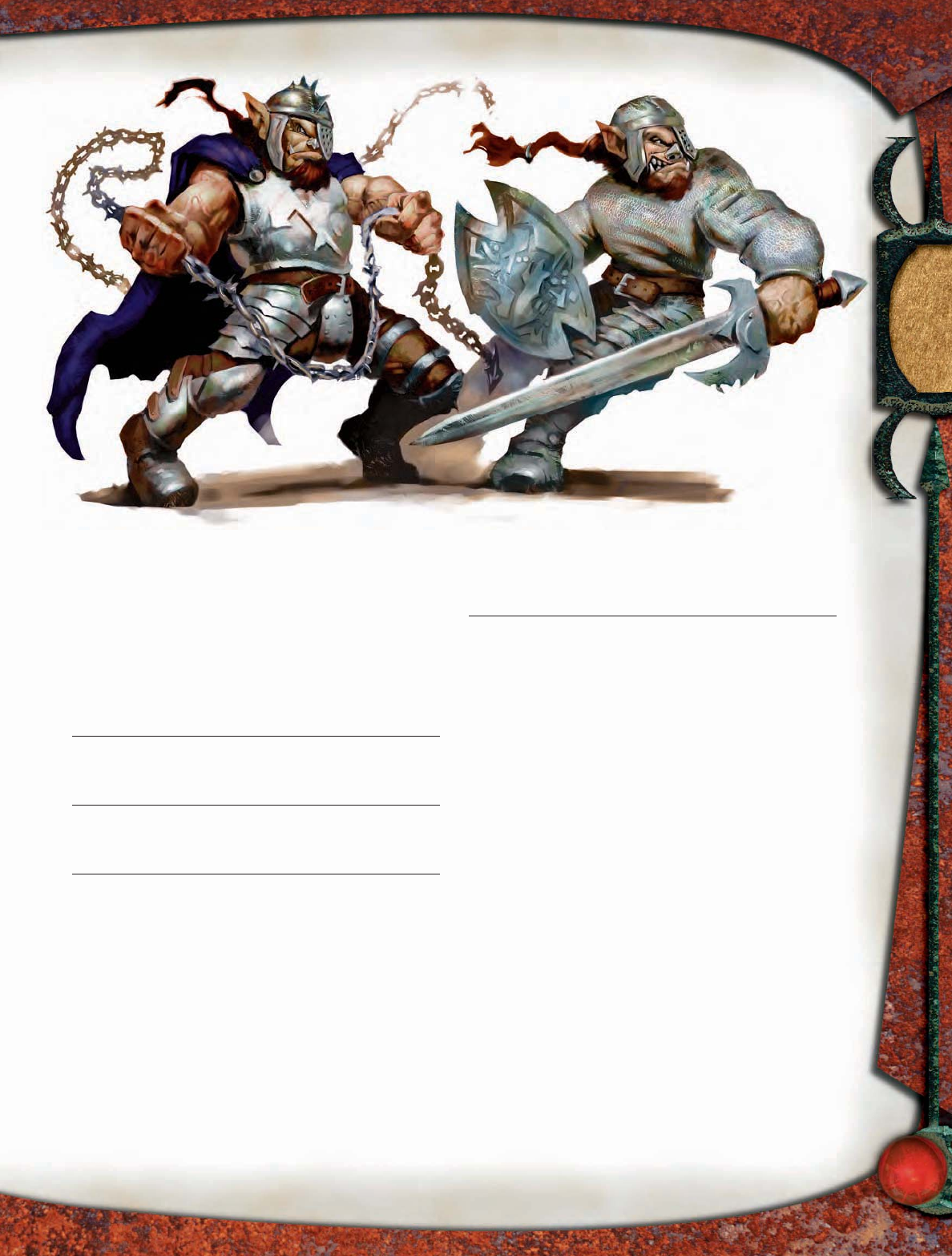
85
HOBGOBLIN SPELLSCOURGE
The scars of old burns and healed wounds cover this hobgoblin. His
breastplate is battered but etched with a single rune. He whirls a
barbed chain about him.
Hobgoblin Spellscourge CR 5
Usually LE Medium monstrous humanoid (goblinoid)
Init +2; Senses darkvision 60 ft.; Listen +1, Spot +1
Languages Common, Goblin
AC 17, touch 12, flat-footed 15; Dodge, Mobility
(+2 Dex, +5 armor)
hp 41 (5 HD)
Fort +5, Ref +7, Will +7; +2 against spells, spell eater
Speed 30 ft. (6 squares)
Melee +1 spiked chain +9 (2d4+5)
Space 5 ft.; Reach 5 ft. (10 ft. with spiked chain)
Base Atk +5; Grp +8
Abilities Str 16, Dex 15, Con 16, Int 10, Wis 12, Cha 8
Feats Dodge, Iron WillB, Mage Slayer*, Mobility
* New feat; see sidebar.
Skills Jump +9, Knowledge (arcana) +3, Listen +1, Move
Silently +5, Spellcraft +3, Spot +1, Tumble +8
Advancement by character class; Favored Class fighter
Possessions +1 chain shirt, +1 spiked chain, cloak of
resistance +1
Spell Eater (Su) If a hobgoblin spellscourge succeeds on his
save against a spell, he gains 5 temporary hit points and
a +2 bonus on attack rolls. The attack bonus lasts for 1
round, and the temporary hit points last for 1 minute.
Spellscourges are elite soldiers. They undergo intensive
training, daily exposure to spells, and cruel rituals, granting
them special defenses against magic. In war, spellscourges
race forward to slay enemy spellcasters. When rivalries
among hobgoblin mages turn violent, spellscourges serve
as choice assassins.
Strategies and Tactics
A spellscourge engages spellcasters, particularly lightly
armored or unarmored ones, shutting them down in a wide
area using his spiked chain. He uses Mobility and Tumble
to get into position to accomplish this goal.
Hobgoblin duskblade and spellscourge
HOBGOBLIN
Illus. by R. Spears
pqqqqqqqqqqqqqqqqqqqqrs
NEW FEAT: MAGE SLAYER
You have studied the ways and weaknesses of spellcasters and
can time your attacks and defenses against them expertly.
Prerequisites: Spellcraft 2 ranks, base attack bonus +3.
Benefit: You gain a +1 bonus on Will saves. Spellcasters you
threaten cannot cast defensively (they automatically fail their
Concentration checks to do so), but they are aware that they
cannot cast defensively while being threatened by you.
Special: Taking this feat reduces your caster level for all your
spells and spell-like abilities by 4.
pqqqqqqqqqqqqqqqqqqqqrs
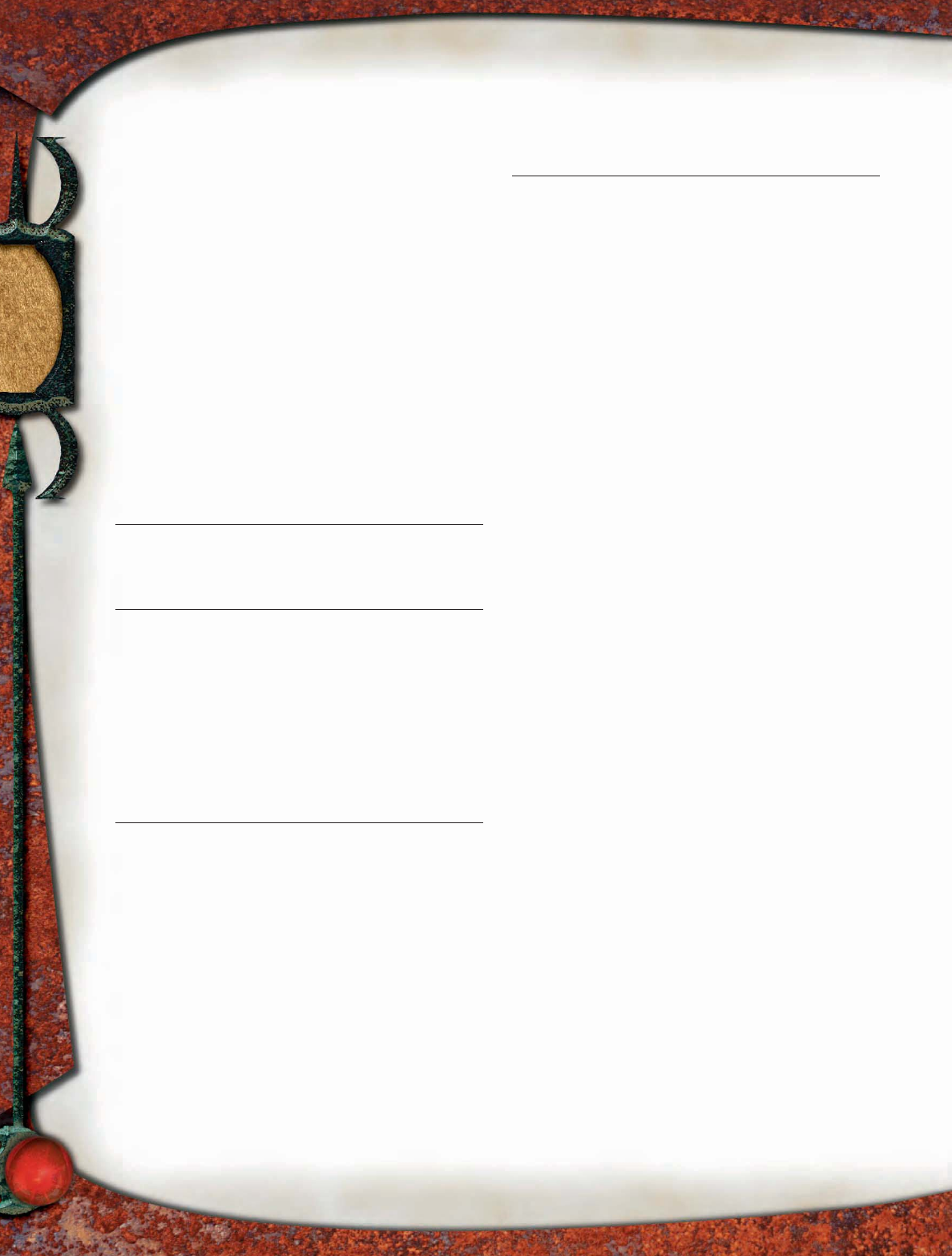
86
Hobgoblin spellcasters aren’t afraid to throw weak area
spells into enemies that have spellscourges among them,
counting on the spellscourges’ defenses to resist the spell. The
spell damages opponents while augmenting the spellscourges
through their spell eater ability.
Hobgoblin Spellscourges as Characters
Hobgoblin spellscourges are elite creatures that have the
racial characteristics of hobgoblins, along with the abilities
granted by their grueling ritualistic training. The typical
spellscourge advances as a fi ghter, but some tribes train
barbarians or monks with these abilities. Spellscourges often
enter the occult slayer prestige class (Complete Warrior 66).
Level Adjustment: +2.
HOBGOBLIN WARCASTER
A gaunt hobgoblin clad in red robes gestures toward you. From his
fi ngers lance two darts of magical energy.
Hobgoblin Warcaster CR 4
Usually LE Medium monstrous humanoid (goblinoid)
Init +2; Senses darkvision 60 ft.; Listen +0, Spot +5
Languages Common, Draconic, Giant, Goblin
AC 15, touch 12, flat-footed 13
(+2 Dex, +1 armor, +2 natural)
hp 33 (4 HD); DR 5/magic
SR 14
Fort +4, Ref +6, Will +6; +2 against spells, spell eater
Speed 30 ft. (6 squares)
Melee mwk staff +4 (1d6–1)
Ranged mwk dagger +7 (1d4–1)
Space 5 ft.; Reach 5 ft.
Base Atk +4; Grp +3
Atk Options magic strike
Special Actions pillar of magic
Wizard Spells Prepared (CL 4th):
2nd—false life, flaming sphere (DC 15), web (DC 15)
1st—expeditious retreat, magic missile (2), shield
0—daze (DC 13), flare (DC 13), resistance, read magic
Spell-Like Abilities (CL 4th):
At will—detect magic
Abilities Str 8, Dex 15, Con 16, Int 16, Wis 10, Cha 12
SA magic strike, pillar of magic, spell-like abilities, spells
SQ arcane talent
Feats Battle Magic Tactics*, Combat Casting, Iron WillB
* New feat; see sidebar, page 84.
Skills Concentration +9 (+13 casting defensively),
Intimidate +7, Knowledge (arcana) +9, Listen +0, Move
Silently +6, Spellcraft +11, Spot +5
Advancement by character class; Favored Class wizard
Possessions bracers of armor +1, masterwork staff, 3
masterwork daggers
Spellbook spells prepared plus 0—all in PH; 1st—cause fear,
chill touch, endure elements, mount, protection from good,
ray of enfeeblement; 2nd—ghoul touch, scare
Spell Eater (Su) If a hobgoblin warcaster succeeds on his
save against a spell, he gains 5 temporary hit points and
a +2 bonus on attack rolls. The attack bonus lasts for 1
round, and the temporary hit points last for 1 minute.
Pillar of Magic (Su) Once per day, a hobgoblin warcaster can
grant all goblinoids within 30 feet spell resistance 14 for
1 minute.
Arcane Talent (Ex) A warcaster casts spells as a 4th-level
wizard.
Warcasters are elite casters trained specifi cally for warfare.
The most promising young hobgoblin arcane casters endure a
grueling series of rituals and tests that slowly warp and alter
their bodies. Scores of hobgoblins exposed to this regimen
die hideous deaths, but those who survive become potent
spellcasters with magic in their veins.
Warcasters are the lowest-ranking products of this process.
They consider those who gained arcane skill through study
rather than ritual transformation to be lesser beings. When
a hobgoblin army marches to war, the warcasters provide
artillery support. They also work with spellscourges and
duskblades to target and destroy enemy spellcasters.
Strategies and Tactics
Warcasters use false life to fortify themselves before a battle
begins. Just prior to engaging the enemy, they use shield to
defend themselves while the spellscourges and duskblades they
lead move into position. Warcasters are acutely aware that they
have no more than four or fi ve spells to contribute to a fi ght, so
they hold back until they’ve gauged their opponents’ defenses.
They unleash their magic with precision against targets that
duskblades have set up with the Battle Magic Tactics feat.
A warcaster targets an area, preferably where duskblades
have softened up the enemy, with web. He then rolls a fl aming
sphere into trapped creatures, dealing more damage in the
process as the fi re interacts with the magical webbing. He
uses magic missile to fi nish off those who look badly injured,
then casts expeditious retreat to leave the battlefi eld.
Hobgoblin Warcasters as Characters
All hobgoblin warcasters are elite creatures that have the
racial characteristics of hobgoblins, as well as the abilities
HOBGOBLIN
pqqqqqqqqqqqqqqqqqqqqrs
MONSTROUS HUMANOID
(GOBLINOID)
The gruesome rituals and training that some of the hobgob-
lins in this entry go through changes their type to monstrous
humanoid. This means they’re immune to abilities that affect
only humanoids. However, abilities that affect creatures with
the goblinoid subtype still affect these creatures despite their
new type. So a ranger who has humanoid (goblinoid) as a
favored enemy still receives the bonuses that ability provides
when using it against the monstrous humanoid goblinoids
presented here.
pqqqqqqqqqqqqqqqqqqqqrs

87
granted by their torturous upbringing. However, hobgoblin
warcasters favor the wizard class. A hobgoblin warcaster’s
wizard levels stack with his Hit Dice to determine spells per
day and spells contained in his spellbook. No class except
wizard is considered associated for a hobgoblin warcaster.
Level Adjustment: +3.
HOBGOBLIN WARSOUL
Like an undead creature, this hobgoblin is incredibly emaciated,
and her skin is pulled tight across her bony frame. Her red robes
and staff mark her as a spellcaster of some sort.
Hobgoblin Warsoul CR 8
Usually LE Medium monstrous humanoid (goblinoid)
Init +7; Senses darkvision 60 ft.; Listen +8, Spot +10
Languages Common, Draconic, Dwarven, Elven, Giant,
Goblin
AC 20, touch 14, flat-footed 17
(+3 Dex, +2 armor, +1 deflection, +4 natural)
hp 88 (10 HD); DR 10/magic
SR 18
Fort +9, Ref +12, Will +13; +2 against spells, spell eater
Speed 30 ft. (6 squares)
Melee mwk quarterstaff +10/+5 (1d6–1)
Ranged mwk dagger +14/+9 (1d4–1)
Space 5 ft.; Reach 5 ft.
Base Atk +10; Grp +9
Atk Options magic strike
Special Actions soul tyrant
Combat Gear brooch of shielding, potion of cure serious wounds
Wizard Spells Prepared (CL 9th):
5th—cone of cold (DC 21), hold monster (DC 20)
4th—dimension door, shout (DC 20), wall of ice
3rd—dispel magic, fi reball (DC 19), haste, lightning bolt
(DC 19)
2nd—false life, fl aming sphere (DC 18), scorching ray (+14
ranged touch), shatter (DC 18), web (DC 17)
1st—expeditious retreat, grease (DC 16), mage armor, magic
missile (2), shield
0—daze (DC 15), flare (DC 16), resistance, read magic
Spell-Like Abilities (CL 9th):
At will—detect magic
Abilities Str 8, Dex 16, Con 18, Int 21, Wis 14, Cha 15
SA magic strike, soul tyrant, spell-like abilities, spells
SQ arcane talent, cult of power
Feats Battle Magic Tactics*, Combat Casting, Improved
Initiative, Iron WillB, Spell Focus (evocation)
* New feat; see sidebar, page 84.
Skills Concentration +17 (+21 casting defensively),
Diplomacy +8, Intimidate +15, Knowledge (arcana) +17,
Listen +8, Move Silently +8, Spellcraft +20, Spot +10
Advancement by character class; Favored Class wizard
Possessions combat gear plus bracers of armor +2, ring of
protection +1, masterwork staff, 3 masterwork daggers,
cloak of resistance +2
Spellbook spells prepared plus 0—all in PH; 1st—cause
fear, chill touch, endure elements, mount, protection
from good, ray of enfeeblement; 2nd—detect thoughts,
ghoul touch, scare, whispering wind; 3rd—clairaudience/
clairvoyance, tongues; 4th—lesser geas, scrying; 5th—
teleport, magic jar
Spell Eater (Su) If a warsoul succeeds on her save against a
spell, she gains 5 temporary hit points and a +2 bonus
on attack rolls. The attack bonus lasts for 1 round. The
temporary hit points last for 1 minute.
Soul Tyrant (Su) As a swift action, a warsoul can draw arcane
power from a willing hobgoblin within 30 feet who has 10
or fewer hit points. That hobgoblin is immediately slain,
leaving behind a desiccated corpse. The warsoul heals 1
hit point per Hit Die she has, and she receives a +2 bonus
to the save DC of the next spell she casts. She also gains
a +2 bonus on any attack roll required by the next spell
she casts. If that spell deals damage, the warsoul receives
a bonus on the damage roll equal to her Hit Dice.
Arcane Talent (Ex) A warsoul casts spells as a 9th-level
wizard.
Cult of Power (Ex) A warsoul is accompanied by 2d4 1st-
level hobgoblin warriors who have sworn their lives to
her. These thralls willingly sacrifice themselves for their
master’s soul tyrant ability.
Occasionally, a warcaster displays an incredible talent for
spellcasting, quickly racing ahead of her peers and master-
ing potent spells. As she endures more rituals and delves
deeper into her studies, the warcaster grows in power until
her fl esh becomes little more than a withered vessel for her
soul. She even learns to consume the essence of her “lessers”
to augment her spells. Invariably, she comes to either lead a
tribe or die at the hands of a rival.
Strategies and Tactics
Warsouls never enter battle without several utterly loyal
minions. Such hobgoblin warriors, compelled into obedi-
ence by the warsoul’s great power and magnetic personality,
believe that dying in their master’s name is the surest way
to attain an exalted state in the afterlife. They gladly perish
to hold back an approaching enemy or to fuel the warsoul’s
soul tyrant ability.
Preferring to fi ght alongside duskblades, spellscourges, and
a few allied warcasters, warsouls take care to cast defensive
spells before a struggle begins. Only a truly cunning oppo-
nent can catch warsouls without their mage armor, false life,
and shield spells cast. They use haste to augment their minions
right before engaging.
A typical warsoul might use the following sequence of
actions.
Round 1: Cast web to slow down or immobilize enemy
fi ghters. Warsouls prefer for their warriors to bring the battle
to the enemy.
Round 2: Cast fi reball targeting the area of the web, so as
to free up the battlefi eld while adding damage to the normal
effect of the fi reball.
Round 3: Order an attack on the toughest enemy, delay
to maximize the save penalty that target takes from allies’
Battle Magic Tactics, and cast hold monster on that foe.
Round 4: Cast scorching ray to fi nish off the held target.
Round 5: Cast an area spell targeting the largest group of
opponents.
HOBGOBLIN
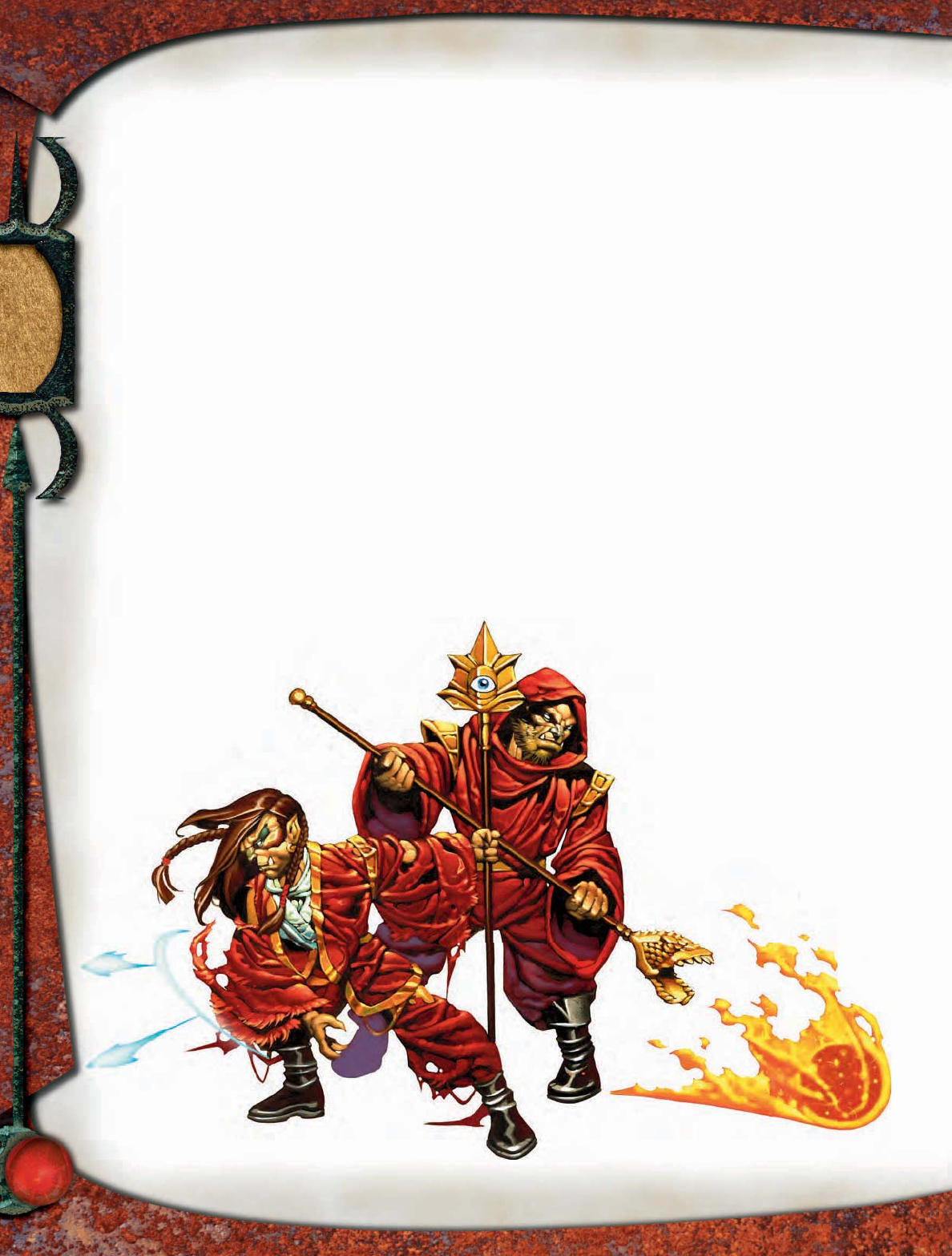
88
If the fi ght goes against the warsoul, she uses dimension
door to escape with her hide intact. If her side is losing but
she can save some of her troops, she uses wall of ice to cover
their retreat before casting dimension door.
Hobgoblin Warsouls with Class Levels
Hobgoblin warsouls are elite, and they advance as wizards.
A hobgoblin warsoul’s wizard levels stack with her Hit Dice
to determine spells per day and spells contained in her
spellbook. No class except wizard is considered associated
for a hobgoblin warsoul.
Level Adjustment: +4.
SAMPLE ENCOUNTERS
Hobgoblins rely on tightly coordinated, highly organized
tactics. They travel in structured groups made up of members
whose abilities work together to create a stronger whole.
Magic Marauders (EL 6): Two hobgoblin duskblades and
a warcaster form the smallest combat formation in special-
ized hobgoblin units. The duskblades act as bodyguards until
they wade into melee to weaken foes with their Battle Magic
Tactics feat.
Warsoul Retinue (EL 9): A warsoul usually fights
along side two duskblades, a warcaster, and a spellscourge.
In combat, this unit seeks out and slays enemy spellcasters.
The duskblades form a defensive wall for the warcaster and
the warsoul, while the spellscourge races forward to
harass or kill enemy casters. The warcaster focuses his
spells on enemy warriors, and the warsoul does the
same with her damaging spells. She uses her inca-
pacitating spells, such
as hold monster, on any
spellcaster unfortunate
enough to draw the spell-
scourge’s attention.
ECOLOGY
Hobgoblins are born predators. Unlike orcs and other
savage humanoids, hobgoblins are naturally clever and
adaptable, agile and hardy. Hobgoblins easily overcome
competing creatures when the two groups’ numbers are
equal or favor hobgoblins.
Although few hobgoblin societies are agricultural, hob-
goblins acquire food with little trouble through hunting,
raiding, and conquest, as well as by maintaining small
herds of livestock. They favor meat, and they can and do
eat whatever they can kill, sometimes including other
sentient creatures.
Hobgoblins reproduce in the same manner as humans,
though breeding is strictly controlled in the majority of
tribes (see Society). Young hobgoblins are born nearly helpless,
but they mature more quickly than their human counter-
parts do.
Environment: Hobgoblins prefer warm, hilly regions,
but they are second only to humans in terms of adaptability.
They can survive in almost any climate or terrain.
Typical Physical Characteristics: Hobgoblins are
lean and tall—usually over 6-1/2 feet tall and 250 pounds
and built for agility. They have orange skin that blues or
reddens near their flat noses. Coarse hair, ranging in color
from red-brown to gray, grows on their heads as well as
on their arms and legs. Male hobgoblins can grow beards,
and some even have pattern balding like males of other
humanoid races.
Alignment: Hobgoblins organize themselves
into strict hierarchies that have harsh laws, with
the mightiest and most cunning hobgoblins
at the top. But they are also murderous and
tyrannical, with little compassion or room in
their cold hearts for “softer” emotions. They
are usually lawful evil.
SOCIETY
Hobgoblins have a rigid, unforgiving
society based on the idea that con-
tinued existence depends on martial
superiority. Their hi-
erarchy is formed
HOBGOBLIN
Hobgoblin warcaster and warsoul
Illus. by T. Giorello
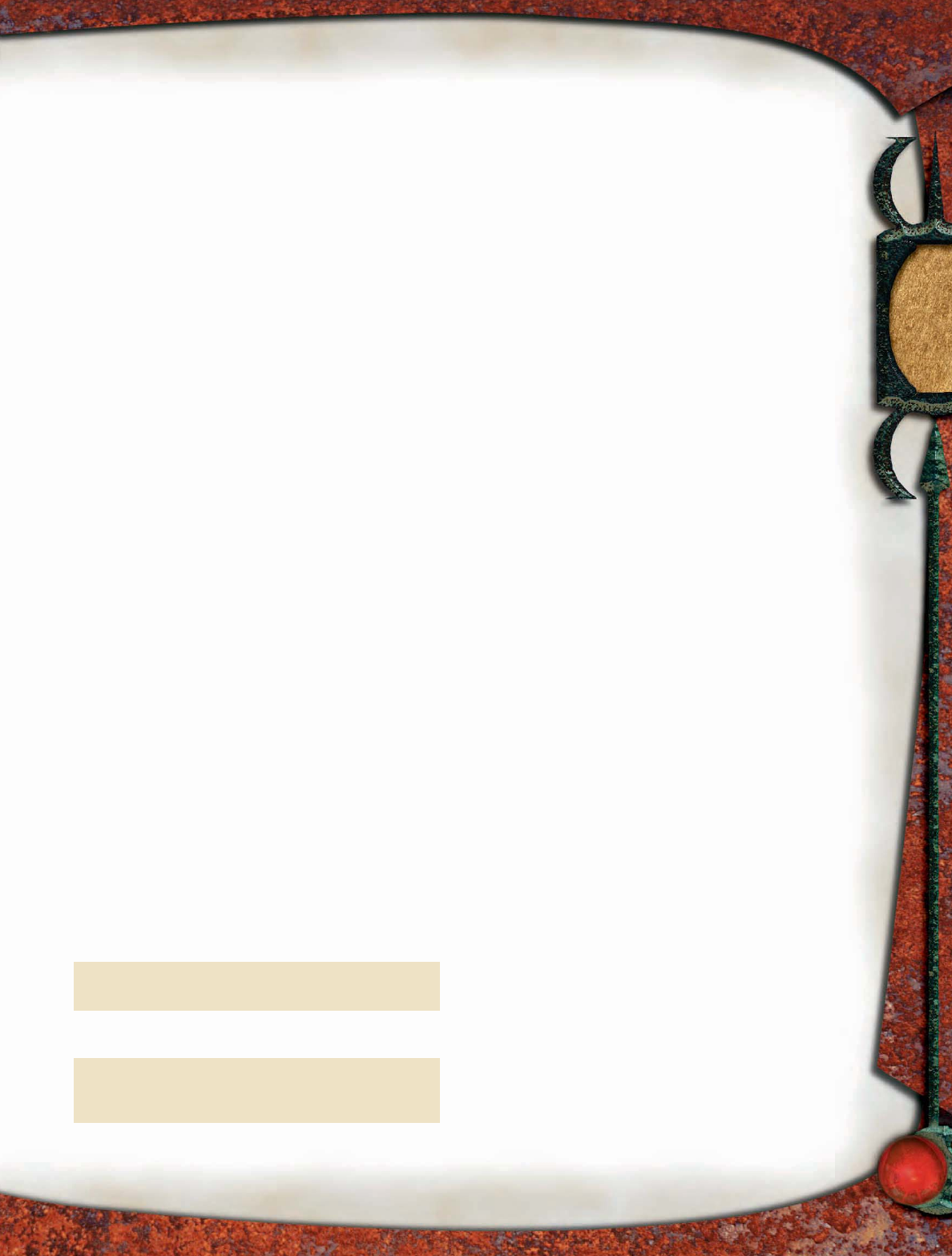
89
to place each hobgoblin within his or her appropriate social
position while supporting nearly endless war. They have
an insatiable thirst for conquest and dominance over all
other creatures.
These goblinoids have two basic modes. They either seek
to conquer their neighbors, or they gather their strength for
the next attack while making raids and feints against their
enemies. A hobgoblin tribe at peace is a tribe that is merely
between wars.
Unlike orcs and other dim-witted evil humanoids,
hobgoblins take a long-term, strategic view of their con-
fl icts. A hobgoblin king might even strike an alliance or a
nonaggression pact with a nonhobgoblin realm that has a
tolerable ethos. Although hobgoblins thirst for conquest
and the imposition of their tyranny over all other intelligent
creatures, they recognize that their plans might require years
of continual fi ghting.
To this end, hobgoblins organize into rigid castes, with
each caste charged with a specifi c task. Slaves occupy the
lowest rung in hobgoblin society, followed by nonwarrior
craftsmen, religious leaders, and then warriors. Hobgoblins
are assigned to a caste based on ability and tribal needs, with
no regard for gender or personal preference.
Given this warrior ideal, success in combat is the best way to
advance to the top of the social order. Thus, even a hobgoblin
blacksmith or cleric takes up arms to earn respect from his
fellows. Braver hobgoblin warriors submit themselves for
brutal training and crueler rituals to toughen them for battle.
Countless hobgoblins fail to survive the process.
With regard to hobgoblin culture, the term “warrior”
should not be confused with “nonspellcaster.” Spellcasters
can be honored members of the hobgoblin hierarchy, and as
with other members of the society, those spellcasters who
succeed in battle are the most revered. In fact, hobgoblin
wizards readily subject themselves to gruseome ordeals to
steel themselves for war.
The warrior ideal doesn’t mean that other castes are looked
down upon. All hobgoblin warriors recognize the need for
craftspersons, healers, and similar members of a tribe. Only
a fool would believe that the hobgoblin war machine could
function without such pieces. However, no member of a lower
caste dares defy or insult a warrior unless the lower-caste
hobgoblin wants to die.
Religious leaders are the exception to this rule—lower
than warriors but able to advise and even challenge their
superiors. Most hobgoblin priests are adepts, and these
priests oversee aspects of hobgoblin life such as arranged
marriage and nonmilitary instruction, including the
Common language. Hobgoblin children form few attach-
ments; their primary bond is usually with an adept or cleric
who instruct them. Hobgoblin despots have one or more
religious advisors who have great infl uence in the tribe and
over their leader.
Individual hobgoblins are taught from birth to protect
themselves and their personal space. By extension, the
personal space of the tribe is a communal responsibility,
made up of the space occupied by each member of the tribe.
An individual hobgoblin pays attention to his surround-
ings and is always alert for opportunities or threats. The
tribe works to control its environment, dominating weaker
sentient creatures and lashing out at perceived dangers. No
room is left for emotional considerations—compassion is a
weakness, and personal freedom a potential hazard to the
tribe’s overall safety.
In this vein, while two hobgoblins might risk a tryst for
the sake of lust, hobgoblins don’t marry for love. The priests
select those who should breed to produce the strongest off-
spring, and marriages are arranged along those lines. Other
marriages are forged to ensure alliances, shore up a position
of power, or to take power away from another hobgoblin.
Offspring are the property of their parents, instructed in
the harsh hobgoblin way of life by father, mother, and the
tribe’s priests.
Similarly, adult hobgoblins are the property of their
superiors, and the only way to avoid the order of a superior
is to die through ritual suicide or to destroy that superior
and his or her allies. Such events are rare, however, and most
hobgoblins serve their tribe faithfully until they no longer
can. Aged and feeble hobgoblins commit ritual suicide in
a ceremony designed to honor their deity Maglubiyet and
the tribe.
TYPICAL TREASURE
Hobgoblins value usable treasure, such as equipment and
magic items, but they also collect jewelry and money. They
have standard treasure for their Challenge Rating. Elite
hobgoblins usually have equipment usual for NPCs of their
Challenge Rating rather than standard treasure.
pqqqqqqqqqrs
HOBGOBLIN LORE
Characters who have ranks in Knowledge (local) can learn
more about hobgoblins. When a character makes a success-
ful skill check, the following lore is revealed, including the
information from lower DCs.
Knowledge (Local)
DC Result
11 Hobgoblins are goblinoid creatures that are
stronger and better organized than their smaller
cousins.
16 Hobgoblins use coordinated tactics to defeat their
enemies. They fl ank opponents, swarm around
foes, and work as a team.
21 Hobgoblins are clever, and they use magic to
twist themselves into better and more specialized
soldiers and spellcasters. Some have even become
monstrous humanoids.
pqqqqqqqqqrs
HOBGOBLIN
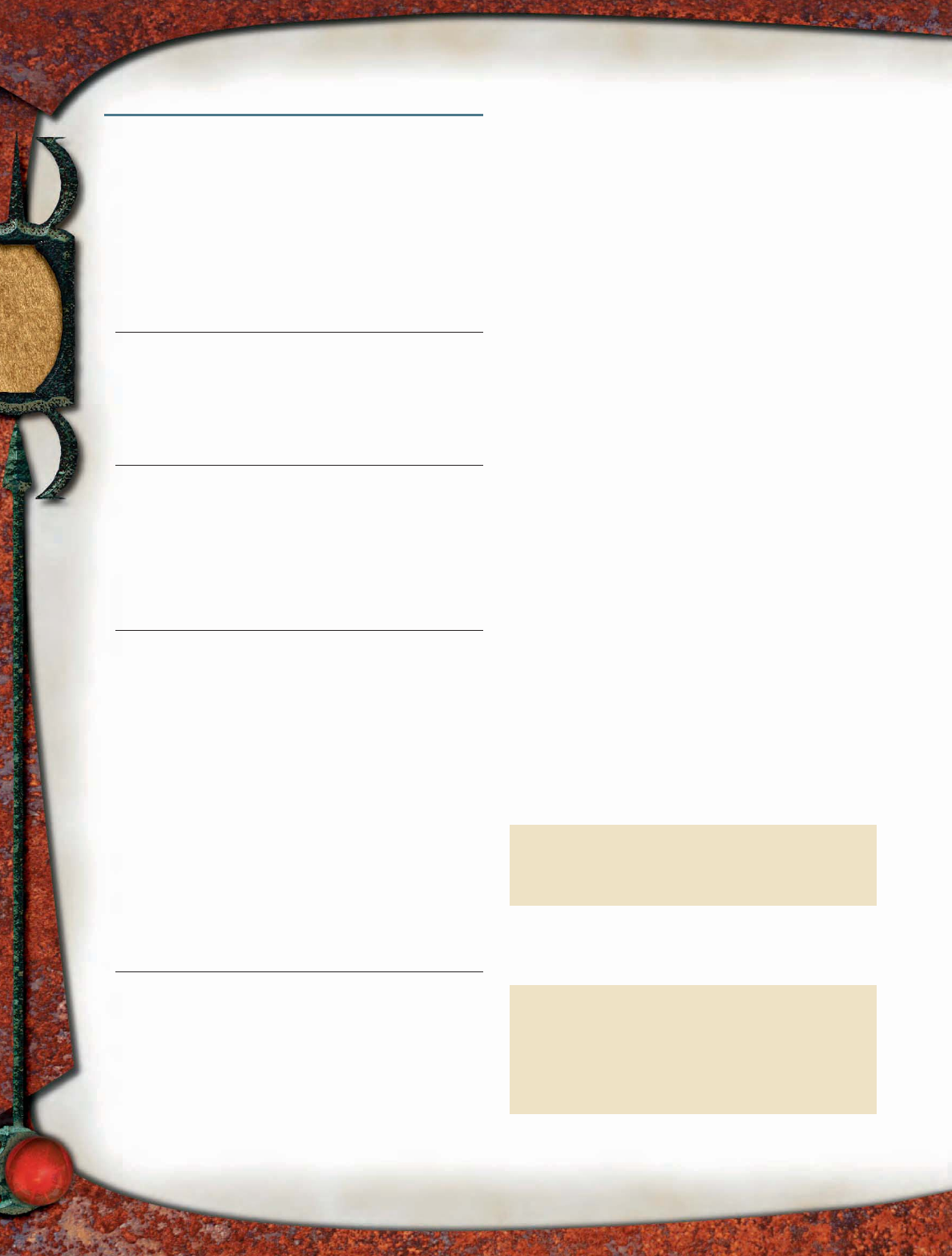
90
ILLURIEN
A dancing array of droplets swirls before you. In the midst of this
storm stands a slender but extremely tall female clad in gray robes.
She has no facial features other than her vivid blue eyes. With a
graceful motion, she beckons to you.
Illurien CR 15
NE Large outsider (evil, extraplanar)
Init +11; Senses low-light vision, darkvision 120 ft., blindsight
60 ft.; Listen +32, Spot +32
Aura storm of visions (30 ft.)
Languages understands all languages; cannot speak;
telepathy 120 ft.
AC 24, touch 16, flat-footed 24; uncanny dodge
(–1 size, +7 Dex, +8 natural)
Miss Chance 20% (cloud of foresight)
hp 230 (20 HD); fast healing 5; DR 15/good; rejuvenation
Immune disease, electricity, paralysis, poison, polymorph,
sleep, stunning
Resist acid 20; SR 24
Fort +21, Ref +21, Will +21
Speed 40 ft. (8 squares); fly 80 ft. (perfect)
Melee tempest lash +28/+23/+18/+13 (1d8+6 plus tempest
lash)
Space 10 ft.; Reach 10 ft.
Base Atk +20; Grp +30
Atk Options aligned strike (evil), magic strike
Special Actions cloud of foresight
Spell-Like Abilities (CL 20th):
At will—analyze dweomer, arcane sight
1/day — plane shift
Abilities Str 22, Dex 24, Con 25, Int 36, Wis 24, Cha 21
SA aligned strike, tempest lash, magic strike, spell-like
abilities, storm of visions
SQ pointed knowledge
Feats Alertness, Great Fortitude, Improved Initiative, Iron
Will, Lightning Reflexes, Weapon Finesse, Weapon Focus
(tempest lash)
Skills Bluff +28, Appraise +36, Decipher Script +36,
Diplomacy +11, Gather Information +30, Intimidate +30,
Knowledge (arcana) +36, Knowledge (architecture and
engineering) +36, Knowledge (dungeoneering) +36,
Knowledge (geography) +36, Knowledge (history) +36,
Knowledge (local) +36, Knowledge (nature) +36,
Knowledge (nobility and royalty) +36, Knowledge
(the planes) +36, Knowledge (religion) +36,
Listen +32, Search +36 (+38 secret doors), Sense
Motive +30, Spellcraft +38 (+40 deciphering scrolls),
Spot +32, Survival +7 (+9 in aboveground natural
environments, +9 on other planes, +9 to avoid getting
lost, +9 to follow tracks, +9 underground), Use Magic
Device +28 (+30 scrolls)
Storm of Visions (Su) The watery drops that surround
Illurien are the collected fragments of the knowledge
she has accumulated. At the end of each of Illurien’s
turns, creatures within 30 feet of her must succeed on
a DC 25 Will save or be dazed for 1 round, as visions of
exotic truths captivate their minds. A successful save
negates the effect, but each creature in the area must
make a new saving throw at the end of each of Illurien’s
turns. The save DC is Charisma-based. This is a mind-
affecting ability.
Cloud of Foresight (Su) Drawing on her boundless lore,
Illurien uses opponents’ tendencies and desires
against them. This causes her opponents to have a
20% miss chance. Once per round, as an immediate
action, Illurien can impose a –8 penalty on a single
attack roll, check, or saving throw made by an opponent
within 60 feet.
Rejuvenation (Su) If slain, Illurien reappears in the
Athenaeum Nefarious (see below) two days later.
Tempest Lash (Su) Illurien attacks by lashing her foes with a
knifelike weapon formed from the droplets that surround
her. Anyone struck by this tempest lash must succeed
on a DC 25 Will save or take 1d4 points of Intelligence
damage. Illurien heals 5 hit points for each point of
Intelligence damage she deals with this attack.
Pointed Knowledge (Su) Illurien understands all languages,
and she instantly knows facts about creatures she speaks
to telepathically, such as their age, where they were born,
and the important events of their lives.
A strange creature composed of countless tears and raindrops,
Illurien of the Myriad Glimpses is a collector of information
and a keeper of secrets. She is fascinated by the contents of
other minds, believing it is her right to obtain and preserve
such knowledge for herself.
STRATEGIES AND TACTICS
Illurien engages those she meets in polite telepathic con-
versation, but this behavior is just an excuse to examine
their minds. Once Illurien has selected the brightest
intellect among her chosen targets, she moves in, subject-
ing her foes to her storm of visions. She uses her tempest
lash to deal Intelligence damage to her preferred enemy,
pqqqqqqqqqrs
ILLURIEN LORE
Characters who have ranks in Knowledge (the planes) can
learn more about Illurien. When a character makes a suc-
cessful skill check, the following lore is revealed, including
the information from lower DCs.
Knowledge (the Planes)
DC Result
25 This is Illurien of the Myriad Glimpses, a strange
creature that steals knowledge from the minds
of her victims. She is amoral and unworthy of
trust. Her home is the Concordant Domain of the
Outlands.
30 The cloud that surrounds Illurien can rob mortals
of their senses. Her attacks drain her target’s mind
while healing Illurien’s wounds. It is said that she
resides in a secret library in the Outlands known
as the Athenaeum Nefarious.
35 Illurien’s knowledge protects her in combat, and
she is immune to disease, electricity, paralysis,
poison, polymorph, sleep, and stunning. She
is resistant to acid and magic and capable of
spontaneously traveling between the planes. She
can be called to a place in the Outlands referred
to as the Shrouded Dispensary, where she can be
coaxed into sharing her knowledge.
40 If killed, Illurien merely rejuvenates, reappearing
inside the Athenaeum Nefarious within two days.
pqqqqqqqqqrs
ILLURIEN
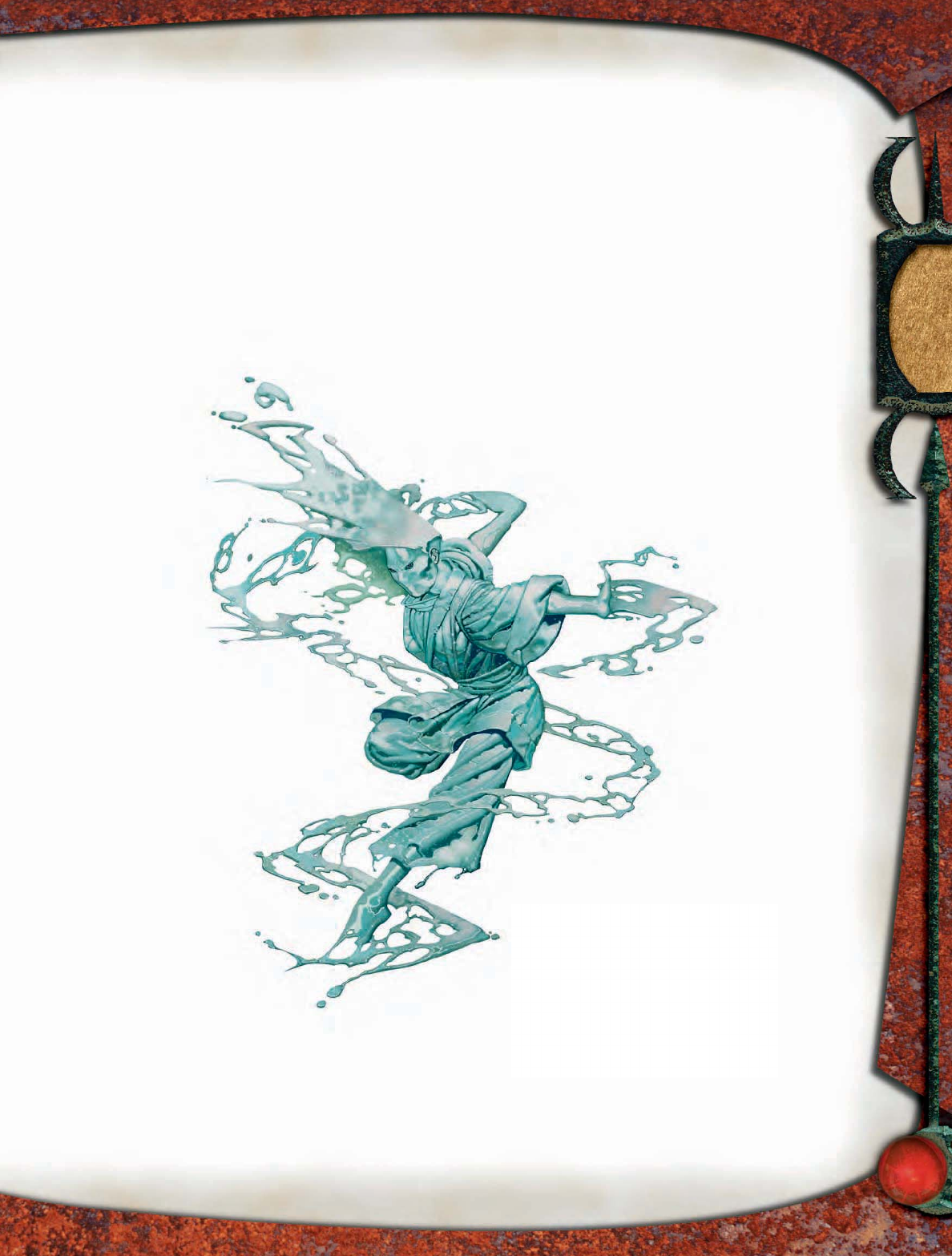
91
relying on her cloud of foresight to foil that opponent’s
defenders. During combat, she sometimes uses her pointed
knowledge to intimidate and threaten her opponents. If
pressed, she uses plane shift to fl ee to the Athenaeum Nefari-
ous (see Environment).
SAMPLE ENCOUNTER
Illurien travels the planes in search of knowledge and myster-
ies to steal and keep for herself.
Mindful Murder (EL 15): Illurien has come to steal in-
formation from one of the PCs’ sagacious allies. She talked
with that NPC for a while, then attacked him, drained him of
intelligence, and slew him. After the murder, Illurien method-
ically inspected the slain man’s organs and body parts to see
his specifi c internal work-
ings. The characters
now have a grisly
murder to solve, and
the corpse, drained
of much of its knowl-
edge, utters only the
name “Illurien” if ques-
tioned with a speak
with dead spell.
ECOLOGY
Illurien is a unique
native of the Con-
cordant Domain of
the Outlands. Where
she came from and who created her,
if anyone did, is a mystery. Some suspect
she is a minion of Vecna, but Illurien, Vec-
na’s clergy, and Vecna himself say nothing
on this subject.
She gains sustenance through collecting
knowledge, but her consumption of
other minds doesn’t destroy the
information she gathers.
Rather, that cognition be-
comes a part of Illurien
and her storm of visions.
Illurien doesn’t otherwise
eat or drink, and unlike oth-
er outsiders, she doesn’t
breathe. She has no physi-
cal needs or desires beyond her
thirst for erudition.
Environment: Illurien resides
in an extraplanar repository referred to as the Athenaeum
Nefarious, a place so well hidden in the wilderness of the
Outlands that few have found it—and fewer still return
from it. The library contains stacks of dark and forgotten
lore, baleful traps, vile guardians, and several one-way
portals to other planes. A clue to the whereabouts of this
sinister vault is the perpetual storm that enshrouds it. Only
Illurien can use plane shift to arrive precisely within the
Athenaeum Nefarious.
The Shrouded Dispensary, a building 100 miles from the
center spire of the Outlands, is where those who wish to speak
with Illurien can call her. She comes if she’s willing, carrying
a sword of the planes (DMG 228) and protected by the effect the
Outlands has on magic, spell-like abilities, and supernatural
abilities. Only Illurien can use the Dispensary’s planar gate,
which leads to the Athenaeum Nefarious.
Physical Characteristics: Illurien is a graceful, human-
like, female figure, roughly 8 feet tall, with shimmering
silver-gray skin. She has no distinct facial features other
than a pair of silver-tinted eyes with blue irises. Close
examination shows that she is composed entirely of irides-
cent droplets, but this watery composition forms organs
and even bonelike structures. So, despite her elemental
nature, she does have vulnerable spots. Illurien touches the
ground only when she must, otherwise fl oating or fl ying
everywhere she travels.
Alignment: Illurien lets no emotions stand
in the way of her calculated collecting. She can
feign kindness when doing so suits her ends,
but pleasantries can’t sway her. She enjoys pluck-
ing information from
unwilling minds, and
she doesn’t care if
she causes suf-
fering, but she
isn’t gratuitously
violent. Illurien is
neutral evil.
SOCIETY
Illurien considers herself
a scholar, a collector, and a
sage. The knowledge she
possesses is in demand.
Creatures from across the
planes seek Illurien’s counsel,
despite her fees, which are brutal-
ly personal and coldly constructed.
TYPICAL TREASURE
Illurien rarely carries treasure, but she might be
caught ferrying a tome of disturbing teachings or
a mystifying item to the Athenaeum Nefarious.
If she is carrying valuables, those objects are
worth as much as standard treasure for Illurien’s
Challenge Rating (22,000 gp). The sword she
carries to the Shrouded Dispensary is worth slightly more
than this total.
If it occurs anywhere other than the Shrouded Dispen-
sary, Illurien’s death spawns hints to the location of the
Athenaeum Nefarious in minds recently touched by the
tempest lash. Creatures that survive her attacks might be left
with the ability to fi nd Illurien’s gloomy home.
Illurien of the
Myriad Glimpses
ILLURIEN
Illus. by T. Giorello

92
JAEBRIN
Nimble and attractive, this short humanoid wears stylish silks
and fi ne jewelry. A veil shrouds the lower half of his face, leav-
ing his striking brown eyes uncovered. A sudden breeze blows
the veil aside—revealing that his oversized mouth is full of
needlelike teeth.
Jaebrin Trickster CR 1
Male jaebrin beguiler* 1
* Class described in PH2
CN Medium fey
Init +2; Senses low-light vision; Listen +3, Spot +3
Languages Common, Elven, Halfling, Sylvan
AC 16, touch 13, flat-footed 14
(+2 Dex, +3 armor, +1 luck)
hp 7 (1 HD)
Immune enchantment
Resist feign enchantment
Fort +1, Ref +2, Will +1
Speed 30 ft. (6 squares)
Melee rapier +2 (1d6/18–20) or
Melee bite +2 (1d3 plus will sapper)
Ranged light crossbow +2 (1d8/19–20)
Base Atk +0; Grp +0
Beguiler Spells Known (CL 1st):
1st (4/day)—charm person (DC 14), color spray (DC 13),
comprehend languages, detect secret doors, disguise self,
expeditious retreat, hypnotism (DC 14), mage armor,
obscuring mist, rouse*, silent image (DC 13), sleep
(DC 14), undetectable alignment, whelm* (DC 14)
0 (5/day)—dancing lights, daze, detect magic, ghost sound,
message, open/close, read magic
* Spells described in PH2
Abilities Str 10, Dex 14, Con 13, Int 15, Wis 8, Cha 12
SQ armored mage, trapfinding
Feats Weapon Finesse
Skills Appraise +4, Bluff +7, Diplomacy +3, Disguise +5,
Hide +6, Listen +3, Move Silently +6, Open Lock +6,
Perform +3, Spot +3, Spellcraft +2 (+6 involving
enchantments), Use Magic Device +5
Possessions masterwork studded leather, rapier, light
crossbow with 10 bolts, gaudy noble’s outfit
Feign Enchantment (Su) Jaebrin tricksters absorb the
energy of enchantment effects used on them, allowing
them to know the intended effect. The jaebrin can
then pretend to be affected, fooling even detect magic,
arcane sight, and similar effects, since the absorbed
energy is displayed in the jaebrin’s aura for the duration
of the effect or until the jaebrin dismisses it. Only by
winning an opposed Sense Motive check against the
jaebrin’s Bluff check result can a viewer discern that the
fey is not enchanted.
Will Sapper (Ex) Any creature damaged by a jaebrin
trickster’s bite must succeed on a DC 11 Will save
or take a –4 penalty on Will saves for 1 minute. The
effect of multiple bites doesn’t stack. The save DC is
Constitution-based.
Armored Mage (Ex) A jaebrin trickster does not have an
arcane spell failure chance when wearing light armor.
Jaebrins are fey whose fearsome teeth belie an impish
nature. Their powers of enchantment, and their immunity
to those same effects, make them tricky opponents and
untrustworthy allies.
STRATEGIES AND TACTICS
Jaebrin tricksters live by their wits, not by their mettle, and
they prefer to befuddle and enchant opponents rather than
face them in open combat. No jaebrin trickster is above
using charm person and hypnotism to get his way. If forced
to fi ght, a jaebrin trickster uses sleep, then casts obscuring
mist. He then casts expeditious retreat and beats feet out of
the area.
SAMPLE ENCOUNTER
Jaebrins are outcast drifters that enjoy tricking and entertain-
ing mortals. Only rarely is a jaebrin found among other fey,
and in such cases, the jaebrin is with a mate or has fallen in
with immoral kin.
Impostor Innkeeper (EL 1): Bertletuckle is a jaebrin
trickster. He overwhelmed the lone barkeep of a roadside inn
earlier this morning, and he spent the day feasting. When
the PCs arrive, Bertletuckle acts the part of an innkeeper
pleased to have guests at his otherwise deserted inn. He
happily offers the characters rooms for the night, then tries
to rob them in their sleep.
ECOLOGY
Jaebrins are elflike in their appearance, but they are
more like a cross between humans and half-elves when
it comes to how they live and age. A jaebrin is an adult
at age 20 or so, and can live to be nearly 200. This seems
to be a short life for a fey creature, and some speculate
that jaebrins would live longer if they remained among
their fey kin.
pqqqqqqqqqrs
JAEBRIN LORE
Characters who have ranks in Knowledge (nature) can learn
more about jaebrins. When a character makes a successful
skill check, the following lore is revealed, including the infor-
mation from lower DCs.
Knowledge (Nature)
DC Result
11 This creature is a jaebrin, a fey creature full of
mischief. This result reveals all fey traits.
16 Jaebrins have needle-toothed mouths capable of
delivering a painful bite. That same bite saps the
will.
21 Jaebrins excel at enchantment magic and are
immune to its effects. They have the uncanny
ability to fake being enchanted, however.
pqqqqqqqqqrs
JAEBRIN
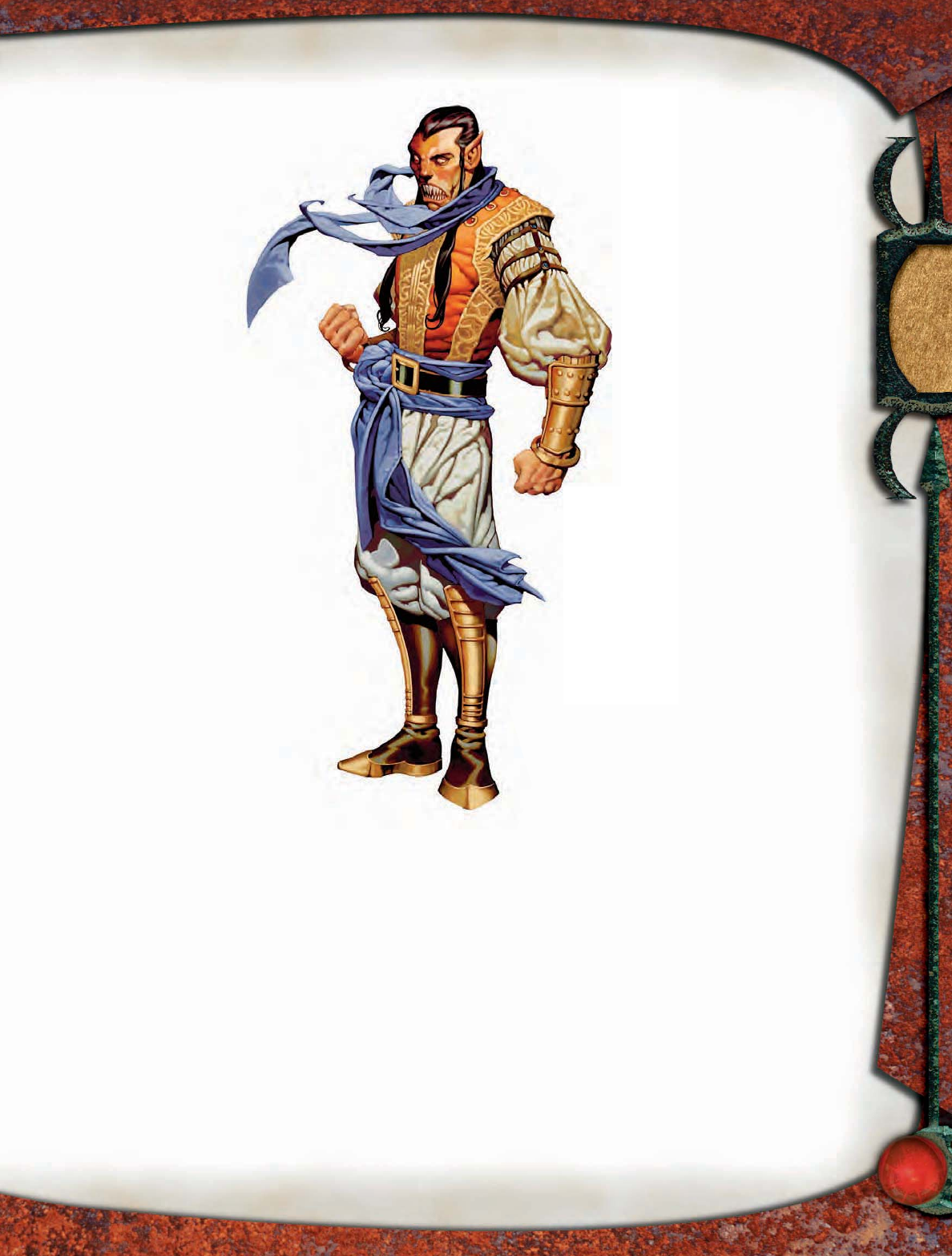
93
When it comes to love, jaebrins are slightly unusual.
Females commonly initiate courtships. Mated jae-
brins usually stay together just long enough to
raise their fi rst offspring, or about 21 years.
Then the two split amicably and
remain friends, but they are never
again lovers.
Jaebrins love lavish feasts.
Born with hedonistic
appetites, they can eat
and drink nearly contin-
uously without gaining
weight. They indulge
this gluttony whenever
they can.
Environment: Jaebrins prefer tem-
perate climes near civilization.
Typical Physical Characteristics:
Jaebrins rarely top 5 feet in height, and
individuals weighing more than 100
pounds are rare. Elflike in appearance,
jaebrins have fine features, but their
mouths bristle with needlelike teeth.
Their fair eyes are oversized, giving
them an alluring or unsettling appear-
ance, depending on the lighting and
their mood. All jaebrins have shiny hair
of nearly any color, but red and raven are
most common.
Alignment: Jaebrins are full of tomfoolery,
egotism, and decadence, but they aren’t malevo-
lent or cruel. They are usually chaotic neutral.
SOCIETY
Jaebrins were formerly the jesters of
fey courts. Fey nobles delighted in
enchanting jaebrins to perform silly or
weird acts. For their part, the jaebrins rev-
eled in their role, seeing entertainment as
a great service.
Eventually they built up a strong tolerance to enchant-
ment. For a number of centuries, they hid this fact from
their masters and learned to fake being under the sway of
enchantment. In time, fey noble after fey noble discovered
the ruse and lost interest in the jaebrins. The forsaken fey
were shamed into self- imposed exile.
Some jaebrins now make their way as merchants, charla-
tans, and swindlers. Others bring merriment as bards, and a
few exploit their talents by becoming sorcerers. Such jaebrins
might even seek the excitement of adventuring.
A large number of jaebrins speak with pronounced
lisps and have a comical tendency to pronounce all nouns
as plural. They even “pluralize” words that are already
plural or add an “s” to words that don’t need one. “I
hears the femaleses in this town are all beautieses,”
one might say, enjoying the laughter his ridiculous
speech evokes.
TYPICAL TREASURE
Jaebrins love fine clothing, jewelry, and
gems. Although they carry money, they
love to hoodwink others out of neces-
sities such as provisions. Jaebrins
have standard treasure for their
Challenge Rating.
JAEBRINS AS
CHARACTERS
Like humanoids, jaebrins gain
their Hit Dice and much of their
power from the class or classes they
choose to pursue. These fey prefer
trickery to combat, and they’re bright
enough to accentuate their strengths,
so they pursue careers as bards, beguil-
ers, or rogues. A few become sorcerers, and
such jaebrins can become fearsome indeed. Jae-
brins are faithless, however—if they pursue
divine magic, they do so only through the
druid class.
Jaebrins possess the following racial traits.
— Fey. Jaebrins are not subject to spells or ef-
fects that affect only humanoids.
— –2 Strength, +2 Charisma.
— Medium size.
— A jaebrin’s base land speed is 30 feet.
— Low-light vision.
— All jaebrins have a +1 luck bonus to AC.
— Immunity to enchantment spells and
effects.
— Natural Attack: Bite (1d3).
— +1 racial bonus on saving throw DCs
for enchantment spells the jaebrin casts.
— +2 racial bonus on Appraise, Bluff, Perform, and
Diplomacy checks.
— Jaebrins treat Spellcraft as a class skill and are consid-
ered trained in it even if they have no ranks. They have a +4
racial bonus on Spellcraft checks involving enchantment
spells and effects.
— Automatic Languages: Common, Sylvan. Bonus Lan-
guages: Draconic, Elven, Goblin, Gnome, Halfl ing.
— Special Attack (see above): Will sapper. A jaebrin adds
1/2 his class level to the saving throw DC of this ability.
— Special Qualities (see above): Feign enchantment.
— Favored Class: Beguiler (PH2 6).
— Level Adjustment: +1.
Jaebrin trickster
JAEBRIN
Illus. by T. Giorello
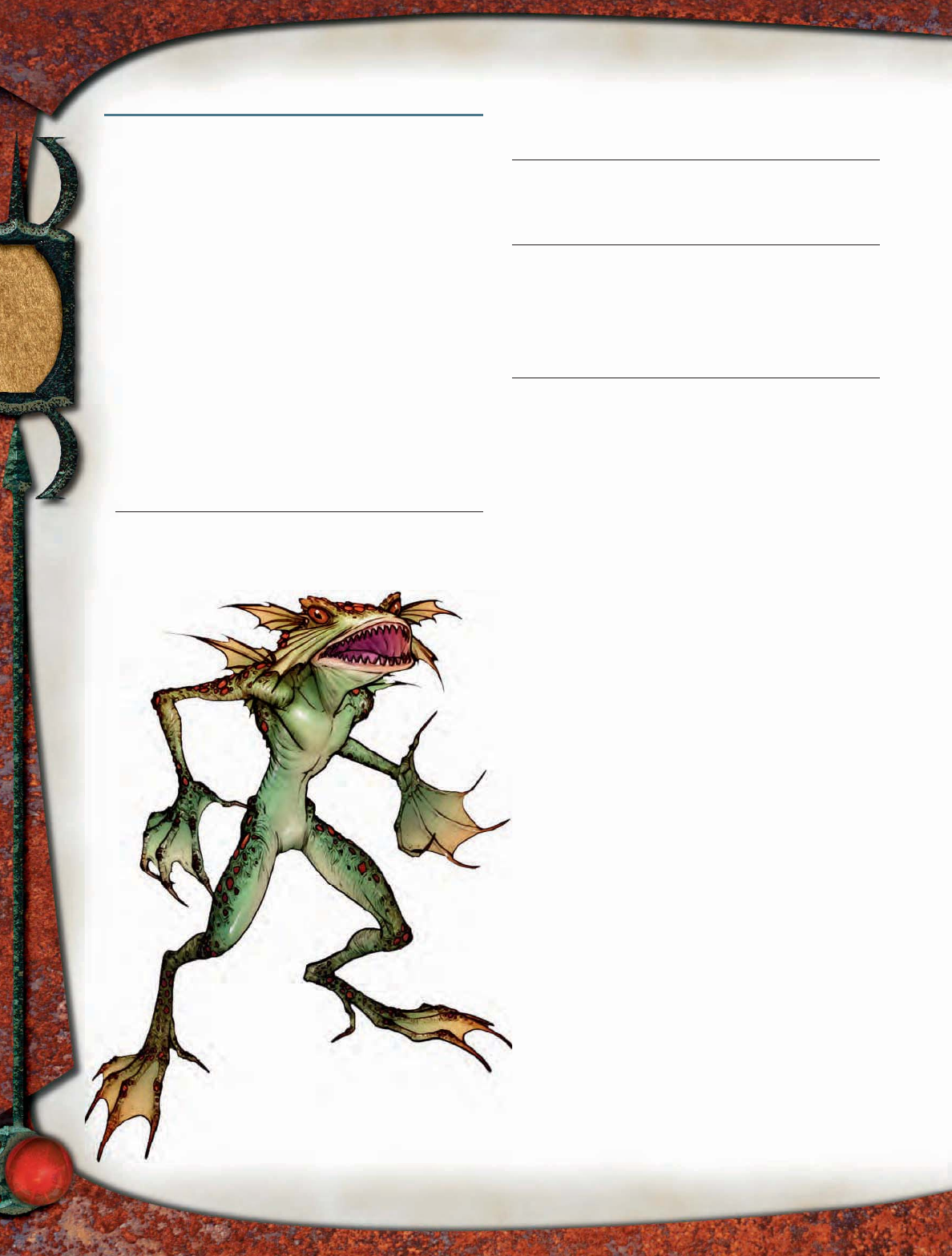
94
KUO-TOA
Kuo-toas are fi shlike humanoids that dwell in the deepest
oceans and subterranean seas. Alien and sinister, these
creatures harbor dark secrets, simmering insanity, and
unreasoning xenophobia.
This section presents fi ve kuo-toas that serve as examples
of this bizarre culture. It also expands on kuo-toa society,
providing glimpses of the madness that boils within the
twisted social order of these monstrous creatures.
Kuo-toas are described beginning on page 163 of the
Monster Manual.
CRAZED KUO-TOA
This fi shlike humanoid’s eyes bulge out, and it shrieks as it charges
you. It swings a massive stone club as if the weapon were as light
as a toothpick.
Crazed Kuo-Toa CR 3
Often CE Medium monstrous humanoid (aquatic)
Init +1; Senses darkvision 60 ft., keen sight; Listen +4,
Spot +9
Languages Kuo-Toan
AC 17, touch 11, flat-footed 16
(+1 Dex, +6 natural)
hp 33 (4 HD); death rage
Immune mind-affecting spells and abilities, paralysis, poison
Resist electricity 10, slippery
Fort +4, Ref +5, Will +3
Weakness light blindness
Speed 20 ft. (4 squares), swim 50 ft.
Melee greatclub +7 (1d10+4)
Space 5 ft.; Reach 5 ft.
Base Atk +4; Grp +7
Atk Options Power Attack
Abilities Str 17, Dex 12, Con 17, Int 9, Wis 8, Cha 8
SA death rage
SQ amphibious
Feats AlertnessB, Power Attack, Toughness
Skills Escape Artist +9, Listen +4, Search +3, Spot +9,
Swim +11
Advancement by character class; Favored Class barbarian
Possessions greatclub
Keen Sight (Ex) Crazed kuo-toas can spot moving objects
or creatures that are invisible or ethereal. Only by
remaining perfectly still can such objects or creatures
avoid notice.
Death Rage (Ex) A crazed kuo-toa that has 10 or fewer hit
points gains a +2 bonus on melee attack rolls and melee
damage rolls.
Slippery (Ex) Crazed kuo-toas secrete an oily film. Webs,
magical or otherwise, don’t affect crazed kuo-toas,
and they can usually wriggle free from most forms of
confinement.
Light Blindness (Ex) Blinded for 1 round in daylight, then
dazzled when still in daylight.
Madness plagues the kuo-toas. Owing to centuries of inbreed-
ing and dedication to a perverse deity, a large number of
kuo-toas are mentally unstable. Some kuo-toas slide over
into utter lunacy, turning into murderous creatures. Crazed
kuo-toas are no larger than their fellows, but their mental
illness makes them animalistic, giving them abnormal might,
agility, and resilience.
Kuo-toa whips use their crazed underlings as disposable
shock troops. In some cases, however, a leader exiles the
insane to areas just outside the main settlement, leaving
them to fend for themselves. The crazed kuo-toas are
then no longer a strain on the community’s resources,
but they still act as that settlement’s outermost ring
of defense.
Strategies and Tactics
Crazed kuo-toas hurl themselves at their enemies, heed-
less of safety. They use Power Attack at its maximum,
reducing their commitment to this tactic only when it
becomes evident it’s costing them the opportunity to
draw blood.
Crazed Kuo-Toas with Class Levels
Crazed kuo-toas rarely survive long enough to advance
in a class, but those that do advance as barbarians.
Barbarian is considered an associated class for a crazed
kuo-toa.
Level Adjustment: +3.
Crazed kuo-toa
KUO-TOA
Illus. by J. Zhang
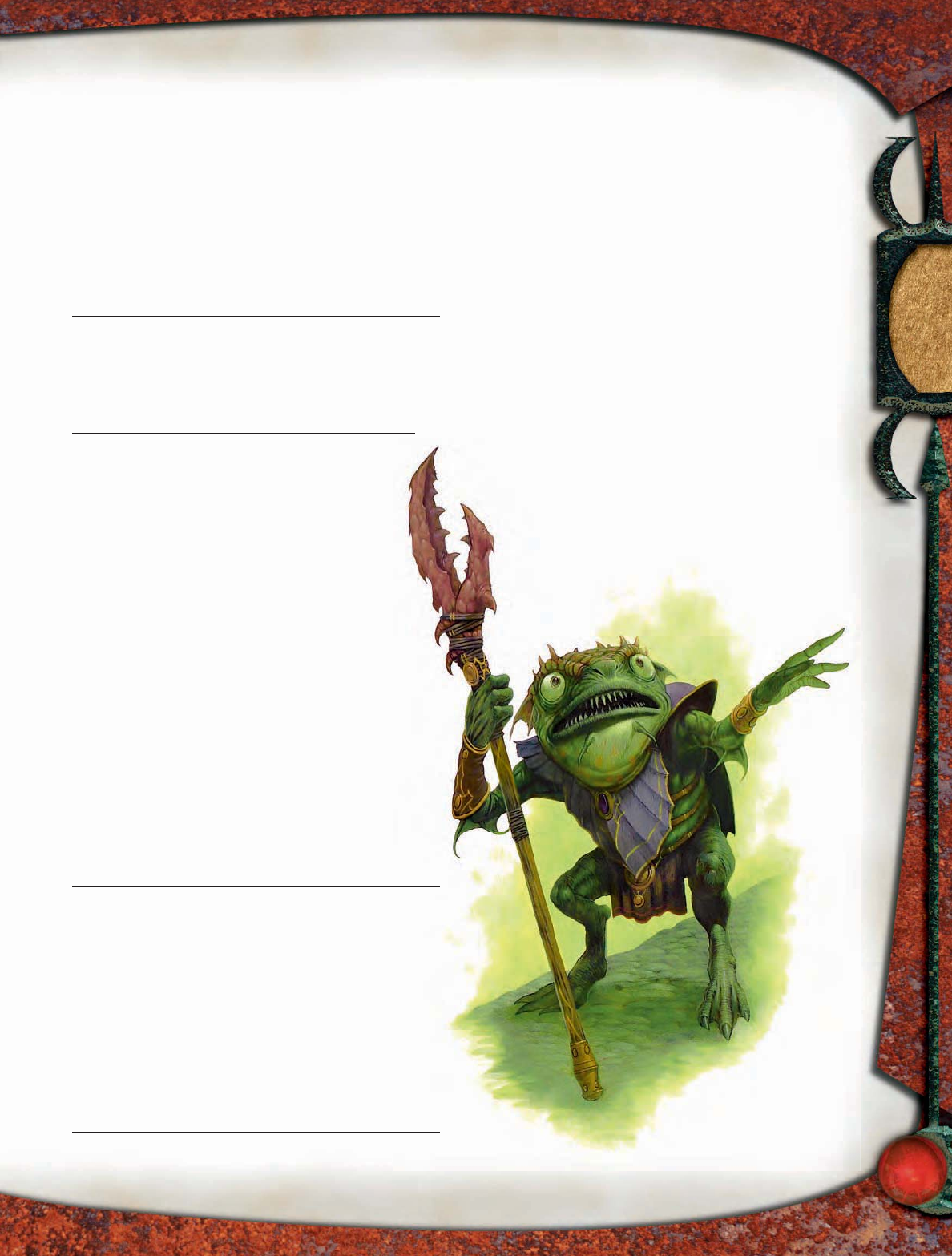
95
KUO-TOA EXALTED WHIP
A red fl ush suffuses this fi shlike humanoid, and armor crafted from
seashells covers its form. It bares its sharp teeth in hatred. One hand
clutches an odd staff with a lobsterlike claw at the top; the other
dances in the complicated gestures of spellcasting.
Kuo-Toa Exalted Whip CR 7
Always NE Medium monstrous humanoid (aquatic)
Init +5; Senses darkvision 60 ft., keen sight; Listen +15,
Spot +19
Aura aquatic might (60 ft.)
Languages Aquan, Kuo-Toan, Undercommon
AC 25, touch 11, flat-footed 24
(+1 Dex, +5 armor, +9 natural)
hp 85 (10 HD); DR 5/good; strength in numbers
Immune paralysis, poison
Resist electricity 10, slippery
Fort +8, Ref +9, Will +13
Weakness light blindness
Speed 20 ft. (4 squares), swim 50 ft.; aquatic escape
Melee +1 pincer staff +17/+12 (1d10+7 plus grapple)
or
Melee mwk dagger +16/+11 (1d4+5)
Ranged mwk light crossbow +14 (1d8+2/19–20)
Space 5 ft.; Reach 5 ft. (10 ft. with pincer staff)
Base Atk +10; Grp +13
Atk Options Power Attack, smite 1/day (+4
attack, +8 damage)
Special Actions lightning bolt, rebuke undead 5/day
(+4, 2d6+10, 8th), rebuke water creatures or turn
fire creatures 5/day (+4, 2d6+10, 8th), spontaneous
casting (inflict spells)
Cleric Spells Prepared (CL 8th):
4th—air walk, infl ict critical woundsD (+13 melee
touch, DC 19), divine power, poison (+13 melee
touch, DC 19)
3rd—bestow curse (+13 melee touch, DC 18),
contagionD(+13 melee touch, DC 18), cure serious
wounds, dispel magic, protection from energy
2nd—bull’s strength, cure moderate wounds, fog cloudD,
hold person (DC 17), spiritual weapon
1st—bless, command (DC 16), cure light wounds, doom
(DC 16), obscuring mistD, protection from good,
sanctuary (DC 16)
0—create water (2), cure minor wounds (2), detect magic (2)
D: Domain spell. Deity: Blibdoolpoolp. Domains:
Destruction, Water.
Abilities Str 16, Dex 12, Con 18, Int 14, Wis 20, Cha 14
SA aura of aquatic might, lightning bolt, spells, rebuke
undead, rebuke water creatures, smite, spontaneous
casting, turn fire creatures
SQ amphibious, divine talent
Feats AlertnessB, Combat Casting, Improved Initiative, Power
Attack, Weapon Focus (pincer staff)
Skills Concentration +14 (+17 casting defensively),
Diplomacy +9, Escape Artist +9, Intimidate +10,
Knowledge (religion) +10, Listen +15, Search +6, Sense
Motive +10, Spot +19
Advancement by character class; Favored Class cleric
Possessions +1 seashell armor (chain shirt), +1 pincer staff,
masterwork dagger, masterwork light crossbow with 20
bolts, cloak of resistance +1, phylactery of faithfulness
Keen Sight (Ex) As the crazed kuo-toa.
Aura of Aquatic Might (Su) All evil aquatic creatures within
60 feet of a kuo-toa exalted whip, including the creature
itself (included in statistics), gain a +2 bonus on attack
rolls and damage rolls. Any evil aquatic creature within
range that is reduced to fewer than 0 hit points can make
a single ranged attack or melee attack as an immediate
action. The effects of multiple auras of aquatic might do
not stack.
Strength in Numbers (Su) A kuo-toa exalted whip draws
strength from fellow kuo-toas. At the start of each of its
turns, an exalted whip heals a number of hit points equal
to the number of kuo-toas within 15 feet of itself.
Slippery (Ex) As the crazed kuo-toa.
Light Blindness (Ex) As the crazed kuo-toa.
Aquatic Escape (Su) Once per day, as a swift action, a kuo-
toa exalted whip can touch a body of water to travel up
to 1 mile to another body of water, transporting up to
100 pounds of other creatures and equipment per Hit
Die with itself. Each body of water must fill a 5-foot
square and be at least 3 feet deep. The destination must
be located in a place the exalted whip has physically
visited before.
Lightning Bolt (Su) An exalted whip can work with other
whips to create a stroke of lightning; see MM 164.
Divine Talent (Ex) Kuo-toa exalted whips cast spells, gain
granted powers from domains, and rebuke undead as
8th-level evil clerics.
Kuo-toa
exalted whip
KUO-TOA
Illus. by W. England
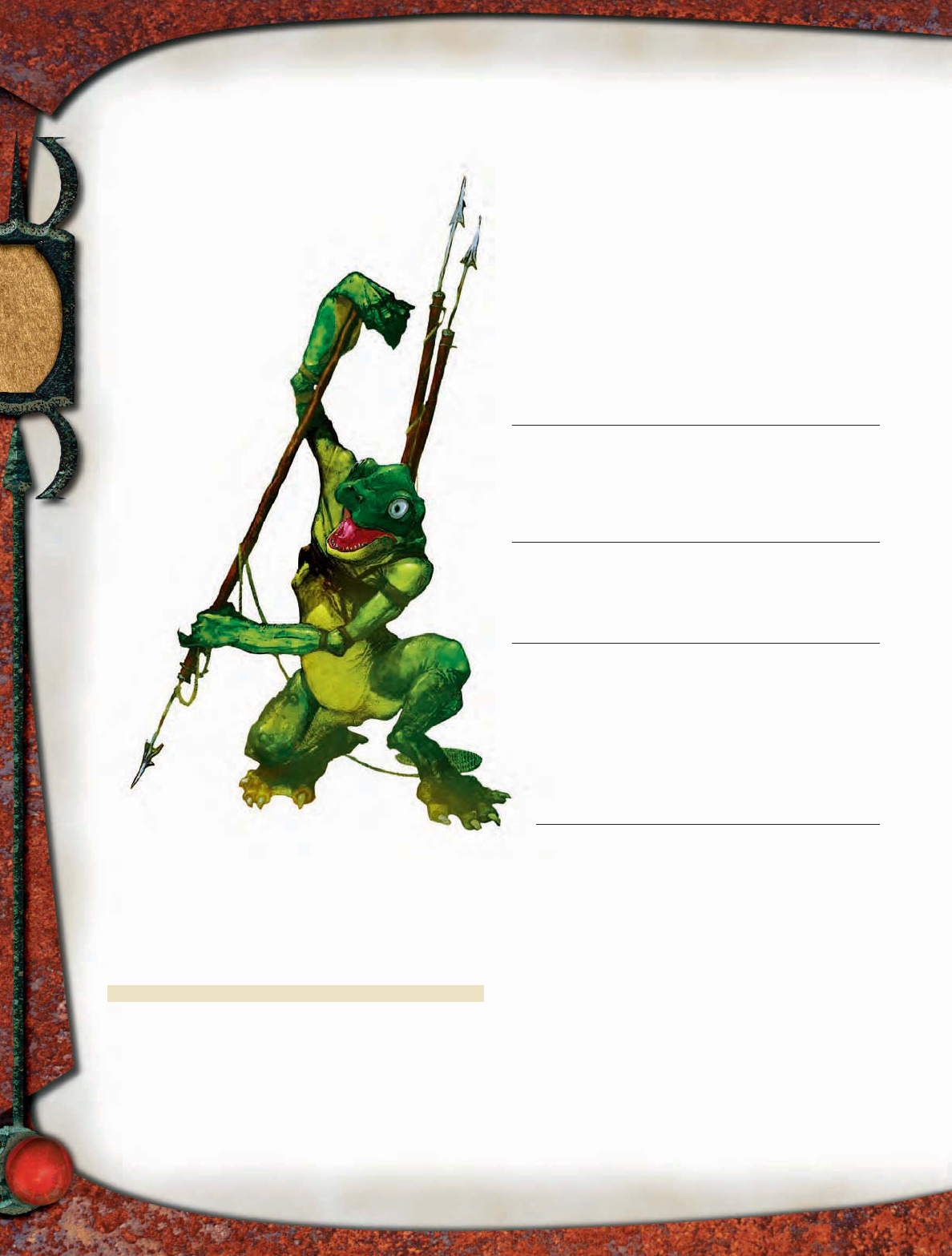
96
Exalted whips are kuo-toas marked for greatness by Blibdool-
poolp. When that goddess is willing, a single kuo-toan egg
in a large settlement hatches an exalted whip. Exalted whips
quickly ascend the kuo-toan hierarchy, combining
physical power with a ruthless intellect.
Strategies and Tactics
Exalted whips lead from the rear. They surround
themselves with as many other
kuo-toas as possible, and they en-
courage the shrines they rule to
grow rapidly. Exalted whips
prefer to use spells such as
hold person to debilitate their
enemies from a distance.
Only if victory seems sure
do they wade into melee.
At the fi rst sign of trou-
ble, an exalted whip
uses aquatic escape to
gather more rein-
forcements. But if
a kuo-toa shrine
faces destruction,
the whips fi ght
to the death.
Exalted Whips with Class Levels
Kuo-toa exalted whips are elite, and they advance as clerics, but
they don’t gain extra domains from doing so. A kuo-toa exalted
whip’s cleric levels stack with Hit Dice to determine spells per
day and the ability to rebuke undead. No class except for cleric
is considered associated for a kuo-toa exalted whip.
Level Adjustment: +4.
KUO-TOA HARPOONER
This fi shlike humanoid has large, staring eyes. The lower jaw of
its wide mouth droops downward as it raises a barbed spear with
its spindly arms.
Kuo-Toa Harpooner CR 4
Male kuo-toa fighter 2
NE Medium monstrous humanoid (aquatic)
Init +3; Senses darkvision 60 ft., keen sight; Listen +9, Spot +13
Languages Aquan, Kuo-Toan, Undercommon
AC 26, touch 13, flat-footed 23; adhesive
(+3 Dex, +4 armor, +3 shield, +6 natural)
hp 32 (4 HD)
Immune paralysis, poison
Resist electricity 10, slippery
Fort +5, Ref +6, Will +5
Weakness light blindness
Speed 20 ft. (4 squares), swim 50 ft.
Melee mwk kuo-toan harpoon +9 (1d10+3)
Ranged mwk kuo-toan harpoon +9 (1d10+3) or
Ranged mwk light crossbow +8 (1d8/19–20)
Base Atk +4; Grp +7
Atk Options Point Blank Shot, Precise Shot
Abilities Str 16, Dex 16, Con 15, Int 14, Wis 14, Cha 6
SQ amphibious
Feats AlertnessB, Exotic Weapon Proficiency (kuo-toan
harpoon)B, Point Blank Shot, Precise Shot, Weapon Focus
(kuo-toan harpoon)B
Skills Appraise +5 (+7 related to Craft), Craft (any one) +9,
Escape Artist +11, Listen +9, Move Silently +8, Search +6,
Spot +13, Swim +11
Possessions +1 studded leather, +1 heavy steel shield, 3
masterwork kuo-toan harpoons, masterwork light
crossbow with 20 bolts
Kuo-toa
harpooner
KUO-TOA
pqqqqqqqqqqqqqqqqqqqqrs
KUO-TOAN HARPOON
The kuo-toan harpoon is an exotic melee weapon that has the
following characteristics.
Range
Cost Dmg (S) Dmg (M) Critical Incr. Wt. Type
15 gp 1d8 1d10 ×2 30 ft. 6 lb. Piercing
A kuo-toan harpoon is a spear that has a barbed metal head. A
slender, 30-foot-long chain runs from the harpoon’s end.
If a kuo-toan harpoon deals damage, the target must succeed
on a Reflex save (DC 10 + the damage dealt) or be harpooned. A
harpooned creature moves at half speed, cannot charge or run,
and must make a DC 15 Concentration check to cast a spell. On
a failed check, it loses the spell.
If a kuo-toa harpooner holds onto the chain, the harpooned
creature must make an opposed Strength check to move more
then 30 feet away from the harpooner. As a swift action, the har-
pooner can wrap his end of the chain around his sticky shield.
In this case, he gains a +5 bonus on the opposed Strength
check. As a standard action, the harpooner can slam his shield
to the ground to seal it in place with the chain still attached.
If the harpooner does so, the harpooned creature is lashed to
within 30 feet of the spot the shield is stuck to and must suc-
ceed on a DC 20 Strength check to escape.
A harpooned creature can pull the harpoon out if it has two
hands free and takes a full-round action to do so. Removing
the harpoon in this way deals 1d10 points of damage to the
harpooned creature. A successful DC 15 Heal check allows the
removal of the harpoon without any additional damage.
pqqqqqqqqqqqqqqqqqqqqrs
Illus. by A. Waters
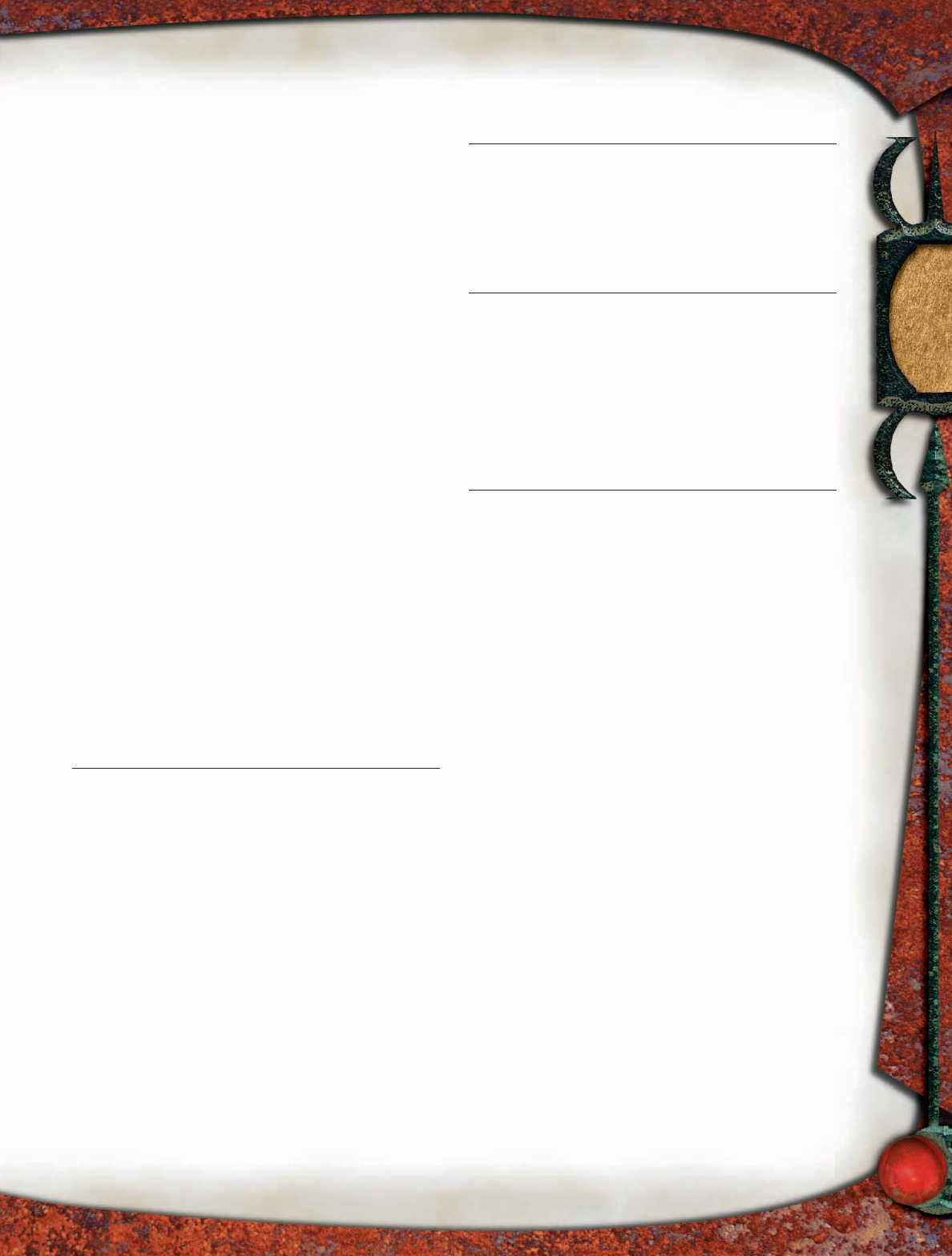
97
Keen Sight (Ex) As the crazed kuo-toa.
Adhesive (Ex) Kuo-toas coat their shields with adhesive.
Those who make unsuccessful melee attacks against a
kuo-toa must succeed on a DC 14 Reflex save, or their
weapon sticks to the kuo-toa’s shield and is yanked
out of their grasp. Creatures using natural weapons are
automatically grappled if they get stuck. The adhesive
remains good until it catches one creature or object,
which uses it up. Pulling a stuck weapon or limb from a
shield requires a DC 20 Strength check.
Slippery (Ex) As the crazed kuo-toa.
Light Blindness (Ex) As the crazed kuo-toa.
Kuo-toa harpooners are elite warriors that help monitors and
whips keep their society functioning. Harpooners capture
and confi ne kuo-toas that slide into madness and threaten
the precarious stability of a kuo-toan settlement. When faced
with invading humans and other threats, harpooners use
their weapons to neutralize and kill attackers.
Strategies and Tactics
Kuo-toa harpooners keep to the edge of a battle, using their
harpoons to capture and neutralize their opponents. The
harpooners usually focus their fi re on a single foe, hoping
to control that enemy and hold it still while the rest of the
kuo-toas swarm in to attack.
KUO-TOA MONITOR
This fi shlike humanoid crouches low. Its wide fi sts are raised in
front of it, and one foot slides forward. In an instant, it is in motion,
speeding forward in long strides.
Kuo-Toa Monitor CR 6
Female kuo-toa monk 4
LE Medium monstrous humanoid (aquatic)
Init +2; Senses darkvision 60 ft., keen sight; Listen +10,
Spot +14
Languages Aquan, Kuo-Toan, Undercommon
AC 24, touch 17, flat-footed 22
(+2 Dex, +5 Wis, +1 armor, +6 natural)
hp 42 (6 HD)
Immune paralysis, poison
Resist electricity 10, evasion, slippery
Fort +7, Ref +10, Will +13 (+15 against enchantment)
Weakness light blindness
Speed 30 ft. (6 squares), swim 50 ft.
Melee unarmed strike +7 (1d8+2) or
Melee unarmed strike +5/+5 (1d8+2) with flurry of blows
Ranged mwk light crossbow +8 (1d8)
Base Atk +5; Grp +7
Atk Options Combat Reflexes, Mind-Shattering Strike
(DC 18), Stunning Fist 4/day (DC 18), ki strike (magic)
Combat Gear potion of bear’s endurance, potion of bull’s
strength, potion of shield of faith (+3)
Abilities Str 14, Dex 14, Con 15, Int 12, Wis 20, Cha 6
SQ amphibious, slow fall 20 ft.
Feats AlertnessB, Combat Expertise, Combat ReflexesB,
Improved Unarmed StrikeB, Kuo-Toan Monasticism*,
Mind-Shattering Strike*, Stunning FistB
* New feat; see sidebar.
Skills Balance +4, Diplomacy +0, Escape Artist +10, Hide +7,
Jump +4, Knowledge (religion) +4, Listen +10, Move
Silently +7, Search +8, Sense Motive +10, Spot +14,
Swim +10, Tumble +10
Possessions combat gear plus bracers of armor +1, cloak of
resistance +1
Keen Sight (Ex) As the crazed kuo-toa.
Slippery (Ex) As the crazed kuo-toa.
Light Blindness (Ex) As the crazed kuo-toa.
Kuo-toa monitors serve as tactical commanders and skilled
melee combatants. Kuo-toan society is full of warriors, and
monitors direct these soldiers against an enemy. Yet monitors
serve a greater purpose. They are the caretakers of kuo-toan
civilization, forming a sort of secret police dedicated to
stamping out madness, controlling kuo-toas who tumble into
insanity, and maintaining order within a shrine.
Strategies and Tactics
A monitor fi ghts alone only if cornered. Otherwise, she relies
on a group of kuo-toa warriors. The monitor dashes forward,
stuns or uses Mind-Shattering Strike against an opponent,
then allows her underlings to charge forward. Monitors
particularly enjoy picking off enemies who have lost their
weapons to the adhesive of a kuo-toa shield.
KUO-TOA
pqqqqqqqqqqqqqqqqqqqqrs
NEW FEATS
Kuo-toa monitors use their own brand of martial arts.
KUO-TOAN MONASTICISM
The monitors learn to use the strange, sticky substance
common to kuo-toas as part of their martial arts. If a monitor’s
first punch hits, it sticks its hand to the target, executes an ac-
robatic tumble, and unfailingly lands its second strike.
Prerequisites: Kuo-toa, flurry of blows.
Benefit: As a swift action, a kuo-toa can smear a strange,
sticky substance on its hands. When using flurry of blows, the
kuo-toa automatically hits with one of its extra attacks if its first
attack hits. A kuo-toa that has this feat uses Hit Dice, rather
than character level, to determine its Stunning Fist save DC.
MIND-SHATTERING STRIKE
Violent madness lurks just beneath the surface in all kuo-toas.
The monitors learn to control this madness and channel it into
their enemies.
Prerequisites: Kuo-toa, Kuo-Toa Monasticism, Stunning Fist,
flurry of blows.
Benefit: Before making an unarmed strike, a kuo-toa monitor
can choose to use this feat, consuming one of the monitor’s daily
uses of the Stunning Fist feat. If kuo-toa monitor’s next unarmed
attack hits, the struck opponent must make a Will save (DC 10 +
1/2 the monitor’s HD + its Wis modifier). On a failed save, that
foe attacks the closest non–kuo-toa on his next turn.
This feat also grants one additional daily use of the Stunning
Fist feat.
pqqqqqqqqqqqqqqqqqqqqrs
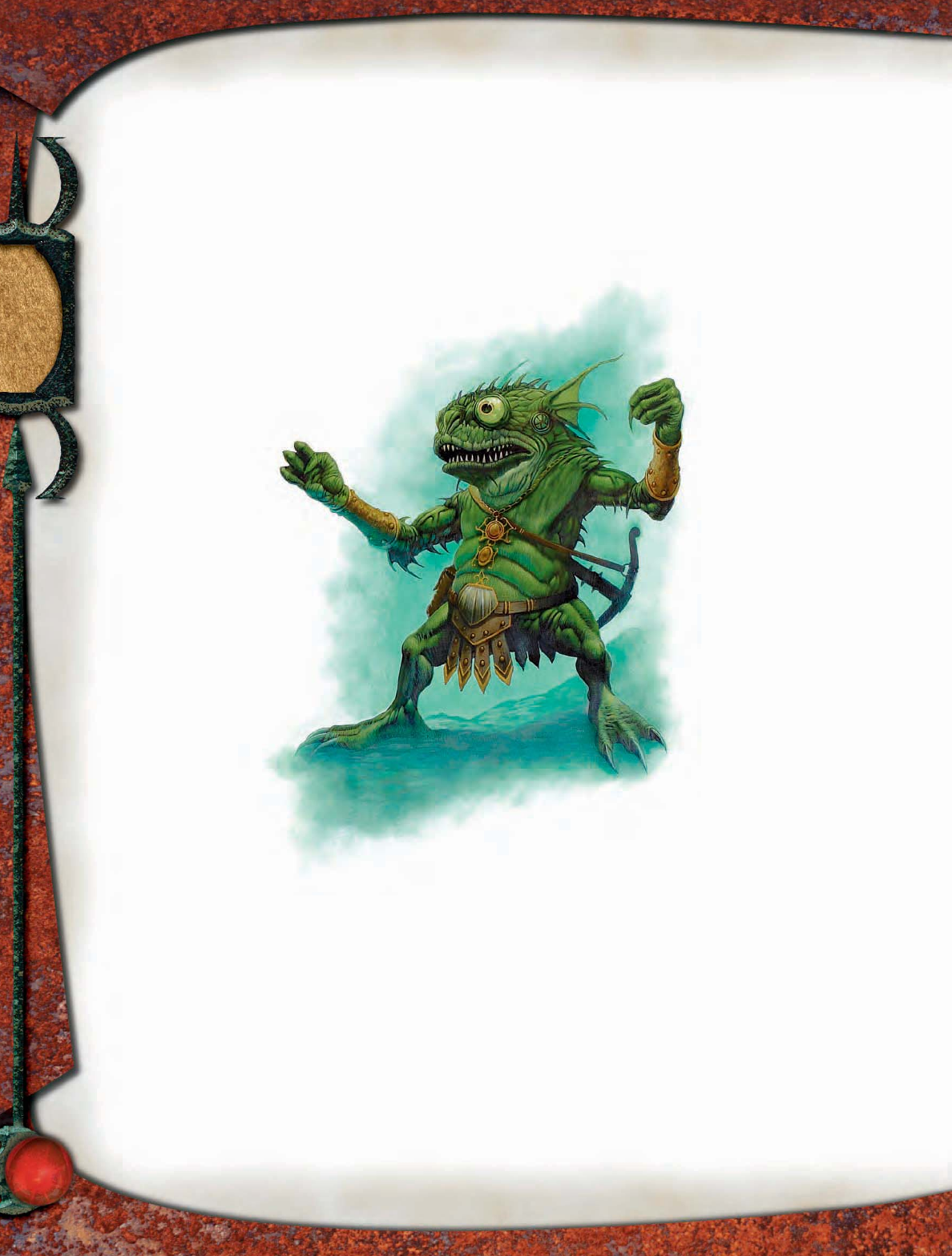
98
Monitors create a deadly combination with their Kuo-Toan
Monasticism feat and Mind-Shattering Strike or Stunning
Fist. If a monitor’s fi rst attack of a fl urry of blows hits, she
uses Stunning Fist or Mind-Shattering Strike to augment
her second sure strike. Against particularly dangerous foes,
she uses both.
ECOLOGY
Kuo-toas are warm-blooded amphibious creatures built for
swimming. Although they breathe air as well as water, they
prefer damp environments with ample pools of water. Their
long legs are not well suited to land mobility, so their hop-
ping movement is usually slower than an average
human’s land speed.
Kuo-toa females lay eggs that are later fertilized
by male kuo-toas, much the way fi sh spawn.
Young kuo-toas hatch from the eggs, look-
ing like a cross between
tadpoles and large fi sh.
When they hatch, they
can breathe only water
and are about 1 foot in
height. Over the next year,
they grow to 3 feet tall and develop
their amphibious qualities.
By the time a kuo-toa reach-
es fi ve years old, it is an adult. A
kuo-toa lives to approximately
sixty years of age.
Environment: Kuo-toas live
in waters within the subterra-
nean reaches of the earth. Rarer
clans live in deep and dark
temperate ocean waters.
Typical Physical
Characteristics:
Kuo-toas are pudgy
and covered with fine
scales. Looking like a
cross between a fi sh and
a frog, they have large
mouths, oversized staring eyes, and long limbs that look
spindly. This appearance is deceptive, because even though
kuo-toas are only about 5 feet tall and weigh 160 pounds, they
are tough and strong.
The most telling feature of kuo-toas is their skin, which
smells like rotting fi sh. Silvery gray in color, the skin of a
kuo-toa changes hue according to the creature’s emotions.
Crazed kuo-toas can change color rapidly, but they are usually
red with agitation and anger.
Alignment: Kuo-toas are selfi sh and greedy, always ready
to bully or mistreat others, including less powerful kuo-toas.
Because of this mindset, only fear of those stronger than they
or of punishment by the authorities in a community keeps
the majority of kuo-toas in line. Smart kuo-toas know that
the way to dominance lies in organization, but those with
power abuse that authority and their underlings to the extent
that they can. They are often neutral evil.
SOCIETY
Kuo-toas dwell in small settlements known as shrines. Each
shrine is dedicated to Blibdoolpoolp, and smaller shrines ra-
diate out from larger settlements. All spaces within a shrine
show evidence of religious fervor, with icons, carvings, and
other works depicting the bizarre god-
dess and rituals of the kuo-toas.
Within the shrines, clerics
known as whips are supreme, rul-
ing over other kuo-toas by divine
right. All kuo-toan leaders are
clerics, though a lot of them
are also practiced in subter-
fuge or other forms of martial
training. A few shrines are
blessed by the presence of
one or more exalted whips,
kuo-toas that are favored by
Blibdoolpoolp to be superior in
every way to their kin. Kuo-toas
high in the chain of command
abuse and intimidate their un-
derlings to instill fear and prevent
scheming for power.
Without the aid of their less-
ers, however, whips would have
trouble controlling the ambi-
tious and calculating masses
of the shrines. Specialized so-
cial classes form the backbone
of the kuo-toan fi ghting forc-
es. Monitors watch over the
population like secret police,
culling the weak, killing or
imprisoning the criminal, and
corraling the mad. Harpooners work as elite soldiers, aiding
the monitors and whips as commanded, remorselessly kill-
ing anything from intruders to other kuo-toas.
Other adult kuo-toas are capable warriors, but they also
work at crafts and trades, the results of which go to support
the shrine or to honor Blibdoolpoolp. Skill and merit deter-
mine an individual’s rise in kuo-toan society. But it’s easier
to plot against and even murder one’s fellows and superiors
to get ahead.
Fear, paranoia, and depravity are as much a part of kuo-toan
culture as religion is. More than a few kuo-toas break under
the strain of living under this cycle of cruelty and suspicion,
becoming unhinged. Others spontaneously descend into mad-
ness during dark rituals dedicated to Blibdoolpoolp. Regardless
of the initial nature of the malady, an insane kuo-toa becomes
a howling, bloodthirsty maniac when attacked or injured.
KUO-TOA
Kuo-toa monitor
Illus. by W. England
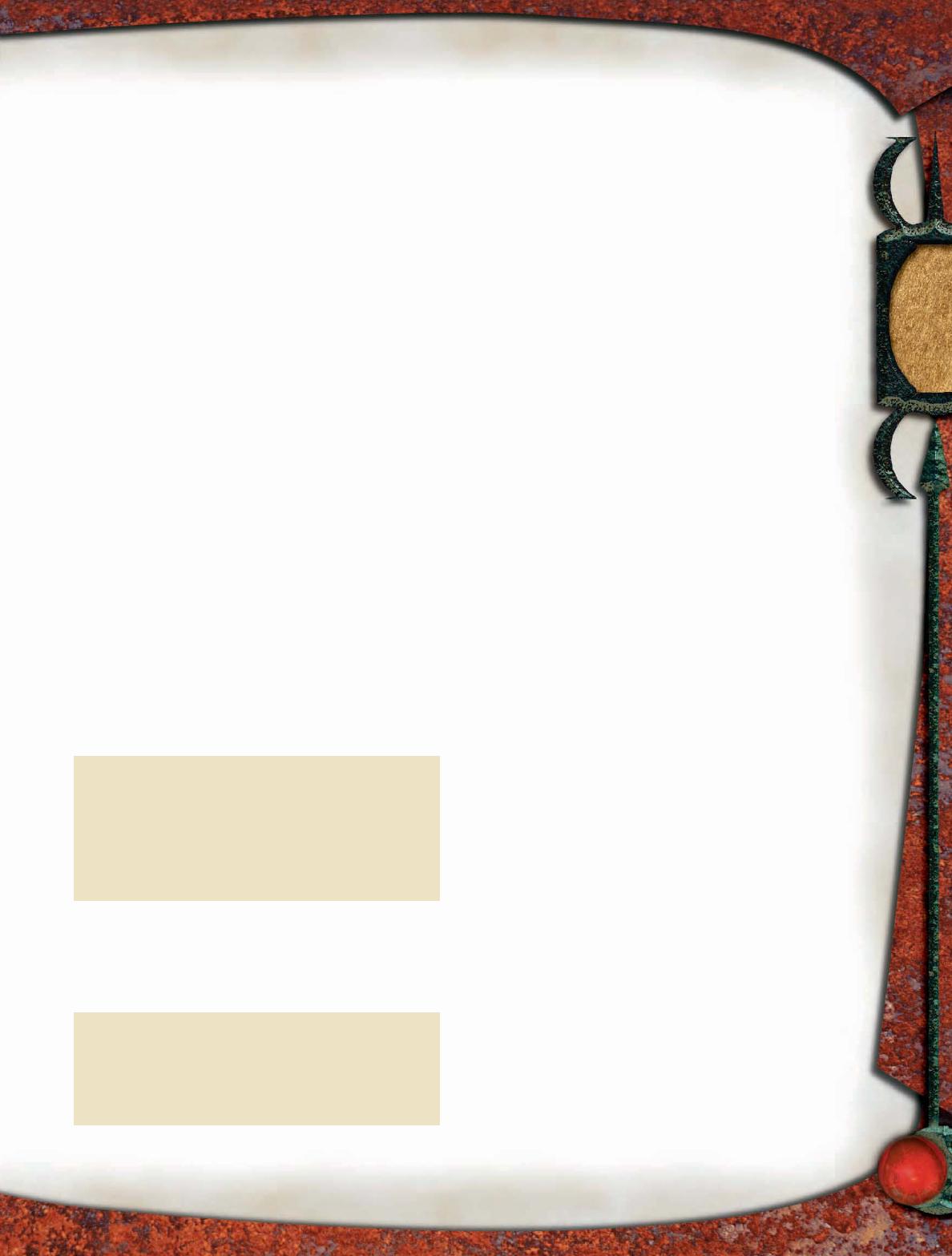
99
Madness on an individual scale poses enough of a risk to
kuo-toan civilization, but kuo-toas face an even worse threat.
Mental illness is contagious among these creatures—like a
disease, emerging lunacy seemingly hops from one kuo-toa
to the next. Those kuo-toas affl icted in this manner adopt the
symptoms and actions of the initial victim. A weaponsmith
in the grip of a psychopathic episode might cut down a
hapless laborer, and some of the kuo-toas who witness the
crime might also enter a psychopathic state. A small cluster
of nearby kuo-toas could soon join a lone one that enters a
fugue. Fortunately for kuo-toas, only about 10% of those who
witness another kuo-toa’s insanity fall victim to the same
mental illness, and only the initial break of a sane kuo-toa
causes others to join the madness. Even moments afterward,
the communal nature of the insanity is gone. But the initial
episode can be enough for a shrine to fall into chaos if the
spread is left unchecked. Monitors, whips, and other disci-
plined kuo-toas seem immune to this problem.
Whips dispatch monitors and harpooners to handle out-of-
control kuo-toas that sometimes run through the community
on murderous sprees or ensnare other kuo-toas in their
broken worldviews. Such an individual is killed, escorted
outside the shrine, or shepherded to a special holding cell
built into the walls of important defensive points in the
settlement. When the shrine comes under assault, those cells
open to unleash dozens of insane kuo-toas upon the attackers.
The screeching of these imprisoned crazed kuo-toas gives
a shrine a chilling aspect, a testament to the degeneracy of
kuo-toan society.
TYPICAL TREASURE
Kuo-toas collect coins for trade, and they make icons and
art dedicated to Blibdoolpoolp. Whips and monitors have a
particular interest in magic items. Kuo-toas have standard
treasure for their Challenge Rating, and elite members of
kuo-toan society have standard equipment for NPCs of their
Challenge Rating.
KUO-TOAS WITH CLASS LEVELS
Kuo-toas typically advance as rogues, but harpooners are
fi ghters, monitors are monks, and whips are clerics. Kuo-toa
leaders often take levels in cleric and rogue, combining dedi-
cation to Blibdoolpoolp with abilities that provide an easier
means to get ahead in the devious kuo-toan social order. All
these classes are associated classes for kuo-toas.
Kuo-toa clerics worship Blibdoolpoolp, who provides access
to the domains of Destruction, Evil, and Water.
Level Adjustment: +3.
KUO-TOAS IN EBERRON
Since the Age of Demons, kuo-toas have swum the unfathom-
able seas and twisting waterways of Khyber. They have forgotten
more dark secrets than the wise on Eberron’s surface know,
and they harbor knowledge that more than one power-hungry
magician might kill for. Their perverse society is dedicated to
the coiling Dragon Below, their madness rooted in creatures and
enigmas extant long before the daelkyr crippled the Dhakaani
Empire. Kuo-toan civilization is dominant in the subterranean
reaches under Khorvaire, where they make hideous deals
with the children of the lords of Xoriat, emerging only to sell
Khyber dragonshards to those brave or wicked enough to deal
with them. Kuo-toan realms also exist in Khyber underneath
Aerenal, Xen’drik, and in nearby oceans, but they are absent
below the continents of Sarlona and Argonnessen.
KUO-TOAS IN FAERÛN
Kuo-toas dwell in the Underdark, where they live in a theo-
cratic society dedicated to Blibdoolpoolp, whom they call
the Sea Mother. (It is rumored, however, that a few kuo-toas
have turned from the Sea Mother to Shar and her Shadow
Weave.) In Faerûn, kuo-toas are closely allied with the drow,
going so far as to treat dark elves and their slaves as honorary
kuo-toas. Every other race the kuo-toas treat as inferior or
as prey. The kuo-toas of the Underdark have a sacred shrine
known as the Holy Mother Cauldron to which every kuo-toa
travels at least once in its life. Another major settlement is
Sloopdilmonpolop, a major trading center and source of water
in the Old Shanatar region of the Underdark under Tethyr’s
Firedrake Bay. For more information on kuo-toas in Faerûn,
see the Underdark supplement.
pqqqqqqqqqrs
KUO-TOA LORE
Characters who have ranks in Knowledge (nature) can learn
more about kuo-toas. When a character makes a successful
skill check, the following lore is revealed, including the infor-
mation from lower DCs.
Knowledge (Nature)
DC Result
12 Kuo-toas are amphibious, fi shlike humanoids that
have a complex society that exists underground
and in the lightless depths of the sea. They are
sinister, but they know much about the hidden
truths and places in the world. Kuo-toa skin
secretes a substance that makes the creatures
diffi cult to grab. They distill this substance into a
gluelike material that they apply to their shields,
allowing them to trap opponents’ weapons.
17 Kuo-toas fi ght with strange weapons designed
to incapacitate rather than kill. They love to
take slaves and sacrifi ces for their goddess, Blib-
doolpoolp. Their society is divided into a hierarchy
of slaves, citizens, warriors, and priests. They are
immune to poison and paralysis, and resistant to
electricity. They can’t stand bright light.
22 The sensitive eyes of kuo-toas can spot the
movement of an invisible creature. Their clerics,
known as whips, can work together to produce
lightning bolts. Blibdoolpoolp sometimes blesses
a kuo-toa clan with the birth of an exalted whip, a
monstrously powerful creature with the power to
aid evil aquatic creatures.
pqqqqqqqqqrs
KUO-TOA

100
MALASTOR
An enormous creature covered in plates of stone bursts from the
ground before you. It rears up on its rear limbs to swing two great
claws in your direction as it gnashes its teeth.
Malastor CR 16
Usually CE Gargantuan magical beast
Init +6; Senses blindsight 1,200 ft., tremorsense 1,200 ft.;
Listen +18, Spot +15
Languages —
AC 34, touch 8, flat-footed 32
(–4 size, +2 Dex, +26 natural)
hp 290 (20 HD)
Fort +21, Ref +14, Will +13
Speed 50 ft. (10 squares), burrow 50 ft.
Melee bite +27 (3d8+10/19–20) and
2 claws +22 each (3d6+5/19–20)
Space 20 ft.; Reach 20 ft.
Base Atk +20; Grp +42
Atk Options Combat Reflexes
Special Actions avalanche wave, stunning roar
Abilities Str 30, Dex 14, Con 28, Int 2, Wis 20, Cha 10
SA avalanche wave, stunning roar
Feats Combat Reflexes, Improved Critical (bite), Improved
Critical (claw), Improved Initiative, Iron Will, Weapon
Focus (bite), Weapon Focus (claw)
Skills Listen +18, Spot +15
Advancement 21–30 HD (Gargantuan); 31–40 HD (Colossal)
Avalanche Wave (Su) A malastor can attack at range by
reaching into the earth with its powerful claws and
sending a shock wave through the ground. A 10-foot-
tall wave of earth moves in a 400-foot line, dealing 8d6
points of damage (Reflex DC 22 half). Those who fail the
save are also buried under rubble and debris. A buried
creature takes 1d6 points of nonlethal damage per
minute. One creature can uncover another in 4 minutes
(or see Cave-Ins and Collapses, DMG 67–68). A buried
creature can free itself with a DC 25 Strength check. The
save DC is Dexterity-based.
A malastor can adapt its avalanche wave to hurl a
chunk of earth at a flying creature up to 400 feet above
the ground. When doing so, the malastor can target
only one creature. The Reflex save has the same DC,
and a successful hit brings the flyer to earth and buries
it as normal.
The avalanche wave functions only on normal earth,
though the presence of vegetation doesn’t affect it.
Stunning Roar (Su) Whenever it takes hit point damage for
the first time in a round, a malastor emits a dreadful roar
as an immediate action. Those within a 30-foot-radius
spread must succeed on a DC 26 Fortitude save or be
stunned for 1 round. The save DC is Charisma-based and
includes a +6 racial bonus.
Malastors spend most of their lives sleeping in the ground,
emerging occasionally to feed or breed. When they do emerge,
they devastate large areas of the countryside.
STRATEGIES AND TACTICS
A malastor is violent and eagerly initiates fi ghts. Despite its
apparent stupidity, it adapt its tactics and uses its burrow
speed to fl ee if it is losing.
When fi ghting opponents with shorter reach, a malastor
advances to bring the opponents just within its own threat-
ened area. This allows the malastor to attack freely, but an
opponent closing to attack must leave a threatened square. A
malastor has Combat Refl exes, allowing it to use this tactic
with multiple enemies in a given round.
A malastor has no control over its stunning roar, which
is an instinctive reaction to damage. However, it does take
advantage of the effect of the roar, concentrating its attacks
on stunned opponents.
Malastors prefer to use melee attacks, but their avalanche
wave ability allows them to attack enemies at a distance.
Blindsight lets them attack invisible enemies as well. A
malastor that has been injured by a spellcaster might focus
its attacks on that character, using avalanche wave, then
moving away from any melee opponents. This tactic can
force melee opponents to provoke attacks of opportunity
again when they move within its reach, giving the creature
the best of both worlds.
SAMPLE ENCOUNTER
A malastor is encountered only when it emerges from the
earth to feed or mate (see Ecology). Finding any malastor is
easy—just follow its path of destruction.
Mated Pair (EL 18): Almost a year ago, a male and a female
malastor devastated the countryside to build the incubation
heap for their eggs. Since then, they have been guarding
the enormous heap, waiting for the eggs to hatch—and
the time has almost come. If the PCs can defeat the adult
malastors, they might be able to destroy the eggs. If not, the
destruction the parents wrought could pale in comparison
pqqqqqqqqqrs
MALASTOR LORE
Characters who have ranks in Knowledge (nature) can learn
more about malastors. When a character makes a successful
skill check, the following lore is revealed, including the infor-
mation from lower DCs.
Knowledge (Nature)
DC Result
26 This is a malastor, a magical beast with a rocky
hide. Malastors have blindsight out to an
incredible distance and are very perceptive. It is
almost impossible to sneak up on them.
31 A malastor can create a tremendous wave of earth
that can bury its foes.
36 Whenever a malastor is wounded, it emits
a terrible roar that can stun those around it,
although this effect soon wears off. A malastor is
wily enough to attack stunned opponents.
pqqqqqqqqqrs
MALASTOR
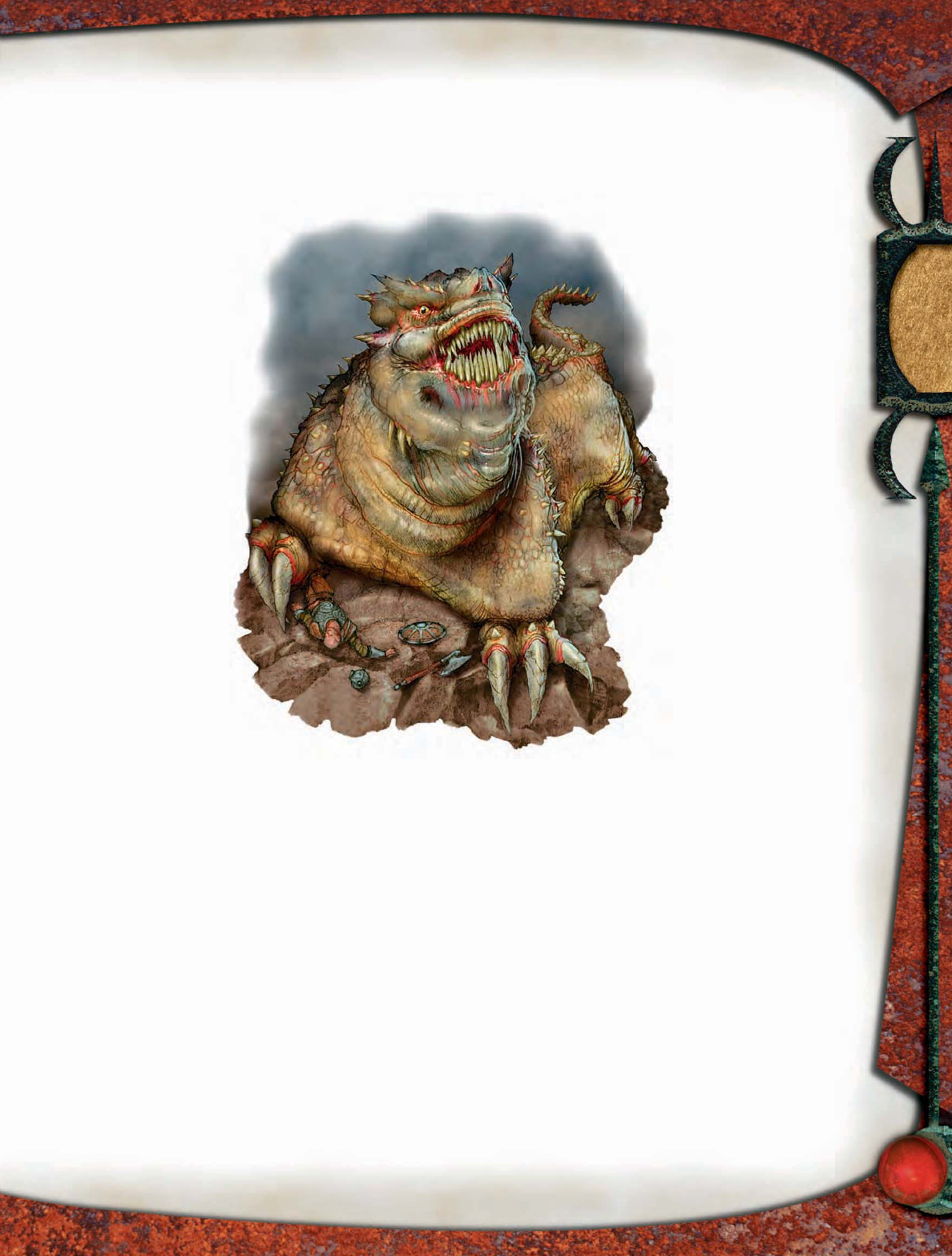
101
to what follows when four young, reckless malastors are
set loose.
The adult malastors attack anyone who comes within 30
feet of the heap or attacks it, pursuing and slaying those who
fl ee. The parents split up to deal with various threats.
ECOLOGY
Malastors are destructive pred-
ators that sit comfortably at
the top of the food chain.
It is fortunate for all other
creatures that they spend
nine-tenths of their lives
asleep, burrowed into the
ground.
An average malastor
emerges from the ground
once per year to feed, cut-
ting a swath of destruction
as it does so. Normally, a
malastor spends ten to
twenty days feeding and
moving across the land
before burrowing back
into the ground.
Once in every hu-
man generation, a
malastor is instinctu-
ally driven to mate. It
leaves the ground and
wanders, looking for a
malastor of the opposite
sex. While wandering, a
malastor is much less destruc-
tive than normal, and it avoids even
small settlements.
This behavior changes when the creature meets its mate.
The pair devastates the surrounding area, piling dead animals
and vegetation into an enormous, rotting heap, within which
the female lays her eggs. The warmth of the heap incubates
the eggs, while the organic material there provides the fi rst
food for the newly hatched malastors. The two parents then
stand guard over the heap for the year it takes the eggs to
mature and hatch. During this period, they are hostile to
anyone approaching the mound, but do not range far from
the heap.
When the parents hear the telltale sounds of the hatching
offspring, they fl ee in different directions, normally running
for at least two days before burying themselves in the earth.
At about the same time, between two and four new malastors
start eating their way out of the incubation mound. They
are full size, thanks to the prepared food, but ravenous, and
split up to spend ten to twenty days eating before burying
themselves in the ground to start the cycle again.
Environment: Malastors prefer temperate plains and
hills, although they are occasionally found in temperate
forests and warm plains. Deserts and mountains almost
never provide enough food for them, although a malastor
looking for a mate might decide to cross such terrain. The
creatures do not like the cold, so they stay
out of cold regions.
Malastors cannot burrow
through hard rock, so they sleep
in areas with deep soil, or with
sandstone and similar soft-
er rocks. While feeding or
searching, however, they
cross any sort of terrain,
leaving devastation be-
hind them.
Typical Physical Char-
acteristics: A malastor
has four limbs, a pow-
erful body, and a head
with a blunt snout. Its
body is covered with
plates of stone, which
form as it sleeps in the
earth, but under the ar-
mor it is flesh and blood.
The color of the plates depends
on the environment where the
malastor last slept, but they
are often the warm orange of
sandstone.
The two rear limbs are
quite close together. The
front pair is much farther for-
ward and somewhat longer. Each
fore limb ends in enormous claws, which a
malastor uses to great effect in combat. These claws also
enable it to burrow and to scoop earth from the ground
to hurl at its enemies.
When fi ghting, a malastor rears up on its hind legs and
stands about 40 feet tall. Most malastors weigh around 40
tons, but larger specimens exist.
Alignment: Malastors enjoy spreading destruction and
have no sense of the importance of organization, so most are
chaotic evil.
TYPICAL TREASURE
Malastors have no interest in treasure. The reward for
defeating a malastor often comes from the grateful people
the victors have saved. Mated pairs of malastors have half
standard treassure, which can be found among and on the
corpses in the birthing heap.
Malastor
MALASTOR
Illus. by A. Swekel

102
MERCHURION
A metal colossus strides through the trees, its form shifting and
fl owing like liquid. The creature moves with a grace that belies its
powerful humanlike form, and you see that its metallic sheen is
no suit of armor. Its eyes bear the same gleam as the rivers of silver
running down its arms, which fl ow together to take the shape of
a vicious battleaxe.
Merchurion CR 17
Usually CE Huge construct (living construct)
Init +7; Senses darkvision 60 ft., low-light vision; Listen +10,
Spot +10
Languages Common, Giant, Terran
AC 31, touch 15, flat-footed 24; Dodge, Mobility
(–2 size, +7 Dex, +16 natural)
hp 319 (22 HD); DR 10/magic and silver
Immune fire, living construct immunities
Weakness vulnerability to sonic
Fort +16, Ref +14, Will +11
Speed 60 ft. (12 squares); Spring Attack
Melee +3 silvered battleaxe +28/+23/+18/+13 (3d6+12)
Space 15 ft.; Reach 15 ft.
Base Atk +16; Grp +33
Atk Options Awesome Blow, Cleave, Improved Bull Rush,
Power Attack, absorb properties, magic strike
Special Actions generate weapon
Abilities Str 28, Dex 25, Con 28, Int 10, Wis 14, Cha 17
SA absorb properties, generate weapons, magic strike
SQ living construct traits
Feats Awesome Blow, Cleave, Dodge, Greater Weapon Focus
(generated weapon)B, Improved Bull Rush, Iron Will,
Mobility, Power Attack, Spring Attack, Weapon Focus
(generated weapon)B
Skills Climb +17, Intimidate +12, Jump +29, Listen +10,
Spot +10, Survival +11
Advancement 23–26 HD (Huge); 27–34 HD (Gargantuan)
Absorb Properties (Ex) If a merchurion is successfully struck
by a magic weapon, all that weapon’s properties are
absorbed by the merchurion for 1 hour. The weapon loses
its properties during that time (or until the merchurion is
slain). A merchurion can manifest any of these absorbed
properties in its generated weapon.
A merchurion can absorb and manifest weapon
properties totaling a +5 enhancement bonus (DMG 223)
or a market value of up to 50,000 gp. Properties beyond
these limits are not absorbed. If a weapon has properties
in excess of these limits, the weakest properties are
absorbed first.
As an immediate action, a merchurion can choose to
give up absorbed properties to absorb new properties.
If it does so, the properties the merchurion gives up are
restored to the weapon they were absorbed from.
Manifested weapon properties must be suitable for
the type of weapon a merchurion generates. Unsuitable
properties can be absorbed and count toward the total
limit of properties even if they cannot be manifested.
For example, a merchurion could absorb the disruption
property from a mace of disruption, but could not
manifest that property in a battleaxe.
A merchurion does not absorb the enhancement
bonus from a weapon whose properties it absorbs. So,
weapons that lose properties continue to function with
their magical enhancement bonus as normal.
Generate Weapon (Su) A merchurion can spontaneously
create a single weapon from its flowing metal form. Such
weapons have a +3 enhancement bonus and are treated
as silvered weapons for the purpose of overcoming
damage reduction. If a generated weapon ever leaves the
merchurion’s hand, that weapon immediately melts into
a pool of harmless silver liquid.
A merchurion is proficient with any weapon it
generates using this ability, even an exotic one.
Legends speak of the merchurions, an ancient race of fi re
giants in the service of Surtur. Master metalsmiths, they
were charged by the Lord of the Fire Giants with creating
weapons that surpassed even the adamantine axes of the
dwarves in combat. After decades of toil, the giants had
produced only a strange slag of mercurial metal. Surtur
was furious, savagely hurling all his followers into the
magma rift that held their creation. The giants were not
slain, however, emerging instead as construct creatures of
living quicksilver.
STRATEGIES AND TACTICS
Merchurions are confi dent of their abilities in combat, and
they waste no time before wading into the thick of melee. A
merchurion uses Awesome Blow to scatter its foes, forcing
them to spend time getting back into position before they
can attack again. Whenever possible, a merchurion targets
opponents wielding magic weapons in the hope of absorbing
those weapons’ properties. The living contruct might even
bull rush through one foe to get at another. It fashions arma-
ments to suit its tactics, using two-handed reach weapons to
keep opponents at bay or fi ghting with smaller weapons in
confi ned spaces.
pqqqqqqqqqrs
MERCHURION LORE
Characters who have ranks in Knowledge (arcana) can learn
more about merchurions. When a character makes a success-
ful skill check, the following lore is revealed, including the
information from lower DCs.
Knowledge (Arcana)
DC Result
27 This rare and reclusive creature is no giant,
but a merchurion—a powerful hulking menace
of living metal. This result reveals all living
construct traits.
32 Merchurions have the ability to shape magic
weapons from their own bodies, but foes who
engage these creatures in melee do so at their
peril. Magic weapons that strike a merchurion
have their properties absorbed and utilized in the
creature’s own attacks.
37 A slain merchurion immediately collapses to a
pool of silvery liquid that retains some of the
creature’s magical essence. Weapons dipped in
this liquid become silvered and strike as magic
weapons against the toughest creatures.
pqqqqqqqqqrs
MERCHURION
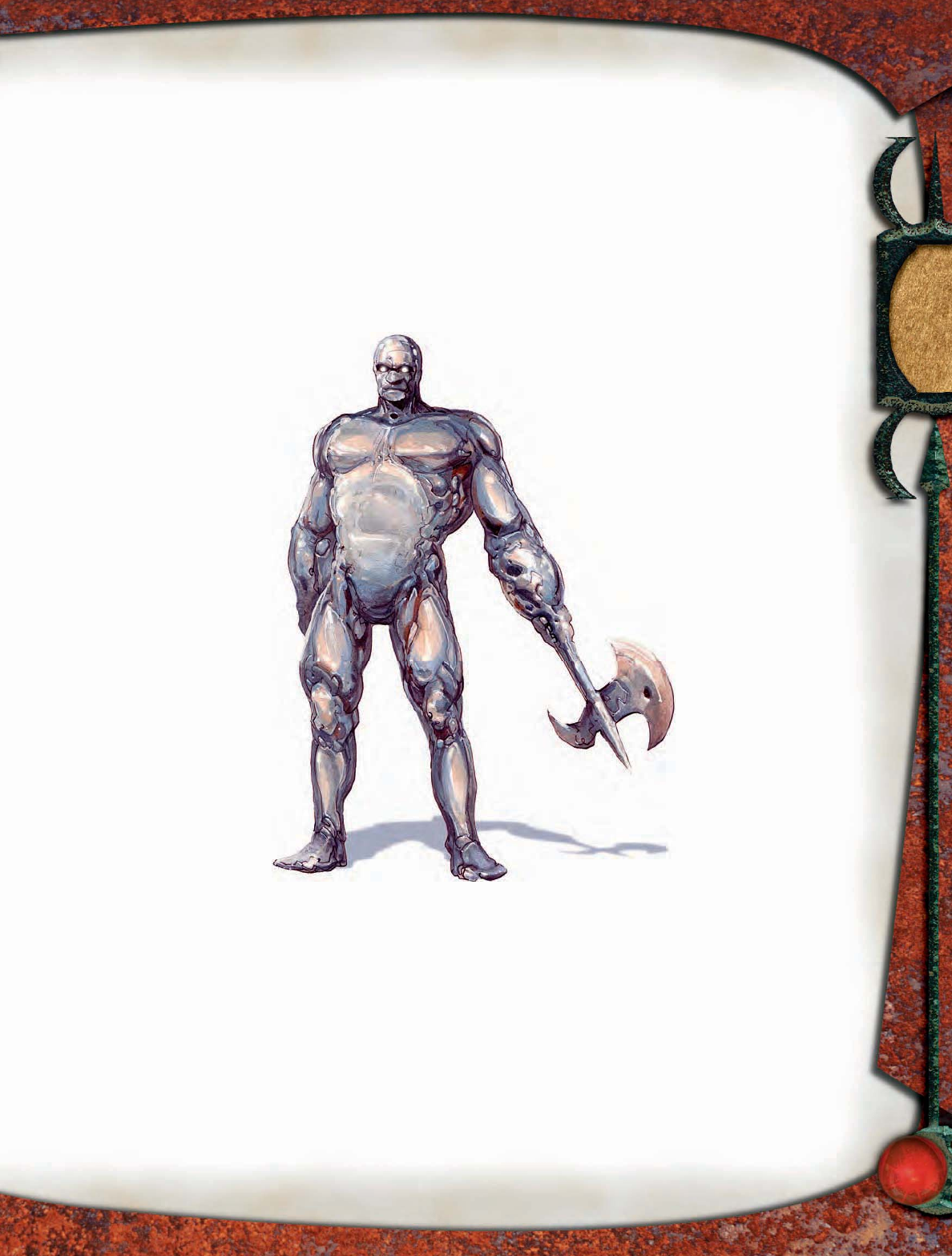
103
SAMPLE ENCOUNTER
Merchurions are rare creatures that are usually solitary.
They do form bands, but such groups have fewer than six
members at a time.
Frontier Raider (EL 17): A merchurion is attacking a
series of forts guarding a giant-infested mountain pass. The
creature seems intent on acquiring the forts’ metal munitions,
but its doing so could leave the pass all but defenseless against
a massive giant incursion. The PCs are charged with putting
an end to the creature’s rampage.
ECOLOGY
Merchurions are driven by their peculiar diet.
They devour metal, with silver being their
meal of choice. Though, as living constructs,
merchurions have no need to eat, their
mysterious craving dictates the di-
rection of their wandering and the
locations of their settlements.
Like other living constructs, mer-
churions do not reproduce. Rather,
every merchurion in the world is
one of the original members of
this race, created in ages past. A
dying race, these creatures pro-
duce no progeny.
Environment: Merchurions
favor warm environs, and most
of them inhabit the interiors of
volcanic mountains. Others re-
main even farther beneath the
surface of the earth. Individual
merchurions can be found roam-
ing everywhere but in arctic climes,
seeking lost mines, ancient treasure
hoards, and the like.
Typical Physical Character-
istics: Merchurions appear well
muscled, and their rippling
silvery forms fl ow like liquid
metal. They are far larger than
the fi re giants they are suppos-
edly descended from, standing 20 feet tall and weighing
twelve tons.
Alignment: Merchurions are disdainful of all would-be
foes, especially true giants. They are virtually impossible
to parlay with, neither asking for nor granting quarter in
combat. Merchurions embrace a life of change and transfor-
mation, and they hate all other creatures. They tend strongly
toward chaotic evil as a result.
SOCIETY
Merchurions are reclusive, shunning the company of
other creatures and withdrawing into the volcanic inner
reaches of the earth. Their lives are centered around an
obsession with discovering a way to create more of their
number. Merchurions seek allies with knowledge of crafting
constructs in the hope of one day creating new genera-
tions of their kind.
These living constructs scorn other races as inferior. They
are envious only of fi re giants, whom merchurions view as
Surtur’s chosen. Merchurions have a deep sense of shame
over their failure and punishment by Surtur. These mixed
feelings turn to bloodshed whenever merchurions and fi re
giants meet.
TYPICAL TREASURE
Merchurion lairs rarely contain metal of any kind, since such
material is eaten as quickly as it is found. But merchurions still
have standard treasure, made up of gems and nonmetallic
magic items.
FOR PLAYER CHARACTERS
When a merchurion is slain, it collapses to a pool
of silver liquid that evaporates harmlessly after
24 hours. Any weapon dipped into this pool
undergoes a permanent change, becoming
silvered and striking as a magic weapon (if
not already magic) for the purpose of over-
coming damage reduction.
MERCHURIONS
IN EBERRON
The merchurions of Eb-
erron are an ancient
race whose origins are
shrouded in mystery,
but which is no doubt
connected to the ancient
creation forges of Xen’drik.
Merchurions have ranged far
from the shattered land in
the countless centuries
since their creation, and
one extended tribe now
serves a powerful silver dragon
named Azraxror-Shien on Argonnessen.
A neutral good merchurion named Silverfi st resides in
Thrane. The creature converted to the faith of the Silver Flame
and is recognized as an icon by some clergy. His place in the
church remains a source of debate.
MERCHURIONS IN FAERÛN
In recent years, adventurers delving beneath the volcanic
areas of Chult have returned with tales of giant creatures
of liquefi ed metal dwelling deep within the earth. These
merchurions are rumored to covet metal and magic.
Merchurion
MERCHURION
Illus. by C. Critchlow

104
MIND FLAYERS OF THOON
Mind fl ayers have long explored the cosmos beyond their
underground lairs, traveling the Inner Planes and Outer
Planes aboard vessels they call nautiloids. One such vessel, on
a mission of exploration over a century ago, traveled farther
than others. Setting a course for the uncharted reaches of
the Astral Plane, the mind fl ayers crossed over into the Far
Realm, a place of madness and disorder.
They returned or, perhaps, were sent back dramatically
changed, capable of great feats of construct crafting and selec-
tive breeding. Though the physical changes were dramatic,
the more profound change was to the very consciousness of
those illithids. They now speak reverently of a being/god/
philosophy known to them as Thoon. The mind fl ayers of
Thoon claim to be able to commune with this presence from
the Far Realm, as well as receive instructions from it.
So far those “instructions” haven’t demonstrated any long-
term purpose. The mind fl ayers of Thoon have traversed
the planes, moving from place to out-of-the-way place and
gathering a mysterious substance they call “quintessence.”
After collecting this substance from captured creatures and
rare materials, the mind fl ayers of Thoon either store it in
glowing ovoid structures called matrices or use it to power
their constructs and bizarre creatures.
Most mind fl ayers of Thoon are identical to the mind fl ayers
described in the Monster Manual, but others have been twisted
by their time in the Far Realm or through experimentation
with quintessence. This entry describes the altered illithids,
along with their humanoid spies, construct servitors, and the
Thoon elder brain.
Because of their strong connection to mind fl ayers, the non-
illithid creatures described in this section require Knowledge
(dungeoneering) for their lore checks instead of the typical
skill. Because of the secrecy and obscurity of this cult, many
lore DCs are also higher than normal. To even know the word
“Thoon” requires a DC 20 Knowledge (dungeoneering) check,
which is assumed in the lore entries.
THOON DISCIPLE
This human-shaped creature has an octopuslike head with four
lashing tentacles. It is clad in ornate, heavy armor and wields
a flail.
Thoon Disciple CR 10
Mind flayer cleric 4
NE Medium aberration
Init +5; Senses darkvision 60 ft.; Listen +13, Spot +13
Languages Undercommon; telepathy 100 ft.
AC 23, touch 11, flat-footed 22
(+1 Dex, +9 armor, +3 natural)
hp 90 (12 HD)
SR 25
Fort +9, Ref +4, Will +15
Speed 20 ft. (4 squares) in full plate, base speed 30 ft.
Melee 4 tentacles +11 each (1d4+1) or
Melee heavy flail +12/+7 (1d10+2/19–20)
Space 5 ft.; Reach 5 ft.
Base Atk +9; Grp +10
Atk Options Improved Disarm, improved grab
Special Actions extract, mind blast, rebuke undead 7/day (+6,
2d6+8, 4th)
Cleric Spells Prepared (CL 4th):
2nd—cure moderate wounds, hold person (2) (DC 17),
spiritual weaponD
1st—cure light wounds, divine favor, protection from goodD,
shield of faith (2)
0—cure minor wounds, detect magic (3), light
D: Domain spell. Deity: Thoon. Domains: Evil, War.
Spell-Like Abilities (CL 8th):
At will—charm monster (DC 18), detect thoughts (DC 16),
levitate, plane shift, suggestion (DC 17)
Abilities Str 12, Dex 12, Con 16, Int 20, Wis 21, Cha 19
SA extract, improved grab, mind blast, spell-like abilities,
spells
Feats Ability Focus (mind blast), Combat Casting, Combat
Expertise, Improved Disarm, Improved Initiative,
Martial Weapon Proficiency (heavy flail), Weapon Focus
(heavy flail)
Skills Bluff +14, Concentration +19, Diplomacy +15,
Disguise +4 (+6 acting), Hide +4, Intimidate +10,
Knowledge (religion) +15, Knowledge (the planes) +13,
Listen +13, Move Silently +4, Sense Motive +9,
Spellcraft +20, Spot +13
Possessions +1 full plate, +1 heavy flail
Improved Grab (Ex) To use this ability, a Thoon disciple must
hit a creature of up to Large size with a tentacle attack.
It can then attempt to start a grapple as a free action
without provoking attacks of opportunity.
If it wins the grapple check, it establishes a hold and
attaches a tentacle to the opponent’s head. A Thoon
disciple can grab a Huge or larger creature, but only if it
can somehow reach the foe’s head. If a Thoon disciple
begins its turn with at least one tentacle attached, it
can try to attach its remaining tentacles with a single
grapple check. The opponent can escape with a single
successful grapple check or an Escape Artist check, but
the Thoon disciple gets a +2 circumstance bonus for
every tentacle that was attached at the beginning of the
opponent’s turn.
Extract (Ex) If a Thoon disciple begins its turn with all
four tentacles attached to its opponent and makes a
successful grapple check, it extracts that opponent’s
pqqqqqqqqqrs
WHAT IS THOON?
Thoon could be anything from an epic-level outsider to a
demigod to a full-fledged deity.
Thoon might also be nothing more than a guiding philoso-
phy—the illithids’ term for the collection of quintessence and
the strange experiments that they conduct.
In fact, you don’t necessarily need to decide what Thoon is.
Thoon itself is likely to remain beyond the characters’ direct
knowledge—unless the PCs go into the Far Realm or Thoon
somehow emerges into the rest of the D&D cosmology.
One of the reasons the PCs might find it difficult to learn
about Thoon is that the mind flayers themselves are incapable
of describing Thoon in detail, even under magical compul-
sion. They genuinely seem unable to understand questions
such as “Is Thoon a god?” The mind flayers answer, “Thoon is
Thoon, and Thoon is all!” Almost any question about Thoon’s
nature gets the same response.
pqqqqqqqqqrs
MIND FLAYERS
OF THOON
Illus. by W. Reynolds
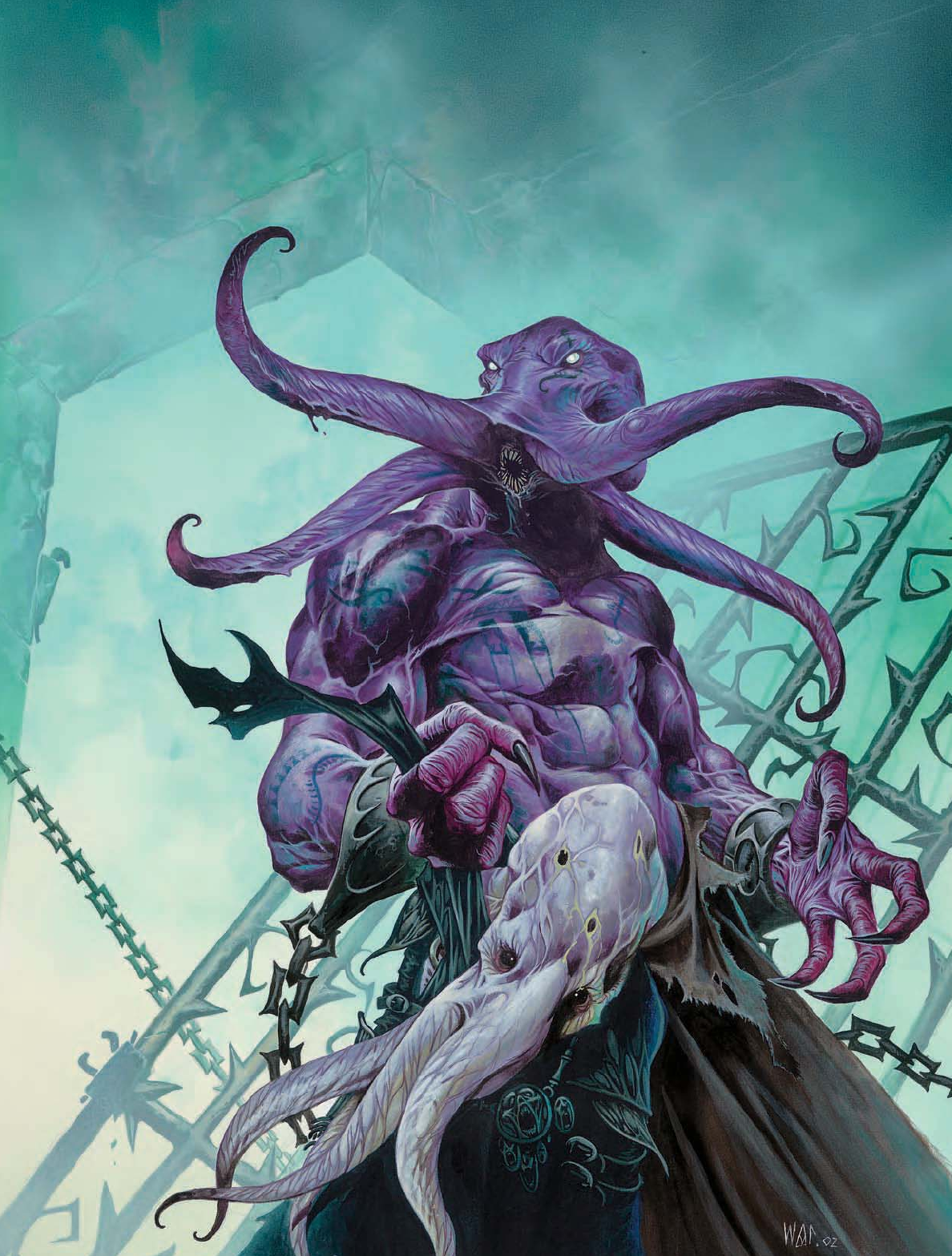
Mind fl ayers of Thoon have a vastly
different agenda from normal illithids
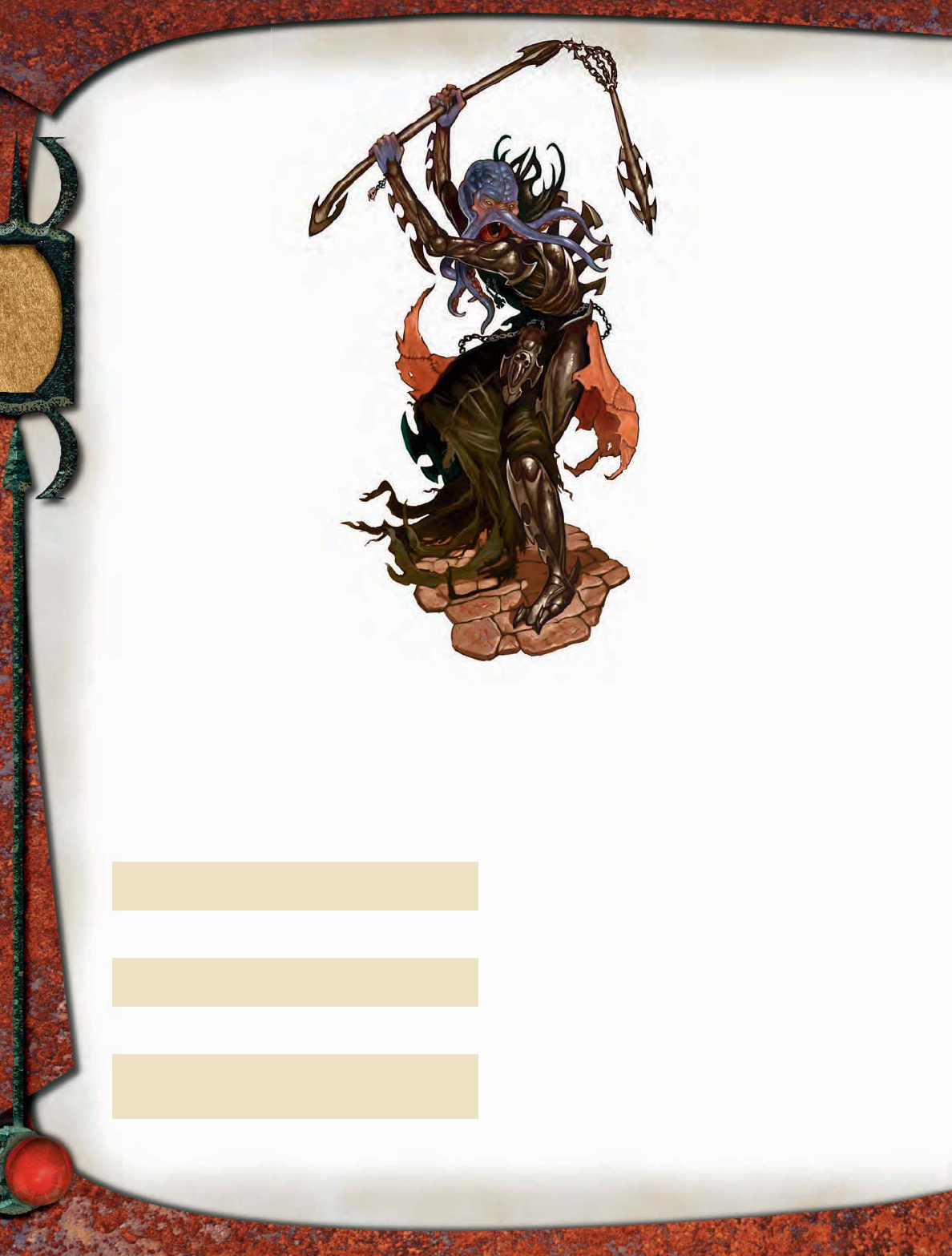
106
brain, instantly killing that creature.
Constructs, elementals, oozes,
plants, and undead are immune.
Mind Blast (Sp) 60-foot cone, stun
for 3d4 rounds, Will DC 20
negates.
Next to the Thoon elder
brain, Thoon disciples have
the closest connection with
the mysterious presence called Thoon. Devot-
ed to whatever principles they think Thoon
supports, these clerics provide healing
and divine magic to other mind fl ayers of
Thoon. Unlike shadow fl ayers, Thoon dis-
ciples are normal mind fl ayers.
Strategies and Tactics
Thoon disciples can heal their allies and
hold their own in melee combat. These
abilities make them versatile additions
to encounters with the mind fl ayers
of Thoon.
Thoon disciples are particu-
larly challenging when they have
a few rounds to prepare by casting
shield of faith and divine favor before the
battle begins. They have more than twice as
many hit points as a standard mind fl ayer and
much better armor, so they’re far more durable.
PCs who face Thoon disciples in melee might be
surprised that these mind fl ayers are ac-
complished at disarming.
Although a Thoon disciple can
be effective as a melee combatant,
it’s equally deadly in the back
ranks of a mind flayer force.
A Thoon disciple has a potent
mind blast, and it can often keep
a hold person spell going long
enough for another mind fl ayer to per-
form a brain extraction.
Ecology
Unless they have a good reason to leave
the safety of the nautiloid vessel, Thoon
disciples remain within the inner
chambers. They rely on shadow fl ay-
ers and rank-and-fi le mind fl ayers to
collect brains for sustenance.
Environment: When Thoon dis-
ciples leave the nautiloid vessel, they
prefer underground dwellings. Thoon
disciples take care to construct a shrine to
Thoon wherever they’re based, gather-
ing broken bits of treasure and casting
it before an otherwise featureless al-
tar. When the mind fl ayers of Thoon
move elsewhere in search of quintes-
sence, these shrines are left behind for
later explorers to puzzle over.
Typical Physical Characteristics: A
Thoon disciple is the same height and weight as
a typical human. Because they wear heavy armor, disciples
appear bulkier and stronger than typical mind fl ayers. Like
other mind fl ayers, Thoon disciples are genderless.
Alignment: Thoon disciples are neutral evil, but they
have a slight tendency toward lawfulness because they’re in
positions of authority. Regardless, when a Thoon disciple
receives “visions from Thoon,” it carries out those directions
from the Far Realm, no matter how chaotic or nonsensical
they seem.
Society
A Thoon disciple regards itself as second only to the Thoon
elder brain among the followers of Thoon. Since the elder
brain agrees with this assessment, Thoon disciples handle
the day-to-day leadership chores that the Thoon elder brain
can’t do itself.
Because the Thoon disciples manage the shadow flayer
breeding program, they eagerly use suggestion and charm
monster to make shadow fl ayers perform errands for them.
Many Thoon disciples are secretly pleased that the shadow
fl ayers have diminished psionic ability—it makes the shadow
fl ayers more pliable.
pqqqqqqqqqrs
THOON DISCIPLE LORE
Characters who have ranks in Knowledge (dungeoneering) or
Knowledge (religion) can learn more about Thoon disciples.
When a character makes a successful skill check, the following
lore is revealed, including the information from lower DCs.
Knowledge (Dungeoneering)
DC Result
25 Thoon disciples are mind fl ayer war priests
that wade into battle wearing heavy armor and
swinging massive fl ails.
30 Thoon disciples aren’t offensive spellcasters. They
use their divine magic for emergency healing or to
augment their defenses.
35 Thoon disciples are clerics with the Evil and War
domains. They don’t worship a god, necessarily,
just a mysterious force called “Thoon.”
Knowledge (Religion)
DC Result
25 Thoon disciples worship a force—maybe a god,
maybe not—called Thoon. Some explorers have
found shrines to Thoon, consisting of plain altars
with smashed, ruined treasure all around them.
30 Whatever Thoon is, it lies in a place beyond the
planes called the Far Realm.
pqqqqqqqqqrs
Thoon disciple
MIND FLAYERS
OF THOON
Illus. by W. Mahy

107
SHADOW FLAYER
In the shadows, you see a creature with jet-black skin. Four tentacles
extend from its face, and two milky white eyes stare forth from the
darkness of its form.
Shadow Flayer CR 8
Usually NE Medium aberration
Init +7; Senses darkvision 60 ft.; Listen +10, Spot +10
Languages Undercommon; telepathy 100 ft.
AC 16, touch 13, flat-footed 13
(+3 Dex, +3 natural)
hp 52 (8 HD)
SR 25
Fort +4, Ref +5, Will +8
Speed 30 ft. (6 squares)
Melee 4 tentacles +9 each (1d4+1) or
Melee mwk spear +10 (1d8+1/×3)
Ranged mwk dagger +10 (1d4+1/19–20 plus poison)
Space 5 ft.; Reach 5 ft.
Base Atk +6; Grp +7
Atk Options Quick Draw, improved grab, poison (DC 17, 1
Str drain/2d6 Str)
Special Actions extract, mind blast, shadowcloak
Spell-Like Abilities (CL 8th):
At will—detect thoughts (DC 14), plane shift
Abilities Str 12, Dex 16, Con 14, Int 19, Wis 15, Cha 15
SA extract, mind blast, shadowcloak, spell-like abilities
SQ poison use
Feats Improved Initiative, Quick Draw, Weapon Finesse
Skills Bluff +10, Concentration +12, Diplomacy +7,
Disguise +2 (+4 acting), Hide +13, Intimidate +4,
Knowledge (the planes) +10, Listen +10, Move
Silently +13, Sense Motive +7, Spot +10, Survival +2 (+4
on other planes)
Advancement by character class; Favored class rogue
Possessions masterwork spear, 4 masterwork daggers (each
poisoned with shadow essence)
Improved Grab (Ex) To use this ability, a shadow flayer must
hit a creature of up to Large size with a tentacle attack.
It can then attempt to start a grapple as a free action
without provoking attacks of opportunity.
If it wins the grapple check, it establishes a hold and
attaches a tentacle to the opponent’s head. A shadow
flayer can grab a Huge or larger creature, but only if it can
somehow reach the foe’s head. If a shadow flayer begins
its turn with at least one tentacle attached, it can try to
attach its remaining tentacles with a single grapple check.
The opponent can escape with a single successful grapple
check or an Escape Artist check, but the shadow flayer
gets a +2 circumstance bonus for every tentacle that was
attached at the beginning of the opponent’s turn.
Extract (Ex) If a shadow flayer begins its turn with all
four tentacles attached to its opponent and makes a
successful grapple check, it extracts that opponent’s
brain, instantly killing that creature. Constructs,
elementals, oozes, plants, and undead are immune.
Mind Blast (Sp) 60-foot cone, stun for 3d4 rounds, Will
DC 16 negates.
Shadowcloak (Su) A shadow flayer can draw on its own inner
stores of quintessence to briefly become invisible. By
expending a swift action and taking 5 points of damage,
a shadow flayer becomes invisible for 1 round. Unlike
with the invisibility spell, shadowcloak doesn’t end when a
shadow flayer attacks.
Poison Use (Ex) A shadow flayer is skilled in the use of
poison and never risks accidentally poisoning itself when
applying poison to a weapon.
Though the followers of Thoon have many normal mind fl ayers
among them, they also have shadow fl ayers, part of a breeding
program that emphasizes stealth over psionic ability.
Strategies and Tactics
A shadow fl ayer is a monster that thrives on surprise. It’s a
good candidate for an ambush encounter, or it can appear
pqqqqqqqqqqqqqqqqqqqqrs
HOW QUINTESSENCE WORKS
Mind flayers can’t predict what creatures and substances contain
quintessence, but some of the Thoon creatures (mad crafters of
Thoon, Thoon infiltrators, and stormclouds of Thoon) can detect
quintessence using the detect magic spell-like ability. It appears
as a black, coruscating aura.
Not every creature of the same race (or every substance of the
same composition) contains quintessence—its presence seems
to be random. The mind flayers use Thoon infiltrators and Thoon
thralls to find potential quintessence sources. If the creatures
that contain quintessence are weak, Thoon thralls kidnap them.
If not, the more powerful Thoon creatures go to work.
If mind flayers find quintessence in rare substances, they
“mine” it, bringing it to the nautiloid vessel or to a madcrafter
of Thoon. Sometimes mind flayers must dominate servitors to
handle the menial aspects of quintessence collection. They do
so by first undermining a community using Thoon infiltrators
and Thoon thralls, employing traditional mind flayer abilities to
crush what resistance remains in the weakened community.
Extracted and refined quintessence is a green, glowing fluid. A
typical source (such as a creature, a chunk of some rare mineral ore,
or an unusual plant) provides about a gallon of liquid. Madcrafters
of Thoon can store quintessence within themselves to create
scythers of Thoon and stormclouds of Thoon, and the vast proces-
sors aboard the nautiloid ship store quintessence in their matrices.
Each matrix holds about 10 gallons of quintessence.
Matrices of quintessence have a strong aura when viewed
using detect magic. Smaller quantities of refined quintessence
have a moderate or stronger aura, depending on the amount.
The school of the magic is never clear.
If a PC is harvested for quintessence, it’s harder to restore
that character’s life. Even if the surviving PCs save their com-
rade’s body, the quintessence must be recovered for any spell
short of greater resurrection to work.
Mind flayers of Thoon can garner quintessence from an
extracted brain as well, although doing so ruins the ordinary
nutrition value of the brain.
The most important game aspect of quintessence collection is
that it proceeds at the speed of the plot. That is, if an adventure
depends on the mayor’s daughter, the iron ore in a nearby mine,
or the PCs themselves being strong potential sources of quin-
tessence, then you’re well within your rights to make it so. As a
DM, you have better things to do than track exactly how much
quintessence the mind flayers are gathering and expending.
pqqqqqqqqqqqqqqqqqqqqrs
MIND FLAYERS
OF THOON
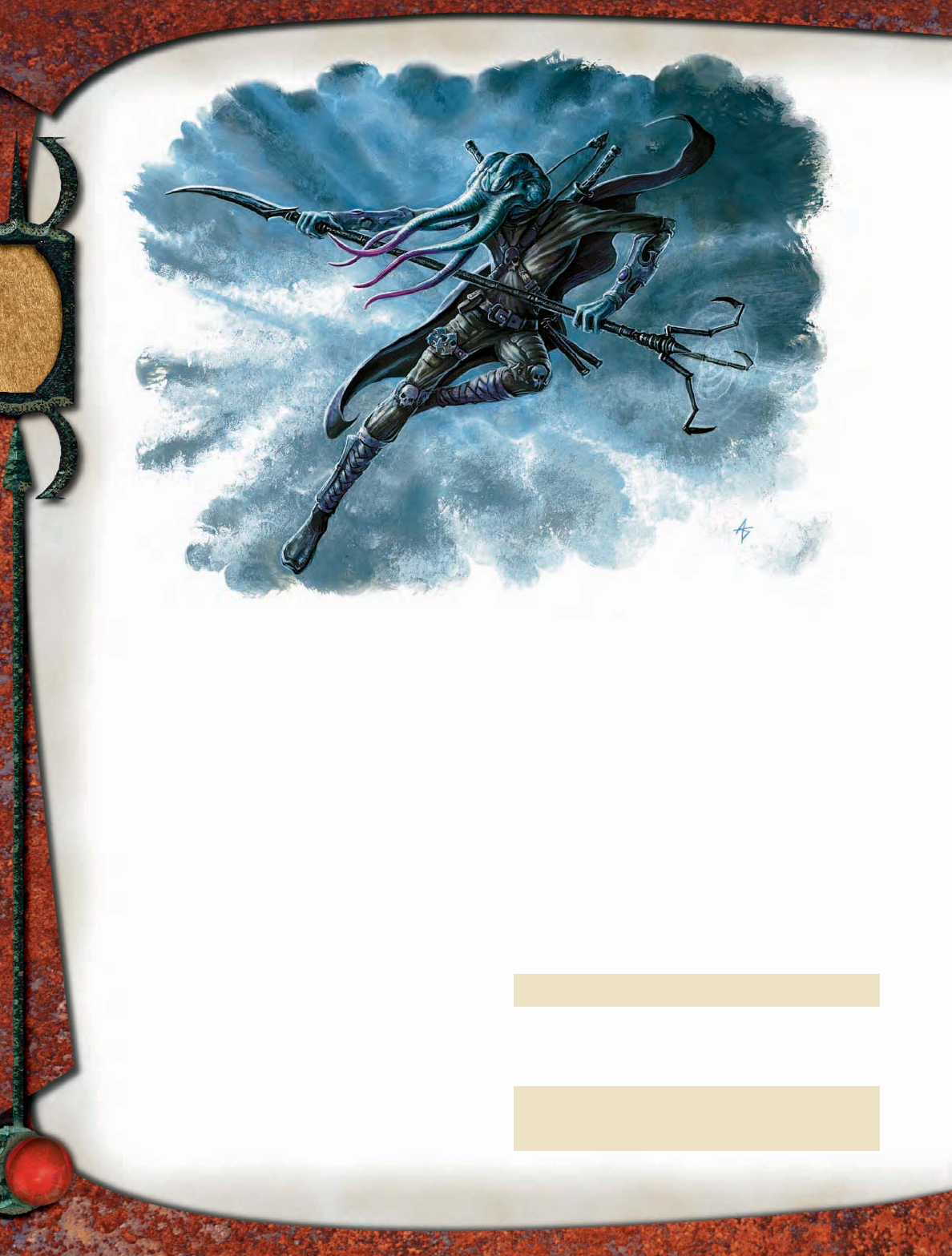
108
in the middle of the fi ght to give the PCs one more thing
to worry about.
Like traditional mind fl ayers, shadow fl ayers are less durable
than other monsters of their Challenge Rating. Shadow fl ayers
are also somewhat less versatile, since they don’t have all the
enchantment-based psionic abilities that regular mind fl ayers
have. With their ability to quickly turn invisible, they’re better
at the tentacle attacks that lead to brain extraction.
Shadow fl ayers usually carry daggers coated with shadow
essence, a potent but slow-acting poison. If they are facing a
signifi cant foe, they use shadowcloak, fl ing their daggers from
a safe hiding place, then fl ee. After a minute, when the poison
has run its course, they return, shadowcloaking again to
surprise weakened PCs with tentacle attacks and grapples.
Ecology
Shadow fl ayers are physiologically similar to mind fl ayers,
but a shadow fl ayer has a less prominent cranium and a cor-
respondingly less powerful mind. Shadow fl ayers eat brains
and reproduce as mind fl ayers do.
Environment: Shadow fl ayers call the nautiloid vessel
home, but they venture farther from it than other mind fl ay-
ers of Thoon do. When the nautiloid enters an underground
cave or other hidden lair, shadow fl ayers play a key role in
the initial scouting effort—at least until Thoon infi ltrators
and thralls can be crafted.
Typical Physical Characteristics: A shadow fl ayer is the
same height and weight as a human. Like mind fl ayers, they
are genderless. The only obvious differences from normal
mind fl ayers are the shadow fl ayer’s jet-black skin and slightly
smaller cranium.
Alignment: Shadow fl ayers are usually neutral evil. They
have a slightly chaotic tendency that breeding hasn’t yet
stamped out.
Society
Shadow fl ayers see themselves as spies and hunters for Thoon.
They’re haughty about their ability to infi ltrate places unseen
and their ability to bring back brains.
pqqqqqqqqqrs
SHADOW FLAYER LORE
Characters who have ranks in Knowledge (dungeoneering)
can learn more about shadow flayers. When a character
makes a successful skill check, the following lore is revealed,
including the information from lower DCs.
Knowledge (Dungeoneering)
DC Result
18 This is a shadow fl ayer, a mind fl ayer with ebony
skin. It can turn invisible at will.
23 These dark-skinned mind fl ayers are part of a
breeding program under the guidance of Thoon.
They can briefl y turn invisible, but doing so is
painful—perhaps the breeding program isn’t
perfected yet.
28 One side effect of the breeding process that leads
to shadow fl ayers is diminished psionic ability.
They’re incapable of any subtle psionic tricks, but
their mind blast remains potent.
pqqqqqqqqqrs
Shadow fl ayer
MIND FLAYERS
OF THOON
Illus. by A. Stokes

109
Shadow fl ayers have a natural rivalry with Thoon thralls,
which are individually much weaker but often make better
spies because they’re so well disguised. The Thoon elder brain
sometimes has to discipline shadow fl ayers who treat Thoon
thralls too cruelly.
Shadow fl ayers also take pains to distinguish themselves from
“ordinary” mind fl ayers, pointing out their controlled breeding.
Each shadow fl ayer believes that it is the acme of mind fl ayer
evolution, purpose-bred to do the will of Thoon.
THOON INFILTRATOR
Everything about this person seems normal, until you see the cluster
of metallic tentacles protruding from the back of the neck.
Thoon Infiltrator CR 5
Always CE Medium monstrous humanoid
Init +3; Senses darkvision 60 ft.; Listen +1, Spot +1
Languages Common; telepathy 100 ft. (only with Thoon thrall)
AC 16, touch 13, flat-footed 13; Dodge
(+3 Dex, +3 armor)
hp 37 (5 HD); fast healing 5; eventual comeback
Fort +4, Ref +7, Will +5
Speed 30 ft. (6 squares)
Melee rapier +8 (1d6+2/18–20)
Ranged throat dart +8 (1d4+2 plus poison)
Space 5 ft.; Reach 5 ft.
Base Atk +5; Grp +7
Atk Options poison (DC 15, 1d6 Wis/1d6 Wis)
Special Actions spawn thrall, submerge tentacles
Spell-Like Abilities (CL 5th):
At will—detect magic
3/day—charm person (DC 14)
1/day — dimension door
Abilities Str 14, Dex 16, Con 17, Int 18, Wis 13, Cha 17
SA poison, spawn thrall, spell-like abilities, throat dart
Feats Dodge, Sense Quintessence*
* New feat; see sidebar.
Skills Balance +5, Bluff +11, Diplomacy +15, Disguise +11
(+13 acting), Hide +11, Intimidate +5, Jump +4, Listen +1,
Move Silently +11, Sense Motive +9, Spot +1, Tumble +11
Advancement by character class; Favored Class rogue
Possessions masterwork studded leather, masterwork rapier
Eventual Comeback (Ex) The Far Realm parasite that powers
a Thoon infiltrator can survive the death of its host,
then revive that host. When a Thoon infiltrator reaches
–10 hit points, it doesn’t actually die. All life functions
cease, however, and the Thoon infiltrator is functionally
a corpse for the purpose of resolving spells that affect
dead bodies. It takes a DC 25 Search check to detect a
slight vibration in the neck-tentacles that indicates that
the creature is not fully dead. Removing the tentacles
from the neck (a bloody process that requires a full-round
action) kills a Thoon infiltrator for good.
If the tentacles aren’t removed, a Thoon infiltrator
can effectively resurrect itself. After it has spent a month
in the near-death state, a Thoon infiltrator returns to
consciousness at full normal hit points. It then frees itself
from burial with dimension door and tries to reestablish
contact with its mind flayer masters.
Throat Dart (Su) The tentacles that represent a Thoon
infiltrator’s parasite aspect can extend themselves up the
infiltrator’s throat and out its mouth, from where they can
shoot a poison dart at a nearby target. The dart functions
as a thrown weapon with a range increment of 10 feet.
Spawn Thrall (Su) If a Thoon infiltrator can spend an
uninterrupted minute with a helpless humanoid, the
infiltrator can turn it into a Thoon thrall by snaking its thin
neck-tentacles into the victim’s mouth. Sleeping creatures
automatically awaken when a Thoon infiltrator attempts
this, so it works only on creatures that are bound,
magically held, or truly unconscious. A Thoon infiltrator
can create one Thoon thrall per week in this manner.
Submerge Tentacles (Ex) A Thoon infiltrator usually hides
its neck-tentacles with a cloak, high collar, or scarf. But
if it expects close scrutiny, it can submerge the tentacles
beneath the flesh, leaving only a rough patch of skin
behind. Doing so takes a full-round action.
While its tentacles are submerged, a Thoon infiltrator
can’t use its spell-like abilities, throat dart, telepathy, or
spawn thrall. If a Thoon infiltrator dies with its tentacles
submerged, no search short of dismemberment can
reveal the tentacles’ presence, and the Thoon infiltrator’s
eventual comeback ability functions normally.
Skills The facial features of a Thoon infiltrator are as
malleable as clay, granting the creature a +8 racial bonus
on Disguise checks.
The parasitic Thoon infi ltrator is an undercover spy for the mind
fl ayers of Thoon, able to build secret networks of Thoon thralls
while appearing as innocuous as an ordinary human.
Strategies and Tactics
A Thoon infi ltrator is a good recurring villain for low-level
PCs. In time, it can lead them into contact with the more
powerful mind fl ayers of Thoon. It functions particularly well
in the company of several Thoon thralls it has created.
In battle, a Thoon infi ltrator is a capable sword-wielder,
and it can surprise an unsuspecting PC with its throat darts.
Perhaps more important is its ability to direct the actions of
any Thoon thrall it is with. The mere presence of a Thoon
infi ltrator makes each Thoon thrall more effective.
Because the mind fl ayers of Thoon have only so many Far
Realm parasites, each Thoon infi ltrator is a precious resource.
Fortunately for the illithids, a Thoon infi ltrator can escape
death at the hands of the PCs, either in the short term (by
MIND FLAYERS
OF THOON
pqqqqqqqqqqqqqqqqqqqqrs
WHY NOT A TEMPLATE?
Given how Thoon infiltrators come into being—a parasitic
infestation at the hands of illithids—creating a template for
them makes a certain amount of sense. Mechanically, though,
it just isn’t worth the effort because the template would change
every thing about the creature. When the local sheriff gets
turned into a Thoon infiltrator, only his appearance and basic
memories remain intact—the rest is a product of the mind
flayer transformation. Thus, it’s easier just to build the infiltra-
tor as a normal monster and stipulate that it looks like whatever
it was beforehand.
pqqqqqqqqqqqqqqqqqqqqrs
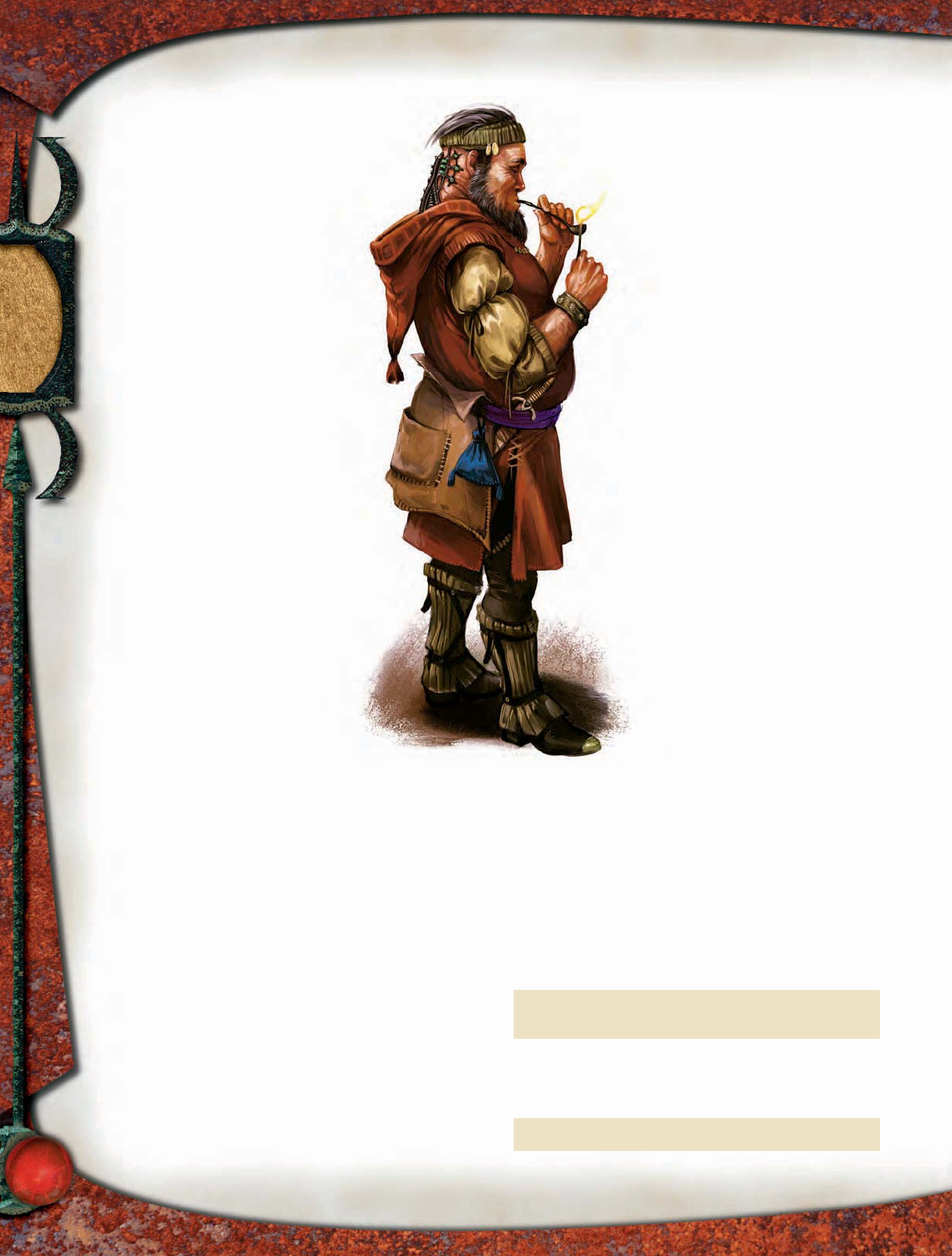
110
using dimension door when the PCs have the upper
hand) or the long term (with its eventual come-
back ability).
Ecology
The mind fl ayers had some living human-
oid captives aboard their nautiloid vessel
when they breached the Far Realm. To
the illithids’ surprise, the humanoids
were quickly infected with a parasite na-
tive to the Far Realm, becoming Thoon
infi ltrators. The mind fl ayers’ surprise
turned to delight when they realized that a
Thoon infi ltrator could both impersonate
“ordinary” folk and detect quintessence.
Since then, the mind fl ayers have
learned a little more about the life cycle
of the Thoon infi ltrator parasite. In its unat-
tached state, the parasite looks like a bundle
of thin, metallic tentacles about the size of
a housecat. When brought into proximity
to a humanoid, the tentacles burrow into
the brain and vital organs of the host crea-
ture, killing it, then reassembling the host
body tissue by tissue. After a day of spasmod-
ic twitching, the host body arises, appearing as
it did before (other than the tentacles at the base
of its skull) but wholly devoted to Thoon and
the mind fl ayers.
The reconstituted body no longer
needs to eat, sleep, or breathe, but it can
do those things voluntarily if it wants
to appear humanoid.
So far, the Thoon infi ltrators’ life
span and means of reproduction are
unknown to either the mind fl ayers or the
infi ltrators themselves. The mind fl ayers have
developed a technique for transferring the parasite from one
humanoid to another after an hour of gruesome surgery. They
do so only when a Thoon infi ltrator has become too notorious
to be effective in the outside world, or when they have a
living captive they think would make a particularly good
host. Most Thoon infi ltrators are out in the world doing
the secret work of the mind fl ayers, so only a few unat-
tached parasites are available to the mind
fl ayers of Thoon at a given time.
The mind fl ayers of Thoon have exper-
imented with different hosts for the Thoon
infi ltrator parasite, but so far, it accepts only
a humanoid as a host.
Environment: A Thoon infi ltrator pre-
fers the same environment its host lived in
before infestation, although this is strictly a
matter of comfort and camoufl age. Thoon in-
fi ltrators have a slight distaste for warmer climes,
simply because humanoids there tend to wear less
clothing, so it’s harder to hide the neck-tentacles.
Typical Physical Characteristics: A Thoon
infi ltrator retains the height and weight of its host
creature. In most cases, that’s a human. Aside
from the metallic tentacles projecting from the
base of its skull, a Thoon infi ltrator looks iden-
tical to a normal person.
Although Thoon infi ltrators don’t have gen-
ders, their hosts do. Thoon infi ltrators never
produce offspring.
Alignment: Unlike the other followers of
Thoon, Thoon infi ltrators are always chaotic evil.
They chafe at the control of the mind fl ayers
and grow impatient with the long-term plans
for careful quintessence-gathering.
Society
Though a Thoon infi ltrator is a monstrous
humanoid in terms of game mechanics,
it’s an outsider from the Far Realm in terms
pqqqqqqqqqrs
THOON INFILTRATOR LORE
Characters who have ranks in Knowledge (dungeoneering)
can learn more about Thoon infiltrators. When a character
makes a successful skill check, the following lore is revealed,
including the information from lower DCs. A character who
has ranks in Knowledge (nature) can attempt this check, but
the DCs increase by 10.
Knowledge (Dungeoneering)
DC Result
20 This is a Thoon infi ltrator, a monstrous humanoid
created by mind fl ayers. They are sent to infi ltrate
civilization to appease Thoon.
25 The creature’s neck-tentacles grant some psionic
abilities and the ability to create thralls. The
person they are attached to is dead and gone, but
the tentacles can animate the body and access its
memories.
30 Detaching the tentacles and destroying them is the
only way to truly kill one of these parasites.
pqqqqqqqqqrs
Thoon infi ltrator
MIND FLAYERS
OF THOON
pqqqqqqqqqrs
NEW FEAT: SENSE QUINTESSENCE
You are capable of discerning sources of quintessence, a
magic substance precious to Thoon.
Prerequisites: Detect magic (as a spell or spell-like ability),
affiliation with Thoon.
Benefit: When you use detect magic, you also detect any
quantities of quintessence within the spell’s area.
The amount of information revealed depends on how long
you study a particular area or subject.
1st Round: Presence or absence of quintessence.
2nd Round: Number of different quintessence sources, and
the size and potency (moderate or strong) of the most power-
ful quintessence source.
3rd Round: The location and potency of each quintessence
source.
pqqqqqqqqqrs
Illus. by E. Widermann

111
of heritage. Unlike the other followers of Thoon, each Thoon
infi ltrator began life in the Far Realm and remembers some-
thing of its existence there.
Because the Far Realm is beyond the rest of the universe—and
beyond reason itself—Thoon infi ltrators remember their time
there imperfectly, and those memories are almost impossible
to convey to others. Each Thoon infi ltrator has an aching desire
to return to the madness of the Far Realm, and most believe
that the ultimate goal of Thoon is a return to the Far Realm or
an intrusion of the Far Realm into the rest of the universe.
THOON THRALL
Purple veins pop out from the person’s skin as he—or perhaps
it—gazes at you, wild-eyed.
Thoon Thrall, Human Commoner CR 3
Male Thoon thrall human commoner 1
LE Medium monstrous humanoid
Init +1; Senses darkvision 60 ft.; Listen +7, Spot +7
Languages Common; telepathy 100 ft. (only with Thoon
infiltrator); thrall to Thoon infiltrator
AC 14, touch 11, flat-footed 13
(+1 Dex, +2 armor, +1 natural)
hp 14 (3 HD); dormancy; overdrive healing 5; immolate
Fort +3, Ref +4, Will +2
Speed 40 ft. (8 squares); 30 ft. when dormant
Melee spear +6 (1d8+4)
Ranged spear +4 (1d8+4)
Space 5 ft.; Reach 5 ft.
Base Atk +2; Grp +5
Abilities Str 16, Dex 12, Con 12, Int 11, Wis 9, Cha 7
SA immolate
Feats Alertness, Great Fortitude, Weapon Focus (spear)
Skills Craft (any) +4, Listen +7, Spot +7
Possessions leather armor, 2 spears
Dormancy (Ex) A Thoon thrall spends most of its time in
a dormant state. When it is dormant, a Thoon thrall’s
overdrive healing doesn’t function, and the thrall doesn’t
move at full speed. It appears exactly as it did before a
Thoon infiltrator turned it into a Thoon thrall.
As a full-round action, a Thoon thrall can end its
dormancy. Throbbing, veinlike growths emerge from its
skin, and the thrall’s true nature becomes apparent. If
a Thoon infiltrator is within 100 feet, a Thoon thrall can
end its dormancy as a swift action.
Once a Thoon thrall ends its dormancy, it can’t return
to a dormant state. Due to overdrive healing, a Thoon
thrall cannot survive out of dormancy for long.
Thrall to Thoon Infiltrator (Ex) A Thoon thrall responds
to the commands of the nearest Thoon infiltrator as if
dominated, with no save allowed.
Overdrive Healing (Su) This ability works like fast healing
5, but a thrall can gain hit points beyond its full normal
hit points as temporary hit points. A thrall’s skin begins
to blister and swell when this happens, and the thrall
grows visibly larger. Once its temporary hit points equal
or exceed its full normal hit points, a Thoon thrall must
make a save every round or explode (see below).
Immolate (Su) When a Thoon thrall is fully healed and has
temporary hit points equal to or greater than its full
normal hit points, it might explode, its body unable
to contain the energy within. At the end of its turn, if
a Thoon thrall’s temporary hit points equal or exceed
its full normal hit points, it must succeed on a DC 11
Fortitude save. If it fails, it explodes, dealing 3d6 points of
fire damage to all creatures within a 10-foot-radius burst,
plus an extra 1d6 points of fire damage for each Thoon
infiltrator and additional Thoon thrall within 30 feet
(Reflex DC 11 half). The explosion kills the Thoon thrall.
A Thoon thrall can voluntarily fail this save, but it
does so only on a direct order from a Thoon infiltrator.
Thoon thralls are the foot soldiers of the secret cabals that the
Thoon infi ltrators direct. They remain in their humanoid guise
until discovered or ordered into battle, then they undergo a
fi nal transformation and go out in a blaze of glory.
The Thoon thrall presented here uses a 1st-level human
commoner as the base creature. It had the following ability
scores before racial modifi cations: Str 10, Dex 10, Con 10, Int
11, Wis 11, Cha 11.
Strategies and Tactics
Thoon thralls work well in the company of other Thoon
thralls and a Thoon infiltrator to direct them. Beyond
that, they’re straightforward grunts that can take a lot of
punishment—especially if they get a round or two of
overdrive healing before the battle begins.
The most important strategic element to remember about
Thoon thralls is that the Thoon infi ltrator that created the
thrall needs to carefully consider whether it’s worth throwing
away a thrall in a particular battle. A Thoon thrall can take
its true form only once. After it leaves dormancy, overdrive
healing forces it to immolate before long. So, an awakened
thrall is always a dead thrall—an expended resource to the
Thoon infi ltrator.
Ecology
Unlike the transformation into a Thoon infi ltrator, which
completely remakes the creature, the transformation into a
Thoon thrall leaves the creature largely intact. The creature
looks the same, behaves the same, and retains its own free
will—unless a Thoon infi ltrator is around. A Thoon thrall
must eat, sleep, and breathe as it did before becoming a Thoon
MIND FLAYERS
OF THOON
pqqqqqqqqqrs
THOON THRALL LORE
Characters who have ranks in Knowledge (dungeoneering)
can learn more about Thoon thralls. When a character makes
a successful skill check, the following lore is revealed, includ-
ing the information from lower DCs. A character who has
ranks in Knowledge (nature) can attempt this check, but the
DCs increase by 10.
Knowledge (Dungeoneering)
DC Result
20 This is a Thoon thrall, a member of a secret cabal
that reveres mind fl ayers. When it comes out of
dormancy, it grows freakishly large, then explodes.
25 The mind fl ayers of Thoon control Thoon thralls
through human-looking intermediaries called
Thoon infi ltrators.
pqqqqqqqqqrs
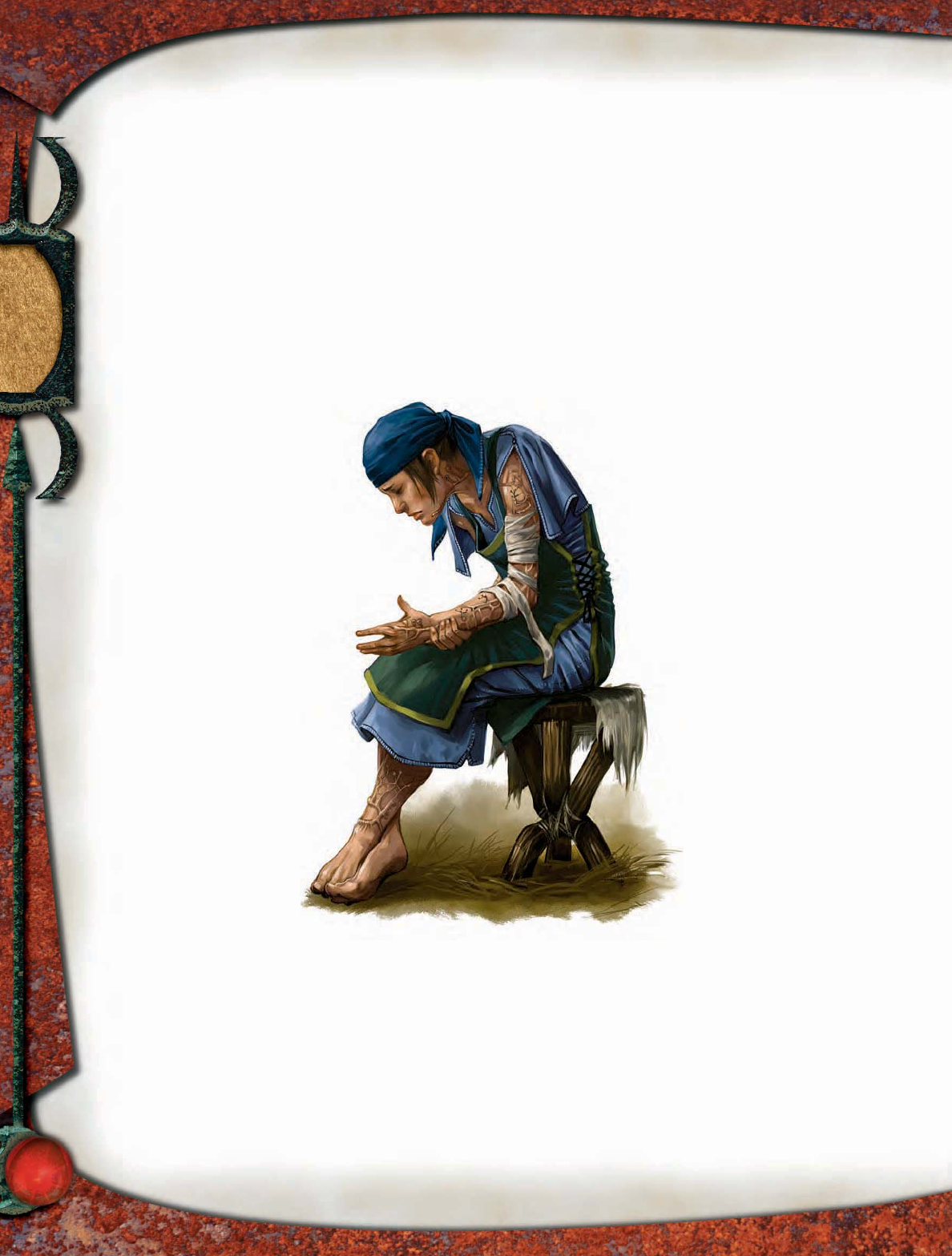
112
thrall. Even reproductive ability is unaffected, although any
offspring aren’t Thoon thralls.
Environment: A Thoon thrall either continues to live
where it did before its transformation or follows a Thoon
infi ltrator on a dark errand. A few serve the mind fl ayers of
Thoon directly as servants, but the illithids prefer their own
thralls to the explosive ones created by Thoon infi ltrators.
Typical Physical Characteristics: When in dormancy,
Thoon thralls are indistinguishable from what they looked
like as humanoids. When they end their dormancy, how-
ever, they begin to grow muscle at a freakish rate, gaining
40 to 50 pounds as they reach the point when they might
immolate.
Alignment: Thoon thralls are usually lawful evil, but that’s
because they are puppets to their Thoon infi ltrator masters,
not because they necessarily behave wick-
edly when not under such infl uence.
Society
Thoon thralls have no society of
their own, but they remember how
to function in the communities they
lived in before their transformation.
The mind fl ayers of Thoon regard Thoon
thralls as beneath contempt or as tasty snacks,
depending on their appetite at the mo-
ment. Life for Thoon thralls is horrifi c,
since they are forced by Thoon in-
fi ltrators to do unspeakable things
and undermine their own commu-
nities. Many welcome the chance to
end their dormancy and immolate
themselves.
Thoon Thralls
with Class Levels
Thoon thralls can continue to advance
in character classes after becoming
a thrall. They have the same fa-
vored classes as the humanoid
they are created from, un-
less their new alignment
precludes advancement in
such classes. In this case,
treat rogue as the thrall’s favored class.
CREATING A THOON THRALL
“Thoon thrall” is an acquired template that can be added to
any humanoid creature that a Thoon infi ltrator could reason-
ably render helpless for 1 minute (referred to hereafter as the
“base creature”).
Challenge Rating: Same as the base creature +2.
Type: The base creature’s type changes to monstrous
humanoid. It does not gain the augmented subtype but
retains other subtypes except those from alignment and
humanoid race.
Senses: A Thoon thrall gains darkvision out to 60 feet if
it doesn’t already have better.
Languages: A Thoon thrall can communicate telepathi-
cally with any Thoon infi ltrator within 100 feet. It also gains
the following special quality.
Thrall to Thoon Infi ltrator: A Thoon thrall responds to the
commands of the nearest Thoon infi ltrator as if dominated,
with no save allowed.
HD: Add two monstrous humanoid Hit Dice. This improve-
ment grants a base attack bonus increase of +2, a +3 bonus on
Refl ex and Will saves, 2d8 hit points, 2 × (2 + Int modifi er)
skill points, and feats at the usual rate.
A Thoon thrall also gains the following special quality and
special attack.
Overdrive Healing (Su): This ability works like fast healing
5, but the thrall can gain hit points beyond its full normal hit
points as temporary hit points. The Thoon thrall’s skin
begins to blister and swell when this happens, and the
thrall grows visibly larger. Once its temporary hit
points equal or exceed its full normal hit points,
the Thoon thrall must make a save every round
or explode (see below).
Immolate (Su): When a Thoon thrall is
fully healed and has temporary hit points
equal to or greater than its full normal hit
points, it might explode, its body unable
to contain the energy within. At the end
of its turn, if a Thoon thrall’s tempo-
rary hit points equal or exceed its full
normal hit points, it must succeed on
a Fortitude save (DC 10 + 1/2 the
Thoon thrall’s HD + its Con modi-
fi er). If it fails, it explodes, dealing
2d6 points of fi re damage to all crea-
tures within a 10-foot-radius burst,
plus an additional 1d6 points of fi re
damage for each Thoon infiltrator
and Thoon thrall within 30 feet.
(It’s always near itself, so even
a lone Thoon thrall explodes
for 3d6 points of fi re damage.)
Creatures that succeed on a
Reflex save (DC 10 + 1/2 the
Thoon thrall’s HD + its Con modi-
fi er) take half damage. The explosion
kills the Thoon thrall.
A Thoon thrall can voluntarily fail this save, but it does
so only on a direct order from a Thoon infi ltrator.
AC: A Thoon thrall is slightly more durable than it was
in its previous life. Increase the base creature’s natural armor
bonus by 1.
Speed: When not dormant, a Thoon thrall’s speed increases
by 10 feet in whatever mode the creature most often employs
(usually land speed).
Abilities: The base creature’s ability scores are modifi ed
as follows: Str +6, Dex +2, Con +2, Wis –2, Cha –4.
Thoon thrall
MIND FLAYERS
OF THOON
Illus. by E. Widermann
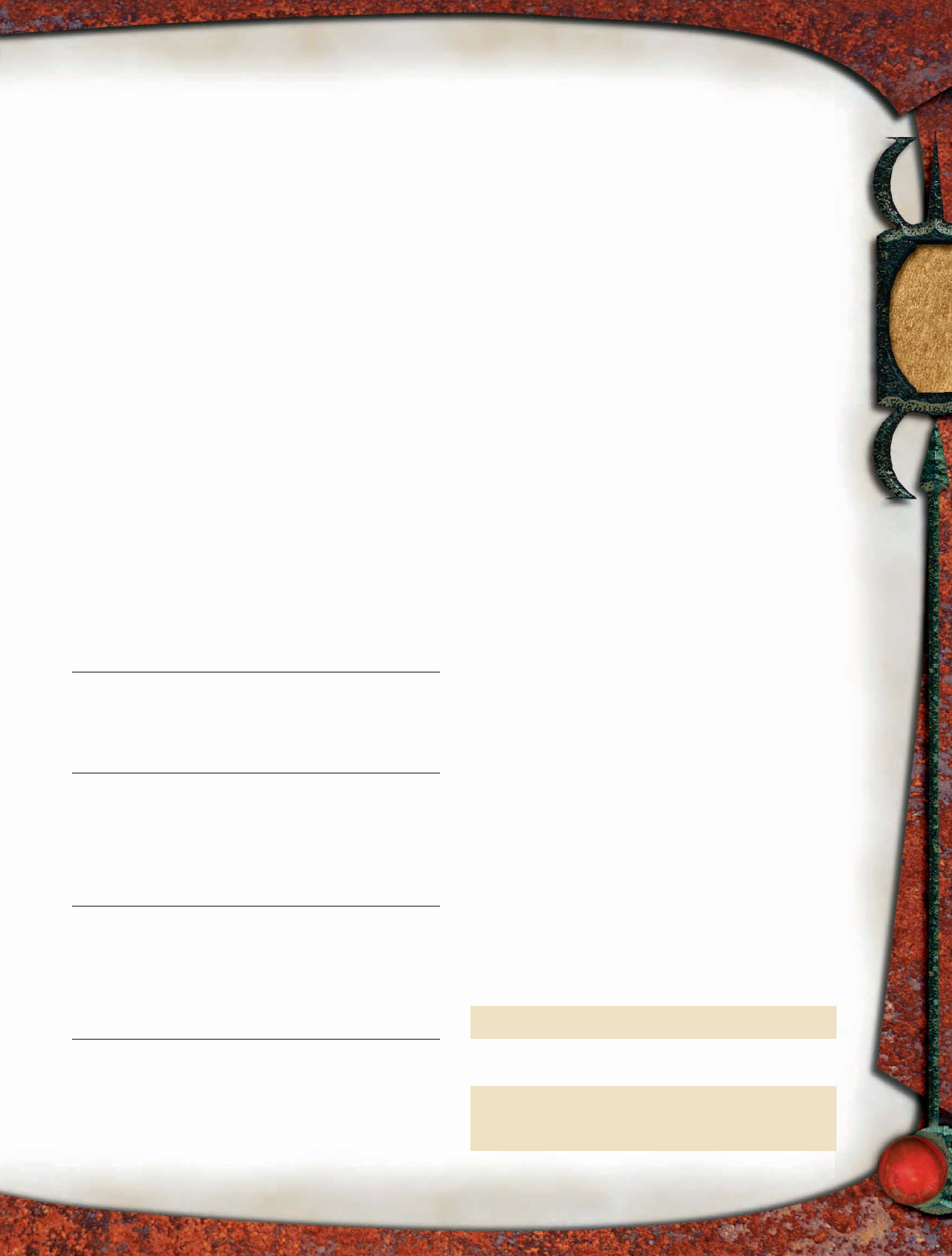
113
Special Qualities: A Thoon thrall retains all the special
qualities of the base creature and gains the following special
quality.
Dormancy (Ex): A Thoon thrall spends most of its time in a
dormant state. When it is dormant, a Thoon thrall’s overdrive
healing doesn’t function, and the thrall doesn’t move at full
speed. It appears exactly as it did before a Thoon infi ltrator
turned it into a Thoon thrall.
As a full-round action, a Thoon thrall can end its dormancy.
Throbbing, veinlike growths emerge from its skin, and the
thrall’s true nature becomes apparent. If a Thoon infi ltrator
is within 100 feet, then a Thoon thrall can end its dormancy
as a swift action.
Once a Thoon thrall ends its dormancy, it can’t return to
a dormant state. Due to overdrive healing, a Thoon thrall
cannot survive out of dormancy for long.
Level Adjustment: —. Because of the total vulnerability
to Thoon infi ltrator domination and the nature of overdrive
healing, Thoon thralls are unsuitable as PCs.
THOON SOLDIER
This biped is covered with armor plates, yet it moves with a sinu-
ous quality. With a liquid, bubbling sound, it extrudes claws and
axe-blades from its arms.
Thoon Soldier CR 8
Always N Medium construct
Init +3; Senses darkvision 60 ft., low-light vision; Listen +1,
Spot +1
Languages speaks specific Undercommon phrases;
understands telepathic commands
AC 20, touch 13, flat-footed 17
(+3 Dex, +7 natural)
hp 75 (10 HD)
Immune construct immunities
Resist fire 10
Fort +3, Ref +6, Will +4
Speed 30 ft. (6 squares)
Melee 2 arm-axes +14 each (1d8+7/×3)
Space 5 ft.; Reach 5 ft.
Base Atk +7; Grp +14
Atk Options depends on aspect (see below)
Special Actions aspect of bloody slaughter, aspect of the
fiery sun, aspect of the impervious tower, aspect of the
ravenous horde, aspect of the death blossom
Abilities Str 25, Dex 16, Con —, Int —, Wis 12, Cha 5
SA aspect of bloody slaughter, aspect of the impervious
tower, aspect of the ravenous horde, aspect of the fiery
sun, aspect of the death blossom
SQ construct traits
Feats —
Skills Listen +1, Spot +1
Advancement 14 HD (Large); see text
Aspect of Bloody Slaughter (Ex) By expending a swift action
and taking 5 points of damage, a Thoon soldier can
reconfigure its limbs to deal damage to multiple adjacent
foes. When in this aspect, a Thoon soldier can make a
Whirlwind Attack (as the feat) with its arm-blades as a
full-round action, and it can make attacks of opportunity
as if it had the Combat Reflexes feat. A Thoon soldier can
have only one aspect active at a time. When adopting
this aspect, a Thoon soldier says in Undercommon,
“Slaughter for Thoon!”
Aspect of the Fiery Sun (Ex) By expending a swift action and
taking 5 points of damage, a Thoon soldier can channel
quintessence from its body, creating heat. The Thoon
soldier’s melee attacks deal an extra 2d6 points of fire
damage, and creatures that hit it with a natural weapon or
a nonreach melee weapon take 1d6 points of fire damage.
A Thoon soldier can have only one aspect active at a
time. When adopting this aspect, a Thoon soldier says in
Undercommon, “All will burn for Thoon!”
Aspect of the Impervious Tower (Ex) By expending a swift
action and taking 5 points of damage, a Thoon soldier
can extrude extra armor plates and bolster its magical
defenses. When using this aspect, a Thoon soldier
gains a +4 resistance bonus on saving throws and a +4
deflection bonus to AC. A Thoon soldier can have only
one aspect active at a time. When adopting this aspect, a
Thoon soldier says in Undercommon, “Stand and fight!
Thoon is Thoon!”
Aspect of the Ravenous Horde (Ex) By expending a swift
action and taking 5 points of damage, a Thoon soldier
can reconfigure its lower limbs for greater speed and
maneuverability. When in this aspect, a Thoon soldier’s
speed increases to 40 feet, and it can make a melee
attack in the middle of its move as if it had the Spring
Attack feat. A Thoon soldier can have only one aspect
active at a time. When adopting this aspect, a Thoon
soldier says in Undercommon, “Walk with Thoon!”
Aspect of the Death Blossom (Ex) A Thoon soldier has one
final mode it enters if it starts its turn with between 5 and
20 hit points left. By expending a swift action and taking
5 points of damage, a Thoon soldier can reconfigure its
body to explode when destroyed. If destroyed when in
the aspect of the death blossom, a Thoon soldier deals
8d6 points of fire damage to all creatures within a 40-
foot-radius burst (Reflex DC 15 half). A Thoon soldier can
have only one aspect active at any time. When adopting
this aspect, a Thoon soldier says in Undercommon,
“Death blooms in the name of Thoon! Thoon! Thoon!”
A Thoon soldier doesn’t change out of the aspect of
the death blossom until it’s fully healed. The save DC is
Constitution-based.
pqqqqqqqqqrs
THOON SOLDIER LORE
Characters who have ranks in Knowledge (dungeoneering)
can learn more about Thoon soldiers. When a character
makes a successful skill check, the following lore is revealed,
including the information from lower DCs. A character who
has ranks in Knowledge (arcana) can attempt this check, but
the DCs increase by 10.
Knowledge (Dungeoneering)
DC Result
23 This is a Thoon soldier, a construct built by mind
fl ayers of Thoon to act as an infantry soldier.
28 A Thoon soldier can change between a number
of aspects that enhance its body, changing speed,
defense, or combat prowess.
33 When badly damaged, a Thoon soldier will enter
an “aspect of the death blossom” and will explode
if destroyed. It remains in that mode until the
mind fl ayers repair it.
pqqqqqqqqqrs
MIND FLAYERS
OF THOON
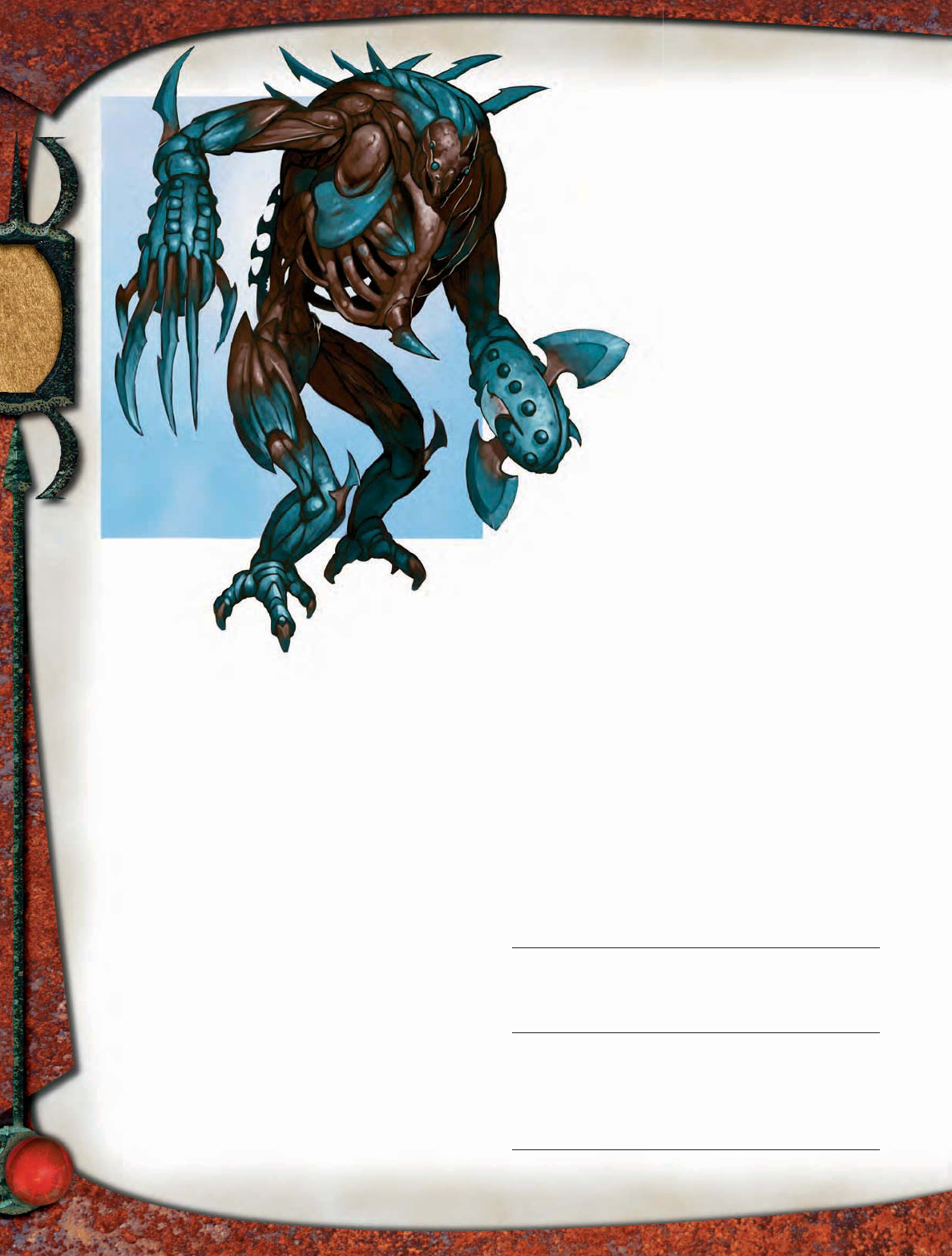
114
Thoon soldiers are constructs made in the quintessence-
cocoons of the nautiloid vessel that the mind flayers of
Thoon call home.
Strategies and Tactics
Thoon soldiers are straightforward melee combatants, but
because they can change aspects, they can feel like different
monsters even when you throw multiple Thoon soldiers at
the PCs.
A Thoon soldier instinctively assesses the tactical
situation at the beginning of each turn, choosing an
appropriate aspect. In the first round, this is often the
aspect that provides the most maneuverability—aspect
of the ravenous horde.
Thoon soldiers understand aspect changes on a round-
by-round basis, but unless directed by someone else, they
don’t “think ahead” with regard to aspects. At the begin-
ning of its turn, a Thoon soldier simply picks whichever
aspect is useful at moment. If opponents gang up on it,
it switches to aspect of the fiery sun (against two foes)
or aspect of bloody slaughter (against three or more). A
Thoon soldier uses aspect of the impervious tower when
it senses that spells might deal the most damage during
a particular round.
Last, of course, comes the aspect of the death
blossom. PCs who ignore the ominous phrase the
soldier utters might not live to regret their choice.
Ecology
Thoon soldiers are formed within cocoons that must be
supplied with quintessence by the mind fl ayers of Thoon.
When a Thoon soldier emerges from a cocoon, it fi nds the
nearest mind fl ayer and awaits orders.
Thoon soldiers are programmed to return to the co-
coons inside the nautiloid vessel if they enter the aspect
of the death blossom but survive the
battle. Quintessence from the vessel’s
stores repairs them at a rate of 1 hit
point per day.
Environment: Thoon soldiers form
the best security patrols that the mind fl ay-
ers of Thoon have, so they’re as common as
mind fl ayers within the nautiloid vessel (or
other base for Thoon followers). They’re less
common outside, because they attract undue at-
tention and require supervision from a sentient
follower of Thoon.
Typical Physical Characteristics: A Thoon soldier
is 6 feet tall and weighs 300 pounds. Its armor allows it sur-
prising mobility, and the mutability of its form makes it look
like it is always in motion.
Alignment: Thoon soldiers strictly follow their
programming, making them neutral.
Advanced Thoon Soldiers
The cocoons do not advance Thoon soldiers on a Hit-Die-
by-Hit-Die basis. Occasionally, a Large 14 HD Thoon soldier
spontaneously emerges from a cocoon. Such a Thoon soldier
is a CR 10 monster.
MADCRAFTER OF THOON
This immense, sluglike creature has a mane of canisters, each
containing a glowing, green fl uid. The front of its body seems like
it is all mouth—a maw dripping with spittle.
Madcrafter of Thoon CR 10
Usually NE Huge aberration
Init +4; Senses darkvision 60 ft.; Listen +17, Spot +17
Languages Undercommon; telepathy 100 ft.
AC 20, touch 8, flat-footed 20
(–2 size, +12 natural)
hp 125 (10 HD); fast healing 5
Immune acid
Fort +11, Ref +3, Will +9
Speed 20 ft. (4 squares)
Melee bite +16 (2d8+15 plus 4d6 acid)
Space 15 ft.; Reach 10 ft.
Base Atk +7; Grp +25
Special Actions launch spawn, mind blast
Spell-Like Abilities (CL 10th):
At will—detect magic
Thoon soldier
MIND FLAYERS
OF THOON
Illus. by W. Mahy
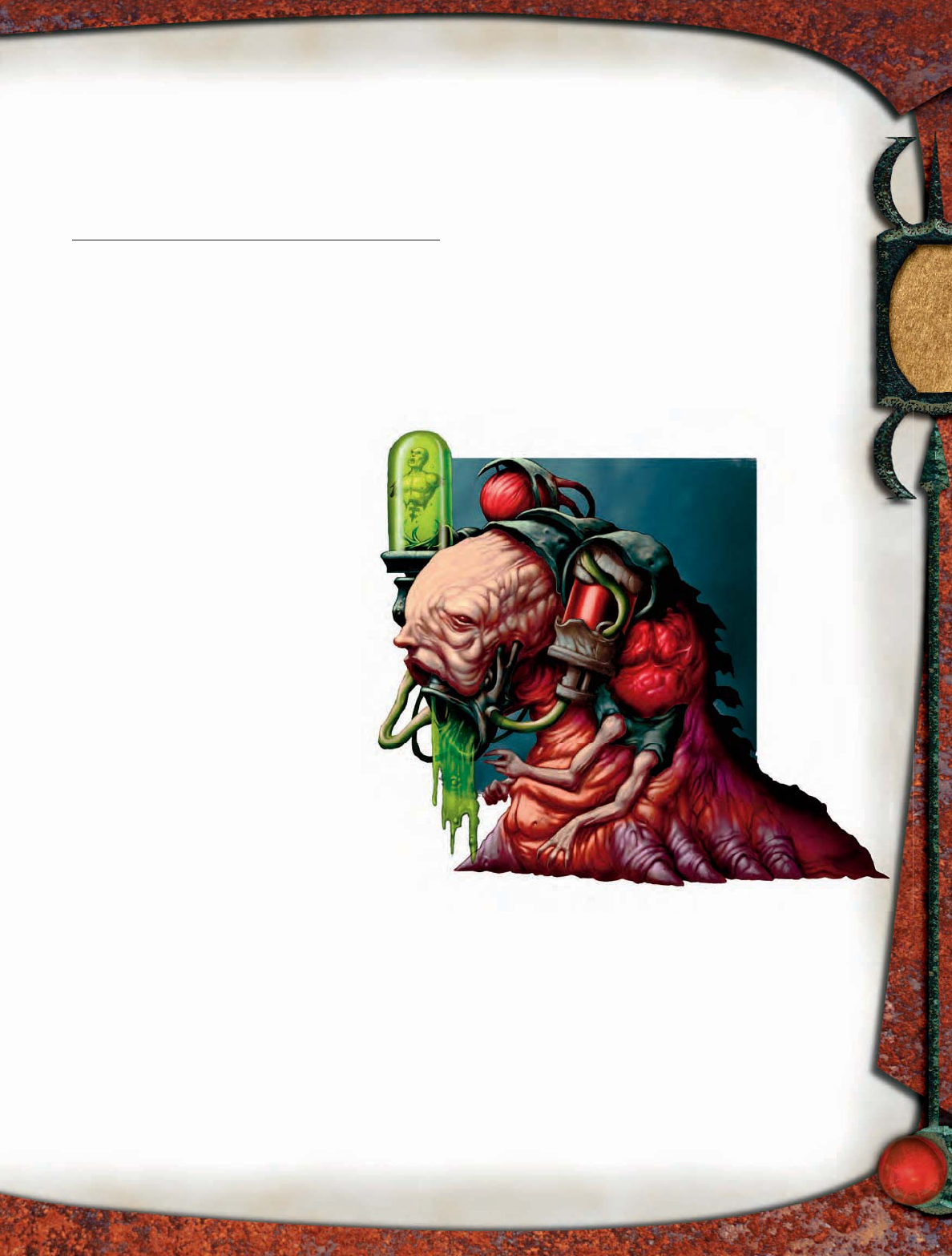
115
Abilities Str 30, Dex 10, Con 26, Int 19, Wis 15, Cha 13
SA launch spawn, mind blast, spell-like abilities
Feats Alertness, Improved Initiative, Sense Quintessence*,
Weapon Focus (bite)
* New feat; see sidebar, page 110.
Skills Concentration +21, Intimidate +14, Knowledge
(arcana) +17, Knowledge (the planes) +17, Listen +17,
Spot +17, Survival +2 (+4 on other planes)
Advancement unknown; see Advanced Madcrafters of Thoon
Launch Spawn (Su) A madcrafter of Thoon usually takes
a full day to give birth to a stormcloud of Thoon or a
scyther of Thoon. When threatened, however, it can
create constructs far more rapidly, then expel them in
globules of caustic spittle. Once per round, as a swift
action, a madcrafter of Thoon can spit a stormcloud of
Thoon or a scyther of Thoon into any unoccupied square
within 60 feet.
The caustic birthing fluid that surrounds the
new construct covers the square the construct
lands in and all adjacent squares. Creatures
in those squares take 6d6 points of acid
damage (Reflex DC 23 half). For 1 minute
afterward, any creature that steps in a
square covered by acid takes 3d6 points
of acid damage.
A typical madcrafter of Thoon has
enough stored quintessence to safely use
its launch spawn ability twice per day. If it
uses launch spawn a third time, it loses
its fast healing ability for the rest of the
day. The fourth and subsequent times it
uses launch spawn, it takes 20 points of
damage.
Mind Blast (Sp) 60-foot cone, stuns for 3d4
rounds (Will DC 15 negates). Unlike its mind
flayer cousins, a madcrafter of Thoon can use
mind blast only three times per day.
A madcrafter of Thoon is a living factory for
some of the quintessence-fueled constructs
employed by the mind fl ayers of Thoon.
Strategies and Tactics
Because a madcrafter of Thoon can create its own
allies, it’s a good choice for a lone monster—but it won’t
be alone for long. The swift action required to launch
spawn doesn’t mean that the madcrafter is truly creating
new constructs in the blink of an eye. It instead represents
how the madcrafter can do other tasks during most of the
birthing process.
In combat, a madcrafter of Thoon is strongest if it can
begin at range, launching two spawn in the first 2 rounds
to put some defenders between itself and its foes. If it can
damage those adversaries with acid from the birthing
fluid, all the better. Then, it assesses the tactical situ-
ation, using launch spawn even more if opponents are
overcoming or outmaneuvering its other spawn and if it
can afford to take the damage. It makes melee attacks if
it must, but it prefers to let its constructs fight while it
uses mind blast.
A madcrafter of Thoon’s biggest weakness is its slow speed.
It is acutely aware that it can’t outrun opponents or flee
determined pursuit, so it retreats through narrow passages
that it can cover with acid.
pqqqqqqqqqqqqqqqqqqqqrs
Because the madcrafter of Thoon is essentially a monster that
spawns other monsters, you should be aware of a few special con-
siderations when planning a madcrafter of Thoon encounter.
The first consideration: Madcrafters handle high-level PCs
poorly because they depend on CR 6 monsters to do much
of their dirty work. The CR 10 madcrafter is indeed a suitable
challenge for four 10th-level PCs. But two CR 10 madcrafters
don’t challenge four 12th-level PCs in the same way, because
the CR 6 scythers of Thoon just can’t hurt the PCs. Nor would
four CR 10 madcrafters challenge a 14th-level group. You can,
however, mix a single madcrafter with other monsters to get
the encounter level you desire.
The second consideration is your own fun at the table. You
can use the madcrafter of Thoon to spawn construct after con-
struct, and if you’re tactically minded, you can give the PCs fits
with this monster. You’re the one responsible for tracking all
those monsters, and nobody at the gaming table is having any
fun when it takes you 10 minutes to move your army of con-
structs. Think carefully about how many monsters you want to
be running at a time.
pqqqqqqqqqqqqqqqqqqqqrs
DESIGNING MADCRAFTER ENCOUNTERS
MIND FLAYERS
OF THOON
Madcrafter of Thoon
Illus. by D. Allsop
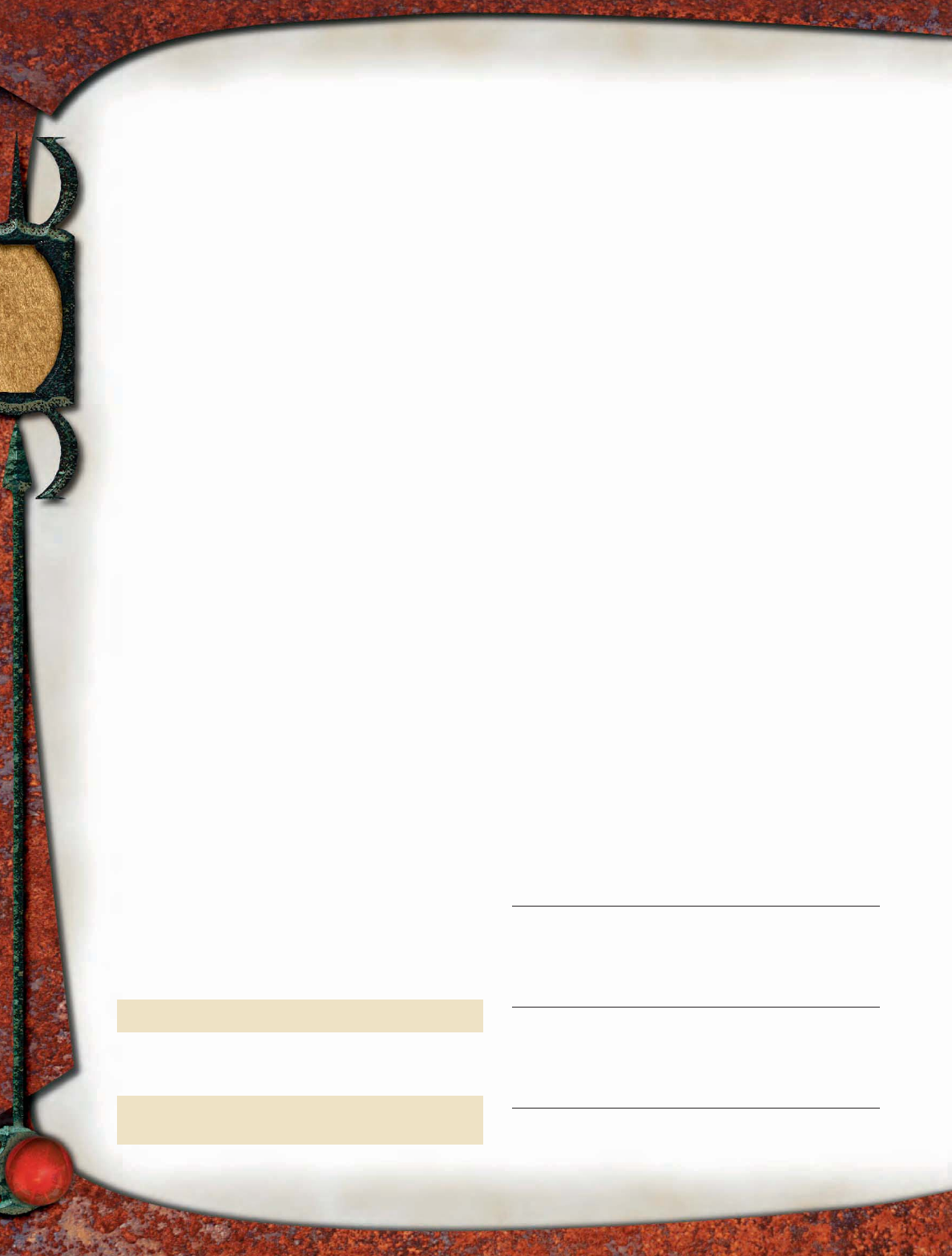
116
Ecology
Looking at them, it’s difficult to believe that the mad-
crafters of Thoon were once mind flayers. Contact with
the Far Realm and Thoon has twisted them into the
immense, sluglike creatures they are today.
A madcrafter of Thoon subsists entirely on quintessence.
Because madcrafters of Thoon are slow and vulnerable
out in the world, other creatures gather quintessence
for them.
Though the madcrafters of Thoon are no longer mind
fl ayers, they have a similar life cycle. The asexual madcrafters
give birth to thousands of tadpoles in a spawning pool deep
within the nautiloid vessel (not the same pool the Thoon elder
brain lives in). The tadpoles feast on each other in a frenzy
of cannibalism punctuated by long periods of group torpor.
Eventually, one massive madcrafter of Thoon, grown fat from
consuming its siblings, slithers from the spawning pool and
immediately demands its fi rst taste of quintessence.
The madcrafters of Thoon need only quintessence to
survive from that point forward, but they have a vestigial
appetite for sentient brains. They don’t derive nutrition from
brains, but a sentient brain sends a madcrafter of Thoon into
fi ts of ecstasy. Thoon elder brains and Thoon disciples use
fresh brains as rewards to keep their construct-producing
madcrafters in line.
Environment: A creature that churns out constructs
is valuable, so the mind fl ayers of Thoon usually keep the
madcrafters safe in their main base. If an outpost beyond the
nautiloid vessel is safe, the mind fl ayers might try to move
a madcrafter of Thoon there, because it’s useful to have a
construct factory and quintessence repository on site. Still,
doing so is tricky, because the madcrafters are slow and attract
a lot of attention.
Typical Physical Characteristics: A madcrafter of
Thoon is almost 20 feet long and weighs about ten tons.
Aside from forelimbs and a head, a madcrafter’s anatomy is
confusing and alien. Its most prominent feature is its oozing,
gaping mouth.
Alignment: Madcrafters of Thoon are neutral evil, but
with a twist. They’re more lawful when given a regular diet
of quintessence and more chaotic when denied quintessence
or given too many brains to eat.
Society
Alone among the mind fl ayers of Thoon, the madcrafters of
Thoon actually consume quintessence. The other followers
of Thoon gather it because Thoon directs them to, and they
covet it for the power it promises. The madcrafters, however,
have a direct connection to quintessence and a craving for
it that sometimes overwhelms their reason. Consequently,
the mind fl ayers keep the madcrafters well fed—a starving
madcrafter lashes out at everyone and does almost anything
to attain more quintessence.
Quintessence isn’t the madcrafters’ only dependency. They
are addicted to the pleasure of eating sentient brains. Even
a madcrafter that feeds on a matrix of quintessence starts
to feel hunger pangs soon afterward, never feeling sated by
quintessence consumption. If given a sentient brain, however,
it might be lost in pleasure for hours, its hunger for quintes-
sence forgotten.
Advanced Madcrafters of Thoon
The mind fl ayers of Thoon don’t have any madcrafters with
more than 10 Hit Dice—yet. Some Thoon disciples theo-
rize that feeding a madcrafter of Thoon a large amount of
quintessence might cause it to grow, perhaps exponentially.
The Thoon elder brain is considering more aggressive
quintessence-gathering to experiment with overfeeding a
madcrafter of Thoon.
SCYTHER OF THOON
Before you is a silvery automaton with four arms, perfectly
constructed to wield the two wicked-looking scythes it carries. Its
eyes glow as they cast forth beams of illumination. It crouches as if
preparing to attack.
Scyther of Thoon CR 6
Always N Medium construct
Init +2; Senses darkvision 60 ft., illumination, low-light
vision; Listen +1, Spot +1
Languages understands telepathic commands
AC 18, touch 12, flat-footed 16
(+2 Dex, +6 natural)
hp 69 (9 HD); natural healing
Immune acid, construct immunities
Resist electricity 10
Fort +3, Ref +5, Will +4
Speed 30 ft. (6 squares)
Melee 2 mwk scythes +11 each (2d4+6/×4)
Ranged searing light +8 touch (damage varies; see below)
Space 5 ft.; Reach 5 ft.
Base Atk +6; Grp +10
Special Actions dispelling touch
Abilities Str 18, Dex 14, Con —, Int —, Wis 13, Cha 5
SA dispelling touch, searing light
SQ construct traits
MIND FLAYERS
OF THOON
pqqqqqqqqqrs
MADCRAFTER OF THOON LORE
Characters who have ranks in Knowledge (dungeoneering)
can learn more about madcrafters of Thoon. When a character
makes a successful skill check, the following lore is revealed,
including the information from lower DCs.
Knowledge (Dungeoneering)
DC Result
25 This is a madcrafter of Thoon, a sluglike aberration
that can vomit out constructs.
30 Madcrafters of Thoon used to be mind fl ayers, but
they were twisted by contact with the Far Realm.
They retain some of the mind fl ayers’ mental
powers.
35 Madcrafters of Thoon are fueled by a mysterious
substance called quintessence, which the mind
fl ayers of Thoon gather for them.
pqqqqqqqqqrs
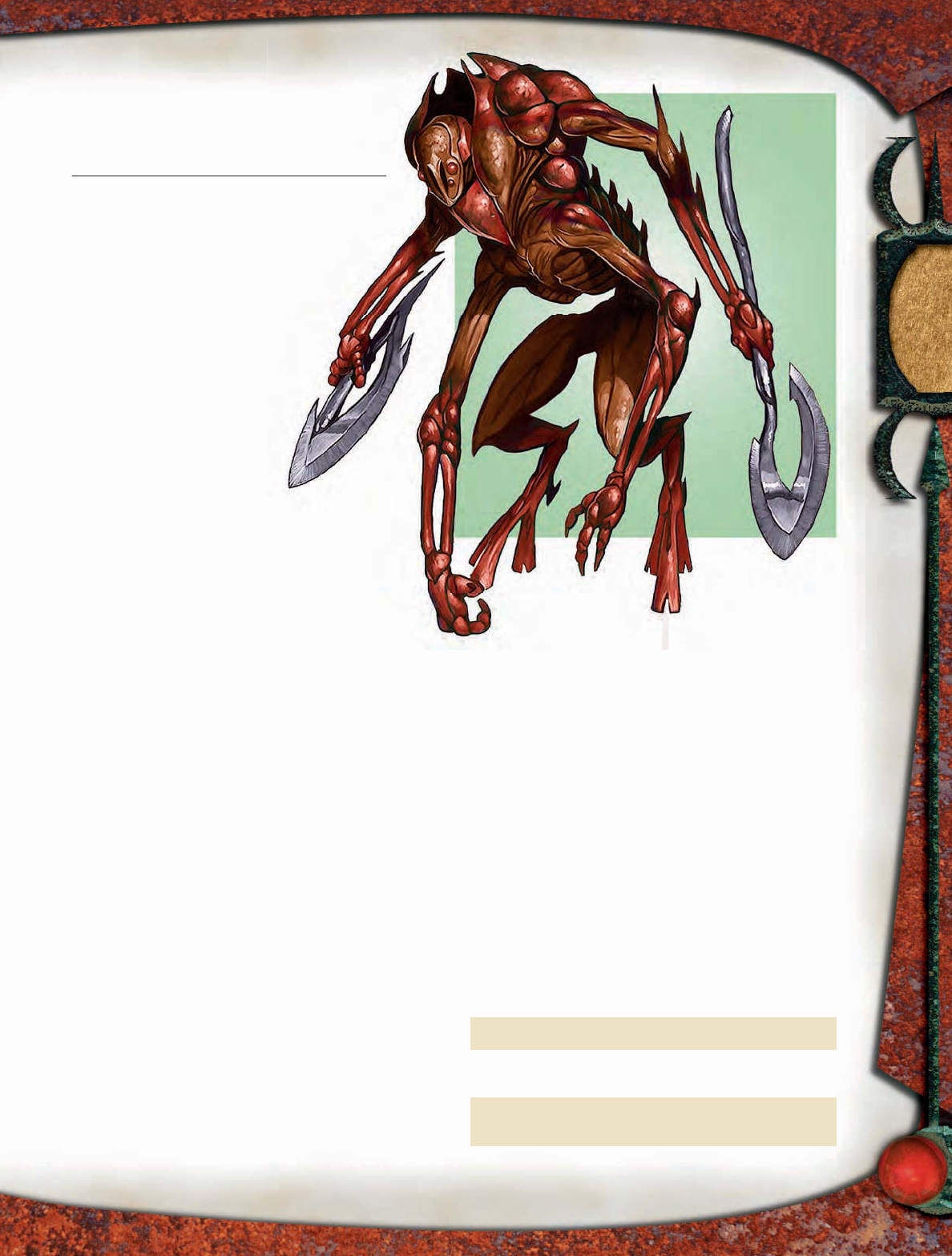
117
Feats —
Skills Listen +1, Spot +1
Advancement unknown; see Advanced Scythers of
Thoon
Possessions 2 masterwork scythes
Illumination As long as at least two other scythers
of Thoon are within 30 feet, the glowing eyes
of a scyther shed light in a 60-foot cone and
provide shadowy illumination in a 120-foot
cone. A scyther of Thoon can close its eyes
to douse the illumination, but doing so
leaves it blind.
A scyther of Thoon that has only
one other scyther within range still
has glowing eyes, but those eyes
provide only a 20-foot radius of
bright illumination and a 40-foot
radius of shadowy illumination.
A scyther of Thoon by itself
has faintly glowing eyes that
provide shadowy illumination
in a 5-foot radius.
Natural Healing (Ex) A scyther
of Thoon is capable of
natural healing, albeit very
slowly. A scyther of Thoon
heals 1 hit point for every 8
hours it remains motionless.
Searing Light (Sp) A scyther of Thoon can focus its
glowing eyes to emit a damaging beam of light
that functions as a searing light spell; at will; +8
ranged touch; caster level 6th. Unlike the spell,
a scyther of Thoon’s searing light deals an extra
1d8 points of damage for each scyther of Thoon
within 30 feet (maximum 5d8), including the scyther
emitting the searing light.
After one scyther of Thoon has used searing light, the
glowing eyes of any others within 30 feet dim briefly, and
none of those creatures can use searing light during the
same round.
Dispelling Touch (Su) With a successful melee touch attack,
a scyther of Thoon can wipe away spells and magical
effects. This ability functions as a targeted dispel magic
spell (caster level 6th). Against each ongoing spell
currently in effect on the object or creature touched, a
scyther makes a dispel check at +6 against a DC of 11 +
the spell’s caster level.
Each time a scyther of Thoon uses dispelling touch, it
takes 10 points of damage.
Scythers of Thoon are constructs vomited forth by mad-
crafters of Thoon. They serve as foot soldiers to advance the
cause of Thoon.
Strategies and Tactics
Scythers of Thoon are best used in groups with other
scythers, when they’re strongest and most interesting.
The most common tactic for a group of scythers is to have
all but one rush into melee, while the remaining scyther
uses searing light against a target that is either about to drop
or can’t be attacked by other scythers in melee.
Without a sentient mind to guide them, scythers of
Thoon use their dispelling touch only if a magical effect is
preventing them from damaging their target, and it must
be something obvious such as a magical wall or a visible
defensive spell. With a mind flayer or even a stormcloud
of Thoon to guide them, scythers of Thoon can put dispel-
ling touch to better tactical use, ending beneficial spells,
grounding foes who use fly spells, and otherwise wreak-
ing havoc with carefully built plans. Thoon disciples in
particular have enough ranks in Spellcraft to know what
pqqqqqqqqqrs
SCYTHER OF THOON LORE
Characters who have ranks in Knowledge (dungeoneering)
can learn more about scythers of Thoon. When a character
makes a successful skill check, the following lore is revealed,
including the information from lower DCs. A character who
has ranks in Knowledge (arcana) can attempt this check, but
the DCs increase by 10.
Knowledge (Dungeoneering)
DC Result
21 This is a scyther of Thoon, a foot soldier construct
invented by the mind fl ayers of Thoon.
26 Scythers of Thoon can shoot fi ery beams of light
from their eyes. These beams are weaker if a
scyther is not near other scythers of Thoon.
31 Scythers of Thoon can neutralize magic spells with
a touch. They are immune to acid and resistant to
electricity, and they heal without requiring repair.
pqqqqqqqqqrs
MIND FLAYERS
OF THOON
Scyther of Thoon
Illus. by W. Mahy
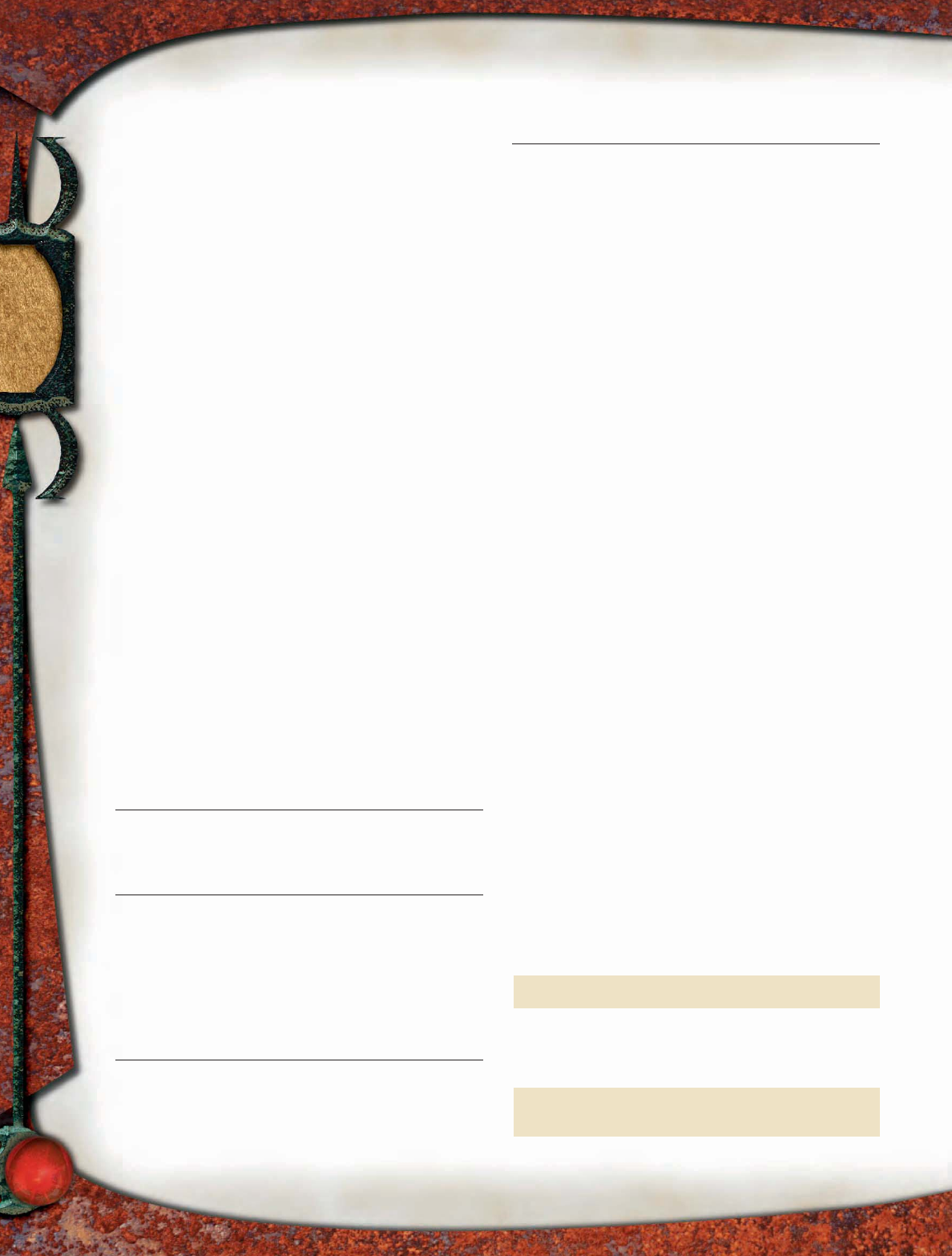
118
spells the PCs are using and whether it’s worthwhile to
attempt a dispelling touch.
Ecology
After being given enough quintessence and metal ore,
madcrafters of Thoon spit out scythers that then await
orders from any telepathic creature of Thoon (usually a mind
fl ayer). Unlike Thoon hulks and Thoon soldiers, scythers of
Thoon don’t need to return to their “parent” to heal—they
do so naturally.
Environment: Most scythers of Thoon are kept in
squads of four to six within the mind flayers’ base, but
outside the nautiloid vessel. Scythers are plentiful, so mind
fl ayers often order a pair of scythers to follow them around
as menial servants.
Typical Physical Characteristics: A scyther of Thoon
is 5-1/2 feet tall and weighs 250 pounds. It relaxes its lower
arms when walking, giving it a lumbering gait, but it uses
both arms to swing its scythes in combat.
Alignment: Scythers of Thoon are neutral, with behavior
solely dependent on their programming and orders.
Advanced Scythers of Thoon
As with stormclouds of Thoon, madcrafters of Thoon don’t
regurgitate scythers that have any more than 8 Hit Dice.
Advanced madcrafters of Thoon might give birth to stronger
scythers of Thoon.
STORMCLOUD OF THOON
This fl oating metal egg has an array of tentacles hanging from its
underside, many of which have sharp blades or grasping claws at the
end. Eyelike spots near the front glow with malign intelligence.
Stormcloud of Thoon CR 5
Usually NE Medium construct
Init +2; Senses darkvision 60 ft., illumination, low-light
vision, tremorsense 60 ft. (see below); Listen +7, Spot +7
Languages Undercommon; telepathy 100 ft.
AC 17, touch 12, flat-footed 15
(+2 Dex, +5 natural)
hp 64 (8 HD); natural healing
Immune acid, construct immunities
Fort +2, Ref +8, Will +9
Speed 30 ft. (6 squares), fly 10 ft. (perfect), swim 20 ft.;
levitative movement
Melee 4 tentacles +8 each (1d4+1)
Space 5 ft.; Reach 5 ft.
Base Atk +6; Grp +7
Atk Options Combat Reflexes
Special Actions lightning bolt (5d6; DC 12; see below)
Spell-Like Abilities (CL 5th):
At will—detect magic
3/day—shield
Abilities Str 13, Dex 14, Con —, Int 5, Wis 16, Cha 9
SA lightning bolt, spell-like abilities
SQ construct traits
Feats Combat Reflexes, Sense Quintessence*, Weapon
Focus (tentacle)
* New feat; see sidebar, page 110.
Skills Listen +7, Search +0, Spot +7, Swim +9
Advancement unknown; see Advanced Stormclouds of
Thoon
Illumination The glowing eyes of a stormcloud of Thoon
shed light in a 60-foot cone and provide shadowy
illumination in a 120-foot cone. A stormcloud of Thoon
can close its eyes and eliminate the illumination, but
doing so leaves it blind.
Tremorsense (Ex) A stormcloud of Thoon must bury one
of its tentacles a few inches under the ground for its
tremorsense to function. Doing so is a swift action, but
a stormcloud loses tremorsense if it moves out of the
square in which it set the tentacle.
Natural Healing (Ex) Unlike most constructs, a stormcloud
of Thoon is capable of natural healing, albeit very slowly.
A stormcloud of Thoon heals 1 hit point for every 8 hours
it remains motionless.
Levitative Movement (Ex) Even when the creature uses its
land speed, the body of a stormcloud of Thoon is actually
floating about 5 feet off the ground, propelled by an
unseen force. A stormcloud of Thoon’s tentacles don’t
need to touch the ground when moving, and the creature
is unaffected by difficult or hazardous terrain.
When a stormcloud of Thoon flies more than 5 feet
above the ground, its speed slows dramatically.
Lightning Bolt (Sp) As the lightning bolt spell; at will; DC 12,
caster level 5th. A stormcloud of Thoon must tap into its
quintessence reserves to use this ability, causing it to take
10 points of damage whenever it does so.
Skills A stormcloud of Thoon has a +8 racial bonus on any
Swim check to perform some special action or avoid a
hazard. The creature can always choose to take 10 on a
Swim check, even if distracted or endangered. It can use
the run action when swimming, provided it swims in a
straight line.
Stormclouds of Thoon, constructs birthed by madcrafters
of Thoon, are fl oating sentinels that are adept at locating
quintessence sources and spotting the enemies of the mind
fl ayers of Thoon.
MIND FLAYERS
OF THOON
pqqqqqqqqqrs
STORMCLOUD OF THOON LORE
Characters who have ranks in Knowledge (dungeoneering)
can learn more about stormclouds of Thoon. When a char-
acter makes a successful skill check, the following lore is re-
vealed, including the information from lower DCs. A character
who has ranks in Knowledge (arcana) can attempt this check,
but the DCs increase by 10.
Knowledge (Dungeoneering)
DC Result
20 This egg-shaped construct is a stormcloud of
Thoon. It is a creation of the mind fl ayers.
25 A sect called the mind fl ayers of Thoon uses
stormclouds of Thoon to scout for brains and
gather a substance called quintessence. The
construct is a capable melee combatant, and it can
emit a lightning bolt seemingly at will.
30 A stormcloud of Thoon is immune to acid. It has
the ability to heal naturally, unlike most constructs.
This healing happens slowly, however.
pqqqqqqqqqrs
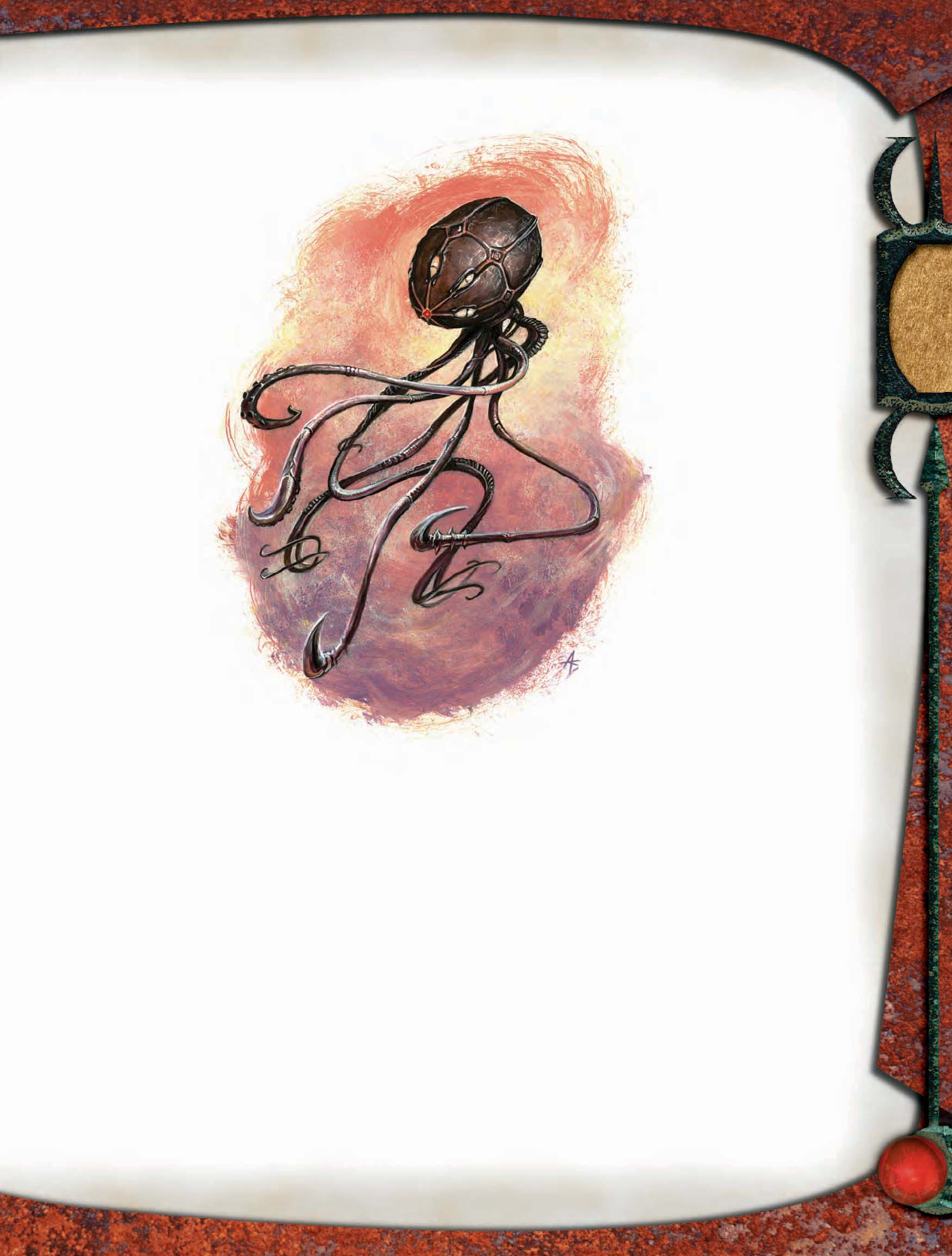
119
Strategies and Tactics
A stormcloud of Thoon is a useful creature to mix into a
group of shadow flayers, Thoon soldiers, or scythers
of Thoon. It adds some detection abilities and
a ranged area attack that those mon-
sters lack. A stormcloud of Thoon’s
lightning bolt comes at a price,
however, so it’s better as a melee
combatant than as a magic ar-
tillery piece.
In battle, a stormcloud of
Thoon fl oats near the melee
combatants, attacking with
its tentacles but remain-
ing alert for foes who
group in clusters or
lines. If it can hit
three or more oppo-
nents with a lightning
bolt, it moves into posi-
tion to do so.
Ecology
Stormclouds of
Thoon are creat-
ed by mad crafters of
Thoon. Storm clouds
range farther from the
mind fl ayer base than oth-
er constructs. It’s easy for
a mad crafter of Thoon to
regurgitate a storm cloud of
Thoon, so the mind flayers of
Thoon aren’t overly concerned when
enemies destroy a stormcloud. The illithids
don’t send their stormclouds of Thoon too far
afield simply because the ovoid constructs can
reveal the mind flayers’ presence.
Environment: Stormclouds of Thoon can travel with
ease over most kinds of terrain. Even when technically using
their land speed or swimming, they’re actually fl oating, so
underwater depths, muck-fi lled swamps, and diffi cult terrain
pose no barrier to their travels.
Typical Physical Characteristics: A stormcloud of
Thoon floats about 4 feet above the ground. Its tentacles
are about 6 feet long on average, and it weighs about 100
pounds. Eyelike structures form a radial pattern on the
front of its egg-shaped head. The tentacles that protrude
in a jumble from the bottom of a stormcloud’s head serve
a variety of functions.
Alignment: Stormclouds of Thoon are neutral evil, but
that alignment represents more their casual willingness
to perform evil deeds for their masters than an innate,
supernatural evil. Stormclouds have only a rudimentary
sense of right and wrong—they just do what they’re told
and won’t go out of their way to help or harm others unless
directed to do so.
Society
Unlike most constructs, storm-
clouds of Thoon are fully
sentient. Even so, they’re dull-
ards in a community of evil
geniuses, so they rarely put their
intellects to much use.
Socially, a stormcloud of
Thoon is a very passive crea-
ture. Among the mind fl ayers of
Thoon, everyone else is smarter
than a stormcloud and capa-
ble of ordering it around. As
a result, stormclouds of Thoon
usually don’t communicate or
interact beyond what’s re-
quired to accomplish their
assigned tasks.
Stormclouds of Thoon
blame their limited intel-
lect for their incomplete
understanding of the will
of Thoon, not realizing that
the Thoon elder brain and the
Thoon disciples might likewise be
in the dark about the larger pur-
pose behind Thoon veneration and
quintessence-gathering.
Out in the field, however, a storm-
cloud of Thoon can put its sentience to use,
assessing the risks in each encounter before
rushing headlong into battle. Mind flayers
often put stormclouds of Thoon in charge of
scythers of Thoon or even Thoon soldiers. If
something unusual happens, a stormcloud tries to think
of the best response rather than mindlessly executing
programming.
Advanced Stormclouds of Thoon
Madcrafters of Thoon don’t create stormclouds of Thoon that
have any more than 8 Hit Dice. No stormcloud of Thoon has
gained Hit Dice, but the mind fl ayers are waiting for stronger
versions of the construct to evolve.
Some mind flayers believe that stronger madcrafters of
Thoon might create stronger stormclouds of Thoon and
scythers of Thoon, so the secret to an advanced stormcloud
is to create an advanced madcrafter. Other illithids think
that since stormclouds of Thoon are actually sentient,
it might be worthwhile to teach them skills (which you
can model with class levels in classes such as fighter and
rogue). Thoon disciples are awaiting the guidance of Thoon
on this matter.
Stormcloud
of Thoon
MIND FLAYERS
OF THOON
Illus. by A. Stokes
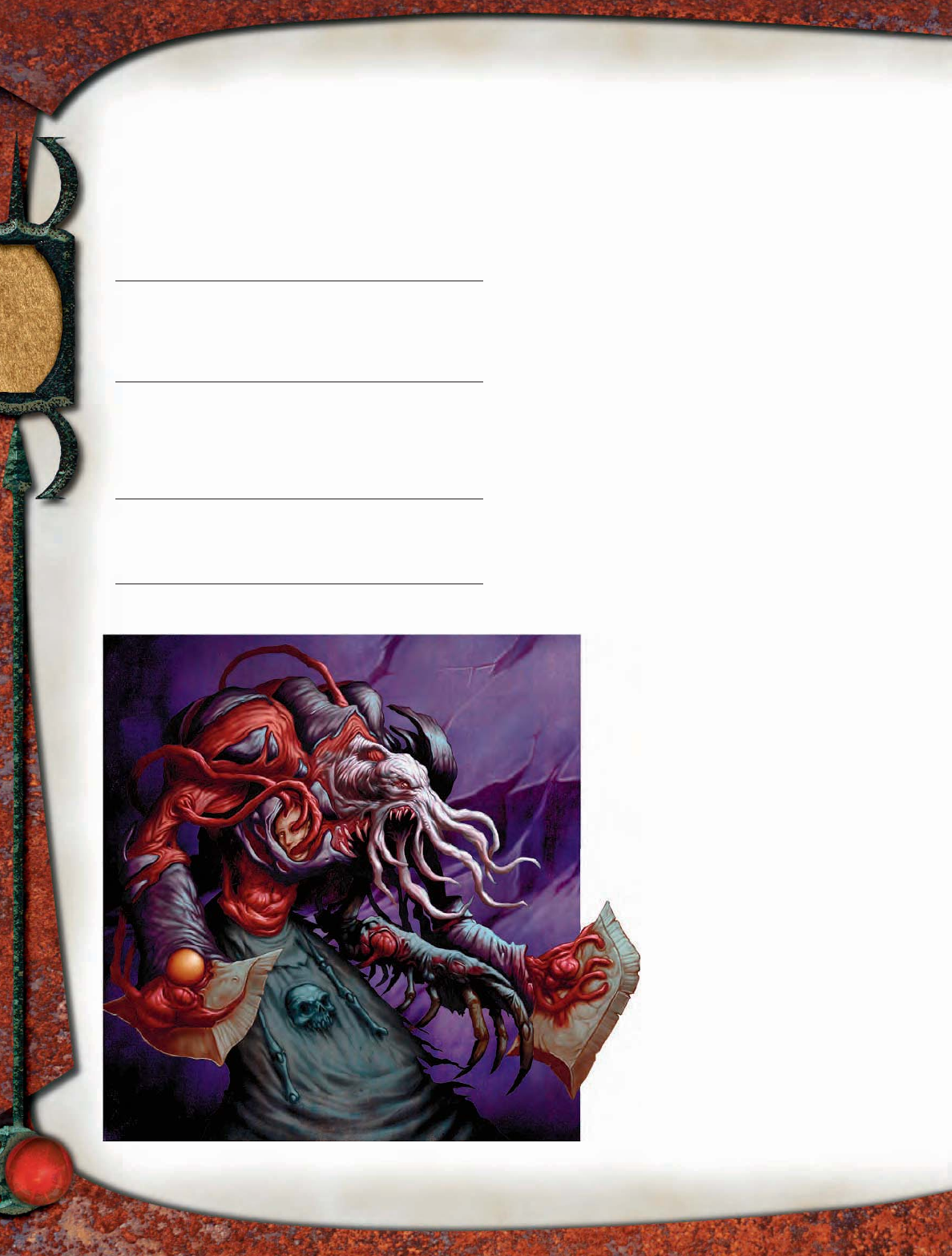
120
THOON HULK
This amalgamation of rubbery fl esh and artifi cial parts has heavy
axelike blades instead of hands and twisted, slimy tentacles covering
the lower half of its face.
Thoon Hulk CR 13
Always NE Large construct
Init +1; Senses darkvision 60 ft., low-light vision; Listen +4,
Spot +4
Languages understands telepathic commands
AC 26, touch 14, flat-footed 25; deflection shield
(–1 size, +1 Dex, +4 deflection, +12 natural)
hp 112 (15 HD)
Immune construct immunities
Resist acid 20, cold 20, electricity 20, fire 20, sonic 20
Fort +5, Ref +6, Will +9; defense overdrive
Speed 40 ft. (8 squares)
Melee 2 arm-axes +18 each (1d12+8) and
4 tentacles +13 each (1d6+4)
Space 10 ft.; Reach 10 ft.
Base Atk +11; Grp +23
Atk Options critical knockback, improved grab
Special Actions attack overdrive, extract
Abilities Str 27, Dex 13, Con —, Int —, Wis 18, Cha 10
SA attack overdrive, defense overdrive, extract
Feats —
Skills Listen +4, Spot +4
Advancement 16–20 HD (Large); 21 HD (Huge); see text
Deflection Shield (Su) A Thoon hulk has a force screen
around it at all times, granting it a +4 deflection
bonus to AC.
Defense Overdrive (Ex) As an immediate action, a Thoon
hulk can gain a +2 bonus on saving throws for 1 round.
Using this ability deals 10 points of damage to the Thoon
hulk. If a Thoon hulk uses this ability, its attack overdrive
ends immediately.
Critical Knockback (Ex) If a Thoon hulk threatens a critical
hit with its arm-axes, its target flies back 10 feet in a
straight line away from the Thoon hulk, landing prone.
The Thoon hulk chooses the path, but that path must
be away from the Thoon hulk in as direct a path as
possible. Intervening obstacles shorten or prevent
the knockback. The Thoon hulk still rolls to confirm
the threat, dealing appropriate damage depending on
whether the threat is confirmed.
Attack Overdrive (Ex) As a swift action, a Thoon hulk can
gain a +2 bonus on attack rolls and damage rolls for 1
round. Using this ability deals 10 points of damage to the
Thoon hulk. If a Thoon hulk uses this ability, its defense
overdrive ends immediately.
Improved Grab (Ex) To use this ability, a Thoon hulk must hit
a creature of up to Huge size with a tentacle attack. It can
then attempt to start a grapple as a free action without
provoking attacks of opportunity.
If it wins the grapple check, it establishes a hold and
attaches a tentacle to the opponent’s head. A Thoon
hulk can grab a Gargantuan or larger creature, but only
if it can somehow reach the foe’s head. If a Thoon hulk
begins its turn with at least one tentacle attached, it
can try to attach its remaining tentacles with a single
grapple check. The opponent can escape
with a single successful grapple check or an
Escape Artist check, but the Thoon hulk gets
a +2 circumstance bonus for every tentacle
that was attached at the beginning of the
opponent’s turn.
Extract (Ex) If a Thoon hulk begins its
turn with all four tentacles attached to its
opponent and makes a successful grapple
check, it extracts that opponent’s brain,
instantly killing that creature. Constructs,
elementals, oozes, plants, and undead are
immune.
Born of Thoon-inspired fleshcrafting
within the mind flayers’ nautiloid vessel,
Thoon hulks are pitiless brutes that
obey their illithid masters’ telepathic
commands.
Strategies and Tactics
The Thoon hulk is a brute that makes
it a good complement to mind fl ayers.
Thoon hulks make up the vanguard of
a mind fl ayer assault.
Mind flayers (including Thoon
disciples and shadow flayers) also take ad-
vantage of the Thoon hulks’ immunity to
stunning. Thoon hulks can stand wherev-
er they want and not worry about whether
Thoon hulk
MIND FLAYERS
OF THOON
Illus. by D. Allsop

121
they’re getting in the way of a mind flayer’s mind blast.
This makes them effective defenders to shield their mind
flayer masters.
In melee combat, a Thoon hulk’s favorite technique is
to grapple with tentacles and extract brains in time-hon-
ored mind fl ayer fashion.
Ecology
As constructs, Thoon hulks don’t eat, sleep, or breathe. But
unlike more mechanical creations, Thoon hulks have an
innate desire to keep moving. This trait makes them poor
guards for lengthy assignments in enclosed spaces, although
they do well when given patrol duty along a path at least a
few hundred yards long.
Unlike mind fl ayers, Thoon hulks can’t derive sustenance
from the brains they extract. They take brains back to the
nautiloid vessel if they contain quintessence, or give them
to the nearest mind fl ayer if ordered to do so.
A Thoon hulk emerges from its cocoon with three arms.
Two have axelike blades attached to them, and the third is
clawed. Thoon hulks don’t use their clawed hands in combat,
although they can pick up items, open doors, and manipulate
objects with them.
Environment: Cocoonlike structures within the nauti-
loid’s inner chambers create Thoon hulks from quintessence,
carefully crafted metal parts, and vivisected bodies of mind
fl ayers that the Thoon elder brain found unworthy.
Damaged Thoon hulks are returned to the cocoons, where
they heal 1 hit point per day.
Typical Physical Characteristics: A Thoon hulk is 10 feet
tall, but it looks shorter because it is usually hunched over. It
weighs 1,000 pounds, and its masses of bulging muscle and
deadly arm-axes clearly set it apart from normal mind fl ayers.
Bits and pieces of a Thoon hulk look like mind fl ayer fl esh,
but metal components are a major part of its anatomy.
Alignment: Without wills of their own, Thoon hulks are
never lawful or chaotic. Their creation and the deeds they do
leave them forever stained with evil.
Advanced Thoon Hulks
A undamaged Thoon hulk sometimes emerges from the cocoon
slightly tougher than before (with extra Hit Dice). If a Thoon
hulk that has 20 Hit Dice is placed in a cocoon, it emerges a
week later as a Huge Thoon hulk with 21 Hit Dice.
THOON ELDER BRAIN
Floating in the air is a purple, bulbous mass that looks like a giant
brain with trailing tentacles. You sense its telepathic power as an
oily wave washes across your consciousness.
Thoon Elder Brain CR 15
Usually NE Large aberration
Init +6, dual action; Senses darkvision 60 ft.; Listen +6,
Spot +6
Languages Undercommon; telepathy 1 mile
AC 26, touch 11, flat-footed 24
(–1 size, +2 Dex, +15 natural)
hp 174 (12 HD); fast healing 10
SR 26
Immune acid, fear
Fort +14, Ref +6, Will +14
Speed 10 feet (2 squares), fly 20 ft. (perfect), swim 30 ft.
Melee 8 tentacles +17 each (1d6+8 plus 2d6 acid)
Space 10 ft.; Reach 10 ft.
Base Atk +9; Grp +21
Atk Options Combat Reflexes, acid burn
Special Actions confusion sphere, overmind blast
Spell-Like Abilities (CL 15th):
At will—charm monster (DC 20), detect magic, detect
thoughts (DC 18), mage armor, plane shift, suggestion
(DC 19).
3/day—dominate monster (DC 25)
Abilities Str 26, Dex 14, Con 30, Int 25, Wis 23, Cha 23
SA acid burn, confusion sphere, dual action, overmind blast,
spell-like abilities
Feats Ability Focus (confusion sphere), Combat Reflexes,
Improved Initiative, Sense Quintessence*, Weapon Focus
(tentacle)
* New feat; see sidebar, page 110.
Skills Bluff +21, Concentration +25, Diplomacy +25,
Intimidate +23, Knowledge (arcana) +22, Knowledge
(religion) +22, Knowledge (the planes) +22, Listen +6,
Sense Motive +21, Spellcraft +24, Spot +6
Advancement 13–19 HD (Large); 20–36 HD (Huge)
Dual Action (Ex) A Thoon elder brain is a creature made
up of multiple minds, all touched by the unreality of the
Far Realm. Make two initiative checks for the creature.
The higher result represents a mental action turn, and
the lower result is used for a physical action turn. This
means a Thoon elder brain can do more in a single round
than most creatures. For example, it could perform an
overmind blast (a purely mental action) on initiative
count 17, then move and make a tentacle attack (a
physical action) on initiative count 12. These initiative
counts can change if a Thoon elder brain readies an
action or delays to let its other half go first.
Acid Burn (Ex) The acid delivered by a Thoon elder brain’s
tentacles continues to burn in the round after the Thoon
MIND FLAYERS
OF THOON
pqqqqqqqqqrs
THOON HULK LORE
Characters who have ranks in Knowledge (dungeoneering)
can learn more about Thoon hulks. When a character makes a
successful skill check, the following lore is revealed, including
the information from lower DCs. A character who has ranks
in Knowledge (arcana) can attempt this check, but the DCs
increase by 10.
Knowledge (Dungeoneering)
DC Result
28 This is a Thoon hulk, a construct built as a
mindless automaton by the mind fl ayers of Thoon.
Like a mind fl ayer, it can extract brains.
33 Thoon hulks can enter an overdrive state that
makes them tougher, but doing so damages their
internal processes.
38 Mind fl ayers birth Thoon hulks in cocoon
structures that also heal the hulks. Their
amalgamated bodies are highly resistant to all
forms of energy.
pqqqqqqqqqrs
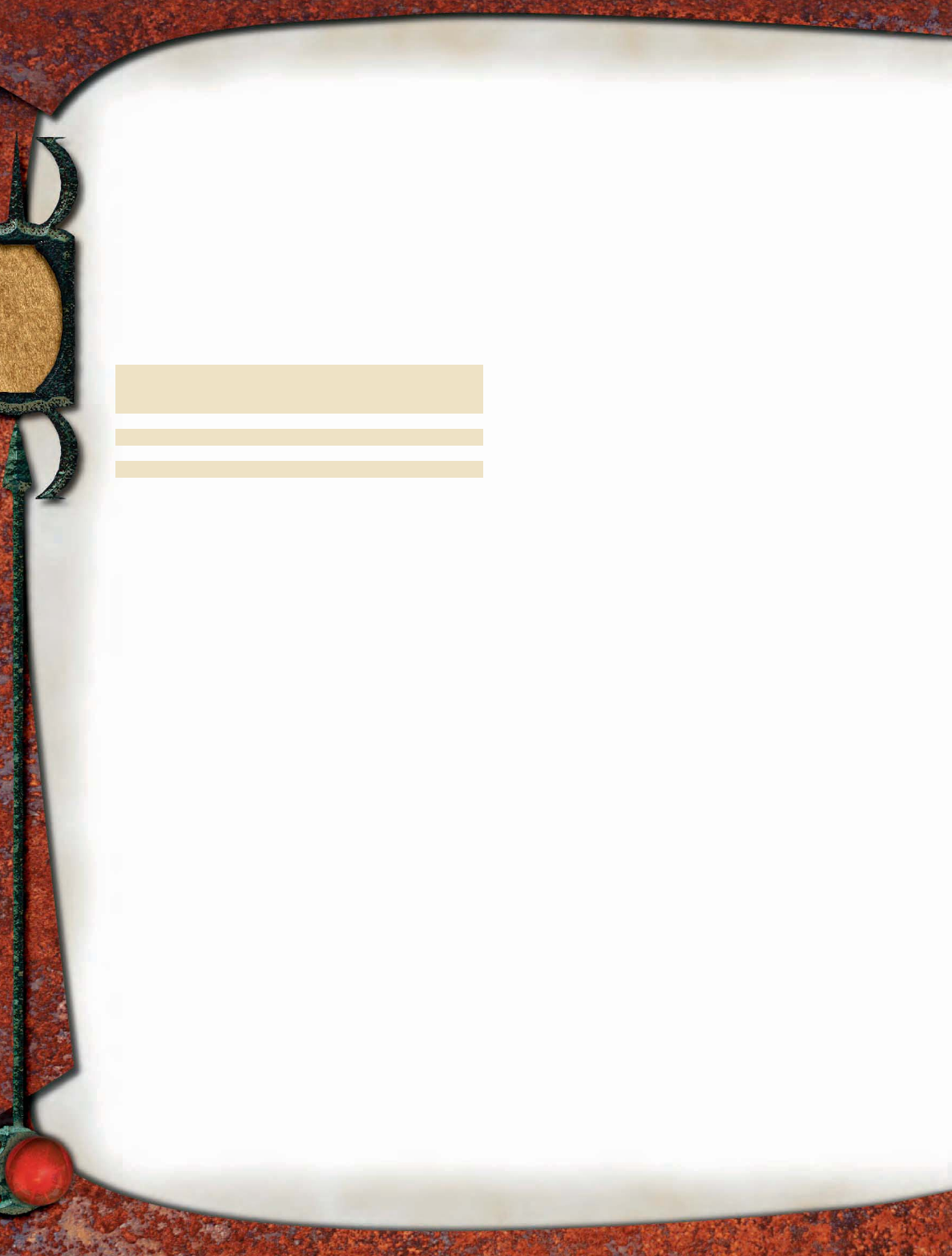
122
elder brain hits. At the beginning of each of a Thoon elder
brain’s physical action turns, the acid deals 4d6 points
of acid damage to any creature the Thoon elder brain hit
with a tentacle attack during the previous round. The
damage is always 4d6 points, regardless of how many
times the Thoon elder brain hit the creature.
Confusion Sphere (Su) A Thoon elder brain can scramble the
thoughts of nearby creatures. This ability functions like a
confusion spell (CL 15th, Will DC 22 negates), except that
all creatures (except for creatures of Thoon) within a 10-
foot radius centered on the Thoon elder brain are subject
to the effect. The effect lasts 15 rounds, but it cannot end
for an affected creature when that creature is still within
10 feet of the Thoon elder brain. At the beginning of each
affected creature’s turn, roll on the table below.
d% Effect
01–10 Attack the Thoon elder brain with melee or
ranged weapons, or close with the elder brain if
attack isn’t possible.
11–20 Act normally.
21–50 Do nothing but mutter “Thoon . . . Thoon . . .”
51–70 Flee from the Thoon elder brain at top speed.
71–100 Attack nearest creature.
Overmind Blast (Su) A Thoon elder brain can project the
horror of its consciousness against a single foe within
100 feet. That target must succeed on a DC 22 Will save
or take 2d6 points of Wisdom damage. Though overmind
blast isn’t a fear effect, a creature that has immunity to
fear or a save bonus against fear receives a +4 bonus on
the saving throw. The save DC is Charisma-based.
A creature that is reduced to 0 Wisdom by an over mind
blast is unconscious, but its body mutters, “Thoon . . .
Thoon . . . ” repeatedly until consciousness returns.
A Thoon elder brain is an elder brain that has been twisted
by its time in the Far Realm and now leads the mind fl ayers
of Thoon.
Strategies and Tactics
A Thoon elder brain is best used as a climactic encounter—the
big, bad monster at the end of an adventure. By the time the PCs
reach a Thoon elder brain, they should have fought their way
past dozens of mind fl ayers and other creatures of Thoon.
A Thoon elder brain’s tactics depend on whether it believes
one or more foes to be vulnerable to its powers of domination.
If so, the elder brain uses each of its mental actions to order
an opponent to turn on that foe’s allies. If this tactic fails
twice, the Thoon elder brain abandons it.
Its tactics also depend on the number of opponents. If a
Thoon elder brain is beset by multiple foes in melee, it uses
its confusion sphere to disrupt its opponents’ tactics and its
tentacles to damage anyone who isn’t confused. In situations
when a Thoon elder brain has allies or is facing only a few
adversaries, it uses its overmind blast from a safe distance.
With its physical action, it readies a tentacle attack in case a
foe moves within reach.
Ecology
Like a traditional mind fl ayer elder brain, a Thoon elder brain
subsists on tadpolelike immature mind fl ayers. Also, like all
creatures of Thoon, it requires distilled quintessence on a
weekly basis, or it slowly starves.
Environment: The sole known example of a Thoon elder
brain has spent its entire existence fl oating within a briny
pool in a central chamber of the Thoon nautiloid. However,
if a Thoon elder brain reproduces itself, any underground
environment is appropriate. A Thoon elder brain is always
near mind fl ayers and other creatures of Thoon.
Typical Physical Characteristics: A Thoon elder brain
is 8 feet across and weighs about 800 pounds. Its tentacles
reach a length of almost 20 feet. It’s diffi cult for a Thoon elder
brain to uncurl its tentacles completely, so its effective reach
is only 10 feet.
A Thoon elder brain doesn’t visibly age. Sometimes indi-
vidual tentacles atrophy and wither away, but they’re quickly
replaced with fresh, quintessence-fueled limbs.
Alignment: A Thoon elder brain is neutral evil, as are
most followers of Thoon. Its efforts to gather quintessence
without regard for the costs to others are unapologetically
evil. It keeps its followers tightly organized among themselves
(a lawful trait), but it can behave unpredictably and without
a clear long-term plan (a hallmark of chaos).
Society
Just one Thoon elder brain currently exists. It’s the one that
leads the mind fl ayers of Thoon from place to place, searching
out new sources of quintessence.
In most respects, a Thoon elder brain behaves like a tradi-
tional mind fl ayer elder brain. It’s imperious, brilliant, and
MIND FLAYERS
OF THOON
pqqqqqqqqqqqqqqqqqqqqrs
AN ELDER BRAIN AT CR 15?
Both Lords of Madness and Underdark have statistics for a mind
flayer elder brain. It’s a fine monster, but it’s CR 25, which limits
how many campaigns can use it—it’s difficult to build an ad-
venture in which both CR 8 mind flayers and their CR 25 leader
pose appropriate challenges.
The Thoon elder brain occupies encounter-design space closer
to the rank-and-file mind flayer. Because it relies on a smaller
set of psionic abilities, it’s also easier for a DM to run.
The existence of this elder brain doesn’t necessarily mean that
a CR 25 elder brain that goes to the Far Realm comes back at
CR 15. Whatever a Thoon elder brain was before it returned to
the Far Realm is beyond the realm of PC knowledge.
You can certainly file off the serial numbers, so to speak, and
use a Thoon elder brain as a normal mind flayer elder brain. If
you want both sorts of elder brains in your game, you can posit
that Thoon elder brains lead smaller mind flayer colonies, and
the elder brains described in Lords of Madness and Underdark
lead vast mind flayer cities.
pqqqqqqqqqqqqqqqqqqqqrs
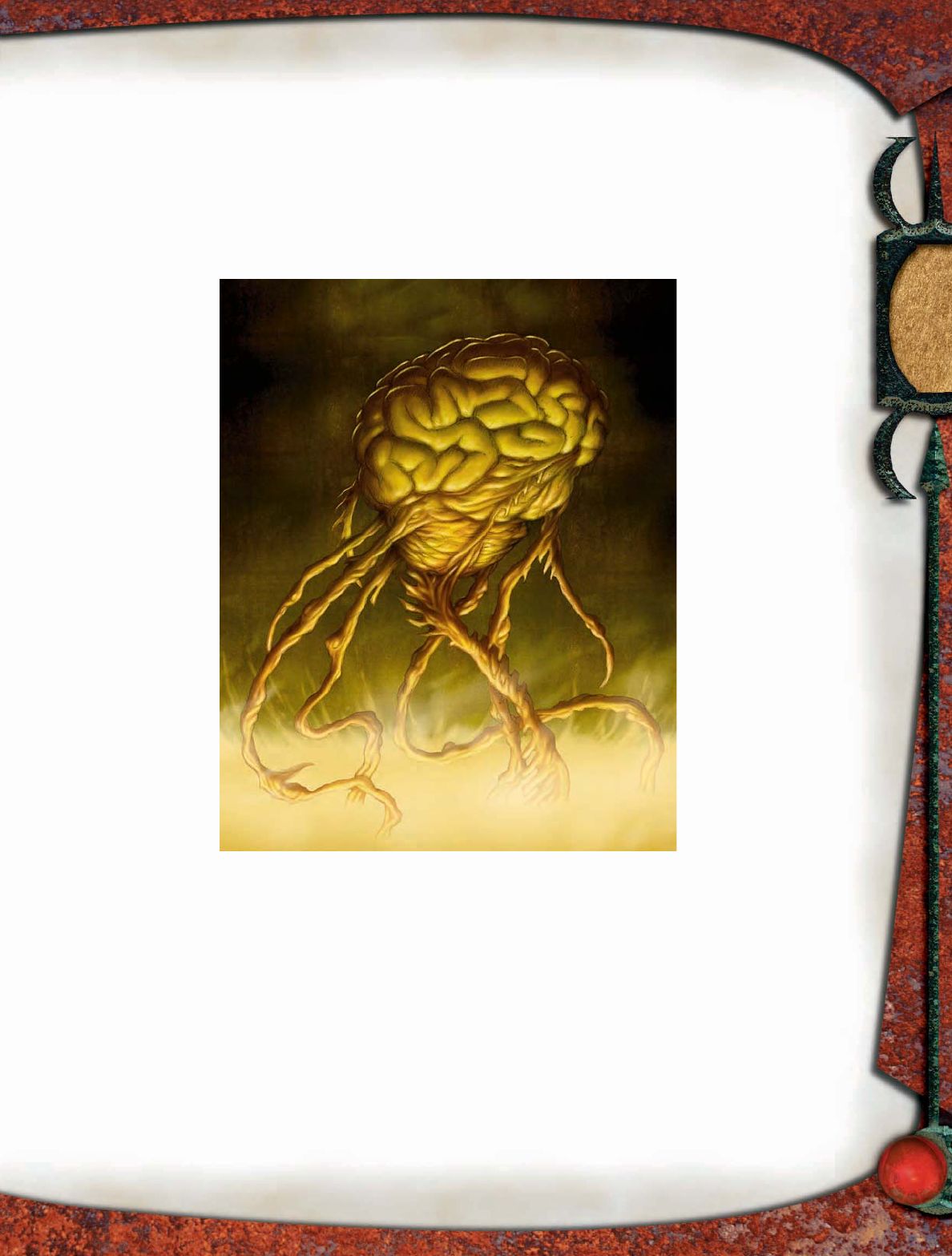
123
utterly confi dent in its abilities. However, it has been touched
by the Far Realm, so it sometimes behaves in strange ways,
telepathically broadcasting gibberish or making arbitrary
decisions that seem to make quintessence-gathering more
difficult. Whether the Thoon elder brain is irrational or
merely several moves ahead of everyone else is an unan-
swered question.
The Thoon elder brain communicates telepathically with
the rest of the mind fl ayers of Thoon, delivering orders and
making announce-
ments in a telepathic
“voice” so intense that
it’s slightly painful.
It ends each mes-
sage with, “All hail
Thoon!”
If the PCs are ad-
venturing within a
mind fl ayer base or
the nautiloid vessel
itself, they should
hear several telepath-
ic messages from the
Thoon elder brain be-
fore they encounter it
in person. The mes-
sages range from the
mundane—“Gleaner
Group Twelve, report
to the Black Spire.
All hail Thoon!”—to
the threatening—
“Intruders have been
detected. Kill all but
the elf. Bring the elf
to the main quintes-
sence processor. All
hail Thoon!”
Advanced Thoon
Elder Brains
If you add Hit Dice to a Thoon elder brain,
increase its spell resistance and caster level by 1 for every
Hit Die you add.
SAMPLE ENCOUNTERS
Because of the wide range of Challenge Ratings among the
followers of Thoon, they can serve as villains for adventures
spanning many level ranges.
Spy Ring (EL 7): A Thoon infi ltrator and two Thoon
thralls are the mind fl ayers’ fi rst foothold in a community.
They keep a low profi le, but part of their mandate is to learn
all they can about powerful travelers passing through town.
The Thoon infi ltrator might decide to preemptively attack
the characters before they can become a threat, or perhaps
the PCs interrupt the infi ltrator in the midst of spawning a
third Thoon thrall. The Thoon creatures use typical tactics,
attempting to kill the characters. The infi ltrator is not worried
about death, since it can revive itself later on.
Hidden Headquarters (EL 9): A Thoon infi ltrator, four
Thoon thralls, and a stormcloud of Thoon have set up an out-
post in an out-of-the-way cabin near a small town. The Thoon
infi ltrator and Thoon thrall go about their business, while
the hidden stormcloud uses its tremorsense to detect inter-
lopers (making the group diffi cult to surprise). If caught, the
Thoon thralls and the
stormcloud of Thoon
try to hold off the PCs
while the Thoon in-
fi ltrator runs into the
woods, carrying off
important papers, in-
cluding a map showing
the location of the mind
fl ayers’ main base.
Quintessence Pros-
pectors (EL 9): The
characters have found
evidence that a seem-
ingly normal person is
not who she appears to
be, but if they go after
her, they get more than
they bargained for.
They quickly discover
that she is a Thoon in-
filtrator, but a bigger
surprise is the shadow
flayer lurking nearby,
ready to grab a captive
if the Thoon infi ltrator
telepathically identifi es
someone as a target.
If the PCs have any
NPC allies who seem
like easy targets, the
shadow fl ayer goes after
them. Otherwise, it grabs the character who
seems like the weakest threat.
Intruder Response Team (EL 11): The PCs have been
detected near a Thoon stronghold. Four scythers of Thoon
and a Thoon soldier receive telepathic orders: Destroy any
intruders they fi nd. None of the constructs is particularly
subtle, although one of the scythers stays back and aims
searing light at an unengaged character.
Birthing Suite (EL 11): In a large, oval room, a madcrafter
of Thoon is processing quintessence while a Thoon soldier
stands guard. The Thoon soldier rushes into melee combat
when the PCs enter, and the madcrafter retreats, launching
spawn. It then unleashes a mind blast or two at the characters.
If the PCs engage the madcrafter in melee or start to gain
the upper hand against the Thoon soldier, the madcrafter
MIND FLAYERS
OF THOON
Thoon elder brain
Illus. by D. Allsop
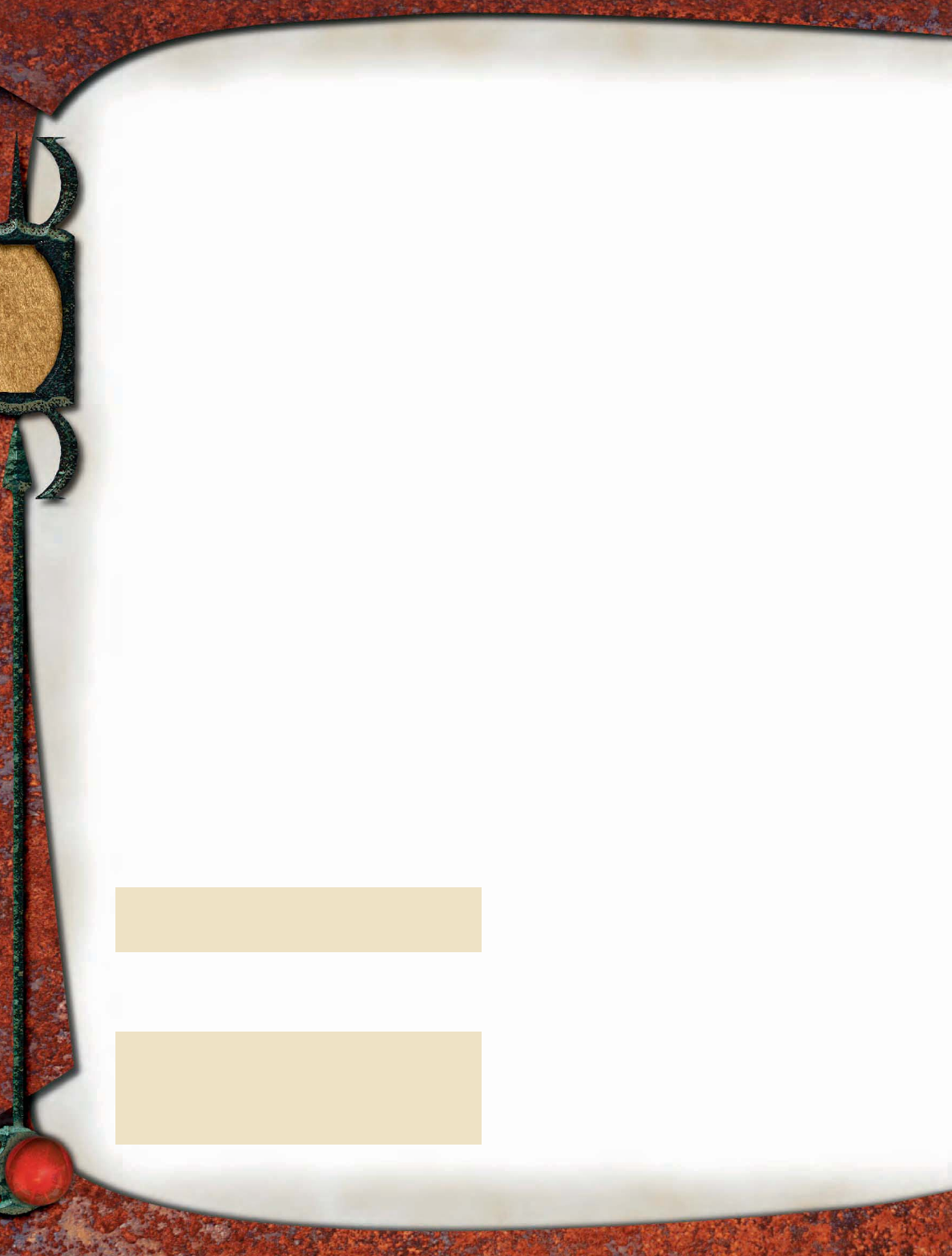
124
launches more spawn and continues to use mind blast with
its standard action until it is no longer capable of doing so.
War Patrol (EL 12): A Thoon disciple and two Thoon
soldiers are searching for enemies. If the disciple thinks
they can defeat the PCs, it directs the Thoon soldiers into
melee and starts using mind blast (which the Thoon soldiers
are immune to) in the ensuing battle. If the Thoon disciple
is near death, it retreats, ordering any remaining Thoon
soldiers to cover its escape. The Thoon soldiers fi ght until
destroyed—the mind fl ayers are confi dent that more will
emerge from the cocoons.
Brain Patrol (EL 14): A Thoon hulk and two normal mind
fl ayers (MM 186) are hunting for any sentient creatures,
intending to claim their brains. Lately, the followers of Thoon
have been unable to fi nd a suffi cient supply of brains, so not
only are these creatures hunting out in the open with little
regard for secrecy, they are reckless and exceptionally danger-
ous. The mind fl ayers lurk well behind the Thoon hulk, so
the PCs might not know they’re facing multiple enemies at
fi rst. Tactics are simple: The mind fl ayers use mind blast, and
the Thoon hulk grapples. If their adversaries seem reasonably
subdued, the mind fl ayers attempt to extract the brain of any
creature a Thoon hulk is grappling.
If a mind fl ayer is defeated, the other fl ees, telepathically
ordering the Thoon hulk to fi ght as a rear guard. If both mind
fl ayers are defeated, the Thoon hulk fi ghts until destroyed.
Sanctum Battle (EL 17): The central chamber of the
Thoon nautiloid ship houses the elder brain’s pool, along
with bizarre artifacts and multiple shrines to Thoon. When
intruders arrive, they see only one Thoon hulk and two Thoon
disciples. The Thoon elder brain lurks in the background,
then reveals itself at a dramatic point in the battle, rising
from its briny pool.
The chamber itself is circular, with a high ceiling and a
recessed area encircling the pool. A narrow passageway leads
in, allowing the Thoon hulk to block the way with its body
to buy some time for the others. The Thoon disciples cast
spells, and the elder brain uses overmind blast and its spell-like
abilities. When the elder brain leaves its pool and gets close
to the PCs, the Thoon disciples move behind it to heal it.
TYPICAL TREASURE
Thoon disciples and shadow fl ayers have standard treasure, as
do Thoon infi ltrators and Thoon thralls (though infi ltrators
usually take any appealing items away from thralls). Thoon
hulks, Thoon soldiers, stormclouds of Thoon, and scythers
of Thoon don’t have any wealth of their own, but they are
often assigned duties that put them near treasure; generate
standard treasure for them in this case.
Madcrafters of Thoon are incapable of going out to acquire
wealth, but many followers of Thoon pay them tribute.
Shadow fl ayers and Thoon disciples that want servants of
their own might trade treasure or fresh brains to a madcrafter
willing to create one. Madcrafters have standard treasure.
Mind fl ayers of Thoon maintain a large treasure hoard that
can be found near the Thoon elder brain. Art items in the
treasure hoard have twice the value indicated on page 55 of
the Dungeon Master’s Guide. Because the mind fl ayers of Thoon
have been traveling across the planes gathering quintessence,
their hoard is a good place to introduce particularly weird,
other worldly treasures, such as strangely marked coinage,
bizarre and disturbing art, and magic items with ornamenta-
tion that is clearly of extraplanar origin.
The value of quintessence—to anyone except the follow-
ers of Thoon—is deliberately left vague. This doesn’t have
to remain true in your campaign, however. Perhaps quintes-
sence can be used as a substitute for experience points in
item and construct creation. Quintessence could instead
be a material component for new spells or rituals you
introduce into your campaign, or it could be an optional
component that makes certain types of magic more potent.
Items and constructs created using quintessence can have
weird quirks and drawbacks. Spells cast using it are bizarre
or take on aberrant aspects. The moral implications of using
a material gathered from innocent (or not) sentient creatures
also comes into play. If you use quintessence in one or more
of these ways, or make it valuable at all, consider that value
when assigning treasure to encounters you create using the
followers of Thoon.
THOON IN EBERRON
Many mind fl ayers built a nautiloid vessel and somehow
found their way back to Xoriat, the Realm of Madness.
They also managed to return to Eberron. The journey itself
is supposed to be impossible, so many of the great powers of
MIND FLAYERS
OF THOON
pqqqqqqqqqrs
THOON ELDER BRAIN LORE
Characters who have ranks in Knowledge (dungeoneering)
can learn more about a Thoon elder brain. When a character
makes a successful skill check, the following lore is revealed,
including the information from lower DCs. When possible,
cast the information in one of two ways: fragmentary reports
from creatures that have barely survived contact with crea-
tures of Thoon or hints from ancient texts that describe the
consequences of delving into the Far Realm.
Knowledge (Dungeoneering)
DC Result
30 This is a Thoon elder brain, a powerful aberration.
It possesses incredible telepathy, which it uses
to issue commands to minions of Thoon. Its
tentacles are coated in acid.
35 Unlike most creatures, a Thoon elder brain is
capable of simultaneously engaging in mental and
physical combat at full effi ciency. Among its potent
mental attacks is a confusion effect that affects
everyone near the Thoon elder brain.
40 The Thoon elder brain was an immature elder
brain when it crossed over into the Far Realm.
It came back twisted by that place of madness,
devoted to a mysterious force named Thoon. Since
then, it has commanded a nautiloid vessel across
the planes, searching for a mysterious substance
called quintessence.
pqqqqqqqqqrs
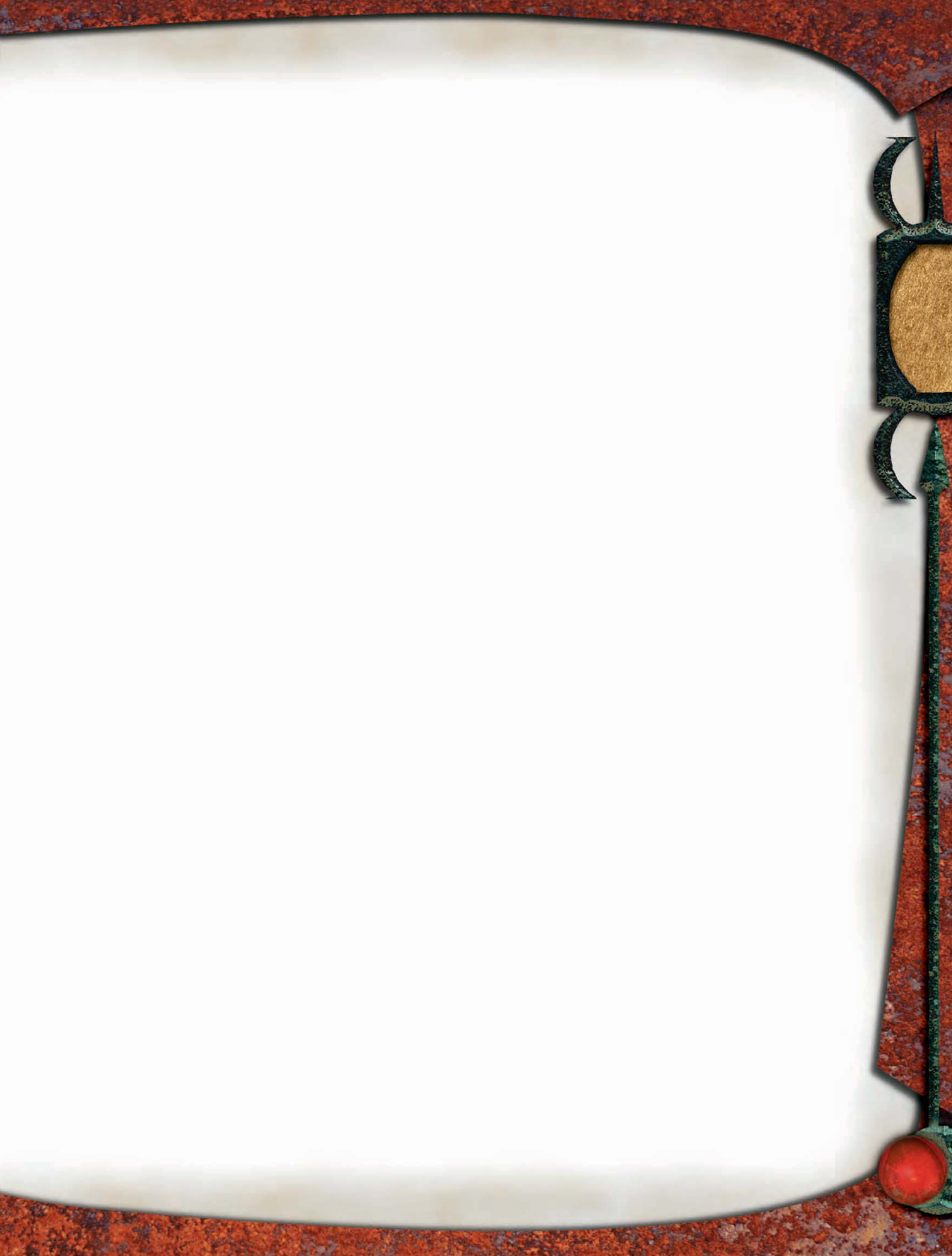
125
Eberron (the Inspired, the dragons, and the Lords of Dust, for
starters) want to know how the mind fl ayers of Thoon accom-
plished the journey. What the mind fl ayers met on Xoriat is
also a mystery that other powers might like to unravel.
Thoon could be a daelkyr overlord so powerful as to nearly
be a god. This mysterious entity could instead be another
creature fl oating on the insane currents of Xoriat’s layers. Or
Thoon could be a philosophical mission initiated by some
entity, chance contact, or dark force awakening on Xoriat.
Regardless of the truth, the mind fl ayers of Thoon are a
dire threat to Eberron. Their beliefs could spread through
Khyber, emboldening the forces of madness. If the doctrine
of Thoon spreads wide enough, and enough quintessence is
gathered, the return of Xoriat might be close behind.
THOON IN FAERÛN
Shortly after the most recent appearance of an avatar of
Ilsensine (Expanded Psionics Handbook 222) in the grand and
highly religious illithid city of Oryndoll (Underdark 168), an
adventurous band of mind fl ayers from the Loretaker creed
left the Lowerdark on a pilgrimage to the Cavern of Thought
on the fi endish plane of Deep Caverns. Whether they arrived
in Ilsensine’s abode is unknown, a fact none of the pilgrims
now confi rm or deny. They brought back with them the belief
in Thoon, a doctrine seen as heretical by the orthodox clergy
of the illithid deity in Oryndoll. So the followers of Thoon,
outcast from their home city, now travel the Underdark,
occasionally raiding the surface, searching for quintessence
and spreading the philosophy of Thoon.
pqqqqqqqqqqqqqqqqqqqqrs
The mind flayers of Thoon crave quintessence above all else,
and the machinations they undertake to fill their matrices might
bring them into conflict with the PCs.
Most campaigns involving Thoon introduce the mind flayers
and their servitors in one of two ways: Low-level campaigns
start with Thoon infiltrators and their thralls, while mid-level
campaigns confront the mind flayers and their more powerful
creations directly.
THE LOW-LEVEL THOON CAMPAIGN
If you’re introducing Thoon to your low-level game, here are
some seeds for possible adventures.
• A small frontier village has repulsed a large band of orc ma-
rauders. Scattered reports from the frontier indicate that
some villagers exploded after being affected by strange mag-
ic. The characters are sent to investigate the village—right
into the arms of a Thoon infi ltrator, a lurking stormcloud of
Thoon, and several Thoon thralls. The stormcloud of Thoon
senses quintessence within the PCs, but the characters move
out of range after only 1 round—before it’s clear which of
them contains quintessence. Because the infi ltrator doesn’t
want to reveal itself, it directs its Thoon thralls to cause
havoc near its lair, hoping to attract attention. Meanwhile,
it sends its most trusted thrall to join the party, spreading
rumors of a reward if “someone” can put an end to the dis-
turbance. When the PCs near the lair, all the thralls converge,
and the traitor reveals its true nature.
• Following the trail of a questing high-level paladin they’re sup-
posed to deliver a message to, the characters fi nd a cave with
several slain mind fl ayers and fi ve egglike containers—matrices
of quintessence, which neither the PCs nor the paladin have
heard of. If the characters take the matrices, a recovery team of
infi ltrators and thralls starts to shadow them, attacking when-
ever it’s inconvenient for the party. The followers of Thoon
don’t reveal their purpose, leaving the PCs to wonder, “Who
are these guys who keep attacking us? And why?”
• A Thoon infi ltrator disguised as a master alchemist gives the
PCs a magic ankh capable of detecting quintessence (func-
tionally giving the Sense Quintessence feat to a spellcasting
character), then sends them out on a series of missions to
gather it. Eventually the characters might grow suspicious of
where all the quintessence is going—especially when they
notice that some people have quintessence within them as
well. When they confront the master alchemist, the mind
fl ayers waiting in the wings reveal themselves.
THE MID-LEVEL THOON CAMPAIGN
The simplest way to introduce the mind flayers of Thoon to a
mid-level party is to include a group of them at an adventure
site, where the aberrations are engaged in some quintessence-
gathering. Beyond the most obvious way, here are a couple of
adventure seeds for mid-level characters capable of tussling
with the mind flayers of Thoon.
• Members of an extended family of nobles start disappearing,
and the PCs must fi gure out who’s kidnapping them, then
rescue them. The kidnappers are mind fl ayers that have dis-
covered that the family’s bloodline is rich in quintessence.
Rather than harvest quintessence from the nobles directly,
they plan to mentally enslave them, then artifi cially breed
hundreds more—a “quintessence herd.”
• A dwarf stronghold has been overwhelmed by mind fl ayers
and their servitors, and a few refugees beg the characters to
liberate their home. Most dwarves survived the mind fl ayer
takeover, and they’re being forced to mine quintessence-rich
ore from caverns underneath the stronghold.
SUBSEQUENT EXPOSITION
Once you’ve introduced the followers of Thoon, the players and
their characters should get curious about what all this “Thoon”
and “quintessence” stuff is. It’s okay if the players (and char-
acters) don’t know exactly what they’re facing. You’re trying to
evoke a sense of weirdness—a “What is the deal with these
guys?” feeling among your players.
But once you’ve evoked that feeling, the PCs are bound to
employ everything—research to interrogation to divination
spells—to learn more about these strange creatures. That’s
good. An explanation at this point helps ground the followers
of Thoon in the world and makes subsequent encounters with
them more interesting. You don’t need to hand a full description
of Thoon to the characters on a silver platter, but if they make
reasonable inquiries, they get reasonable information back. The
various lore sidebars throughout this section have high DCs—
the mind flayers have many means to guard their secrets, to be
sure—but it makes for a better game if the characters eventually
learn the true nature of what they’re fighting.
pqqqqqqqqqqqqqqqqqqqqrs
INTRODUCING THOON INTO YOUR GAME
MIND FLAYERS
OF THOON
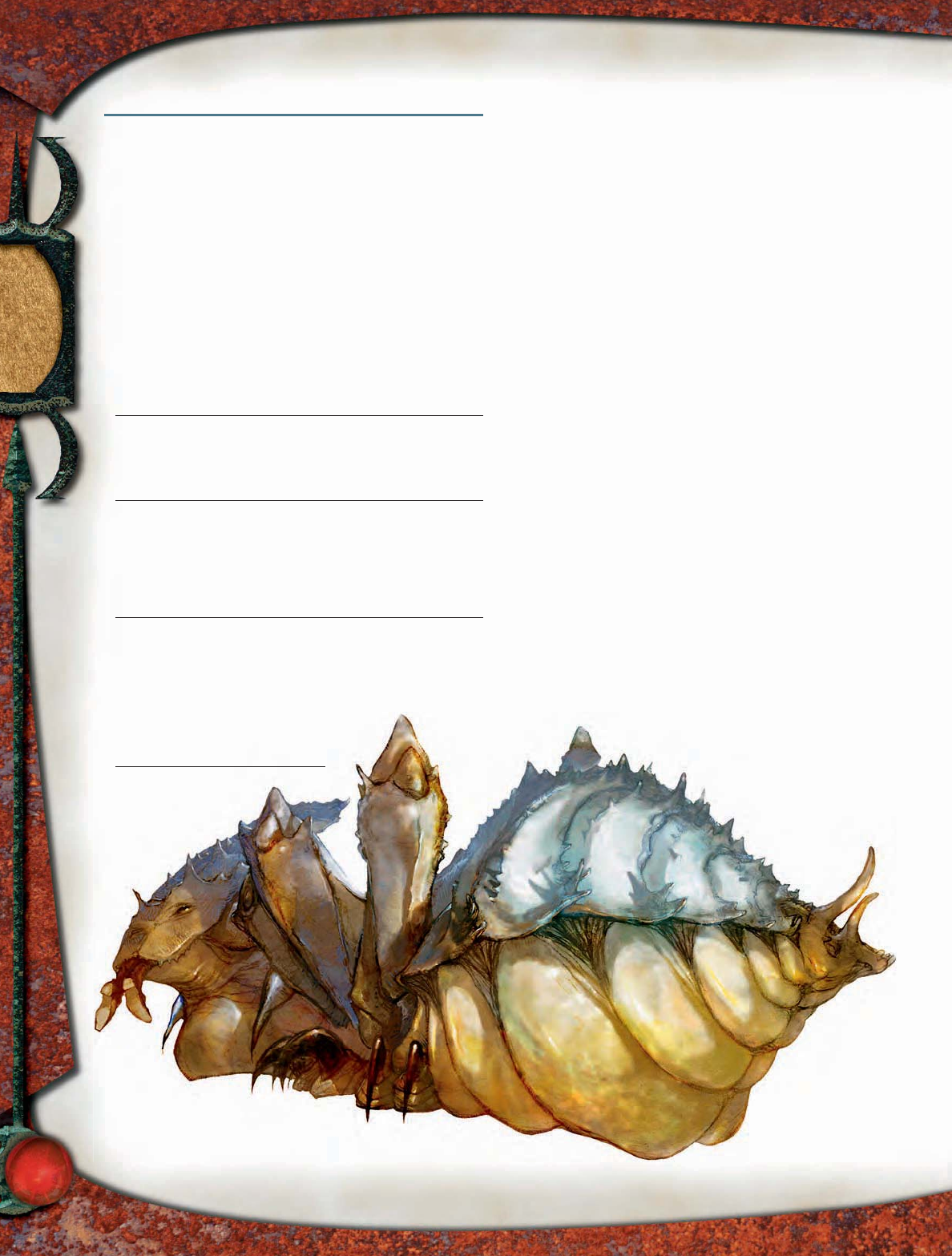
126
MOCKERY BUGS
Mockery bugs are a strain of magical beasts descended from
ankhegs. They come in two forms—the mockery monarch
and its dreadful progeny, mockery drones.
MOCKERY MONARCH
An immense silvery insect turns toward you, its bloated abdomen
dragging on the ground. Six slender legs support its segmented
body. Its mandibles are large, but they are nothing compared to its
cavernous mouth. The creature eyes you with an air that suggests
it’s more than a stupid beast.
Mockery Monarch CR 14
Usually NE Large magical beast
Init +7; Senses darkvision 60 ft., low-light vision,
tremorsense 60 ft.; Listen +27, Spot +27
Languages consume language; cannot speak
AC 34, touch 25, flat-footed 31
(–1 size, +3 Dex, +13 deflection, +9 natural)
hp 150 (20 HD)
Resist spell turning
Fort +14, Ref +15, Will +10
Speed 20 ft. (4 squares), burrow 20 ft.
Melee bite +25 (3d6+7 plus 1d6 acid)
Space 10 ft.; Reach 5 ft.
Base Atk +20; Grp +29
Atk Options Cleave, Power Attack
Special Actions improved grab, swallow whole, spawn
mockery drone
Abilities Str 21, Dex 17, Con 14, Int 12, Wis 14, Cha 6
SA acid, improved grab, swallow whole, spawn mockery
drone
Feats Alertness, Cleave, Improved Initiative, Improved
Natural Attack (bite), Iron Will, Power
Attack, Weapon Focus (bite)
Skills Climb +28, Listen +27, Spot +27
Advancement 21–40 HD (Large);
41–60 HD (Huge)
Consume Language (Su) When a mockery monarch
consumes a humanoid, it gains the ability to understand
languages that humanoid spoke. It retains understanding
of those languages but cannot speak them.
Spell Turning (Su) Spells and spell-like abilities that
specifically target a mockery monarch are reflected back
on their casters as if affected by a spell turning spell.
Effect and area spells are not affected, nor are touch
spells. This ability has no maximum number of spell
levels it can turn.
Improved Grab (Ex) To use this ability, a mockery monarch
must hit an opponent smaller than itself with a bite.
It can then attempt to start a grapple as a free action
without provoking attacks of opportunity.
Swallow Whole (Ex) A mockery monarch can swallow a
grappled opponent smaller than itself by making a
successful grapple check.
A swallowed creature takes 1d6+5 points of
bludgeoning damage and 5 points of acid damage per
round it spends in the mockery monarch’s abdomen.
A swallowed creature can cut its way out by using a
light slashing or piercing weapon to deal 25 points of
damage to the abdomen (AC 15). Once the creature
exits, muscular action closes the hole; another swallowed
opponent must cut its own way out.
A Large mockery monarch’s abdomen can hold 2
Medium, 8 Small, 32 Tiny, or 128 Diminutive or smaller
opponents.
Spawn Mockery Drone (Su) A humanoid reduced to 0 or
fewer hit points when inside a mockery monarch’s
abdomen becomes a mockery drone. The spawned
mockery drone emerges from the mockery monarch’s
abdomen at the beginning of the monarch’s next turn.
Although a mockery drone looks like the consumed
humanoid, it is actually a new creature with none of the
consumed humanoid’s abilities. Mockery drones are not
enslaved to the monarch, but they are loyal to it.
Mockery monarchs are clever insectile
magical beasts that want to spawn
as many mockery drones as
they can. They lack the
ability to speak, but
they are curious
Mockery monarch
MOCKERY
BUGS
Illus. by A. Waters
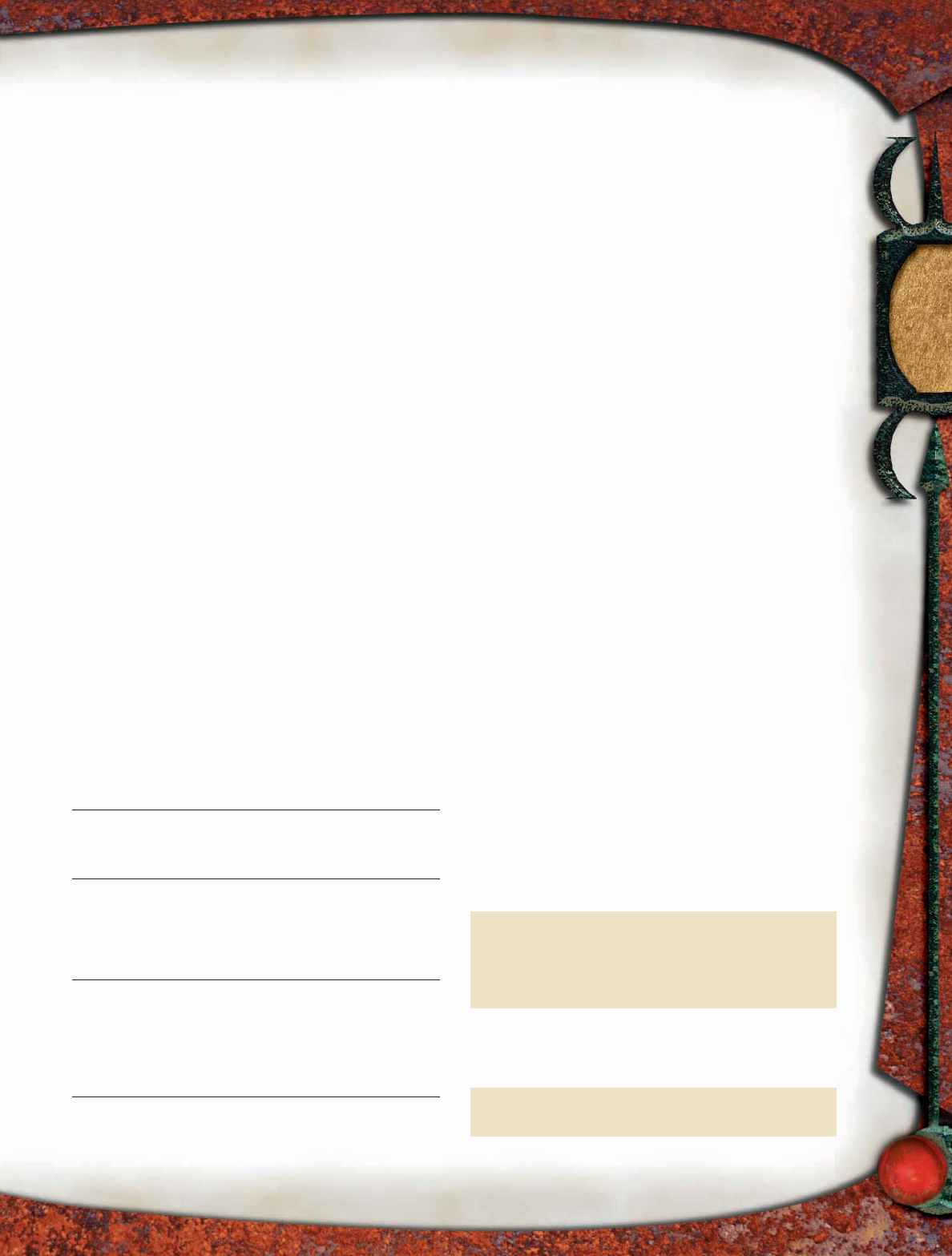
127
about sentient humanoids, consuming them and creating
progeny that appear intelligent but are not much smarter
than animals.
Strategies and Tactics
Mockery monarchs are wise enough to live near civilized
places and shrewd enough to hide themselves well. They
then pick off humanoids that stray off beaten paths or
travel alone. Each victim becomes a mockery drone,
which the mockery monarch uses to lure prey and other
humanoids to it.
Older mockery monarchs are even more insidious, having
learned tactics that draw humanoids in rather than scaring
them off. It might leave a clue that a missing child entered
the sewer near its lair, or it could kill livestock and leave
signs of a mundane ankheg attack. Such a crafty mockery
monarch usually amasses a large number of drones before
it is found out and hunted down.
Despite their intelligence, mockery monarchs have
straightforward tactics. They bite and grab as often as possible,
swallowing every humanoid they can successfully grapple.
For defense, they simply rely on their hard carapaces and
the weird energy surrounding them that deflects spells
and weapons.
MOCKERY DRONE
The shopkeeper turns toward you, a silly grin on his face. “Here’s
your change. Here’s your change!” he says, his voice rising to a
shout. Then, in a spout of blood, his face detaches from his skull and
leaps toward you, propelled by a centipedelike body with foot-long
spines. “Here’s . . . your . . . change!” shouts the centipede with the
shopkeeper’s face as it scuttles your way.
Mockery Drone CR 9
Usually NE Medium magical beast
Init +7; Senses darkvision 60 ft., low-light vision; Listen +4,
Spot +4
Languages Common (speaks strangely)
AC 23, touch 18, flat-footed 20; barbs
(+3 Dex, +5 deflection, +5 natural)
hp 114 (12 HD)
Fort +14, Ref +11, Will +6
Speed 30 ft. (6 squares), climb 30 ft.
Melee 2 claws +19 each (2d6+6/19–20) and
spines +13 (1d8+3)
Space 5 ft.; Reach 5 ft.
Base Atk +12; Grp +18
Special Actions humanoid seeming, spit acid
Abilities Str 23, Dex 16, Con 22, Int 3, Wis 14, Cha 11
SA barbs, spit acid
Feats Alertness, Improved Critical (claw), Improved
Initiative, Power Attack, Weapon Focus (claw)
Skills Climb +21, Disguise +8 (+16 sight only), Listen +4,
Spot +4
Advancement 13–23 HD (Medium)
Barbs (Su) Any opponent that touches a mockery drone,
strikes it with a natural weapon, strikes it with a nonreach
melee weapon, or grapples it takes 5 points of piercing
and slashing damage from the creature’s barbs. A foe can
take damage from this ability only once per turn.
Humanoid Seeming (Ex) When born, a mockery drone
looks like a Medium or Small humanoid. But the
mockery drone is actually an insectile creature living
inside that humanoid’s skin and animating it from
within. When inside a humanoid form, a mockery
drone doesn’t have its natural attacks or a climb speed,
and its barbs are ineffective since they’re inside the
humanoid body.
As a swift action, a mockery drone can burst from
the humanoid’s head, retaining the face but discarding
the rest of the body. The mockery drone bursts forth
as soon as it senses danger. If the humanoid body is
struck before the mockery drone can burst forth, that
body can take 10 points of damage before the mockery
drone is harmed.
Spit Acid (Ex) Once every 6 hours, as a standard action, a
mockery drone can spit acid in a 60-foot line, dealing
10d4 points of acid damage (Reflex DC 22 half). The save
DC is Constitution-based.
Skills Mockery drones have a +8 racial bonus on Climb
checks and can choose to take 10 on Climb checks, even
if rushed or threatened. Mockery drones have a +8 racial
bonus on Disguise checks made to fool others who see
them, but do not hear them speak.
A mockery drone lives a confusing and often brief life. It’s
born in a humanoid form but without coherent memories,
skills, or language. It has an instinctive desire to bring
other humanoids closer to the mockery monarch, but it isn’t
smart enough to think of sophisticated ways to accomplish
this task.
Strategies and Tactics
Mockery drones stay near their monarch, but the monarch
sometimes sends them forth to gather more fodder. Drones on
pqqqqqqqqqrs
MOCKERY BUG LORE
Characters who have ranks in Knowledge (arcana) can learn
more about mockery bugs. When a character makes a suc-
cessful skill check, the following lore is revealed, including the
information from lower DCs.
Knowledge (Arcana)
DC Result
19 Centipedelike creatures that hide within humanoid
bodies, mockery drones are magical beasts that
can burst out of their macabre disguises and
attack without warning. They have long, sharp
barbs that can cut and stab those in close combat
with them.
24 Mockery drones are the offspring of a creature
called a mockery monarch, a magical beast
born from an ankheg. Mockery monarchs are
intelligent insects capable of swallowing their
foes whole.
29 A mockery monarch gives birth to mockery drones
that look like humanoids it swallows. Its carapace
can refl ect spells back upon their caster.
pqqqqqqqqqrs
MOCKERY
BUGS
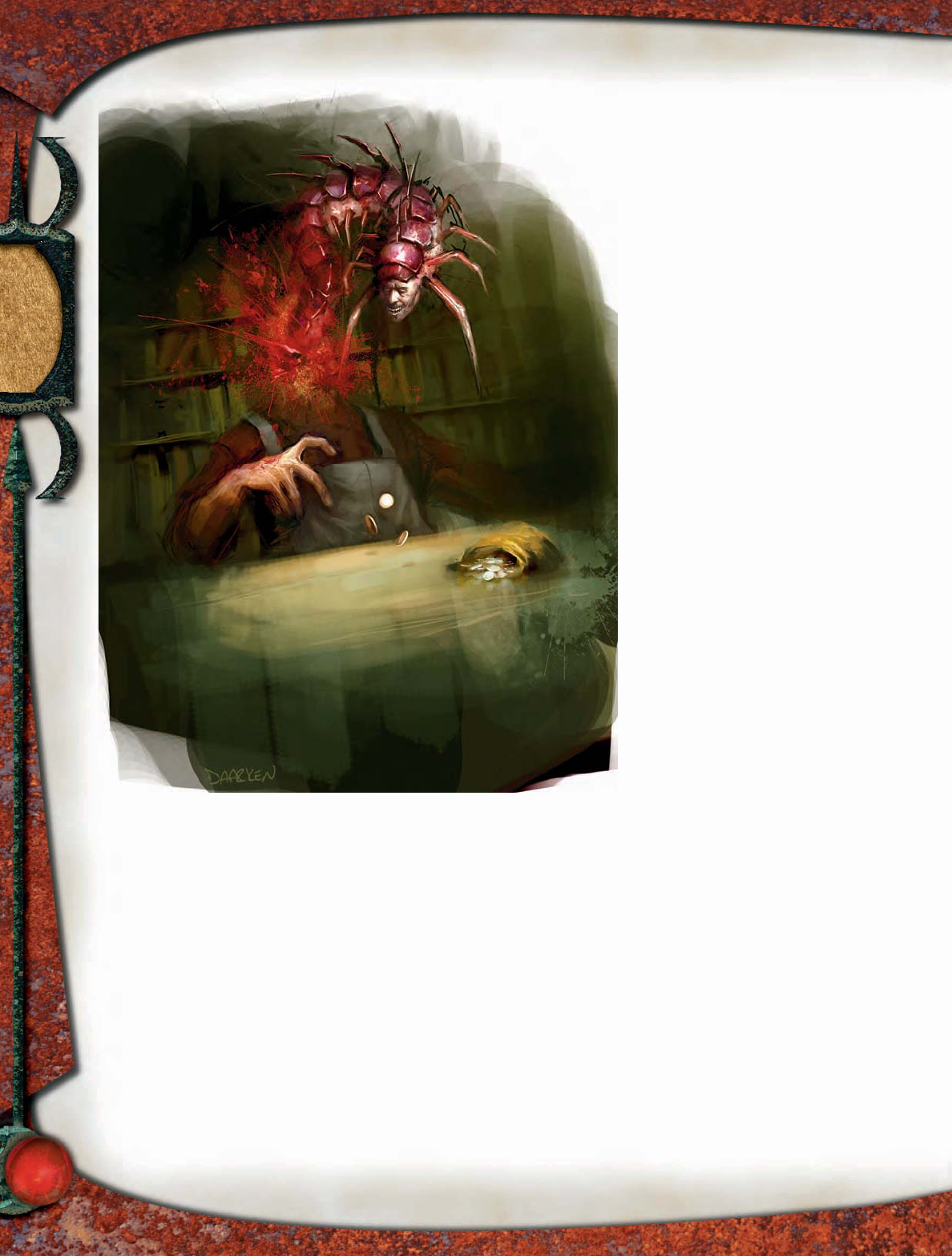
128
such a mission usually wander around until they attract
someone’s attention. They then meander back toward the
monarch, hoping to lead their pursuers into its waiting
mandibles. Though not very bright, mockery drones do have
a feel for when someone “recognizes” their humanoid form,
and they use this ability to their advantage. Some people who
follow a relative who is acting strangely end up becoming
new drones.
When it senses danger, a mockery drone bursts out of the
head of its humanoid form, revealing itself for the monster
it is. It keeps the humanoid face, however, and continues to
speak in repetitive or nonsensical phrases as it battles what-
ever threatened it. A mockery drone spits acid at enemies
at its fi rst opportunity. Then it enters melee combat, using
Power Attack in the beginning, trying to take out opponents
as quickly as possible. If it misses repeatedly when using
Power Attack, it gives up on dealing a lot of damage and
goes for more precise shots.
SAMPLE ENCOUNTERS
Mockery monarchs have no other monarchs as
companions, but loyal mockery drones usually
surround them.
Town Idiots (EL 11+): A mockery mon-
arch has converted all the inhabitants of a
hamlet into mockery drones. Any visitor
immediately notices that everyone in
town has been rendered smilingly idi-
otic, with people carrying empty pails
from the well, a town crier repeating,
“Midnight and all’s well” in the middle
of the day, and a woodcutter splitting
the same log until it’s mere splinters.
When confused or discovered, the
mockery drones attack, and two or
more are always together. The charac-
ters have multiple fi ghts with mockery
drones before they fi gure out that the
mockery monarch is in a cellar beneath
the inn.
Mockery Seekers (EL 15): A mock-
ery monarch has just moved into the
ruins of an ancient border keep near
several small settlements, and it already
has four drones with it. Members of a
shadowy organization have designs on
turning the mockery monarch to their
despicable purposes. Perhaps they are
under the mistaken impression that it
can create secret agents for them, or may-
be they know it can convert normal folk
into dangerous creatures. One way or an-
other, the organization’s agents are willing
to use underhanded means to fi nd the mockery
monarch and secure its cooperation, including kidnapping
innocents to hand over to the beast. The PCs have to defend
the area against the agents and the mockery monarch.
ECOLOGY
A tiny fraction of ankheg eggs produce mockery monarchs.
A newborn mockery monarch usually leaves the nest as
soon as it can.
Seemingly produced by magic worked on ankhegs, mock-
ery monarchs look like their lesser kin. But the resemblance
is deceiving. From their intellect to their refl ective exoskel-
etons, mockery monarchs show some of the side effects of
eldritch energy gone awry.
Luckily for the world at large, mockery monarchs are
sterile. They can’t mate with ankhegs or other mockery
monarchs, so they have no biological drive to fi nd others of
Mockery drone
MOCKERY
BUGS
Illus. by Daarken
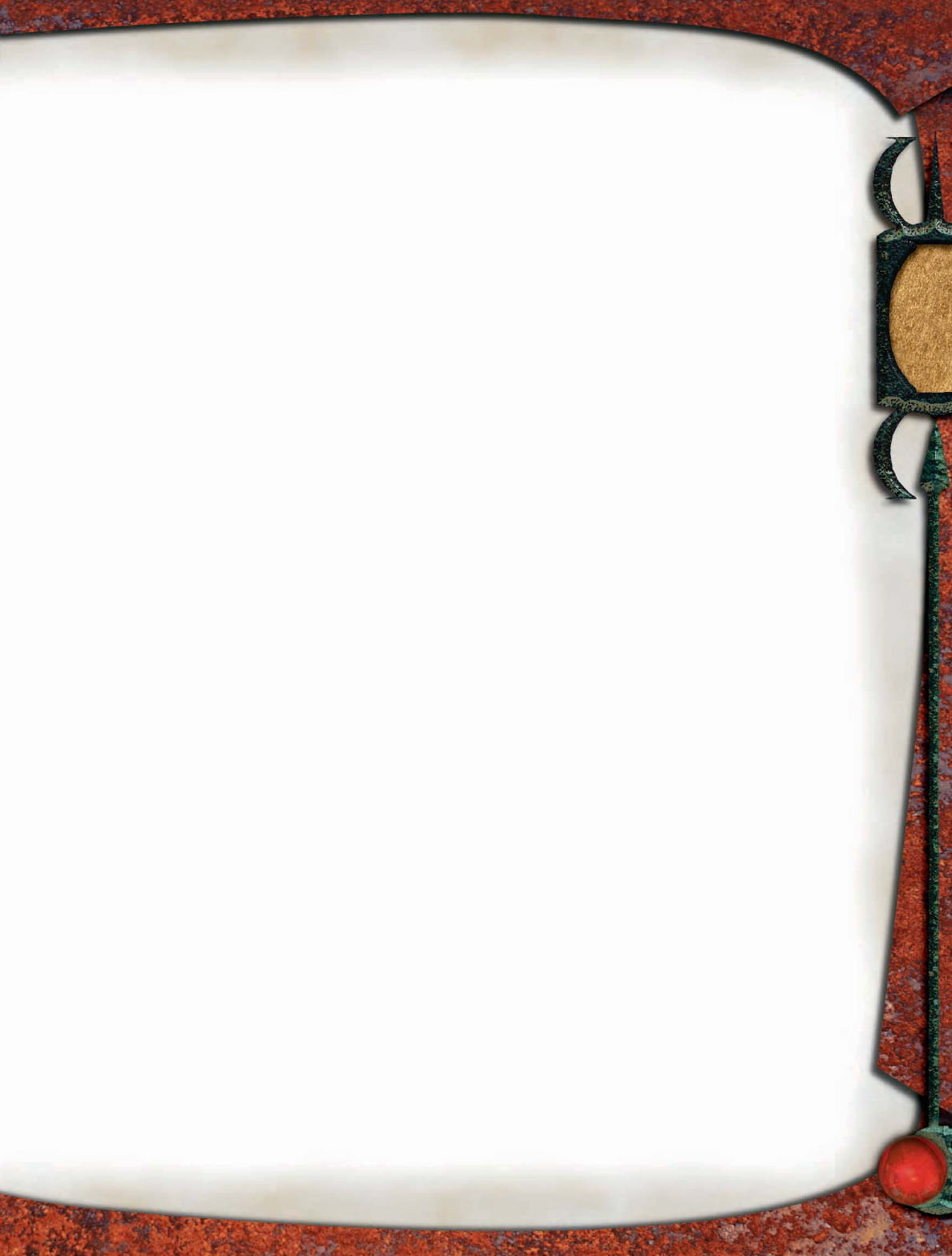
129
their kind or to remain among their bestial relatives. Their
only urge is to fi nd and consume humanoids and to create
mockery drones.
Mockery monarchs can go a long time without food,
and they can travel far without being seen. Their burrows
produce tunnels only if they choose to create such openings,
so it’s easy for a mockery monarch to arrive undetected in a
civilized area and set up a central nest. Then the monarch
goes to work converting citizens into mockery drones.
Mockery drones are incapable of reproducing. They exist
only to protect a mockery monarch and entice humanoids
to approach the monarch. Drones never willingly stray
far from their monarch, but sometimes they get lost or
survive an attack that kills their mockery monarch. Such
mockery drones wander aimlessly, trying to make some
sense of their jumbled memories. Once they lose their
humanoid form, mockery drones attack anything weaker
than they are.
Unlike shapechangers, mockery drones can use their
humanoid disguise only once. Once they burst out of the
face and reveal their true forms, they remain in their insectile
form for the rest of their lives.
Environment: Mockery monarchs can be found nearly
anywhere, though they prefer warm environments. Aban-
doned buildings and ruins hold special interest for the
creatures. They dwell in or near civilized lands, where they
can fi nd new fodder to turn into mockery drones. Mockery
drones never stray far from their monarch.
Mockery drone nests are usually open, underground areas
with winding tunnels that lead to the mockery monarch’s
lair. The tunnels are at least 5 feet wide by 5 feet tall.
Typical Physical Characteristics: Mockery monarchs
are massive, segmented insects with silvery carapaces.
Their mouths are gaping, muscular holes set with enormous
mandibles. All mockery monarchs have grossly distended
abdomens. An adult mockery monarch is 10 feet long and
weighs about 1,000 pounds.
Mockery drones look like spined centipedes with grin-
ning humanoid faces. They average 5 feet long and weigh
200 pounds.
Alignment: Mockery monarchs have a curiosity about
other intelligent beings, but they have no compunctions
about causing suffering or killing. They aren’t callously
destructive, but they have no sense of fairness or honor. Care-
ful and conniving in pursuit of their goal of eating humanoids
and creating mockery drones, mockery monarchs care little
for other creatures. They are usually neutral evil.
Mockery drones are similar to their monarch. However,
they are more brutal and direct.
SOCIETY
Mockery monarchs have no society beyond the collective
nature of the ankheg nest that spawned them. They’re
curious about the outside world, and they search for other
intelligent creatures. That search isn’t for contact alone; it’s
to fi nd victims from which to spawn mockery drones.
It’s possible for a mockery monarch to strike up an alliance
with another creature. Such alliances end when the mockery
monarch gives in to the temptation to turn its allies into
mockery drones.
Mockery drones are free-willed and capricious creatures
that enjoy killing. Fortunately for their would-be victims,
they’re barely smarter than animals and incapable of group
organization.
A mockery drone wanders around, trying to engage in some
semblance of the activities it “remembers” from its humanoid
life. But with dull wits and scrambled memories, a mockery
drone quickly reveals that it’s no ordinary humanoid when
someone interacts with it. Mockery drones repeat nonsensi-
cal phrases or mindlessly repeat the same actions until some
new stimulus presents itself.
TYPICAL TREASURE
Mockery monarchs gather whatever attracts their interest,
carefully examining the gear from creatures they’ve killed
and turned into mockery drones. They’re interested in the
tools and trinkets that humanoids carry, so they keep such
objects. Even so, they have little sense of what wealth means,
and no notion of buying or selling. A mockery monarch has
standard treasure for its Challenge Rating.
Mockery drones have standard treasure for their Challenge
Rating. The treasure is spread around the drones’ environs.
In humanoid form, mockery drones employ only obviously
useful implements such as tools, weapons, and armor.
MOCKERY BUGS IN EBERRON
Mockery monarchs and mockery drones emerged in the
Lower City of Sharn near the end of the Last War, rumored
to be the result of experiments with Brelish ankhegs and
roach thralls (Sharn 184) gone wrong. House Phiarlan and
House Thuranni have been implicated, but each house blames
the other. Despite efforts to destroy them, a few mockery
monarchs escaped into the wild. Mockery bugs have been
rooted out as far east as Valenar, and the hags of Droaam are
rumored to have a few in their service.
MOCKERY BUGS IN FAERÛN
Mockery monarchs and mockery drones were originally bred
in ancient Netheril—whether their breeding into the ankheg
population was deliberate or accidental is unknown. Wild
mockery bugs are rare but found wherever ankhegs are.
The Zhentarim have experimented with mockery bugs
recently, using them to mixed effect in their expansion
across the North. The Zhent mockery monarchs obediently
followed orders at fi rst, but as they created more mockery
drones, they grew more independent and resentful of their
masters. Now, renegade mockery monarchs make war on
the Zhentarim.
MOCKERY
BUGS

130
PHANTOM
Phantoms are creatures that can become incorporeal.
KUGAN, PHANTOM GHAST NINJA
Preceded by the stench of death, a humanoid form clad in loose black
clothing appears from the shadows, a violet cloak trailing behind it.
Its face is wrapped in black cloth except for the eyes and mouth—eyes
that burn with red light in sunken sockets, and a mouth full of over-
sized fangs. The creature’s black-gloved hands end in long claws.
Kugan CR 7
Male phantom ghast ninja* 4
* Class described in Complete Adventurer
CE Medium undead
Init +5; Senses darkvision 60 ft.; Listen +11, Spot +11
Languages Common, Draconic
Aura stench (10 ft.)
AC 28, touch 24, flat-footed 23; phantom defense
(+5 Dex, +5 Wis, +4 deflection, +4 natural)
hp 45 (8 HD)
Immune undead immunities; see incorporeal jaunt
Resist evasion, +2 turn resistance
Fort +3, Ref +11, Will +11 (+13 with ki power)
Weakness vulnerability to ghost touch
Speed 40 ft. (8 squares); great leap
Melee bite +11 (1d8+6 plus ghoul fever plus paralysis) and
2 claws +9 each (1d6+3 plus paralysis)
Base Atk +5; Grp +10
Atk Options Combat Reflexes, phantom strike, sudden
strike +2d6
Special Actions ghost step (invisible), incorporeal jaunt, ki
power 4/day
Combat Gear potion of inflict moderate wounds
Abilities Str 20, Dex 20, Con —, Int 12, Wis 20, Cha 18
SQ trapfinding, undead traits; see incorporeal jaunt
Feats Combat Reflexes, Multiattack, Toughness
Skills Balance +13, Bluff +9, Climb +10, Diplomacy +6,
Hide +16, Jump +21, Listen +11, Move Silently +16,
Spot +11, Tumble +14
Possessions combat gear plus amulet of mighty fists +1, cloak
of resistance +1
Stench (Ex) Living creatures within 10 feet of Kugan must
succeed on a DC 16 Fortitude save or be sickened for
1d6+4 minutes. A creature that succeeds on the save
cannot be affected by Kugan’s stench again for 24 hours.
A delay poison or neutralize poison spell removes the effect
from a sickened creature. Creatures that are immune to
poison or that have a saving throw bonus against poison
receive those benefits against the stench.
Phantom Defense (Su) See template description.
Ki Power (Su) +2 bonus on Will saves as long as at least one
daily use remains. Complete Adventurer 8.
Vulnerability to Ghost Touch (Ex) +50% damage from attacks
and effects that have the ghost touch property.
Great Leap (Su) Makes Jump checks as if running with the
Run feat. Complete Adventurer 8.
Ghoul Fever (Su) Disease—bite, Fort DC 16 negates,
incubation period 1 day, damage 1d3 Con and 1d3 Dex.
The save DC is Charisma-based.
Paralysis (Ex) Those hit by Kugan’s bite or claw must succeed
on a DC 16 Fortitude save or be paralyzed for 1d4+1
rounds.
Phantom Strike (Su) See template description.
Sudden Strike (Ex) As sneak attack (PH 50), but not when
flanking. Complete Adventurer 8.
Ghost Step (Su) Swift action, one daily ki power use,
invisibility for 1 round. Complete Adventurer 8.
Incorporeal Jaunt (Su) See template description.
An elite assassin serving a sinister necromancer at the heart
of a ninja cult, Kugan is blessed with an unholy array of abili-
ties. By using a secret ritual, Kugan’s master granted him the
phantom template for his years of honorable and successful
service. Kugan had the following ability scores before racial
modifi cations and Hit Dice ability score increases: Str 13,
Dex 14, Con 8, Int 10, Wis 15, Cha 12.
Strategies and Tactics
Kugan initiates combat from a distance that he covers with
an impressive leap. He lands among his foes to expose them
to his stench, then he fi ghts while incorporeal, using his
ghost step power to set up his sudden strikes. Incorporeality
and Tumble give him all the mobility he needs to choose his
targets. He kills clerics fi rst.
Sample Encounter
Kugan works alone.
Phantom Assassin (EL 7): One of the PCs’ enemies
has employed Kugan’s cult to take out one or more of the
characters. Kugan stalks the PCs, attacking them when
they’re vulnerable.
CREATING A PHANTOM
“Phantom” is an acquired template that can be applied to any
corporeal creature (referred to hereafter as the base creature).
A phantom uses all the base creature’s statistics and abilities
except as noted here.
The base creature gains abilities from this template based
on its Challenge Rating. If the creature’s CR increases for
any reason, it gains abilities according to its new CR.
Challenge Rating: If the base creature is CR 4 or lower,
its new CR is the same as the base creature +1. If the base
creature is CR 5 or higher, its new CR is the same as the base
creature +2.
pqqqqqqqqqrs
PHANTOM LORE
Characters who have ranks in Knowledge (religion) can learn
more about phantoms. When a character makes a success-
ful skill check, the following lore is revealed, including the
information from lower DCs. Facts about the base creature
can be learned only by using the skill appropriate to the base
creature’s type and Challenge Rating.
Knowledge (Religion)
DC Result
15+CR This creature can take on incorporeal traits.
20+CR Phantoms are vulnerable to attacks made with
ghost touch weapons. Powerful phantoms can
attack corporeal targets while incorporeal.
pqqqqqqqqqrs
PHANTOM
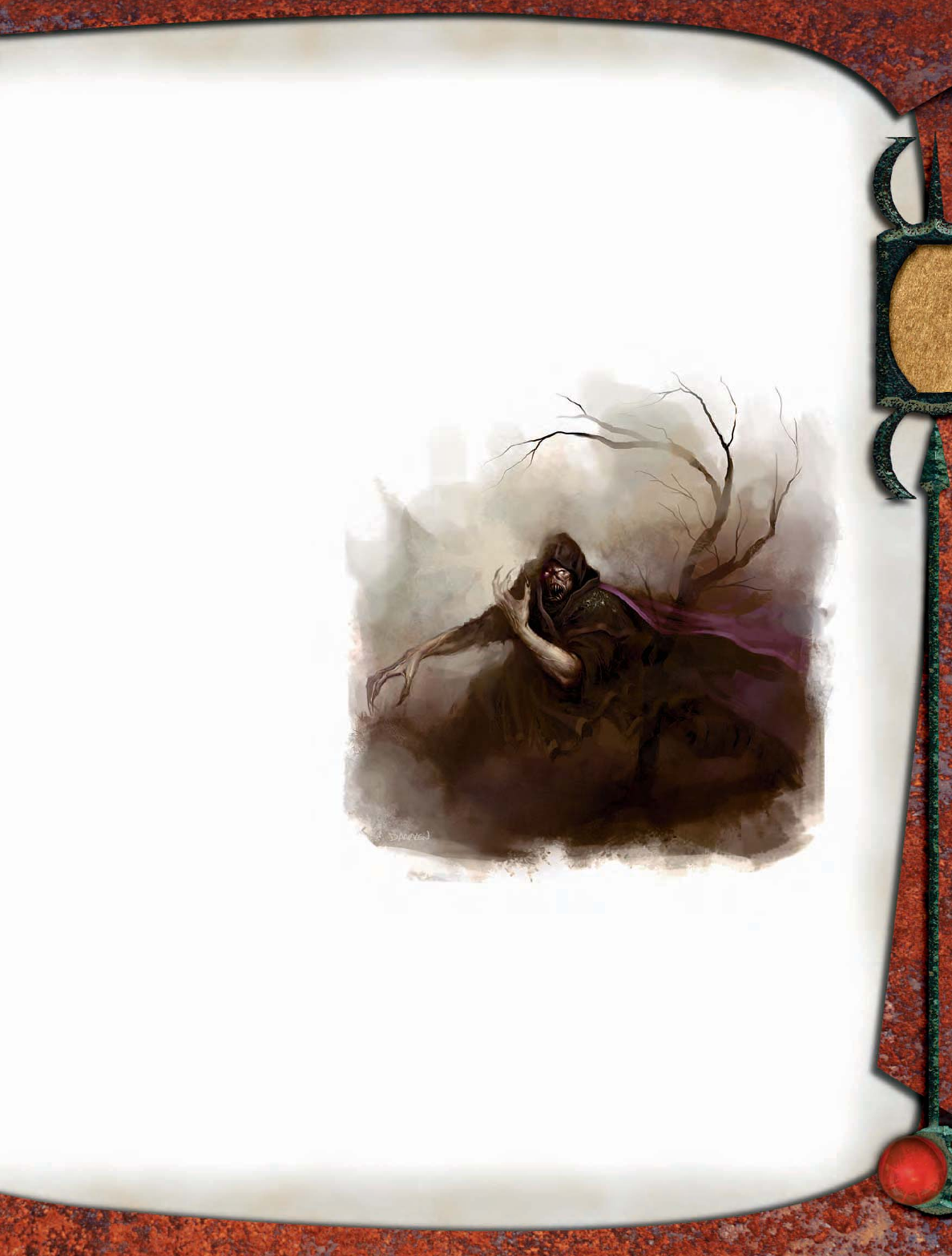
131
Type: Animal and vermin base creatures become magical
beasts with the appropriate augmented subtype.
AC: All phantoms gain a defl ection bonus to Armor Class
equal to their Charisma bonus or +1, whichever is higher. A
base creature of CR 5 or higher gains the following special
quality.
Phantom Defense (Su): A phantom’s armor bonus, defl ection
bonus, natural armor bonus, and shield bonus count toward
its Armor Class, whether it or its attackers are incorporeal
or corporeal.
Weakness: A phantom retains all the weaknesses of the
base creature, and it gains the following weakness.
Vulnerability to Ghost Touch (Ex): If damaged by a ghost
touch attack, a phantom takes half again (+50%) as much
damage from that attack, regardless of whether a saving throw
is allowed or whether that save succeeds.
Speed: A base creature of CR 4 or lower gains the following
special quality.
Incorporeal Movement (Su): When willingly mov-
ing, a phantom becomes incorporeal. A
phantom can suppress or resume this ability
as a move action.
Grp: When incorporeal, a phantom
cannot grapple.
Atk Options: A phantom of CR 5
or higher cannot use attack options that
require prolonged contact with a target,
such as adhesive and similar attacks. A
base creature or CR 5 or higher gains the
following attack option.
Phantom Strike (Ex): For the purpose of
resolving spells, melee attacks, ranged at-
tacks, and other attacks that require only
momentary contact to deal damage or
have their effects, a phantom is consid-
ered to be both incorporeal and corporeal
when it is incorporeal. Thus, the phan-
tom receives its normal Strength
bonus on attack rolls and damage rolls,
and it can use material components to cast
its spells.
Special Actions: A phantom of CR 5 or higher cannot use
special actions that require prolonged contact with a target,
such as swallow whole and similar actions. A base creature
or CR 5 or higher gains the following special action.
Incorporeal Jaunt (Su): A phantom can become incorporeal
as a swift action. It can become corporeal again as a swift
action or a standard action.
Level Adjustment: —.
TYPICAL TREASURE
If the base creature ordinarily possesses treasure, the
phantom does too, according to the base creature’s standard
treasure and the phantom’s new Challenge Rating.
pqqqqqqqqqqqqqqqqqqqqrs
PHANTOM INCORPOREALITY
When you apply the phantom template to a base creature that
has a CR of 4 or lower, that creature has no Strength score when
it’s moving with its incorporeal movement ability active, nor does
it get its armor bonus, natural armor bonus, or shield bonus to
AC (unless that bonus comes from a force effect or from an item
that has the ghost touch property). Since the creature is incorpo-
real only when it moves, its attacks aren’t affected by its incorpo-
reality even if it uses feats or abilities such as Spring Attack.
When you apply the template to a base creature that has a CR of
5 or higher, don’t change the creature’s Strength for the purpose
of resolving its attacks, and simply give the creature its Charisma
bonus as a deflection bonus to AC. Note the special attacks it has
that require more than momentary contact with an opponent—
those attacks don’t work when the creature is incorporeal.
In all cases, a phantom that becomes corporeal when inside
a solid object is shunted out of that object toward the nearest
open space that can hold the creature, taking 1d6 points of
damage per 5 feet it must travel.
When a phantom is incorporeal, items it carries cannot be
handled by corporeal creatures. A phantom has incorporeal
immunities and incorporeal traits when incorporeal, modified
by the exceptions provided by the template.
pqqqqqqqqqqqqqqqqqqqqrs
Kugan
PHANTOM
Illus. by Daarken
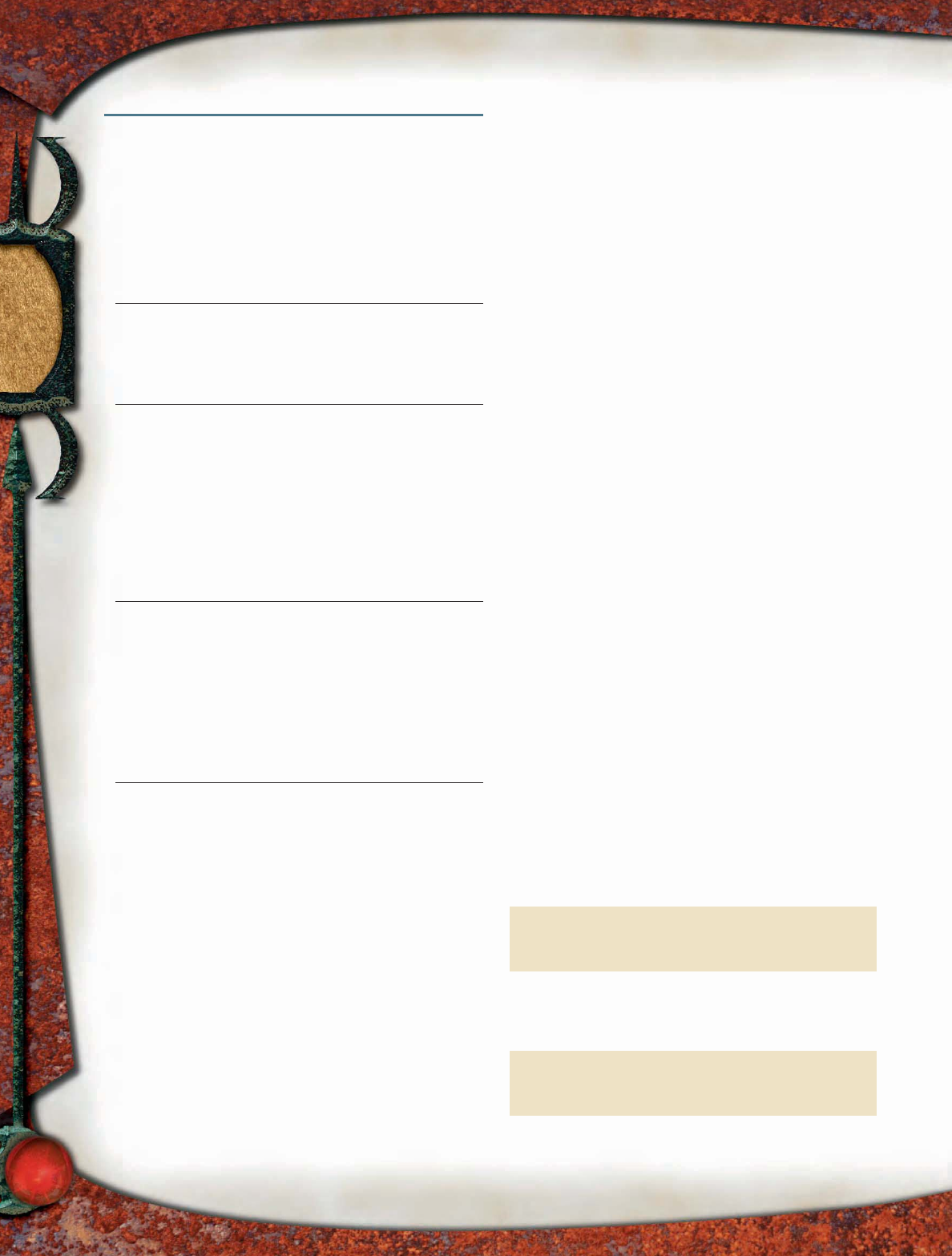
132
RUIN CHANTER
On a narrow stone ledge stands a nimble fi gure garbed in ragged
clothes and a rust-colored cloak. A pair of clever black eyes set in
a weathered face shine from beneath his wide-brimmed hat. His
long, fi ne fi ngers hold an ornate black mace. He suddenly licks his
parched lips and begins to wail a mournful dirge.
Ruin Chanter CR 14
Usually CN Medium fey (air, earth)
Init +11; Senses low-light vision; Listen +26, Spot +26
Languages Auran, Common, Giant, Sylvan, Terran
AC 31, touch 17, flat-footed 24; Dodge, Mobility
(+7 Dex, +14 natural)
hp 190 (20 HD); DR 15/cold iron and magic
Immune disease, poison
SR 23
Fort +12, Ref +19, Will +15
Speed 40 ft. (8 squares), fly 40 ft. (perfect)
Melee +2 adamantine light mace +20/+15 (1d6+7)
Space 5 ft.; Reach 5 ft.
Base Atk +10; Grp +15
Special Actions bardic music (countersong, fascinate
4 creatures, inspire courage +2, inspire confidence,
suggstion, inspire greatness 2 creatures, song of
freedom), call ruin elemental, infirmity of body, infirmity
of mind
Spell-Like Abilities (CL 20th):
3/day—crushing despair (DC 21), rusting grasp (+15 melee
touch, DC 21), spike stones (DC 21)
Abilities Str 20, Dex 25, Con 23, Int 18, Wis 17, Cha 25
SA bardic music, call ruin elemental, infirmity of mind,
infirmity of body, spell-like abilities
Feats Combat Expertise, Dodge, Endurance, Improved
Initiative, Mobility, Weapon Finesse, Weapon Focus (light
mace)
Skills Concentration +15, Hide +30, Knowledge (architecture
and engineering) +27, Knowledge (history) +27,
Listen +26, Move Silently +30, Perform (singing) +30,
Search +20, Spot +26, Survival +26, Tumble +30
Advancement 21–40 HD (Medium)
Bardic Music (Su) A ruin chanter has the bardic music ability
of a 12th-level bard (PH 29).
Call Ruin Elemental (Su) Once per week, when a ruin chanter
is aware of interlopers within the ruins it calls home, the
ruin chanter can conjure a ruin elemental (page 134)
after an hour-long ritual. During the ritual, a storm (DMG
94) appropriate for the climate strikes the ruin chanter’s
home. When the ritual is complete, the storm disappears
suddenly and a ruin elemental appears, ready to do the
ruin chanter’s bidding. Since the ruin elemental serves
the ruin chanter until the elemental is destroyed, it’s
possible for a ruin chanter to have more than one ruin
elemental serving it.
Infirmity of Body (Su) By pointing its finger, a ruin chanter
can prematurely age an enemy’s body. Doing so imposes
a –6 penalty to Strength, Dexterity, and Constitution, and
causes the victim’s hair to turn white, skin to wrinkle, and
posture to stoop (Fortitude DC 27 negates). The penalty
lasts for 1 hour or until the victim receives a remove curse
spell. A ruin chanter cannot place both infirmity of body
and infirmity of mind on the same creature. The save
DC is Charisma-based.
Infirmity of Mind (Su) With a wave of its hand, a ruin chanter
can render a creature senile and unable to reliably tell
friend from foe. This ability functions as a confusion spell
(Will DC 27 negates) and makes victims appear elderly
just as infirmity of body does. Infirmity of mind lasts for
1 hour or until the victim receives a remove curse spell.
A ruin chanter cannot place both infirmity of body and
infirmity of mind on the same creature. The save DC is
Charisma-based.
Ruin chanters, personifications of worldly decay, act as
guardians of ancient sites. They channel their sorrow
into melancholy songs of glories past and powers of
decomposition.
STRATEGIES AND TACTICS
When invaders come to a ruin chanter’s home, that chanter
calls a ruin elemental as soon as it can. It then sends the
elemental against the trespassers, while the ruin chanter
uses its infirmity abilities to prematurely age intruders
it deems to be the greatest threats. Intermittently, the
ruin chanter sings dirges commemorating the ruins’ past
glory to inspire courage or inspire greatness in itself and
its allies.
Ruin chanters are nimble foes, using their feats and
flight to deliver precise strikes or maneuver into a good
position to use a spell-like ability. They don’t give away
the fact that they can fly, seeming to move easily over dif-
ficult terrain or leap great distances. They use this secret
to great advantage in combat, weightlessly “springing”
onto unstable structures and luring their opponents into
following them, then “stepping off” the construction just
as it collapses.
pqqqqqqqqqrs
RUIN CHANTER LORE
Characters who have ranks in Knowledge (nature) can learn
more about ruin chanters. When a character makes a suc-
cessful skill check, the following lore is revealed, including
the information from lower DCs.
Knowledge (Nature)
DC Result
24 This is a ruin chanter, a fey guardian of ancient
ruins. It is a nimble combatant that can summon
biting stones on the ground. Beware its pretenses
at being earthbound, for it can actually fl y.
29 Ruin chanters have powers that can confuse,
depress, and age mortals, as well as corrode
metal. They can use a ritual to call ruin elementals
to aid them, but this ritual can’t be performed
during combat.
34 A ruin chanter is as enduring as its ruins. It can’t
be harmed by disease or poison, and it is resistant
to all sorts of spells. Only magic weapons made of
cold iron can effectively harm it.
pqqqqqqqqqrs
RUIN CHANTER
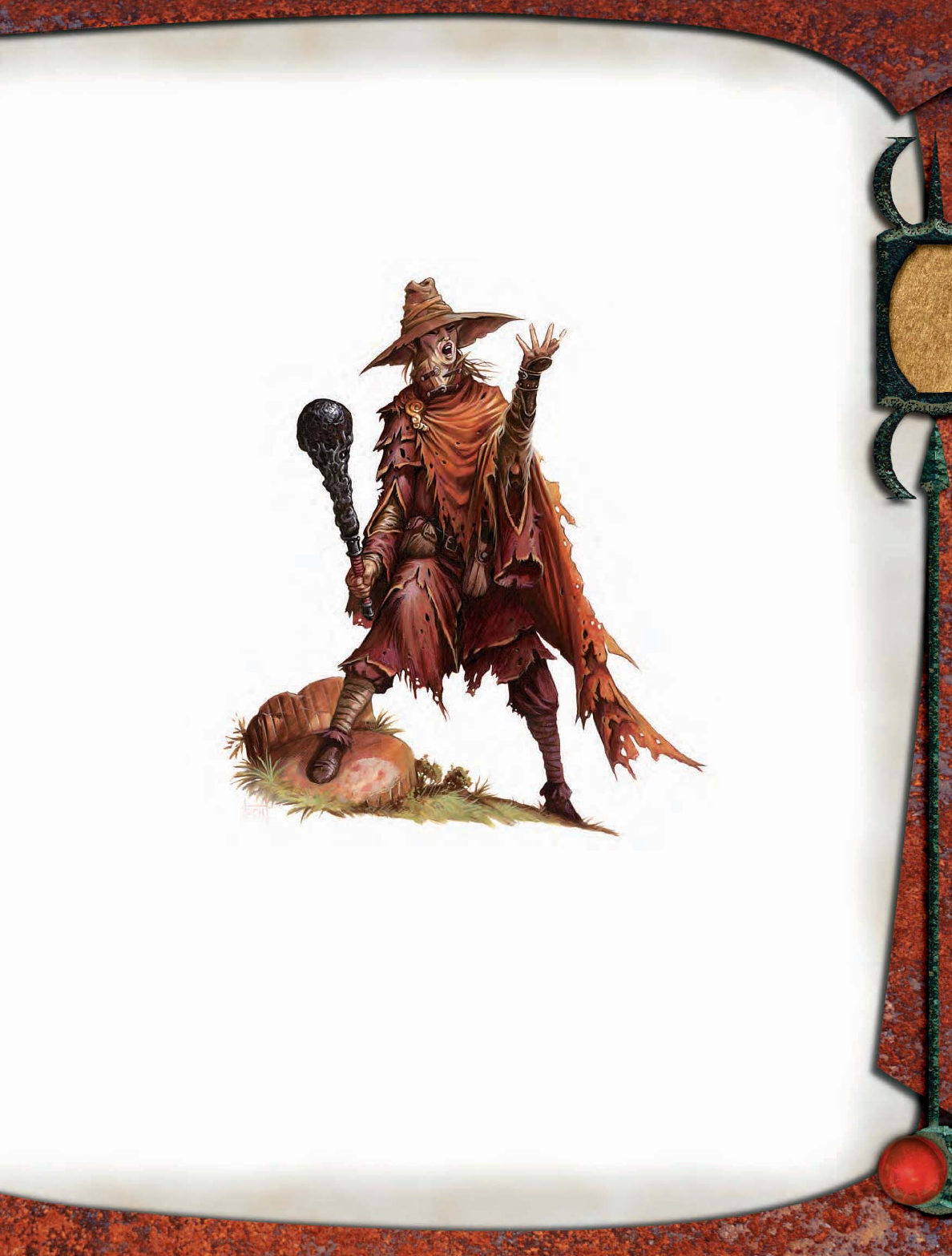
133
SAMPLE ENCOUNTER
Ruin chanters are solitary creatures, but they’re usually found
with ruin elemental servants. Occasionally, a bonded pair of
ruin chanters can be found in a single locale.
Urban Renewal (EL 15): In ruins from a bygone age
under a major city, a ruin chanter and two ruin elementals
have taken up residence. The powers that be have decided
to demolish the ruins to build an underground ward for
dwarves, bringing them into direct confl ict with the
ruin chanter and its allies.
ECOLOGY
Ruin chanters, like other types of fey, are spir-
its born of the land. In the case of a ruin
chanter, sadness and loss have given
it life, rather than natural vibrancy
and abundance. A ruin chanter
reflects these former qualities
in its solitary, introspective, and
melancholy manner.
Male and female ruin chanters
exist. On the rare occasion when two
ruin chanters of opposite sexes meet,
they mate and produce children the
way most mortal creatures do. Young
ruin chanters seek their own domains
far from their parents.
Ruin chanters eat ash and dust, and
they drink whatever water they find
within their ruined homes. To
them, air full of ancient grit
is like a fl oral perfume.
They sleep on piles of
rubble.
Environment:
These elusive fey are
found in locales rav-
aged by magic or war, or
where time has seen the
fall of civilization. They haunt the ruins
of lost cities, ancient temples, and toppled fortresses. Ruin
chanters revel in the dissolution imposed by time, so most
of them shy away from populated areas.
Typical Physical Characteristics: Ruin chanters are
lanky humanlike creatures, standing between 5 and 6 feet
tall. Their skin is weathered, colored tan to gray, with patches
of wind-burned red. Eyes sparkle darkly, no whites to be seen,
within those hairless faces, and ruin chanters have silvery
locks as an aged human might.
Alignment: A ruin chanter is selfi sh and pessimistic.
Caring little for events and creatures outside its demesne,
a ruin chanter is openly hostile to those who raid its home
for loot. It can be deadly in such a case, though it doesn’t try
to cause undue suffering. Ruin chanters are usually chaotic
neutral, and they are seldom good. Evil ruin chanters try
to create ruins from thriving societies.
SOCIETY
A creature that enters a ruin chanter’s ruins to do anything
other than subsist or restore the glories of the past becomes
the ruin chanter’s enemy. Ruin chanters harry their foes
relentlessly, intent on preserving the grandeur
of ages past. Although it is content to
drive away adversaries, a ruin chanter
isn’t gentle or diplomatic.
Solitary creatures by nature, ruin
chanters nonetheless occasionally at-
tract followers who share their views. A
ruin chanter tolerates constructs, undead,
and other creatures native to its chosen
ruins. It also abides creatures devoted
to restoration.
Ruin chanters dress in earth-toned
clothes, wearing cloaks, hats, scarves, or
goggles to conceal their features. They
carry ornate melee weapons, most com-
monly an adamantine mace. Though
the mace sometimes has decora-
tions similar to those found in
the ruins, it isn’t necessarily
from a former age.
Individual ruin chanters
sometimes seek compan-
ionship among their
kind, often to mate.
They respect one
another’s territo-
ry, though, and a
visiting ruin chanter sings an
announcement to let a poten-
tial host know of its approach.
The ruin’s owner can respond with a song of welcome
or a song of warning, greeting or rejecting the would-
be guest.
TYPICAL TREASURE
Ruin chanters don’t collect treasure, but the antiquities
and wonders of the ancients are under their guard. They
effectively have double standard treasure for their Challenge
Rating. This wealth is spread around the chanter’s home
ruin, and those who take even the smallest item draw the
fey’s ire.
Ruin chanter
RUIN CHANTER
Illus. by R. Horsley

134
RUIN ELEMENTAL
What appeared at fi rst to be the debris of a fallen wall or crumbling
building suddenly lurches to its feet. Composed entirely of rubble,
this immense hunchbacked biped rumbles quickly toward you, its
rocky fi sts raised.
Ruin Elemental CR 10
Usually N Large elemental (earth)
Init +0; Senses darkvision 60 ft., low-light vision; Listen +9,
Spot +9
Languages Terran
AC 23, touch 9, flat-footed 23
(–1 size, +14 natural)
hp 161 (14 HD); DR 5/—
Fort +16, Ref +4, Will +6
Immune elemental immunities, spike stones
Speed 40 ft. (8 squares)
Melee 2 slams +19 each (1d8+9)
Ranged rock +19 (2d6+9)
Space 10 ft.; Reach 10 ft.
Base Atk +10; Grp +23
Atk Options Improved Bull Rush, Improved Sunder, Power
Attack
Special Actions shock wave
Abilities Str 28, Dex 10, Con 24, Int 9, Wis 15, Cha 7
SA rock throwing, shock wave
SQ elemental traits
Feats Brutal Throw*, Improved Bull Rush, Improved Sunder,
Power Attack, Weapon Focus (slam)
* New feat; see sidebar.
Skills Hide –1*, Jump +13, Listen +9, Spot +9
* Ruin elementals have a +4 racial bonus on Hide checks
in areas of ruined stone.
Advancement 15–26 HD (Large); 27–42 HD (Huge)
Immunities (Ex) Ruin elementals take no damage and suffer
no impeded movement in the area of a spike stones spell.
Rock Throwing (Ex) Like giants, ruin elementals are
accomplished rock throwers and have a +1 racial bonus
on attack rolls when throwing rocks. A ruin elemental
of Large size can hurl rocks weighing up to 50 pounds
(Small objects) up to five range increments. A Huge
ruin elemental can hurl rocks weighing up to 80 pounds
(Medium objects) up to five range increments. The
range increment is 150 feet for a ruin elemental’s
thrown rocks.
Shock Wave (Ex) Every 1d4 rounds, as a swift action, a
ruin elemental can strike the ground to create a shock
wave in a 20-foot-radius spread centered on itself. All
creatures not of the earth subtype within the radius
of the shock wave are treated as if bull rushed by the
ruin elemental. The ruin elemental receives a +4 bonus
on this check from Improved Bull Rush, as well as +4
for each size category it is larger than the targeted
opponent. A typical ruin elemental has a +17 bonus
on the opposed check against Medium creatures, +21
against Small creatures, and +13 against Large
creatures. Creatures that fail the opposed checks are
pushed back 5 feet and knocked prone.
Brought into being by ruin chanters (page 132), ruin elemen-
tals arise in wasted lands and shattered fortresses. They keep
to themselves, avoiding contact with other creatures.
STRATEGIES AND TACTICS
Ruin elementals are passive, patient creatures, but they turn
violent when others trespass within the territory they are
dedicated to defending. Ruin elementals guarding their
lairs are aggressive and virtually impossible to negotiate
with, seeing all creatures in the area as threats to be slain or
driven away. Only the ruin chanter that created it and those
designated as harmless by the ruin chanter can approach a
ruin elemental without fear.
When defending their homes, ruin elementals first
attempt to take out opponents with volleys of thrown
rocks. When foes close to melee range, the elemental
meets them with its slam attacks. If fighting multiple
foes, a ruin elemental uses its shock wave ability to knock
them down. Prone foes likely remain within the creature’s
reach, but it concentrates on one target before moving on
to the rest.
In defense of their lairs and the areas they are sworn to
protect, ruin elementals fi ght to the death.
SAMPLE ENCOUNTERS
Ruin elementals are the servants of ruin chanters. These
elementals are called to the Material Plane, and they seldom
appear in large numbers.
Masterless Servant (EL 10): A lone ruin elemental lurks
within the rubble of a fallen castle. The ruin chanter that cre-
ated it is long dead, but a doppelganger has a lair nearby. The
shapechanger knows which areas of the ruins it can hide in
to avoid the elemental’s wrath. If the doppelganger observes
PCs investigating the area, he poses as the ruin chanter and
demands tribute in exchange for ordering “his” guardian to
stand down. The doppelganger then fl ees with the payment
(or if his ruse is discovered), leaving the party to face the
ruin elemental.
Final Guardians (EL 13): A trio of ruin elementals
guards the exit from an ancient dungeon explored by the
PCs. When the characters emerge, the elementals hem
them in, preventing their exit but keeping them from
fleeing back into the place. Unless the PCs drop the loot
they took from the dungeon, these guardians attack and
fight until destroyed.
ECOLOGY
Ruin elementals refl ect the destructive forces of nature and
time even as they protect the remains of history. Their ruin
pqqqqqqqqqrs
NEW FEAT: BRUTAL THROW
You have learned how to hurl weapons to deadly effect.
Benefit: You can add your Strength modifier (instead of your
Dexterity modifier) to attack rolls with thrown weapons.
Normal: A character attacking with a ranged weapon adds
his Dexterity modifier to the attack roll.
Special: A fighter can select Brutal Throw as one of his
fighter bonus feats.
pqqqqqqqqqrs
RUIN
ELEMENTAL
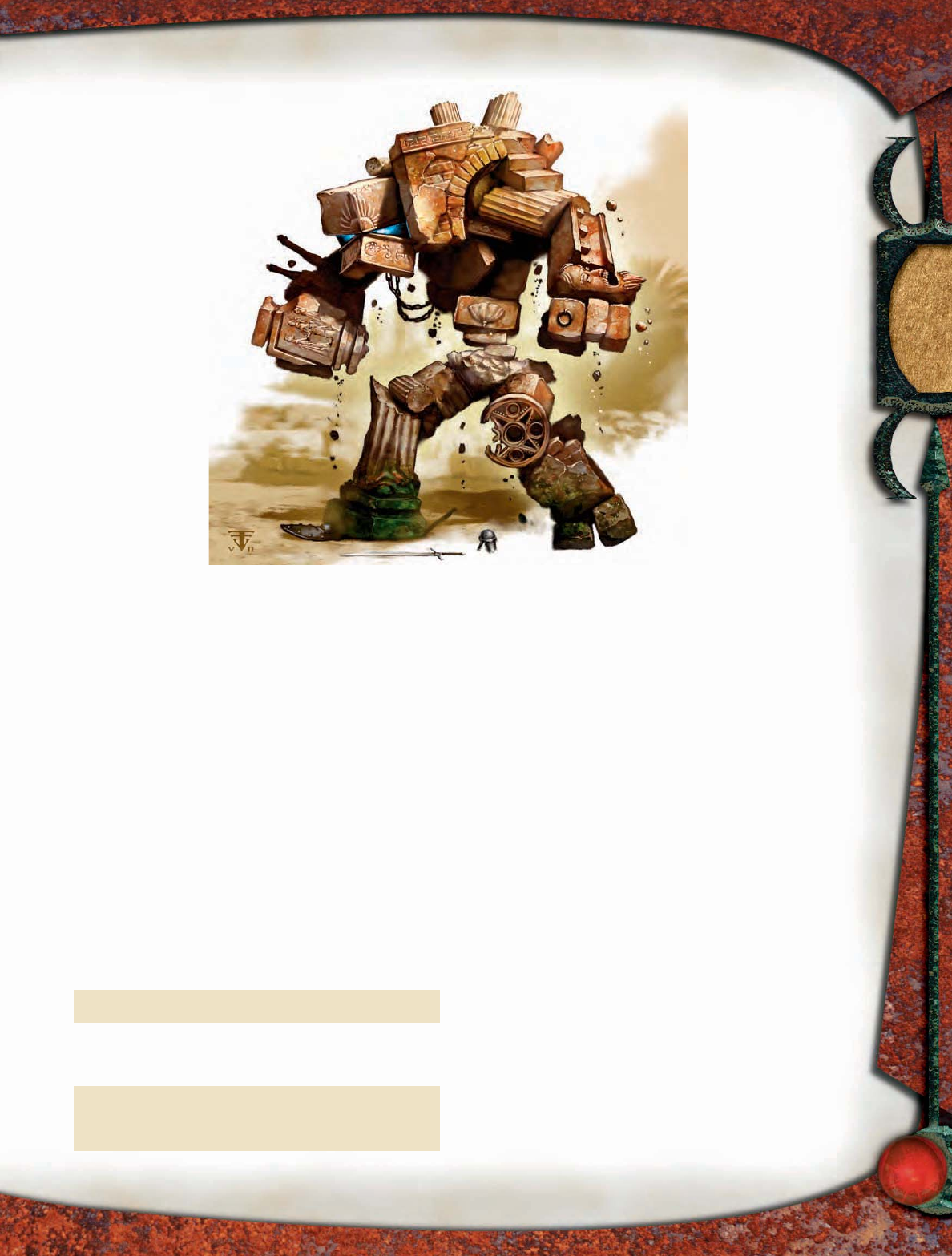
135
chanter masters create them to guard ancient places
against those intent on plunder or defi lement.
Ruin elementals instinctively collect curios
from the ruins in which they arise, usually
taking great care to safeguard such
objects. These items can be near-
ly anything from worthless
statuary to potent artifacts.
Although a ruin elemen-
tal is very possessive of
the treasure it collects, the
surface of the creature’s
body is so abrasive that
most objects it touches
and handles suffer signifi -
cantly from that contact.
Mundane items in
a ruin elemental’s
hoard are inev-
itably damaged
by its touch, and
they often look
like nothing more
than junk.
Environment:
Ruin elementals
guard long-abandoned
cities, temples, and fortresses in the farthest corners of the
world. Trackless deserts, tundra, and other places so in-
hospitable that their ruins were never resettled are these
creatures’ homelands.
Typical Physical Characteristics: Ruin elementals are
stooped, shambling creatures that stand some 14 feet tall.
Their rocky forms weigh about 7,000 pounds. Over time,
the rubble from which a ruin elemental is made is ground
down by its movement and the friction that movement cre-
ates against its surroundings. The oldest ruin elementals
look as though they
are made of rough
gravel and spurs of
harder stone.
Alignment:
Ruin elementals care
little for the lives of
other creatures, and
they are typically be-
nign unless they or
the areas over which
they claim steward-
ship are threatened.
They are usually
neutral.
TYPICAL
TREASURE
Ruin elementals col-
lect whatever odds and
ends they find interesting,
but these items are not nec-
essarily valuable or useful.
Although they are rarely
found in possession of coins,
ruin elementals frequently hoard
fine weapons and art. These are often worn
or damaged in some way because of the creature’s abra-
sive touch, and they are worth their full value only to
collectors. Magic items are also commonly found in a
ruin elemental’s lair, since such objects are more capable
of withstanding the ravages of time and the creature’s
touch. Ruin elementals have half standard treasure for
their Challenge Rating, almost all of which is in the form
of the aforementioned items.
RUIN ELEMENTALS IN EBERRON
Ruin elementals can be found across Eberron, from the ruins
of Xen’drik to the blasted wastes of the Mournland. In the
Demon Wastes, ruin elementals are thought to have been
created by ruin chanters dedicated to guarding that land
against the return of the Lords of Dust. Rumor has it that a
ruin chanter has hidden a powerful artifact within territory
guarded by his creations—a relic said to be instrumental in
the plans of those seeking to free the fi ends that were bound
at the end of the Age of Demons.
RUIN ELEMENTALS IN FAERÛN
Thought to be little more than legend, ruin elementals are
found in the deep deserts and tundra of Faerûn. Within
the lairs of the oldest ruin elementals, powerful magic
items of Faerûn’s past are said to be hidden. Factions of the
Zhentarim and the Red Wizards search constantly for such
sites, and they pay handsomely for information regarding
such locations. They also reward those who thwart others
in similar searches.
pqqqqqqqqqrs
RUIN ELEMENTAL LORE
Characters who have ranks in Knowledge (the planes) can
learn more about ruin elementals. When a character makes a
successful skill check, the following lore is revealed, including
the information from lower DCs.
Knowledge (the Planes)
DC Result
20 This monster is a ruin elemental, a creature bound
to a particular site of ruin and destruction.
25 Ruin elementals protect the areas they are bound
to guard with thrown rocks and vicious slams.
They collect the relics of the past, which can be
found in their lairs.
30 Ruin elementals produce a devastating shock wave
that can knock foes prone. Ruin chanters call ruin
elementals forth to protect ancient places from the
predations of looters.
pqqqqqqqqqrs
Ruin elemental
RUIN
ELEMENTAL
Illus. by F. Vohwinkel

136
RYLKAR
Rylkars are a race of ratlike creatures hailing from the
upper regions of the Underdark. These monstrosities
spread into inhabited locales, consuming all they find
and reproducing at a terrifying rate. Like the rats they
resemble, rylkars feed on garbage and offal, and their
presence spreads the taint of corruption throughout the
areas where they lair.
Fire is the source of the rylkar life cycle, and all rylkars
are drawn to fl ame. Rylkar mating rituals typically involve
fi re-resistant tormentors and madclaws bringing open fl ame
to a rylkar harridan, who then spawns a swarm of new rylkars
with this life-giving energy.
RYLKAR HARRIDAN
Vile odors hang heavy in the air even before you spot their source.
A massive hulk of matted fur and fl esh shudders to life, rolling in
its own waste as it fi xes you with an eyeless face. What appears to
be an enormous, bloated rat rises before you, its tongue fl icking
from its gaping jaws.
Rylkar Harridan CR 9
Always NE Huge magical beast
Init +2; Senses blind, blindsight 60 ft., scent; Listen +19
Languages Undercommon
AC 24, touch 10, flat-footed 22
(–2 size, +2 Dex, +14 natural)
hp 125 (10 HD); regeneration 5; DR 10/magic
Immune gaze attacks, illusions, visual effects
Fort +14 (+18 against disease), Ref +9, Will +5 (+9 against
mind-affecting)
Speed 10 ft. (2 squares)
Melee bite +16 (2d6+12/19–20 plus rylkar fever)
Space 15 ft.; Reach 10 ft.
Base Atk +10; Grp +26
Atk Options Cleave, Improved Sunder, Power Attack,
frightful presence, magic strike
Special Actions contaminate, spawn swarm
Abilities Str 26, Dex 15, Con 24, Int 5, Wis 14, Cha 17
SA contaminate, frightful presence, magic strike, rylkar fever,
spawn swarm
SQ hive mind
Feats Cleave, Improved Critical (bite), Improved Sunder,
Power Attack
Skills Listen +19
Advancement 11–20 HD (Huge); 21–30 HD (Gargantuan)
Blindsight (Ex) A rylkar harridan can sense all foes within
60 feet as a sighted creature would. Beyond that range,
she treats all targets as having total concealment. A
rylkar harridan is susceptible to sound- and scent-based
attacks, however, and is affected normally by loud
noises, sonic spells (such as ghost sound or silence), and
overpowering odors (such as stinking cloud or incense-
heavy air). Negating a harridan’s sense of smell or
hearing reduces this ability to normal Blind-Fight (as the
feat). If both these senses are negated, a rylkar harridan is
effectively blinded.
Regeneration (Ex) A rylkar harridan takes normal damage
from fire and acid.
Rylkar Fever (Ex) Disease—bite, Fort DC 22 negates,
incubation period 1 day, damage 1d6 Con. The save DC is
Constitution-based.
Frightful Presence (Ex) 30-foot radius, 10 HD or fewer, Will
DC 18 negates.
Contaminate (Su) A rylkar harridan exudes toxins that
contaminate the environment around it. Food or drink
brought within 20 feet of a harridan becomes foul and
poisonous (Fort DC 22, 1d6 Con/1d6 Con) to any but
rylkars. Potions in the area must succeed a DC 22
Fortitude save or become similarly poisonous. The save
DC is Constitution-based.
This contamination spreads away from a rylkar
harridan’s lair. Once a rylkar harridan remains in a
cavern or dungeon room up to 80 feet on a side, or
similar chamber, for one full week, that entire room is
contaminated as above. The contamination spreads
20 feet from that room each day the rylkar harridan
remains present. A remove curse spell cast within
the room after the harridan has been killed ends the
contamination.
Spawn Swarm (Ex) Three times per day, when a rylkar
harridan takes at least 5 points of fire damage from
a single source, she can release a rylkspawn swarm
into 4 contiguous squares that she occupies or is
adjacent to.
Hive Mind (Ex) All rylkars within 10 miles of their harridan
are in constant communication, and she with them.
If one is aware of a particular danger, they all are. If
one in a group is not flat-footed, none of them are. No
rylkar in a group is considered flanked unless all of
them are.
Skills Rylkar harridans have a +4 racial bonus on Listen
checks.
A rylkar harridan is the queen of a rylkar colony. She
spends her time rolling in the muck of her surround-
ings and devouring her madclaw drones with disgusting
relish, even as she poisons the area around her with her
foul presence.
By the power of fi re, all rylkars are born from a harridan,
but large numbers of these creatures meet their eventual end
inside her gullet. So ravenous are the rylkar harridans that
they are known to snatch and devour new broods of young
to appease their gnawing hunger.
Strategies and Tactics
If an enemy manages to breach the defenses of a rylkar
infestation and reaches the harridan’s breeding pit, the
rylkar queen rises up in her terrible wrath. Though
blind, she homes in on her enemies with blindsight and
moves toward her closest opponent. Swollen with cor-
ruption and maddened by constant hunger, she uses her
prodigious jaws and Improved Sunder feat to shatter her
foes’ weapons, then uses Power Attack to quickly kill her
screaming meals.
A harridan moves to attack any creature carrying fi re,
whether a torch or a fl aming weapon. Though she knows
that fi re can harm her, she relishes the pain that allows her
to create more spawn.
RYLKAR
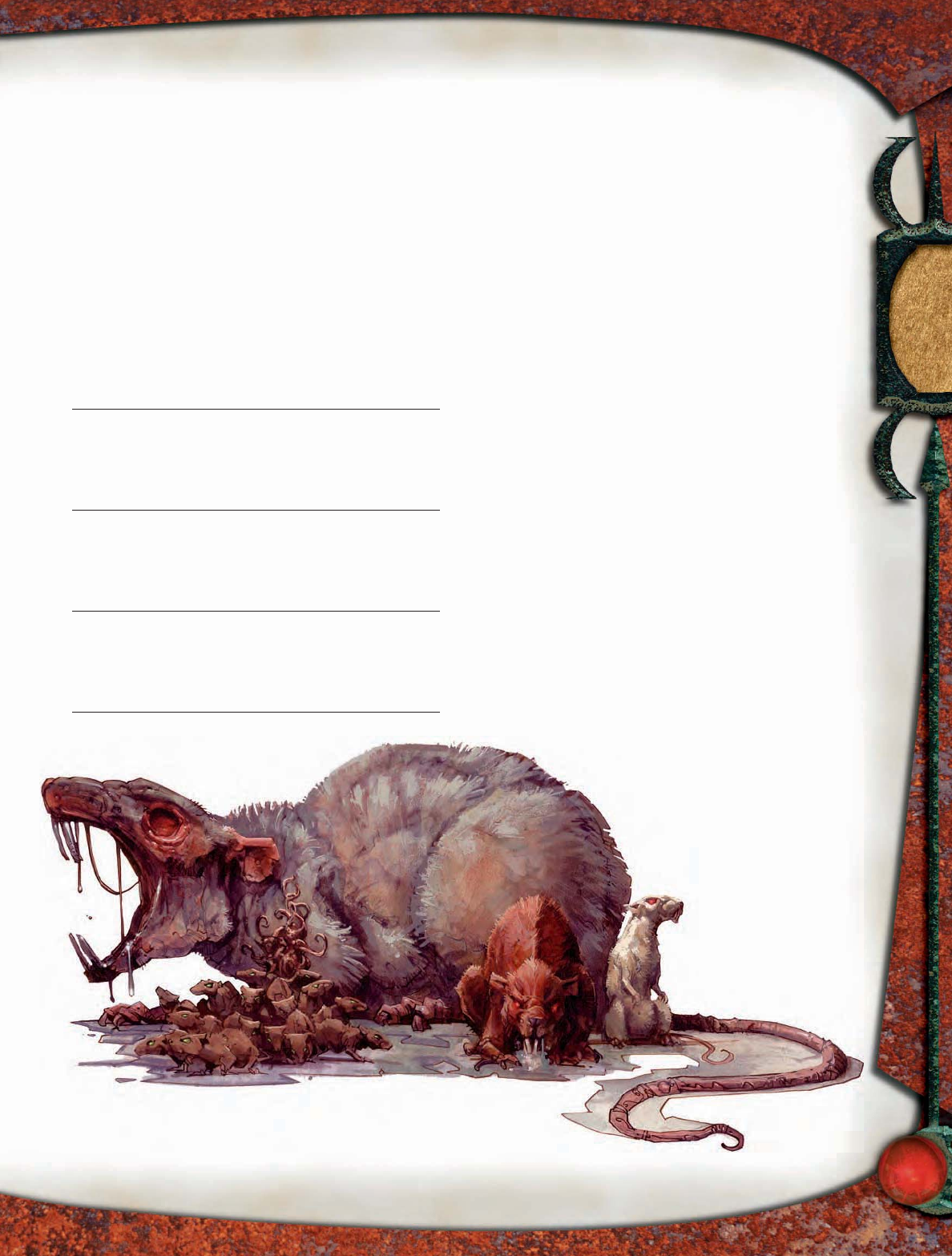
137
A harridan has little interest in the well-being of other
rylkars, and she fi ghts without regard for tactical position.
In fact, a harridan’s appetite is so voracious that if no oppo-
nents stand within immediate reach, she is likely to snatch
up and feed on a squirming ally to give her strength for the
battle to come.
RYLKAR MADCLAW
A tittering laugh echoes in the darkness, followed by the sound of
scrabbling claws. A white rat the size of a dog emerges from the
clinging shadows, whiskers twitching as it creeps forward. Then it
laughs again as it races to attack.
Rylkar Madclaw CR 3
Always NE Small magical beast
Init +3; Senses darkvision 60 ft.; Listen +10, Spot +7
Languages Undercommon
AC 15, touch 14, flat-footed 12; Dodge
(+1 size, +3 Dex, +1 natural)
hp 26 (4 HD); fire healing
Immune fire
Fort +5 (+9 against disease), Ref +7, Will +4 (+8 against
mind-affecting)
Speed 30 ft. (6 squares), burrow 20 ft., climb 20 ft.
Melee bite +8 (1d4 plus filth fever) and
2 claws +3 each (1d3 plus 1 Con)
Space 5 ft.; Reach 5 ft.
Base Atk +4; Grp +0
Special Actions mad shriek
Abilities Str 10, Dex 17, Con 13, Int 4, Wis 17, Cha 14
SA filth fever, mad shriek
SQ hive mind
Feats Dodge, Weapon Finesse
Skills Climb +8, Hide +7, Listen +10, Spot +7
Advancement 5–8 HD (Small); 9–12 HD (Medium)
Fire Healing (Ex) In addition to being immune to fire, a
madclaw heals 5 hit points each time it is subjected to an
attack that deals fire damage.
Filth Fever (Ex) Disease—bite, Fort DC 13 negates,
incubation period 1d3 days, damage 1d3 Dex and 1d3
Con. The save DC is Constitution-based.
Mad Shriek (Ex) Once per day, a madclaw can emit a horrible
shriek. All creatures except rylkars within 30 feet must
make a DC 13 Will save or become confused for 1 round.
The save DC is Constitution-based.
Hive Mind (Ex) All rylkars within 10 miles of their harridan
are in constant communication, and she with them.
If one is aware of a particular danger, they all are. If
one in a group is not flat-footed, none of them are. No
rylkar in a group is considered flanked unless all of
them are.
Skills Madclaws have a +4 racial bonus on Listen checks
and a +8 racial bonus on Climb checks. A madclaw can
choose to take 10 on Climb checks, even if rushed or
threatened.
Madclaws are the drones, workers, and battle fodder of a
rylkar colony.
Strategies and Tactics
Though they lack the raw strength of rylkar tormentors,
madclaws don’t shirk when it comes to battle. Gathering
in bands of two to six, madclaws can even deter individual
tormentors from making a meal out of them. Multiple bands
overwhelm foes through superior numbers.
When threatened, a madclaw assumes a defensive posture,
using its Dodge feat against the closest enemy. If outnum-
bered, it uses its mad shriek to confound its opponents and
escape. If cornered, a madclaw is a vicious foe, lashing out
with its corrupt bite and claws.
Rylkars
RYLKAR
Illus. by C. Critchlow

138
RYLKAR TORMENTOR
A great fl abby rat covered in fi lthy red fur speeds out of the darkness,
mouth foaming. Its mad eyes follow your movements as it unleashes
a piercing scream.
Rylkar Tormentor CR 6
Always NE Medium magical beast
Init +7; Senses darkvision 60 ft.; Listen +10, Spot +6
Languages Undercommon
AC 18, touch 13, flat-footed 15
(+3 Dex, +5 natural)
hp 60 (8 HD); DR 5/magic
Resist fire 10
Fort +8 (+12 against disease), Ref +9, Will +3 (+7 against
mind-affecting)
Speed 40 ft. (8 squares), climb 20 ft.
Melee bite +10 (1d6+2 plus filth fever) and
2 claws +8 each (1d4+1)
Space 5 ft.; Reach 5 ft.
Base Atk +8; Grp +10
Atk Options magic strike, pounce, rake
Special Actions hate shriek
Abilities Str 14, Dex 17, Con 14, Int 5, Wis 12, Cha 10
SA filth fever, hate shriek, magic strike, pounce, rake
SQ hive mind
Feats Improved Initiative, Multiattack, Weapon Finesse
Skills Climb +10, Jump +6, Listen +10, Spot +6, Survival +2
Advancement 9–12 HD (Medium); 13–24 HD (Large)
Filth Fever (Ex) Disease—bite, Fort DC 16 negates,
incubation period 1d3 days, damage 1d3 Dex and 1d3
Con. The save DC is Constitution-based.
Hate Shriek (Ex) As a standard action, a tormentor can emit
a scream that incites hatred in all madclaws within 30
feet. Madclaws in the area gain a +2 morale bonus on
attack rolls and damage rolls for 1 minute.
Pounce (Ex) If a tormentor charges a foe, it can make a full
attack, including two rake attacks.
Rake (Ex) Attack bonus +8 melee, damage 1d4+1.
Hive Mind (Ex) All rylkars within 10 miles of their harridan
are in constant communication, and she with them. If
one is aware of a particular danger, they all are. If one in a
group is not flat-footed, none of them are. No rylkar in a
group is considered flanked unless all of them are.
Skills Rylkar tormentors have a +4 racial bonus on Listen
checks and a +8 racial bonus on Climb checks. A
tormentor can choose to take 10 on Climb checks, even if
rushed or threatened.
Tormentors are the warriors of a rylkar colony. They protect
the harridan and harass other rylkars, murdering them to
pass the time until another foe comes along.
Strategies and Tactics
Tormentors work individually or in teams of two to four,
charging intruders en masse. They pounce on their enemies,
tearing into them with jagged claws and teeth. If supported
by madclaws, tormentors use hate shriek to make those
allies more formidable. Having inherited something of
their queen’s hunger, they do not pursue fl eeing opponents.
Instead, they set upon the dead or dying, gorging themselves
on fresh meat.
RYLKSPAWN SWARM
You catch a whiff of a foul stench as a knot of squirming rats surges
out of the darkness. Gleaming green eyes seek you out as uncount-
able sleek brown bodies writhe, their tails seemingly entwined in
one great knot.
Rylkspawn Swarm CR 4
Always NE Tiny magical beast (swarm)
Init +10; Senses darkvision 60 ft.; Listen +9, Spot +5
Aura terror musk (10 ft.)
Languages understands Undercommon
AC 18, touch 18, flat-footed 12
(+2 size, +6 Dex)
hp 45 (7 HD)
Immune fire, swarm immunities
Resist half damage from piercing and slashing
Fort +6 (+10 against disease), Ref +11, Will +3 (+7 against
mind-affecting)
Weakness swarm vulnerabilities
Speed 20 ft. (4 squares), climb 10 ft.
Melee swarm (2d6 plus 1 Con plus filth fever)
Space 10 ft.; Reach 0 ft.
Base Atk +7; Grp —
Atk Options distraction
Abilities Str 5, Dex 22, Con 13, Int 1, Wis 13, Cha 8
SA distraction, filth fever, terror musk
SQ swarm traits
Feats Ability Focus (distraction), Improved Initiative, Stealthy
Skills Climb +5, Hide +14, Listen +9, Move Silently +8,
Spot +5
Advancement 8–14 HD (Tiny)
Terror Musk (Ex) At the end of a rylkspawn swarm’s turn,
creatures within 10 feet of it must make a DC 16 Will
save or become shaken for 1 round. The save DC is
Constitution-based and includes a +2 racial bonus.
A creature that successfully saves cannot be affected
again by that same rylkspawn swarm’s musk for 24 hours.
Rylkars are immune to this effect.
Filth Fever (Ex) Disease—swarm attack, Fort DC 14 negates,
incubation period 1d3 days, damage 1d3 Dex and 1d3
Con. The save DC is Constitution-based.
Distraction (Ex) Fortitude DC 14, nauseated 1 round. The
save DC is Constitution-based.
Skills Rylkspawn swarms have a +4 racial bonus on Listen
checks and a +8 racial bonus on Climb checks. A
rylkspawn swarm can choose to take 10 on Climb checks,
even if rushed or threatened.
A rylkspawn swarm is made up of the massed spawn of a
rylkar harridan. A swarm numbers three hundred or more
individual rylkspawn that roll over and devour anything in
their path.
Strategies and Tactics
Though individual rylkspawn are the least of the rylkars,
a swarm of these creatures can strip a foe to the bone in
short order. A swarm attacks in a straightforward manner,
moving over as many opponents as possible in an attempt
to consume them.
RYLKAR
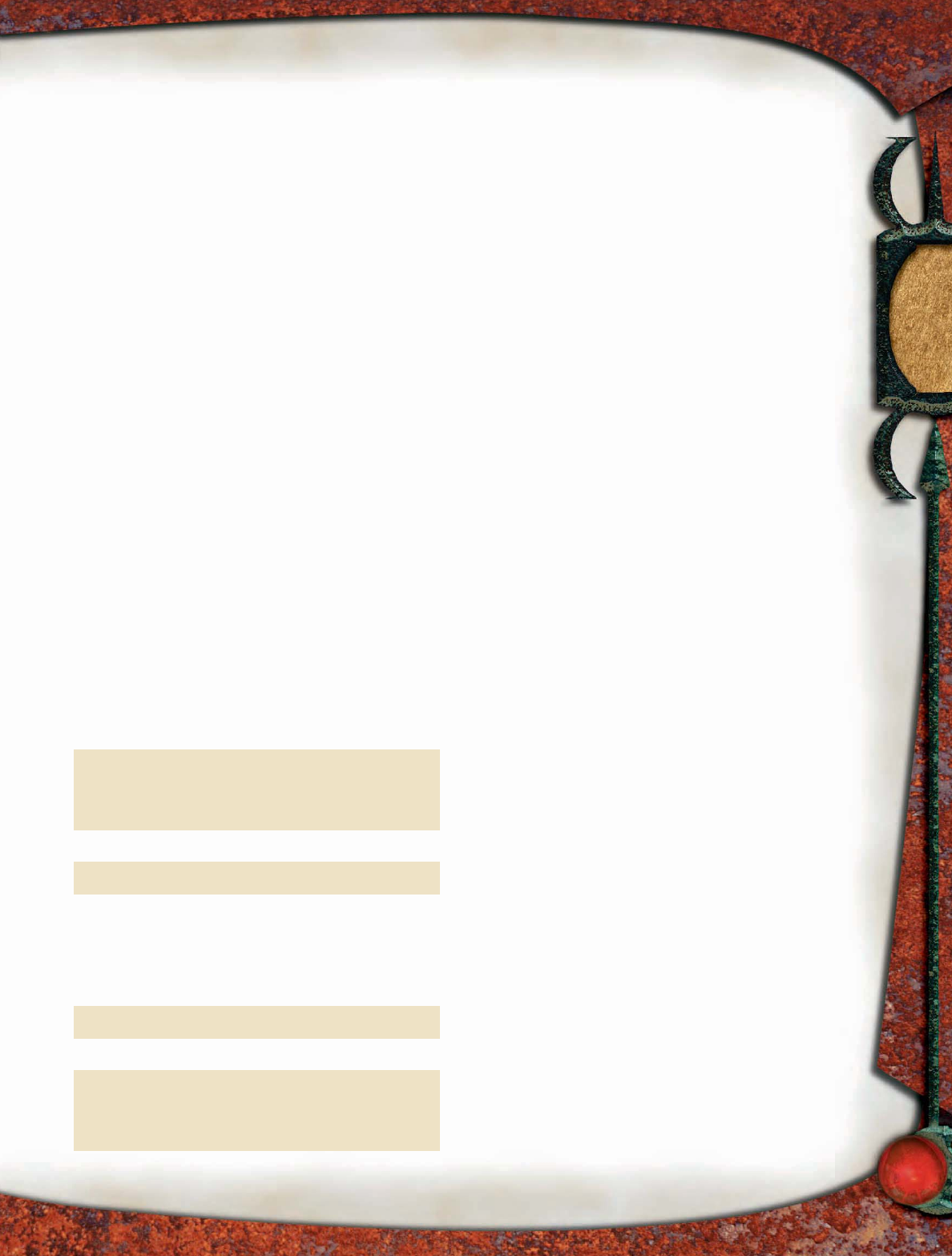
139
SAMPLE ENCOUNTERS
Rylkar colonies arise as infestations, and rylkars defend the
colony and its harridan to the bitter end. Creatures encoun-
tered singly or in small numbers should be close to a larger
lair, and a rylkar infestation can and probably should serve
as the backbone of an adventure.
An infestation of rylkars might take hold in a city’s sewers,
growing in size and danger as these creatures feed their insa-
tiable hunger. Alternatively, a colony might establish itself in
proximity to an important location in the Underdark, feasting
on subterranean travelers or the leavings of other predators.
Scavengers (EL 7): Three rylkspawn swarms prowl the
tunnels of a city sewer. Even when seeking morsels with
which to stuff themselves, they search for fi re to present to
the harridan. When the PCs cross their path, the rylkspawn
swarms seize the opportunity to feed.
The Doomed (EL 8–10): In a rare moment of desperate
self-preservation, a group of six madclaws attempts to escape
a failing colony, knowing that the harridan will devour
them all before the end. As the madclaws fl ee through the
Underdark, a group of three tormentors pursues them, with
the PCs caught in the middle.
Queen of Filth (EL 13): In the center of a rylkar infesta-
tion stands the lair of the harridan. This foul chamber holds
the rylkar queen herself, as well as the four tormentors and
eight madclaws attending her.
ECOLOGY
A rylkar colony has a ravenous appetite. When a rylkar
infestation takes hold, rylkspawn swarms swiftly destroy
the local ecosystem, slaughtering native creatures and strip-
ping plants bare. Before long, the area around the colony is
devoid of life, forcing the rylkars to range farther and farther
for survival. Eventually, the gathering of more food in the
vicinity becomes impossible, and the infestation must move
on or die.
Once a rylkar colony takes hold, tormentors set out to fi nd
sources of fi re. By bringing these back to the harridan, the
tormentors help the colony expand its numbers to forage in
a wider range. For their service and devotion, tormentors
are often eaten after the harridan has given birth to a new
rylkspawn swarm.
As a swarm matures, its members eat each other and any-
thing else consumable in the area. The survivors emerge as
warrior tormentors and madclaw drones. The most numerous
rylkars inside a colony are the madclaws, and tormentors are
more common outside the colony. Occasionally, a rylkspawn
swarm includes a nascent harridan. If this creature can act
quickly and eat enough of the swarm to survive, it is carried
off by madclaws under tormentor escort, eventually founding
a new colony far from the old.
Rylkars blindly attack any creatures they encounter, just
as other creatures usually attack a rylkar on sight. Animals
instinctively sense the corruption inherent in rylkars, and they
either attempt to drive the rylkars off or immediately fl ee.
Environment: Though they have no special antipathy to
light, rylkars prefer to hole up in underground environments.
In addition to keeping them hidden from potential predators,
underground life suits the rylkars’ nocturnal nature. A colony
emerges from its lair when the sun has set, beginning the
night’s hunt in an attempt to appease the harridan’s dread-
ful hunger. Rylkars lair aboveground only when doing so
protects them from their enemies better than a subterranean
lair could. Whether in the heart of a massive sewer system
or the ruins of an ancient fortress, a rylkar infestation is a
noxious and deadly scourge.
Typical Physical Characteristics: Rylkars might look
like giant rats from a distance, but closer inspection shows the
similarity to be superfi cial. They have pale skin mottled with
thin patchy fur. Their skin is covered with unsightly bulges
and tumors that have a tendency to burst when the creatures
are active, spraying streams of pale green fl uid harmlessly into
the air. This expulsion appears to cause the rylkars no distress,
however, and they chitter happily at the patterns produced
on walls and foes alike by this disgusting display.
Lesser rylkars vary in size, depending on their purpose
in a colony. An individual rylkspawn is about the size of a
large brown rat, 1 to 2 feet long and weighing 2 to 4 pounds.
Madclaws grow up to 4 feet in length and weigh about 40
pounds. They are covered in pale white fur and have pink
pqqqqqqqqqrs
RYLKAR LORE
Characters who have ranks in Knowledge (arcana) can learn
more about rylkars. When a character makes a successful skill
check, the following lore is revealed, including the information
from lower DCs.
Knowledge (Arcana)
DC Result
13 This creature is a member of a rylkar infestation—
a colony of evil ratlike creatures native to the
Underdark. A creature called a madclaw is the
most common rylkar. This result reveals all
magical beast traits.
14 Rylkar young mass in teeming swarms that can
strip a creature to the bone in a matter of seconds.
16 The skittering tormentors are the warriors of the
rylkars, protecting the colony and its queen.
18 A blind and bloated harridan rules a rylkar
colony. She and her offspring spread disease with
their bites. They all have dense hides that are
particularly resistant to attacks with mundane
weapons. Some are also resistant to fi re. Rylkar
madclaws can unleash a scream that confuses
their foes.
19 Rylkspawn swarms give off a foul stench that
strikes fear into enemies.
21 Rylkar tormentors emit a shriek that can bolster
their madclaw kin.
28 A rylkar harridan regenerates damage, but unlike
her lesser children, she is not immune to fi re.
Fire damage allows this foul creature to generate
a swarm of rylkspawn. She can be safely harmed
by acid.
pqqqqqqqqqrs
RYLKAR
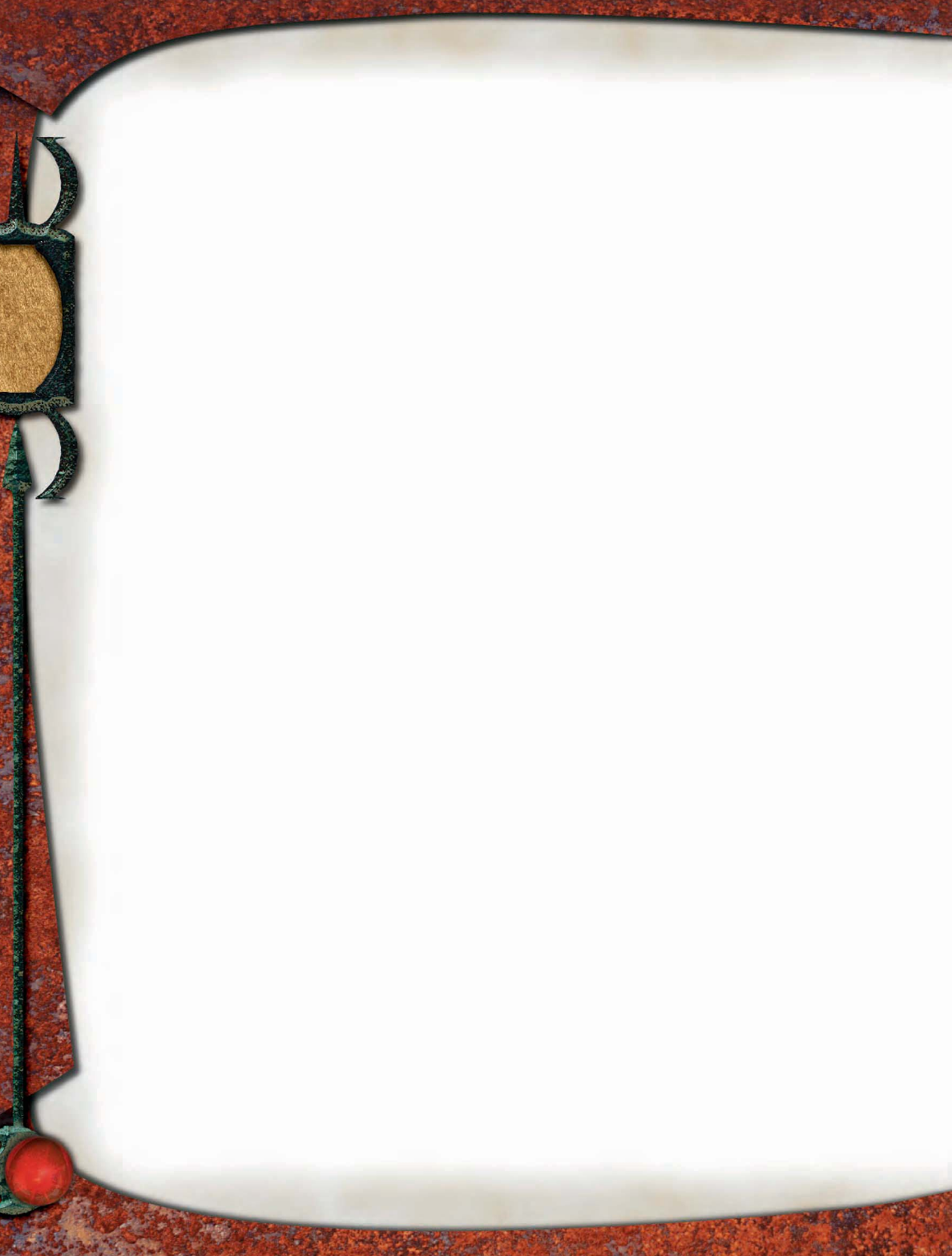
140
or red eyes. The larger and stronger tormentors can grow
to 8 feet long and weigh upward of 400 pounds. They have
matted red fur and black eyes.
Harridans dwarf all other members of the colony. These
creatures can grow to 30 feet in length and sixteen tons
in weight. Though they bear a passing resemblance to
enormous bloated rats, their bodies bristle with clumps
of filth-encrusted black fur. Great swaths of their skin
are bare, pocked with scabrous tumors and old rupture
scars. A harridan’s head is more mouth than anything
else. Rylkar tormentors tear a harridan’s eyes out as soon
as she is discovered among a swarm, possibly in the hope
of preventing her from feasting on her own kind. If so,
this scheme seldom works.
Alignment: Although a rylkar colony can have the appear-
ance of a regimented society, rylkars are self-serving in the
extreme. A colony’s dedication to its harridan is absolute, but
madclaws and tormentors are intelligent enough to defend
themselves from the appetite of the harridan and her vora-
cious swarms. Without exception, rylkars are neutral evil.
SOCIETY
Rylkars are vicious and rapacious. Thoroughly malevolent,
they are concerned only with the rampant destruction
through which they feed their endless hunger. Rylkar
colonies avoid quick collapse into chaos only by the rigidly
defi ned roles of their hierarchy. Under a social structure
similar to that of ants or bees, members of the colony are
assigned particular functions based on their capabilities.
At the bottom of the hierarchy are the mewling rylkspawn,
which live only to eat and grow. They cannot reproduce and
have little individual will.
Above the rylkspawn swarms stand the madclaws that
serve as the harridan’s consorts. Savage and self-centered,
they have an infl ated sense of their own purpose, seeing their
relationship to the harridan as a sign of power. This belief
doesn’t end even when the harridan snatches up a madclaw
and stuffs it into her cavernous maw.
Tormentors are the warriors of a colony, charged with
protecting the harridan and her breeding chamber. This
responsibility makes them arrogant, and they believe they
have the right of life and death over any other colony member.
Gluttony and hubris inspire tormentors to devour squirming
rylkspawn and madclaws alike, though they prefer to kill and
eat other creatures.
At the head of the infestation is the grotesque harridan
herself. This queen of the colony is a blind, vile behemoth
whose life is spent eating and breeding. The pampering she
receives from her madclaw drones inflates her cruel and
selfish nature—harridans are famed for their fickleness
and wickedness.
SAMPLE LAIR: RYLKAR WARRENS
The sewers of a small city have recently been overrun by
an infestation of rylkars. Though the citizens of the town
are not yet aware of the danger, signs of the infestation are
growing. People have begun to fall ill, pets and children
have gone missing, and an especially foul stench rises from
the sewers.
The network of sewers beneath the town consists of 10-foot
wide channels, each running parallel to a major thoroughfare
above. Branching off from these main routes are secondary
sewers that are 5 feet wide. These drain debris, rubbish, and
effluvia out to a nearby river as it flows south. The walls
throughout are masonry over excavated earth, and they
feature no ledges. Characters navigating these passages must
do so in the polluted water of the sewers.
The entire area depicted on the map has been fouled by
the harridan’s contaminate ability.
1. Sewers (EL 4): The area depicted is a single stretch of
sewer located anywhere in the city. The water is slow-moving,
too shallow to swim but too deep to walk through unimpeded.
Each square of the sewer costs 2 squares to enter. Due to the
sounds of dripping and running water, characters take a –2
penalty on Listen checks when in these sewer tunnels.
This area is home to two rat swarms that have managed
to elude the ravenous rylkars. The swarms are drawn to the
sound of movement.
2 Rat Swarms: hp 13 each; MM 239.
2. Entrance (EL 6): At the entrance to the rylkar
warren, chunks of slimy masonry emerge like rotten
teeth from the sluggish flow of the sewer water. Perched
on one rock is a common brown rat that scampers off if
anyone approaches.
Guarding this area is a single tormentor. It is focused on
eating a sheepdog, so it takes a –4 penalty on Listen checks
to notice the PCs’ approach. If it hears the PCs, the tormentor
presses against the wall, leaping out to attack any creature
that comes within 5 feet.
3. Hall of Bones (EL 6): This large chamber has been
excavated by swarming rylkspawn. The stench here is over-
whelming, and the fl oor is littered with chewed bones and
rotting offal. Footing in this area is bad—the DC of Balance
and Tumble checks increases by 2.
Hiding in the muck are two rylkspawn swarms. When
any character moves into the room, the swarms attack.
4. Madclaw Nest (EL 7): This chamber is foul with excre-
ment and slime. The colony’s madclaws lair here, and four are
here at any one time. They attack any nonrylkar that enters
this area.
5. Harridan Horror (EL 10): The colony’s harridan
languishes here in her own fi lth. Protecting her are two
tormentors that attack anyone who threatens their queen.
This room also holds the colony’s treasure.
6. Rylkspawn Swarm Nests (EL 6): The odor of this room
is particularly repulsive. Cast-off bits of cloth and rubbish
litter the floor, serving as a nest. Two rylkspawn swarms
are here.
7. Tunnels (EL 5): Two groups of two rylkar madclaws
work at excavating these tunnels so the colony can grow.
Insert a single encounter with two madclaws at a couple of
points during the PCs’ exploration.
RYLKAR
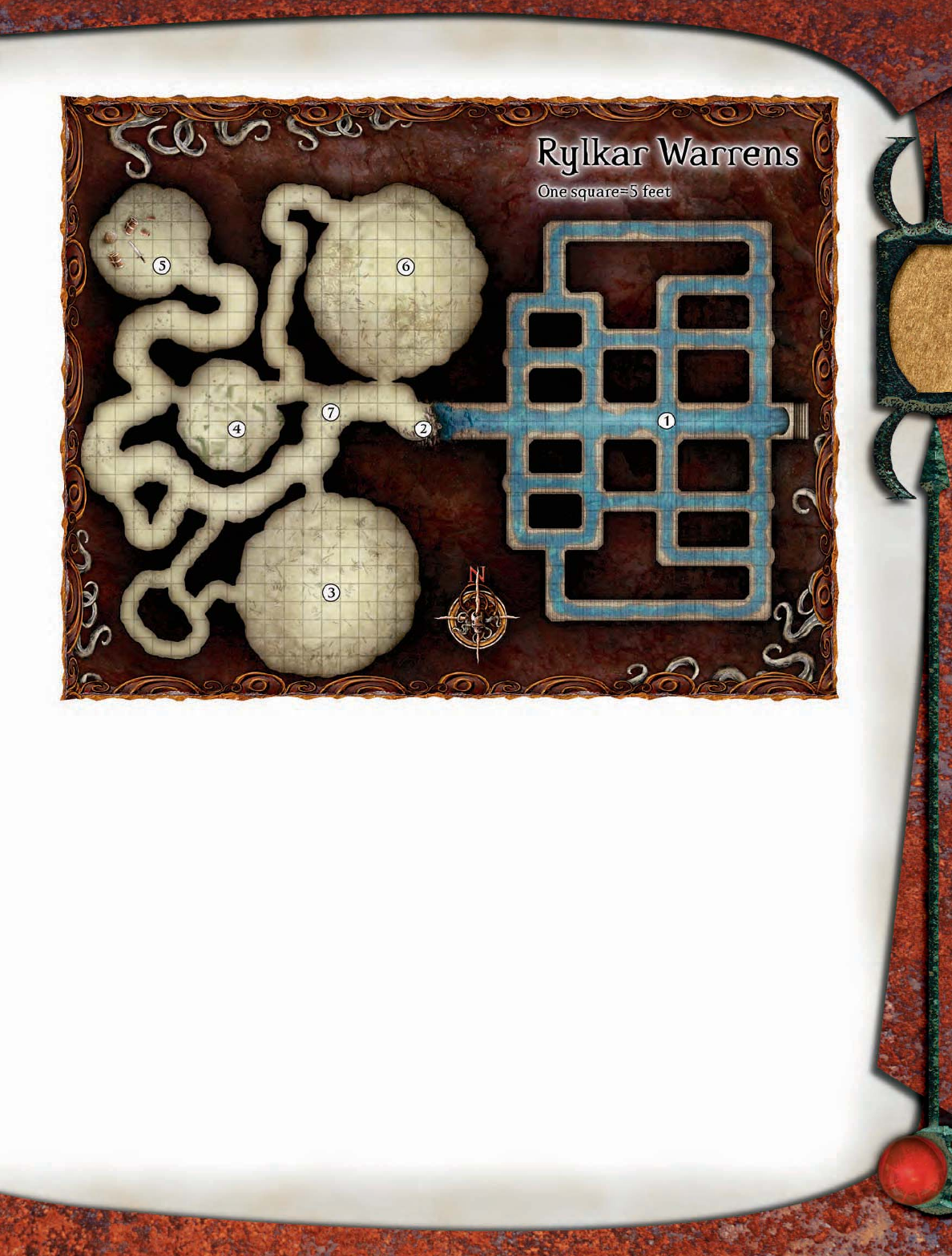
141
TYPICAL TREASURE
Though rylkars have little use for treasure, they collect what
they obtain from their victims. Rylkars are particularly
attracted to shiny objects, and their hoards contain coins,
gems, metalwork, and magic items. Tormentors, madclaws,
and rylkspawn have no treasure, since all rylkars give
valuables they fi nd to the harridan. Her lair contains triple
standard treasure for her Challenge Rating.
RYLKARS IN EBERRON
Supposedly created by and enslaved to the goblinoids of
the Dhakaani Empire, rylkars lived and died at the whim of
their cruel masters. Hobgoblin lords pitted rylkar warriors
against one another in spectacular blood matches. Those that
did not fi ght for the entertainment of their masters slaved
away in the mines.
Goblinoid legends tell of a bloody rylkar uprising that
raged for years during the war against the daelkyr. Battles
were costly, but in the end, the rylkars won their freedom.
They fl ed into the depths of Khyber.
Today, these ancient accounts are seldom given credence,
but reports have described deadly encounters with colonies of
ratlike creatures deep beneath the earth. Adding credibility to
these tales, goblinoid priests in Darguun have recently begun
to make blood sacrifi ces, reportedly for protection against a
foul presence growing in the darkness beneath the earth.
RYLKARS IN FAERÛN
The upheaval that was the result of Lolth’s silence rippled
outward from the drow cities, with the violence that spilled
from these enclaves plunging other cultures into chaos.
Countless creatures fl ed the rebellion, descending deeper
into the earth or drifting upward in the hope of escaping the
attention of the followers of the dread Revenancer.
Among these displaced creatures were the rylkars. Previ-
ously unknown to any but the most well-traveled Underdark
explorers, these monstrosities exploded from the subterra-
nean depths to fi nd new homes in the sewers below surface
cities. Sightings of new infestations have been reported from
Waterdeep to Cormyr, and across the land, adventurers have
rallied to fi ght this new threat.
Though colonies are destroyed as quickly as they establish
themselves, the rylkars have shown great adaptability and
cunning. Whether pushing into the wilderness or creating
lairs that can be actively defended within ancient ruins, this
scourge continues to spread.
RYLKAR

142
SANGUINEOUS DRINKER
This gore-spattered skeletal fi gure moves with great speed. Blood-
soaked organs glisten and swing within its rib cage like water skins.
Its arms end in jagged, bloody claws.
Sanguineous Drinker CR 5
Always CE Medium undead
Init +6; Senses darkvision 60 ft.; Listen +8, Spot +10
Languages one language spoken in life or by creator
AC 16, touch 12, flat-footed 14
(+2 Dex, +4 natural)
hp 75 (10 HD)
Immune undead immunities
Fort +3, Ref +7, Will +7
Speed 40 ft. (8 squares)
Melee 2 claws +8 each (1d4+3 plus blood drain)
Space 5 ft.; Reach 5 ft.
Base Atk +5; Grp +8
Atk Options Combat Reflexes
Special Actions blood spray
Abilities Str 16, Dex 15, Con —, Int 7, Wis 10, Cha 14
SA blood drain, blood spray
SQ undead traits
Feats Combat Reflexes, Improved Initiative, Improved
Toughness, Lightning Reflexes
Skills Balance +10, Listen +8, Spot +10
Advancement 11–20 HD (Large); 21–30 HD (Huge)
Blood Drain (Su) A sanguineous drinker’s claws are hollow,
enabling it to drain blood from a living victim. Living
creatures damaged by a claw attack also take 1 point of
Constitution damage. Each time a sanguineous drinker
deals 1 point of Constitution damage, it heals 5 points of
damage as its organs swell with blood.
Blood Spray (Su) As a swift action, a sanguineous drinker
can deal itself 5 points of damage to spray blood from
the organs in its torso. This has the same effect as the
area version of the grease spell (Reflex DC 17), but the
area is centered on the sanguineous drinker. The slippery
conditions created by the spray persist for 1 minute. The
save DC is Charisma-based.
Sanguineous drinkers never need to make Reflex
saves against blood spray, but they do need to make
Balance checks to move.
Blood spray does not stack with the effect of a grease
spell or similar effects. The effect that has the highest
Reflex save DC takes precedence.
Sanguineous drinkers are skeletal undead intent on draining
the blood of any creature they encounter.
STRATEGIES AND TACTICS
A sanguineous drinker quickly closes to melee with its
opponents, getting in among them if possible. Once
in position, a sanguineous drinker uses blood spray to
affect the surrounding area. Subsequently, it uses Combat
Ref lexes to attack any opponent standing up from prone.
Whenever possible it uses a full attack, concentrating on
a single foe.
SAMPLE ENCOUNTERS
The abodes of sanguineous drinkers contain blood and
corpses, making them attractive to vermin. Those who hunt
these undead often encounter swarms of insects before bat-
tling the sanguineous drinker itself. A sanguineous drinker
attacks any living creatures entering its domain, stopping
only when it or the invaders are dead.
Occasionally, small packs of three to nine individuals form
in areas of intense death and suffering.
Sanguineous drinkers often fight alongside other
intelligent undead—particularly vampires—that value
their ferocity and lust for blood. Necromancers and cun-
ning undead spellcasters create sanguineous drinkers to
serve as guards, sometimes placing them among weaker
undead to reduce the efficacy of an enemy cleric’s turn
undead ability.
A Deadly Plunge (EL 6): A single sanguineous drinker
lurks in a grotto 40 feet up the wall of a natural cavern.
The grotto is accessible along a narrow ledge. Using its
blood spray and full attacks to knock opponents to the
floor of the greater cavern, the sanguineous drinker
attacks anyone it spots moving along the ledge. Even if
it doesn’t sense intruders soon enough to attack those
on the ledge, the sanguineous drinker can rely on the
centipedes in its lair to swarm and attack approaching
living creatures.
Blood Pack (EL 9): A vampire fi ghter (MM 251) stalks
the darkened streets on the bad side of town, accompanied
by two sanguineous drinkers. The vampire fl ies ahead of
his companions in bat form, and once he spots explorers,
he summons bat swarms to conceal the approach of the
sanguineous drinkers. When the sanguineous drinkers
attack, the vampire reverts to his normal shape and slams an
obvious servant of a good deity, using energy drain against
pqqqqqqqqqrs
SANGUINEOUS DRINKER LORE
Characters who have ranks in Knowledge (religion) can learn
more about sanguineous drinkers. When a character makes a
successful skill check, the following lore is revealed, including
the information from lower DCs.
Knowledge (Religion)
DC Result
15 This creature is a sanguineous drinker, a type of
skeletal undead commonly used by intelligent
undead and necromancers as soldiers. They have
quick refl exes and prefer to concentrate their
attacks on a single foe.
20 Sanguineous drinkers use their hollow claws to
drain the blood of living creatures.
25 These creatures can store the blood in their
wasted organs, later using it to spray the fl oor
with a bloody slick that can cause falls and impair
movement.
pqqqqqqqqqrs
SANGUINEOUS
DRINKER
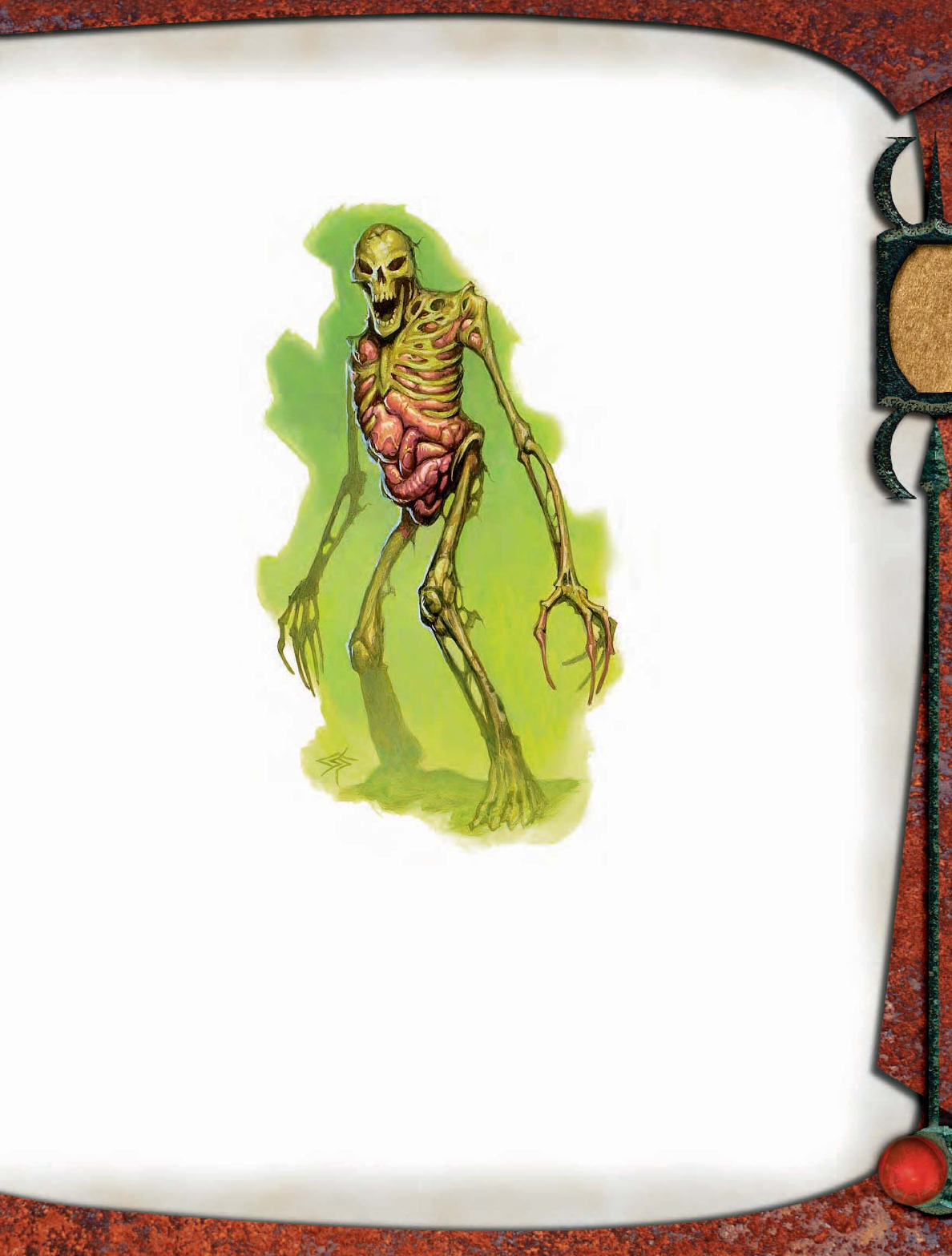
143
that foe. The sanguineous drinkers fl ank another foe, using
blood spray only to prevent their prey from retreating.
ECOLOGY
Sanguineous drinkers are not natural creatures. Necro-
mancers create them from corpses
boiled in blood. Particularly evil
and bloodthirsty creatures might
spontaneously rise as sanguineous
drinkers if they die in an environ-
ment soiled with blood and corrupted
by negative energy.
Environment: Sanguin-
eous drinkers lurk on
battlefi elds or in places used
for ritual sacrifice. They
haunt unholy locales, thirst-
ing for blood. Although
sunlight does not harm san-
guineous drinkers, they avoid
its brilliance, preferring to lurk
inside or underground. Some
prowl fetid caverns heavy with
the stench of death, while
others inhabit abandoned
and isolated ruins that
have a history of bloody
slaughter.
Their lairs take several
forms but typically have at
least two entrances, which
sanguineous drinkers don’t
bother to hide. Blood cakes the
area around such access points,
and the interior is stacked with
eviscerated and bloodless corpses
that frequently attract large num-
bers of vermin. The sanguineous
drinkers coat the walls, fl oors, and even
the ceilings of their lairs in blood. When
their bloodlust overcomes them and no al-
ternative source of blood is available, they
consume these deposits.
Typical Physical Characteristics: Sanguineous drinkers
are humanoid in form and usually human-sized. Larger speci-
mens exist, created from the remains of a larger creature.
A typical sanguineous drinker resembles a partially
decomposed and skeletal member of its original race, except
that it has clawed hands and feet. It drains blood through
those hollow claws, storing the fl uid in its shriveled organs. A
fi brous mass of connective tissue connects the organs to the
sanguineous drinker’s ribs. Despite leaking from thousands
of tiny perforations, the organs swell as more blood is pumped
into them.
Alignment: Sanguineous drinkers are corrupt and
depraved killers with an inborn hatred for living creatures
and a supernatural lust for blood. They lack compassion, and
they enjoy toying with their victims, infl icting as much tor-
ment as possible. These creatures are always chaotic evil.
SOCIETY
Uncontrolled sanguineous drinkers claim a small area in
which to hunt. They thirst for blood from the living,
and this need drives them above all else. Sanguineous
drinkers know nothing of mercy or fear. They fi ght
to the death.
Sanguineous drinkers don’t fi ght among
themselves, even over territory, seeing no gain
in such clashes. Instead, they either form packs
to gain more blood or disperse to ensure good
hunting for all. When a pack forms, the old-
est or most powerful sanguineous drinker
rules the group, using its underlings as
pawns to entrap or lure living creatures.
Sanguineous drinkers speak one
language, which is normally Com-
mon. A sanguineous drinker’s
creator can specify a different lan-
guage when creating the creature,
but he must speak that language.
Although sanguineous drink-
ers can speak, they rarely do
so—and they never negotiate
with their prey—but in com-
bat, they howl with excitement.
Communication among a pack
of such creatures is limited to the
expression of commands and the re-
ports of subordinates.
TYPICAL TREASURE
In addition to their insatiable lust for
blood, sanguineous drinkers have an
obsessive desire to collect implements
used in committing violence. In particu-
lar, sanguineous drinkers gather weapons and
armor, especially those items still gory from the battlefi eld.
Their lairs are crammed with armaments of all descriptions,
most of which are rusted and useless. Masterwork weapons
and armor, as well as the occasional magic item, are mixed
in among this trash.
A sanguineous drinker has standard treasure for its
Challenge Rating. The bulk of this treasure is in the form
of valuable weapons or similar items.
FOR PLAYER CHARACTERS
A spellcaster of 15th level or higher can use the create undead
spell to animate a sanguineous drinker.
Sanguineous drinker
SANGUINEOUS
DRINKER
Illus. by S. Prescott
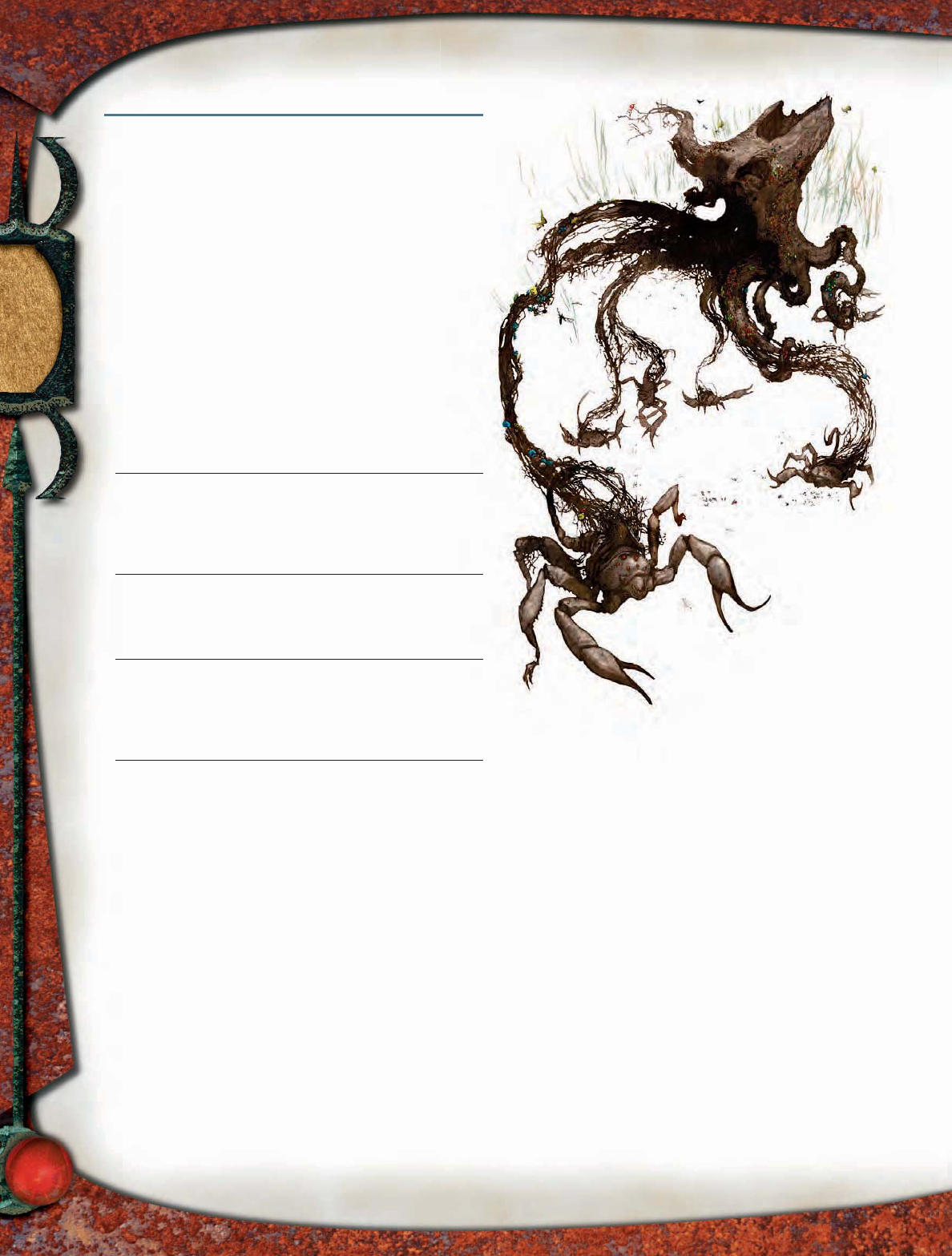
144
SCOURING CONSTRUCT
Scouring constructs are the creations of druids bent on
defending the natural world from the predations of civi-
lization at any cost. Built to stand against the strongest
foes, scouring constructs are the products of secret rituals
and powerful magic. Working in concert and under the
control of the druids who create them, they are all but
unstoppable.
SCOURING SLINGER
This massive tangle of branches and roots is surrounded by a
swarming mass of insects. It rises up and extrudes six arms from
its central mass, each holding what appears to be a construct
scorpion some 4 feet long.
Scouring Slinger CR 18
Always N Huge construct
Init +4; Senses darkvision 60 ft., low-light vision; Listen –3,
Spot –3
Languages understands controller’s orders
AC 35, touch 12, flat-footed 31
(–2 size, +4 Dex, +23 natural)
hp 271 (42 HD); collective health
Immune construct immunities
SR 27
Fort +14, Ref +18, Will +11
Speed 30 ft. (6 squares)
Melee slam +37 (1d8+12)
Space 15 ft.; Reach 10 ft.
Base Atk +31; Grp +47
Special Actions scorpion throw
Abilities Str 26, Dex 18, Con —, Int —, Wis 4, Cha 4
SA scorpion throw
SQ construct traits
Feats —
Skills Listen –3, Spot –3
Advancement 43–60 HD (Huge); 61–84 HD (Gargantuan)
Collective Health (Su) A scouring slinger within 100 feet of
another scouring slinger or a scouring stanchion shares
a single pool of hit points. This pool is the sum of the hit
points from all creatures that have the collective health
ability and are within 100 feet of each other. Subtract
any damage taken by one creature from the overall pool.
No creature that has collective health is destroyed until
the pool reaches 0 hit points, at which time all creatures
sharing the pool are destroyed simultaneously.
If a scouring
slinger is
separated
from others
in its hit
point pool,
divide the damage
taken proportionally among the
creatures within the pool. For
example, if a collective of five
stanchions and slingers has lost
100 hit points, each creature that separates from the pool
has taken 20 points of damage.
Scorpion Throw (Ex) As a standard action, a scouring slinger
can throw six of the slinger scorpions that are grown from
its body. Treat this as a ranged touch attack with a range
of 250 feet. On a successful attack, the slinger scorpions
take up positions in squares surrounding and adjacent to
the target, avoiding squares that are already occupied. If
the attack misses, the slinger scorpions take up positions
around a square 2d4 squares away from the target in a
random direction.
pqqqqqqqqqqqqqqqqqqqqrs
SCOURING INSECTS
The collective health ability of a group of scouring constructs
is manifested in the large insects constantly swarming around
these creatures. These insects are a part of a scouring con-
struct’s being, and they are laced with the supernatural essence
of its collective health ability.
Individual insects are fragile, and any melee attack directed
against the swarm automatically kills 2d8 of these Diminutive
creatures. Spells such as fireball can destroy all the insects in a
wide area. However, a scouring construct can create as many
replacement insects as it needs as an immediate action. The
insects ignore other creatures, and characters fighting within
the cloud suffer no adverse effect.
A character who succeeds on a DC 15 Spot check notices that
a cloud of insects never swarms more than 50 feet from a lone
construct. This knowledge might inspire PCs to try to force
constructs to move more than 100 feet apart, negating their
collective health ability.
pqqqqqqqqqqqqqqqqqqqqrs
Scouring slinger
SCOURING
CONSTRUCT
Illus. by A. Waters

145
Slinger scorpions cannot attack in the round in
which they are launched, but they are not flat-footed.
The scorpion throw itself deals no damage to the
target creature.
Once its first set of slinger scorpions is deployed,
a scouring slinger can create up to six more as a move
action. However, the slinger takes 10 points of damage for
each scorpion it creates. If it is within 100 feet of another
scouring slinger or scouring stanchion, this damage is
taken from the collective health pool as normal.
Slinger Scorpion
This scorpionlike construct has four legs and a longer arm tipped
with a blade. Its head hangs slightly below and in front of its body,
featureless except for fi ve eyes set in a circular pattern.
Slinger Scorpion CR —
Always N Small construct
Init +4; Senses darkvision 60 ft., low-light vision; Listen –4,
Spot –4
Languages —
AC 30, touch 15, flat-footed 26
(+1 size, +4 Dex, +15 natural)
hp 5 (1 HD)
Immune construct immunities
Fort +14, Ref +18, Will +10
Speed 20 ft. (4 squares)
Melee claw blade +32 (2d8)
Space 5 ft.; Reach 5 ft.
Base Atk +31; Grp –4
Abilities Str 10, Dex 18, Con —, Int —, Wis 3, Cha 4
Feats —
Skills Hide +8, Listen –4, Spot –4
Advancement —
Slinger scorpions are grown from the body of a scouring
slinger and launched as part of its special scorpion throw
attack. They use the scouring slinger’s Hit Dice to determine
their base attack bonus and saving throws.
Independent slinger scorpions fall to pieces after 24
hours or when the scouring slinger that created them is
destroyed. They are not independent monsters and have
no Challenge Rating; they are part of an encounter with
a scouring slinger.
Strategies and Tactics
If an opponent comes within melee range, a scouring
slinger uses its slam attack. Otherwise, scouring slingers
attack primarily with their scorpion throw, harrying foes
at a distance. Against large numbers of opponents, scouring
slingers target characters on the fringe of the group, allowing
their slinger scorpions to focus on individual targets without
being fl anked themselves. Against smaller groups, scouring
slingers launch their slinger scorpions to surround as many
foes as possible.
Spells that deal damage even on a successful save are the
best means of destroying slinger scorpions. As such, a scour-
ing slinger targets characters lacking armor fi rst, hoping to
take out enemy mages. If a particular opponent demonstrates
an ability to destroy slinger scorpions easily, the scouring
slinger does not target that foe with subsequent scorpion
throw attacks. Similarly, any opponent who consistently
avoids the slinger scorpions’ attacks is eventually ignored in
favor of other targets.
These default strategies can be altered if an intelligent
creature is directing the scouring slinger’s attacks. Slinger
scorpions are effective at slowing adversaries down and
restricting their movement. As such, intelligent control-
lers order them to ignore characters with low mobility
and few attacks.
Though slinger scorpions can move to fl ank opponents,
they employ little strategy beyond attacking foes as directed.
Even if an intelligent creature controls the scouring slinger,
the slinger scorpions’ tactics cannot be improved.
SCOURING STANCHION
An immense trunk of gnarled wood towers above you, a host of shin-
ing insects swarming across its body. As the tower lumbers toward
you, arcs of multicolored energy fl ash between the tiny creatures
teeming on and around it.
Scouring Stanchion CR 18
Always N Huge construct
Init +0; Senses darkvision 60 ft., low-light vision; Listen +0,
Spot +0
Languages understands controller’s orders
AC 38, touch 28, flat-footed 38
(–2 size, +20 deflection, +10 natural)
hp 325 (30 HD); collective health
Immune construct immunities
SR 27
Fort +16, Ref +16, Will +16
Speed 30 ft. (6 squares); unstoppable movement
Melee 2 slams +32 each (2d6+12 plus 2d6 nonlethal)
Space 15 ft.; Reach 15 ft.
Base Atk +22; Grp +42
Atk Options Awesome Blow
Abilities Str 34, Dex 10, Con —, Int —, Wis 10, Cha 19
SA unstoppable movement
SQ construct traits, structural integrity
Feats Awesome BlowB
Skills Listen +0, Spot +0
Advancement 31–40 HD (Huge); 41–60 HD (Gargantuan)
Collective Health (Su) As the scouring slinger.
Saving Throws (Ex) Scouring stanchions have a +6 racial
bonus on saving throws (included in the creature’s
statistics).
Unstoppable Movement (Ex) Scouring stanchions can
attempt to overrun as a free action when moving. They
have a +4 racial bonus on Strength checks made to
overrun, so a typical scouring stanchion has a +24 bonus
on the opposed Strength check. Targets cannot choose to
avoid a scouring stanchion’s overrun attempt.
Structural Integrity (Ex) The supernatural energy binding a
scouring stanchion’s body together makes it tougher than
it would normally be. It adds its Charisma modifier as
bonus hit points to each Hit Die.
SCOURING
CONSTRUCT
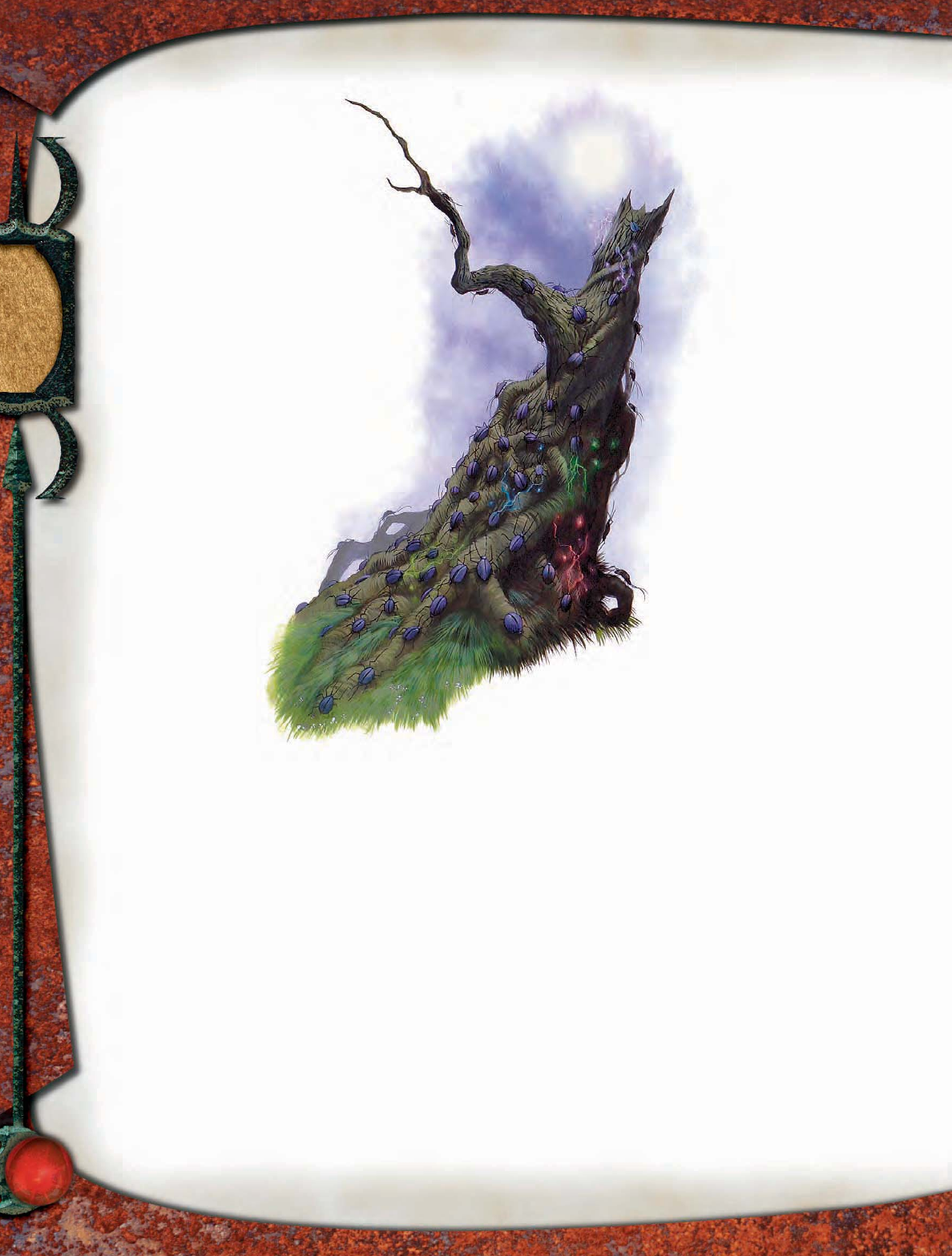
146
Strategies and Tactics
Although scouring stanchions are
mindless, they are programmed with
advanced combat strategies. An intelli-
gent controller can direct a scouring
stanchion even more effectively.
A scouring stanchion with designated
enemies moves toward them but stops 10 feet
away from the nearest foe. This forces oppo-
nents to move through the area the scouring
stanchion threatens, provoking an attack of
opportunity even as the scouring stanchion’s
reach allows it to attack. A scouring stanchion
uses Awesome Blow to knock opponents away
from it. Those opponents must then move back
into range (likely provoking attacks of oppor-
tunity) to attack again.
A scouring stanchion directs all its attacks
against a single target until that target drops.
The construct can also be directed to clear a
path between its location and a certain
point. If so ordered, it moves for-
ward in a straight line, using its
unstoppable movement and
melee attacks to clear oppo-
nents out of the way.
Though weak oppo-
nents can be slain by
a single slam attack,
a scouring stan-
chion often leaves
stronger opponents
alive. Its program-
ming forces it to stop
attacking when a tar-
get falls unconscious from nonlethal damage, though an
intelligent controller can order the construct to finish off
fallen foes.
SAMPLE ENCOUNTERS
Scouring slingers and scouring stanchions usually have an
intelligent controller guiding them. This controller (usu-
ally the druid who created the construct or a creature in
that druid’s service) stays hidden, deploying the powerful
constructs to keep combatants well away from him. A single
controller can direct the actions of up to three scouring
constructs as a full-round action, directing a single scouring
construct as a standard action.
Scouring stanchions are sometimes set as guards for po-
tent magical locations in the wilderness, but they are more
commonly used as the vanguard of druid-led armies. Scour-
ing stanchions are strong enough to break down wooden
palisades and stone walls, and they can clear a path through
nearly any opposing force.
Because scouring stanchions
and scouring slingers are con-
structed through similar
processes, they are often
created at the same time.
Their combat styles com-
plement each other, with a
scouring stanchion taking
on massed melee forces
while scouring slingers
use their scorpion throw
against targets outside the
main group.
Both kinds of con-
structs obey their creator
and any other intelligent crea-
ture their creator orders them
to obey. The constructs’ creator
can regain sole control as a free
action. Scouring stanchions and
scouring slingers understand any
commands spoken by their control-
lers, but they do not respond to any
other creatures.
Sentinel (EL 18): A lone scour-
ing slinger guards an approach to a
druid’s tree house abode. The dru-
id’s assistant is also present, but PCs
who time their attack carefully can
catch him by surprise. If they do so,
the assistant is prevented from control-
ling the scouring slinger for the fi rst round
of combat.
Sentry (EL 18): A single scouring
stanchion and a controller have instructions to stop anyone
trying to pass through a sacred grove. If all intruders are
rendered unconscious, the construct’s controller takes them
prisoner.
Artillery Unit (EL 21): Three scouring slingers and
a single controller work together as an assault force. The
constructs throw slinger scorpions to pin opponents down,
then wade in with their slam attacks.
Strike Team (EL 21): A scouring slinger provides artil-
lery support to two scouring stanchions, with the whole
group directed by a druid serving the powerful druid who
created the constructs. The controller stays well away from
combat, but if he is taken out, the constructs lose the ability
to coordinate their assault.
ECOLOGY
As constructs, scouring slingers and scouring stanchions
have no place in the natural world. A scouring slinger
given defensive orders and a generous definition of
“enemy” can lay waste to a substantial number of creatures,
Scouring
stanchion
SCOURING
CONSTRUCT
Illus. by W. England
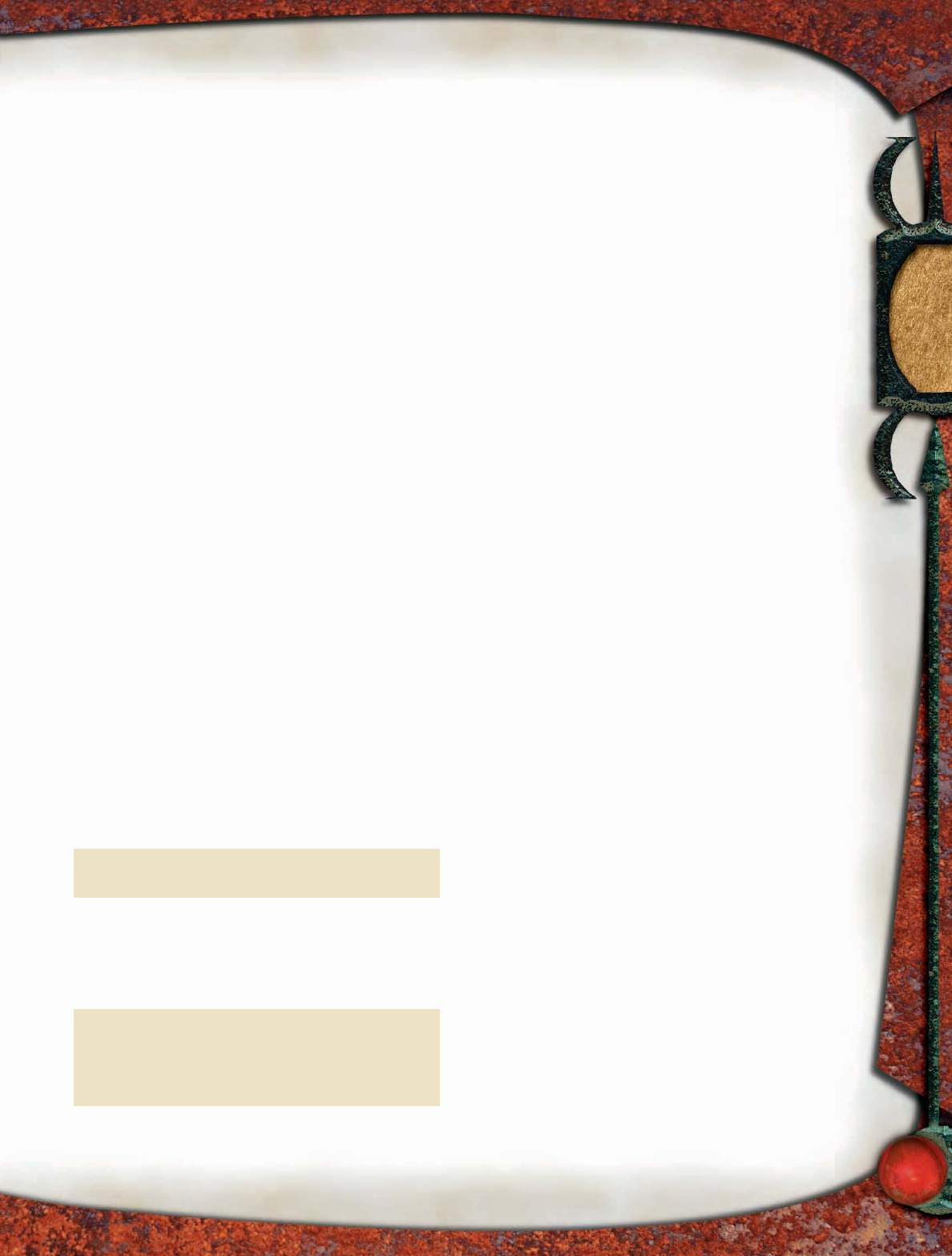
147
but these constructs are passive until used in battle.
Likewise, a scouring stanchion directed to destroy (or
simply given badly worded orders) can devastate a wide
swath of territory.
Environment: Scouring slingers and scouring stan-
chions can survive in almost any environment, and they
are found wherever their creators order them. Both kinds
of constructs operate best in a wide area, however, and
are only rarely found in the confined spaces of castles,
fortresses, and cities. Scouring slingers are not commonly
used underground, since their scorpion throw becomes
limited by the 60-foot range of their darkvision. Scouring
stanchions can be found underground, and they function
perfectly well underwater.
Typical Physical Characteristics: Scouring slingers
resemble the shambling mounds from which they are
created, but they are larger and composed of desiccated
vegetation. Essentially amorphous, a scouring slinger can
grow limbs as it needs them, then reabsorb them into its
body. These creatures are vaguely bipedal, standing 20
feet tall and weighing twelve tons.
Scouring stanchions resemble nothing so much as a mas-
sive, gnarled tree trunk. They stand 25 feet tall and weigh
fi fteen tons.
The insects that swarm on and around a scouring construct
are oversized, clearly supernatural, and in constant motion.
Their movement is marked by faint arcs of multicolored
energy that jump from bug to bug.
Alignment: As mindless automatons, scouring slingers
and scouring stanchions are always neutral.
TYPICAL TREASURE
Scouring constructs have no interest in treasure. Their con-
trollers carry standard treasure for their Challenge Rating,
usually in the form of weapons and magic items.
FOR PLAYER CHARACTERS
High-level druids, employing closely guarded magic rituals,
create scouring slingers and scouring stanchions. A scouring
slinger grows slinger scorpions, and these smaller constructs
cannot be created independently.
Scouring Slinger Construction: The secret druidic ritual
for creating a scouring slinger involves the initial creation
of three shambling mounds that are incorporated into the
creature’s construction.
CL 18th; Craft Construct, creeping doom, shambler; Price
117,000 gp; Cost 58,500 gp + 3,000 XP.
Scouring Stanchion Construction: The secret druidic
ritual for creating a scouring stanchion requires the partici-
pation of a treant willing to sacrifi ce its life to become the
construct. A druid must make a DC 25 Craft (woodcarving)
check after one day of working to inscribe special runes in
the treant’s trunk.
CL 18th; Craft Construct, creeping doom, animate plants;
Price 105,000 gp; Cost 52,500 gp + 3,000 XP.
Variants: Larger scouring slingers and scouring stanchions
can be constructed. Each additional Hit Die adds 500 gp to
the cost. Repairing a scouring construct follows the normal
rules for repairing constructs (see the Craft Construct feat,
MM 303).
SCOURING CONSTRUCTS
IN EBERRON
In Khorvaire, scouring constructs are a creation of the Ash-
bound, and the druids of this militant sect are the only ones
who know the secret of such magical construction. On the
fringes of the Towering Wood, whole settlements have been
wiped from the map. Terrifi ed survivors speak of rapacious
plant creatures and scorpionlike terrors with a thirst for
blood. The folk of neighboring settlements are fl eeing the
Reaches in droves, but what the Ashbound’s ultimate goals
are, none can say.
SCOURING CONSTRUCTS
IN FAERÛN
Scouring constructs are a part of the legendary history of
Faerûn, spoken of in tales dating back to the last Crown
Wars. The secret of the creation of these constructs (if indeed
they were ever anything more than legend) has been lost for
millennia. Recently, however, tales of dark rites twisting the
forces of nature have emerged from the Chondalwood and
the Forest of Lethyr. Explorers and settlers pushing deep into
those realms have returned with harrowing tales of attacks
by invulnerable plant creatures.
pqqqqqqqqqrs
SCOURING CONSTRUCT LORE
Characters who have ranks in Knowledge (arcana) or Knowl-
edge (nature) can learn more about scouring constructs.
When a character makes a successful skill check, the following
lore is revealed, including the information from lower DCs.
Knowledge (Arcana) or Knowledge (Nature)
DC Result
28 This plantlike creature is a scouring construct, an
artifi cial being created by druid magic. Its body is
covered by a layer of swarming insects.
33 Two kinds of scouring constructs exist. Scouring
slingers are primarily ranged attackers, throwing
smaller construct creatures grown from their own
bodies. Scouring stanchions are powerful melee
combatants, and they can use their tremendous
strength to knock foes prone or smash defensive
structures.
38 Two or more scouring constructs within 100 feet of
each other are able to share any damage dealt to
them individually. Scouring constructs fi ghting in
concert must all be destroyed before any fall. The
swarming insects are the source of this collective
health.
pqqqqqqqqqrs
SCOURING
CONSTRUCT

148
SHAEDLING
A short, humanlike creature with raven skin and equally dark
eyes flutters on fine wings like those of a dragonfly. Its lower
abdomen is distended. Two spinnerets there exude wisps of
thick darkness as the creature zips by, leaving a trail of shadow
in its wake.
Shaedling CR 2
Always CE Medium fey
Init +4; Senses darkvision 60 ft., low-light vision; Listen +4,
Spot +4
Languages Common, Sylvan
AC 15, touch 14, flat-footed 11
(+4 Dex, +1 buckler)
hp 22 (4 HD); DR 5/cold iron
Fort +3, Ref +8, Will +5
Speed 30 ft. (6 squares), fly 60 ft. (good)
Melee spiked chain +6 (2d4)
Ranged bolas +6 (1d4 nonlethal) or
Ranged javelin +6 (1d6)
Space 5 ft.; Reach 5 ft. (10 ft. with spiked chain)
Base Atk +2; Grp +2
Atk Options Combat Reflexes, Point Blank Shot, shadow
gossamer, sleeping curse, wall of darkness
Abilities Str 10, Dex 18, Con 15, Int 13, Wis 13, Cha 16
SA shadow gossamer, sleeping curse, wall of darkness
Feats Combat Reflexes, Point Blank Shot, Weapon Finesse
Skills Appraise +1 (+3 weapons), Bluff +10, Craft
(weaponsmithing) +8, Diplomacy +5, Escape Artist +11
(+13 ropes), Hide +11, Intimidate +6, Listen +4, Move
Silently +11, Spot +4, Use Rope +11
Advancement by character class; Favored Class rogue
Possessions shadow gossamer buckler
Shadow Gossamer (Ex) As a swift action, a shaedling can
generate a 15-pound or lighter item out of shadow
gossamer, and it usually crafts a weapon just before
attacking. A shaedling is proficient with any weapon it
creates from shadow gossamer, and such weapons have
a range increment 10 feet longer than usual. Shields
constructed of this substance have their armor check
penalty lessened by 1. Shadow gossamer implements
dissipate to nothingness if they leave the hands of a
shaedling for longer than 1 round.
Sleeping Curse (Su) Once per day, a shaedling can target
an opponent within 30 feet with a special javelin of
venomous shadow gossamer. A foe struck by this javelin
must succeed on a DC 15 Fortitude save or fall asleep
for 1d6 rounds. A remove curse spell ends this effect. The
save DC is Charisma-based.
Wall of Darkness (Su) Once per day, a shaedling can
generate a wall of darkness up to 30 feet long. The wall
blocks line of sight for all creatures except those that have
darkvision.
Shaedlings are malignant fey that have turned their back on
nature in favor of the Spider Queen, Lolth.
STRATEGIES AND TACTICS
A shaedling attacks from above and at range, hovering and
throwing shadow gossamer weapons. It uses its sleeping
curse immediately to take out the creature among its foes
that seems the weakest. If it can, it uses a wall of darkness to
cordon the combat zone to its liking.
In a group, shaedlings use walls of darkness to divide
their foes and control the battlefield. They divide into two
attack formations. One formation flies high above, throw-
ing javelins, while the second group hovers 10 feet above
the enemy, attacking with spiked chains. The shaedlings
using chains try their best to harry foes that can attack
the throwers.
SAMPLE ENCOUNTERS
Shaedlings prefer the tactical superiority that numbers
provide. When caught alone, a shaedling has a particular task
or goal, which it completes, fl eeing afterward.
Dark Raider (EL 2): A shaedling that was left behind by
its kin when it overslept hurries to catch up. It hasn’t had a
good meal in 24 hours, so it raids the PCs’ camp to snatch a
backpack or sack and make off with some food. If it can kill
a mortal in the process, all the better.
Retrieval Crew (EL 9): A banshrae (page 10) with four
shaedlings in tow pursues the PCs. It seems their dark mis-
tress wants a treasure the characters acquired on their last
adventure, and she won’t take no for an answer. In fact, if the
banshrae has its way, she’ll get her treasure and the heads of
a few mortals to boot.
ECOLOGY
Shaedlings’ origins are linked to the same schism that drove
elves and drow apart. A small number of pixies followed the
drow in their reverence for Lolth, but they didn’t follow the
drow underground. The Queen of the Demonweb Pits blessed
these pixies to become a terror in the places other fey and
elves love best. She gave them their ability to weave shadow
as spiders weave webs.
pqqqqqqqqqrs
SHAEDLING LORE
Characters who have ranks in Knowledge (nature) can learn
more about shaedlings. When a character makes a successful
skill check, the following lore is revealed, including the infor-
mation from lower DCs.
Knowledge (Nature)
DC Result
12 This creature is a shaedling, a hateful fey with
command over shadow. This result reveals all fey
traits.
17 The spinnerets on a shaedling’s belly allow it
to form weapons and other implements from
shadowy strands. A shaedling can also weave a
wall of shadow to block sight.
22 Shaedlings can use a special javelin to put a
creature and, potentially, all who touch that
creature to sleep. Their tough skin is best cut by
cold iron.
pqqqqqqqqqrs
SHAEDLING
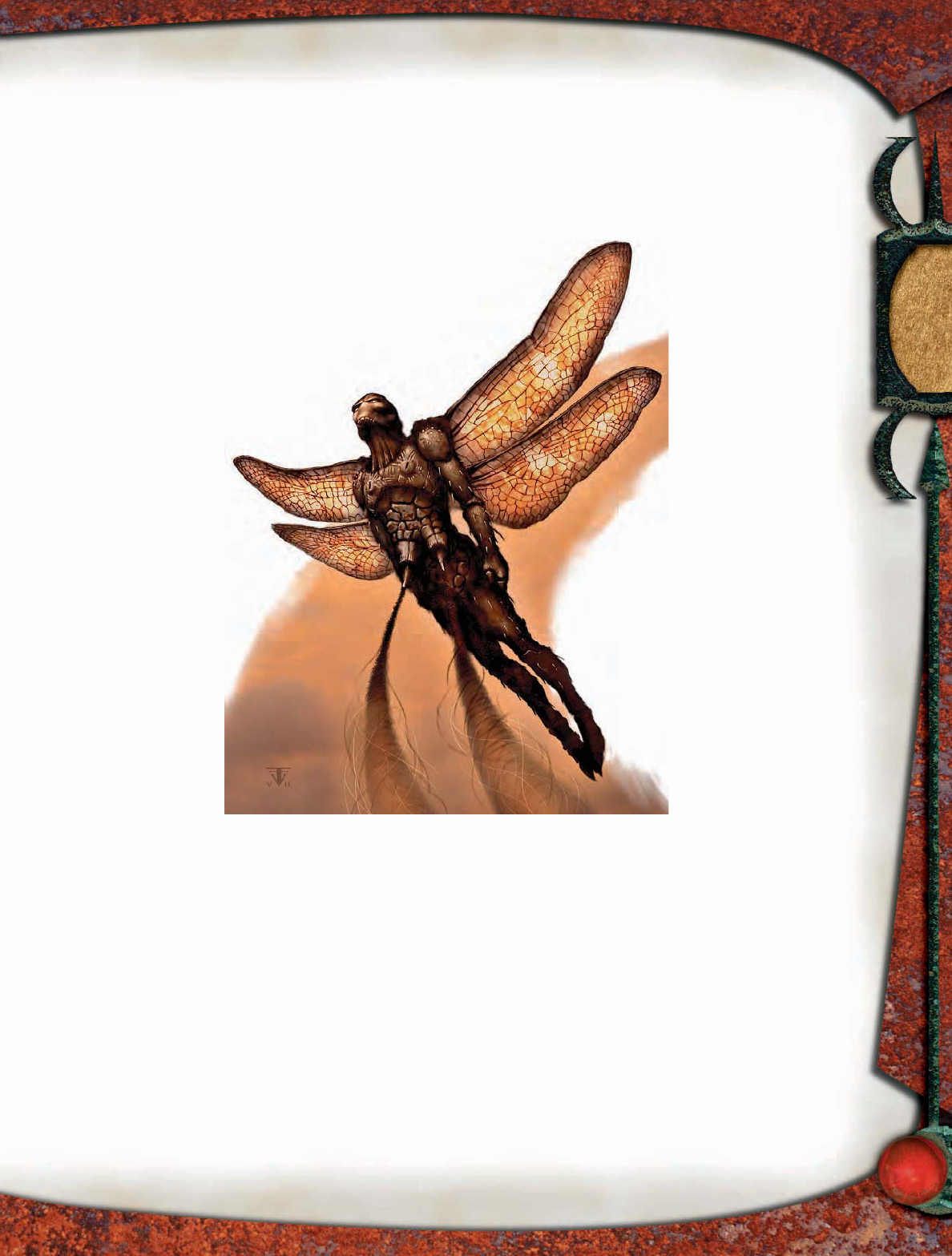
149
Like drow, shaedlings are a true race. Their transformation
made them bigger and stronger than normal pixies, and
largely incompatible with any other sprite. They can’t mate
with their good-aligned kin.
However, they do produce shaedling offspring, and pro-
lifi cally. Female and male shaedlings couple wantonly, and
the females lay eggs. These eggs hatch within a month, and
infant shaedlings are fully grown within a year. Newborn
shaedlings require little care, and that’s fortunate for them,
because they receive little. Some are born without any
guardian, and such siblings fi ght among themselves until a
pack of the toughest ones emerges alive from the fray with
a clear leader.
Shaedlings do suffer a side effect of their powers and spider-
like life cycle. Unlike other fey, shaedlings
have short lives. Few survive past twenty
years of age.
Environment: Shaedlings
prefer temperate for-
ests where other fey
and elves live.
Typical Physical
Characteristics: Shaed-
lings resemble drow elves of
short stature with solid black
eyes and dark dragonfl y wings.
They stand about 4 feet tall
and weigh no more than
80 pounds. Spinnerets
sprout from their stom-
achs, allowing them
to weave shadow
gossamer—a light,
tensile substance
stronger than a spi-
der’s webbing.
Alignment: These
pernicious fey enjoy
causing suffering
and bedlam. Whenev-
er they can, they torment and kill those unfortunate enough
to wander into their territory, working the scene so that
others are blamed. Shaedlings are born chaotic evil.
SOCIETY
Shaedlings have a society the way a group of brigands might
be said to have a culture. The strongest creatures lead,
and the weak submit or die. A shaedling band produces
nothing aside from momentarily useful implements of
shadow gossamer. Whatever else they need, they kill or
steal to obtain.
These fey do have an affinity for other evil arachnid
creatures, as well as monstrous spiders. When they can,
shaedlings live among or near evil araneas, ettercaps, and
even driders.
Other fey usually shun these vile creatures, if they don’t
kill them on sight. Malevolent nymphs and degenerate
verdant princes sometimes welcome shaedlings into corrupt
fey courts. In such cases, shaedlings serve as spies, assassins,
and burglars, overseen by another more powerful evil fey
such as a banshrae.
Shaedlings serve only in
hope of being offered the op-
portunity to wreak mayhem
on communities of human-
oid races. They respect only
displays of power and
creatures capable of
destroying them. Their
limited life span makes
them short-sighted.
That trait, coupled
with their evil nature,
makes them especially
wasteful and greedy,
as well as prone to fi ts of
rage if their whims are not
instantly gratifi ed.
TYPICAL TREASURE
Shaedlings disdain clothing and art-
work, but they enjoy shiny baubles and
magic items. A shaedling has standard
treasure for its Challenge Rating. Elite
NPC shaedlings have equipment based
on their Challenge Rating instead of
their character level.
SHAEDLINGS WITH
CLASS LEVELS
Shaedlings don’t have
the discipline to pur-
sue classes that require
commitment and con-
centration, but they are
crafty and versatile. They usually advance as rogues, be-
coming sneaky and highly skilled, but a few have natural
talent as sorcerers. Rogue is considered an associated
class, but sorcerer is not.
Level Adjustment: +3.
SHAEDLINGS IN EBERRON
Shaedlings originated in Xen’drik, where the legendary
Qabalrin (Secrets of Xen’drik 52) created them during the Age
of Giants. Xen’drik’s shaedlings aren’t always evil, but they
frequently ally with evil creatures, and large numbers of
them serve drow tribes as scouts.
Whispers in Sharn’s Lower City suggest that a terrible
Daask assassin called Vil’yas is some sort of dark sprite.
Perhaps Vil’yas is a shaedling.
Shaedling
SHAEDLING
Illus. by F. Vohwinkel

150
SHARDSOUL SLAYER
Humanoid in shape, this lithe and angular creature has a body
of smooth blue-gray metal. Its joints fl are to jagged edges, and the
overlapping armor plates that wrap it create the appearance of a
slender weapon waiting to strike.
Shardsoul Slayer CR 5
Usually CE Medium construct
Init +6; Senses darkvision 60 ft.; Listen +0, Spot +1
Aura disorienting (5 ft.)
Languages understands Undercommon
AC 18, touch 12, flat-footed 16
(+2 Dex, +6 natural)
hp 53 (6 HD); DR 3/—; death’s release
Immune construct immunities
Fort +2, Ref +6, Will –2
Speed 30 ft. (6 squares)
Melee 2 slams +9 each (1d6+4 plus 1 Wis)
Space 5 ft.; Reach 5 ft.
Base Atk +4; Grp +8
Atk Options Powerful Charge
Abilities Str 18, Dex 14, Con —, Int 6, Wis 3, Cha 8
SA death’s release, disorienting aura
SQ construct traits
Feats Improved Initiative, Powerful Charge, Weapon Focus
(slam)
Skills Listen +0, Spot +1
Advancement 7–11 HD (Medium); 12–16 HD (Large)
Disorienting Aura (Su) At the end of a shardsoul slayer’s
turn, creatures within 5 feet of it must succeed on a
DC 12 Will save or be affected by lesser confusion, as the
spell. The save DC is Charisma-based.
Death’s Release (Su) When a shardsoul slayer is destroyed,
its fragment of elemental essence reunites another
fragment. A shardsoul slayer reduced to 0 hit points or
fewer can select another shardsoul slayer within 120 feet
to receive its unbound essence. The recipient shardsoul
slayer immediately gains one of the following effects for 2
rounds, as chosen by the dying construct.
Haste, as the spell.
+2 enhancement bonus on attack rolls and damage
rolls.
+2 enhancement bonus to AC and on saving throws.
Once a shardsoul slayer uses this ability, it becomes
inert and cannot be repaired or reanimated. However, its
raw materials can be used in the construction of more
shardsoul slayers, reducing the cost of the process by 500
gp (see For Player Characters).
Shardsoul slayers are created through a process that splinters
a single elemental spirit, binding it into a number of construct
bodies. This fragmentation pushes the elemental spirit to
the brink of madness, and a shardsoul slayer suffuses that
madness into the world around it.
Some suggest that the shardsoul slayers were created in the
image of their derro masters. Others believe that the derro are
themselves too mad to understand how dangerously insane
their creations are. Whatever the case, a shardsoul slayer is a
lethal and unpredictable weapon.
STRATEGIES AND TACTICS
The products of a harrowing creation, shardsoul slayers
spread their madness to as many other creatures as possible.
Shardsoul slayers use Powerful Charge whenever possible,
caring little that the AC penalty imposed by a charge only
hastens their demise. They focus their attacks on single
targets, piling on Wisdom damage to disorient that creature.
Having no regard for their continued existence, they allow
themselves to be destroyed if doing so means being able to
pass the power of death’s release to another slayer who can
fi nish the fi ght.
SAMPLE ENCOUNTERS
Among the derro that spawn them, shardsoul slayers act as
vanguard scouts and shock troops. However, these constructs
have an unpredictable nature, and more than a few escape
their masters to wreak havoc in the world at large. Left to
their own devices, shardsoul slayers fi nd an area where they
can generate the maximum amount of chaos and violence.
As such, they are drawn to populous settlements, both in the
Underdark and on the surface.
These constructs are created in groups of three, and they
rarely appear alone. More often, shardsoul slayers created
together stay together as a unit. The derro split them up,
however, to make better use of them.
Underdark Strike Force (EL 7): Two derro (MM 49)
and a shardsoul slayer guard a narrow pass near a derro
settlement in the Underdark. The shardsoul slayer presses
any intruders, keeping them close in the cramped con-
fines of the passage to affect as many as possible with its
disorienting aura. The derro snipe from the shadows with
poisoned crossbow bolts, using their daze and sound burst
pqqqqqqqqqrs
SHARDSOUL SLAYER LORE
Characters who have ranks in Knowledge (arcana) can learn
more about shardsoul slayers. When a character makes a suc-
cessful skill check, the following lore is revealed, including the
information from lower DCs.
Knowledge (Arcana)
DC Result
15 This creature is a shardsoul slayer, a dangerously
insane and brutal construct.
20 The attack of a shardsoul slayer affects body
and mind, dulling the instincts of even the most
steadfast warriors.
25 Engaging a shardsoul slayer in melee combat is
a risk. The creatures’ insanity is said to spread to
those who stray too close.
30 Destroying a shardsoul slayer in the vicinity of
another of its kind is a short-lived victory. The
death of one slayer can grant another slayer
increased killing power.
pqqqqqqqqqrs
SHARDSOUL
SLAYER
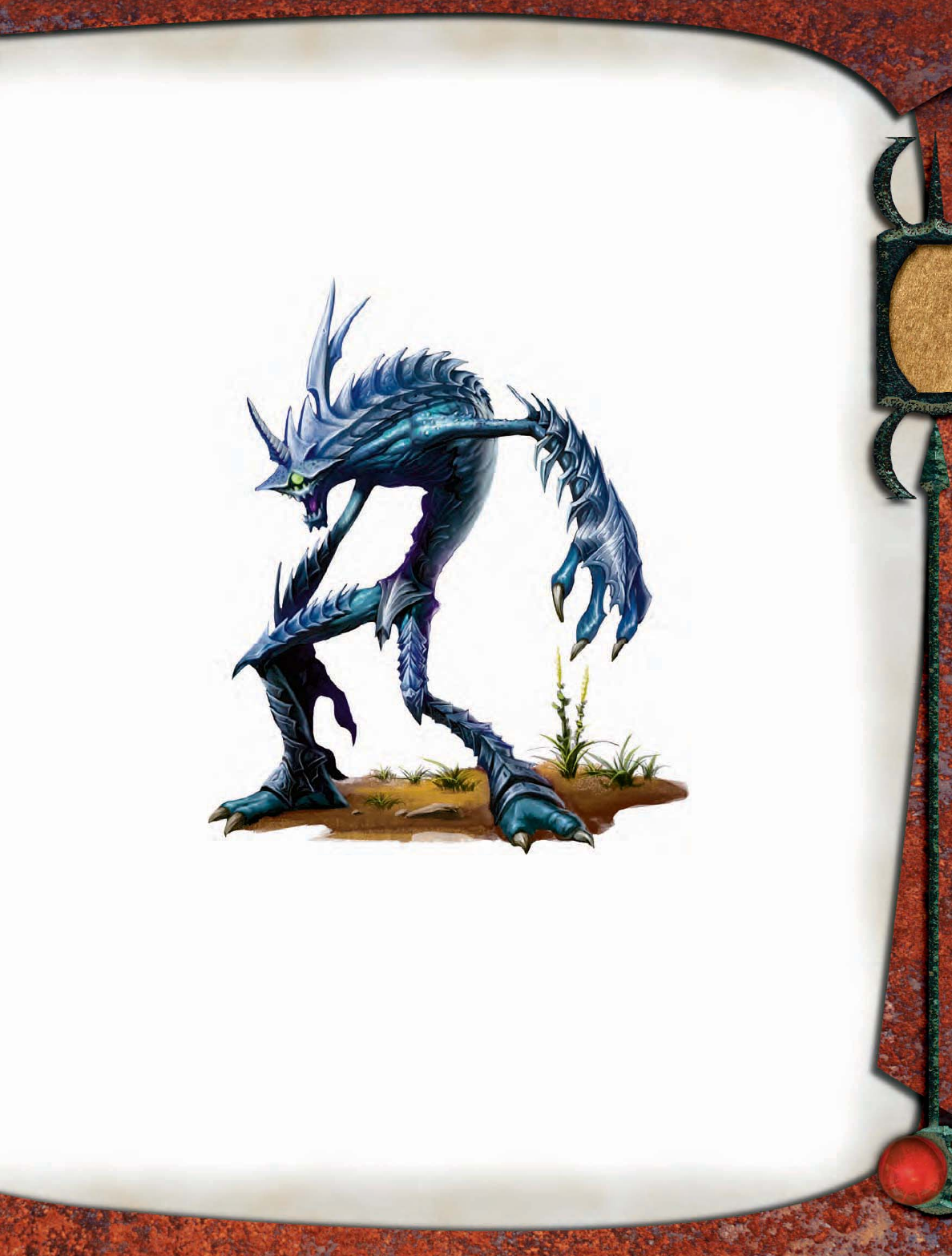
151
abilities on foes whose will is weakened by the shardsoul
slayer’s attacks.
Maddened Slaughter (EL 9): Four shardsoul slayers killed
their derro creator and fl ed the Underdark for a small city on
the surface. There, the constructs wreak murderous havoc in
the busy streets, trusting in their disorienting aura to confuse
attackers and keep a crowd of addled noncombatants between
them and danger.
ECOLOGY
Unlike most other constructs, shard-
soul slayers have a rudimentary
intelligence. Shardsoul slayers are
dedicated to spreading their suf-
fering in the most violent possible
way. Though they view
their destruction as a
means of reuniting their
elemental essence once
more, shardsoul slayers
yearn to live long enough
to inflict terrible pain on
others.
Environment: Shardsoul slay-
ers were originally created by
derro spellcasters seeking
to unleash pure havoc on
their enemies, so they are
most often found in sub-
terranean derro lairs.
They can be found
anywhere their mas-
ters send them.
Typical Physical Char-
acteristics: A shardsoul
slayer has an appearance
as fragmented as
the essence bound
within it. Its metal
limbs are lean and
angular, creating a haphazard but deadly
appearance. Armor plating makes up the
majority of its body, but a smoother “skin” of blue alloy
is visible at the joints. A typical shardsoul slayer stands
5 feet tall and weighs 300 pounds.
Alignment: A shardsoul slayer’s capriciousness and
lust for violence are its only consistent features. Shard-
soul slayers are usually chaotic evil, capable of any act
their form allows. The best among them are chaotic
neutral—unpredictable but not quite as bloodthirsty. Such
shardsoul slayers are created by less wicked creatures than
the derro.
SOCIETY
Shardsoul slayers have no innate social order, and those
controlled by the derro or others do as their masters bid
them. However, when escaped slayers come across each other,
they are drawn to live and fi ght as a unit. Once so bound,
shardsoul slayers can be separated only by the destruction
that frees their essence.
TYPICAL TREASURE
Shardsoul slayers have no need for treasure, but their chaotic irra-
tionality compels them to collect it anyway. They are particularly
fond of magic items, especially those of an elemental nature—
devices granting protection from energy, weapons that deal
energy damage, and so on. They have standard treasure
for their Challenge Rating, usually in the form
of a single weapon or magic item.
FOR PLAYER
CHARACTERS
Shardsoul slayers are never creat-
ed as single creatures. Rather, a
group of three slayers is given
life by the fragmented es-
sence of a single elemental
spirit. Each crafting of a
group of shardsoul slayers
requires the creation of a
number of distinct bodies
in which the shards of the el-
emental spirit are to reside.
Shardsoul Slayer
Construction
Three shardsoul slayer
bodies must be created
from specially pre-
pared alloys worth
1,500 gp. The con-
structs’ armored forms are forged
in a process requiring three days
and a single successful DC 15 Craft
(armorsmithing) check. As each body is smelt-
ed and poured, the molten metal is blended with quicksilver,
then slowly cooled. This quicksilver costs 500 gp.
The creator then calls and binds an elemental spirit from the
Elemental Plane of Earth. A fi nely crafted crystal prism worth
1,000 gp must be used in the fragmenting of the elemental
spirit. This prism is consumed at the time of creation, cracked
and dulled by the process.
CL 9th; Craft Construct, animate objects, lesser planar bind-
ing, shatter, caster must be at least 9th level; Price 70,000
gp; Cost 41,000 gp + 2,800 XP. This process creates three
shardsoul slayers.
Shardsoul slayer
SHARDSOUL
SLAYER
Illus. by J. Zhang

152
SIEGE BEETLE
The loud buzz of whipping wings fi lls the air as a tremendous insect
swoops down upon you. Its massive forelegs violently fl ail and its
great, curved mandibles glisten with a strange liquid.
Siege Beetle CR 16
Always N Gargantuan vermin (extraplanar)
Init +0; Senses darkvision 60 ft.; Listen +0, Spot +0
Languages —
AC 33, touch 6, flat-footed 33
(–4 size, +27 natural)
hp 250 (20 HD); DR 15/piercing
Immune electricity, sonic, vermin immunities
Resist cold 10, fire 10
Fort +20, Ref +6, Will +6
Speed 40 ft. (8 squares); fly 50 ft. (clumsy)
Melee 2 claws +26 each (2d8+15) and
bite +24 (2d6+7 plus paralysis)
Space 30 ft.; Reach 20 ft.
Base Atk +15; Grp +42
Atk Options improved grab
Special Actions blinding musk, surging trample
Abilities Str 40, Dex 10, Con 27, Int —, Wis 10, Cha 9
SA blinding musk, improved grab, paralysis, surging trample
SQ vermin traits
Feats —
Skills Listen +0, Spot +0
Advancement 21–26 HD (Gargantuan); 27–35 HD (Colossal)
Paralysis (Ex) A creature hit by a siege beetle’s bite attack
must succeed on a DC 28 Fortitude save or be paralyzed
for 1d6 rounds. The save DC is Constitution-based.
Improved Grab (Ex) To use this ability, a siege beetle must
hit an opponent of any size with a claw attack. It can
then attempt to start a grapple as a free action without
provoking attacks of opportunity.
If it wins the grapple check and maintains the hold
during the next round, it bites the grappled foe as a free
action.
Blinding Musk (Ex) As soon as it is reduced to half of its
full normal hit points or fewer, a siege beetle sprays
opponents with a 60-foot cone of blinding musk as an
immediate action. Those within the cone must succeed
on a DC 28 Fortitude save or be blinded for 1 minute. The
save DC is Constitution-based.
Surging Trample (Ex) A siege beetle can surge forward,
flattening and demolishing everything in its path.
Targets in the siege beetle’s path take 2d6+22 points
of damage, and they are also pushed in front of the
siege beetle to the extent of its movement. A creature
in the beetle’s path can choose to either make a DC 35
Reflex save to move out of the way, or attempt an attack
of opportunity, taking the effect of the trample if the
attack does not kill the siege beetle. The save DC is
Strength-based.
Siege beetles are massive, carnivorous insects from the
plane of Acheron. They are voracious and feed on the refuse
scattered upon the massive battlefi elds on that plane. These
insects see living creatures as mobile and tasty meals.
STRATEGIES AND TACTICS
Siege beetles attack fearlessly, swooping down on potential
prey and trampling. They follow up by slashing with their
scythe-shaped forelimbs, and they grab struck foes. Once
a siege beetle successfully grabs an opponent, it bites that
enemy as soon as it can, causing paralysis. It seeks a new
target as soon as a foe succumbs.
If the target (or its allies) proves to be resilient or bother-
some, the siege beetle fl ies off with its prey. It drops that
creature from a lofty height if the foe still resists.
When severely wounded, a siege beetle turns defensive.
The creature withdraws, spraying a stream of blinding musk
at opponents before fl ying off. If possible, it tries to carry off
at least one opponent to devour.
SAMPLE ENCOUNTERS
Adventurers are most likely to encounter a siege beetle after
entering the territorial insect’s hunting grounds. Fortunately
for those who would battle them, siege beetles are just as
hostile to others of their race as they are to their prey, and
they are rarely encountered in groups.
The Guardian (EL 16): Deep within an immense forest
is a grove of ancient redwoods that tower hundreds of feet
into the heavens. It is said that at their apex, a portal opens to
Acheron. About two-thirds of the way up is lair of the portal’s
guardian, a hungry siege beetle.
Hatchlings (EL 20): A wizard sends the PCs on a quest to
recover a special material from which he promises to craft
a powerful suit of magic armor. He gives the characters
directions to an ancient battlefi eld on Acheron that is said to
hold a clutch of siege beetle eggs. Although he informs the
PCs of the nature of the eggs, he assures them that the eggs
cannot hatch in the cold place they are located in. However,
a strike from another cube in Acheron opened a geothermal
vent, which has warmed the eggs, causing them to hatch
prematurely. By the time the PCs arrive, the eggs are empty,
and four siege beetles are looking for a fresh meal.
pqqqqqqqqqrs
SIEGE BEETLE LORE
Characters who have ranks in Knowledge (the planes) can
learn more about siege beetles. When a character makes a
successful skill check, the following lore is revealed, including
the information from lower DCs.
Knowledge (the Planes)
DC Result
26 This is a siege beetle, an enormous insect from
the plane of Acheron. It is particularly weak against
piercing weapons, and its chitin is useful for
crafting armor.
31 Siege beetles have paralytic bites. Of the forms of
energy, only acid is fully effective against them.
36 Siege beetles spray a blinding musk when they are
severely wounded.
pqqqqqqqqqrs
SIEGE BEETLE
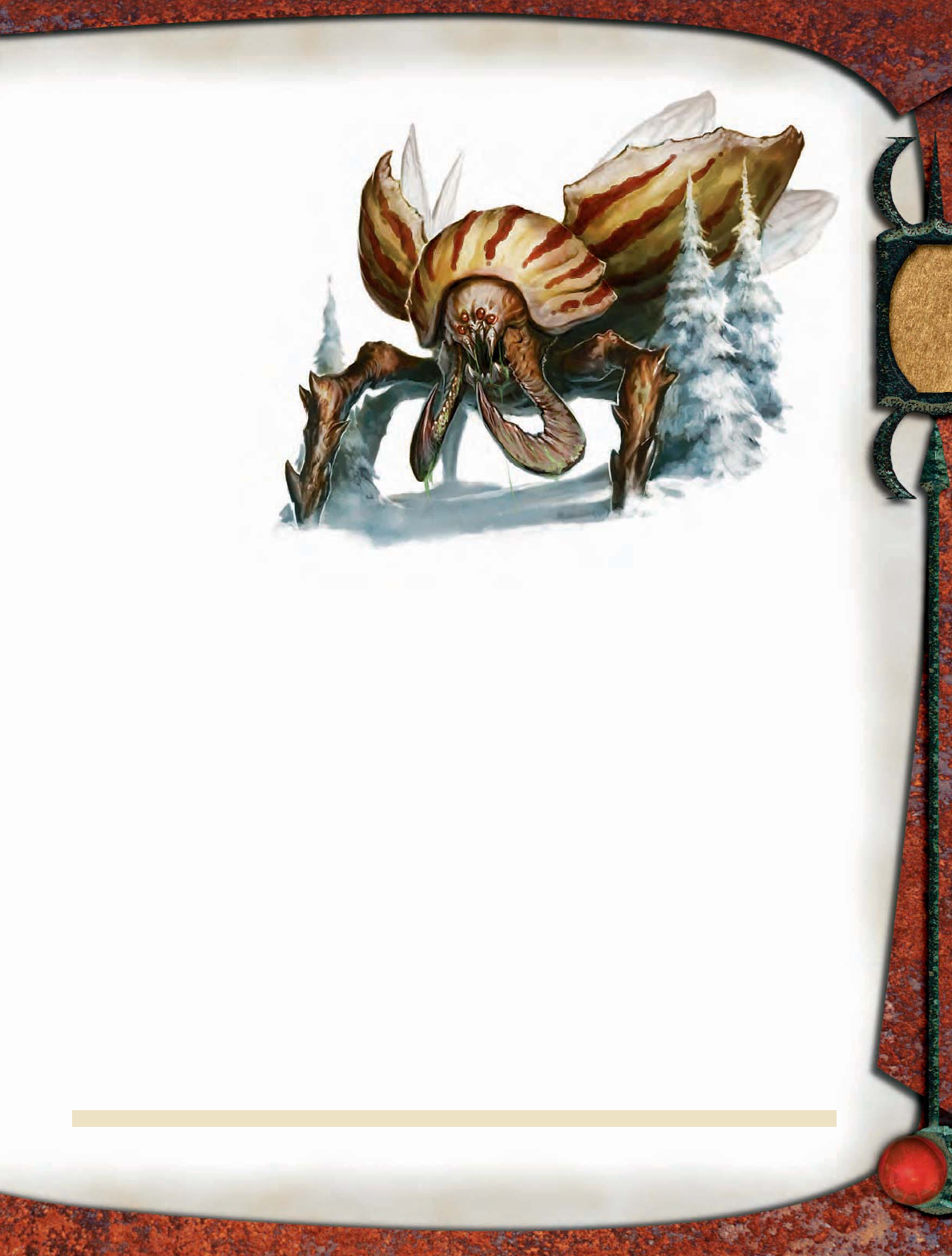
153
ECOLOGY
Siege beetles require ample food and plenty of
space to survive. They stop eating only long
enough to molt and reproduce. Since they
must consume immense amounts of food,
the availability of suitable habitats for them
is limited. Fiercely territorial even against
others of their kind, they violently defend
their hunting grounds. Only court-
ship scents released by willing mating
partners can quell this instinct for
a time.
Siege beetles lay their eggs by de-
positing them into large crevasses
and similar geographic features.
They cover their clutches with
carcasses and other detritus. A
female siege beetle lays two to
four eggs surrounded by a
membrane fi lled with sticky
ectoplasm. A single egg is over
15 feet in circumference and
looks like a brown, fleshy
seedpod.
In a few months, the eggs hatch, releasing
nymph-stage beetles. Siege beetle nymphs molt several times
before reaching the adult stage (advanced creatures with 30
HD). Each phase lasts for about a year, and large numbers of
beetles die before reaching adulthood.
Environment: Siege beetles roam the iron battlefi elds of
Acheron, but one might slip through to the Material Plane
by stumbling through a planar gate. The beetles instinctively
nest in dark caves or crevasses where they hibernate. When
they find a battlefield littered with corpses, they push the
bodies into one massive pile, then climb atop and begin
to eat.
Typical Physical Characteristics: A typical siege beetle
is the size of a barn and weighs thirty to forty tons. Its body is
longer than it is wide, supported by slender, segmented legs
covered with sticky cilia. One or two mottled colors adorn
its chitin.
All siege beetles have long, paired wings that fold
straight back underneath an outer shell. Pale and irides-
cent, the wings move so quickly that they can barely be
seen when the creature flies, though they make a loud
thrumming sound.
Alignment: Siege beetles have no concept of morality and
are always neutral.
SOCIETY
Siege beetles have no society. However, the armies that
wage war across Acheron employ these enormous insects
as war beasts. A siege beetle is an unruly soldier, however,
and more than one army has lost a battle because of its own
siege beetles.
TYPICAL TREASURE
Siege beetles are mindless, but the possessions of their vic-
tims remain after the beetle feeds. A siege beetle has half the
standard number of coins, half goods, and standard items. Its
shell is a valuable commodity in places where chitin armor is
valued (see For Player Characters), including the war camps
and strongholds of Acheron.
FOR PLAYER CHARACTERS
Siege beetle chitin is highly desirable for making chitin
armor. The chitin is treated for flexibility, then cut and
reshaped into long strips. These strips are bound together by
tightly woven cord when necessary. Siege beetle chitin armor
is always masterwork in quality, and it provides its wearer
with resistance to electricity 5 and resistance to sonic 5. A
druid who wears chitin armor crafted from a siege beetle shell
does not lose access to spells or class features. Chitin armor
is medium armor that has the following characteristics.
Max Armor Spell
Armor Dex Check Failure Speed
Cost Bonus Bonus Penalty Chance (30 ft.) (20 ft.) Weight1
2,000 gp +4 +4 –2 30% 20 ft. 15 ft. 20 lb.
1 Weight is for armor sized to fit Medium creatures. Armor fitted for Small characters weighs half as much, and
armor fitted for Large characters weighs twice as much.
Siege beetle
SIEGE BEETLE
Illus. by J. Chan
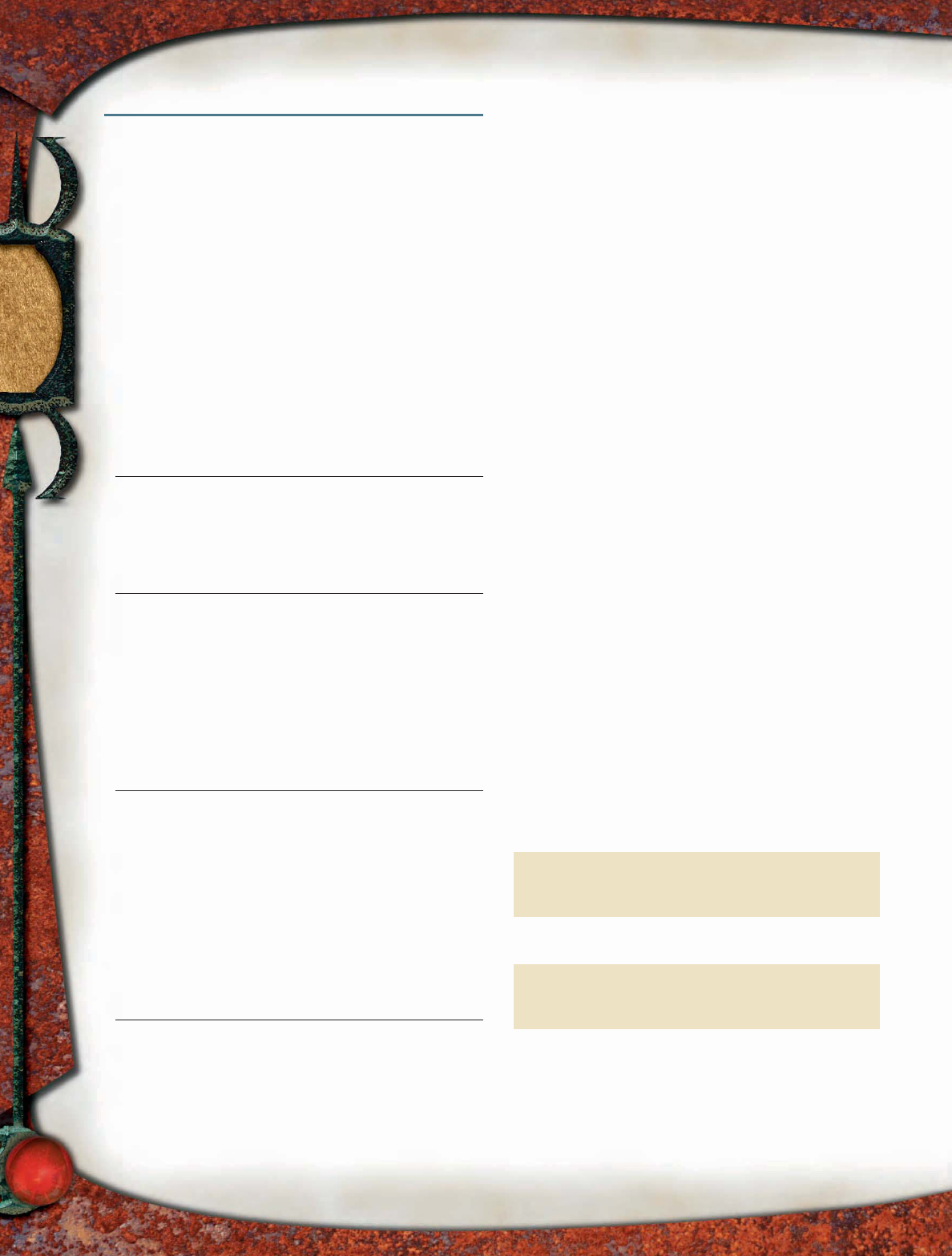
154
SKULL LORD
Dark rumors speak of the skull lords, powerful undead
beings created by the magic unleashed at the death of the
mighty necromancer Vrakmul. These undead wish to call
their master back from beyond mortality, using their mastery
over bones as a tool and a weapon. In their quest, they show
no mercy to the living or the walking dead that refuse to
follow them.
SKULL LORD
Tall and regal, a skeletal figure wearing breastplate and wrapped
in a flowing black cloak steps toward you. It regards its sur-
roundings with each of its three human skulls. Shining blue
fl ames gutter in its eye sockets, and it wields a staff of bones with
skulls at each end.
Skull Lord CR 7
Usually LE Medium undead
Init +4; Senses darkvision 60 ft.; Listen +12, Spot +12
Languages Common, Draconic, Infernal
AC 21, touch 14, flat-footed 17
(+4 Dex, +5 armor, +2 natural)
hp 78 (12 HD); DR 5/bludgeoning
Immune cold, undead immunities
Resist +4 turn resistance (see skull loss)
Fort +4, Ref +8, Will +10
Weakness skull loss
Speed 20 ft. (4 squares) in breastplate, base speed 30 ft.
Melee bone staff +12/+7 (1d6 plus 1d6 cold) or
Melee bone staff +10/+10/+5 (1d6 plus 1d6 cold)
Ranged bone shard +10 (1d6 plus 1d6 cold; see triple
skulls)
Space 5 ft.; Reach 5 ft.
Base Atk +6; Grp +6
Atk Options Point Blank Shot, Precise Shot
Special Actions triple skulls
Combat Gear scroll of inflict serious wounds, scroll of
invisibility, scroll of meld into stone, scroll of sculpt sound,
scroll of wall of fire, scroll of warp wood
Abilities Str 11, Dex 19, Con —, Int 14, Wis 15, Cha 17
SA triple skulls
SQ create spectral rider, undead traits
Feats Point Blank Shot, Precise Shot, Two-Weapon Fighting,
Weapon Finesse, Weapon Focus (bone staff)
Skills Bluff +8, Diplomacy +7, Disguise +3 (+5 acting),
Hide +5, Intimidate +10, Knowledge (arcana) +12,
Knowledge (dungeoneering) +7, Knowledge (religion) +12,
Listen +12, Move Silently +5, Sense Motive +7,
Spellcraft +9 (+11 deciphering scrolls), Spot +12,
Survival +2 (+4 underground), Use Magic Device +18
(+20 scrolls)
Advancement 13–24 HD (Medium)
Possessions combat gear plus breastplate, royal outfit
Skull Loss When a skull lord is reduced to two-thirds of its
full normal hit points, its creator skull shatters. The skull
lord loses the ability to create undead, though extant
undead remain under its control. When a skull lord is
reduced to one-third of its full normal hit points, its
spitting skull shatters, and it loses its bone shard ability.
If a skull lord is healed so that its hit points once again
exceed one-third or two-thirds of its full normal total, the
appropriate skull reappears. The skull lord then regains
the use of the ability granted by the skull.
A skull lord and the undead it controls have +4 turn
resistance as long as the skull lord has all three of its skull
heads. This turn resistance is reduced to +2 if a skull lord
has only two heads, and it is lost when a skull lord has
only one head remaining.
Bone Staff (Su) A skull lord’s bone staff functions as a
masterwork quarterstaff that deals an extra 1d6 points of
cold damage. A bone staff is treated as a natural weapon
for the purpose of the skull lord’s use of its Weapon
Finesse feat.
If a skull lord loses possession of its bone staff, the
bone staff is destroyed. A skull lord can create a new
bone staff as a swift action. To do so, it must slay one of
its created undead servitors within 30 feet. The chosen
servitor is instantly destroyed as the bone staff reappears
in the skull lord’s hands.
Triple Skulls (Ex) Each round as a swift action, a skull lord
can use one of these abilities: bone beckon, bone shard,
or create servitor. If a skull lord loses a skull (see skull
loss), it loses access to one of the abilities.
Bone Beckon (Su) A skull lord can use its beckoning
skull to bring forth fragments of bone from the body
of an opponent within 30 feet that has a skeletal
system. The creature must succeed on a DC 19 Will
save or take 2d6 points of damage as the shards are
torn from its body. Nonintelligent undead creatures
do not get a save.
A skull lord can instantaneously cause the shards to
be absorbed by a corporeal undead of its choice within
30 feet (including itself). The chosen undead heals 5
points of damage. Alternatively, a skull lord can hold the
shards in the mouth of its spitting skull (see the bone
shard ability).
pqqqqqqqqqrs
SKULL LORD LORE
Characters who have ranks in Knowledge (religion) can learn
more about skull lords. When a character makes a successful
skill check, the following lore is revealed, including the infor-
mation from lower DCs.
Knowledge (Religion)
DC Result
17 This creature is a skull lord, a sinister undead with
powers over lesser undead creatures. Skull lords
are capable of raising skeletal undead to do their
evil bidding.
22 Skull lords wield bone staffs and spit bone shards
at range. Both attacks deal cold damage, and a
skull lord is immune to cold-based attacks.
27 Skull lords can cause bone shards to be wrenched
from a creature’s body, then subsequently spit
them back at the same creature with unerring
accuracy.
32 When a skull lord takes enough damage, it loses
one of its skulls and the special power granted to
it by that skull. Its ability to create undead goes
fi rst, followed by its spitting skull. Destroying
the skulls also makes turning a skull lord and its
minions easier.
pqqqqqqqqqrs
SKULL LORD
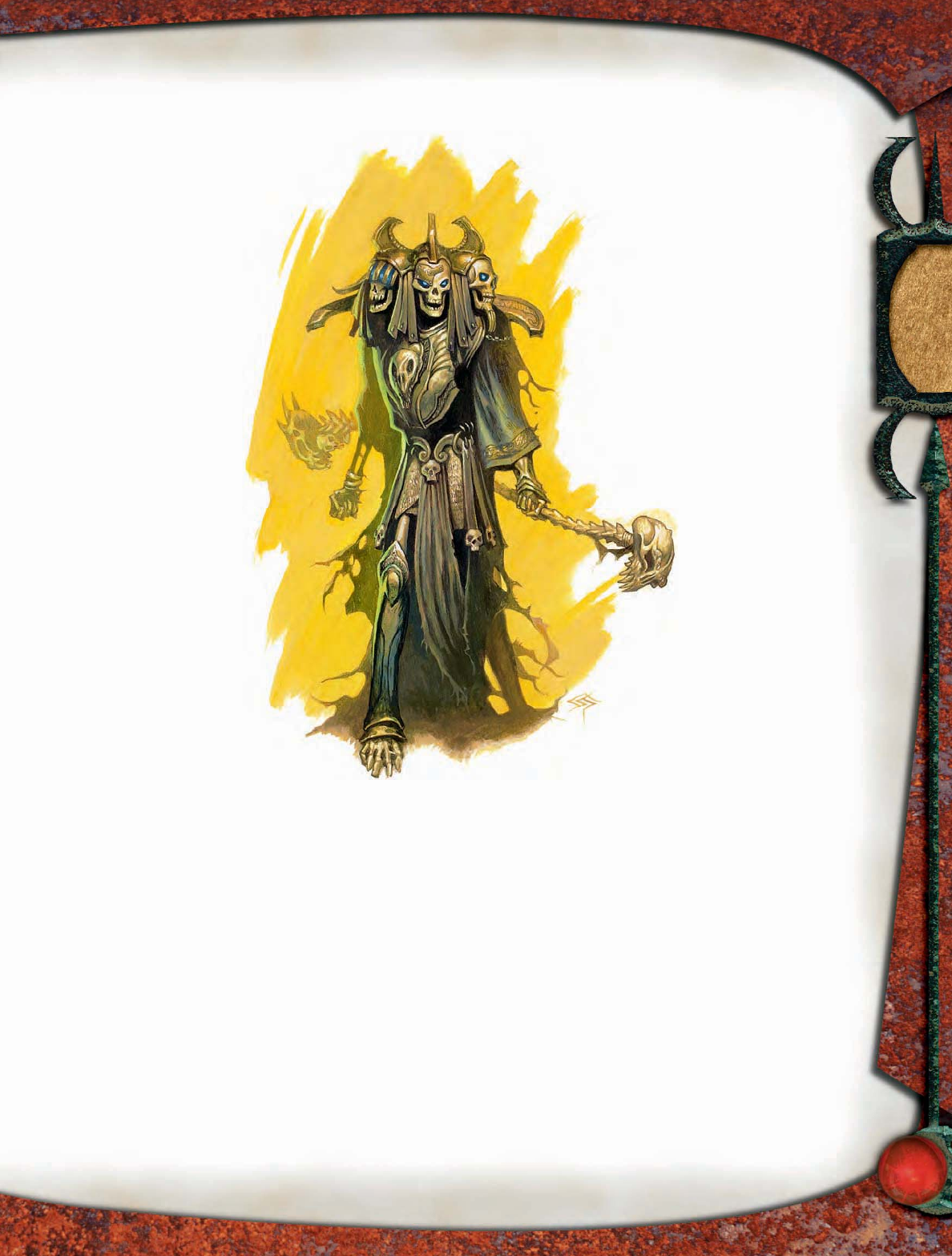
155
Bone Shard (Su) A skull lord’s spitting skull can spit
shards of bone from its mouth. A bone shard attack
has a range increment of 30 feet.
If a skull lord has used the bone
beckon ability to hold bone shards
wrenched from a creature, it
can fire those shards with
this ability. If the skull
lord fires bone shards at
the same creature the
shards were taken from,
the bone shard attack
automatically hits unless
the target has total cover
or total concealment. A
skull lord must make
this special bone shard
attack in the round
immediately after
it brings forth the
shards with its bone
beckon ability.
Create Servitor
(Su) A skull lord’s
creator skull can
create a bonespur
(page 156), a serpentir
(page 158), or a
skeleton from nearby
bones and bone
shards. Undead
created by this ability
are automatically under
the skull lord’s control.
A skull lord can have
a number of undead
under the control of its
creator skull equivalent
to an EL 7 encounter.
For example, a skull lord
might have four bonespurs,
three serpentirs, or a cloud giant
skeleton under its control. It could
also control a mix of undead, such as
five human skeletons, three bonespurs,
and a serpentir.
Servitors in the presence of a skull lord at the
beginning of an encounter earn experience points
for PCs as normal if they are fought and defeated.
Servitors created during combat are treated as
summoned monsters, which do not provide additional
experience points.
Create Spectral Rider (Su) Once per month, a skull lord
can engage in a 12-hour ritual under the dark moon to
create a spectral rider (page 160) from the remains of a
mounted warrior. The spectral rider is loyal to the skull
lord, but it is not controlled. Through use of this
ability, a skull lord can have one spectral rider
servant at a time, creating a new one only after
an existing servant is destroyed.
The twelve skull lords arose from
the ashes of the Black Tower of
Vrakmul. Whether they were created
intentionally by that mad necroman-
cer or came forth spontaneously from
the foul energies of his fallen sanctum,
none can say. However, legends state
that since Vrakmul’s fall, the twelve
have sought his lost regalia—a mask
of the skull, a rod of withering, and a staff
of necromancy. With these items, they
plan to recall Vrakmul from destruc-
tion, rejoining his shattered soul and
re-forming his phylactery so that he
might rise as a lich.
Strategies
and Tactics
Skull lords prefer to
avoid direct conflict
in favor of mastermind-
ing attacks by those they
command. Typically, a skull lord
sends its servitors and minions
into melee while it hangs back,
using them as a shield. A skull lord
uses scrolls and its bone beckon
and bone shard abilities against foes
that attack directly, and creates more
servitors as the need arises. Skull lords are
equally effective in melee combat, however,
and they put their grisly bone staffs to good
use if pressed.
Sample Encounter
A skull lord is never encountered without undead minions,
and independent sentient undead might willingly serve a
skull lord. Individual skull lords avoid congregating so that
they cannot be struck down all at once.
Skull lord
SKULL LORD
pqqqqqqqqqqqqqqqqqqqqrs
VRAKMUL?
The skull lords’ background information makes reference to
the necromancer Vrakmul, establishing these creatures as
being limited in number and having a specific goal. You can
take this idea and run with it, inventing the history of Vrakmul
and deciding what purpose the twelve skull lords play in your
campaign. Alternatively, skull lords might simply be a powerful
new form of undead with no specific background or number.
Skull lords might be the result of failed attempts at achieving
lichdom, the undead remains of a race of three-headed beings,
or a single creature formed from the magical amalgamation of
three corpses.
pqqqqqqqqqqqqqqqqqqqqrs
Illus. by S. Prescott
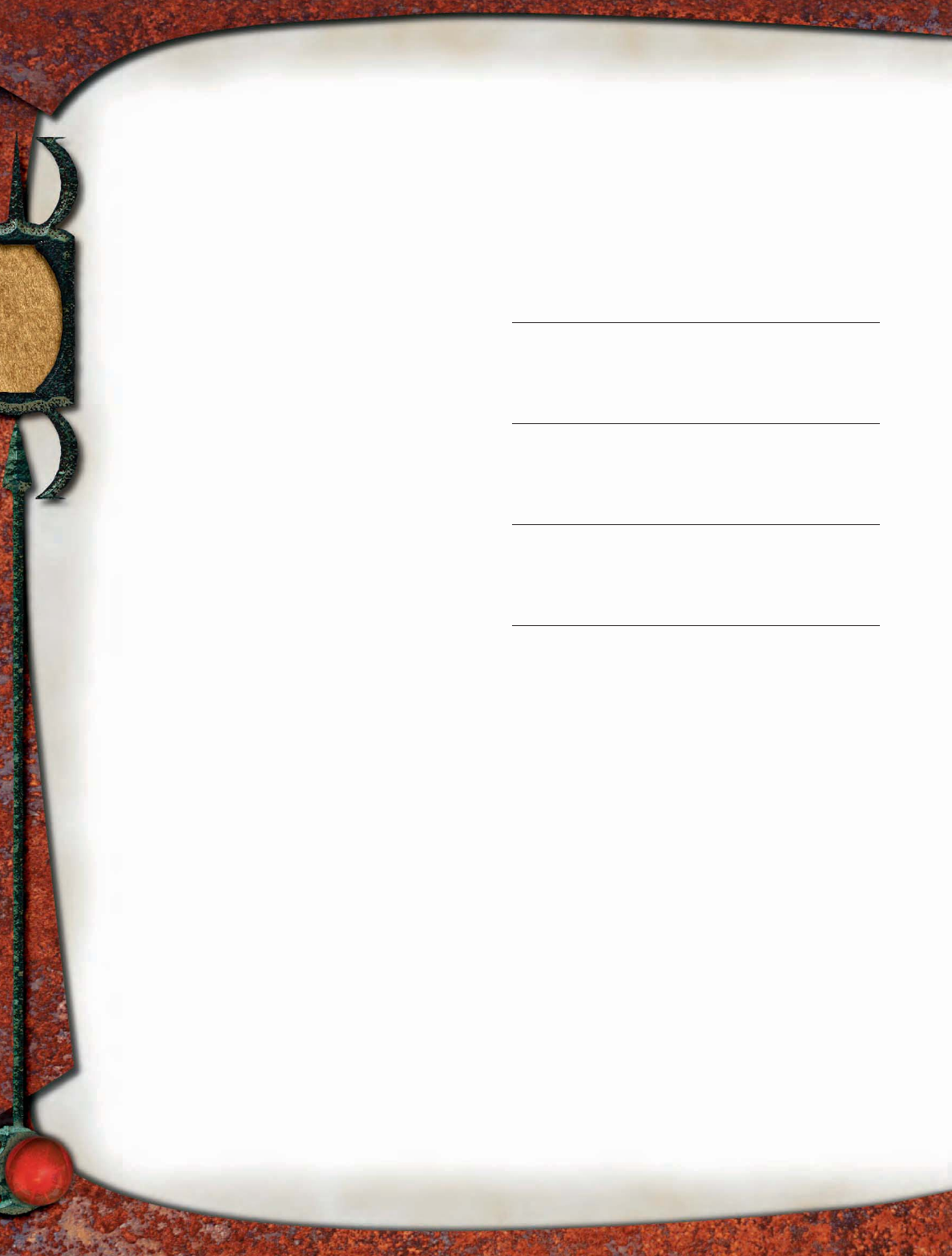
156
Tomb Marauders (EL 9): While raiding a tomb for the
relics contained within it, a skull lord convinced two mum-
mies (MM 190) to follow it. Now the skull lord continues its
search for lost magic, crossing paths with adventurers who
are doing the same. The mummies’ despair ability paralyzes
characters who stand in their way, allowing the skull lord’s
summoned servitors to make coup de grace attacks against
such foes.
Ecology
Skull lords are undead, and as such, they do not have a
signifi cant effect on the environment. Though they rely on
skeletal corpses to create their servitors, skull lords do not
indiscriminately lay waste to populations of living creatures
unless such destruction serves a larger purpose. Skull lords
have more specifi c aims, requiring them to work with circum-
spection, but they take direct action if the need arises.
Environment: Skull lords operate in secret, creating lairs
for themselves below ancient ossuaries, taking up residence
in cemeteries, or making homes in the dark depths of empty
catacombs. Any location that features an ample supply of
skeletal remains makes an excellent place for a skull lord to
base its operations.
Typical Physical Characteristics: Humanoid in form and
having three skulls, a skull lord is immediately recognizable.
Each skull lord’s armor and cloak are scribed with its own
dark motifs, so individual skull lords are distinct from one
another. These creatures stand about 6 feet tall, but their
skeletal forms weigh only 50 pounds.
Alignment: Skull lords prefer complicated and precise
planning to rash action. Though not all skull lords are lawful
in alignment, all are uniformly evil.
Society
Other than their coterie of undead followers, skull lords typi-
cally work alone. Each seeks Vrakmul’s regalia and the other
arcane secrets necessary to bring back their dark lord. On
rare occasions, skull lords meet to discuss recent intelligence
and formulate plans, particularly if one of their number has
recently been destroyed.
Typical Treasure
Skull lords are vain creatures, and they have an appreciation
for the effect their appearance can have on terrifi ed mortals.
They wear circlets and bracelets of gold and silver, adorning
their talonlike hands with jeweled rings. Skull lords also
covet magic items, particularly those that might help them
in their search for Vrakmul’s regalia and those they can wield
in combat. With their expertise in Use Magic Device, skull
lords can read scrolls and employ magic items with ease. They
have double standard treasure for their Challenge Rating
in fi nery and magic items. The skull lord presented in this
entry has 2,275 gp worth of scrolls before combat, so it can
still have standard treasure generated for it.
BONESPUR
A macabre column of bone suddenly springs to life, fragments and
shards near the top shaping themselves into a parody of a skull. A
bone arm sprouting from the side of the column ends in a scything
blade of gleaming white. Then, even as you watch, the creature
collapses in on itself, reconfi guring into a rhinolike quadruped that
charges with great speed.
Bonespur CR 3
Always LE Large undead
Init +1; Senses darkvision 60 ft.; Listen +3, Spot +4
Languages understands creator’s orders
AC 14, touch 10, flat-footed 13
(–1 size, +1 Dex, +4 natural)
hp 26 (4 HD); DR 5/bludgeoning
Immune cold, undead immunities
Resist stability
Fort +1, Ref +2, Will +4
Speed 10 ft. (2 squares), 40 ft. in charging form
Melee bone scythe +5 (1d8+6/19–20)
Space 10 ft.; Reach 10 ft.
Base Atk +2; Grp +10
Atk Options Improved Bull Rush, Power Attack, boneshard
blast, charging form
Abilities Str 18, Dex 12, Con —, Int 2, Wis 11, Cha 10
SA boneshard blast, charging form
SQ undead traits
Feats Improved Bull Rush, Power Attack
Skills Listen +3, Spot +4
Advancement 5–20 HD (Large)
Stability (Ex) A bonespur has better than average footing
and leverage in either of its forms. It gains a +4 bonus on
ability checks made to resist being bull rushed or tripped
when standing on the ground (but not when climbing,
flying, or otherwise not standing firmly on the ground).
Boneshard Blast (Su) Once per day, as a free action
immediately following a charge, a bonespur can explode
in a shower of bone shards. Creatures within 10 feet of
the bonespur take 2d6 points of damage (Reflex DC 12
half). The shards of the bonespur transform into its
normal towering shape at the beginning of its next turn.
Charging Form (Su) Once per day, as a swift action, a
bonespur can transform from a column of bone into a
rhinolike form. In this form, its speed increases to 40 feet
and its scythe is transformed into a hornlike structure.
The scythe deals normal damage. If a bonespur hits with
its scythe after charging, however, the weapon deals an
extra 2d6 points of damage.
Bonespurs are animalistic monstrosities created only for
fi ghting and killing.
Strategies and Tactics
When first encountered, a bonespur slashes its bone scythe
menacingly before shifting into its charging form and
racing at the nearest group of enemies. At the end of its
charge, it uses its boneshard blast ability, reshaping into
a column of bone on its next turn and attacking all that
come within reach.
SKULL LORD
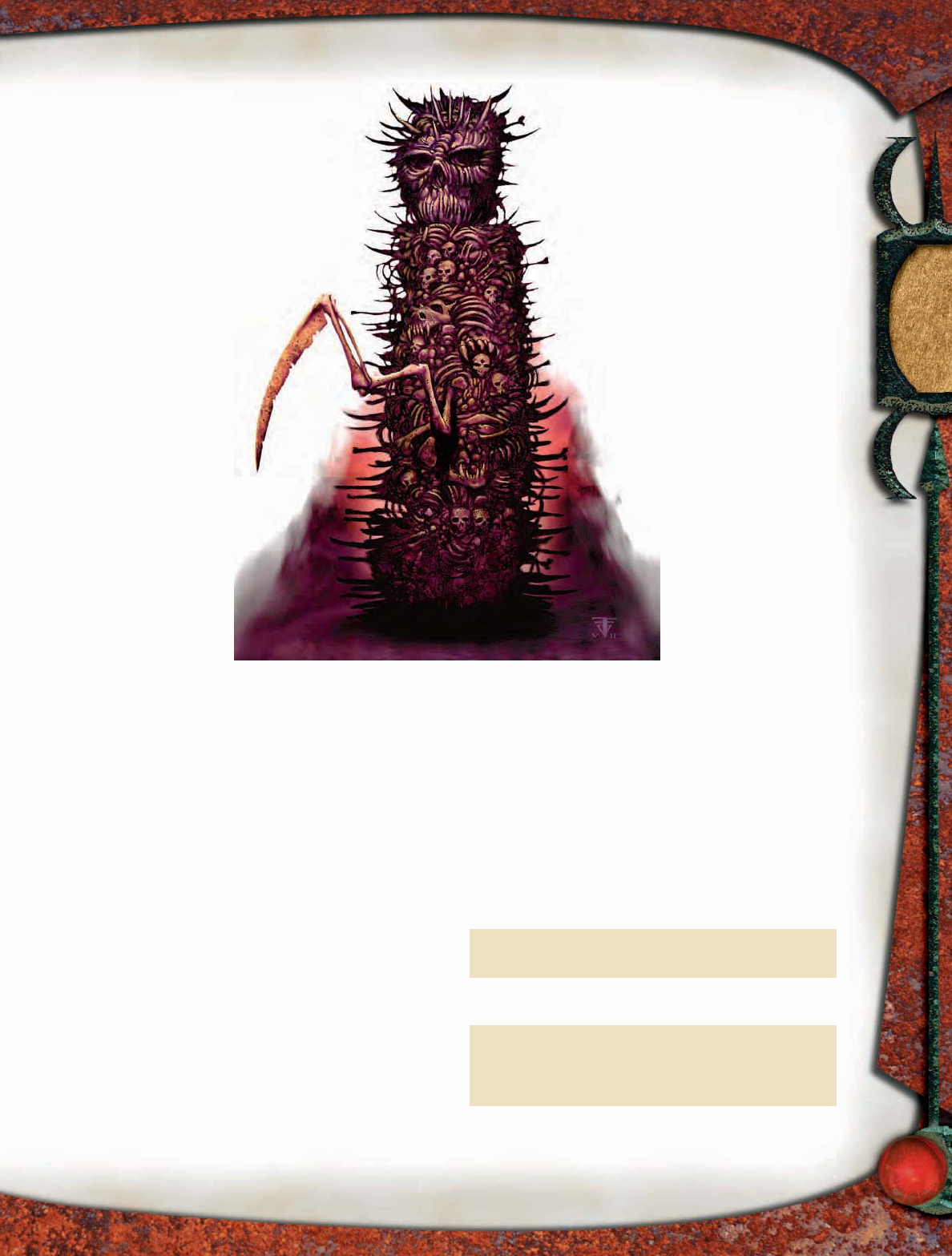
157
Though a bonespur is of limited intelligence,
it recognizes the advantage of pushing oppo-
nents into pits or off ledges, and it makes bull
rush attacks whenever possible. At the same
time, a bonespur has no sense of self-preserva-
tion, and these creatures have been known to
follow opponents over the edge of cliffs in the
zealousness of a bull rush attack.
Sample Encounters
Though bonespurs serve at the
side of the skull lord or spell-
caster who created them, their
errands of destruction some-
times see them sent far from
their masters. They seldom
appear in large groups.
Graveyard Terror (EL
3): In an effort to spread
fear and panic, a skull
lord has created a bone-
spur in a local cemetery.
Though the towering mon-
strosity does not move
from this spot, its pres-
ence has terrifi ed the
local townsfolk, and it
charges any characters
who pass through the
cemetery gates.
Caravan of Death
(EL 6): Three fl atbed wagons piled high with
dirt-caked bones make their way through the empty wilder-
ness, each pulled by an owlbear skeleton (MM 226). What the
PCs who observe do not know is that the caravan is actually
a skull lord’s trap designed to lure them to their doom. The
piles of bones are three dormant bonespurs that rise up and
attack as soon as the caravan is approached.
Ecology
Bonespurs were fi rst created by skull lords, whose create
servitor ability can bring these dread creatures into existence.
Necromancers and other spellcasters sometimes learn the
secret of creating bonespurs.
Environment: Though they are highly mobile in their
charging form, bonespurs are typically found near the
place of their creation. Skull lords and necromancers create
bonespurs in battlefi elds, graveyards, and wherever suffi cient
quantities of bones can be found. Skull lords also have their
minions collect bones to be brought back to their lair, where
they create bonespurs as macabre sentries or soldiers.
Typical Physical Characteristics: In its normal form, a
bonespur appears to be a 12-foot-tall column of bone, 5 feet
around at the base and slowly tapering toward its top. Bones
and shards near the top of the tower form a mas-
sive skull shape, with a compound skeletal arm
reaching out from its side. When charging, the
bonespur transforms into a 12-foot-long rhino-
like shape, exploding in a cloud of bone shards as it
slams into its opponents. In either incarnation, a
bonespur’s skeletal form weighs 400 pounds.
Alignment: These creatures have ani-
mal intelligence, but they are driven by utter
loyalty to their creator and the corrupt en-
ergy that animates them. They are uniformly
lawful evil.
Typical Treasure
Bonespurs are simple creatures that have
little use for trinkets or trophies. How-
ever, they sometimes collect wealth
from slain opponents as an offering
to their masters. Bonespurs have half
standard treasure for their Challenge
Rating, mostly in jewels and oth-
er adornments that can be
found among the shattered
remains of the creature
after it is destroyed.
For Player
Characters
A spellcaster of 8th lev-
el or higher can create a
bonespur using the create
undead spell. Creating a bonespur requires skel-
etal remains equivalent to six Medium creatures.
pqqqqqqqqqrs
BONESPUR LORE
Characters who have ranks in Knowledge (religion) can learn
more about bonespurs. When a character makes a successful
skill check, the following lore is revealed, including the infor-
mation from lower DCs.
Knowledge (Religion)
DC Result
13 This dread tower of animated bone is a bonespur,
a dangerous undead creature. This result reveals
all undead traits.
18 Bonespurs can shift their bony forms, taking on
a four-legged shape that grants them great speed
and a devastating charge attack.
23 Bonespurs are immune to cold and resistant to
all but bludgeoning weapons. A bonespur that
charges can explode in a shower of sharp bone
shards afterward, taking on its original shape
shortly after doing so.
pqqqqqqqqqrs
Bonespur
SKULL LORD
Illus. by F. Vohwinkel
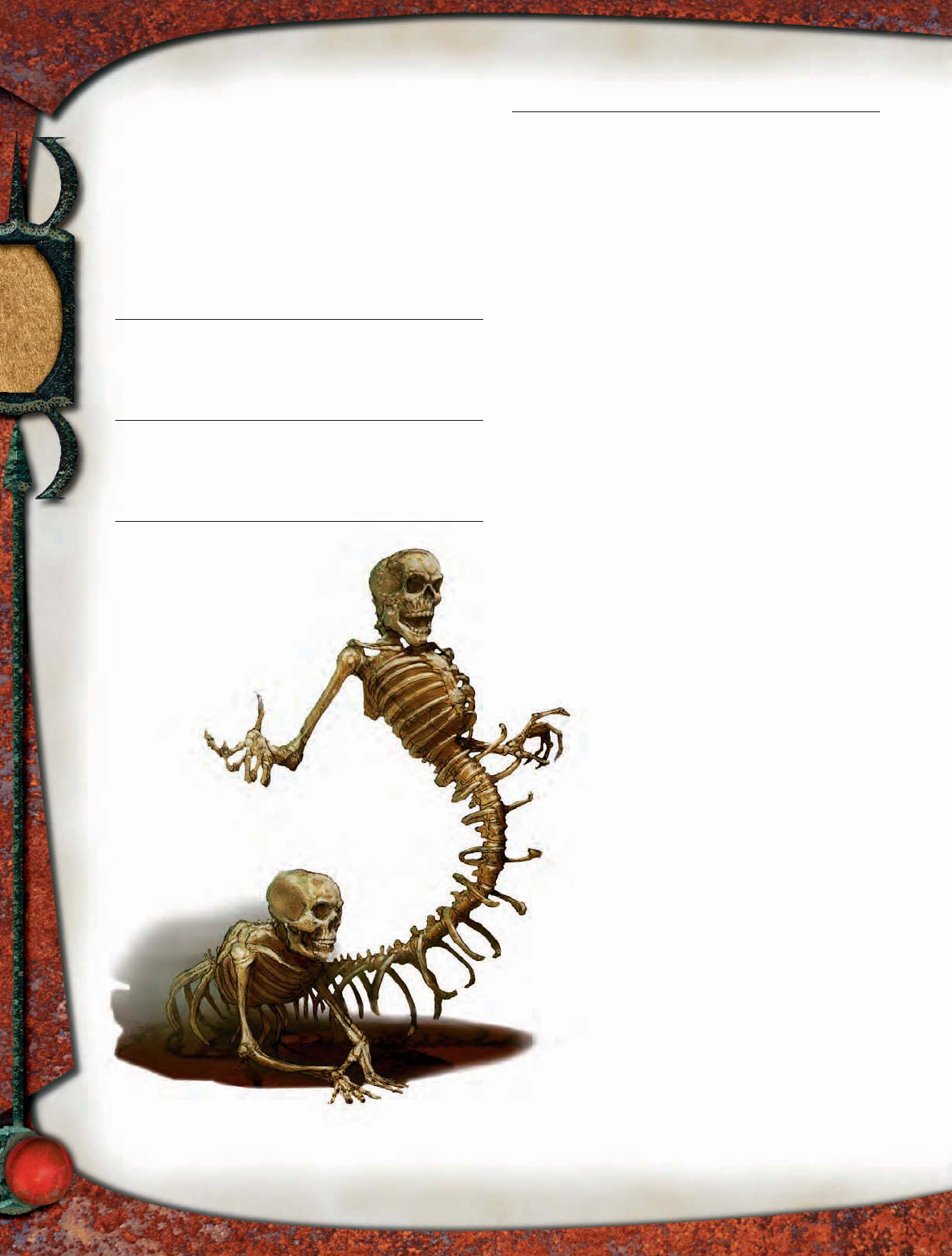
158
SERPENTIR
A serpentlike abomination of bone crawls stealthily toward you, both
ends crowned by a skull with burning eyes. The creature appears
to be composed of a series of linked torsos whose moving ribs propel
it forward. Two pairs of taloned skeletal arms reach for you as the
monstrosity attacks.
Serpentir CR 4
Always CE Large undead
Init +9, dual actions; Senses all-around vision, darkvision
60 ft., sense emotions 60 ft.; Listen +10, Spot +10
Languages understands creator’s orders
AC 15, touch 14, flat-footed 10; Dodge, Mobility
(–1 size, +5 Dex, +1 natural)
hp 52 (8 HD); DR 5/bludgeoning
Immune cold, flanking, undead immunities
Resist stability
Fort +2, Ref +7, Will +9
Speed 50 ft. (10 squares), climb 20 ft.
Melee 4 claws +5 each (1d6+2)
Space 10 ft.; Reach 5 ft.
Base Atk +4; Grp +10
Atk Options improved grab
Special Actions churning ribs
Abilities Str 14, Dex 20, Con —, Int 4, Wis
16, Cha 11
SA churning ribs, dual actions,
improved grab
SQ undead traits
Feats Dodge, Improved Initiative,
Mobility
Skills Climb +10, Hide +12,
Jump +10, Listen +10, Move
Silently +15,
Search +1,
Spot +10
Advancement 9–12 HD (Large); 13–18 HD (Huge)
Dual Actions (Ex) A serpentir’s two independent heads
allow it to take two rounds’ worth of action in any given
round, as if it were two creatures. Thus, a serpentir can
use two standard actions and two move actions, two
full-round actions and two 5-foot steps, or some other
combination.
All-Around Vision (Ex) A serpentir’s two heads allow it to
look in any direction, providing a +4 racial bonus on Spot
and Search checks. Opponents gain no benefit when
flanking a serpentir.
Sense Emotions (Su) This ability functions like blindsense,
except that a serpentir can detect only the presence and
positions of living creatures.
Stability (Ex) A serpentir has better than average footing and
leverage. It gains a +4 bonus on ability checks made to
resist being bull rushed or tripped when standing on the
ground (but not when climbing, flying, or otherwise not
standing firmly on the ground).
Improved Grab (Ex) To use this ability, a serpentir must
hit an opponent of up to Medium size with two or
more claw attacks. It can then attempt to start a
grapple as a free action without provoking attacks of
opportunity.
A grappled opponent can be drawn into the
serpentir’s churning ribs as a free action.
Churning Ribs (Ex) A serpentir’s elongated torso of
prehensile ribs can chew creatures to pieces. Any
Medium or smaller opponent successfully grappled
by a serpentir can be drawn into the churning ribs as
a free action. When this occurs, the serpentir is no
longer considered to be grappling and can act and move
normally, dragging the creature with it as it goes.
Opponents in the churning ribs remain grappled
until they succeed on a grapple check against the
serpentir, allowing them to claw their way free. A creature
within the churning ribs takes 2d6 points of
piercing damage at the beginning of each of the
serpentir’s turns.
Skills Serpentirs have a +4 racial bonus on
Listen checks and a +8 racial bonus on Hide,
Move Silently, and Climb checks. A serpentir
can choose to take 10 on Climb checks, even if
rushed or threatened. Serpentirs use either their
Strength or Dexterity modifier for Climb checks,
whichever is higher.
Serpentirs are unnatural predators, preferring to stalk
foes from the shadows rather than face them in a stand-up
fi ght. Their talent for stealth and their speed make them
favor quick strikes and hit-and-run tactics.
Strategies and Tactics
A serpentir conceals itself from foes whenever possible,
shadowing them for hours as it sizes up their abilities
and learns their habits. It takes great delight in
attacking without warning, using walls, ceilings,
and difficult terrain to its advantage. A serpentir
attempts to grapple a weak-looking creature, draw
that foe into its churning ribs, then retreat. If it has had
time to prepare, it takes a preplanned escape route that is
Serpentir
SKULL LORD
Illus. by A. Swekel
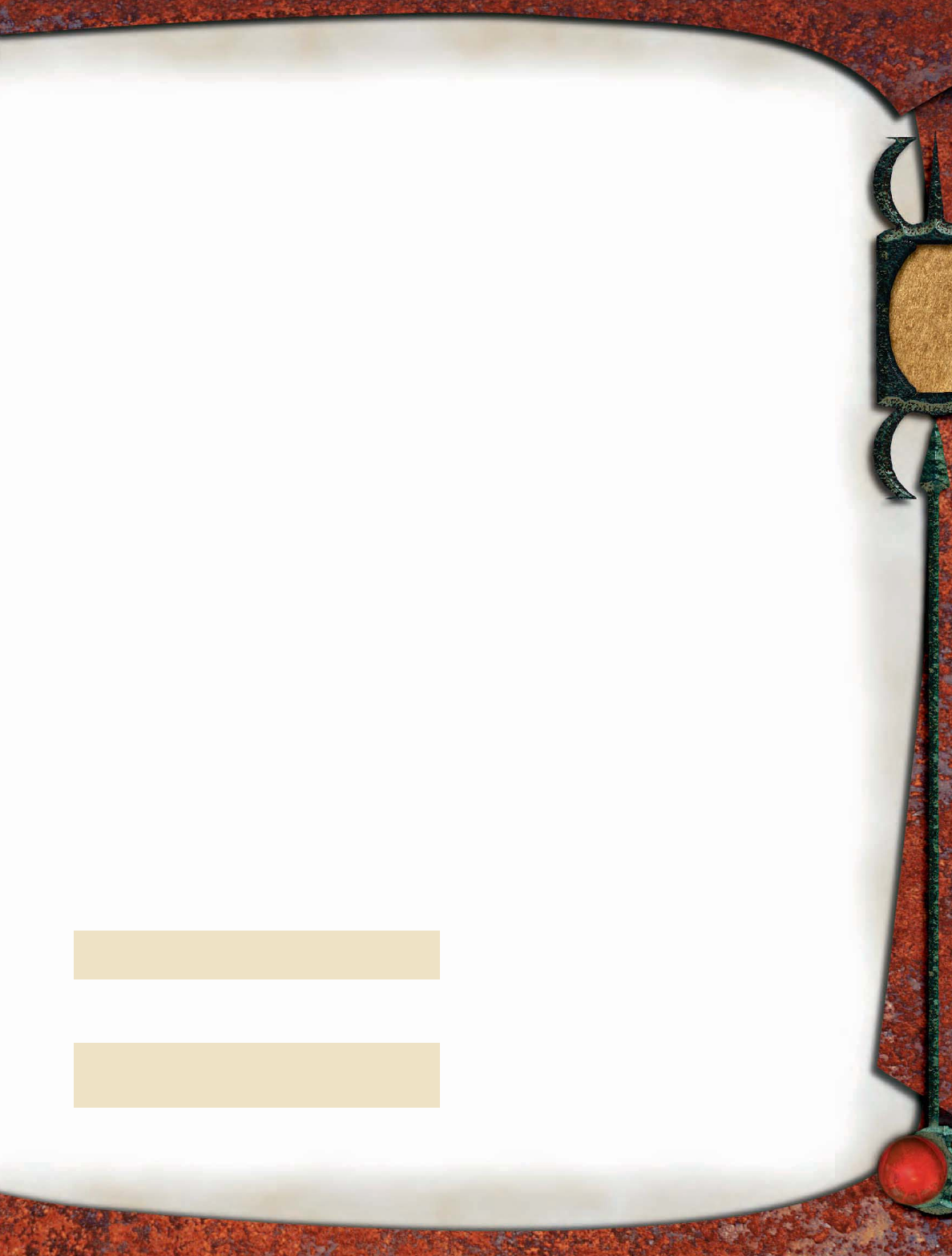
159
difficult for foes to follow, such as a steep mine shaft or a
rubble-filled corridor. If this tactic proves successful, the
serpentir continues to stalk the group, attacking in the
same way at the next opportunity.
If cornered or forced to fight, a serpentir does not shy
away from battle. It moves quickly as one move action,
then brings five claw attacks to bear against individual tar-
gets, using its remaining standard and full-round actions.
A cornered serpentir faced with only a single creature
always attempts to grapple and draw that foe into its
churning ribs.
Sample Encounters
Serpentirs are made to serve the masters who created them.
They sometimes escape, however, slaying indiscriminately
as they roam free. Like bonespurs, they are rarely found in
large numbers.
Mine Killer (EL 4): Crews working in a local iron mine
recently broke through to a series of ancient catacombs, but
since the discovery, miners have begun to go missing. The
catacombs are the prowling ground of a serpentir that was
trapped in a cave-in centuries ago. Now free, it stalks anyone
foolish enough to enter the dark depths of the mine. The
serpentir uses the mine’s shafts to move about and stalk
anyone exploring its lair.
The Vampire’s Pets (EL 10): A noble-turned-vampire
(MM 250) named Dramethius Kobal has discovered two
serpentirs in a vault beneath his family’s estate. The 5th-
level human fighter vampire’s new favorite pastime is
to invite strangers traveling through the region to take
respite at his manor. He then turns his serpentirs loose and
enjoys the show in bat form or gaseous form. The serpen-
tirs begin hunting the PCs as soon as Kobal’s dominated
servants show the characters to their chambers. If either
serpentir is slain, Dramethius and his three vampire
spawn attack.
Ecology
A serpentir is born with a hunger it can never satisfy. Com-
pelled to devour living prey, these creatures are then forced to
watch their mangled meals drop through empty ribs, leaving
them eternally ravenous.
The skull lords created serpentirs, but their uncontrol-
lable urge for slaughter has led a lot of these creatures to
escape their servitude. Necromancers have since learned
the art of creating these menaces, and chaotic necromantic
cabals spawn such dangerous predators as implements of
mindless terror.
Environment: Serpentirs favor underground environ-
ments, and they are spawned with an innate understanding
of the subterranean world. Their urge to feed on the living
leads a large number of free serpentirs to seek hunting
grounds near humanoid settlements. Mines are a favored
habitat, as are the sewer tunnels beneath human cities.
Graveyards riddled with catacombs, shantytowns built
around twisting alleyways, and abandoned castles make
good serpentir lairs.
Typical Physical Characteristics: A serpentir consists
of a number of skeletal torsos linked together spine to spine,
forming a serpentlike mass of twisting ribs and vertebrae
some 15 feet long and weighing 300 pounds. At each end,
the creature bears a skull and two long arms with clawed
hands. The prehensile ribs of a serpentir click softly as they
undulate, shifting like the myriad legs of a centipede. Bits
of decaying fl esh and shreds of rotten cloth cling to the
creature’s jagged bones, remnants of its previous unsatisfy-
ing meals.
Alignment: Though created to serve, serpentirs are driven
to near-madness by their insatiable hunger. Even when under
the direction of a skull lord or a spellcaster, they are uniformly
chaotic evil.
Typical Treasure
Serpentirs care nothing for material wealth. Though they
ignore the possessions of their shredded meals, jewelry
or weaponry occasionally becomes wedged between these
creatures’ ribs. Other treasure left behind by a serpentir’s
victims typically litters its hunting grounds. They have
standard treasure for their Challenge Rating, strewn over
a wide area.
For Player Characters
A spellcaster of 10th level or higher can create a serpentir
using the create undead spell. Creating a serpentir requires
skeletal remains equivalent to six Medium creatures.
pqqqqqqqqqrs
SERPENTIR LORE
Characters who have ranks in Knowledge (religion) can learn
more about serpentirs. When a character makes a successful
skill check, the following lore is revealed, including the infor-
mation from lower DCs.
Knowledge (Religion)
DC Result
14 Serpentirs are dreadful snakelike undead formed
from several skeletons. This result reveals all
undead traits.
19 Serpentirs are deadly hunters who can sense living
beings. They stalk prey before attacking, grabbing
foes and dragging them off to be devoured in the
darkness.
24 A serpentir’s ribs act as prehensile legs, allowing
it to move at great speed. These ribs also form a
churning maw that can shred creatures trapped
within it.
pqqqqqqqqqrs
SKULL LORD
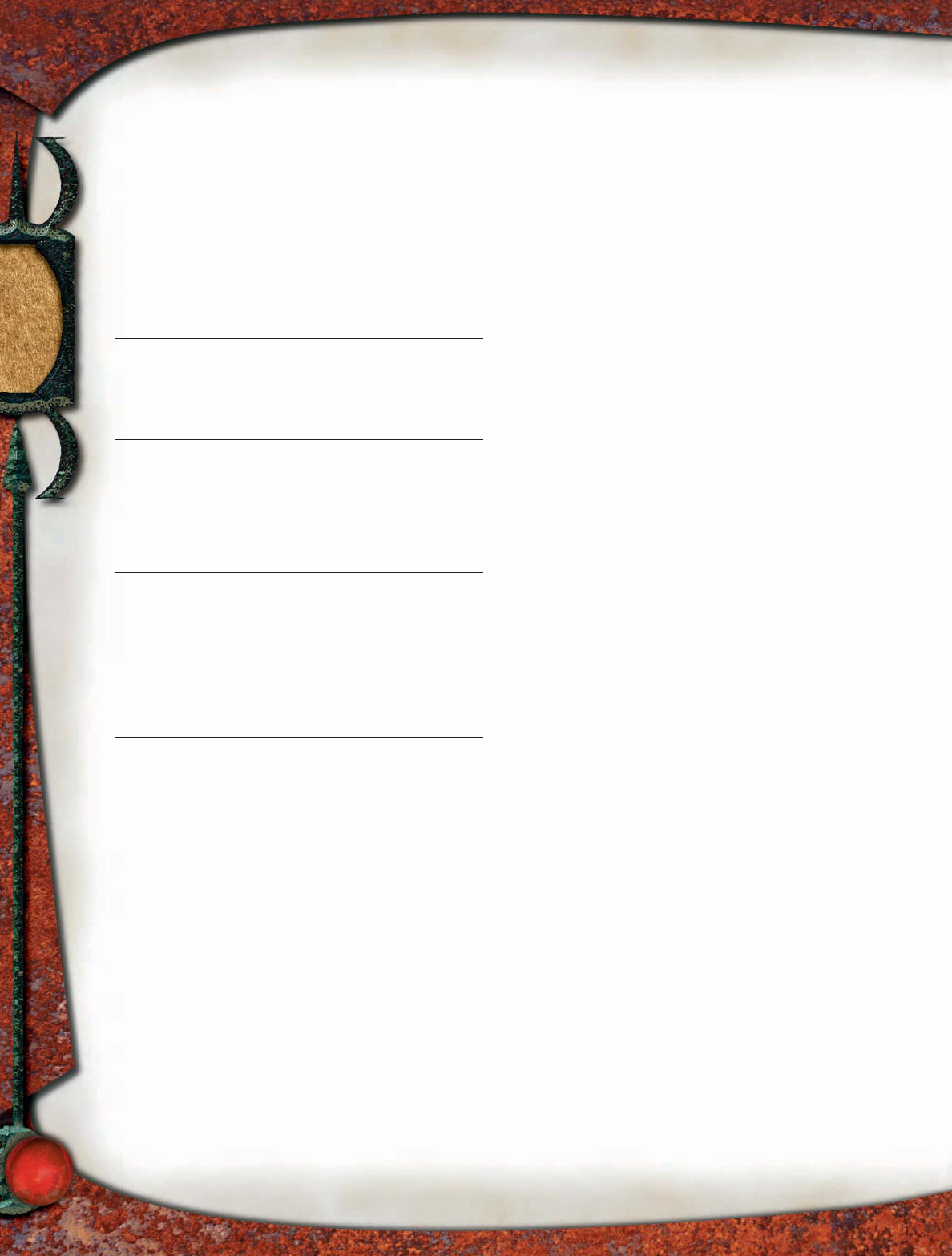
160
SPECTRAL RIDER
The fi gure approaching you appears as an aged knight clad in
ornamental full plate, but the images and crests on his armor are
twisted and malformed. A prancing lion is misshapen and sprouts
fi endish bat’s wings, and a fl oral coat of arms has become a twisted
mass of rotting black vines. In a skull-like face, the knight’s eyes
burn with a cold, unholy light.
Spectral Rider CR 6
Usually LE Medium undead
Init +2; Senses darkvision 60 ft.; Listen +2, Spot +10
Aura desecration (30 ft.), magic circle against good (10 ft.)
Languages Common, Infernal
AC 19, touch 11, flat-footed 18; 23, touch 15, flat-footed 22
using ghost shift
(+1 Dex, +8 armor, +4 deflection using ghost shift)
hp 45 (7 HD); DR 10/bludgeoning
Immune cold, undead immunities
Fort +2, Ref +4, Will +7
Speed 20 ft. (4 squares) in full plate, base speed 30 ft.
Melee longsword +8 (1d8+6/19–20) or
Melee defiling touch +7 (1d6+4)
Space 5 ft.; Reach 5 ft.
Base Atk +3; Grp +7
Atk Options Mounted Combat, Power Attack, smite good
1/day (+4 attack, +7 damage), unholy strike
Special Actions phantom steed, shroud of living days
Abilities Str 18, Dex 14, Con —, Int 12, Wis 15, Cha 19
SA defiling touch, phantom steed, smite good, shroud of
living days, unholy strike
SQ undead traits
Feats Mounted Combat, Power Attack, Weapon Focus
(longsword)
Skills Bluff +12, Diplomacy +14, Disguise +12 (+14 acting),
Intimidate +16, Listen +2, Ride +10, Spot +10
Advancement 8–20 HD (Medium)
Possessions full plate, longsword
Desecration Aura (Su) As the desecrate spell; continuous;
caster level 7th. This aura also causes holy symbols of
good-aligned deities to dissolve into an acidic spray of
noxious gas. Attended holy symbols are allowed a DC 17
Will save against this effect. Anyone within 5 feet of an
affected holy symbol takes 1d6 points of acid damage.
Magic Circle Against Good (Su) As the magic circle against
good spell; continuous; caster level 7th. A spectral rider’s
magic circle is continuously active but can be suppressed
by dispel magic. The spectral rider can activate it again as
a free action on its next turn.
Ghost Shift (Su) A spectral rider and its equipment can
become incorporeal as an immediate action when it
moves. It becomes corporeal at the end of its move.
When incorporeal, a spectral rider gains a +4 deflection
bonus to AC due to its Charisma bonus, but it doesn’t
lose its armor bonus to AC.
Defiling Touch (Su) A spectral rider that hits a target with a
melee touch attack deals damage equal to 1d6 points +
its Cha bonus.
Unholy Strike (Su) A spectral rider’s touch and any weapon it
wields deals an extra 2d6 points of damage against good
creatures.
Phantom Steed (Su) As the phantom steed spell; at will;
caster level 7th. A spectral rider can use this ability as a
swift action. Its steed also becomes incorporeal when a
spectral rider uses its ghost shift ability.
Shroud of Living Days (Su) At will, a spectral rider can appear
as it did in life. This is an illusion, but only true seeing
reveals the spectral rider’s hideous undead form.
Spectral riders act as elite bodyguards and retainers to their
skull lord masters.
Strategies and Tactics
In combat, spectral riders prefer to let lesser undead minions
go before them. They then often summon their phantom
steeds and charge while incorporeal into the back ranks of the
enemy to attack spellcasters. However, spectral riders target
paladins and divine spellcasters who are obviously good-
aligned fi rst in any fray. Their contempt for such opponents
is extreme, as is their fear of the power these foes bring to
bear against evil creatures and undead.
Whether engaging single foes or small groups, spectral
riders delight in deceit and betrayal. They use their shroud
of living days ability to approach, then offer a hand in friend-
ship, subsequently attacking with their defi ling touch. Once
melee is joined, spectral riders lay into opponents—they save
smite attacks for the most powerful good characters.
Sample Encounter
Each spectral rider is born of particular circumstances, and
encounters with a rider can play into an extensive back story.
Due to the method of a rider’s creation, instances when more
than one appears are rare.
Fallen Champion (EL 6): Sir Drevamor Tain was one
of the most famed knights of his day. A vision of youth,
strength, and beauty, Tain was cut down in the early days of
his adventuring career. But his example inspired his sons to
become the fi nest knights of the realm.
Now, three hundred years later, a skull lord has defi led
Sir Drevamor’s tomb and raised the long-dead knight as a
spectral rider. Tain patrols the region his family protected
for generations, his true nature concealed by his shroud of
living days. The common folk believe Tain to be a hero come
to fi ght the evil sweeping across their land. Sadly for them,
the spectral rider plans to deliver as many innocent victims
as possible to the skull lord.
Ecology
Spectral riders are knights of the skull lords. Blackguards
and evil knights are the individuals who most commonly
become spectral riders after death. However, even the holi-
est of paladins can be polluted by foul necromantic magic
and twisted into these dark warriors. The rituals that create
a spectral rider involve unspeakable desecrations of the
corpse. In the case of paladins or holy knights, deception is
used to lure the spirit back to its body, binding a pure soul
to tainted dead fl esh.
Environment: Spectral riders serve at their master’s plea-
sure, and they go where they are sent. If freed from service,
spectral riders haunt their ancestral lands or the place where
they were slain, spreading evil and death wherever they go.
SKULL LORD
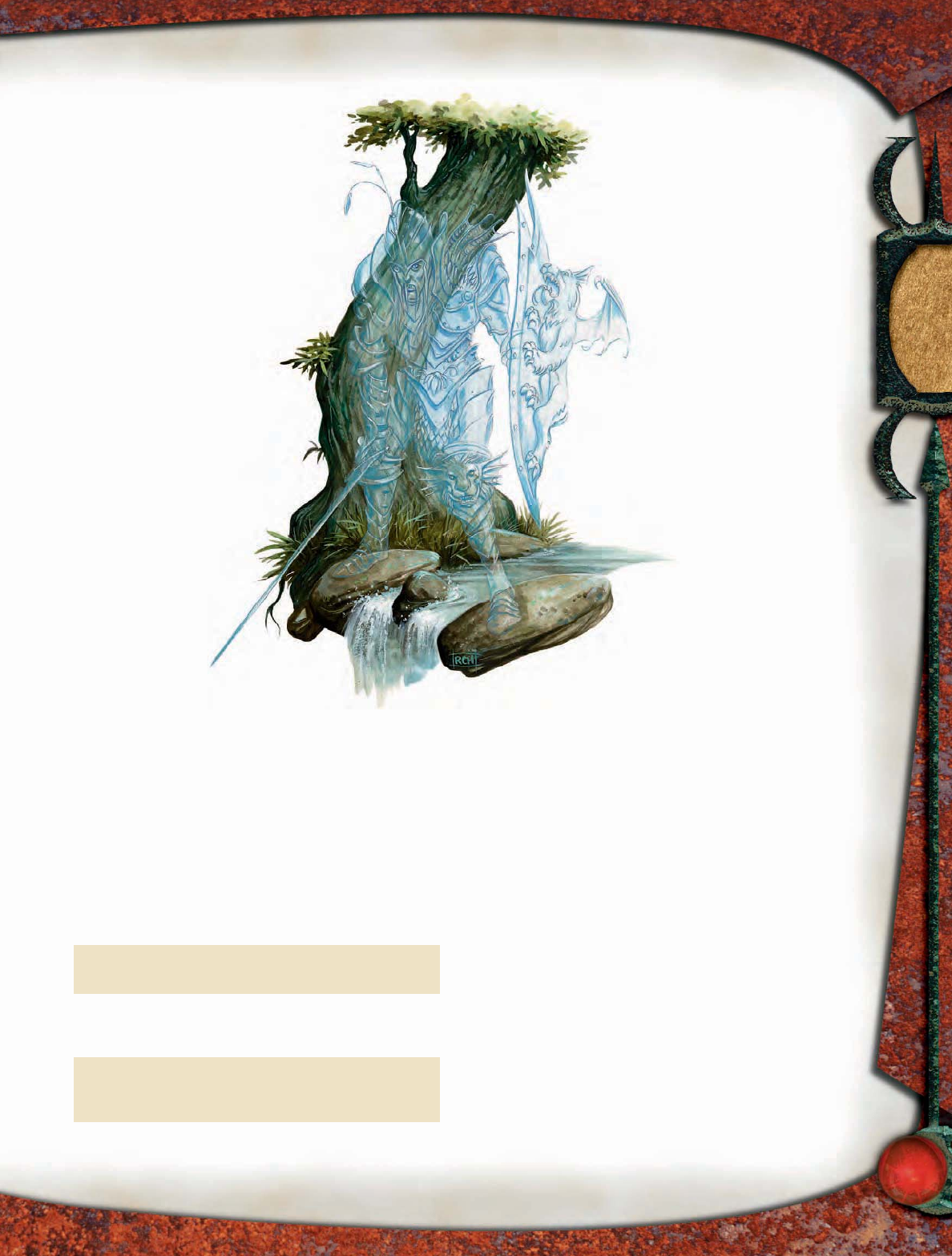
161
Typical Physical Characteristics:
When not hidden behind their shroud
of living days, these mournful undead
knights can be identifi ed by the ghostly
skull-like visage within their helms. Their
armor resembles what the individual wore
in life, but it is studded with spikes and
barbs. Coats of arms are twisted into mock-
eries of their original form, with honorable
crests and emblems besmirched by evil.
Spectral riders average 6 feet in height,
but their skeletal forms weigh only
40 pounds.
Alignment: Spectral riders
believe in order and disci-
pline, and they enjoy lording
their power and infl uence over the
lesser minions of their masters.
They reluctantly bow to authority,
willingly serving necromancers or
skull lords if this service gives them
a chance to spread wickedness
among the living. They are
almost always lawful evil.
Society
Spectral riders are bound
to the master who cre-
ated them, and they
are unifi ed by a con-
temptible hatred of
the living. This hatred manifests in a vi-
cious need to corrupt other mortal knights
and send them to their graves, ensuring that
the ranks of undeath always have new recruits.
All spectral riders take great pleasure
in employing deception and trickery,
even those who were paragons of
good when they lived. Spectral riders
created from paladins and good knights
relish the irony of their newfound taste
for deceit.
Typical Treasure
Spectral riders gather their
former family heirlooms and
treasures for themselves. They
have double standard treasure
for their Challenge Rating,
usually in the form of jew-
els, art objects, and treasured
magic arms and armor.
For Player Characters
A spellcaster of 12th level or higher can create
a spectral rider using a create greater undead
spell. The PC must fi nd a suitable subject
corpse—a mounted warrior of at
least 6th level at the time
of his or her death.
SKULL LORDS
IN EBERRON
From their appearance alone, the
skull lords are typically assumed to
be agents of Vol the lich queen. In fact,
the skull lords are some of Vol’s most potent
foes, seeking vengeance against the self-styled
Queen of the Dead for allowing the power
of undeath to be controlled by her living servants. Skull
lords operate independently across Khorvaire, engaging in
schemes to raise Vrakmul, as well as opposing the Order of
the Emerald Claw and the Blood of Vol cult.
SKULL LORDS IN FAERÛN
The Battle of Bones is a popular destination for Faerûn’s
necromancers, and it is rumored that the fi rst skull lords
were spawned in that cursed place. Today, necromancers who
create bonespurs and serpentirs are drawn to the bleached
bone-drifts of these lifeless fi elds. The faithful of Velsharoon
are rumored to be creating great forces of serpentirs there
for their own dark purposes.
The skull lords are said to hold their infrequent meet-
ings at the Battle of Bones, typically in deepest winter. In
the weeks before these unholy assemblies, spectral riders
are seen ranging from the High Forest to the Dragonmere,
and everyone fears their passage. The purposes of the
skull lords are inscrutable, though, and their meetings
are brief.
pqqqqqqqqqrs
SPECTRAL RIDER LORE
Characters who have ranks in Knowledge (religion) can learn
more about spectral riders. When a character makes a suc-
cessful skill check, the following lore is revealed, including the
information from lower DCs.
Knowledge (Religion)
DC Result
16 Spectral riders are elite undead knights in the service
of skull lords or powerful necromancers. They ride
ghostly steeds that they can summon at will.
21 These dark knights spread desecration with every
step, and they can assume a ghostly incorporeal form
as they move. They are protected against goodness,
and their weapons are made unholy by their touch.
26 Spectral riders can slay creatures with a mere touch,
and good creatures fall more easily to this defi lement.
They can assume the guise of their former mortal
form to deceive those they seek to destroy.
pqqqqqqqqqrs
Spectral rider
SKULL LORD
Illus. by R. Horsley

162
SPAWN OF JUIBLEX
For untold millennia, the demon lords Zuggtmoy and
Juiblex have struggled for control of Shedaklah, the 222nd
layer of the Abyss. Centuries ago, Zuggtmoy used a series
of powerful divinations to determine the Demon Lord of
Ooze’s exact location within Shedaklah. She then erected a
series of adamantine plinths throughout the Abyssal layer
and triggered a powerful ritual meant to banish Juiblex to
a different plane.
Unfortunately for Zuggtmoy and the rest of the cosmos,
the ritual simply sent a portion of Juiblex’s polluted form
to the Elemental Plane of Water. Though weakened, the
Faceless Lord survived, but the toxic and virulent nature
of his material form corrupted the elemental matter
around it. The denizens of the plane near this polluted
area combined their power to contain the corruption and
send it to its own demiplane. Though this process was
successful, it scattered the spawn of Juiblex across the
Material Plane.
LESSER SPAWN OF JUIBLEX
A giant mass of dark liquid rears upward, its surface heaving as
it spatters the area around it with globs of slime. Dozens of small
red eyes dot the creature’s surface, glaring at you like beacons of
hunger and hate.
Lesser Spawn of Juiblex CR 6
Always CE Large elemental (extraplanar, water)
Init +1; Senses blindsense 60 ft., darkvision 60 ft.; Listen +7,
Spot +6
Languages Aquan
AC 18, touch 10, flat-footed 17
(–1 size, +1 Dex, +8 natural)
hp 68 (8 HD); DR 5/—
Immune elemental immunities
Fort +10, Ref +3, Will +3
Speed 40 ft. (8 squares), climb 30 ft.; sludge form
Melee 2 slams +12 each (2d8+7 plus slimy infestation)
Space 10 ft.; Reach 10 ft.
Base Atk +6; Grp +17
Atk Options Cleave, Power Attack
Abilities Str 25, Dex 12, Con 19, Int 4, Wis 13, Cha 10
SA slimy infestation, sludge form
SQ elemental traits
Feats Cleave, Improved Natural Attack (slam), Power Attack
Skills Climb +15, Jump +11, Listen +7, Spot +6
Advancement 9–12 HD (Large)
Sludge Form (Ex) A spawn of Juiblex flows like thick, muddy
water as it moves. Its movement never provokes attacks
of opportunity. It ignores difficult terrain and can freely
pass through other creatures’ spaces, though it cannot
end its movement in such a place.
If a lesser spawn of Juiblex enters a living
creature’s space, that creature must attempt a DC 18
Fortitude save. On a failed save, the creature takes
2d6 points of damage and is sickened for 1 round. On
a successful save, the creature takes half damage and
is not sickened.
This ability is effective against a given creature only
once per round. The save DC is Constitution-based.
Slimy Infestation (Su) When a spawn of Juiblex deals damage
to a creature with its slam attack, it covers its target with
a thick coat of slime. At the start of the spawn’s turn, it
can animate the slime covering all foes within 100 feet
as a free action. The slime sprouts tentacles and attacks
any creature within 10 feet (including the target if no
other creatures are in reach). It makes a slam attack with
an attack bonus equal to the spawn’s (normally +12),
dealing damage equal to 1d8 points + 1/2 the spawn’s Str
modifier (normally +3).
A creature afflicted by slimy infestation can remove
the slime as a full-round action. The slime is also
destroyed if the creature it covers is dealt 10 points of
cold or fire damage. If that creature has resistance to cold
or fire, the slime could be destroyed without harm to the
affected creature.
Though they are the weakest of the Faceless Lord’s favored
children, lesser spawn of Juiblex are potent threats. These
massive elemental creatures wander through dungeons
and other desolate areas, killing and devouring all in
their path.
GREATER SPAWN OF JUIBLEX
This creature—if creature it is—wells up before you as a bubbling,
oozing mess of dark clotted liquid. Chunks of unnameable sludge
twist through its form, and its surface spatters and heaves. A single
red eye dominates its mass, and dozens of smaller eyes scattered
throughout its putrid form watch you.
Greater Spawn of Juiblex CR 10
Always CE Huge elemental (extraplanar, water)
Init +0; Senses blindsense 60 ft., darkvision 60 ft.; Listen +9,
Spot +9
Aura horrific presence (5 ft.)
Languages Aquan
AC 24, touch 8, flat-footed 24
(–2 size, +16 natural)
hp 126 (11 HD); DR 5/—
Immune elemental immunities
Fort +14, Ref +3, Will +5
Speed 40 ft. (8 squares), climb 30 ft.; sludge form
Melee 2 slams +16 each (3d8+10/19–20 plus slimy
infestation)
Ranged sludge orb +6/+1 (2d8+10 plus slimy infestation)
Space 15 ft.; Reach 15 ft.
Base Atk +8; Grp +26
Atk Options Cleave, Power Attack
Abilities Str 31, Dex 10, Con 24, Int 6, Wis 15, Cha 10
SA slimy infestation, sludge form
SQ elemental traits
Feats Cleave, Improved Critical (slam), Improved Natural
Attack (slam), Power Attack
Skills Climb +18, Jump +14, Listen +9, Spot +9
Advancement 12–15 HD (Huge)
Horrific Presence (Su) Any creature that starts its turn
adjacent to a greater spawn of Juiblex must succeed on a
DC 22 Fortitude save or be forced to move 10 feet away
from the monster. This movement does not provoke
SPAWN OF
JUIBLEX
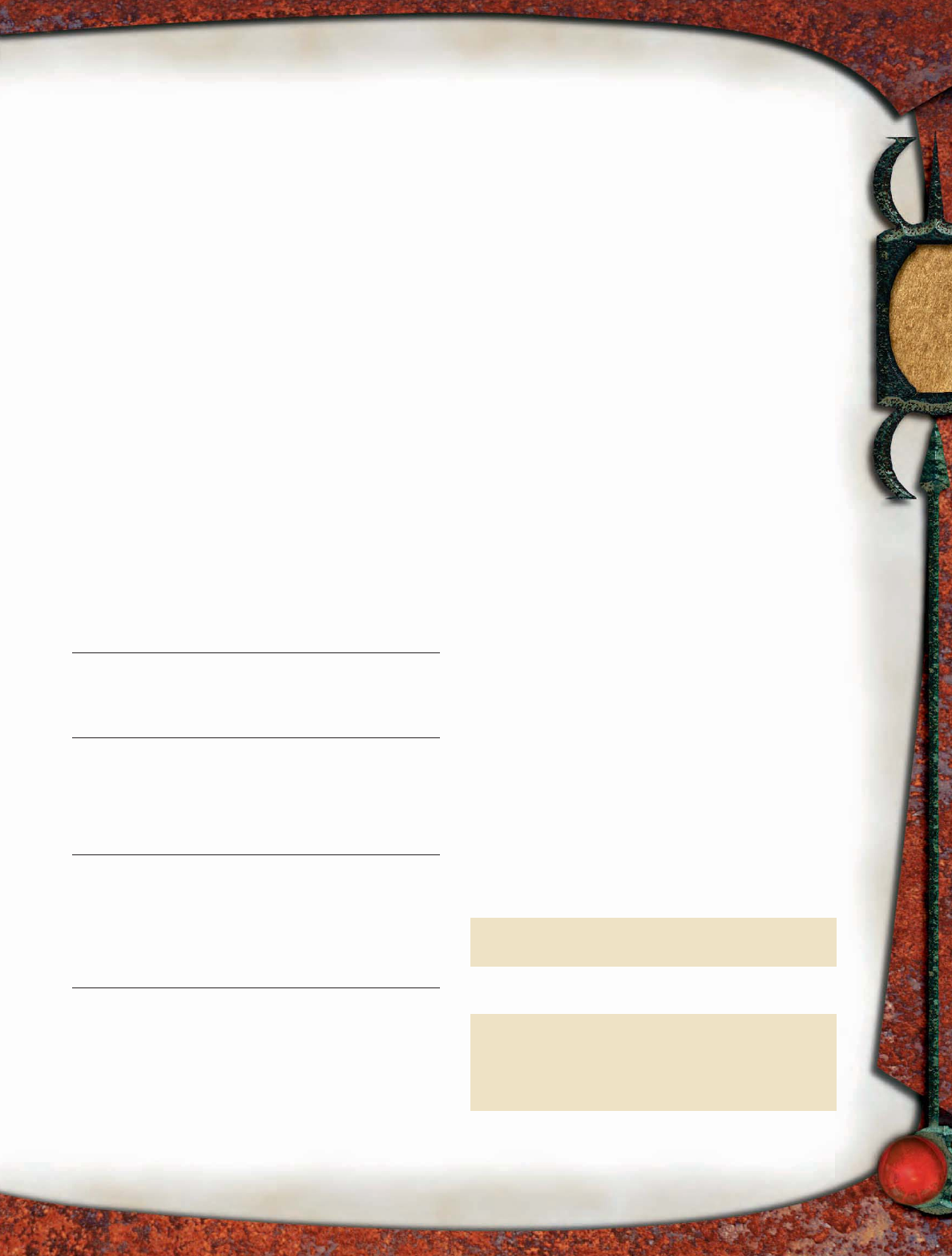
163
attacks of opportunity and does not count toward the
victim’s regular movement for the round.
A creature unable to move is dazed for 1 round if it
fails the save. The save DC is Constitution-based.
Sludge Form (Ex) As lesser spawn, but deals 4d6 points
of damage and 1 point of Con damage. The creature is
sickened for 1 round. Fortitude DC 22 to take half hit
point damage and negate the Con damage.
Slimy Infestation (Su) As lesser spawn, but tentacles deal
1d8+5 points of damage.
Sludge Orb (Ex) A greater spawn of Juiblex can fling globs of
effluvia up to five range increments. The range increment
is 20 feet.
Greater spawn of Juiblex resemble their lesser counterparts,
but they are rarer and far more dangerous. Slimy trails left in
deep tunnels sometimes hint at the presence of these beings,
and intelligent creatures stay far away from such areas.
ELDER SPAWN OF JUIBLEX
A hulking mass of tarry, steaming ooze rears impossibly high. Con-
vulsions wrack the surface of this enormous creature as it burbles
and spits chunks of its own matter into the air. Three large red eyes
are evenly set around its bulk, with dozens of smaller eyes spread
across the creature’s skin.
Elder Spawn of Juiblex CR 14
Always CE Gargantuan elemental (extraplanar, water)
Init +3; Senses blindsense 60 ft., darkvision 60 ft.; Listen +12,
Spot +11
Aura horrific presence (5 ft.)
Languages Aquan
AC 23, touch 5, flat-footed 23
(–4 size, –1 Dex, +18 natural)
hp 216 (16 HD); DR 10/—
Immune elemental immunities
Fort +19, Ref +6, Will +7
Speed 40 ft. (8 squares), climb 30 ft.; sludge form
Melee 2 slams +22 each (4d8+14/19–20 plus slimy
infestation)
Ranged sludge orb +7/+2/–3 (3d8+14 plus slimy infestation)
Space 20 ft.; Reach 20 ft.
Base Atk +12; Grp +38
Atk Options Cleave, Power Attack
Abilities Str 39, Dex 8, Con 29, Int 8, Wis 15, Cha 12
SA slimy infestation, sludge form
SQ elemental traits
Feats Cleave, Improved Critical (slam), Improved Initiative,
Improved Natural Attack (slam), Lightning Reflexes,
Power Attack
Skills Climb +22, Jump +18, Listen +12, Spot +11
Advancement 17–21 HD (Gargantuan)
Horrific Presence (Su) As greater spawn. Fortitude DC 27.
Sludge Form (Ex) As lesser spawn, but deals 6d6 points of
damage and 2 points of Con damage. The creature is
sickened 1 for round and knocked prone. Fortitude DC 27
to take half hit point damage, negate the Con damage,
and avoid being knocked prone.
Slimy Infestation (Su) As lesser spawn, but tentacles deal
1d8+7 points of damage.
Sludge Orb (Ex) As greater spawn, but the range increment
is 30 feet.
The world can be thankful that these largest and mightiest
spawn of Juiblex are rare. Whispered legends speak of these
creatures as vile masses bubbling up from forgotten caves to
consume whole towns. An elder spawn of Juiblex can blot
out the sun as it surges forward like a living wave. When it
is done, it leaves little more than ruins and scattered bones
behind it.
STRATEGIES AND TACTICS
Regardless of their intelligence, spawn of Juiblex display
an uncanny cunning. In ruins or inhabited areas, they
choose lairs that allow them to quickly launch themselves
at unsuspecting targets. Whether a lesser spawn spilling
out from behind a closed door or an elder spawn lingering
beneath the surface of a black lake, a spawn of Juiblex that
gains surprise attempts to use its sludge form to sicken
and harm all creatures unfortunate enough to stand in
its path.
When battle is joined, the spawn strike as many different
foes as possible to get the most out of its slimy infestation.
Greater and elder spawn even risk attacks of opportunity to
throw sludge orbs at distant targets to infest those adversar-
ies. Once engaged, these creatures use their sludge form
to move and sicken as many opponents as possible each
round, trusting in their considerable abilities to quickly
even the odds.
Greater spawn and elder spawn of Juiblex are intelligent
enough to distinguish between living creatures and nonliv-
ing ones such as undead and constructs. They typically ignore
the latter, but they defend themselves if attacked.
SPAWN OF
JUIBLEX
pqqqqqqqqqrs
SPAWN OF JUIBLEX LORE
Characters who have ranks in Knowledge (the planes) can
learn more about spawn of Juiblex. When a character makes a
successful skill check, the following lore is revealed, including
the information from lower DCs.
Knowledge (the Planes)
DC Result
16 This nauseating mass of toxic sludge is a spawn
of Juiblex. Though it resembles an ooze and has
demonic origins, it is an elemental creature.
21 If a spawn of Juiblex infests a dungeon, it lies in
ambush, waiting to spill into a passage or boil up
from a pool or fi ssure.
26 A spawn of Juiblex covers its opponents in a
slimy material that can animate and attack
independently. However, these creatures can
sicken and even kill foes by touch alone. In
battle, spawn simply fl ood past their prey like a
destructive wave.
pqqqqqqqqqrs
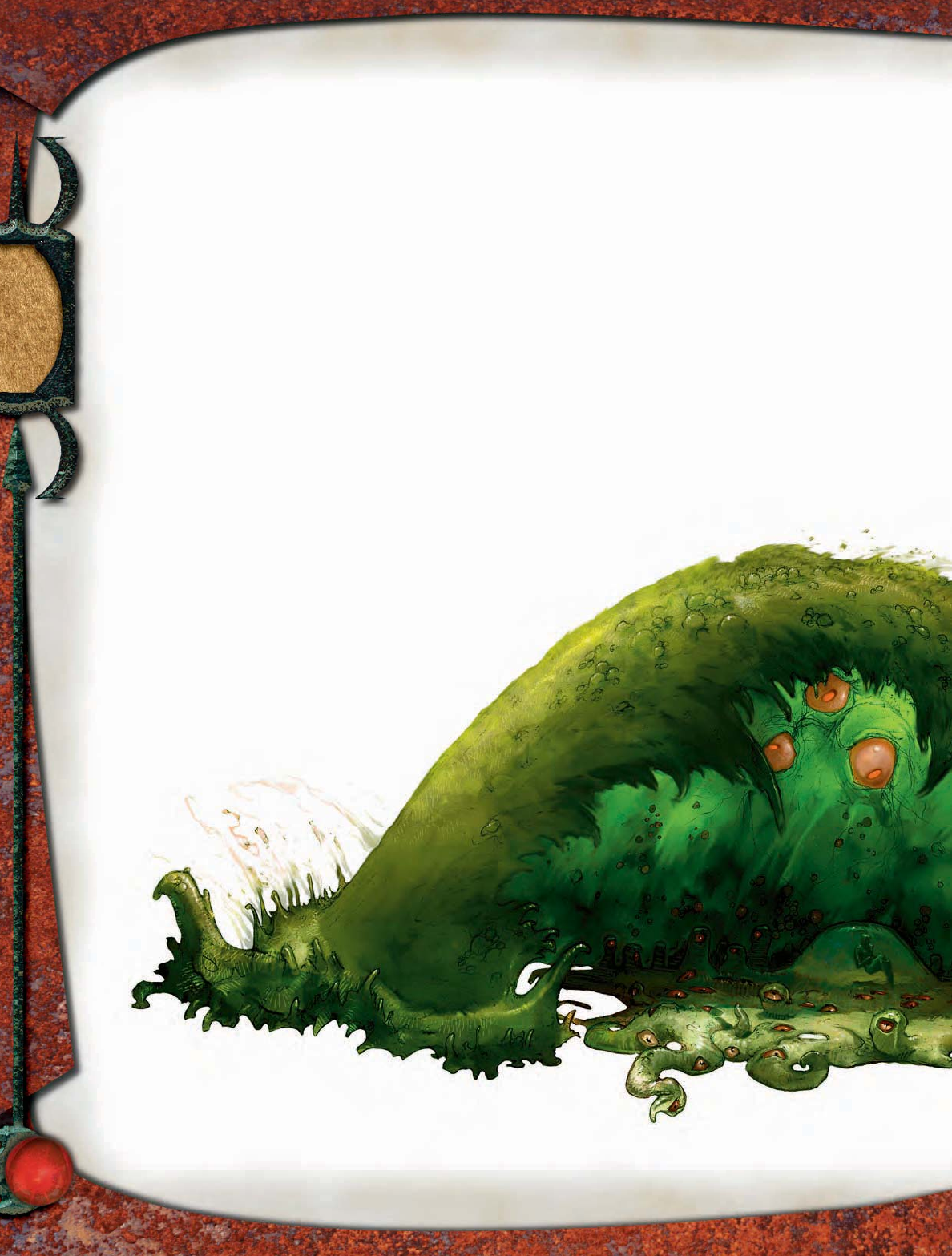
164
SAMPLE ENCOUNTER
Scattered as they are across the Material Plane, spawn of
Juiblex are usually encountered alone. Even when new
creatures are spawned from the old, they quickly go their own
way, driven to spread their destructive potential.
Lone Spawn (EL 6–14): Though spawn of Juiblex have
no direct connection to the Faceless Lord, they retain the
instinctual intellect of their progenitor. These creatures
are drawn to places of great power, including magical
locations, the resting places of lost artifacts, ancient
altars dedicated to mighty evil, or gates to the Abyss and
other planes.
EL 10: An isolated monastery comes under assault by
random bands of creatures from the Underdark. How-
ever, not until the catacombs beneath the monastery are
explored is it realized that these waves of monsters are
fleeing the presence of a greater spawn of Juiblex, drawn
to the presence of a powerful magic weapon guarded by
the monastic order.
ECOLOGY
The spawn of Juiblex have no place in the natural world, but
they are adept at destroying it. Once it has consumed enough
food, a spawn of any size splits off a new lesser spawn. Spawn
of Juiblex indiscriminately kill all other living creatures
except oozes and slimes.
Environment: Though spawn of Juiblex can survive in
almost any nondamaging environment, they keep to sub-
terranean passages and dungeons, retaining their demon
lord’s preference for underground lairs. Spawn prefer to
fight in tight, winding passages, since open ground
allows their prey to separate and attack from range.
All spawn of Juiblex are native to the Demiplane of Filth
(see below).
Typical Physical Characteristics: A spawn of Juiblex is
an oozelike entity that spreads in a rough circle. Its semi-
liquid form is a putrid green shot through with swirls of
black, brown, and yellow, constantly spurting and heaving
as it churns.
Lesser spawn are about 10 feet in diameter and weigh
approximately one and one-half tons. Greater spawn are 20
feet in diameter and can weigh ten tons. Elder spawn are 40
feet in diameter and weigh some sixty tons.
Alignment: All spawn of Juiblex carry the corrupt
essence of their progenitor lord. They are uniformly
chaotic evil.
TYPICAL TREASURE
Spawn of Juiblex have no need of treasure and do not collect
it. However, unlike the oozes it resembles, a spawn is not
acidic, and any treasure its victims were carrying remains
intact and scattered throughout its lair. In rare cases, a
spawn of Juiblex captures and holds treasure or magic
items within its heaving form. Such items are invariably
SPAWN OF
JUIBLEX
Illus. by A. Waters
Spawn of Juiblex
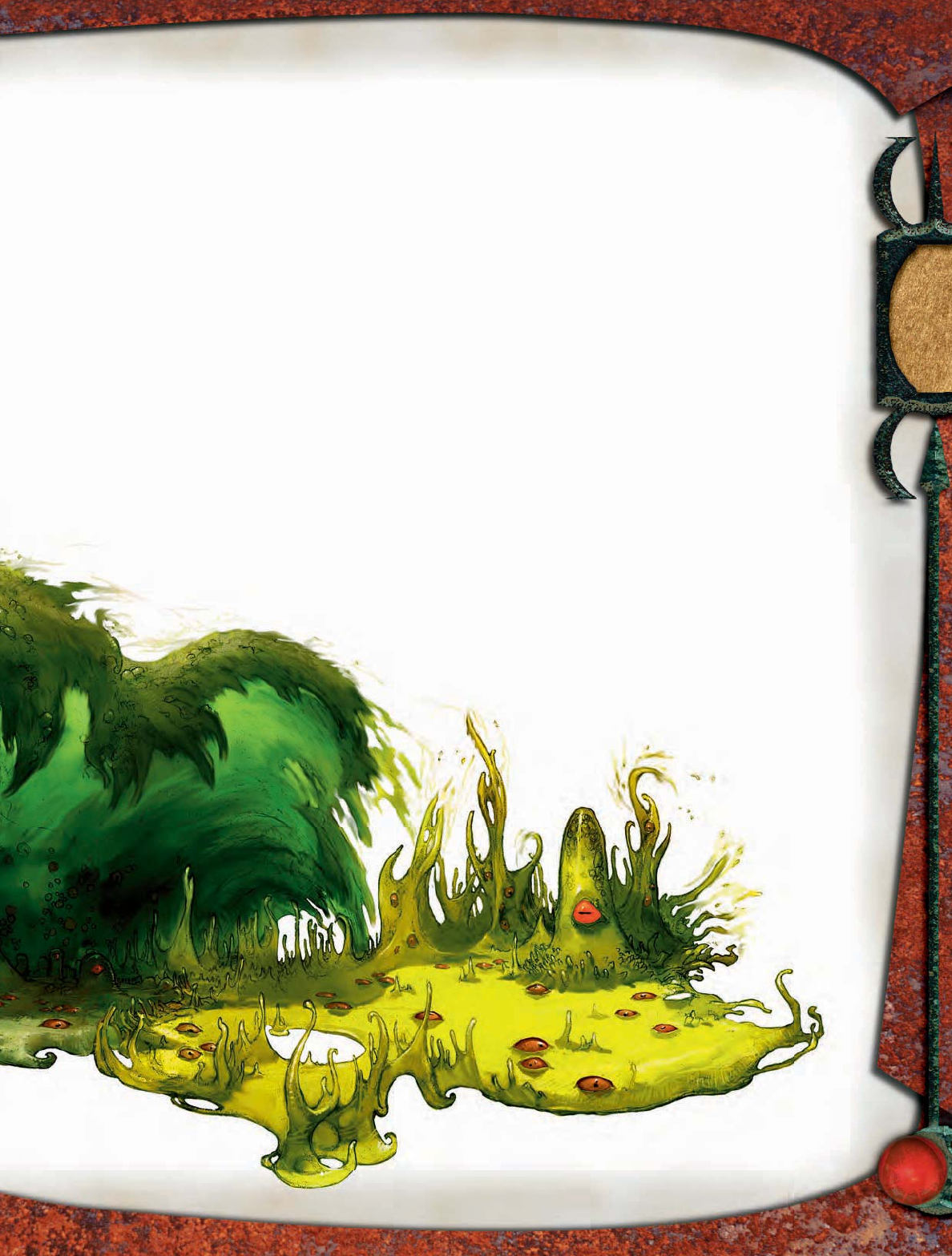
165
tied to Juiblex or are of potential benefi t to the Faceless
Lord’s plans. Spawn of Juiblex have half standard treasure
for their Challenge Rating.
ADVANCED SPAWN OF JUIBLEX
Spawn of Juiblex grow larger by devouring massive amounts
of organic matter. Though a spawn typically splits off a new
lesser spawn of Juiblex regardless of its own size, one of
these creatures sometimes simply continues to grow.
DEMIPLANE OF FILTH
This strange demiplane was formed when the denizens
of the Elemental Plane of Water banished the corruption
of Juiblex’s essence from their realm. The demiplane is
a mockery of a verdant forest, with trees and ground
formed of pulsating slime—some of which is green
slime. Streams and ponds of reeking watery ooze dot the
landscape. A green sun hangs in a yellow sky that darkens
by night to a featureless black curtain. Great clouds of
insects fill the air, and otyughs and other foul creatures
splash through the mire.
The Demiplane of Filth is 25 miles wide and 10 miles long.
At its center stands a stone monolith 50 feet on each side
and 400 feet tall. In a small hut atop the monolith dwells
a fi gure, appearing to be an elderly human male,
known simply as the Hermit. Made of a single
shard of Juiblex’s essence, the Hermit knows much of the
cosmos and the history of the Abyss. Those who agree to
complete a task for him can ask a single question.
The Hermit is an avatar of Juiblex. He answers questions
that further his master’s aims—namely to defeat Zuggt-
moy and avenge the insult done to the Faceless Lord. The
quests he sends adventurers on invariably involve Juiblex’s
enemies, though at times they have worked toward more
inscrutable ends.
When approached, the Hermit holds his eyes and mouth
closed, opening them when he is addressed. When they are
opened, green slime slowly leaks from them to devour his
body as the question is answered and the task is set. Yet the
next time a group enters his hut, the Hermit is there once
more, patiently awaiting visitors.
Oozes and spawn of Juiblex prowl the Demiplane of Filth,
as do those seeking Juiblex’s favor. Powerful cults to the
Faceless Lord build permanent gates to this wretched place,
conducting sacrifi cial rites here or luring away a powerful
creature to wreak havoc on the Material Plane.
SPAWN OF JUIBLEX IN EBERRON
In Eberron, Spawn of Juiblex are known as chaos spawn.
When the daelkyr invasion was overcome by the sealing
of the gates linking Eberron and Xoriat, destructive rifts
rippled through all the planes. Where the corrupting mad-
ness of Xoriat touched Lamannia, the Twilight Forest, it
created these terrible creatures and set them loose on the
Material Plane. Today, chaos spawn spread destruction and
madness in the depths of Khyber and the ruins of Eberron’s
lost civilizations.
SPAWN OF
JUIBLEX

166
SPIRRAX
A gigantic spiral shell fl ecked with dark metal fl oats menacingly
across the sky, a twisted mass of blue tentacles spilling from it. Each
of the tentacles ends in a swollen mass of black void. A single bulging
eye above them stares out with an alien hunger.
Spirrax CR 18
Always LE Gargantuan aberration (extraplanar)
Init +0; Senses sense emotions 300 ft.; Listen +30, Spot +30
Aura indifference (180 ft.)
Languages —
AC 30, touch 6, flat-footed 30; 50% fortification
(–4 size, +16 armor, +8 natural)
hp 299 (26 HD); DR 15/adamantine
SR 32
Fort +15, Ref +8, Will +16
Speed 20 ft. (4 squares), fly 50 ft. (perfect); Flyby Attack
Melee 6 tentacles +27 each (2d6+11/19–20)
Space 20 ft.; Reach 15 ft. (20 ft. with tentacles)
Base Atk +19; Grp +42
Atk Options Cleave, Great Cleave, Improved Bull Rush,
Improved Sunder, Power Attack, consumption,
improved grab
Special Actions death spiral, void blast
Spell-Like Abilities (CL 26th):
At will—plane shift (self only)
Abilities Str 32, Dex 10, Con 25, Int 15, Wis 13, Cha 14
SA consumption, death spiral, improved grab, spell-like
abilities, void blast
SQ adamantine shell, putrid form
Feats Ability Focus (indifference aura), Cleave, Flyby Attack,
Great Cleave, Improved Bull Rush, Improved Critical
(tentacle), Improved Sunder, Power Attack, Weapon
Focus (tentacle)
Skills Knowledge (the planes) +31, Listen +30, Move
Silently +29, Spot +30, Survival +1 (+5 on other planes)
Advancement 27–40 HD (Gargantuan)
Sense Emotions (Su) This ability functions like blindsense,
except that a spirrax can detect only the presence and
positions of living creatures.
Indifference Aura (Su) At the end of each of a spirrax’s
turns, creatures within 180 feet of it must succeed on
a DC 27 Will save or be affected by calm emotions, as
the spell. In addition, creatures that fail their saves
can move no more than double their speed each
round. This effect lasts as long as a creature remains
within the area or until it is attacked by the spirrax.
A successful save negates the effect. The save DC is
Charisma-based.
A creature that successfully saves or is attacked by a
spirrax cannot be affected again by that same spirrax’s
aura for 24 hours.
Fortification (Ex) 50% chance to ignore the additional
damage dealt by a critical hit or sneak attack.
Consumption (Su) Living creatures successfully grappled by
a spirrax take 1d6 points of Constitution drain.
Improved Grab (Ex) To use this ability, a spirrax must hit with
a tentacle attack. It can then attempt to start a grapple
as a free action without provoking attacks of opportunity.
If it wins the grapple check, it establishes a hold and can
use its consumption ability in following rounds.
Death Spiral (Su) When a spirrax dies, a planar rift opens up
around it for 1d4 rounds, sucking everything within 150
feet to another plane of existence (determined randomly).
A DC 25 Will save negates this effect.
As long as the rift remains open, a creature that
succeeds on its save can choose to enter it—typically to
follow comrades who have failed their saves. After this
time, the rift seals permanently, taking the body of the
spirrax with it.
Void Blast (Su) 120-foot line or 30-foot-radius burst, once
every 1d4 rounds, damage 30d6, Reflex DC 30 half. Those
reduced to 0 or fewer hit points by this blast leave behind
only a fine powder, but their equipment is unaffected.
The save DC is Constitution-based.
Adamantine Shell (Ex) A spirrax is surrounded by an organic
shell laced with adamantine. This shell grants a +16
armor bonus, DR 15/adamantine, the ability to fly, and
50% fortification. The shell can be used only by a spirrax.
When a spirrax is reduced to one-quarter of its full
normal hit points or fewer, its shell collapses, causing the
creature to lose the benefits provided by the shell.
Putrid Form (Ex) When a spirrax’s adamantine shell
collapses, its normal form—a mass of tentacles,
putrescent alien organs, and a single bulging eye—is
revealed. Any living creature that comes within 10 feet of
a spirrax in its putrid form is sickened. In addition, that
creature must succeed on a DC 30 Fortitude save or be
nauseated for 1 round.
A spirrax in its putrid form gains two additional
tentacle attacks when making a full attack.
Spirraxes wander the planes, consuming all living matter
they come across. Whole worlds are said to have been laid
waste as a result of their insatiable hunger.
STRATEGIES AND TACTICS
Spirraxes approach all combat in the same calm, calcu-
lated way. A spirrax begins by using its void blast against
pqqqqqqqqqrs
SPIRRAX LORE
Characters who have ranks in Knowledge (the planes) can
learn more about spirraxes. When a character makes a suc-
cessful skill check, the following lore is revealed, including the
information from lower DCs.
Knowledge (the Planes)
DC Result
28 A spirrax is a titanic creature that inhabits a
metallic shell. It devours all life and organic
material in its path.
33 A spirrax seeks to seize its opponents in combat
and drain their vitality. Its shell is incredibly tough
and grants the creature powerful protection.
If enough damage can be dealt to the shell, it
collapses, leaving the creature easier to kill.
38 A spirrax radiates an unnatural aura that prevents
foes from fi ghting it or running away. It also
possesses an energy attack that can turn its
enemies to ash.
pqqqqqqqqqrs
SPIRRAX
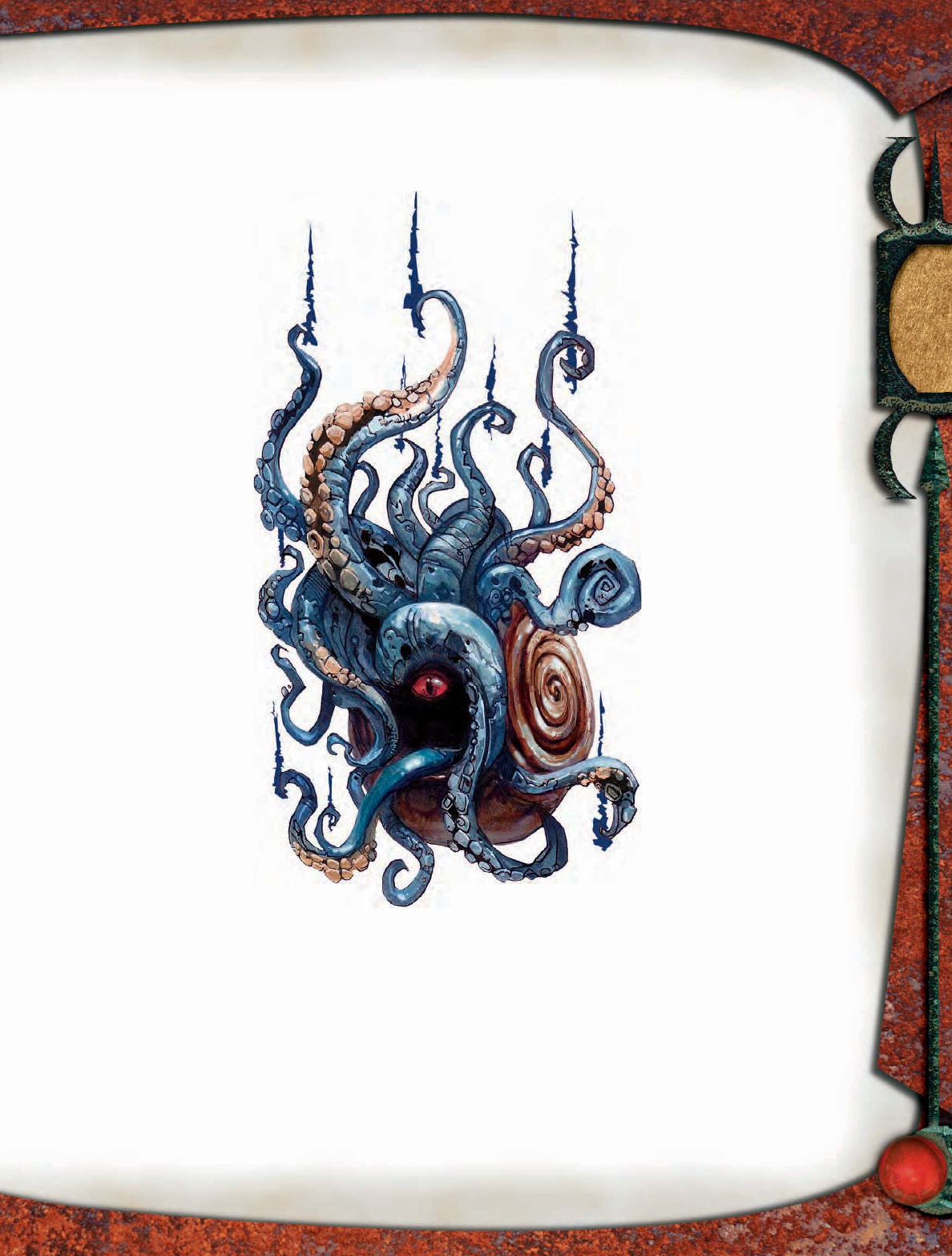
167
any enemies not affected by its indifference aura. It then
attempts to grapple active foes with its tentacles, allowing
its consumption ability to fi nish them off. If all targets are
affected by the spirrax’s indifference aura, it assaults one at
a time, attacking with four tentacles while attempting to
grapple with the other two.
If its adamantine shell collapses,
a spirrax continues to fi ght until
it takes damage once more. At
that point, it attempts to plane shift
back to its home plane to rest and
rebuild its shell.
SAMPLE
ENCOUNTER
Spirraxes can be encountered
anywhere except under-
ground. As a general rule, they
do not work together. How-
ever, when more than one
appears on a given world,
their destructive paths start
in the same area.
Into the Void (EL 18):
What was once a land of
verdant forests and fertile
farmsteads is now a dead
ruin. A spirrax appeared
here two weeks ago and
has slowly been consuming
everything in its widening
spiral of destruction. A few ref-
ugees have managed to escape
the creature, spreading tales of
the fl oating doom that seems
set to destroy the world.
ECOLOGY
Little is known of the spirraxes,
but these creatures do not ap-
pear to age or reproduce. Sages
believe that only a fraction of the
material a spirrax consumes is used to
nourish the creature, but what happens
to the rest of the living matter it destroys
remains unknown.
Though spirraxes do not sleep, these creatures go into
periods of inactivity for up to one month each year, float-
ing lazily through the sky with their tentacles drawn into
their shells.
Environment: Spirraxes can be found in aboveground
environments where living matter is abundant. When a
spirrax first appears in an area, it begins flying in a spiral
pattern, consuming all life it passes over. It leaves behind
it a swath of barren earth littered with metal and stone,
all wrought with strange spiral markings as a result of
the creature’s passing.
Typical Physical Characteristics: Beneath its shell, a
spirrax is a mass of tentacles and alien
organs. An average spirrax has a shell
22 feet long and tentacles of the same
length. The creature weighs twenty
tons on its own, combined with its
fifty-ton shell for a total weight of
seventy tons.
Alignment: A spirrax lives only
to collect matter in an orderly
and precise pattern, based on an-
cient principles (see Society). Its
alien mindset entertains no other
thoughts. These creatures are always
lawful evil.
SOCIETY
Spirraxes represent the last rem-
nants of a dying demiplane.
Millennia ago, the powerful
civilization that had arisen
there fell victim to a magi-
cal catastrophe that caused
its world to decay. The resi-
dents of this ancient society,
believing they were unable to save
themselves by any other means, cre-
ated the fi rst spirraxes and sent
them to other planes. These crea-
tures were designed to consume
living matter and transport it
back to the demiplane, where
that matter, converted to en-
ergy, might be used to halt
the destruction.
Spirraxes have no society.
Though they have been observed
encountering others of their kind, no
hint of communication between two or more
of them has yet been seen.
TYPICAL TREASURE
Spirraxes have no interest in treasure, though metal and stone
items in abundance can be found in their wake. A spirrax has
double standard treasure for its Challenge Rating. Half of
this treasure is in the form of coins, gems, and metal or stone
magic items left behind it, with the other half representing
the value of the 150 pounds or more of adamantine that can
be stripped from the dead creature’s shell.
Spirrax
SPIRRAX
Illus. by C. Critchlow

168
STEELWING
An immense avian form darkens the sky, its majestic shape somehow
incongruous with its plumage of dull gray. The noble bird’s crested
head arches back, and its screech shakes the earth. As it wings closer,
you see that its feathers glint with keen edges.
Steelwing CR 14
Usually N Huge magical beast (extraplanar)
Init +12; Senses low-light vision; Listen +9, Spot +15
Aura razorfeather shield (5 ft.)
Languages Common
AC 28, touch 16, flat-footed 20; Dodge
(–2 size, +8 Dex, +12 natural)
Miss Chance 20% (razorfeather shield)
hp 187 (15 HD); fast healing 15; DR 15/adamantine
Immune cold
Fort +16, Ref +17, Will +10
Speed 50 ft. (10 squares), fly 120 ft. (average); Flyby Attack,
Hover
Melee bite +22 (2d6+9) and
2 wings +20 each (1d8+4/17–20) and
2 talons +20 each (1d8+4)
Ranged 3 razorfeathers +21 each (1d8+9/17–20)
Space 15 ft.; Reach 15 ft.
Base Atk +15; Grp +32
Special Actions hail of razorfeathers
Abilities Str 28, Dex 26, Con 25, Int 6, Wis 16, Cha 18
SA hail of razorfeathers
Feats Dodge, Flyby Attack, Hover, Improved Initiative, Iron
Will, Multiattack
Skills Jump +17, Listen +9, Spot +15
Advancement 16–18 HD (Huge); 19–28 HD (Gargantuan)
Razorfeather Shield (Ex) A steelwing generates a storm
of razorfeathers around its body. At the beginning of a
steelwing’s turn, any creature within 5 feet of it takes
5d6 points of slashing damage. In addition, the storm
of whirling steel feathers gives a steelwing concealment
against any nonadjacent opponents.
Razorfeathers (Ex) Razorfeathers used at range veer toward
their target, negating any miss chances that otherwise
would apply. Due to razorfeathers, a steelwing’s wing
attacks and razorfeather attacks threaten a critical hit on
a 17–20.
Hail of Razorfeathers (Ex) As a standard action, a steel wing
can cast a 60-foot cone of its razorfeathers. Creatures
caught in the area must succeed on a DC 24 Reflex save
or take 15d6 points of slashing damage. A steelwing can
use its hail of razorfeathers attack every 1d4 rounds.
The damage dealt by a steelwing’s hail of
razorfeathers is 1d6 points per Hit Die. The save DC is
Constitution-based.
Steelwings are enormous avian creatures native to the Infer-
nal Battlefi eld of Acheron. As befi ts natives of that plane, they
are fi erce and deadly combatants, and their appearance on
the Material Plane is an ill omen.
STRATEGIES AND TACTICS
A steelwing fi ghts from the air whenever possible, attack-
ing creatures at range with its hail of razorfeathers. It uses
Flyby Attack to rain destruction down on an enemy party
before soaring out of range. If attacked by other flying
creatures, a steelwing uses ranged razorfeather attacks or
its devastating bite.
If facing powerful spellcasters or foes employing danger-
ous ranged attacks, a steelwing does not hesitate to close
to melee range, even dropping to the ground. There, it
makes full attacks and allows its razorfeather shield to
shred its foes.
SAMPLE ENCOUNTERS
Though steelwings have only minimal intelligence, their
connection to Acheron makes them cunning combatants.
Steelwings don’t appear in numbers greater than four indi-
viduals unless they are domesticated.
Unwelcome Nest (EL 16): A planar rift has pulled a mated
pair of steelwings and their egg from Acheron to the Material
Plane. The creatures have nested above a trade road through
a mountain pass. The disruption to merchant traffi c from
the creatures’ hunting threatens to throw the economies of
two kingdoms into chaos unless the PCs can overcome the
steelwings or fi nd a way to return the gigantic birds to their
home plane.
Egg Hunt (EL 17): A fl ight of three steelwings has come
to the Material Plane in search of an unscrupulous horizon
walker who made off with a precious steelwing egg. Enraged
by the theft, the steelwings accost the party when they
mistake one of the PCs for the horizon walker. Characters
can attempt to prove they had nothing to do with the theft
by reasoning with the steelewings. If the PCs offer to aid the
steelwings in their search, the characters might gain a brace
of powerful avian allies.
ECOLOGY
Steelwings are born on Acheron, where the metallic cubes
of Ocanthus and Tintibulus meet amid the whirling winds
pqqqqqqqqqrs
STEELWING LORE
Characters who have ranks in Knowledge (the planes) can
learn more about steelwings. When a character makes a suc-
cessful skill check, the following lore is revealed, including the
information from lower DCs.
Knowledge (the Planes)
DC Result
24 This powerful avian is a steelwing, a creature
native to the Infernal Battlefi eld of Acheron.
29 A steelwing can shoot its bladed feathers as
individual ranged attacks, or it can cast a cone of
razorfeathers to deal devastating damage. Though
it prefers to attack from the air, a steelwing fi ghts
with beak, wings, and talons if pressed.
34 A steelwing’s whirling shroud of razorfeathers
makes it all but impossible to approach, and the
tearing cloud can rip melee opponents to gory
shreds.
pqqqqqqqqqrs
STEELWING
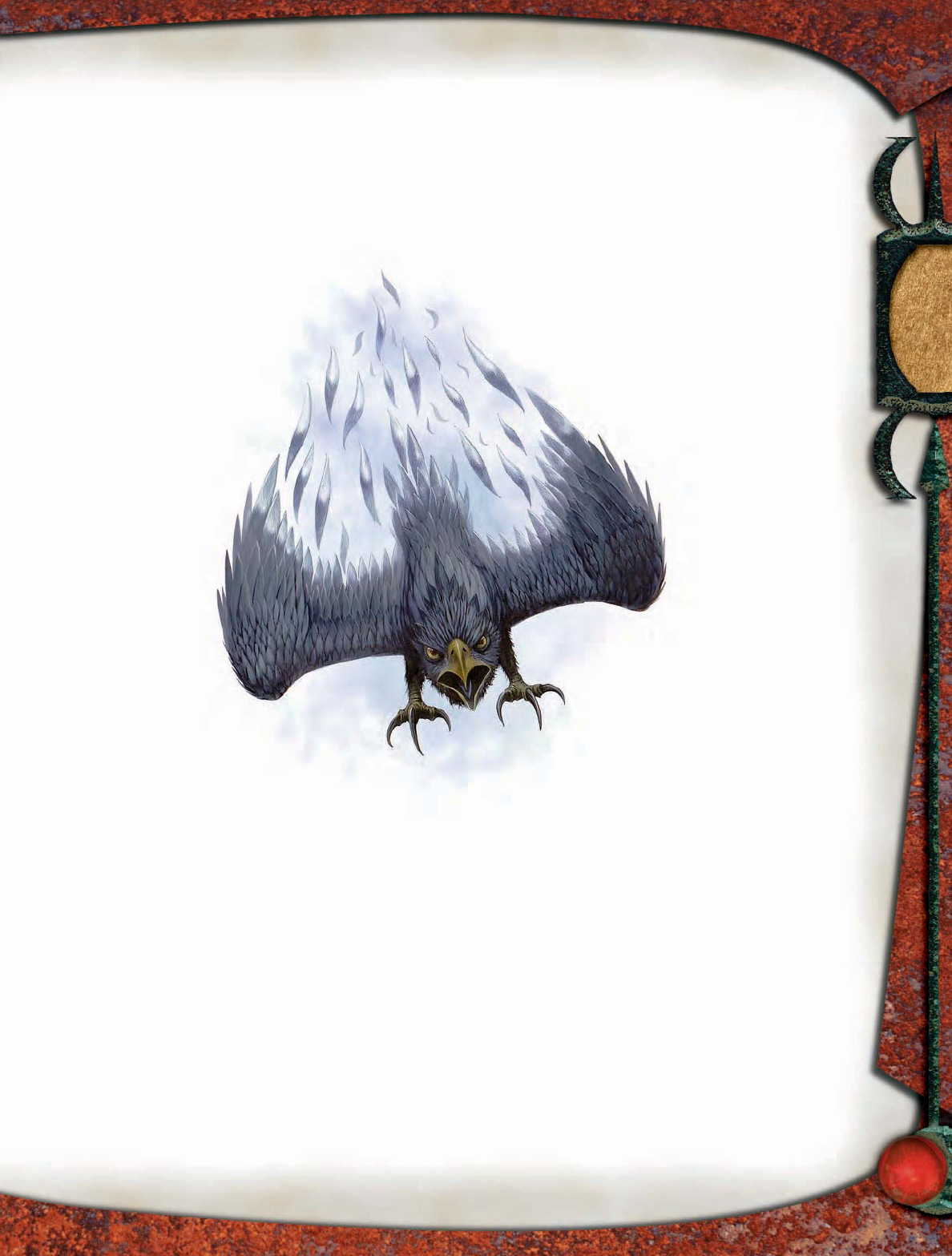
169
of the plane. They are sometimes called Acheron phoenixes
in honor of their home and their regal shape. Steelwings
roam the Infernal Battlefi eld freely, preying upon petition-
ers and visitors alike.
On Acheron, steelwings are predators and prey, as well
as tamed beasts of war. Hextor has gathered a great number
of steelwings in an aerie in Scourgehold, training them
to aid his aerial combat forces. Champions of Grummsh,
who hunt the steelwings for dangerous sport,
also seek after these creatures’ steely
razorfeathers.
Steelwings mate for life, and if a
steelwing’s mate is slain, the bird
of prey seeks out the murder-
ers and exacts grim vengeance.
Mated pairs construct nests
of twisted iron and steel on
Tintibulus. They guard their
eggs jealously, rarely vacating
the nest for fear of eggs
being cast out by the col-
lisions between cubes
common on the plane.
Dead steelwing eggs
are sometimes seen
fl oating in the airy
void of Acheron,
forever lost.
Environment:
Steelwings are most
commonly encoun-
tered on one of the
four layers of the Infer-
nal Battlefield of Acheron.
When they find their way to
the Material Plane, they are fre-
quently in the service of a powerful
spellcaster, on a mission from a master in
Hextor’s armies, or in pursuit of creatures
that have attempted to steal their eggs.
Typical Physical Characteristics: Despite its flat gray
hue, a steelwing is an impressive sight. With its crested
head and neck, and its long, steely tail feathers, a steelwing
cuts a fierce silhouette in the sky. The edges of its feathers
thin out to a razor-sharp edge, and they are as strong as
adamantine. A steelwing’s plumage molts continuously and
can regenerate in moments. Steelwing feathers that have
not yet molted are coveted for their value in the fashioning
of ammunition.
Adult steelwings are approximately 20 feet in length
with a 30-foot wingspan. They weigh two and one-half
tons. Their eggs are metal spheroids each the size of a small
cart. As their hatching time draws close, steelwing eggs begin
to tarnish and exude silver-gray dust.
Alignment: Steelwings are fi ercely dedicated to their
mates and young, but they eschew the confl icts of others.
They are almost always neutral.
TYPICAL TREASURE
Steelwings have no interest in treasure, but their razorfeath-
ers have great value. Razorfeathers are ruined when used in
a steelwing’s attacks or razorfeather shield, but characters
who defeat a steelwing in combat on the Material Plane
can remove 350 razorfeathers (worth 50 gp each; see
For Player Characters).
If a steelwing pair is killed on Acheron, an
egg makes up the bulk of their treasure, along
with 300 razorfeathers that can be reclaimed
from the roiling winds and tumbling
matter of that plane.
In any case, a steelwing
has standard treasure for its
Challenge Rating.
FOR PLAYER
CHARACTERS
Steelwings offer two pos-
sibilities for PCs.
Razorfeather Am-
munition: Razorfeathers
can be used to make master-
work arrows or bolts, with each group
of fi fty requiring a DC 30 Craft (weap-
onsmithing) check to construct. Such
ammunition is considered to be master-
work and adamantine, and to have the
keen weapon property.
Mounts: Hatching and raising a steel-
wing requires six months of work and a DC 35
Handle Animal check. Riding a steelwing re-
quires an exotic saddle worth 500 gp, built to
carry up to four Medium or smaller creatures, or two Large
creatures, and protect them from the creature’s razorfeather
shield. A steelwing can fi ght when carrying riders. All rid-
ers except the one guiding the steelwing can attack while
being carried, but the steelwing’s lead rider cannot also at-
tack without succeeding on a Ride check.
Steelwing eggs are worth 10,000 gp each on the open
market. Professional trainers charge 20,000 gp to hatch and
train a steelwing.
Carrying Capacity: A light load for a steelwing is up to 1,600
pounds; a medium load, 1,601–3,200 pounds; and a heavy
load, 3,201–4,800 pounds.
Steelwing
STEELWING
Illus. by W. England

170
THRYM HOUND
This creature resembles an enormous wolf, twice as tall as a human
at the shoulder. As it approaches, however, what you took to be fur
is revealed as spikes of icy stone. With glowing white eyes, the great
beast watches you intently.
Thrym Hound CR 10
Usually NE Huge magical beast
Init +1; Senses scent; Listen +11, Spot +8
Languages Common, Draconic, Orc
AC 39, touch 9, flat-footed 38
(–2 size, +1 Dex, +30 natural)
hp 175 (13 HD)
Resist cold 15
Fort +22, Ref +15, Will +15
Speed 40 ft. (8 squares)
Melee bite +19 (3d6+8) and
2 claws +18 each (2d6+4)
Space 15 ft.; Reach 10 ft.
Base Atk +13; Grp +29
Special Actions counterstrike, frigid stare
Spell-Like Abilities (CL 13th):
3/day—ice storm
Abilities Str 26, Dex 12, Con 27, Int 4, Wis 20, Cha 15
SA counterstrike, frigid stare, spell-like abilities
Feats Alertness, Multiattack, Skill Focus (Intimidate),
Quicken Spell-Like Ability (ice storm), Weapon Focus
(claw)
Skills Intimidate +22, Jump +12, Listen +11, Survival +9,
Spot +8
Advancement 14–32 HD (Huge); 33–39 HD (Gargantuan)
Saves Thrym hounds have a +6 racial bonus on saving
throws.
Counterstrike (Ex) Any adjacent creature that swings at a
Thrym hound and misses has a chance to be struck by
the creature’s spines. The Thrym hound receives a free
attack at +19 on the attack roll, dealing 1d8+4 points of
damage if it hits.
Frigid Stare (Su) 60-foot line, once every 1d4 rounds, damage
13d6 cold, Reflex DC 24 half.
Skills Thrym hounds have a +10 racial bonus on Intimidate
checks.
Thrym hounds are cunning predators that dwell in lands
of ice and snow, originally a gift from the deity Thrym to
his frost giant worshipers. Some Thrym hounds serve the
frost giants as fearsome steeds, and others run in feral packs
through the polar wastes.
STRATEGIES AND TACTICS
Whether they are the hunters or the hunted, Thrym hounds
make intelligent use of their special abilities in combat.
When facing large numbers, they use ice storm (a swift action
thanks to their Quicken Spell-Like Ability feat) to disorient
and confuse their foes. They then close to take advantage
of their reach. Once engaged in melee, they use their frigid
stare as often as possible, attacking with bite and claws the
rest of the time.
When fi ghting small numbers of foes, a Thrym hound uses
its frigid stare to take probable spellcasters out of combat
quickly, hoping to keep an enemy’s magic off the battlefi eld.
It reserves its ice storm ability for spellcasters, ranged combat-
ants, and other characters who hang back from the fray.
Against weaker opponents, Thrym hounds engage as many
foes as possible in melee, relying on their counterstrike
ability to quickly even the odds. They freely use tactics that
provoke attacks of opportunity, trusting that characters who
have seen the Thrym hound’s counterstrike will think twice
before making those attacks.
Though Thrym hounds are resistant to cold, they are not
immune to it. As such, these creatures are careful not to catch
each other in the line of their frigid stare. In larger packs,
specifi c members whose injuries limit their usefulness in
melee use ice storm and frigid stare, while the others take the
fi ght to the foe.
SAMPLE ENCOUNTERS
Wild Thrym hounds live alone or in feral packs. Frost
giants domesticate these creatures for use as steeds and
guardians. Whether encountered singly, in a pack, or
alongside the giants they serve, Thrym hounds make
formidable opponents.
Lone Hound (EL 10): A single Thrym hound lairs in an
elaborately carved ice cave, causing trouble for the nomadic
tribes of the nearby tundra.
Raiding Party (EL 15): A pack of three frost giants (MM
122) and four Thrym hounds has traveled to warmer climes
in search of easy hunting. Whether the creatures are attack-
ing local herds or the hunters who follow them, one Thrym
hound hangs back to use ice storm and frigid stare before
joining the others in melee.
ECOLOGY
Thrym hounds are at the top of the food chain in their frigid
homelands. White dragons are the only creatures a Thrym
hound fears, but packs of hounds can stand up to younger
dragons if threatened.
pqqqqqqqqqrs
THRYM HOUND LORE
Characters who have ranks in Knowledge (arcana) can learn
more about Thrym hounds. When a character makes a suc-
cessful skill check, the following lore is revealed, including the
information from lower DCs.
Knowledge (Arcana)
DC Result
20 This creature is a Thrym hound, a magical beast
native to arctic lands.
25 Thrym hounds are said to be Thrym’s gift to
his favored giant tribes. They have a number of
powerful cold-related abilities, which they use in
combat to devastating effect.
30 A Thrym hound’s rocky skin is likely to be
impervious to all but the most powerful attacks,
and its icy spines can lash out against foes.
pqqqqqqqqqrs
THRYM HOUND
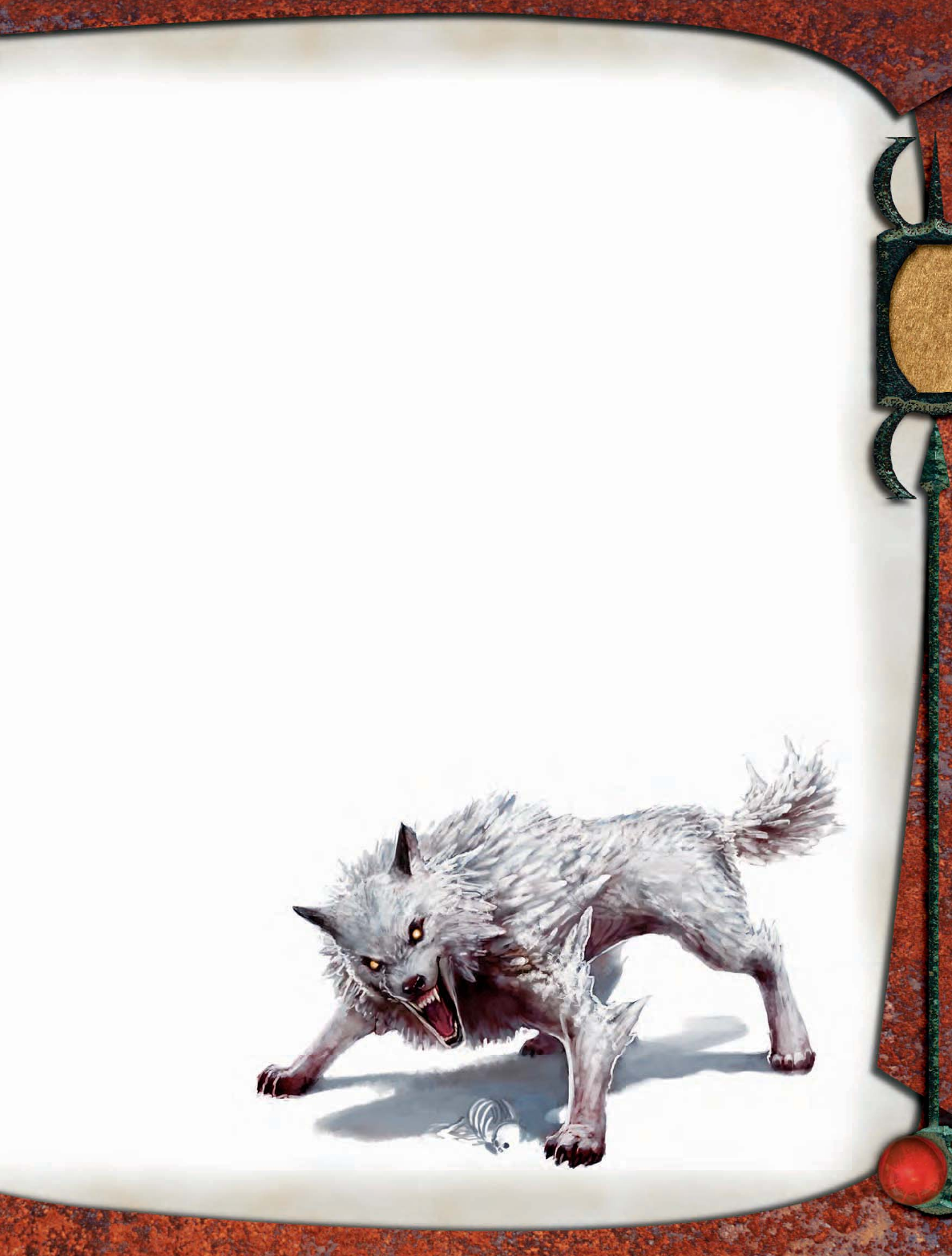
171
If a Thrym hound eats voraciously for a week or two, it can
go hungry for nearly a year without suffering any ill effect.
Thrym hounds can eat smaller meals throughout the year if
they so choose, but most of them prefer to binge and then
fast, since prey can be scarce in the frigid lands where the
hounds dwell.
Environment: Thrym hounds live in arctic and subarctic
lands, preferring glacial regions of snow and ice. They are
commonly found in cold mountains and cold hills, though
they prefer temperate regions for hunting and sport. When
hunting, they can be found in a broad range of climes,
though they rarely linger long before returning to their
arctic homes.
Thrym hounds prefer to live in ice caves, which they
excavate with teeth and claws. They can make remarkably
fast headway through ice in this manner, though not nearly
fast enough to qualify as a mode of movement. Given time,
they are capable of constructing extensive networks of icy
tunnels and caverns.
Typical Physical Characteristics: Thrym hounds
have the shape and build of wolves, but they are 30 feet
long, including the tail, and can stand 12 feet tall at the
shoulder. An adult Thrym hound weighs fifteen tons.
Instead of fur, these creatures have rocklike skin that proj-
ects away from the body in fine spines. These spines are
constantly frosted with ice, regardless of the surrounding
temperature, and are cold to the touch. They reflexively
flare out to strike at anyone attacking the Thrym hound
in melee.
Alignment: Thrym hounds are selfi sh creatures, as quick
to hunt humanoids and their livestock as they are the beasts
of the wild. Nearly all these creatures are neutral evil, with
more rapacious examples demonstrating chaotic evil traits.
SOCIETY
Packs of two to a dozen Thrym hounds form to hunt and raid.
Raids into warmer lands are a strange feature of Thrym
hound pack culture. Lone Thrym hounds occasion-
ally go raiding, though this is normally an
activity for a large pack. But even a small
pack of Thrym hounds can wreak havoc
in a civilized area.
Thrym hounds hunt for plea-
sure as much as they do for
sustenance. They are intelligent
enough to engage in cruelty for its own
sake, putting their victims through
torturous cat-and-mouse games before
consuming them.
These creatures have a
couple of habits that
extend beyond instinct
or intelligence. They have
an intuitive sense of and
respect for territorial boundaries,
so conflicts between individuals or packs are rare. Thrym
hounds also have a natural subservience toward frost
giants. Thus, frost giants receive a +4 bonus on Handle
Animal checks and Ride checks when dealing with
Thrym hounds.
TYPICAL TREASURE
Thrym hounds have little appreciation for treasure, but they
sometimes keep gems, weapons, and magic items from former
victims in their lairs. They have half standard treasure for
their Challenge Rating.
THRYM HOUNDS IN EBERRON
Thrym hounds originated in the Frostfell, but they have
since spread to the Lhazaar Principalities, the Mror Holds,
the Demon Wastes north of Eldeen Bay, and the Tashana
Tundra in northern Sarlona. Their depredations are known
and feared in Karrnath, but elsewhere they are little more
than myth. Thrym hounds are named for a legendary Frost-
fell island where a kingdom of giants was said to have been
established before the fall of Xen’drik.
THRYM HOUNDS IN FAERÛN
Thrym hounds live in the far north, particularly on the
Great Glacier and the High Ice. Packs of these creatures are
sometimes seen in the Frozenfar and the Spine of the World
as well, and they have been known to raid as far south as
Daggerford. In recent years, Thrym hounds have appeared
in southern climes for reasons beyond the need to hunt or
the desire to raid. Some believe that these Thrym hounds are
under the control of Iyraclea, mistress of the Great Glacier,
but their purpose is unknown.
Thrym hound
THRYM HOUND
Illus. by J. Chan
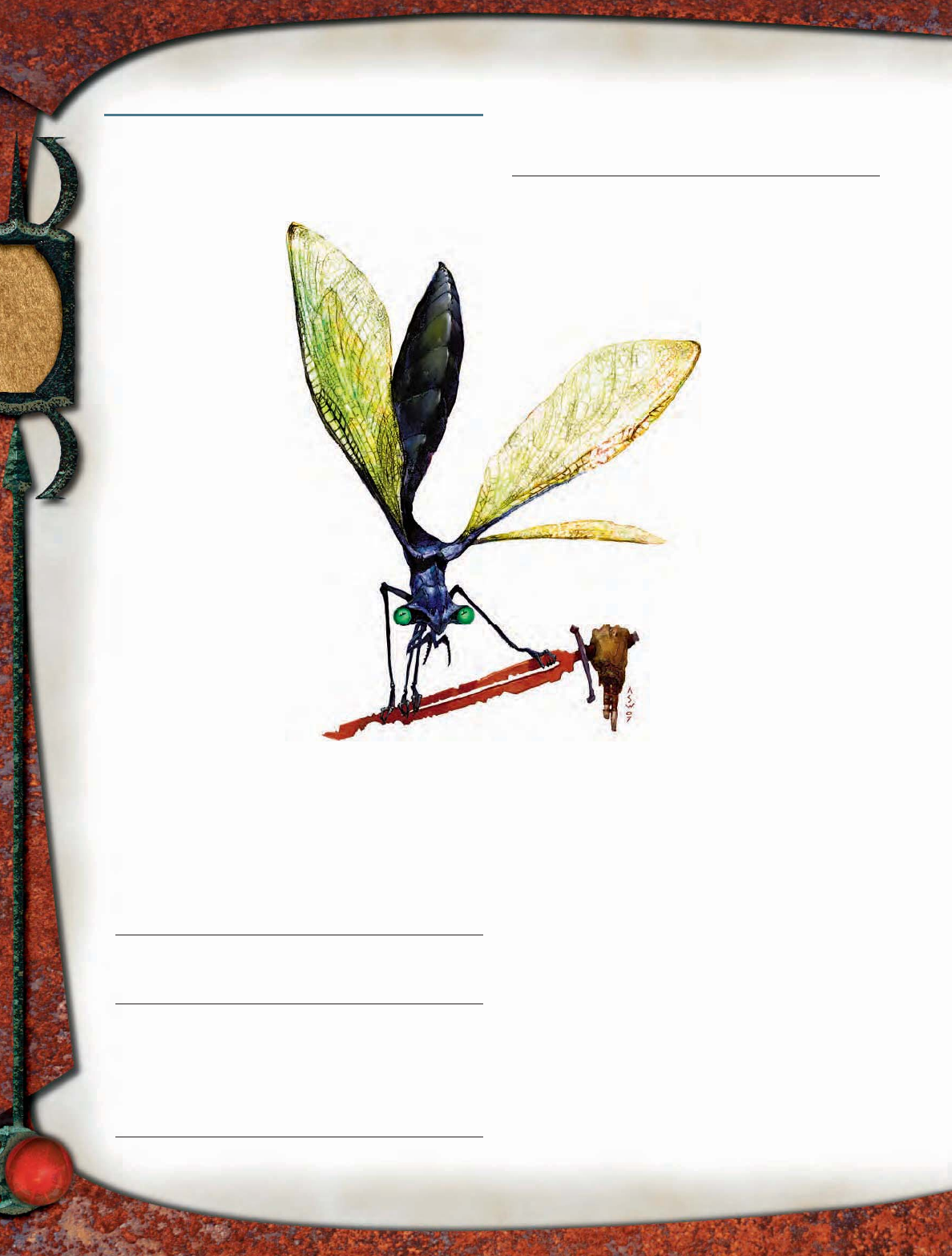
172
TIRBANA
At the fringes of civilization, ghost towns echo with the
chittering din of countless tirbanas. Endlessly toiling, end-
lessly breeding, these fearsome creatures spread and thrive
by overwhelming the folk of isolated villages, placing those
victims into a magical
slumber, then implant-
ing eggs into them.
To sustain their ex-
istence, tirbanas need
living hosts. Because an-
imals and other wildlife
seldom congregate in suf-
fi cient numbers for their
needs, these creatures have
evolved to seek out the
consistently populous com-
munities of sentient races. In
such places, tirbanas fi nd more
than enough hosts to propagate
new generations.
Tirbanas take one of four known
forms. The least of their kind are the
eyewings, odd creatures that resemble
overly large dragonflies. Above them
are the drowsers, worker-drones
charged with magically subduing the
residents of a settlement. Slayers are
the warriors of the tirbanas, quashing
any resistance in the colony’s target
population of sentient creatures. At
the top are the spawners that
implant tirbana eggs into
doomed hosts.
TIRBANA EYEWING
What appears to be a large black dragonfl y slips through the air with
incredible grace, watching you with large green eyes.
Tirbana Eyewing CR 1/2
Usually LN Tiny magical beast
Init +3; Senses all-around vision, darkvision 60 ft.; Listen +3,
Spot +7
Languages Tirbana
AC 15, touch 15, flat-footed 12
(+2 size, +3 Dex)
hp 6 (1 HD)
Fort +3, Ref +5, Will +1
Speed 20 ft. (4 squares), fly 60 ft. (perfect)
Melee bite +6 (1d4–3 plus poison) or
Melee touch +6 (disorienting touch)
Space 2-1/2 ft.; Reach 0 ft.
Base Atk +1; Grp –10
Special Actions negate enchantment
Spell-Like Abilities (CL 1st):
3/day—detect magic
Abilities Str 5, Dex 16, Con 13, Int 3, Wis 13, Cha 10
SA disorienting touch, negate enchantment, poison, spell-
like abilities
Feats Weapon Finesse
Skills Hide +11, Listen +3, Search +0, Spot +7
Advancement 2 HD (Tiny)
All-Around Vision (Ex) An eyewing’s eyes allow it to look in
any direction, providing a +4 racial bonus on Spot and
Search checks. Opponents gain no benefit when flanking
an eyewing.
Disorienting Touch (Su) With a successful melee touch
attack, an eyewing causes a creature to take a –1 penalty
on Will saves for 1 minute. The effect of multiple touches
does not stack.
Poison (Ex) Injury, Fortitude DC 13
or take a –5 penalty on
Listen and Spot checks
and a –2 penalty on Will
saves against sleep effects
for 5 rounds. The save
DC is Constitution-based
and includes a +2 racial bonus.
Negate Enchantment (Su) An
eyewing can attempt to negate an
enchantment affecting any creature
it touches. The target is allowed a new
saving throw for one enchantment
spell or effect, at the original
DC. If multiple enchantments
are in effect on the target
creature, it receives a new save
for the most recent effect.
The gentle tirbana eyewings are
all but harmless. They serve their
colony as scouts and as nursemaids,
keeping host creatures alive until the
eggs within those hosts hatch. The only
tirbanas ever found outside a colony,
eyewings sometimes serve as familiars
for wizards and sorcerers. They are valued
for their ability to sense magical auras and negate enchant-
ment effects.
Strategies and Tactics
When it is encountered alone, an eyewing fl ees enemies,
returning to the colony to alert its kin. It then leads several
drowsers back to the site of danger. It uses its poisoned bite
in combat, hoping to make victims more susceptible to the
drowsers’ sleep ability.
When not threatened, an eyewing is a carefree, good-
natured creature. These tirbanas happily follow any creatures
they come across, demonstrating complete docility in return
for morsels of food or a playful scratch between the wings.
If given the opportunity, they follow creatures for up to two
days in the hope of being led to a settlement. Once there, they
immediately fl ee back to the colony to report the location.
For Player Characters
An eyewing can be used as an improved familiar (DMG 200).
A spellcaster must be lawful neutral or lawful evil, have an
Tirbana eyewing
TIRBANA
Illus. by A. Waters

173
arcane spellcaster level of 5th, and take the Improved Familiar
feat to acquire an eyewing familiar.
TIRBANA DROWSER
A buzzing noise precedes the approach of an insectlike creature the
size of a dog. Its wide, armored body shambles forward on six legs.
A seventh limb, ending in a handlike appendage, projects from the
front of its body. The creature’s triangular head has bulging green
eyes. Slung beneath them is a pair of dripping mandibles that exude
a yeasty stench.
Tirbana Drowser CR 2
Usually LN Small magical beast
Init +2; Senses all-around vision, darkvision 60 ft.; Listen +4,
Spot +8
Languages Tirbana
AC 15, touch 13, flat-footed 13
(+1 size, +2 Dex, +2 natural)
hp 19 (3 HD)
Fort +4, Ref +5, Will +2 (+4 against enchantments)
Speed 30 ft. (6 squares), burrow 20 ft., fly 30 ft. (average)
Melee bite +7 (1d4 plus poison)
Space 5 ft.; Reach 5 ft.
Base Atk +3; Grp –1
Atk Options strength in numbers
Spell-Like Abilities (CL 3rd):
At will—detect magic, sleep (DC 12)
1/day — blur
Abilities Str 11, Dex 14, Con 13, Int 3, Wis 12, Cha 13
SA poison, spell-like abilities
Feats Weapon Finesse, Weapon Focus (bite)
Skills Hide +6, Listen +4, Search +0, Spot +8
Advancement 4–5 HD (Small)
All-Around Vision (Ex) A drowser’s eyes allow it to look in
any direction, providing a +4 racial bonus on Spot and
Search checks. Opponents gain no benefit when flanking
a drowser.
Poison (Ex) Injury, Fortitude DC 14 or take a –5 penalty
on Listen and Spot checks and a –2 penalty on Will
saves against sleep effects for 5 rounds. The save DC is
Constitution-based and includes a +2 racial bonus.
Strength in Numbers (Ex) Whenever a drowser begins its
turn in a space adjacent to another drowser, it gains a +2
circumstance bonus on attack rolls and damage rolls.
A tirbana colony relies on drowsers to slip stealthily into
settlements and subdue the population with their sleep ability.
The colony also contains a small number of modifi ed drowser
drones whose job is to impregnate the spawner. Once that
task is complete, they fi ll the same place in the colony as
regular drowsers.
Strategies and Tactics
Drowsers are naturally cooperative, and they work especially
well together. They are a colony’s fi rst line of defense, meeting
any threat head on with their sleep ability. A few drowsers
typically hold back to use blur on themselves, but these join
the battle quickly, surrounding opponents to help their fel-
lows bring those foes down.
Eyewings and slayers occasionally accompany drows-
ers on combat missions. The smaller eyewings zoom in
to nip at their foes, hoping to make their enemies more
susceptible to the drowsers’ sleep ability. If slayers are
present, a handful of drowsers bestow a blur effect on
those warriors instead of themselves. Once they have
protected the slayers, drowsers fling themselves into the
fray, maneuvering to flank opponents and thereby aid
their larger allies.
TIRBANA SLAYER
The creature lurching toward you looks like some great beetle, hoary
fur sprouting from the joints of its mud-caked carapace. Its forelegs
end in jagged claws, and a pair of dripping mandibles tremble
beneath bulbous red eyes.
Tirbana Slayer CR 4
Usually LN Medium magical beast
Init +1; Senses all-around vision, darkvision 60 ft.; Listen +4,
Spot +8
Languages Tirbana
AC 17, touch 11, flat-footed 16
(+1 Dex, +6 natural)
hp 45 (6 HD); DR 5/magic
Fort +9, Ref +6, Will +3 (+7 against enchantments)
Speed 30 ft. (6 squares), fly 10 ft. (clumsy)
Melee bite +9 (1d6+3 plus poison) and
2 claws +7 each (1d4+1)
Space 5 ft.; Reach 5 ft.
Base Atk +6; Grp +9
Atk Options Cleave, Power Attack, magic strike, skirmish
(+1d6, +1 AC)
Special Actions second wind
Abilities Str 17, Dex 12, Con 15, Int 3, Wis 13, Cha 4
SA magic strike, poison, skirmish
Feats Cleave, Great FortitudeB, Multiattack, Power Attack
Skills Listen +4, Search +3, Spot +8
Advancement 7–12 HD (Medium); 13–18 HD (Large)
All-Around Vision (Ex) A slayer’s eyes allow it to look in any
direction, providing a +4 racial bonus on Spot and Search
checks. Opponents gain no benefit when flanking a
slayer.
Poison (Ex) Injury, Fortitude DC 17 or become stunned for 1
round, plus take a –5 penalty on Listen and Spot checks
and a –2 penalty on Will saves against sleep effects for 5
rounds. The save DC is Constitution-based and includes
a +2 racial bonus.
Skirmish (Ex) A slayer deals an extra 1d6 points of damage
on all attacks it makes during any round in which
it moves at least 10 feet. The extra damage applies
only to attacks made on the slayer’s turn. The extra
damage applies only against living creatures that have a
discernible anatomy.
In addition, a slayer gains a +1 competence bonus
to AC during any round in which it moves at least 10
feet. This bonus lasts until the start of the slayer’s
next turn.
Second Wind (Ex) As a standard action, once per encounter,
a slayer can temporarily give up its skirmish ability to heal
10 hit points. It recovers its skirmish ability after it rests
for 1 hour.
TIRBANA
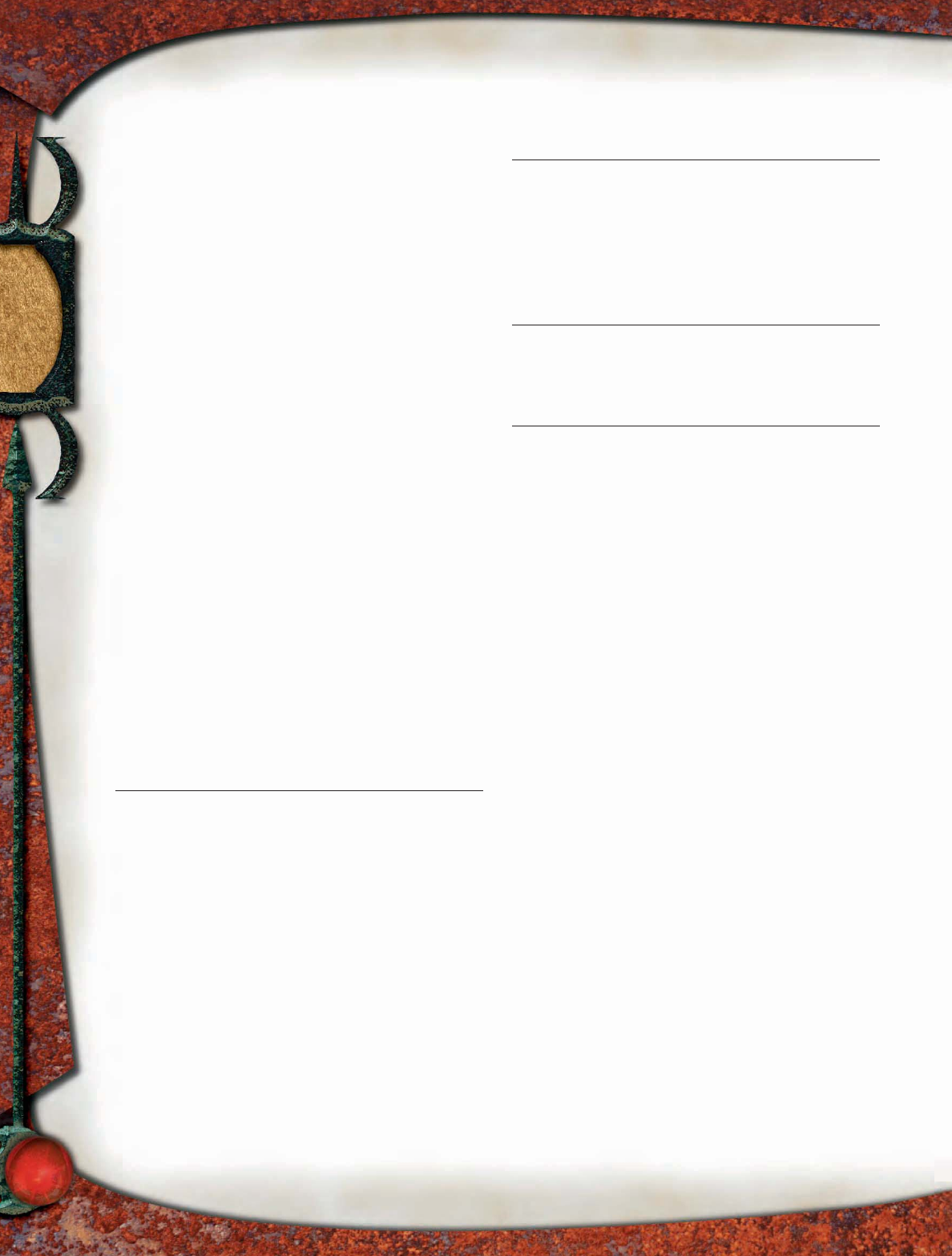
174
Slayers are the warriors of a tirbana colony. Their principal
responsibility is to destroy those creatures that resist the
drowsers’ sleep ability.
Strategies and Tactics
Slayers are not as numerous as eyewings and drowsers, so
they fight singly or in pairs. A slayer is typically accom-
panied by a number of drowsers, with one of the smaller
tirbanas giving the warrior the benefit of blur while the
others fan out to surround the enemy. The slayer then
races into combat, tearing through foes with its bite attack
boosted by its skirmish ability. If prevented from moving,
it attacks with bite and claws before taking a 5-foot step,
hoping to gain enough space to use its skirmish ability
during the next round.
Slayers are unsubtle combatants, typically maximizing
their Power Attack feat in the hope of landing dreadful
blows on their enemies. If its bite attack successfully stuns
an opponent, a slayer directs its drowser allies to flank
and finish that foe off, moving to skirmish with another
adversary. If the slayer loses its skirmish ability to heal
itself with its second wind ability, it focuses on one foe
at a time, flanking if possible as it makes successive bite
and claw attacks.
TIRBANA SPAWNER
A yeasty odor precedes this strange bipedal creature, which looks like
a cross between a human and a giant cockroach. Its upper limbs
end in handlike appendages. A pair of large violet eyes dominates
its triangular head, overshadowing mandibles that slaver with a
sickening eagerness.
Tirbana Spawner CR 5
Usually LN Medium magical beast
Init +4; Senses all-around vision, darkvision 60 ft.; Listen +9,
Spot +13
Languages Tirbana, understands Common and Elven
AC 18, touch 14, flat-footed 14; Dodge
(+4 Dex, +4 natural)
hp 57 (6 HD); DR 10/magic
Fort +11, Ref +9, Will +4 (+8 against enchantments)
Speed 30 ft. (6 squares)
Melee 2 bites +10 each (1d6+4 plus poison)
Ranged acid orb +10 (1d6 acid)
Space 5 ft.; Reach 5 ft.
Base Atk +6; Grp +10
Atk Options Combat Reflexes, Power Attack, magic strike
Special Actions sleep drone
Spell-Like Abilities (CL 6th):
At will—detect magic
2/day—displacement
Abilities Str 18, Dex 19, Con 18, Int 11, Wis 14, Cha 13
SA magic strike, poison, sleep drone, spell-like abilities
Feats Combat Reflexes, Dodge, Great FortitudeB, Power
Attack
Skills Knowledge (local) +4, Listen +9, Search +4, Spot +13
Advancement 7–12 HD (Medium); 13–18 HD (Large)
All-Around Vision (Ex) A spawner’s eyes allow it to look in
any direction, providing a +4 racial bonus on Spot and
Search checks. Opponents gain no benefit when flanking
a spawner.
Poison (Ex) Injury, Fortitude DC 19 or take a –5 penalty
on Listen and Spot checks and a –2 penalty on Will
saves against sleep effects for 5 rounds. The save DC is
Constitution-based and includes a +2 racial bonus.
Acid Orb (Ex) As a standard action, a spawner can project an
orb of acid to a range of 100 feet. Creatures struck by the
orb take 1d6 points of acid damage, plus an additional
1d6 points of acid damage in the following round at the
beginning of the spawner’s turn.
Sleep Drone (Su) As a full-round action, a spawner can cause
living creatures within a 60-foot-radius spread to fall asleep
unless they succeed on a DC 16 Will save. An affected
creature stays asleep until it takes damage or is awakened
by another creature (a standard action). The save DC is
Charisma-based and includes a +2 racial bonus.
The spawner is the leader of a tirbana colony. These bipedal
creatures are far more intelligent than their lesser kin,
pqqqqqqqqqqqqqqqqqqqqrs
HANDS OF THE TIRBANAS
Tirbana spawners and drowsers have hands, and these
creatures are clever enough to utilize tools and other handy
objects. A tirbana spawner is as bright as a human, so it can
exploit items in its possession on a strategic and tactical
level. It can even figure out how to operate complex devices.
A tirbana drowser is only slightly smarter than a chimpanzee,
so on its own, it might use simple tools for accomplishing
mundane tasks. It could, for example, employ a bucket for
food gathering.
Since they have the required appendages, tirbana spawners
and drowsers can handle weapons. A drowser can wield one-
handed or light weapons designed for Small creatures, but it
only gains proficiency with such armaments if trained. It’s usu-
ally better off using its natural attacks in battle, making use of
its dexterous hand for other tasks. Spawners are more likely to
learn to use a weapon. Only an advanced spawner could take
the feat required to gain proficiency with a weapon, and such
a creature never bothers learning to wield a weapon that deals
less damage than its mandibles.
Tirbana spawners sometimes educate drowsers on how
to work with objects and machines in ways the dull-witted
drowsers would never think of on their own. Spawners also
devise plans and instruct their tirbana underlings on how
to implement those plans. For instance, a spawner might
teach its drowsers how to open and close a complex system
of gates, along with how to use those gates to protect the
tirbana colony. The same spawner could show the drowsers
how to throw splash weapons, which require no proficiency
to use.
If you design a tirbana-based adventure, consider the loca-
tion and the objects available there. Many implements pres-
ent in, say, a small keep, could be dangerous in the hands of
the tirbanas. If you allow the tirbanas to take advantage of
these items, your encounters will be that much more surpris-
ing and fun.
pqqqqqqqqqqqqqqqqqqqqrs
TIRBANA
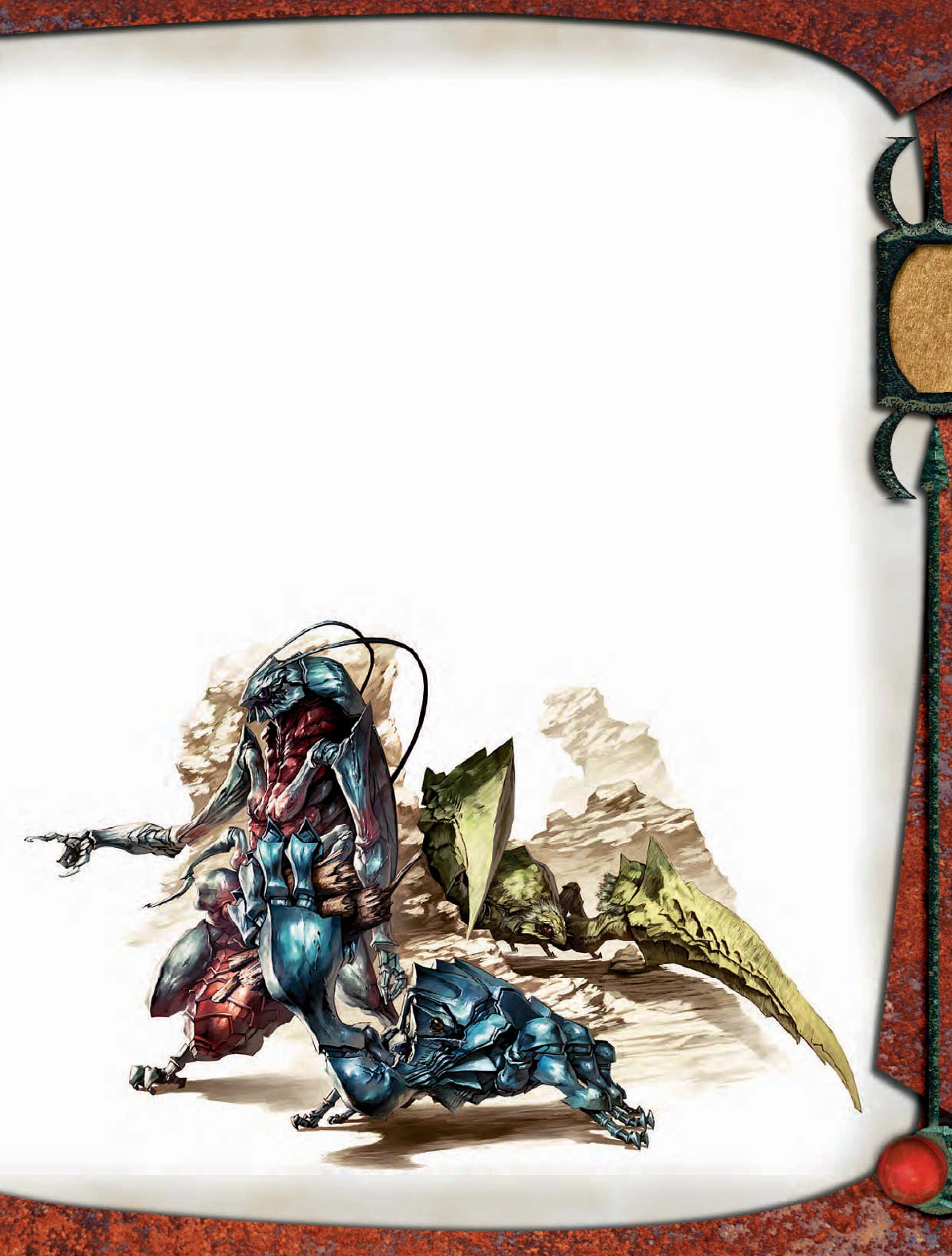
175
driving the colony to conquer populated settlements and
spread their kind across the world.
Strategies and Tactics
A spawner is the brains of a colony, and without its presence
and guiding infl uence, all the tirbanas of the colony lose
their way. As a result, two to three slayers typically protect
a single spawner. Since a spawner rarely ventures out of its
lair, combat with one of these creatures is on its terms. Given
time to prepare, a spawner uses its displacement ability and
takes cover, trusting its sleep drones and its fanatically loyal
slayers to defend it. If directly threatened, it emerges from
cover to bite or fl ing acid orbs at its foes.
A spawner’s instincts direct it to whatever action best
serves the health of the colony. However, a spawner’s aware-
ness and intellect sometimes makes the tirbanas’ antipathy
for elves (see Society) manifest as a dark rage. If face to face
with elves in its lair, a spawner attacks incessantly with its
acid orbs, not caring if it runs the risk of hitting its slayer
or drowser allies.
SAMPLE ENCOUNTERS
Tirbanas live only to subdue settlements and implant eggs
in their captives. Once established, these creatures rarely
venture outside a community except to seek water and food.
Tirbanas are not wantonly violent by nature, and when they
do attack, it is with the intent of tak-
ing their victims alive.
If encountered
in an overrun
settlement, tirba-
nas become far
more aggres-
sive. They do
not tolerate
intruders,
quick to drive
out any who do not belong. If alerted to attack, strike teams
of slayers and drowsers prowl the streets while eye wings
speed through the air. All fight independently, sharing
the common goal of defending the spawner in the safety
of its lair.
Scouts (EL 1/2–4): Before making an attack against a
settlement, the spawner sends out teams of eyewings to
locate populations of prospective hosts. Each eyewing travels
independently and fi ghts only if it cannot fl ee. However, an
eyewing that is attacked returns in 1d10 minutes with two
drowsers ready to fi ght.
Strike Teams (EL 4–6): Once a site is located, the spawner
sends in teams of two eyewings and two to four drowsers to
pacify the populace. These creatures avoid well-armed or
well-armored foes, and they ignore enemies that succeed
on two successive saves against their sleep ability. They know
that the suppressor force set to follow them can deal with any
creatures they cannot.
Suppressors (EL 6–7): Invariably, a settlement contains
folk who resist the tirbanas’ sleep abilities. A slayer and two
to four drowsers are sent in to crush any such residents. The
suppressor force uses divide-and-conquer tactics, preventing
targets from aiding each other in combat. Directed by the
slayer, the drowsers target the most powerful foes fi rst, hoping
to slay leaders to break the morale of those still alive.
Maintenance Team (EL 7–8): As soon as tirbanas take
control, maintenance teams of six to eight drowsers make
the rounds of host creatures to ensure those hosts remain
asleep. If their work is interrupted, half the drowsers focus
on ensuring that any host creatures that awaken are sent back
to sleep, while the other half defend
against intruders.
Spawner and Entou-
rage (EL 7–10): In the
fi nal stage of colonization,
the spawner and two
to six slayers prowl
the community, im-
planting eggs in
host creatures.
Tirbanas
TIRBANA
Illus. by S. Srisuwan

176
ECOLOGY
Tirbanas take nourishment from anything that can be
consumed, and they can survive on dead wood and other
creatures’ leavings if need be. They have no natural enemies,
for only the most voracious of predators can tolerate the
taste of their flesh. As a result, tirbanas are free to do as
they like.
Though tirbanas can sustain themselves in nearly any
environment, they cannot reproduce without laying their
eggs in other creatures. The warm body of a living creature
incubates the eggs and provides food for tirbana larvae when
they hatch. A spawner produces up to one hundred eggs in a
single clutch, each needing at least 15 pounds of fresh meat
to sustain it. Only populated settlements can typically meet
the needs of a tirbana colony’s breeding program.
Tirbanas need to keep their host creatures alive, and so
they have evolved a number of unusual abilities dedicated
to inducing a deep sleep in their victims. Once the hosts
succumb to sleep, the spawner inserts four eggs into each
victim’s throat. An acidic gel coats the eggs and enables them
to attach within the host’s stomach. After a week, the egg
hatches to release a pale white larva (1 hit point) that grows
into one of the four types of tirbanas.
Each sleeping creature is an ideal meal, providing the larvae
with suffi cient energy to complete their transformation. A
victim takes 1d6 points of Constitution damage each day the
larvae feed. When its Constitution is reduced to 0, the host
dies. The larvae then emerge and feed on the corpse.
As long as its Constitution has not reached 0, a host creature
can be saved by the application of a cure disease or heal spell.
This kills the parasitic larvae and allows any Constitution
damage to be healed normally.
Once a new generation of tirbanas has hatched, the
bodies of their hosts fuel the growth of the young over a
period of two weeks. During this time, the elder colony
begins to die. Eyewings, drowsers, and slayers grow weak
and collapse one by one. By the time the spawner perishes,
the larvae have completed their transformations, and a
new generation of tirbanas is born. Among the young are
1d3+1 spawners that divide the rest of the colony between
them. Each group then sets out to find a population of new
hosts to continue the cycle.
Environment: Tirbanas are hardy and adaptable, settling
anywhere that isolated communities spring up. As such,
these creatures can be found in any land or underground
environment. Their lairs are ghastly places, fi lled with the
bodies of host creatures slowly starving in their sleep, or
corpses being devoured by the larvae that have hatched
inside them.
Typical Physical Characteristics: Tirbanas resemble
giant insects, blending the features and body parts of man-
tises, beetles, roaches, fl ies, and other vermin.
An eyewing looks like an oversized dragonfl y, 1 foot long
and weighing 2 pounds, with two large green orbs for eyes.
It fl ies by means of 2-foot-wide translucent wings that allow
it to reach great speeds. An eyewing is at home in the air,
moving with an uncanny grace.
Drowsers have wings as eyewings do, but they lack the
maneuverability and speed of their smaller kin. Resem-
bling giant cockroaches, these creatures move about on
six legs and have a seventh limb equipped with a grasping
hand. They have flat, shiny bodies and the triangular head
common to all tirbanas. All drowsers are about 3 feet long
and weigh 30 pounds.
The brutish slayers are larger than drowsers—about 5 feet
long and weighing 200 pounds. Scarcely contained by their
waxen shells, their bodies are filthy, covered with muck
and debris that forms an effective second carapace. Their
triangular heads have large red eyes.
Spawners are the strangest tirbanas of all. Unlike others
of their kind, they stand upright, walking on their hind
legs. Though their second set of limbs is withered and
useless, the upper set is strong and equipped with fully
functioning hands. They stand just under 6 feet tall and
weigh 150 pounds.
Alignment: Tirbanas are not evil, but the act of subduing
and slaying host creatures is an intrinsic part of their nature.
Though these creatures do their best to care for victims while
their larvae grow, they don’t recognize the immorality of
trading the lives of unwilling sentient hosts for their own
survival. Tirbanas have an unshakeable commitment to
their colony and its survival, and these creatures are usually
lawful neutral. A few tirbanas display evil tendencies, which
manifest as unnecessary cruelty.
pqqqqqqqqqrs
TIRBANA LORE
Characters who have ranks in Knowledge (arcana) can learn
more about tirbanas. When a character makes a successful
skill check, the following lore is revealed, including the infor-
mation from lower DCs.
Knowledge (Arcana)
DC Result
11 This creature is a tirbana, a member of a menacing
insectile race that invades humanoid settlements.
This result reveals all magical beast traits.
16 All tirbanas have highly developed eyes, making
them dangerously perceptive and impossible to
fl ank. Though capable in combat, tirbanas can
send their foes to sleep using poison and magical
abilities.
21 Of the four types of tirbanas, the large slayers are
the most deadly. However, all these creatures fi ght
in concert, using their poison to make foes more
susceptible to their sleep effects.
26 Tirbanas put creatures into a deep sleep not
for defense, but for reproduction. The bipedal
spawner is the leader of a tirbana colony, and
the eggs it lays within a magically sleeping host
eventually hatch, resulting in the host’s death.
pqqqqqqqqqrs
TIRBANA
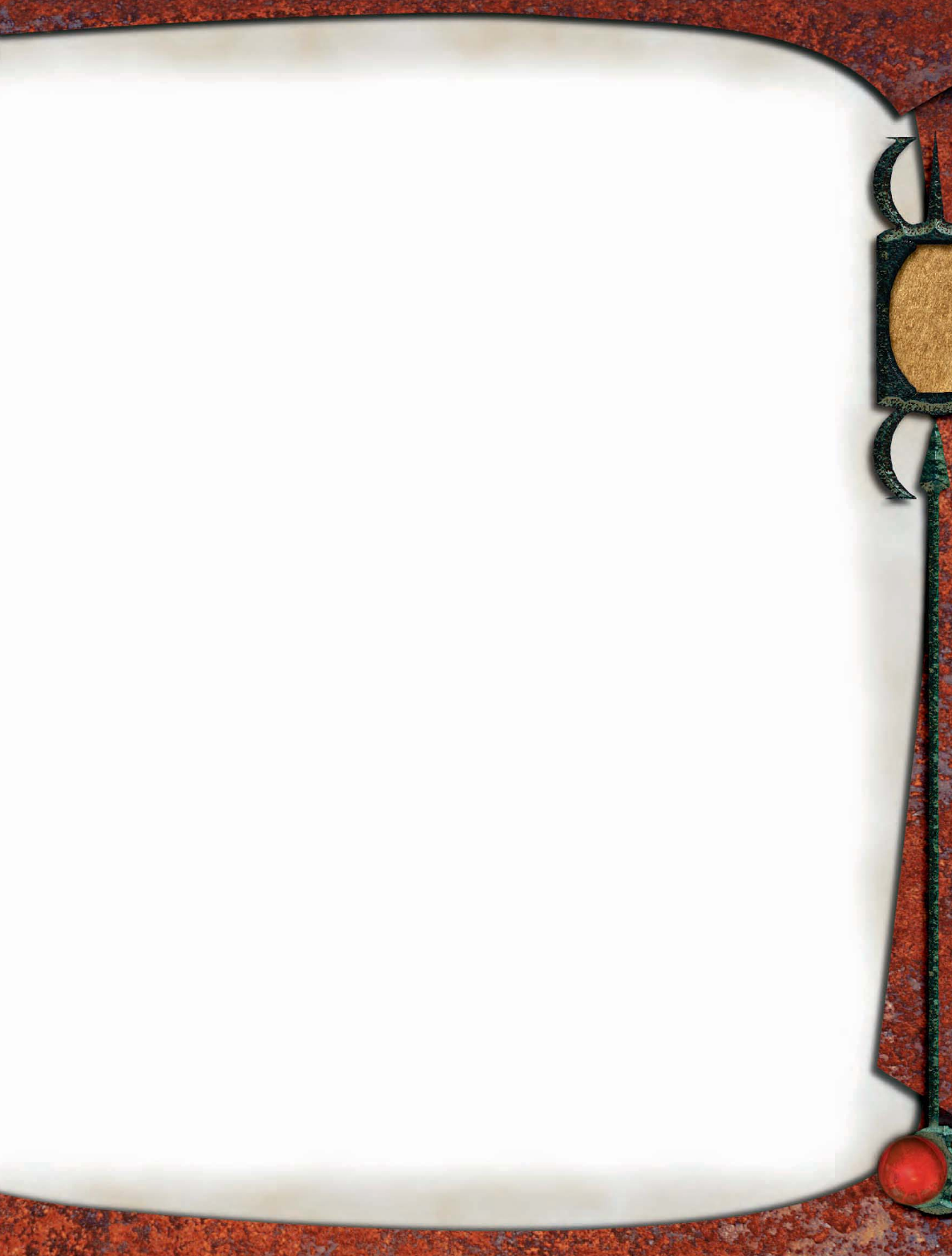
177
SOCIETY
Tirbanas are disciplined and keenly aware of their roles
within the hierarchy of the colony. Lesser tirbanas follow
the commands of a spawner without question, giving their
lives if need be to ensure the colony’s well-being.
Eyewing tirbanas work primarily as scouts. Skilled fl yers,
they can cover vast territory as they seek out isolated com-
munities for the colony. Once tirbanas have taken over a
settlement, eyewings work tirelessly to tend to the health
of host creatures. They scour the environs for fresh water,
collecting it in specially designed pockets in their legs.
They then flutter back to the colony’s sleeping victims
to dribble water into their mouths. Eyewings also give
nourishment to smaller or weaker host creatures (typically
children) whose Constitution might not be suffi cient to
allow a brood of eggs to successfully hatch. From the food it
eats, an eyewing disgorges a pasty mass that heals 2 points
of Constitution damage when forced down a helpless
victim’s throat. However, most hosts are allowed to starve
where they lie.
Drowsers come next in the tirbana hierarchy. It falls to
these creatures to place the residents of a target settlement
into the deep sleep that sees them turned into tirbana hosts.
Drowsers spread out in small teams when a settlement is
invaded, blanketing victims with their sleep ability. Once
a settlement is overrun, drowsers work in coordinated
teams, constantly renewing their sleep effect to keep host
creatures helpless.
Especially in larger settlements that cannot be taken in
one fell swoop, slayers are sent in to deal with any pockets of
physical resistance. These warriors tear apart any creatures
that attempt to stand in the way of the colony’s survival.
When the battle is done, the corpses of their victims feed
the colony as the sleeping host creatures are prepared for
implantation.
Heading up the tirbana colony is a single spawner. More
intelligent than their lesser kin, spawners understand the
fate that awaits the colony once the eggs hatch, and they
are the only tirbanas who can truly appreciate the horror
that the colony’s host creatures undergo. To a spawner, how-
ever, the continued spread of the tirbana race outweighs
any other concern.
Though a tirbana colony is strongly lawful, the destruc-
tion of the spawner does not leave lesser tirbanas helpless.
As long as the spawner has laid any eggs, tirbanas fight
for the overall defense of the colony, knowing that the
continued survival of their kind depends on their ability
to defend the host creatures that are growing the next
generation of tirbanas.
Although tirbanas are indifferent to their victims, they
reserve a special hatred for elves, whom they fear because
of that race’s innate immunity to sleep effects. They instinc-
tively give elf settlements a wide berth, but elves who share
territory with humans, halfl ings, and other good humanoid
races sometimes send out hunting parties to destroy tirbana
colonies before they spread.
SAMPLE LAIR: TIRBANA THORP
Before the tirbanas came, Martuk was a peaceful community
of fi fty souls in a wide rural realm. Elders passed down the
secrets of coaxing plants from the soil for generations. Using
these methods, the folk of Martuk have sustained themselves
and grown enough surplus to trade with an enclave of wood
elves ten miles to the east. The farmers and hunters of this
land regard the natural world as an expression of the divine.
They respect nature, killing only out of necessity and ensur-
ing that no part of a creature goes to waste.
The gentle and trusting nature of the residents of Martuk
proved to be their downfall, however. When a hunter
encountered a tirbana eyewing in the nearby woods, its
beauty amazed him. After leading it back to Martuk with
offers of food, he showed his fellow townsfolk the graceful
creature he had found. Shortly after its arrival, however, the
eyewing sped off. Locals saw the creature’s appearance as a
sign of providence, and so they kept an eye out in case it or
others of its kind returned.
Three days after the initial encounter, return they did.
A host of tirbanas poured out of the woods and set upon
the town. Eyewings filled the air, while drowsers worked
their fell magic to incapacitate the residents. Though a few
fought back, they were slain almost to the last (see area 5). It
was over quickly. Tirbanas had claimed the community for
themselves, and their spawner set about implanting its eggs
in the slumbering bodies of the fallen.
Now, the tirbana colony has just about run its course.
Half of the new generation of eggs have hatched and as
many of the original attackers have collapsed, rotting
where they fell. The sight that greets any approaching
party is a macabre one. Dismembered and devoured human
corpses litter the ground, and a few sluggish tirbanas crawl
through the area, awaiting the end. A pervasive stench hangs
in the air.
When using this site, seed treasure among the encounters
as you see fi t; see Typical Treasure.
Tirbana Husks: Each location marked with tirbana
remains indicates a place where a member of the colony
succumbed to the death that awaits them all. These repellent
remains stink far worse than do the human corpses. Tirbana
carcasses weep a pale yellow fl uid from their joints. Each dead
tirbana swarms with fl ies.
Trees: The trees around the thorp are medium forest (DMG
87). To a casual observer, this appears to be an ordinary wood.
However, a character who succeeds on a DC 15 Knowledge
(nature) check knows that this forest is carefully maintained.
Any search of the area reveals a number of stone amulets
hanging from woven cords in the trees’ lower branches. A
DC 20 Knowledge (religion) check suggests that residents
placed these ornaments here to ward away evil spirits.
TIRBANA
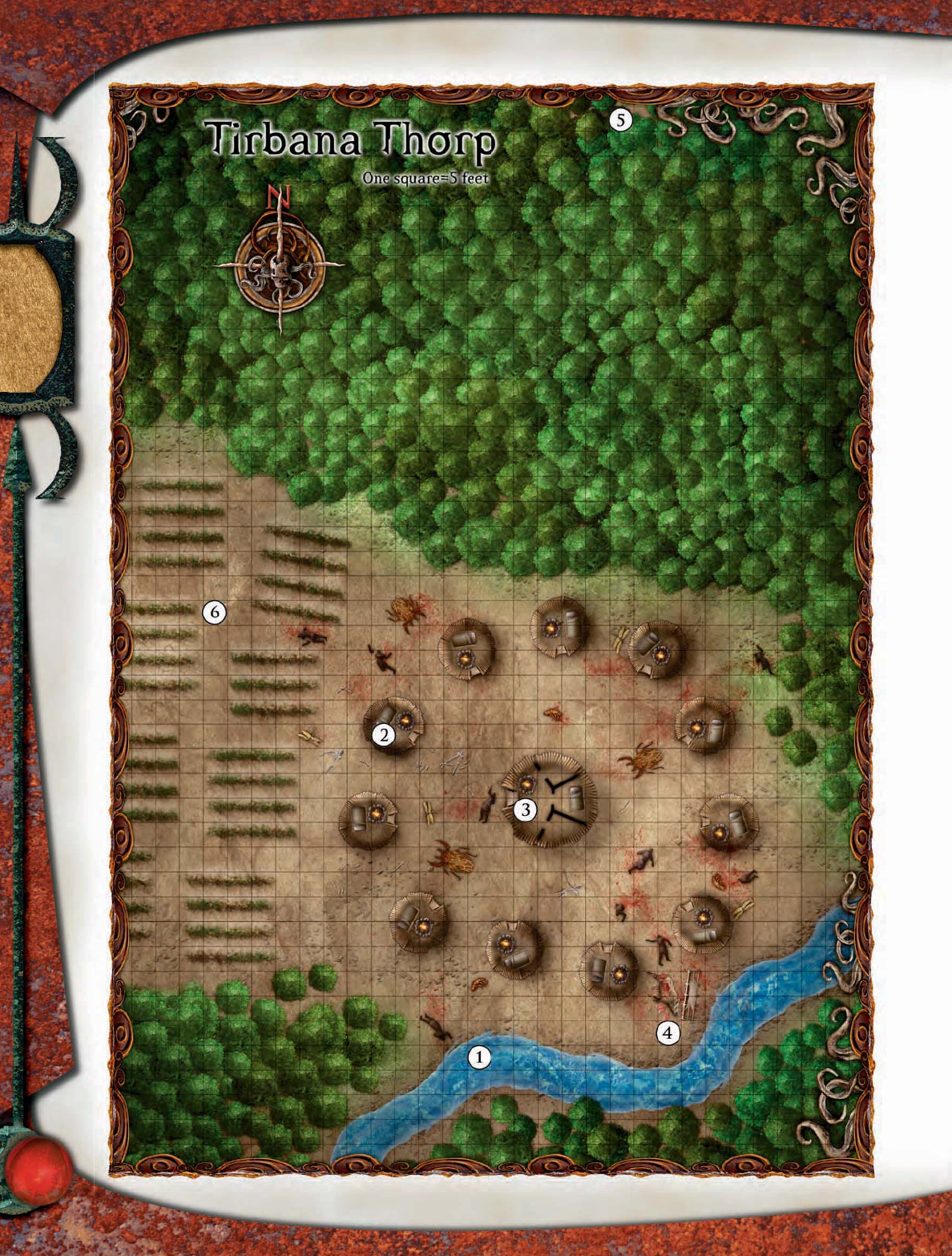
178
TIRBANA
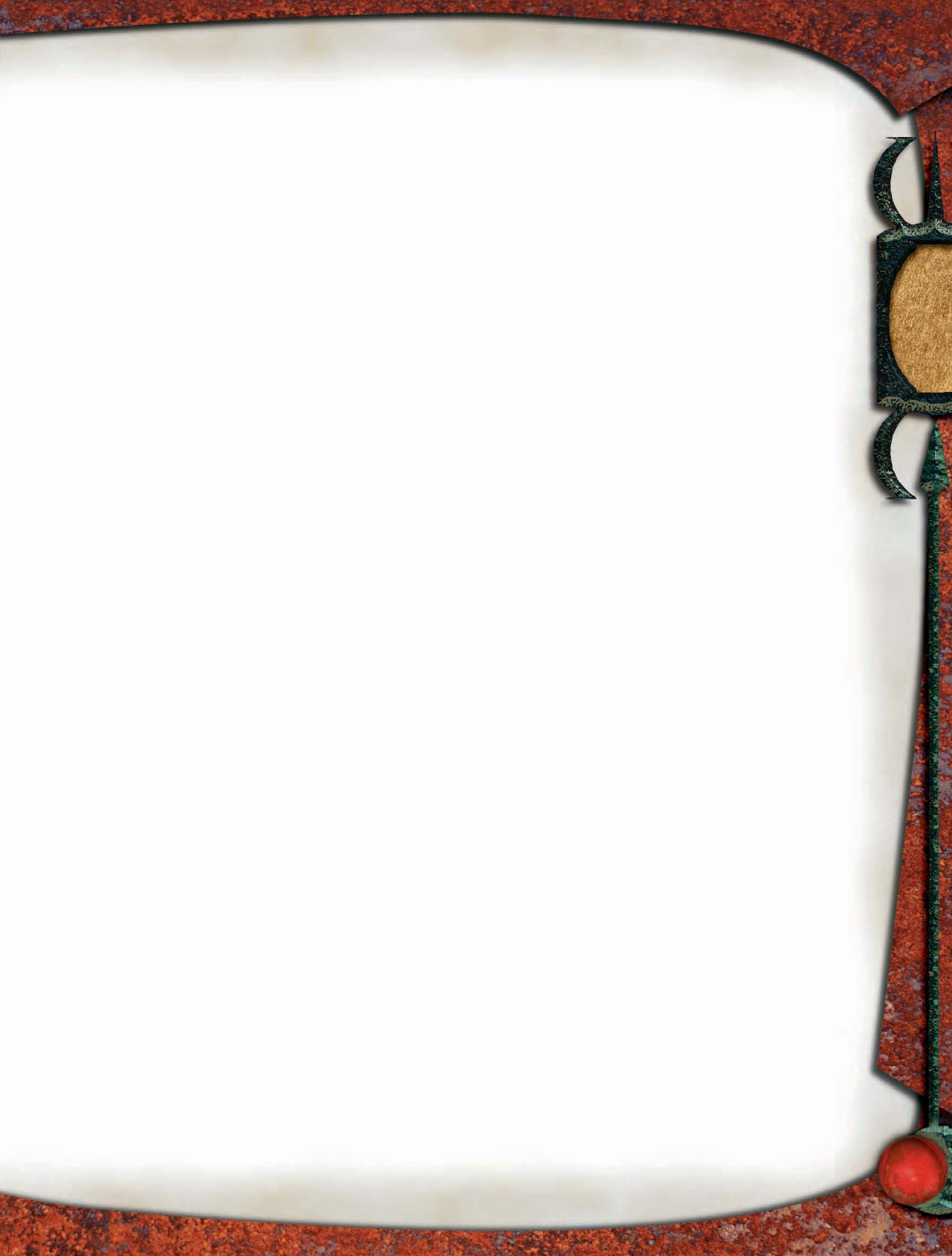
179
1. River (EL 1–2): The river moves at a brisk pace, and
any bodies that fell here have long since washed down-
stream. The water is potable, but every 10 minutes, 1d4+1
eyewings arrive to gather water for the colony’s sleeping
host creatures.
2. Huts (EL 5–7): Eleven huts fi ll the center of the clearing,
situated around a bigger structure (area 3). Though largely
constructed of mud, wood, and leaves, the huts are sturdy.
Their roofs are made of tightly woven reeds, and these struc-
tures have a hole in the center through which smoke from a
central fi re pit can escape.
Every hut holds 1d4+1 emaciated residents of varying
ages and genders. Half their number are in a deep magical
slumber, their mouths slack. The other residents are dead and
currently being eaten by the hut’s other inhabitants—1d3
tirbana drowsers and a single tirbana slayer.
3. Chieftain’s Hut (EL 8): This large hut once housed the
thorp’s chieftain. His remains are spread a few feet away, face
down and rotting in the mud. Unlike the smaller structures,
this hut is separated by interior walls into four rooms. The
tirbana spawner claimed this place as its lair, posting two
slayers out front as sentries.
4. Dire Boar Corpse (EL 4): Two drowsers dismember
this corpse to bring back as food for the spawner. They have
carefully peeled off parts of its bristly skin and carved away
hunks of meat that they stacked nearby.
5. Survivors: Against all odds, two residents who were
immune to the tirbanas’ sleep attacks managed to fl ee into
the woods when the onslaught came. For the last week,
Oolasien (CG female elf ranger 4) and her daughter Spyra
(CG half-elf ranger 1) have hidden here, surviving on nuts
and berries. Oolasien watched her human husband slain
in the defense of the thorp, and the destruction of her
community has taxed her sanity, leaving her periodically
catatonic. With eyewings in constant fl ight around the area,
Spyra is afraid to try to move her mother to a safer location.
She has noticed the tirbanas have recently begun to die,
however, and is preparing to return to the community to
fi nd out why.
6. Fields (EL 3): The stench of death has attracted an
ankheg, which now lurks beneath the thorp’s fi elds. At night,
the monster burrows out of its subterranean nest to snatch a
juicy corpse or two.
A DC 15 Spot check allows characters to notice that the
ground here has been disturbed as if recently dug. A DC 10
Search check reveals the same information, and someone
who has the Track feet can make a DC 15 Survival check to
identify the creature that has been living and digging here.
TYPICAL TREASURE
Tirbanas have no use for wealth, and anything they cannot
consume or use is left where it falls. Because tirbanas
attack small and out-of-the-way communities, treasure
from a tirbana encounter usually takes the form of silver
and copper coins, gems, trade goods, and occasional magic
items and art objects. These creatures do not carry or
hoard treasure, but valuables are found in the areas where
tirbanas live.
Eyewings have no treasure, whether they are encoun-
tered in the open as scouts or ministering to sleeping host
creatures. Drowsers have half standard treasure for their
Challenge Rating. Slayers have half standard treasure for
their Challenge Rating. Spawners lair in the largest and
most secure building in a settlement, such as a chieftain’s
hut, a great hall, or where the common wealth of the villag-
ers is stored. They have double standard treasure for their
Challenge Rating.
Trade goods found as tirbana treasure are consistent with
the size of a village and the area in which it is found. Common
trade goods might include livestock and horses that escaped
the initial tirbana attack plus salt, furs, linen, fl our, and spices.
See Wealth Other than Coins, PH 112.
TIRBANAS IN EBERRON
Tirbanas are confined to Xen’drik, where they primarily
colonize tribal settlements of lizardfolk. Though more
numerous, the drow are immune to the tirbanas’ sleep
abilities. Moreover, the tirbana spawners have come to
see the xenophobic drow as an impediment to widespread
settlement in Xen’drik. Tirbanas in Xen’drik sometimes
breed attack swarms of slayers whose only goal is to destroy
drow outposts. As a result, the drow have begun to actively
hunt tirbanas.
TIRBANAS IN FAERÛN
A group of Halruaan explorers recently returned from a foray
into the Mhair Jungles beyond the West Wall, telling strange
tales of ghost villages overgrown by vines and brush. Though
these places showed signs of battle, all were full of skeletons
laid out in repose, as if the villagers had simply died in their
sleep. The explorers suspect plague, but the wild dwarves of
the area claim this to be the work of the tirbanas—strange
insect beasts that come to snatch away a sleeper’s soul. So
unsettling are these sites that the wild dwarves refuse to go
near them.
TIRBANA

180
TROLL, BLADERAGER
A snarling and muscular giant lumbers into view, plates of steel
embedded in its rubbery green skin. A cap of steel is riveted to its
head, and steel claws are affi xed to its hands. Blood oozes from
around the plating and down the claws. The creature’s wild eyes
betray unthinkable agony.
Bladerager Troll CR 8
Always CE Large giant
Init +3; Senses darkvision 60 ft., low-light vision, scent;
Listen +6, Spot +7
Languages Giant
AC 25, touch 12, flat-footed 22
(–1 size, +3 Dex, +5 natural, +8 steel plates)
hp 81 (6 HD); regeneration 5; death throes
Immune mind-affecting spells and abilities
Resist tortured mind
Fort +14, Ref +7, Will +4
Speed 20 ft. (4 squares)
Melee 2 claws +12 each (2d6+9)
and bite +10 (2d6+4)
Space 10 ft. Reach 10 ft.
Base Atk +4; Grp +17
Atk Options Power Attack, pounce, rend 4d6+13
Abilities Str 28, Dex 16, Con 28, Int 6, Wis 14, Cha 9
SA death throes, pounce, rend, tortured mind
Feats Lightning Reflexes, Multiattack, Power Attack
Skills Listen +6, Spot +7
Advancement by character class; Favored Class fighter
Regeneration (Ex) Fire and acid deal normal damage to a
bladerager troll. If a bladerager troll loses a limb or body
part, the lost portion regrows in 5 minutes. The creature
can reattach a severed member instantly by holding it to
the stump.
Death Throes (Ex) A bladerager troll is designed to be a
bomb by its sinister masters. When a bladerager troll
dies, it explodes, propelling shrapnel in a 30-foot-
radius burst. Those caught in the area take 5d6 points
of piercing damage (Reflex DC 22 half). The save DC is
Constitution-based.
Tortured Mind (Ex) A bladerager troll’s mind has been torn
to shreds by the constant pain of its implanted armor.
Anyone who makes direct contact with a bladerager troll’s
tortured mind (such as by using a detect thoughts spell)
takes 1d4 points of Wisdom damage.
Pounce (Ex) If a bladerager troll charges a foe, it can make a
full attack.
Rend (Ex) A bladerager troll that hits with both claw attacks
latches onto the opponent’s body and tears the flesh.
This attack deals an extra 4d6+13 points of damage.
STRATEGIES AND TACTICS
Bladerager trolls immediately charge any foe they see, pounce
upon that opponent, and rend it to pieces. Their masters
usually unleash these vicious creatures as shock troops and
suicide squads.
SAMPLE ENCOUNTERS
Bladerager trolls are created, not born, so they are usually
found with their masters. Since they are military creatures,
they can be found in squads of two to ten when in such
service. When they are not under a master’s control, blade-
rager trolls are unable to abide the company of others without
lashing out to relieve their agony, so they are encountered
as solitary creatures.
Renegade (EL 8): After escaping its fi re giant handlers, a
bladerager troll runs amok, preying on livestock and farmers
on the edge of a frontier village. The savagery of its attacks
is extreme even for a troll. Though the attacks left no survi-
vors, those who come to deal with the menace can quickly
determine that they’re dealing with something like a troll
but worse. Tracks at the locations of recent attacks suggest
the giant is heavier but not much larger than normal, and
the wounds on victims are more like those created by light
weapons than claws. Stranger still, the troll didn’t carry any
valuables away from the sites of its attacks, despite the pres-
ence of such riches.
Assault Squad (EL 13): A fi re giant (MM 121) with four
freshly trained bladerager trolls has come down from the
mountains to test the mettle of her new slaves. She starts
with villages nearest the mountains and then moves farther
into civilized territory. Her aim is not conquest. Instead, she
wants to prove the effi cacy of the trolls to her superiors. She
keeps notes on the squad’s performance, so the defeat of the
assault squad and the capture of this information could lead
to further dealings with the fi re giants and their new military
technology—the bladerager trolls.
ECOLOGY
Bladerager candidates are selected from among the hardiest
troll specimens. These ill-fated giants are flayed alive as
steel is riveted onto their bones and magically augmented to
work with troll physiology. Claws are then mounted on their
forearms, and enormous steel jaws resembling bear traps are
screwed to their skulls.
pqqqqqqqqqrs
BLADERAGER TROLL LORE
Characters who have ranks in Knowledge (nature) can learn
more about bladerager trolls. When a character makes a suc-
cessful skill check, the following lore is revealed, including the
information from lower DCs.
Knowledge (Nature)
DC Result
15 This is some sort of troll, but it seems to have had
armor and weapons grafted to it.
18 This is a bladerager troll, a giant altered by others.
Bladerager trolls are implanted with steel plates
and claws. This augmentation infl icts constant
agony on the trolls and makes them more
dangerous than typical specimens. They can attack
with all their grafted weapons after a mad charge.
23 The pain endured by bladerager trolls addles
their minds. Mind-affecting spells and abilities
cannot manipulate them, and those who contact
a bladerager’s mind suffer a portion of the troll’s
madness.
pqqqqqqqqqrs
TROLL,
BLADERAGER
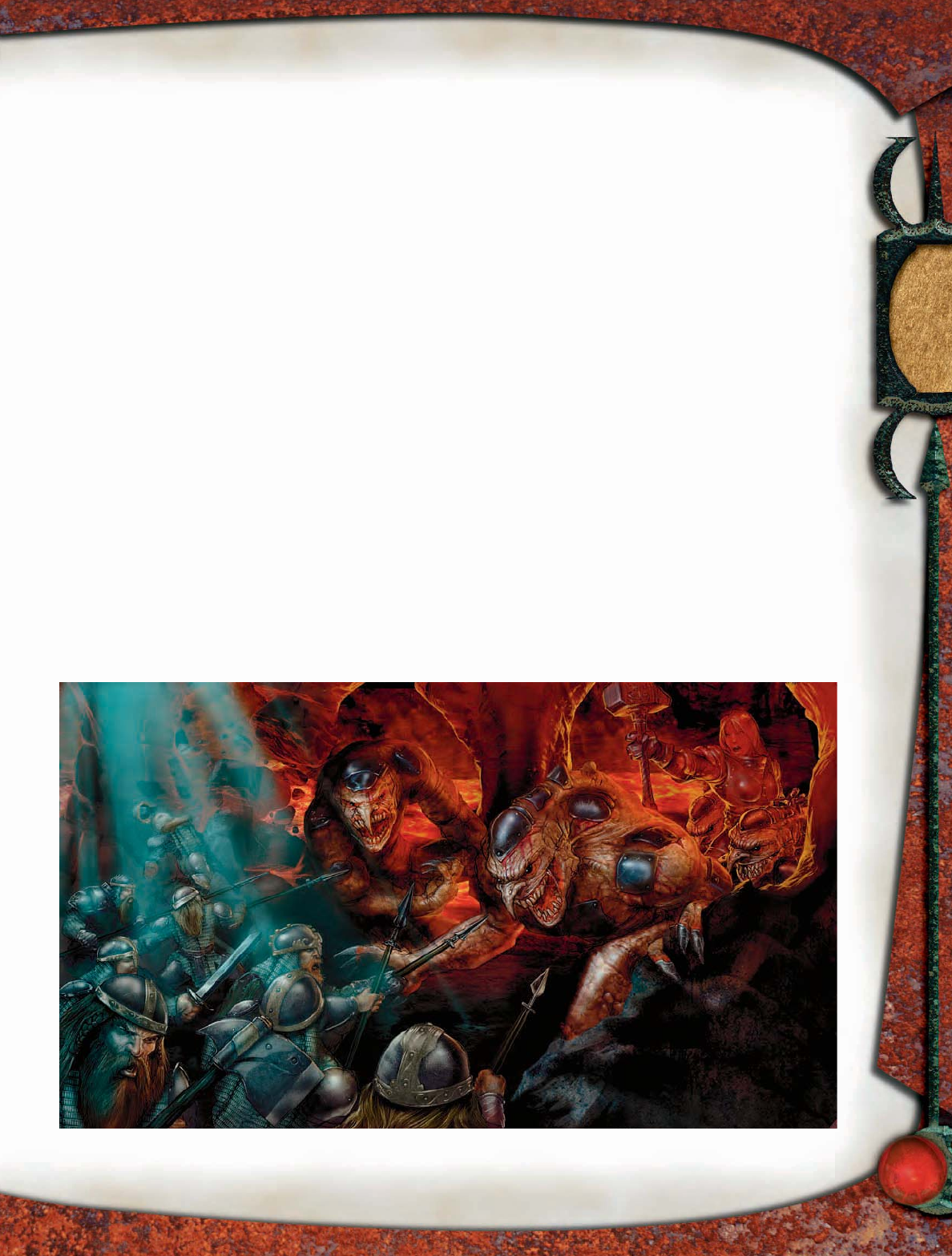
181
Environment: Bladerager trolls are most commonly
found near where normal trolls live and breed, usually
in the vicinity of mountain ranges in colder climates.
After their augmentation, bladerager trolls go where
their masters send them. An independent bladerager troll
wanders blindly, so it might be found far from where trolls
normally range.
Typical Physical Characteristics: Bladeragers resemble
mighty trolls that have armor plating covering large areas
of their body, as well as steel claws and teeth. They are rec-
ognizable for what they are, but their grafts are horrifi c and
bloody. Skin seems to seethe and recede around the armor
due to the troll’s regeneration ability, and blood sometimes
escapes from near the edges of the troll’s plating. A typical
bladerager troll is slightly taller and broader than a normal
troll, and the large amount of metal inserted into its body
makes it weigh about 650 pounds.
Alignment: Trolls are fearless and remorseless hunters
that know nothing of mercy, and bladeragers add unhealthy
doses of madness and brutality to that foul demeanor. Blad-
erager trolls are always chaotic evil.
TYPICAL TREASURE
Bladerager trolls’ tortured minds cannot grasp anything
beyond pain, wholesale slaughter, and the need to feed. They
carry and value no treasure. The trolls’ master might be richer
than normal after collecting the possessions of those slain
by bladerager trolls.
BLADERAGER TROLLS
WITH CLASS LEVELS
Because of their constant agony, bladerager trolls have little
ability to comprehend complex skills. They gain levels as
fi ghters or barbarians, both of which are associated classes
for the creatures.
Level Adjustment: +5.
BLADERAGER TROLLS IN EBERRON
Bladeragers were once frontline troops in Xen’drik’s armies,
but the practice of outfi tting trolls with implanted armor
and weapons vanished with the fall of the giant civilization.
In the southern reaches of the shattered land, a tribe of
cloud giants recently unearthed an armoring chamber and
thereby learned about the bladerager process. The cloud
giants have begun enslaving trolls and transforming them
into bladeragers, hoping these dangerous monstrosities
can tip the balance in a war with several nearby clans
of drow.
BLADERAGER TROLLS IN FAERÛN
Bladerager trolls were fi rst introduced to Faerûn in the armies
of Zhentil Keep, but after that redoubt’s shattering, they were
unleashed upon the world at large. A good number of these
renegade bladeragers wander the Moonsea region, wreak-
ing havoc wherever they appear. One ogre tribe in Thar has
captured a bladerager troll and uses it as an advance strike
unit during battles.
A fi re giant orders her bladerager trolls into battle against dwarves
TROLL,
BLADERAGER
Illus. by A. Swekel

182
TUSK TERROR
Though this creature resembles an angry wild boar, its eyes glint
with a dark intelligence. The beast bears a long, flexible tail and
wide-set serrated tusks that glisten with spittle. Bulges of muscle
ripple beneath its mottled fur as it charges.
Tusk Terror CR 8
Usually CN Medium magical beast
Init +7; Senses darkvision 60 ft., low-light vision; Listen +3,
Spot +3
Languages Tusk Terror; understands Common and
Undercommon
AC 20, touch 17, flat-footed 13; Dodge, Mobility
(+7 Dex, +3 natural)
hp 110 (13 HD)
Fort +11, Ref +15, Will +6; mobile
Speed 80 ft. (16 squares); Spring Attack
Melee gore +15 (1d8+2) and
2 claws +10 each (1d4+1)
Space 5 ft.; Reach 5 ft.
Base Atk +13; Grp +15
Abilities Str 14, Dex 25, Con 16, Int 11, Wis 14, Cha 9
Feats Acrobatic, Dodge, Improved Natural Weapon (gore),
Mobility, Spring Attack
Skills Balance +25, Jump +40, Listen +3, Spot +3, Tumble +35
Advancement 14–20 HD (Medium); 21–26 HD (Large)
Mobile (Su) A tusk terror has a +6 racial bonus on saving
throws made to avoid effects that would restrict its
movement. This includes the Will save against a slow
spell, the Reflex save made to avoid the full effect of a
web spell or a tanglefoot bag, and so on.
Skills Tusk terrors have a +8 racial bonus on Balance, Jump,
and Tumble checks. They can choose to take 10 on
Balance, Jump, and Tumble checks even if rushed or
threatened.
Tusk terrors are intelligent predators that resemble the wild
boars they were bred from. Deviously cunning and danger-
ously unpredictable, these creatures are fi erce combatants.
STRATEGIES AND TACTICS
Tusk terrors fi ght by making use of their Spring Attack feat,
dashing in for a devastating bite, then retreating behind
cover or beyond the range of counterattacks. Their high
ranks in Tumble combine with their skill mastery to allow
them to move through threatened areas and even squares
occupied by hostile characters without provoking attacks of
opportunity. Using Balance and Jump, they can move easily
across diffi cult terrain.
Tusk terrors prefer to fi ght in a large area that offers cover
and features obstacles. They can jump vertically to attack
low-flying creatures, but are wary of attacks from the air.
In normal terrain, a tusk terror can long jump 50 feet or
high jump 12 feet (half those distances without a running
start), tumble past eleven opponents at full speed, or tumble
through six opponents at full speed without having to roll
for its checks.
Tusk terrors fi ght well in packs, taking advantage of their
speed and Spring Attack to move into flanking position,
attack, then move off again. A tusk terror that is badly
wounded tries to fl ee from combat. These creatures rarely
fi ght to the death.
SAMPLE ENCOUNTER
Tusk terrors sometimes gather in small packs. A pack of
these creatures typically contains two to six members. They
cooperate intelligently, but if the fight turns against one
particular creature, it invariably flees. Packs seldom stay
together longer than the length of a hunting season. Mated
pairs are an exception, normally staying together until any
young reach maturity.
Terror Pack (EL 10): Three tusk terrors have been hunting
together in a thick forest for a month, and they employ refi ned
tactics. Having witnessed too many settlers despoiling their
hunting grounds, they attack humanoids on sight. A few
hunters have fallen to their attacks, and the locals in the area
fear the woods now.
ECOLOGY
Tusk terrors maintain their position in an area not by chal-
lenging other predators, but by running away from those that
might defeat them. Singly or in packs, tusk terrors establish
a territory and become intimately familiar with it. Whether
hunting or hunted, this familiarity allows them to use cover
and diffi cult terrain to their best advantage.
Tusk terrors prefer to hunt single slow-moving creatures,
attacking such beasts repeatedly and granting little chance
for the target to counterattack. A single tusk terror can kill
an animal as large as an elephant with little trouble, but if
smaller, faster prey is the only option, the tusk terror’s speed
is up to the chase.
This is not to say that tusk terrors eat only meat. Like the
wild pigs they resemble, tusk terrors are omnivorous, eating
plants and animals as it suits them. These creatures spend
most of their time hunting and foraging, but hunting provides
more sport to satisfy their bright minds.
pqqqqqqqqqrs
TUSK TERROR LORE
Characters who have ranks in Knowledge (arcana) can learn
more about tusk terrors. When a character makes a success-
ful skill check, the following lore is revealed, including the
information from lower DCs.
Knowledge (Arcana)
DC Result
18 This boarlike creature is a tusk terror, a fi erce and
fast-moving magical beast.
23 Tusk terrors rely on speed and maneuverability to
bring down their prey. They can tumble around
opponents, leap high into the air, and move at
speed through the roughest terrain.
28 Tusk terrors are intelligent and cunning, and
they attack in such a way as to prevent their prey
from fi ghting back. They are not brave creatures,
however, and if seriously injured or threatened,
they typically fl ee.
pqqqqqqqqqrs
TUSK TERROR
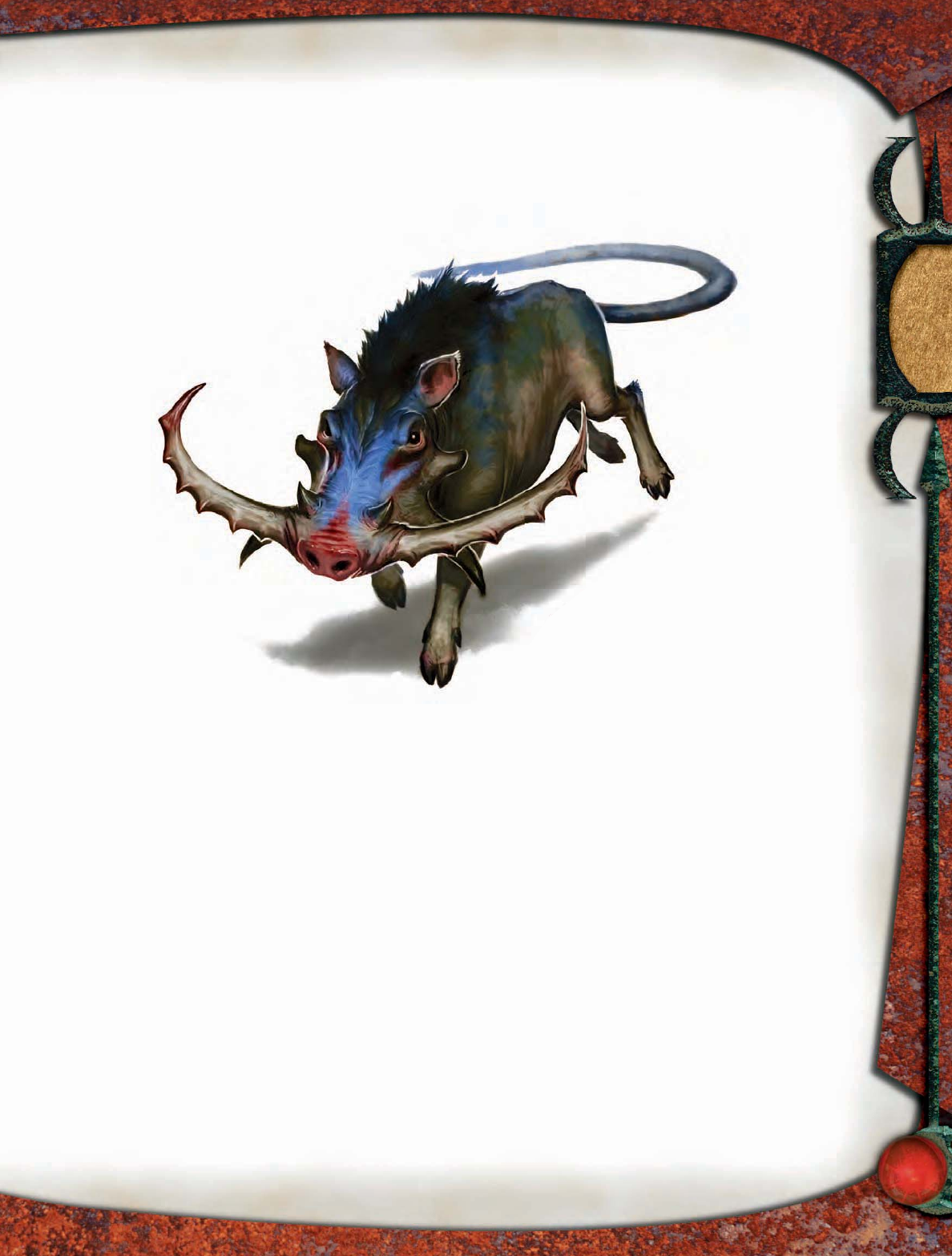
183
Tusk terrors mate seasonally. A pair seldom maintains
a relationship after their young are reared. During the
mating ritual, males vie for females’ attention, engaging
in bloody matches and acrobatic dances. After she selects
her favorite male and mates with him, a female tusk terror
gives birth to a litter of around six tiny terrors four months
later. She feeds them with milk, and the male tusk terror
supplements this diet with meat and forage. Young mature
in about a year.
Environment: Because of their reliance on move-
ment, tusk terrors avoid living in marsh areas,
and deserts rarely have enough prey to sup-
port them. Though they can survive
the cold, they do not like it.
Terrain that
provides cover
and slows
other crea-
tures down
is a tusk
terror’s
preferred
environment.
As such, they are
found in warm or
temperate hills and
mountains, or in temperate forests.
Tusk terrors have a particular af-
fi nity for a plant known as
weary grass (see the sidebar).
They can sense its presence,
and they live near patches of the
strange herb when they can.
Tusk terrors prefer to lair in places that
allow for defense and have ample escape routes. Packs of
tusk terrors typically lair in the open, setting watches
against intruders.
Typical Physical Characteristics: Tusk terrors are
larger than normal boars, about 6 feet long and weigh-
ing 500 pounds. They stand 4 feet high at the shoulder.
Unlike a boar, a tusk terror has a flexible tail as long as its
body, used for balance as it tumbles and jumps. Its fur is
a mottled green and brown under normal circumstances,
but displays bright red and blue patches when the creature
signals aggression.
Alignment: Unorganized and unpredictable, tusk terrors
have little concern for any creatures but themselves. As a
result, nearly all are chaotic neutral.
SOCIETY
Tusk terrors resent hierarchies of any kind, and young leave
the care of their parents as soon as they are able. Packs of up to
six tusk terrors are common, but such groups typically stay to-
gether only a few weeks before one tusk terror begins to assert
dominance and breaks the pack apart. As long as a pack survives,
tusk terrors are highly cooperative, coordinating their at-
tacks in combat
and sleeping
in shifts at
night.
Negotiation
with a tusk terror is
possible, since they understand
Common and Undercom-
mon. Their own language
consists of grunts, roars,
and gestures.
TYPICAL
TREASURE
Tusk terrors have no
treasure of their own.
TUSK TERRORS
IN EBERRON
Tusk terrors are found in the Eldeen
Reaches and the forests of northern Aundair
and Karrnath. Though these creatures keep to
themselves, they are wary of humanoid expan-
sion in their territories. Unprovoked tusk terror
attacks against settlers and explorers are not
uncommon. Tusk terrors also roam the Black-
cap Mountains in Breland, with adventurers claiming that
packs of these creatures actively guard a mountain pass on
the Aundair frontier. Why they do so is unknown.
TUSK TERRORS IN FAERÛN
Tusk terrors are found in the Vilhon Reach, particularly
the Chondalwood and the Cloven Mountains. They favor
the worship of Lurue, although the less chaotic favor
Nobanion. Tusk terrors in Faerûn tend toward good as a
result, but they also count more than a few worshipers
of Malar among their number. The tusk terrors of the
Chondalwood have an understanding with the wild elves
and ghostwise halflings of that place, and all stay out of
each other’s territories.
Tus k t e r r o r
TUSK TERROR
pqqqqqqqqqqqqqqqqqqqqrs
WEARY GRASS
Weary grass looks like normal range grass but secretes a debili-
tating contact poison. When they can, tusk terrors stake their
territories in areas where it grows, since it is low-lying and they
can easily jump over it. A DC 30 Spot check allows a character
to notice weary grass within an area of normal grass. A DC 20
Knowledge (nature) check allows it to be identified.
Weary Grass Poison: Contact, Fortitude DC 17, fatigued/
fatigued.
pqqqqqqqqqqqqqqqqqqqqrs
Illus. by J. Chan
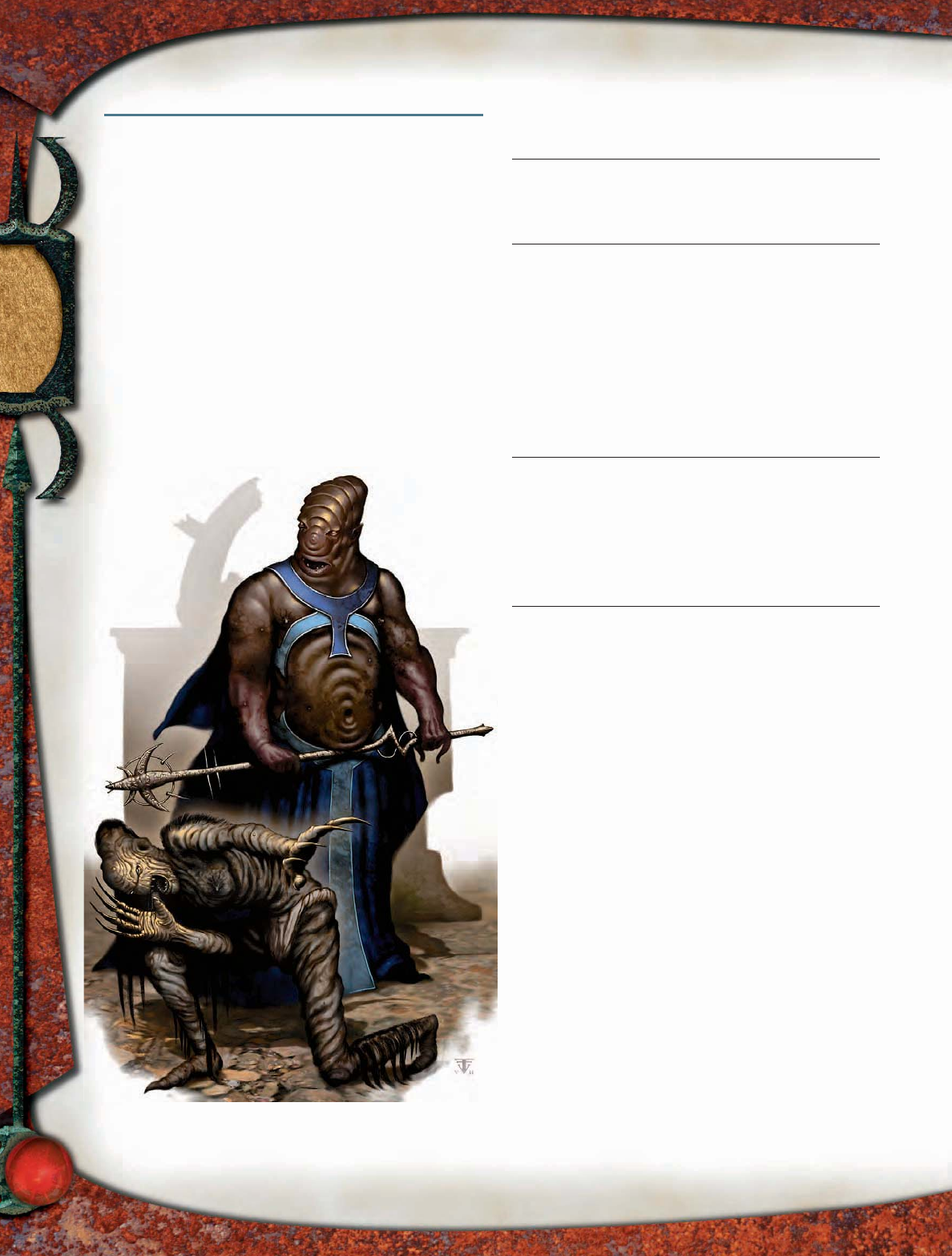
184
USHEMOI
The ushemoi are a strange race whose members gain
increased strength, speed, or arcane power when exposed
to different stimuli. The simplest ushemoi grow tougher
and stronger as they take damage in combat. Their bodies
undergo a powerful physical change, granting them superior
prowess even as their skin toughens to the strength of metal
armor. Other ushemoi grow faster in response to injury, their
limbs becoming longer and more fl exible. The leaders of the
ushemoi are powerful spellcasters whose magic increases in
potency each time it is used.
ARKAMOI
This bald, gray-skinned humanoid is clad in blue robes that
barely cover its portly body. As the skin across its head and
face undulates like rippling water, it clutches an ornate staff
with soft fingers and begins to intone eldritch phrases in a
rumbling voice.
Arkamoi CR 4
Usually NE Medium monstrous humanoid
Init +2; Senses low-light vision; Listen +1, Spot +1
Languages Common, Draconic, Undercommon
AC 14, touch 12, flat-footed 12
(+2 Dex, +2 natural)
hp 29 (4 HD); DR 5/slashing or piercing
SR 14
Fort +3, Ref +6, Will +5
Speed 30 ft. (6 squares)
Melee quarterstaff +4 (1d6)
Ranged light crossbow +6 (1d8/19–20)
Space 5 ft.; Reach 5 ft.
Base Atk +4; Grp +4
Special Actions arcane mastermind
Sorcerer Spells Known (CL 4th); strength from magic:
2nd (5/day)—Melf’s acid arrow (+6 ranged touch), mirror
image
1st (7/day)—burning hands (DC 13), disguise self, jump,
mage armor
0 (6/day)—daze (DC 12), detect magic, fl are (DC 12), light,
ray of frost (+6 ranged touch), read magic
Abilities Str 11, Dex 15, Con 14, Int 15, Wis 12, Cha 15
SA spells, strength from magic
SQ arcane talent
Feats Combat Casting, Toughness
Skills Concentration +9, Hide +9, Knowledge (arcana) +9,
Listen +1, Spellcraft +11, Spot +1
Advancement by character class; Favored Class sorcerer;
see text
Possessions quarterstaff, light crossbow with 20 bolts
Arcane Mastermind (Ex) When an arkamoi’s bonus to spell
save DCs from its strength from magic ability is +3 or
higher, its mind begins to work with lightning precision.
Once per round, as an immediate action, the arkamoi
can lend tactical advice to an ally. This effect grants a +2
morale bonus on that ally’s next check, attack roll, or
damage roll.
Strength from Magic (Ex) Each time an arkamoi casts an
arcane spell, magical feedback grants it a rush of power.
For each arcane spell cast, an arkamoi increases the save
DC of subsequent arcane spells it casts by 1. Additionally,
the arkamoi gains a +2 bonus on damage rolls for
subsequent spells, and gains a +2 deflection bonus to
AC. These benefits last for 1 minute starting in the round
during which the arkamoi finishes casting its first spell of
the encounter.
Bonuses stack each time an arkamoi casts an arcane
spell within that minute, to a maximum of a +5 bonus
to save DCs, a +10 bonus on damage rolls, and a +10
deflection bonus to AC. At the end of that minute, all
these bonuses disappear. They could begin accumulating
again if the arkemoi casts more spells.
Arcane Talent (Ex) An arkamoi casts spells as a 4th-level
sorcerer.
Arkamoi are the thinkers, leaders, and arcane spell-
casters of the ushemoi. They have an innate ability for
arcane magic, and their keen minds allow them to lead
with ruthless efficiency. Though arkamoi are physically
weaker than others of their kind, the other ushemoi
take a deferential attitude toward them. Lashemoi and Lashemoi and arkamoi
USHEMOI
Illus. by F. Vohwinkel
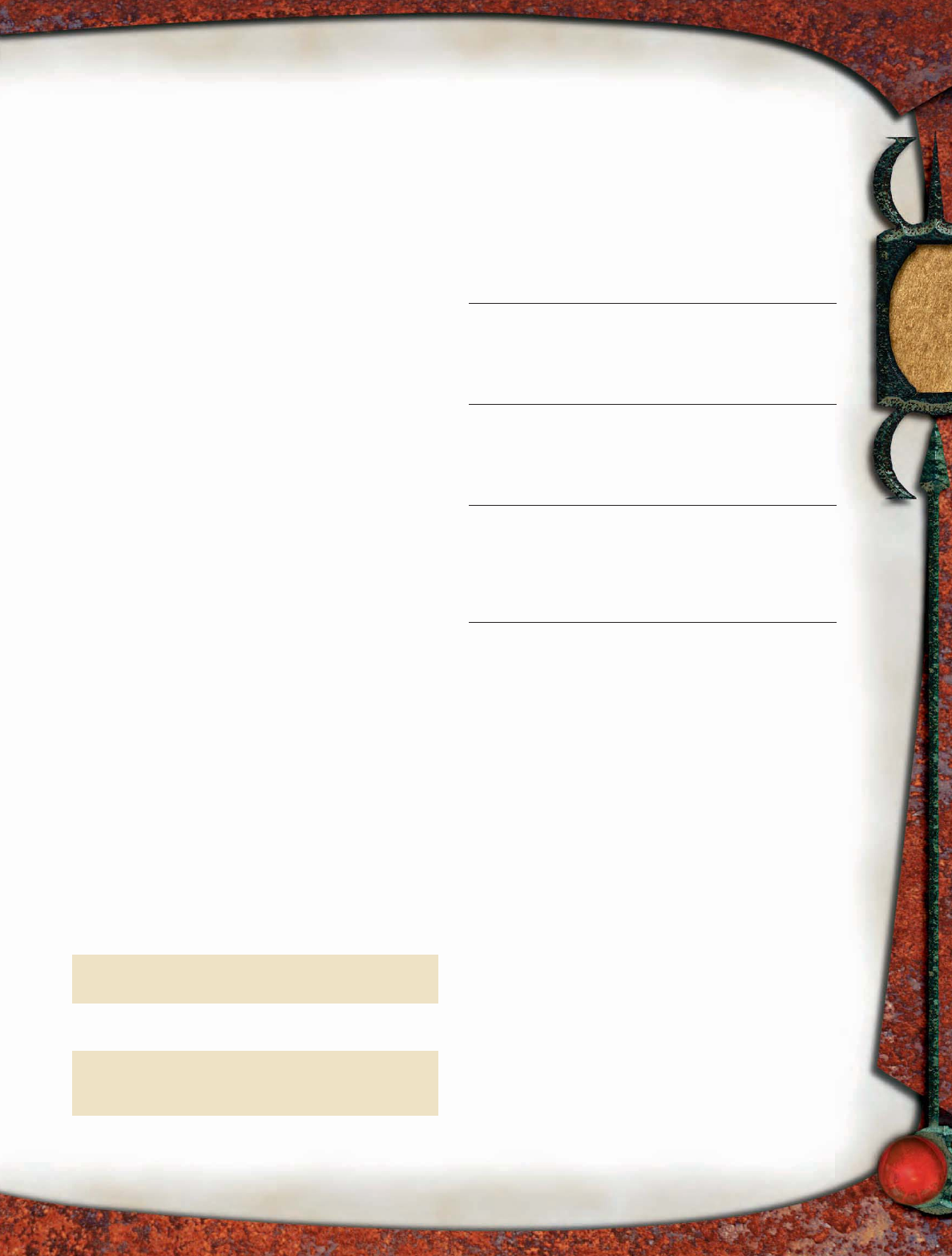
185
turlemoi are happy to acquiesce to the arkamoi’s natural
leadership, while hadrimoi recognize the arkamoi as
savvy commanders with a knack for turning a situation
to their advantage.
When an arkamoi casts spells, for a time the energy fl ow-
ing through its body sharpens its mind and improves each
spell it subsequently casts. As its spellcasting skill soars, an
arkamoi becomes increasingly deadly.
Strategies and Tactics
Arkamoi prefer to build their arcane energies by fi rst pick-
ing away at the enemy with their lesser spells, particularly
ray of frost and daze. As their spellcasting ability improves,
they unleash Melf’s acid arrow and burning hands. Though
arkamoi are ill suited to melee combat, their damage reduc-
tion and strength from magic bonus to AC—augmented
by mage armor and mirror image—sometimes makes them
overconfi dent in their own ability to avoid harm. As such,
they push to the front lines in ways that traditional sorcer-
ers do not.
One of the most useful talents of arkamoi is their ability to
plan a battle around their kin’s strengths and weaknesses.
A band of ushemoi led by an arkamoi might use hadrimoi
to spring an attack. As the hadrimoi gain speed but lose
their stomach for battle, they lure the enemy toward an
ambush of turlemoi. The arkamoi then uses burning hands
to harm as many turlemoi as possible, increasing the
strength of its brutish troops while improving its own
spellcasting ability.
Arkamoi with Class Levels
Sorcerer is the favored class of arkamoi. As an associated class,
levels in sorcerer stack with an arkamoi’s innate spellcasting
ability. Levels in other classes (even spellcasting classes) are
not associated.
Level Adjustment: +4.
HADRIMOI
A thin, lithe humanoid darts from cover as you strain to catch a
glimpse of it. Its skin is composed of fi brous tendrils, and two red eyes
and a fanged mouth dominate its face. Both its arms split off into
separate limbs just below the elbow, and in each of its four hands it
spins a dagger with practiced ease.
Hadrimoi CR 5
Usually NE Medium monstrous humanoid
Init +8; Senses low-light vision; Listen +4, Spot +4
Languages Common, Undercommon
AC 14, touch 14, flat-footed 10; Dodge, Mobility
(+4 Dex)
hp 58 (9 HD); DR 10/slashing and piercing; speed from
pain
Fort +5, Ref +10, Will +7
Weakness falling courage
Speed 30 ft. (6 squares)
Melee 4 daggers +13 each (1d4+1) with perfect symmetry
Ranged dagger +13/+8 (1d4+1)
Space 5 ft.; Reach 5 ft.
Base Atk +9; Grp +10
Atk Options dagger dance
Abilities Str 13, Dex 18, Con 14, Int 12, Wis 13, Cha 11
SA dagger dance, perfect symmetry, speed from pain
Feats Dodge, Improved Initiative, Mobility, Weapon
Finesse
Skills Hide +13, Jump +7, Listen +4, Move Silently +13,
Sleight of Hand +10, Spot +4
Advancement by character class; Favored Class rogue
Speed from Pain (Ex) Each time a hadrimoi takes damage,
the fibrous tendrils that make up its body become
increasingly elastic and responsive. The hadrimoi gains
a +2 dodge bonus to AC, a +1 bonus on attack rolls and
Reflex saves, and a +10-foot bonus to its land speed.
These benefits last for 1 minute starting in the round
during which a hadrimoi first takes damage in the
encounter.
Bonuses stack each time a hadrimoi takes damage,
to a maximum of a +10 dodge bonus to AC, a +5
bonus on attack rolls and Reflex saves, and a +50-foot
bonus to land speed. These bonuses accrue each time
a hadrimoi takes damage during that minute, even
from multiple attacks in the same round. At the end of
that minute, all these bonuses disappear. They could
begin accumulating again if the hadremoi takes more
damage.
Falling Courage (Ex) A hadrimoi whose bonus to speed
from its speed from pain ability is +30 feet or higher
takes a –4 penalty on saves against fear effects and on
the level check made to oppose an Intimidate check. In
addition, when in this state, a hadrimoi can be affected
by fear effects that do not normally affect creatures of its
Hit Dice.
Perfect Symmetry (Ex) As a full attack, a hadrimoi can
attack with up to four light weapons with no penalty on
attack rolls. If it tries to use heavier weapons, it can make
multiple attacks only according to its base attack bonus,
and it takes the normal penalties for attacking with two or
more weapons.
Dagger Dance (Ex) As a hadrimoi converts its pain to
superior agility, it can perform a deadly attack. When
pqqqqqqqqqrs
ARKAMOI LORE
Characters who have ranks in Knowledge (nature) can learn
more about arkamoi. When a character makes a successful
skill check, the following lore is revealed, including the infor-
mation from lower DCs.
Knowledge (Nature)
DC Result
14 This gray-skinned creature is an arkamoi, one of
the spellcasters and leaders of the ushemoi. This
result reveals all monstrous humanoid traits.
19 An arkamoi has the natural talents of a sorcerer,
but its magic becomes more potent with each
spell it casts.
24 An arkamoi’s ever-increasing spellcasting power
also makes it harder to hit. Arkamoi at the peak of
their spellcasting power can direct their allies to
greater effi ciency in combat.
pqqqqqqqqqrs
USHEMOI
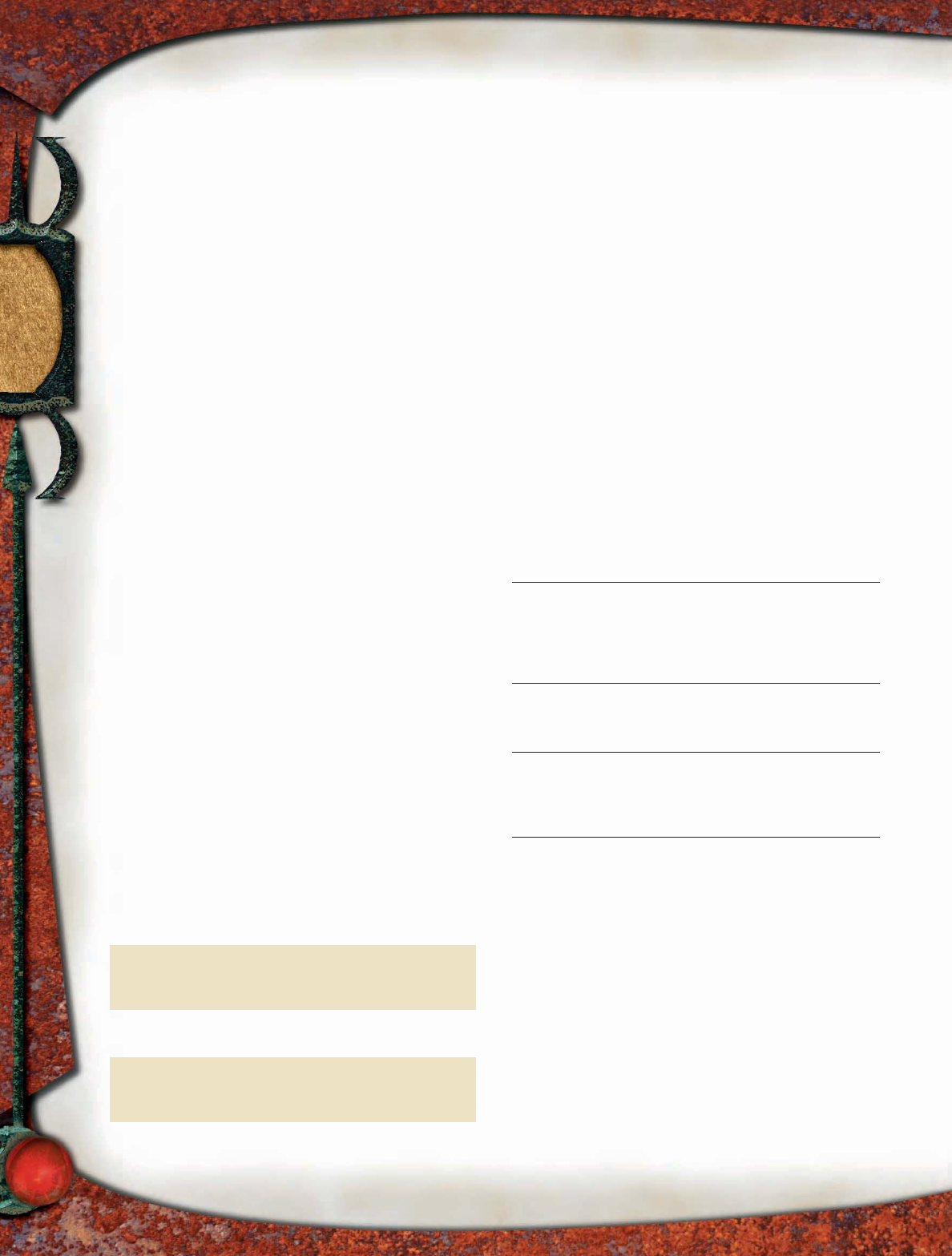
186
a hadrimoi’s bonus to speed from its speed from pain
ability is +30 feet or higher, the creature can move up
to its speed as part of a full attack. It can move before,
after, or between each of its attacks, as long as its total
movement in the round does not exceed its speed.
The wandering hadrimoi are shiftless vagabonds will-
ing to do nearly anything to earn a little coin or a meal.
Though their monstrous appearance prevents them
from moving openly in human society, they thrive in
the shadowy corners of the criminal underworld, where
their innate speed and agility make them excellent thugs
and assassins.
Hadrimoi gather in small bands, hoping to better defend
against their enemies. When found in these traveling groups,
they typically have a few turlemoi along as enforcers. Unlike
their larger cousins, hadrimoi have a nasty nature in and
out of combat. They take advantage of the turlemoi’s natural
cowardice to cow them into submission.
As a hadrimoi takes damage, it grows taller and thinner.
The grooves in its skin become smooth as its body fi lls out
to its full size. In this form, a hadrimoi gains great speed
and agility.
Strategies and Tactics
A hadrimoi attack is a sudden blur of steel that leaves vicious
dagger wounds in its wake. However, though hadrimoi are
aggressive, they are inherent cowards even before their fall-
ing courage takes effect. They prefer to attack from ambush,
but if a battle turns against them, they use their superior
speed to fl ee.
Hadrimoi are careful to avoid getting bogged down in a
fi ght. Though they place survival above winning, they never
enter a battle unless they are sure that the reward of victory
outweighs the risk of defeat.
A foiled hadrimoi is a dangerous foe. Though vanquished
orcs and goblins might simply run for their lives and seek
out easier targets in the future, hadrimoi ruminate over
every defeat. Plotting endless schemes of revenge despite
their cowardice, hadrimoi return again and again to fi ght
those who have bested them. More than one adventuring
band has defeated a group of hadrimoi in battle only to fi nd
themselves targeted by poison, ambush, and attacks against
allies and loved ones. To defeat a hadrimoi and let it live is
to create a lifelong enemy.
Hadrimoi with Class Levels
Hadrimoi usually advance as rogues. That class, the fi ghter class,
and the ranger class are considered associated for hadrimoi.
Level Adjustment: +4.
LASHEMOI
This gaunt humanoid’s wrinkled gray skin seems too ample for its
body. A plume of ragged hair hangs from the back of its skull, and
patches of its skin are also hairy. It crouches low, snarling as long
claws extend from its fi ngers.
Lashemoi CR 1
Usually NE Medium monstrous humanoid
Init +0; Senses low-light vision; Listen +0, Spot +2
Languages Common
AC 12, touch 10, flat-footed 12
(+2 natural)
hp 15 (2 HD); DR 5/slashing or piercing; lesser strength from
pain
Fort +3, Ref +3, Will +3
Weakness broken courage
Speed 30 ft. (6 squares)
Melee 2 claws +4 each (1d4+1)
Space 5 ft.; Reach 5 ft.
Base Atk +2; Grp +3
Abilities Str 12, Dex 11, Con 16, Int 5, Wis 11, Cha 8
SA lesser strength from pain
Feats Weapon Focus (claw)
Skills Hide +3, Listen+0, Spot +2
Advancement by character class; Favored Class barbarian
Broken Courage (Ex) A lashemoi takes a –4 penalty on
saves against fear effects and on the level check made
to oppose an Intimidate check. In addition, a lashemoi
can be affected by fear effects that do not normally affect
creatures of its Hit Dice.
Lesser Strength from Pain (Ex) Whenever a lashemoi takes
damage from any source, it gains a +1 bonus on attack
rolls, a +1 bonus on damage rolls, and its natural armor
bonus to AC increases by 1. These benefits last for 1
minute starting in the round during which a lashemoi
first takes damage in the encounter.
Bonuses stack each time a lashemoi takes damage, to
a maximum of a +5 bonus on attack rolls, a +5 bonus on
damage rolls, and a +5 natural armor bonus to AC. These
bonuses accrue each time a lashemoi takes damage
during that minute, even from multiple attacks in the
same round. At the end of that minute, all these bonuses
disappear. They could begin accumulating again if the
lashemoi takes more damage.
pqqqqqqqqqrs
HADRIMOI LORE
Characters who have ranks in Knowledge (nature) can learn
more about hadrimoi. When a character makes a successful
skill check, the following lore is revealed, including the infor-
mation from lower DCs.
Knowledge (Nature)
DC Result
15 This creature is a hadrimoi, one of a race called
the ushemoi. Hadrimoi are subtle combatants,
relying on stealth and speed to overcome their
foes.
20 Hadrimoi are the scouts, spies, and assassins of
the ushemoi. Their arms split into two limbs each,
allowing them to fi ght with four weapons.
25 As they take damage, hadrimoi become faster,
more agile, and increasingly deadly in combat. At
its peak, a hadrimoi can move at full speed while
making four dagger attacks during its turn.
pqqqqqqqqqrs
USHEMOI
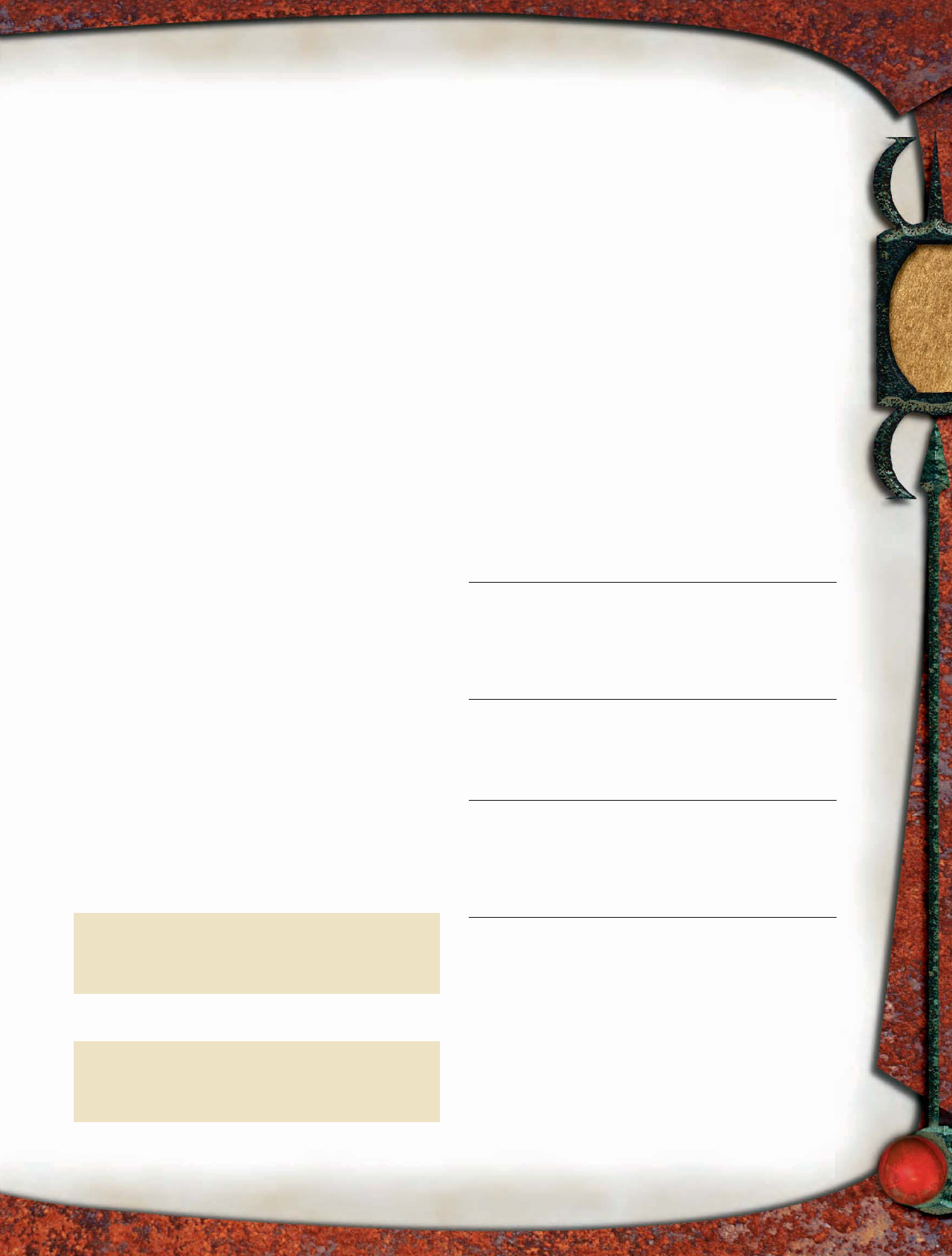
187
Lashemoi are the drudge workers, low-ranking warriors,
and servitors of ushemoi society. Though lashemoi typically
toil under the direction of arkamoi and hadrimoi leaders,
turlemoi sometimes gather lashemoi to them as hunters,
scouts, and expendable advance troops.
Without leadership, lashemoi keep to themselves. Though
they attack other creatures for food and treasure, they are
meek, cowardly, and easily driven off. Lashemoi avoid stand-
up fi ghts even against weaker foes and are typically content
to take potshots at soft, easy targets.
Lashemoi have a natural connection to their ushemoi
brethren, but they are just as likely to be found in the service
of ogre mages, hobgoblin chieftains, evil clerics, and the like.
Other ushemoi refer to lashemoi as “mongrels,” not because
of their heritage, but for the lashemoi’s tendency to follow
any charismatic creature.
Strategies and Tactics
Lashemoi are built for simple tactics. They rush forward
and attempt to overwhelm their enemies with raw num-
bers, relying on their lesser strength from pain ability to
amplify their fighting prowess. Superior odds and a clear
escape route are the lashemoi’s only concerns in combat.
If these are not present, lashemoi are unlikely to fight
unless pressed.
Lashemoi gain a deep, satisfying emotional rush from
their lesser strength from pain ability. As a lashemoi
takes damage, it enters an increasingly ecstatic state. As
a result, lashemoi that are lightly wounded can assess a
potential loss and flee from it, but those that have taken
grievous injuries typically fight to the death. Lashemoi
that are not badly injured use their allies’ battle lust to
cover their own retreat.
Lashemoi under the command of an organized leader
are willing and eager servants. They are easily bullied,
and their naturally timid and cowardly nature is easily
overcome with sufficient prodding and training. Power-
ful creatures such as ogre mages love to use lashemoi as
disposable shock troops. This allows them to reserve their
less expendable followers until enemies are softened up
by lashemoi forces taking damage, growing stronger, and
fighting to the death.
Lashemoi with Class Levels
Lashemoi favor the barbarian class. That class is considered
associated for lashemoi.
Level Adjustment: +2.
TURLEMOI
The tall humanoid lumbering toward you resembles a giant stripped
of its skin, leaving glistening, bloody muscle exposed to the air. As it
moves closer, you see that its form consists of thick, knotted tendrils
of fl esh. Its body twitches and twists, seeming to expand and solidify
as it attacks.
Turlemoi CR 8
Usually NE Large monstrous humanoid
Init +6; Senses low-light vision; Listen +7, Spot +7
Languages Common
AC 14, touch 11, flat-footed 12
(–1 size, +2 Dex, +3 natural)
hp 102 (12 HD); DR 10/slashing or piercing; strength from
pain
Immune rising courage
Fort +8, Ref +10, Will +10
Weakness broken courage
Speed 40 ft. (8 squares), climb 30 ft.
Melee 2 slams +15 each (2d6+3)
Ranged rock +13 (1d8+3)
Space 10 ft.; Reach 10 ft.
Base Atk +12; Grp +19
Atk Options Combat Reflexes, Power Attack
Abilities Str 17, Dex 14, Con 18, Int 7, Wis 15, Cha 6
SA rock throwing, strength from pain
Feats Alertness, Combat Reflexes, Improved Initiative, Power
Attack, Weapon Focus (slam)
Skills Balance +5, Climb +11, Jump +10, Listen +7, Spot +7,
Survival +5
Advancement by character class; Favored Class barbarian
Rising Courage (Ex) When a turlemoi’s bonus on attack
rolls from its strength from pain ability is +3 or higher,
it becomes immune to all mind-affecting spells and
abilities. In such a state, turlemoi do not retreat from
combat.
Broken Courage (Ex) A turlemoi takes a –4 penalty on saves
against fear effects and on the level check made to
oppose an Intimidate check. In addition, a turlemoi can
be affected by fear effects that do not normally affect
creatures of its Hit Dice.
Rock Throwing (Ex) Like giants, turlemoi are accomplished
rock throwers. A turlemoi can hurl rocks of 20 to 30
pounds (Tiny objects) up to five range increments. The
range increment is 60 feet for a turlemoi’s thrown rocks.
pqqqqqqqqqrs
LASHEMOI LORE
Characters who have ranks in Knowledge (nature) can learn
more about lashemoi. When a character makes a successful
skill check, the following lore is revealed, including the infor-
mation from lower DCs.
Knowledge (Nature)
DC Result
11 Lashemoi are strange creatures that become
stronger and tougher as they take damage in
combat. They are the weakest form of a race called
the ushemoi. This result reveals all monstrous
humanoid traits.
16 Lashemoi are especially susceptible to fear and
intimidation, but the longer they stay in combat,
the more fi ercely they fi ght.
21 The more damage a lashemoi takes, the greater
its combat prowess becomes. Opponents are
sometimes lulled into a false sense of security
by these creatures’ relative weakness, only to be
overcome by their sudden deadly ferocity.
pqqqqqqqqqrs
USHEMOI
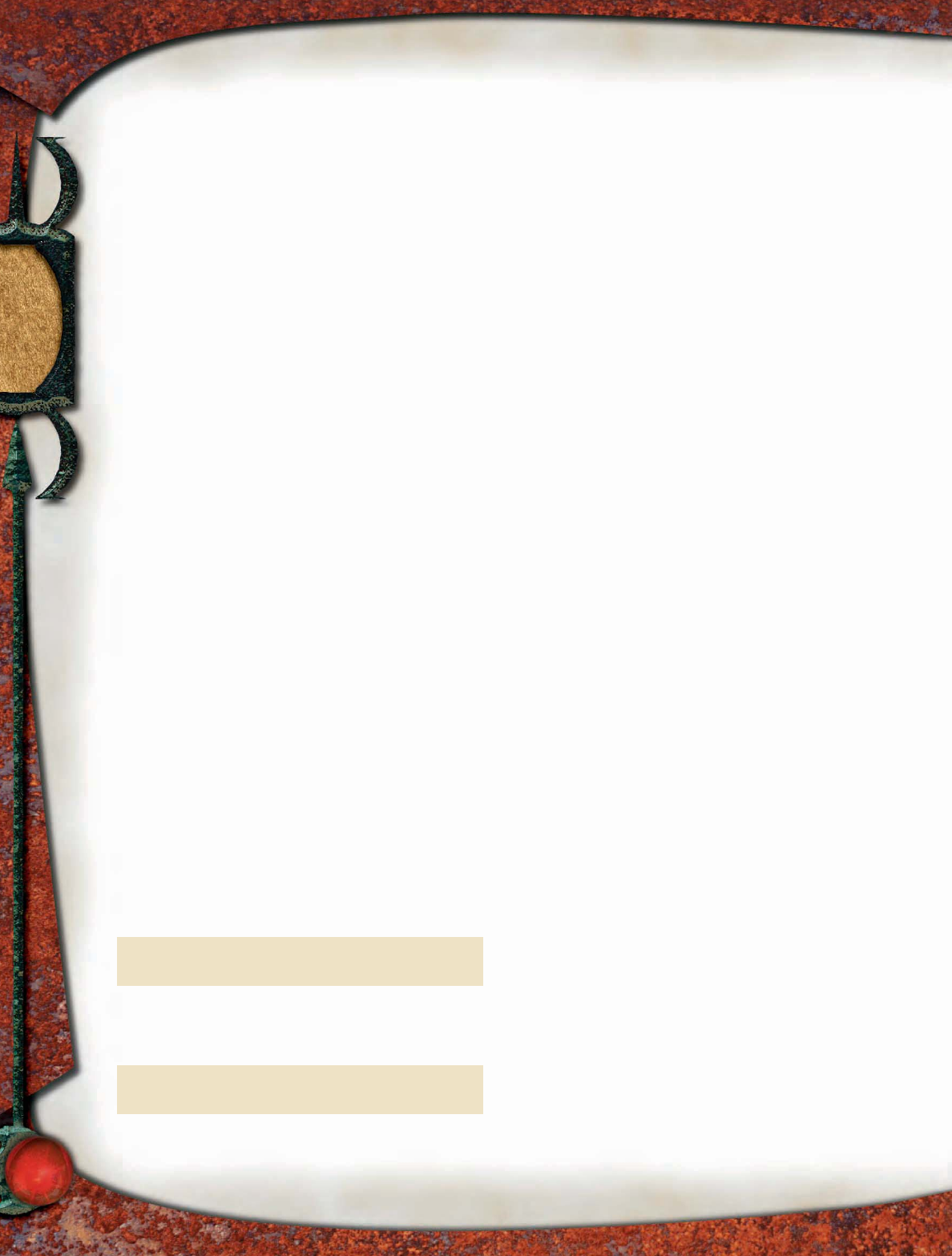
188
Strength from Pain (Ex) Whenever a turlemoi takes damage
from any source, it gains a +1 bonus on attack rolls, a +2
bonus on damage rolls, and its natural armor bonus
to AC increases by 2. These benefits last for 1 minute
starting in the round during which a turlemoi first takes
damage in the encounter.
Bonuses stack each time a turlemoi takes damage,
to a maximum of a +5 bonus on attack rolls, a +10 bonus
on damage rolls, and a +10 natural armor bonus to AC.
These bonuses accrue each time a turlemoi takes damage
during that minute, even from multiple attacks in the
same round. At the end of that minute, all these bonuses
disappear. They could begin accumulating again if the
turlemoi takes more damage.
Turlemoi are the largest of the ushemoi. Solitary creatures,
they wander the wilderness and the back roads in search of
food or easy prey. As a turlemoi takes damage, its tendrils of
fl esh fuse into a crimson shell that covers its body. A turlemoi
that has sustained several injuries looks like a giant with a
smooth, blood-red hide.
A turlemoi’s personality also changes as its body trans-
forms. Though it starts out meek and fearful, it becomes more
confi dent and wrathful the more damage it takes. Though
other creatures might start a fi ght with confi dence and fl ee
when they are injured, turlemoi do the opposite. Once com-
mitted to combat, a turlemoi fi ghts to the death.
Other ushemoi sometimes corner and capture lone
turlemoi to serve as warrior-slaves. Turlemoi are driven
forward from the front ranks with longspears, attaining a
peak of fearless battle fury as they reach the enemy.
Strategies and Tactics
Turlemoi might be brutes, but they have an instinctive
cunning. Some carry stones and clubs, bashing themselves
with these weapons to summon their strength of pain before
combat is joined. The rush of power more than offsets the
discomfort of their injuries. A turlemoi is typically too timid
to injure itself, though, and only imminent threats push it
to such action.
Given time, a turlemoi looks for a good place to set up
an ambush. However, even with their excellent natural
agility, turlemoi have little skill for such tactics. But they
like to ensure that the enemy is within melee range when
a battle begins.
Turlemoi with Class Levels
Like lashemoi, turlemoi favor the barbarian class, but some
advance as fi ghters instead. Both these classes are considered
associated for turlemoi.
Level Adjustment: +4.
SAMPLE ENCOUNTERS
Though they can be encountered individually, ushemoi are
just as often found in mixed groups that take advantage of
their racial abilities.
Wizard’s Bodyguard (EL 4): A lone arkamoi acts as
courier and bodyguard to an infl uential necromancer, using
disguise self to take on the appearance of a young apprentice.
PCs attempting to recover a relic from the necromancer’s
sanctum—or who are in possession of an item the necro-
mancer desires—fi nd themselves shadowed by this apparent
stripling. However, the characters are in for an unpleasant
surprise when the arkamoi unleashes the escalating power
of its magic.
Thick as Thieves (EL 8): Three hadrimoi have banded
together to take over a rural village. By threatening farmers
and merchants, the hadrimoi have built up a widespread
protection racket and created a comfortable life for them-
selves. They take a hard line against characters who might
threaten their operation, including any PCs who happen to
pass through town.
Brute Force (EL 9): A group of three lashemoi serves under
a turlemoi chief that has learned to master its inherent cow-
ardice with self-infl icted wounds to activate its strength from
pain. This group operates along the trade roads, attacking
small caravans and parties on foot. From cover, the turlemoi
uses its rock throwing to take out escort guards. It then sends
the lashemoi in to soften up any remaining defenses before
wading into the fray.
War Party (EL 10): This band of ushemoi consists of eight
lashemoi servants, an arkamoi leader, a hadrimoi scout, and
a turlemoi brute. Along a lonely stretch of forest road, the
arkamoi dispatches the hadrimoi to fi nd promising targets
and attack. The hadrimoi then fl ees in an effort to lure its
targets into the war party’s ambush.
ECOLOGY
The ushemoi are a nomadic race. They lack the desire to form
permanent settlements even as they are compelled to keep
moving to avoid the attention of their former victims.
pqqqqqqqqqrs
TURLEMOI LORE
Characters who have ranks in Knowledge (nature) can learn
more about turlemoi. When a character makes a successful
skill check, the following lore is revealed, including the infor-
mation from lower DCs.
Knowledge (Nature)
DC Result
18 This creature is a turlemoi, one of a race called the
ushemoi. Turlemoi are hulking brawlers, and they
have a reputation for fi ghting to the death.
23 Though turlemoi are the largest and strongest of
the ushemoi, they are naturally cowardly. However,
they grow in strength and courage as they take
damage, so those hoping to overcome these
brutes in combat must do so quickly.
28 Turlemoi in combat eventually become immune to
fear, though they are initially more susceptible to it
than other creatures.
pqqqqqqqqqrs
USHEMOI
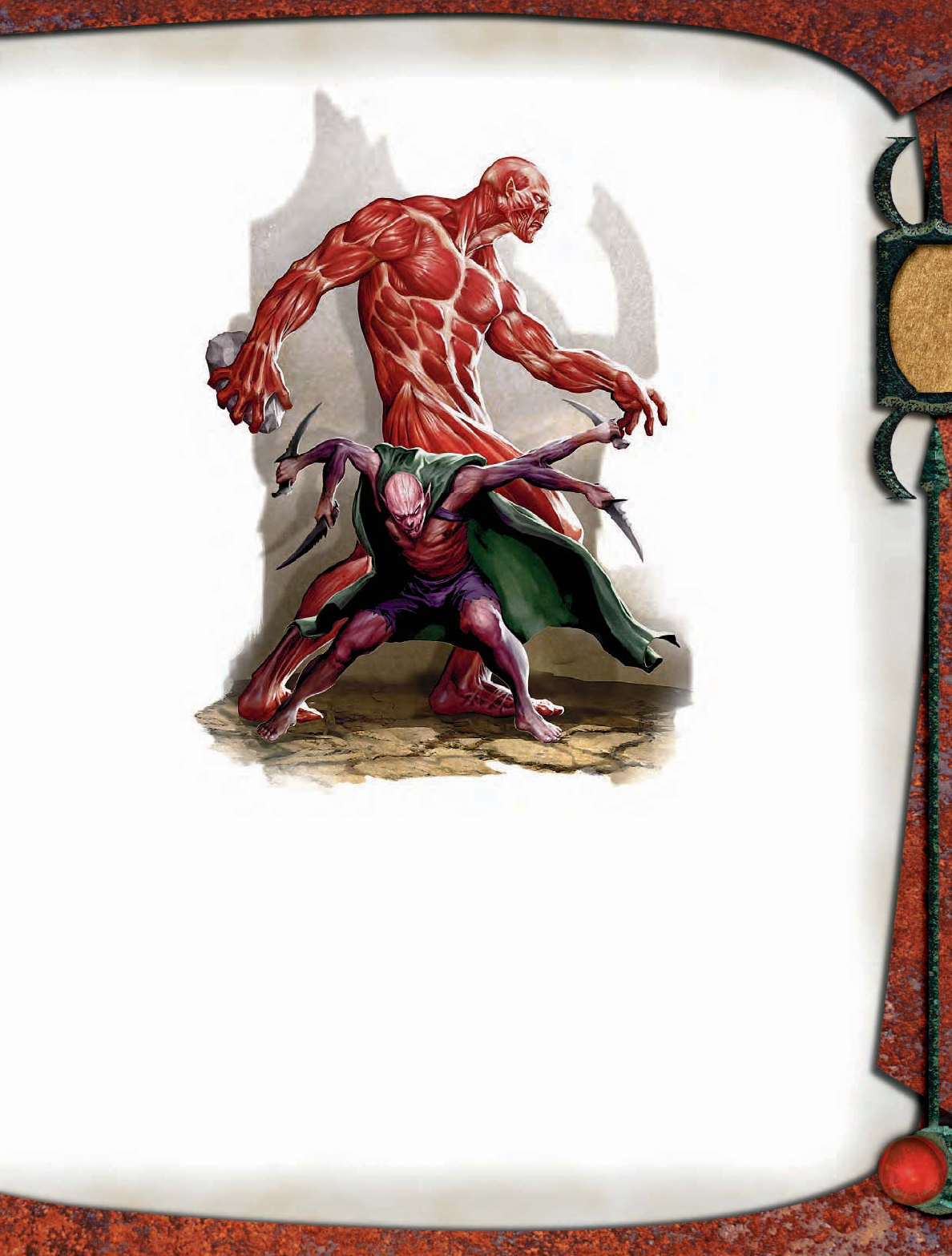
189
Environment: Ushemoi pre-
fer forests of all types, from
steaming jungles to frigid alpine
climes. They rely on cover to set
up ambushes and to protect
them from any large-scale
retaliation.
Typical Physical
Characteristics: The
brawny turlemoi stand
approximately 9 feet
tall and can weigh
1,000 pounds.
Hadrimoi are
lithe and light,
standing 6 feet
tall and weigh-
ing 150 pounds.
Arkamoi are approxi-
mately 6 feet tall and 190
pounds. Lashemoi are 5
feet tall and 130 pounds.
Alignment: Ushemoi
care only for themselves,
willing to do whatever it
takes to fi ll their purses
or secure their needs and
desires. They ally with
others out of con-
venience, but they
are just as likely to
betray allies
for short-term
gain. They are
neutral evil.
SOCIETY
Ushemoi form ragtag groups
that wander the forests and jungles of
unsettled frontier lands. They rarely form organized perma-
nent settlements, and even arkamoi prefer a life of wandering.
To the ushemoi mind, the best defense is to keep as far from
potential foes as possible. By constantly roving, ushemoi stay
one step ahead of the retribution their depredations would
otherwise inspire.
Ushemoi have a caste society as befits their four types.
Arkamoi are natural leaders and thinkers, and small cabals
of arkamoi direct the other ushemoi. Hadrimoi are schem-
ers and merchants. Though they prefer to use violence to
achieve their ends, they sometimes trade stolen and looted
goods to thieves’ guilds and other shady organizations.
Lashemoi make dependable grunt labor
and expendable warriors. Turlemoi are
used as brutal troops or threats to
cow others.
As a group, ushemoi are
adept at blending into so-
cieties that are forgiving
of their strange appear-
ance. Hobgoblins and
other monstrous races
use the simpler turlemoi
and lashemoi as mer-
cenaries or slaves. The
more intelligent hadri-
moi and arkamoi work
with other creatures as
hirelings or allies.
Little sense of loyalty
is found among the ushemoi,
particularly between arkamoi
and hadrimoi. These crea-
tures constantly jockey
for power, even betraying
their own kind to aid non-
ushemoi if the price
is right. Other evil
humanoids might
dream of conquest
for the greater glo-
ry of their culture
or deities, but the
ushemoi look out
only for individual
interests. The idea of
the ushemoi as a unified
race is alien to them.
TYPICAL TREASURE
Ushemoi covet treasure for the comforts and power it
can buy them. A skilled arkamoi sorcerer might live in
luxury as a mercenary spellcaster within a drow city, and
even the dim-witted lashemoi recognize that coins buy
sustenance. Because they are constantly on the move, ush-
emoi favor highly portable treasure. They have standard
treasure for their Challenge Rating. Those ushemoi that
have class levels have standard equipment for an NPC of
their Challenge Rating.
USHEMOI
Turlemoi and hadrimoi
Illus. by J. Zhang
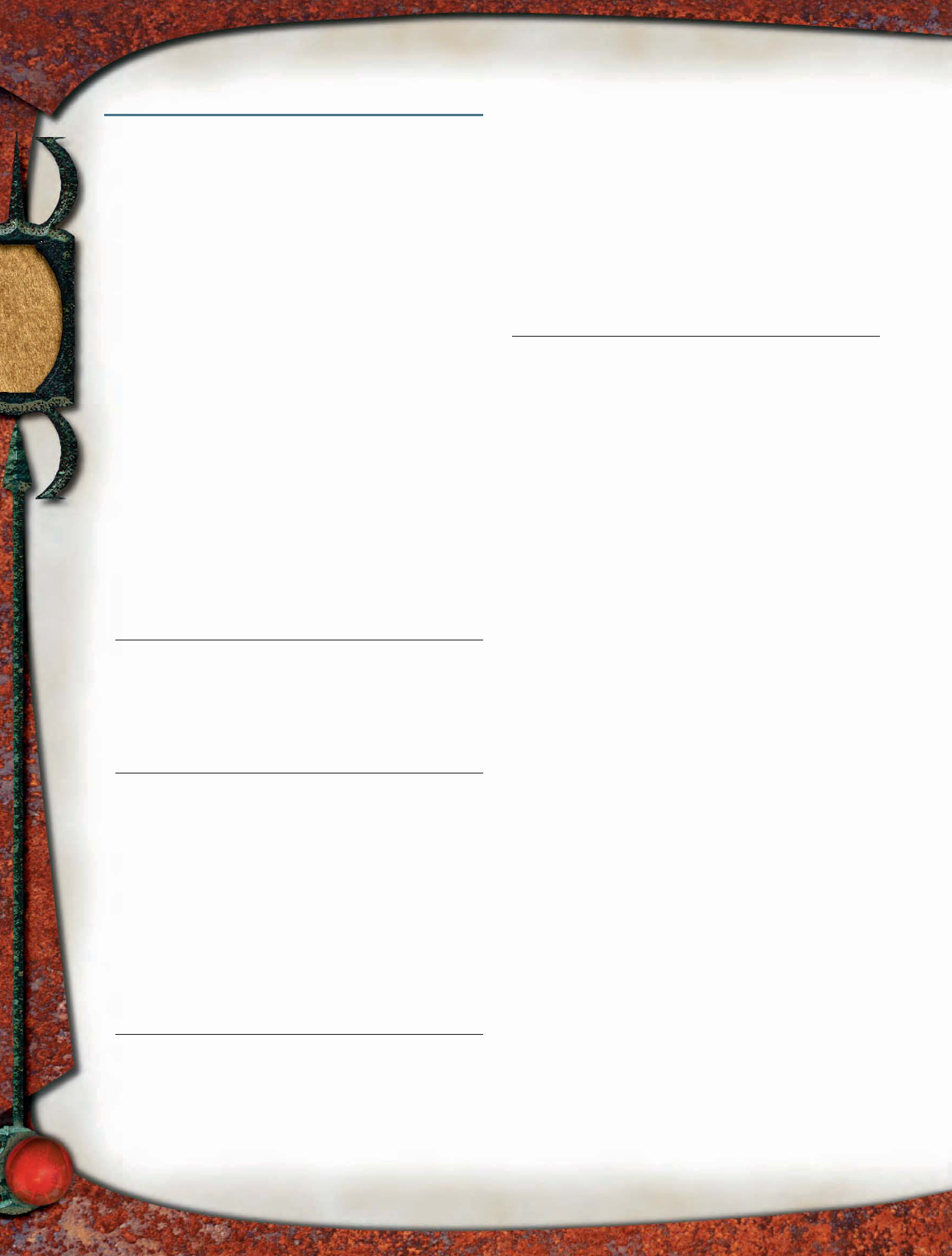
190
VAMPIRES
As described in the Monster Manual, vampires are power-
ful undead creatures that prowl the night in search of the
blood that gives them sustenance. Incredibly intelligent
and equipped with a number of potent abilities, they are the
defi nitive evil masterminds, forever conceiving ever more
nefarious plots.
This section presents two examples of vampires suitable
for use as recurring villains in an ongoing campaign or as
potent adversaries for high-level adventurers. One is a more
straightforward threat with considerable martial prowess,
and the other is a criminal mastermind potentially at the
center of a web of intrigue.
The vampire template is described on page 250 of the
Monster Manual.
THE BLACK DUKE
A mighty warrior steps into view through the fog, adorned in
gleaming mithral armor. The massive blue blade in his hands is
wrapped with tendrils of mist. Through the grate of his wolf-shaped
helm, the dark fi gure laughs.
The Black Duke CR 19
Male vampire knight 7*/ronin 10*
* Classes described in PH2 and Complete Warrior
respectively
CE Medium undead (augmented humanoid)
Init +8; Senses darkvision 60 ft.; Listen +11, Spot +11
Languages Common, Draconic, Infernal
AC 42, touch 19, flat-footed 38; Dodge, shield block +1
(+4 Dex, +10 armor, +7 shield, +4 deflection, +1
insight, +6 natural)
hp 110 (17 HD); fast healing 5; DR 10/magic and silver
Immune undead immunities
Resist cold 10, electricity 10, +4 turn resistance
Fort +12, Ref +14, Will +12
Weakness vampire weaknesses (MM 253)
Speed 30 ft. (6 squares); Ride-By Attack, armor mastery
(medium), spider climb
Melee +4 keen frost bastard sword +29/+24/+19/+14
(1d10+12/17–20 plus 1d6 cold) or
Melee slam +29 (1d6+12 plus energy drain)
Ranged +2 seeking composite longbow +23/+18/+13/+8
(1d8+7/×3)
Base Atk +17; Grp +33
Atk Options Cleave, Combat Reflexes, Great Cleave,
Mounted Combat, Power Attack, Spirited Charge,
Trample, banzai charge, blood drain, bulwark of defense,
magic strike, sneak attack +4d6, vigilant defender
Special Actions alternate form, children of the night, create
spawn, dominating gaze, gaseous form, shield ally
Combat Gear 2 potions of inflict light wounds, potion of inflict
moderate wounds
Abilities Str 27, Dex 18, Con —, Int 14, Wis 12, Cha 17
SA blood drain, children of the night, create spawn,
dominating gaze, energy drain, magic strike, sneak attack
SQ infamy
Feats Ability Focus (dominating gaze), AlertnessB, Cleave,
Combat ReflexesB, DodgeB, Exotic Weapon Proficiency
(bastard sword), Great Cleave, Improved Grapple,
Improved InitiativeB, Improved Unarmed Strike, Lightning
ReflexesB, Mounted CombatB, Power Attack, Ride-By
AttackB, Spirited ChargeB, TrampleB
Skills Bluff +21, Climb +16, Diplomacy +11, Disguise +13
(+15 acting), Hide +10, Intimidate +25, Jump +12,
Knowledge (nobility and royalty) +12, Listen +11, Move
Silently +10, Ride +24, Search +10, Sense Motive +19,
Spot +11
Possessions combat gear plus +5 mithral breastplate, +5
undead controlling heavy steel shield, +4 keen frost
bastard sword, +2 seeking composite longbow (+5 Str
bonus) with 20 arrows, amulet of mighty fists +4, belt
of giant strength +6, cloak of resistance +3, gloves of
Dexterity +2, howling helm, ring of protection +4, dusty
rose ioun stone
Shield Block (Ex) On the Black Duke’s turn, he can designate
a single opponent and increase his shield bonus to AC by
1 against all attacks made by that opponent.
Armor Mastery (Medium) (Ex) The Black Duke does not
reduce his speed when wearing medium armor.
Spider Climb (Ex) Climb sheer surfaces as though with a
spider climb spell.
Energy Drain (Su) Living creatures hit by the Black
Duke’s slam attack gain two negative levels. For each
negative level bestowed, the Black Duke gains 5
temporary hit points that last for up to 1 hour. DC 21
Fortitude save to remove a negative level. The save DC is
Charisma-based.
Banzai Charge (Ex) When making a charge, the Black Duke
can take a penalty to his AC and receive an equivalent
bonus on the damage roll. The normal –2 AC penalty for
charging applies and counts toward the bonus. The Black
Duke can take a penalty from –2 to –17.
Blood Drain (Ex) The Black Duke can suck blood from
a living victim with his fangs by making a successful
grapple check. If he pins the foe, he drains blood,
dealing 1d4 points of Constitution drain each round the
pin is maintained. On each successful blood drain, the
Black Duke gains 5 temporary hit points that last for up
to 1 hour.
Bulwark of Defense (Ex) An opponent that begins its turn in
the Black Duke’s threatened area treats all squares the
Black Duke threatens as difficult terrain.
Vigilant Defender (Ex) The DC for Tumble checks made to
move through a space threatened or occupied by the
Black Duke increases by 7.
Alternate Form (Su) The Black Duke can assume the
form of a bat, dire bat, wolf, or dire wolf as a standard
action. When in his alternate form, the Black Duke
loses his natural slam attack and dominating
gaze ability, but he gains the natural weapons and
extraordinary special attacks of his new form. The
Black Duke can remain in bat, dire bat, wolf, or dire
wolf form until he chooses to assume a new form or
until the next sunrise.
Children of the Night (Su) Once per day, the Black Duke can
call 1d6+1 rat swarms, 1d4+1 bat swarms, or a pack of
3d6 wolves. These creatures arrive in 2d6 rounds and
serve the Black Duke for 1 hour.
Create Spawn (Su) A humanoid or monstrous humanoid
slain by the Black Duke’s energy drain rises as a vampire
spawn 1d4 days after burial. If the Black Duke instead
drains the victim’s Constitution to 0 or lower, the victim
returns as a spawn if it had 4 or fewer HD and as a
vampire if it had 5 or more HD. In either case, the new
VAMPIRES
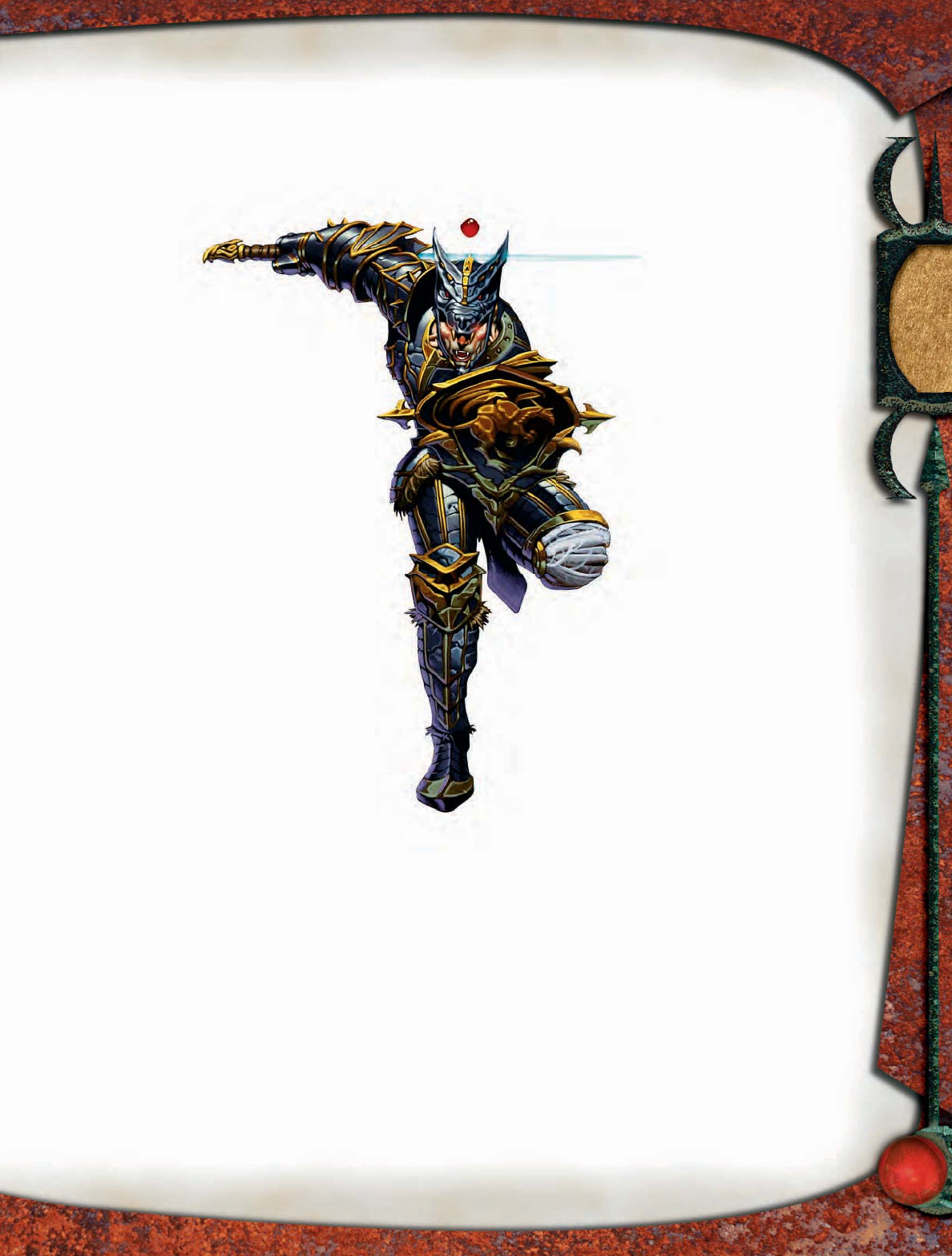
191
vampire or spawn is under the Black Duke’s command
and remains enslaved until his destruction.
At any given time, the Black Duke can have no more
than 34 enslaved spawn, though vampires he creates can
have enslaved spawn of their own.
Dominating Gaze (Su) As the dominate person spell, range
30 feet, Will DC 22 negates, caster
level 12th. The save
DC is Charisma-
based.
Gaseous Form
(Su) As the
gaseous form
spell; at will; caster level 5th.
The Black Duke can remain in this
form indefinitely, and he has a fly speed of
20 feet with perfect maneuverability while
in gaseous form.
Shield Ally (Ex) As an immediate action, the
Black Duke can choose to take half the
damage dealt to an adjacent ally from a
physical attack. Each time the ally takes
damage from a physical attack before the
Black Duke’s next turn, he can take half that
damage himself.
Infamy Those in positions of authority who have
heard of the Black Duke’s past have attitudes
that start one category worse than normal.
The Black Duke takes a –4 penalty on Charisma-
based checks involving such characters.
The Black Duke is a disgraced knight who
abandoned his code of honor and betrayed his
people centuries ago. Seduced by the promises of
Orcus, he cast aside his life for the dark blessings
of undeath.
The vampire presented here was human before
gaining the vampire template, and he had the follow-
ing ability scores before Hit Dice and racial ability
adjustments: Str 15, Dex 12, Con 14, Int 10, Wis 8,
Cha 13.
Strategies and Tactics
When the Black Duke encounters a suit-
able foe, he halts his entourage and issues
a challenge. If a foe agrees to test his skills in combat, the
knight fi ghts that adversary fairly at the start. However, if a
foe threatens to best him, the Black Duke betrays his honor
and calls for assistance from his comrades.
The Black Duke exploits his cauchemar nightmare steed
to great effect, delivering terrible attacks using Spirited
Charge and Ride-By Attack to prevent his opponents from
landing blows against him. When attacked, he uses his
shield block ability to boost his AC. He uses the
benefit of Mounted Combat
and the effect of shield ally
to protect his mount.
Even if deprived of his
mount and allies, the Black Duke is a deadly
foe. With his howling helm (see the sidebar),
he employs greater shout to stun multiple
foes and deafen spellcasters. He then
flings himself at the nearest en-
emy, targeting good clerics or
paladins over all others, grap-
pling the chosen target so that
he can drain that creature’s blood. If
his opponent’s allies attempt to enter
the fray, the Black Duke counts
on his temporary hit points and
fast healing to keep him alive as
he maintains the grapple. Once
the first adversary is dead, the
Black Duke turns to the next op-
ponent, baring his bloody fangs for
another embrace.
Sample Encounter
Though the Black Duke is capable of great subtlety
and stealth, he exults in the chance to pit his skills
against expert warriors. Under such circumstances,
he might reveal his true nature early, manifesting in
the dead of night to issue bold challenges to those he
respects. Foes who fall to the Black Duke’s
blade have their skill at arms assessed.
Those found wanting meet their end by
that blade. The few who impress the Black
Duke have their blood drained so that they might share
in his dark gifts.
The Black Duke
VAMPIRES
pqqqqqqqqqqqqqqqqqqqqrs
HOWLING HELM
Price (Item Level): 20,000 gp (15th)
Body Slot: Head
Caster Level: 15th
Aura: Strong; (DC 22) evocation
Activation: Standard (command)
Weight: 3 lb.
This shining mithral helm is shaped like a wolf’s head.
Whenever desired, the wearer can whisper a command word
to amplify his voice up to the level of twenty humans shouting,
which can be heard from six miles away in an otherwise quiet
area. A second whispered command, which is not amplified,
ends the effect. The wearer can utter a different command word
to use greater shout, as the spell, once per day.
Prerequisites: Craft Wondrous Item, ghost sound, greater
shout.
Cost to Create: 10,000 gp, 800 XP, 20 days.
pqqqqqqqqqqqqqqqqqqqqrs
Illus. by T. Giorello
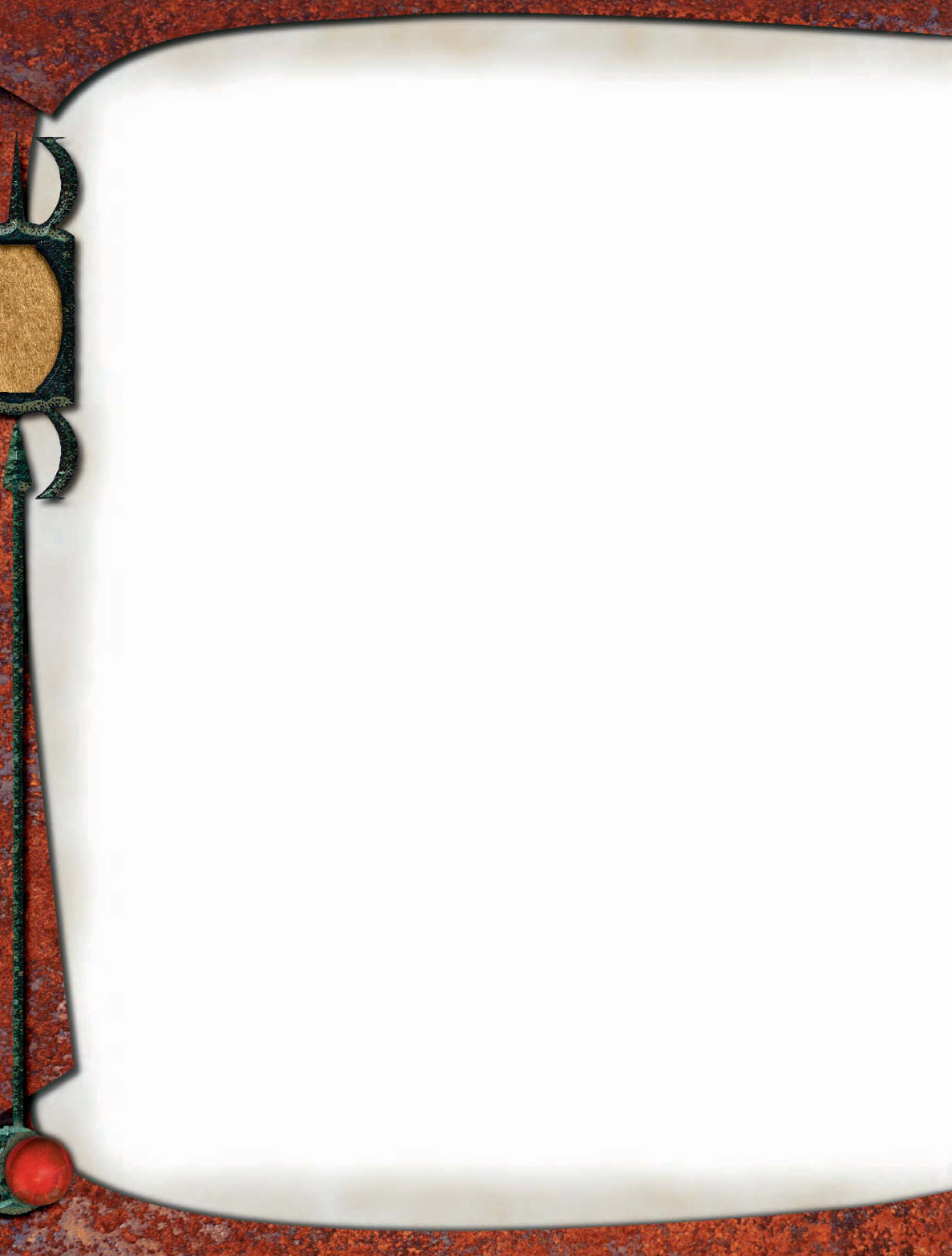
192
Challenge of the Black Duke (EL 19+): Through all
seasons, the Black Duke leads a host of undead through
the forlorn stretches of his demesne. Thundering forward
on his cauchemar nightmare steed (MM 194), he is accom-
panied by at least six elite vampires (MM 251) and up to
double this number of vampire spawn (MM 253). Sweeping
through his lands, he searches for would-be heroes to add
to his court.
The Black Duke and his entourage are an epic encounter
in every sense of the word. On his own, the vampire lord
is still formidable, but PCs have only one chance to engage
the Black Duke alone. When he fi nds a party whose war-
riors have the mettle he seeks, the Black Duke approaches
at nightfall, alone, cloaked, and on foot so as not to give
his identity away. He issues his challenge only once, and
expects an immediate response. For PCs intent on destroy-
ing the Black Duke, the acceptance of this single-combat
challenge (whether as part of a previously prepared trap or
not) might be their only option.
Ecology
More than two hundred years ago, the Black Duke was
famous for his courage and daring on the battlefield.
Beloved by noble and commoner alike, this great knight
was a chivalrous champion, valiant and pure. However,
this bold exterior concealed his fear of death, the seed
of a dark corruption.
As a warrior, the knight had seen countless deaths and
had sent more than his share of foes to the darkness. Even
as each new enemy fell to his swift sword, he knew that he
must one day meet his match. Although he trained cease-
lessly, the knight dreaded his own mortality, fearing the
eventual day when he would be the one breathing his last
on the bloody battlefi eld.
As the Black Duke entered his twilight years, a great and
wild host of orcs poured into the knight’s lands. Bent on
rapine and destruction, these merciless killers butchered
with abandon. No longer the warrior he was, the once-great
knight quailed at the thought of donning his armor and
facing the enemy. And so he waited in his castle while his
subjects died. The exhortations of his fellow knights fell on
deaf ears, for he knew that if he went out against that host,
he would surely fall.
As his lands were conquered around him, the knight
descended into madness and fled to his inner chambers.
He begged the gods to spare him from death, vowing that
he would do whatever was asked of him in exchange for
the gift of immortality. His pleas gained the attention of
Orcus, who longed for mortal souls to feed his insatiable
hunger. The demon prince granted this knight the power
to defeat death by stealing his soul, transforming his
mortal form into the undead monstrosity it remains to
this day.
Environment: Filled with the power of undeath, the
Black Duke now fears no mortal foe. With his host, he often
rides the ruined remnants of his ravaged lands, looking for
intruders and worthy foes. He keeps a macabre court within
the crumbling halls of his stronghold.
Physical Characteristics: The Black Duke is a power-
fully built human male with a shock of white hair. No
compassion shows in his soulless black eyes—only mad-
ness and hatred. His features are smooth, but his skin is pale
and translucent, revealing a tangle of bright red arteries
and black veins beneath. The Black Duke is rarely without
his mithral breastplate, which is engraved with images of
wolves and bats. He wears his howling helm whenever he
leaves his keep.
Alignment: The Black Duke is thoroughly insane and
immoral. Corrupt to the core and a servant of the demon
prince Orcus, he is capricious, prone to violent outbursts
and slaughterous behavior. Though he can also be pleasant,
disarming, and (to some) seductive, the Black Duke typifi es
chaotic evil.
Society
Soon after the Black Duke’s transformation, he slew the few
knights who remained faithful to him, draining them of their
life energy and watching them rise as his eternal servants.
At the same time, the infl uence of Orcus cursed his dying
lands, corrupting its dead and driving the superstitious orcs
away. The Black Duke’s court is now a mockery of its past
glory, fi lled with shuffl ing zombies, ravenous ghouls, and
the ghosts of those he betrayed with his cowardice.
Emboldened by the gift bestowed by Orcus, the Black
Duke rides through the night in the company of his warriors.
He surveys his lands as he did when he was alive. However,
instead of the revels and celebrations of the past, the shat-
tered bones of the dead and the ruins of his fi efs are stark
reminders of his unholy corruption.
Typical Treasure
The Black Duke’s wealth lies in the weapons and armor that
are the tools of his trade. His deep and abiding fear of fi nal
death drives the vampire lord to spend the bulk of his wealth
on protective items. His total wealth is comparable to a player
character of his Challenge Rating.
VAMPIRES

193
THE RED WIDOW
From out of nowhere, a strikingly beautiful female appears.
She wears tight-fitting crimson clothing and a long red cloak,
auburn hair framing her perfect features. One hand grips a
demonic longsword while the other reaches for you, limned with
ghostly light.
The Red Widow CR 17
Female vampire ninja 5*/fighter 2/ghost-faced killer 8*
* Classes described in Complete Adventurer
NE Medium undead (augmented humanoid)
Init +12; Senses darkvision 60 ft., ghost sight; Listen +19,
Spot +27
Languages Common, Elven, Infernal
AC 38, touch 26, flat-footed 30; Dodge, Mobility
(+8 Dex, +5 class, +6 armor, +3 deflection, +6 natural)
hp 97 (15 HD); fast healing 5; DR 10/magic and silver
Immune undead immunities
Resist cold 10, electricity 10, +4 turn resistance
Fort +14, Ref +20, Will +7 (+9 with ki power)
Weakness vampire weaknesses (MM 253)
Speed 30 ft. (6 squares); Spring Attack, great leap, spider
climb
Melee sword of life stealing +20/+15/+10 (1d8+7/17–20 plus
energy drain) or
Melee slam +18 (1d6+7/19–20 plus energy drain)
Ranged +3 composite longbow +24/+19/+14 (1d8+8/×3)
Base Atk +13; Grp +18
Atk Options Cleave, Combat Reflexes, Improved Feint,
Power Attack, blood drain, frightful attack 2/day, magic
strike, sudden strike +6d6
Special Actions alternate form, children of the night, create
spawn, dominating gaze, gaseous form, ghost step
(invisible), ghost step (invisible or ethereal) 3/day, ki
power 5/day
Combat Gear boots of speed, elixir of hiding, 2 potions of inflict
moderate wounds
Abilities Str 20, Dex 26, Con —, Int 14, Wis 16, Cha 15
SA blood drain, children of the night, create spawn,
dominating gaze, energy drain, frightful attack, magic
strike, sudden strike
SQ trapfinding
Feats AlertnessB, Cleave, Combat Expertise, Combat
ReflexesB, DodgeB, Improved Critical (longsword),
Improved Critical (slam), Improved Feint, Improved
InitiativeB, Lightning ReflexesB, Mobility, Power Attack,
Spring Attack, Stealthy
Skills Balance +14, Bluff +22, Climb +15, Concentration +6,
Diplomacy +4, Disguise +2 (+4 acting), Hide +34,
Intimidate +18, Jump +25, Listen +19, Move Silently +35,
Search +10, Sense Motive +11, Spot +27, Tumble +26
Possessions combat gear plus bracers of armor +6, sword of
life stealing, +3 composite longbow (+5 Str bonus) with 20
arrows, cloak of resistance +4, gloves of Dexterity +6, ring of
freedom of movement, ring of protection +3
Ghost Sight (Su) The Red Widow can see ethereal and
invisible creatures and objects within her normal range of
vision.
Great Leap (Su) Makes Jump checks as if running with the
Run feat. Complete Adventurer 8.
Spider Climb (Ex) Climb sheer surfaces as though with a
spider climb spell.
Energy Drain (Su) Living creatures hit by the Red Widow’s
slam attack gain two negative levels. For each negative
level bestowed, the Red Widow gains 5 temporary hit
points that last for up to 1 hour. DC 19 Fortitude save to
remove a negative level. The save DC is Charisma-based.
Blood Drain (Ex) The Red Widow can suck blood from
a living victim with her fangs by making a successful
grapple check. If she pins the foe, she drains blood,
dealing 1d4 points of Constitution drain each round the
pin is maintained. On each successful blood drain, the
Red Widow gains 5 temporary hit points that last for up
to 1 hour
Frightful Attack (Su) The Red Widow can designate a melee
sudden strike attack as a frightful attack. She must
use her Power Attack feat and take a penalty of at least
–1 on the attack roll. If the attack deals damage, the
victim must succeed on a DC 20 Will save or die. On a
successful save, the victim is shaken for 8 rounds.
Those within 30 feet (except the Red Widow, her
victim, and her allies) who see the frightful attack
become panicked (if they have 10 or fewer Hit Dice) or
shaken for 8 rounds. A successful Will save (DC 20 +
the damage bonus from the Red Widow’s Power Attack)
negates this effect.
This is a mind-affecting fear ability that cannot affect
creatures that have 16 or more Hit Dice.
Sudden Strike (Ex) As sneak attack (PH 50), but no extra
damage when flanking. Complete Adventurer 8.
Alternate Form (Su) The Red Widow can assume the form
of a bat, dire bat, wolf, or dire wolf as a standard action.
When in her alternate form, the Red Widow loses her
natural slam attack and dominating gaze ability, but she
gains the natural weapons and extraordinary special
attacks of her new form. The Red Widow can remain in
bat, dire bat, wolf, or dire wolf form until she chooses to
assume a new form or until the next sunrise.
Children of the Night (Su) Once per day, the Red Widow
can call 1d6+1 rat swarms, 1d4+1 bat swarms, or a pack
of 3d6 wolves. These creatures arrive in 2d6 rounds and
serve the Red Widow for 1 hour.
Create Spawn (Su) A humanoid or monstrous humanoid
slain by the Red Widow’s energy drain rises as a vampire
spawn 1d4 days after burial. If the Red Widow instead
drains the victim’s Constitution to 0 or lower, the victim
returns as a spawn if it had 4 or fewer HD and as a
vampire if it had 5 or more HD. In either case, the new
vampire or spawn is under the Red Widow’s command
and remains enslaved until her destruction.
At any given time, the Red Widow can have no more
than 30 enslaved spawn, though vampires she creates
can have enslaved spawn of their own.
Dominating Gaze (Su) As the dominate person spell, range 30
feet, Will DC 19 negates, caster level 12th. The save DC is
Charisma-based.
Gaseous Form (Su) As the gaseous form spell; at will; caster
level 5th. The Red Widow can remain in this form
indefinitely, and she has a fly speed of 20 feet with
perfect maneuverability while in gaseous form.
Ghost Step (invisible) (Su) Swift action; one daily ki power
use; become invisible for 1 round. Complete Adventurer 8.
Ghost Step (invisible or ethereal) (Su) Swift action; become
invisible or ethereal for 1 round. Complete Adventurer 52.
Ki Power (Su) Expend one daily use to activate ki-based
abilities (ghost step); +2 bonus on Will saves as long as at
least one daily use remains. Complete Adventurer 8.
VAMPIRES
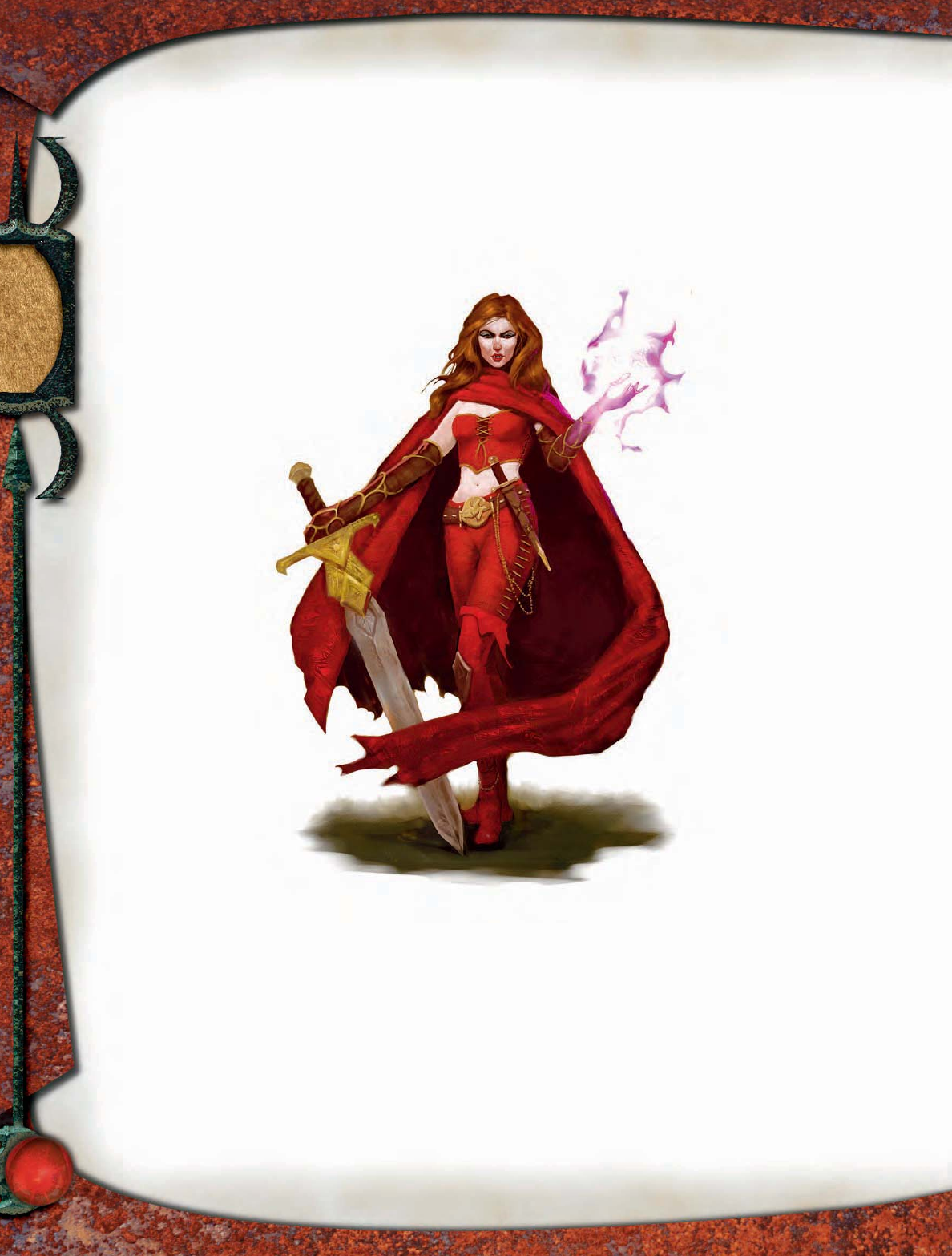
194
The mighty vampire known as the Red Widow controls a
network of undead assassins in the cities of a half-dozen
lands. Known for their consummate professionalism and
effi ciency at killing, the members of the Red Widow’s brigade
are among the most highly sought-after killers in the realm
and beyond.
The vampire presented here was human before gaining the
vampire template, and she had the following ability scores
before Hit Dice and racial ability score adjustments: Str 14,
Dex 15, Con 8, Int 12, Wis 13, Cha 10.
Strategies and Tactics
The Red Widow is a cautious combatant, never
entering into a fi ght she feels she cannot win. With
incredible patience and care, the vampire lady can
watch her prey for days or even weeks. As they go
about their normal business, her targets remain
blissfully unaware of the deadly threat that
lurks just out of sight.
While on the hunt at
night, the Red Widow
prefers to assume gas-
eous form to blend in with
the wisps of fog that
rise from the streets.
On clear nights, she
might transform into a
wolf or a bat, depending
on the appropriateness of
the form. Otherwise, she
simply hides in the shad-
ows, silently following her
prey as she waits for the op-
timal moment to strike.
The Red Widow attacks
with surprise whenever possible.
Against overly cautious oppo-
nents, she uses her ghost
step ability to become in-
visible or ethereal, then
strikes as if from nowhere.
To initiate combat, she makes a
frightful attack, weakening a foe she
fails to kill. On subsequent rounds, she
makes extensive use of ghost step to ensure that she deals
sudden strike damage. Once her victim is unconscious or
dying, she feeds.
If the Red Widow is fought on her own turf, she becomes
even more dangerous. The vampire surrounds herself with
an army of minions—vampires, wights, wraiths, and other
undead. Given time to prepare, she calls forth rats or wolves to
slow intruders, ordering her minions to attack any foes who
break past that fi rst line of defense. Only if confronted with
superior opponents does the Red Widow retreat. Otherwise,
she uses her dominating gaze to control her attackers, then
lays into them with frightful strike to make them rue the
day they set foot in her lair.
Sample Encounter
Unless the fi ght is brought to her, the Red Widow chooses
the time and place of her battles. She is driven to remain
in control of any situation, and if combat turns against her,
she has no qualms about saving herself at the expense of
her followers.
Red Widow Strike Team (EL
19): The Red Widow and two elite
vampires (MM 251) have tak-
en a commission to murder
a highly placed noble in the
city. After infiltrating the
compound and dominating
key members of the noble’s
household, they prepare their
attack. Though the terms of their
mission are simply to eliminate
the target, the Red Widow intends
to alter the bargain—transforming the
noble into a vampire so that she can
expand her infl uence in the city.
Ecology
Before her rebirth as a vam-
pire, the Red Widow was an
infamous killer in the realm’s
largest city, taking her name
from the crimson cloak that was
her trademark. The Red Widow’s
decision to refuse to join the assas-
sins’ guild in favor of operating as
an independent made her numerous
enemies. To protect herself, she gath-
ered intelligence regarding key
personnel in the guild, threat-
ening to reveal their identities
if they made a move against
her. To prove her point, she ex-
posed a member of a leading noble family
as one of the guild’s inner circle. The scandal
that erupted rocked the city.
Enraged by this young upstart’s hubris, the assassins
plotted to have her removed as a means of protecting
themselves and their clients. Because they knew the Red
Widow would be watching for any sign of retaliation, they
enlisted the aid of a small but powerful cult of Pyremius
(Complete Divine 123). In exchange for the living victims
required for their dark rites, the cultists vowed to deal with
this troublesome rogue.
To carry out the job, the priests of the murderous deity
looked to their leader—a mighty vampire who had taken over
the cult years before. After easily tracking the elusive Red
The Red Widow
VAMPIRES
Illus. by R. Spears
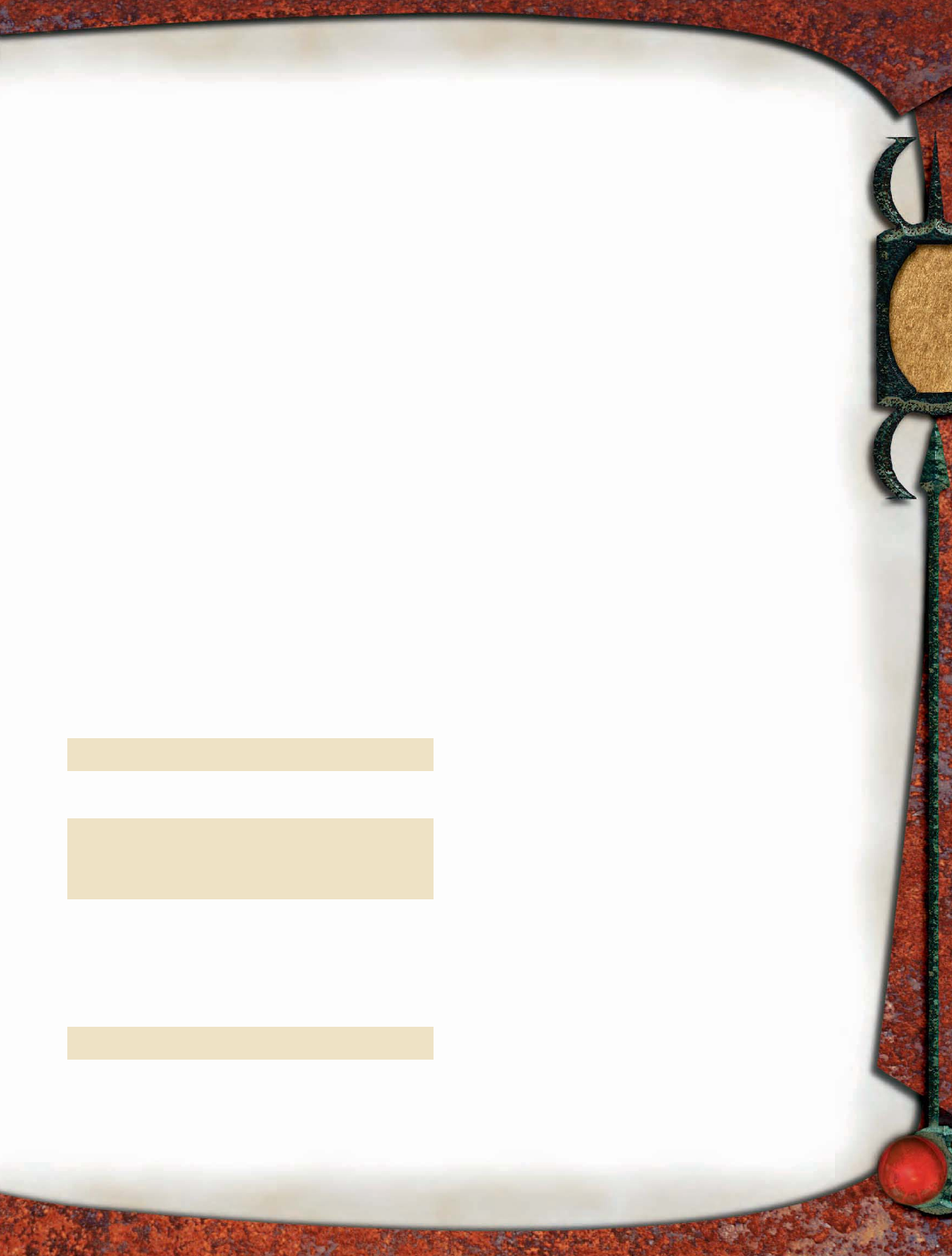
195
Widow, the vampire cornered her in her apartments, bending
her to his will with his dominating gaze ability. Intrigued by
her particular talents and inspired by his wicked faith, the
vampire decided not to slay the Red Widow outright, instead
allowing her to join him in his unhallowed state.
When the Red Widow awoke, her rage was beyond
measure. At the same time, she was fascinated by the dark
gifts the priest had granted her. She learned the ways of her
new form quickly, impressing her new master and earning
his trust and confi dence. When he fi nally confi rmed her
suspicions regarding who was behind the attack on her, the
Red Widow slipped out into the night and drank deeply of
the blood of the assassins who had sought to destroy her. In
the aftermath, she left the city where she had made her name,
never to return. All the long years since, she has sought and
made her fortune far from the conspiracies and treacheries
of that place.
Environment: Since her transformation, the Red Widow
has established a network of hired killers in cities across the
continent. She splits her time between several lairs, traveling
to and from them by means of a sleek ebony carriage drawn
by nine black horses. One of her various coffi ns is contained
within a secret compartment in the cab’s cargo space.
Though she prefers urban environments, the Red Widow
has been known to venture to remote locations to carry out
special assignments.
Physical Characteristics: The Red Widow appears as a
beautiful young female with long auburn hair and pale skin.
Upon closer examination, her striking features reveal a hard-
ened edge and the promise of violence. She wears clothes of
deep red that are tailored for combat, with a billowing cloak
of the same color. Her bestial appearance asserts itself only
when she is angry, her face twisting into a snarling visage as
she reveals her fangs.
Alignment: The Red Widow values self-preservation
above all else. Every action she takes is designed with her
own luxury and safety in mind. Though she was rarely
virtuous to begin with, her transformation drained her of all
compassion and other softer emotions, leaving her staunchly
neutral evil.
Society
Nominally freed from her creator’s influence, the Red
Widow abandoned her past life to begin anew. Faced with
the constant and gnawing need for life energy, she saw a
perfect union between her talents as a killer and the new
abilities gained from her transformation. However, she knew
that the assassins’ guild that had once hunted her might
have a long reach. Though its leaders had died at her hands,
their successors were bound to seek her again. Rather than
leaving her future to chance, the Red Widow infi ltrated a
smaller cell of assassins in her new home city, transforming
the best of them into vampire thralls and consuming those
who failed her.
For the last fi fty years, the Red Widow and her minions
have infi ltrated an increasing number of criminal organiza-
tions, expanding their roles as hired killers to encompass
less romantic but often more profi table enterprises. From
smuggling to extortion, petty theft to protection rackets,
a significant amount of the criminal underworld’s opera-
tions in the major cities of the land is controlled by the Red
Widow’s operatives.
The Red Widow prefers to surround herself with other
undead creatures she can trust, but she realizes that her vam-
piric minions run the risk of exposing themselves through
their need to feed. Accordingly, she conceals her true nature
and uses living minions to manage her interests and see to
the day-to-day operation of her organization.
Typical Treasure
Though the Red Widow appreciates the finer things in
life, she is also practical. Nearly all her wealth is in the
form of personal possessions (chiefly weapons and magic
items) that enhance her other talents. The success of her
organization allows her to ensure that her underlings are
properly equipped for the missions they undertake. Her
total wealth is comparable to a player character of her
Challenge Rating.
pqqqqqqqqqrs
VAMPIRE LORE
Characters who have ranks in Knowledge (religion) or Knowl-
edge (local) can learn more about vampires, the Red Widow,
and the Black Duke. When a character makes a successful skill
check, the following lore is revealed, including the information
from lower DCs.
Knowledge (Religion)
DC Result
15 This creature is a vampire, a foul undead that
drinks the blood of the living.
20 Vampires possess a number of deadly abilities,
including a dominating gaze and a touch that can
drain the life from a creature.
25 Vampires are the masters of the night, and can
summon nocturnal animals that obey their
profane will. By drinking the blood of the living,
vampires rejuvenate themselves and create their
foul spawn.
30 Vampires are particularly resilient, capable of
shrugging off the harshest wounds and healing
rapidly when they are injured. Magic silvered
weapons are the surest way to overcome a
vampire’s unnatural defenses.
Knowledge (Local)
DC Result
27 This is the Red Widow, a ruthless vampire who
commands a large network of vampire assassins.
29 This is the Black Duke, a fallen knight turned
vampire lord. He prowls the ruins of his former
lands in search of new champions to convert to
his unholy cause.
pqqqqqqqqqrs
VAMPIRES

196
VERDANT REAVER
A creature resembling animated driftwood shambles into view, roots
and undergrowth springing up from the ground where it walks.
You hear the creak of twisting wood as it strides forward, thick limbs
thrashing the ground as they reach for you.
Verdant Reaver CR 5
Usually N Large plant
Init +0; Senses low-light vision; Listen +5, Spot +4
Languages Sylvan
AC 16, touch 9, flat-footed 16
(–1 size, +7 natural)
hp 63 (6 HD)
Immune plant immunities
Fort +11, Ref +2, Will +2
Weakness vulnerability to fire
Speed 30 ft. (6 squares); woodland stride
Melee 2 slams +8 each (1d8+5)
Space 10 ft.; Reach 10 ft.
Base Atk +4; Grp +13
Atk Options Cleave, Power Attack, Powerful Charge, verdant
growth, verdant rend 1d8+7
Abilities Str 20, Dex 10, Con 22, Int 6, Wis 10, Cha 6
SA verdant growth, verdant rend
SQ plant traits
Feats Cleave, Power Attack, Powerful Charge
Skills Listen +5, Spot +4
Advancement 7–12 HD (Large); 13–18 HD (Huge)
Woodland Stride (Ex) A verdant reaver can move through
any sort of undergrowth (such as natural thorns, briars,
overgrown areas, and similar terrain) at its normal
speed and without taking damage or suffering any other
impairment. However, thorns, briars, and overgrown
areas that have been magically manipulated to impede
motion still affect it.
Verdant Growth (Su) Squares adjacent to a verdant reaver
spring up with low brush and tangled roots, even if they
are actually bare stone. It costs 2 squares of movement to
enter a square of verdant growth, and the DC of Tumble
checks increases by 2 in such squares. This growth also
imposes a –2 penalty on Move Silently checks. Squares of
verdant growth revert to their normal state as soon as a
verdant reaver is no longer adjacent.
Verdant Rend (Ex) If both of a verdant reaver’s slams hit a
single target that is touching the ground and adjacent to
the reaver, verdant growth tears at that target, dealing an
extra 1d8+7 points of damage.
Those who live their lives in the service of a dryad become
changed over time, becoming one with the natural world
of their mistress. In the end, they are transformed into
verdant reavers, losing all memory of their former lives as
they become thralls of the fey.
STRATEGIES AND TACTICS
A verdant reaver typically begins combat with a Power-
ful Charge to measure a foe’s relative strength. Against
weaker melee threats or creatures that have reach, a
verdant reaver tries to remain adjacent to make use of its
verdant rend ability. Foes that make multiple attacks in
melee are instead kept 5 feet away, forcing them to move
into the area of the reaver’s verdant growth if they wish
to attack. Since this movement cannot be accomplished
with merely a 5-foot step, such foes cannot make a full
attack. Additionally, they might provoke an attack of
opportunity when they move through the verdant reaver’s
threatened area.
SAMPLE ENCOUNTER
Verdant reavers are typically encountered with their
dryad mistresses or some other controller. However, since
they are not bound to a particular tree as dryads are, they
can range a considerable distance as they carry out their
mistress’s commands.
Mistaken Identity (EL 9): A pair of dryads (MM 90)
has mistaken the PCs for the woodcutters who slew their
sister. The dryads’ three verdant reaver servants launch
an attack while the dryads hang back using tree shape.
After 1 round of combat, the dryads take their normal
forms and use tree stride to move behind the PCs. From
that position, they use suggestion against spellcasters and
try to catch other characters with deep slumber or entangle,
taking care to avoid the verdant reavers in the process.
The PCs might be able to talk to the dryads and end the
fight, but the verdant reavers stop attacking only if a dryad
orders them to.
ECOLOGY
When a dryad charms a humanoid creature to her service,
that creature slowly begins to absorb the essence of his fey
mistress and the forest she defends. The life of a dryad’s
thrall is a harsh one. Such creatures experience all the
wildness of the weather and the changing of the seasons,
pqqqqqqqqqrs
VERDANT REAVER LORE
Characters who have ranks in Knowledge (nature) can learn
more about verdant reavers. When a character makes a suc-
cessful skill check, the following lore is revealed, including the
information from lower DCs.
Knowledge (Nature)
DC Result
15 This creature is a verdant reaver, a plant creature
transformed from a subject enthralled to the
service of the fey.
20 Verdant reavers are born of creatures charmed by a
dryad. They defend their dryad mistresses fi ercely,
but they are sometimes found wandering in search
of a new mistress to serve.
25 A verdant reaver causes a riot of plant growth
in the nearby area. This growth impedes the
movement of creatures attacking it and can deal
extra damage to those struck by the verdant reaver.
pqqqqqqqqqrs
VERDANT
REAVER
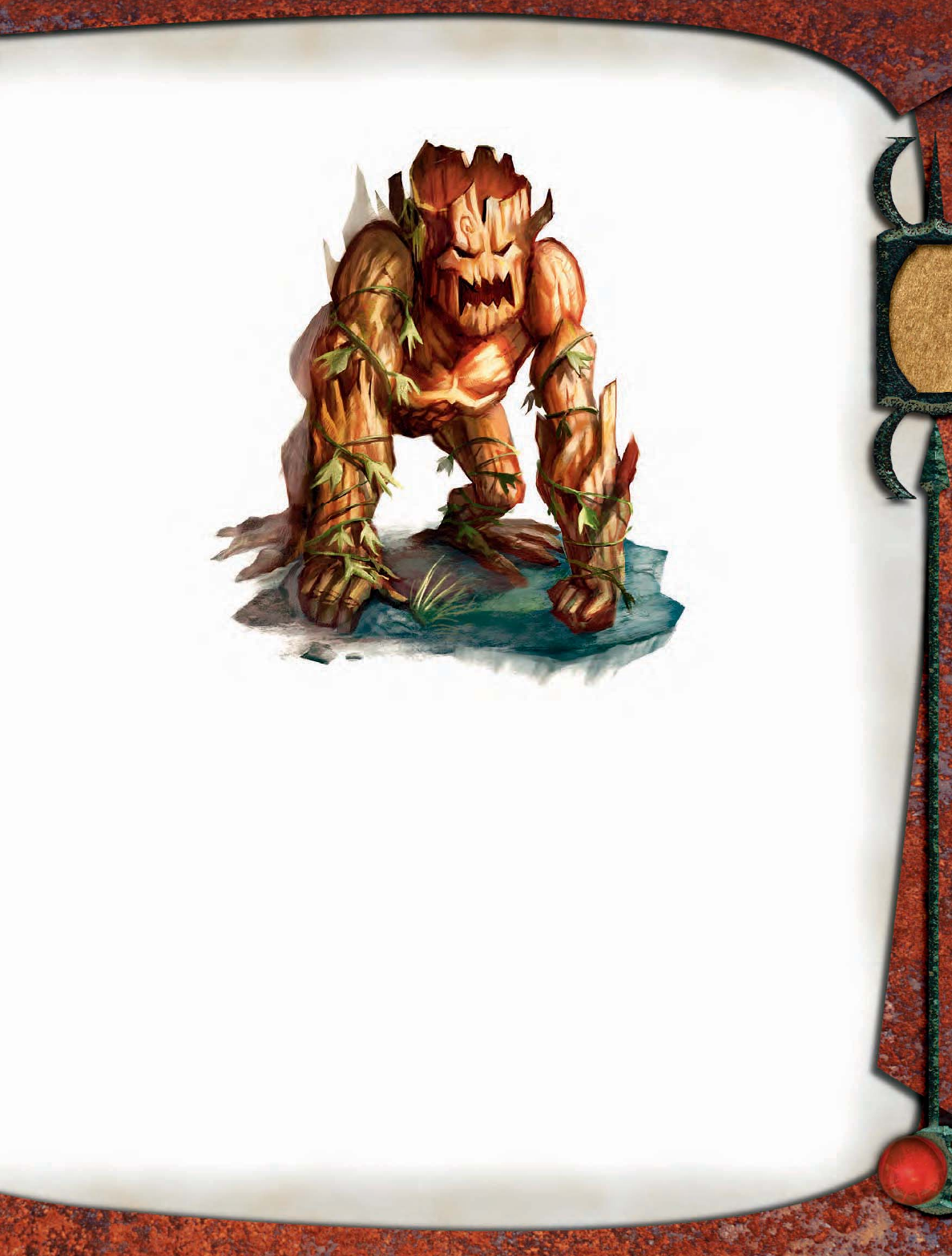
197
and they are forced to scramble for shelter, warmth, and
food. Thralls must also survive the tasks their dryads
set for them, including defending the dryad from
threats, delivering messages to other
dryads in the area, and searching through
the forest for shiny stones, weathered
wood, and other items that strike the
dryad’s fancy.
If a humanoid survives this treat-
ment for a year and a day (and
assuming the dryad does not simply
grow bored and dismiss him), he
awakens to fi nd himself rooted
to the ground. His transfor-
mation into a plant creature
takes place over the course of
that day. The creature’s hair falls
out, and his skin takes on the
texture of bark. The thrall’s
dryad mistress might at-
tempt to comfort him during
this distressing and
painful process. At-
tempting to cut or
tear the creature
from the ground
kills it instantly, but
a remove disease or re-
move curse spell frees
the thrall from the trans-
formation process.
If not freed before sundown,
the thrall becomes a verdant reaver, forget-
ting nearly all its past life and possessing undying loyalty to
the dryad who created it.
Evil and neutral dryads delight in creating verdant reaver
servants, seeking out those hapless souls who pass too
close to their domains. Good dryads rarely make verdant
reavers intentionally, sometimes discovering the process
only after a romantic attraction to a humanoid turns to
dark possessiveness. Thereafter, a good dryad creates a
verdant reaver only if she believes a thrall is worthy of
the punishment.
Freeing a thrall from a dryad can be a simple matter
of dispelling the charm effect that binds it, but such
creatures can also be easily freed while they sleep. A
dryad’s charm person spell-like ability normally lasts 6
hours and can be used three times per day. This leaves a
6-hour period during which the thrall is free of the dryad’s
charm. Dryads typically use suggestion to order the thrall
to sleep and take shelter until morning, whereupon the
dryad can renew her charm. If approached and awakened
during this period, a thrall might be easily convinced to
escape its servitude.
Environment: Verdant reavers live primarily in the
temperate forests where dryads are found. However, those
that have broken with or been dismissed by their
dryad mistresses wander far afi eld in search of
another mistress to obey and protect.
If properly commanded and treated
well, a verdant reaver might follow a new
mistress even out of its normal forest
environment. Rumors sometimes tell
of these creatures living entirely un-
derground as the servants of strange
druid sects.
Typical Physical Charac-
teristics: Weighing 600 to 1,000
pounds, verdant reavers resemble
animated fallen logs or drift-
wood more than living plants.
They stand 12 to 15 feet tall,
but their hunched posture
makes them appear slightly
shorter.
Alignment: Verdant
reavers are creatures of raw
nature, so they have no
moral connection to their
former lives or even the
dryads who created
them. They are almost
always neutral.
SOCIETY
Once its transformation is com-
plete, a verdant reaver loses almost all
connection to the being it once was. As creatures devoted
to the individual dryads who created them, verdant reavers
have no society of their own. However, they all share com-
mon traits. Verdant reavers must serve a mistress—a female
creature (or one that appears to be female) willing to give the
verdant reaver orders. In the absence of its creator dryad, a
verdant reaver seeks out another mistress.
Verdant reavers in search of a new mistress seek out
nymphs, sprites, and forest-dwelling humanoids who com-
monly speak Sylvan, such as druids and elves. If it goes
without a mistress for a year and a day, a verdant reaver dies.
In the service of the fey or other creatures that protect nature,
these creatures can live indefi nitely.
TYPICAL TREASURE
Verdant reavers have little use for treasure, but they are
compelled to collect valuables. They give this wealth to their
mistresses as tribute. A verdant reaver without a mistress car-
ries its treasure in the hollows of its barklike skin. Verdant
reavers have half standard treasure for their Challenge Rating,
mostly in gems and magic items.
Verdant reaver
VERDANT
REAVER
Illus. by M. Coimbra

198
VINESPAWN
As you approach it, the vine-covered tree before you suddenly shud-
ders. A towering mass of tendrils peels away from the trunk to form
a distinct creature, the tight mesh of its vine form thrashing as it
lurches toward you.
Vinespawn CR 7
Usually N Large plant
Init +5; Senses low-light vision; Listen +3, Spot +4
Languages —
AC 18, touch 14, flat-footed 13; Dodge, Mobility
(–1 size, +5 Dex, +4 natural)
hp 102 (12 HD); DR 5/slashing
Immune plant immunities
Weakness vulnerability to fire
Fort +11, Ref +11, Will +4
Speed 30 ft. (6 squares), climb 30 ft.
Melee 2 slams +14 each (1d8+6)
Ranged vine net +13 touch (entangle)
Space 10 ft.; Reach 10 ft.
Base Atk +9; Grp +19
Atk Options Power Attack
Special Actions engulf, spawning
Abilities Str 22, Dex 21, Con 17, Int 5, Wis 10, Cha 12
SA engulf, spawning
SQ plant traits
Feats Dodge, Improved Natural Attack (slam), Lightning
Reflexes, Mobility, Power Attack
Skills Climb +14, Hide +14 (+22 in forest), Listen +3, Move
Silently +8, Spot +4
Advancement 13–24 HD (Large); 25–36 HD (Huge)
Vine Net (Ex) A vinespawn can hurl parts of its body up to 30
feet as a ranged attack. Each of these tightly wound balls
of vine opens in flight to form a net that can entangle
a creature up to one size category larger than the
vinespawn. A vinespawn can create one vine net per day
for every 4 Hit Dice that it has (normally three per day).
Engulf (Ex) As a standard action, a vinespawn can flow
over Medium or smaller creatures, entrapping them
within its form. The vinespawn simply moves into
the opponents’ space; any creature whose space it
completely covers is subject to the engulf attack. A
vinespawn cannot make slam or vine net attacks during
a round in which it engulfs. It can engulf as many
creatures as can fit in its space.
Opponents can make attacks of opportunity against a
vinespawn, but if they do they are not entitled to a saving
throw. Those who do not attempt attacks of opportunity
must succeed on a DC 18 Reflex save or be engulfed; on
a success, a creature moves aside or back (opponent’s
choice) to move out of the vinespawn’s path. The save
DC is Strength-based.
As a swift action, a vinespawn can crush engulfed
creatures, dealing 2d6+12 points of nonlethal damage.
Engulfed creatures are considered grappled and trapped
within the vinespawn’s body, but they can attempt to
damage the vinespawn or escape from it as with a normal
grapple. A vinespawn is not considered to be grappling
when it has engulfed a creature, and it cannot be pinned
by an engulfed creature.
A creature engulfed by a vinespawn is subject to any
area effect to which the vinespawn is subjected. Grappled
and engulfed creatures lose any Dexterity bonus to AC
but gain a +4 bonus on Reflex saves for having cover.
An engulfed creature takes half damage from any attack
that deals piercing damage to the vinespawn. This half
damage is calculated before the vinespawn’s damage
reduction is applied to the attack.
A vinespawn can choose to expel engulfed creatures
as a standard action. If a vinespawn is killed, any engulfed
creatures are freed.
Spawning (Ex) As a standard action, a vinespawn can
attempt to insert its spawning root down the throat of
an engulfed humanoid, monstrous humanoid, or giant.
An unconscious engulfed creature cannot resist the
spawning root. A vinespawn must succeed on a grapple
check to infect any other creature. The engulfed creature
takes 1d6+8 points of damage as the thorny appendage
burrows into its stomach. The presence of a spawning
root prevents talking, the casting of any spells with verbal
components, and other activities requiring speech.
Removing a spawning root requires a successful grapple
check by the creature invaded by the root, but doing so
deals an extra 1d6 points of damage. If the vinespawn
is killed, the spawning root can be removed without
dealing damage.
A spawning root nourishes an unconscious creature,
keeping it breathing while the vinespawn uses periodic
swift actions to deal nonlethal damage and keep the
target unconscious. If the target creature is left in this
state for 1 day, vines grow through its veins. On the
fourth day in this state, the victim dies as an adult
vinespawn exits the body of its parent.
A vinespawn that is attacked during the spawning
process can fight back but cannot move without
disengaging its spawning root. Only if reduced to 20 or
fewer hit points does it break off, disengaging the vine,
dealing damage as above, and fleeing with engulfed
creatures in tow.
If extracted before the fourth day, the victim is
sickened even when returned to consciousness. Such
victims die in 2d4 days unless remove disease is used to
destroy the vines that can be seen growing beneath
their skin.
pqqqqqqqqqrs
VINESPAWN LORE
Characters who have ranks in Knowledge (nature) can learn
more about vinespawns. When a character makes a success-
ful skill check, the following lore is revealed, including the
information from lower DCs.
Knowledge (Nature)
DC Result
17 This mobile mass of vines is a vinespawn, a skilled
and cunning hunter.
22 A vinespawn has a vicious slam attack and can
hurl parts of its own body at opponents as vine
nets. It can engulf opponents by simply rolling
over them, trapping and crushing creatures within
the mesh of its body.
27 Vinespawns do not feed on living creatures,
but those they hunt meet a more grisly fate.
Vinespawns reproduce by spawning within a living
host, which becomes a new vinespawn after four
days.
pqqqqqqqqqrs
VINESPAWN
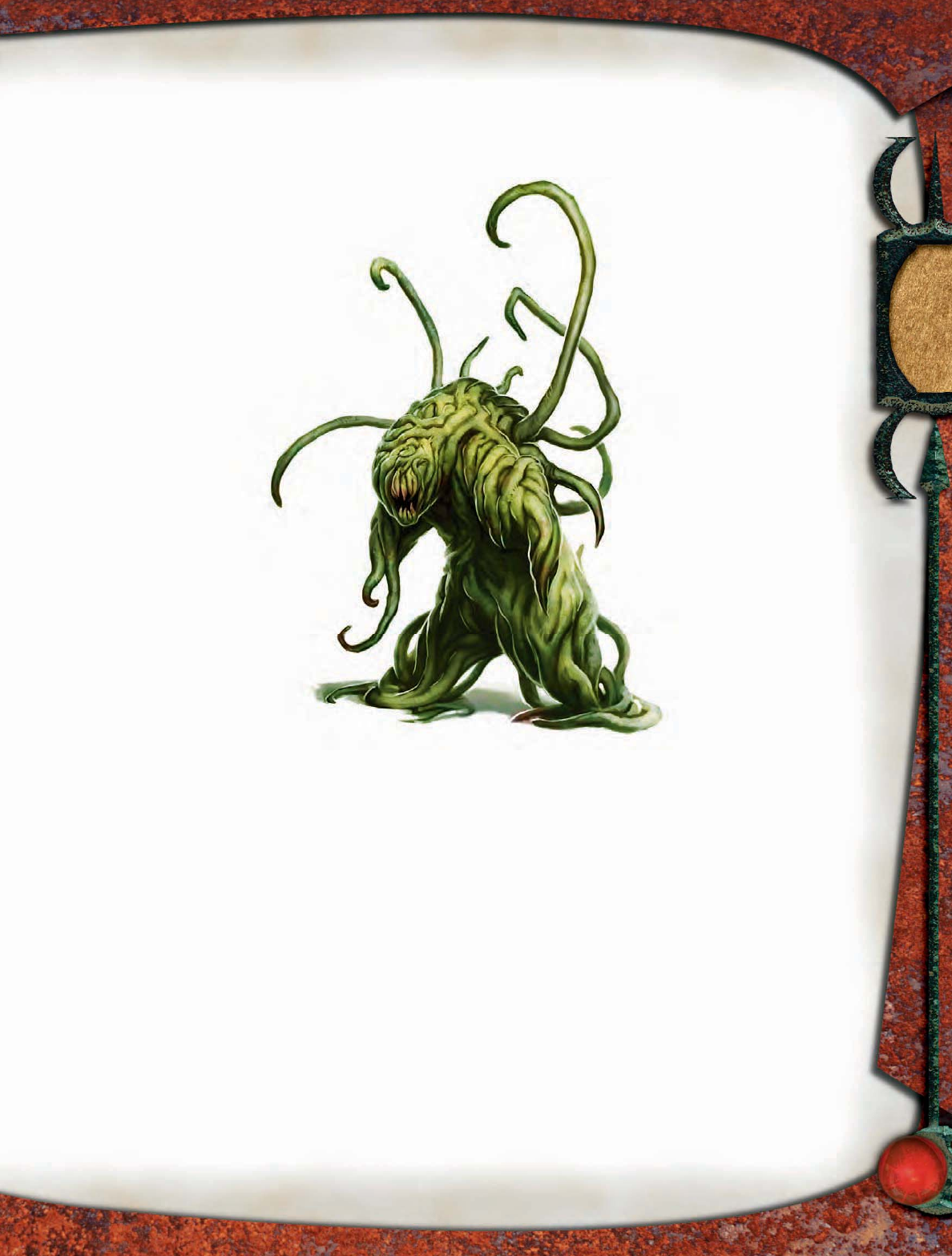
199
Skills Vinespawns have a +8 racial bonus on Climb checks
and Hide checks. They can choose to take 10 on Climb
checks even if rushed or threatened. In forested areas,
a vinespawn’s racial bonus on Hide checks increases
to +16.
Creatures of the deep woodlands, vinespawns are cunning
hunters who strike without warning.
STRATEGIES AND TACTICS
Vinespawns prefer to ambush prey, and
they usually flee from a fight in which
they are at a disadvantage from the start.
Vinespawns initiate combat by hurling vine nets
at those bearing slashing weapons, then charge
into melee.
A vinespawn batters its opponents
with slams, engulfing any crea-
tures it can. It uses further
vine nets to hinder ranged
attackers and fl anking foes.
When it has rendered an en-
gulfed victim unconscious,
a vinespawn retreats into the
surrounding trees.
Once it is in a place of safety, a vinespawn
engages in spawning. Unless attacked, the
vinespawn stays hidden until the pro-
cess is complete.
SAMPLE
ENCOUNTERS
Vinespawns are cunning hunt-
ers driven solely by their need to
spawn. Vinespawns typically dwell alone in
the deep forest, though groups of these creatures
are known to lurk along trade routes. Such groups typically
number six or fewer vinespawns, led by the largest and most
aggressive specimen. The members of larger packs inevitably
turn on each other in their competition for suitable spawn-
ing hosts and space.
Creeping Death (EL 7): A single vinespawn lurks in the
trees near a well-traveled path, waiting for unsuspecting
creatures to pass beneath it. Once it has engulfed its prey, it
returns to its nearby lair.
Bivouac Bushwack (EL 11): Four vinespawns lurk in
the woodlands around an established campsite. Though
merchant caravans and adventurers regularly stop here, no
travelers have been through the area in a number of weeks.
Members of the pack are growing bold.
The vinespawns attack when campers settle in for the
night. When battle begins, three of the creatures hurl vine
nets from different directions before charging. The fourth
hangs back to use its vine nets against those who fl ee or who
deal signifi cant damage with ranged attacks.
ECOLOGY
As plant creatures, vinespawns do not hunt for food. They
are thus indifferent to the birds and animals sharing their
woodlands. Only Small or larger crea-
tures are suitable for spawning, so
vinespawns ignore all others.
During the day, vinespawns sun
themselves on the highest boughs
of the trees they call home, keep-
ing watch for suitable prey. As dusk
falls, they creep forth to seek water
in secluded pools and streams, and
then they begin to hunt.
Environment: Vinespawns
dwell in vine-choked groves of
tall trees in temperate and warm
forests. Within the vines, they
fashion intricate nests that have
several distinct chambers. The
nests of a vinespawn pack are
interconnected. In areas where
vine growth rises well above the
ground, vinespawn nests rise with
it. These creatures sometimes lair
high in the forest canopy, spawning
safely out of reach of any threats.
Typical Physical Char-
acteristics: Vinespawns are
towering creatures composed
of living vines in a tightly wo-
ven mesh. Their bodies
are supple but strong.
A vinespawn stands
12 feet tall and weighs
1,500 pounds.
Alignment: Vinespawns are creatures focused only on
the need to spawn. They are neutral.
SOCIETY
When strong winds batter the forest, vinespawns climb to
the highest branches of their tree sanctuaries. There, they
contort their bodies to catch and funnel the wind, creating
a cacophony of strange wailing sounds that can be heard for
miles. Though the creatures’ reasons for doing so remain a
mystery, they do so in unison. Those who hear these sounds
describe them as the cries of the damned. Numerous stories
of haunted woodlands have no doubt been inspired by the
presence of vinespawns.
TYPICAL TREASURE
Vinespawns have no interest in treasure, but the gear of those
they have engulfed sometimes remains caught up in the tight
vine mesh of their bodies. Such gear might include weapons,
jewelry, and magic items. Vinespawns have standard treasure
for their Challenge Rating.
Vinespawn
VINESPAWN
Illus. by M. Coimbra

200
VIVISECTOR
A gangly biped appears above you, descending on thin crystalline
wings. Its form is composed of dozens of blue chitinous plates, the
cracks between them oozing blood and black ichor. Its head bears
a pair of multifaceted eyes but no mouth or nose, and the arms
reaching for you end in bloodstained claws.
Vivisector CR 4
Always LE Medium aberration
Init +8; Senses darkvision 60 ft., deaf; Spot +10
Languages —
AC 21, touch 15, flat-footed 17
(+4 Dex, +1 deflection, +6 natural)
hp 45 (7 HD)
Immune sonic
Fort +4, Ref +6, Will +5
Speed 30 ft. (6 squares), fly 20 ft. (good)
Melee 2 claws +9 each (1d8+2/19–20/×3) and
sting +4 (1d6+1 plus poison)
Space 5 ft.; Reach 5 ft.
Base Atk +5; Grp +7
Atk Options Combat Reflexes, augmented critical, poison
(DC 15, 1d6 Str/1d6 Str)
Special Actions invisibility, vivisection
Combat Gear potion of resist energy (fire) 10
Abilities Str 15, Dex 18, Con 14, Int 12, Wis 11, Cha 15
SA augmented critical, poison, vivisection
SQ unnatural biology
Feats Combat Reflexes, Improved Initiative, Weapon Finesse
Skills Heal +8, Hide +16, Move Silently +16, Spot +10
Advancement 8–16 HD (Medium); 17–21 HD (Large)
Possessions combat gear plus ring of protection +1
Deaf (Ex) Vivisectors are immune to effects that require
hearing to function, such as language-dependent spells.
They automatically fail Listen checks.
Augmented Critical (Ex) A vivisector’s deadly claws are
incredibly sharp, allowing it to surgically dismantle foes.
It threatens a critical hit on a roll of 19–20, dealing triple
damage on a successful critical hit.
Invisibility (Su) Three times per day, as a swift action, a
vivisector can become invisible for 1 round. A vivisector
remains invisible even when it attacks.
Vivisection (Ex) As a full-round action, rather than
performing a coup de grace, a vivisector can hack into
the chest of a helpless humanoid, attempting to harvest
choice organs for its personal use. Treat this as an
automatic critical hit with a single claw attack that also
heals the vivisector of the same amount of damage. If the
target is killed, its corpse is rendered unsuitable for spells
such as raise dead that require an intact body. If the victim
survives, the vivisector moves on, ignoring it in favor of
other creatures.
Unnatural Biology (Ex) Vivisectors are unnatural creatures
that do not eat, drink, breathe, or heal naturally. Instead,
they draw sustenance from the vital organs of others.
Skills Vivisectors have a +4 racial bonus on Hide, Move
Silently, and Spot checks.
Vivisectors are gruesome creatures that dwell in the darkest
corners of humanoid cities and towns. They prey on the weak
and the helpless, gorging themselves on the living organs
that extend their unnatural lives.
STRATEGIES AND TACTICS
Vivisectors are cowardly foes, preferring to attack from
hiding whenever possible. They rely on their ability to hide
or turn invisible to avoid direct confrontation and escape
from superior forces. Once engaged, however, a vivisector
fi ghts with a single-minded ferocity. It uses its claws to
tear opponents apart as it attempts to cripple them with its
poison sting.
Vivisectors attack and slay any creatures, but they must feed
exclusively on humanoids. Once a vivisector has a humanoid
foe immobilized or unconscious, it cuts into the creature’s
chest to claim vital organs, incorporating such viscera into
its body.
SAMPLE ENCOUNTERS
On the fringes of humanoid settlements, vivisectors are
encountered alone. In larger towns and cities, packs of these
creatures are more common.
Death By Night (EL 4): A farming village lives in fear of
an unseen killer. Over the past two weeks, cattle and local
wildlife have begun to turn up dead and mutilated. Now,
the vivisector responsible has turned its attention to the
townsfolk, and two farmers and a hunter have been slain
so far.
Scourge of the Sewers (EL 8): Residents of a small city
initially blamed a turf war within the thieves’ guild when
a number of low-level bravos and operatives began to dis-
appear. However, a half-dozen merchants and respectable
townsfolk have since vanished, and the guild and the city
lords alike are seeking answers. A network of abandoned
sewers beneath the city has been claimed by a pack of four
vivisectors responsible for the disappearances—a pack whose
hunger is growing.
pqqqqqqqqqrs
VIVISECTOR LORE
Characters who have ranks in Knowledge (dungeoneering)
can learn more about vivisectors. When a character makes a
successful skill check, the following lore is revealed, including
the information from lower DCs.
Knowledge (Dungeoneering)
DC Result
14 This creature is a vivisector, a gruesome hunter
that feasts on its opponents’ remains. This result
reveals all aberration traits.
19 Vivisectors are immune to sonic damage, and
their deafness renders them immune to auditory
effects. They are unnatural creatures, and they
heal themselves by consuming the organs of their
victims.
24 Vivisectors are little more than carapace and
claws. They cut out the vital organs of their victims
and place them inside their own bodies, drawing
sustenance from them in some unearthly way.
pqqqqqqqqqrs
VIVISECTOR
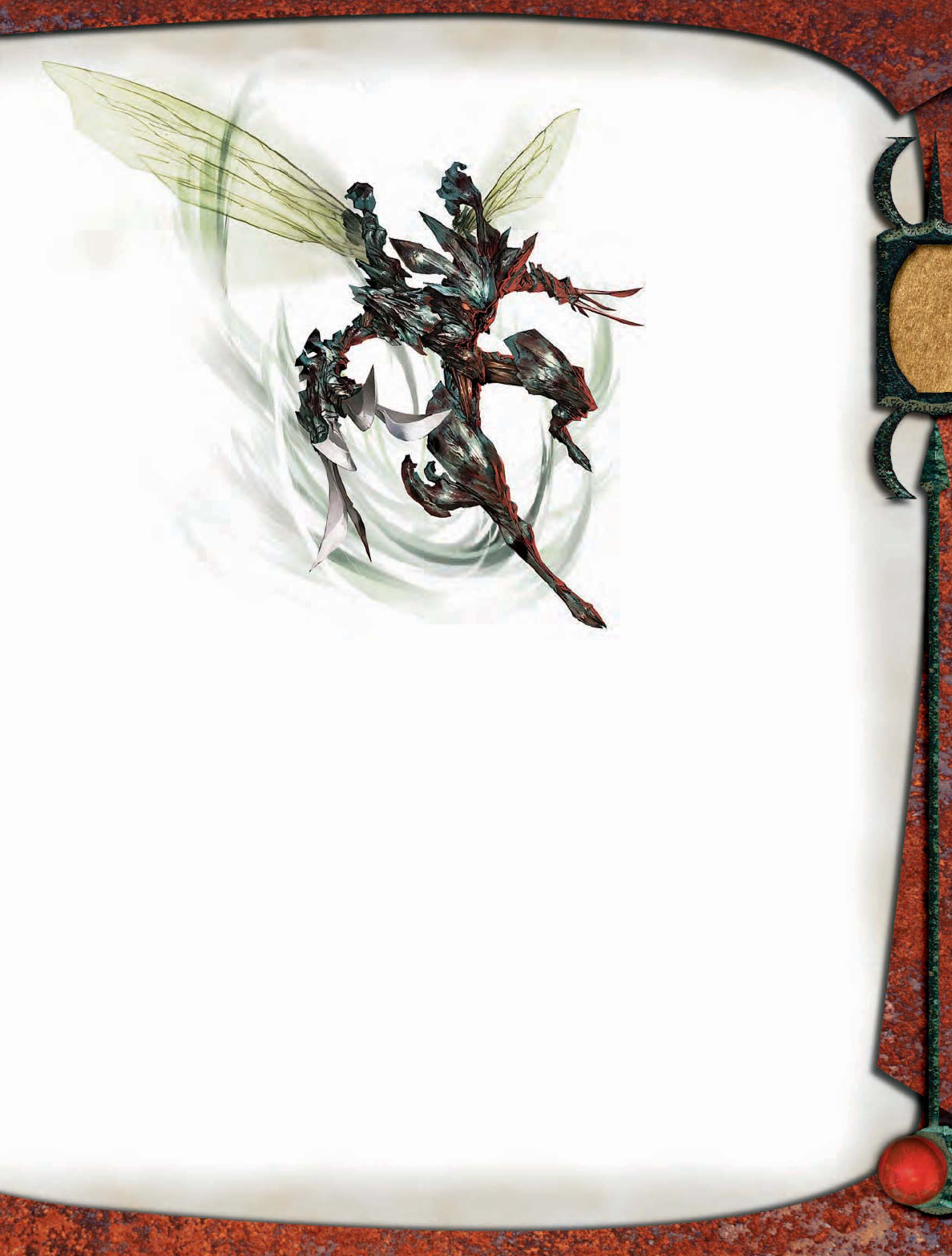
201
ECOLOGY
Vivisectors do not
consume their hu-
manoid victims
in any tradition-
al sense. Rather,
they dissect the fall-
en for vital organs.
Removed innards
are placed inside
the vivisectors’ hol-
low carapace. As the
essence of such entrails
is absorbed, the organs
wither and rot, requiring
the vivisector to constantly
search for fresh supplies.
Vivisectors reproduce through
an asexual process that requires
harvesting the organs of no few-
er than ten Medium humanoid creatures. During this time,
a vivisector becomes more and more bloated as the organs it
claims are slowly processed and transformed inside its body.
After two weeks, the vivisector opens its carapace to release
a smaller version of itself. Within a week, the new creature
has matured to full size, and it leaves its parent to fi nd its own
domain to terrorize.
When slain, a vivisector falls to pieces, spilling its stolen
organs and shattered carapace to the ground in a reeking
heap. Vivisectors are not known to die of old age. As long as
a constant supply of victims can be found, these creatures
might live forever.
Environment: Vivisectors are found in secluded locations
close to potential victims, such as the sewers beneath a city
or a defensible cavern near a small town. Though bright
light causes them no negative effect, they have an aversion
to it, preferring darkness and gloom as a backdrop for their
grisly work.
Typical Physical Characteristics: An average vivisector
stands about 5 feet tall and weighs 100 pounds. Its body
resembles that of a giant praying mantis, with talons at the
end of each arm and a pair of dark but translucent wings.
Alignment: Vivisectors are wholly devoted to their dark
hunger, as methodical as they are sinister. They are always
lawful evil.
SOCIETY
Where victims are scarce, vivisec-
tors do not congregate with others
of their kind. However, groups of
these creatures thrive beneath large
cities, working together for foul com-
mon purpose. Over time, these groups
seek out more powerful victims
from which to harvest body
parts, including high-level
characters and humanoid
creatures that have super-
natural or magical abilities.
It is rumored that some an-
cient and powerful vivisectors
are able to harvest the abili-
ties of their prey, using such
powers as their own for short pe-
riods of time before the organs
rot away.
TYPICAL
TREASURE
Vivisectors have no interest in
wealth or weapons, but they covet
protective magic items of all kinds,
most commonly potions and
rings. Though it has no mouth, a
vivisector can ingest potions by
pouring them into its carapace. Vivisectors have double
standard treasure for their Challenge Rating. The vivi-
sector presented in this entry has protective items worth
2,300 gp, so it might have additional treasure worth up
to 100 gp.
VIVISECTORS IN EBERRON
Vivisectors are frequently found in the depths of Khyber,
preying on explorers, Khyber shard prospectors, and the
surface communities above. These grotesque creatures
have been spotted in the deepest levels of Sharn’s Cogs,
and particularly grisly murders are often written off to
the hunger of a vivisector. The dwarves of the Mror Holds
face regular attacks by vivisectors, and some suspect that
a great conclave of the creatures dwells deep beneath the
Hoar frost Mountains.
VIVISECTORS IN FAERÛN
The Underdark is the traditional home of vivisectors in
Faerûn, and all the races of that subterranean realm fear
these creatures. Rumors tell of a great hive of vivisec-
tors located beneath the Thunder Peaks. There, one of
their number is said to have attained great power, and
is believed to be summoning its foul kin to its side for
some dark purpose.
Vivisector
VIVISECTOR
Illus. by S. Srisuwan

202
WILD HUNT
A giant elfl ike creature in a mithral breastplate, its helm bearing
the proud antlers of a great stag, streaks across the sky on the back
of a phantom stallion. Flames leap up in its wake, and four hounds
the size of bears precede the rider. Silhouetted by the shimmering
moon, the stag-helmed rider draws back a black bow, an arrow
nocked for the kill.
Master of the Hunt CR 22
Usually CN Large fey
Init +15; Senses darkvision 60 ft., low-light vision; Listen +45,
Spot +45
Languages Aquan, Auran, Common, Elven, Ignan, Sylvan,
Terran
AC 42, touch 32, flat-footed 26
(–1 size, +15 Dex, +10 armor, +7 insight)
hp 560 (32 HD); DR 15/cold iron and epic
Immune electricity, exhaustion, fatigue, mind-affecting
spells and abilities
Resist cold 20, fire 20; SR 30
Fort +24, Ref +33, Will +28
Speed 30 ft. (6 squares), fly 60 ft. (perfect); total freedom
Melee +5 flaming burst halberd of speed +33/+33/+28/+23/+18
(2d8+23 plus 1d6 fire/19–20/×3 plus 2d10 fire)
Ranged +5 seeking mighty composite
longbow +36/+31/+26/+21 (2d6+17/×3) or
Ranged +5 seeking mighty composite longbow +28
(8d6+68/×3) with Manyshot or
Ranged +5 seeking mighty composite longbow
+34/+34/+29/+24/+19 (2d6+17/×3) with Rapid Shot
Space 10 ft.; Reach 10 ft.
Base Atk +16; Grp +32
Atk Options Improved Precise Shot, Mounted Archery,
Mounted Combat, Point Blank Shot, Power Attack,
Precise Shot, moonhunter, selected prey
Special Actions moon eye, summon mount
Abilities Str 35, Dex 40, Con 38, Int 20, Wis 30, Cha 35
SA moon eye, moonhunter, selected prey, summon mount
Feats Improved Precise Shot, Manyshot, Mounted Archery,
Mounted Combat, Point Blank Shot, Power Attack,
Precise Shot, Rapid Shot, Track, Weapon Focus (halberd),
Weapon Focus (composite longbow)
Skills Balance +50, Handle Animal +47, Hide +46, Knowledge
(geography) +40, Knowledge (nature) +40, Listen +45,
Move Silently +50, Ride +50, Search +40, Spot +45,
Survival +45 (+47 following tracks, avoiding getting lost,
avoiding hazards, or in aboveground natural environments)
Advancement —
Possessions +5 mithral breastplate, +5 flaming burst halberd
of speed, +5 seeking mighty composite longbow (+12 Str
bonus) with 30 adamantine arrows, 30 silver arrows, and
30 cold iron arrows, quiver of Ehlonna
Total Freedom (Su) A master of the hunt acts as if constantly
under the effect of a freedom of movement spell. He
ignores the maximum Dexterity bonus limitation of any
armor he wears.
Moonhunter (Su) Whenever a master of the hunt shoots an
arrow while outdoors when the moon is in the sky, the
arrow grows to the size of a spear as soon as it is loosed
from the bow. These immense arrows deal an extra
20 points of damage to any creature they strike that is
outdoors while the moon is in the sky.
Moon Eye (Sp) The moon is the mirrored eye of the Wild
Hunt. At will, as a swift action, a master of the hunt can
use discern location, as the spell, against any creature
outdoors while the moon is in the sky. Caster level 20th.
Selected Prey (Su) Three times per day, as a swift action, a
master of the hunt can point to one opponent within 60
feet, marking that foe as selected prey. The selected prey
glows with moonlight as if affected by a faerie fire spell.
Further, the master of the hunt receives a +5 morale bonus
on attack rolls and damage rolls against his selected prey,
and all critical threats the master of the hunt scores against
the selected prey are automatically confirmed. A master of
the hunt can have only one selected prey at a time, and the
effect ends when the moon sets.
Summon Mount (Sp) At will, as a swift action, a master of
the hunt can use phantom steed as the spell, but he can
create a mount only for himself. Caster level 20th.
Hound of the Hunt CR 18
Usually CN Large magical beast
Init +15; Senses darkvision 60 ft., low-light vision, scent;
Listen +19, Spot +19
Languages Sylvan
AC 35, touch 20, flat-footed 24; Dodge, Mobility
(–1 size, +11 Dex, +15 natural)
hp 370 (20 HD); DR 15/cold iron and magic
Immune electricity, exhaustion, fatigue, mind-affecting
spells and abilities
Resist cold 10, fire 10; SR 25
Fort +25, Ref +23, Will +16
Speed 90 ft. (18 squares), fly 90 ft. (perfect); Spring Attack,
total freedom
Melee bite +37 (2d6+25 plus dimensional anchor)
Space 10 ft.; Reach 10 ft.
Base Atk +20; Grp +41
Atk Options Power Attack, moonhunter, skirmish (+10d6)
Special Actions hunter’s howl
Abilities Str 45, Dex 32, Con 36, Int 6, Wis 30, Cha 26
SA dimensional anchor, moonhunter, skirmish, hunter’s howl
SQ freedom of movement
Feats Dodge, Improved Initiative, Mobility, Power Attack,
Spring Attack, Track, Weapon Focus (bite)
Skills Hide +20, Listen +19, Move Silently +20, Spot +19,
Survival +21
Advancement —
Total Freedom (Su) As the master of the hunt.
Dimensional Anchor (Su) Any creature hit by a hound of the
hunt’s bite is affected by dimensional anchor, as the spell,
for 1 round. This effect allows no save or spell resistance.
Moonhunter (Su) Whenever a hound of the hunt bites a foe
while outdoors when the moon is in the sky, the wound
deals an extra 20 points of damage.
Skirmish (Ex) A hound of the hunt deals an extra 10d6 points
of damage on all attacks made during a round in which
it moves at least 10 feet. This extra damage applies only
to attacks made on the hound’s turn. A hound can deal
this extra damage only to living creatures that have a
discernible anatomy.
Hunter’s Howl (Su) As a free action, a hound of the hunt can
release an echoing howl. Those within a 120-foot-radius
spread must succeed on a DC 28 Will save or be shaken
for 1 minute. A creature that saves cannot be affected by
that same hound of the hunt’s howl for 24 hours.
Skills Hounds of the hunt are accomplished hunters that can
stalk their prey as silently as a shadow. They have a +8
racial bonus on Hide and Move Silently checks and a +4
racial bonus on Listen and Spot checks.
WILD HUNT
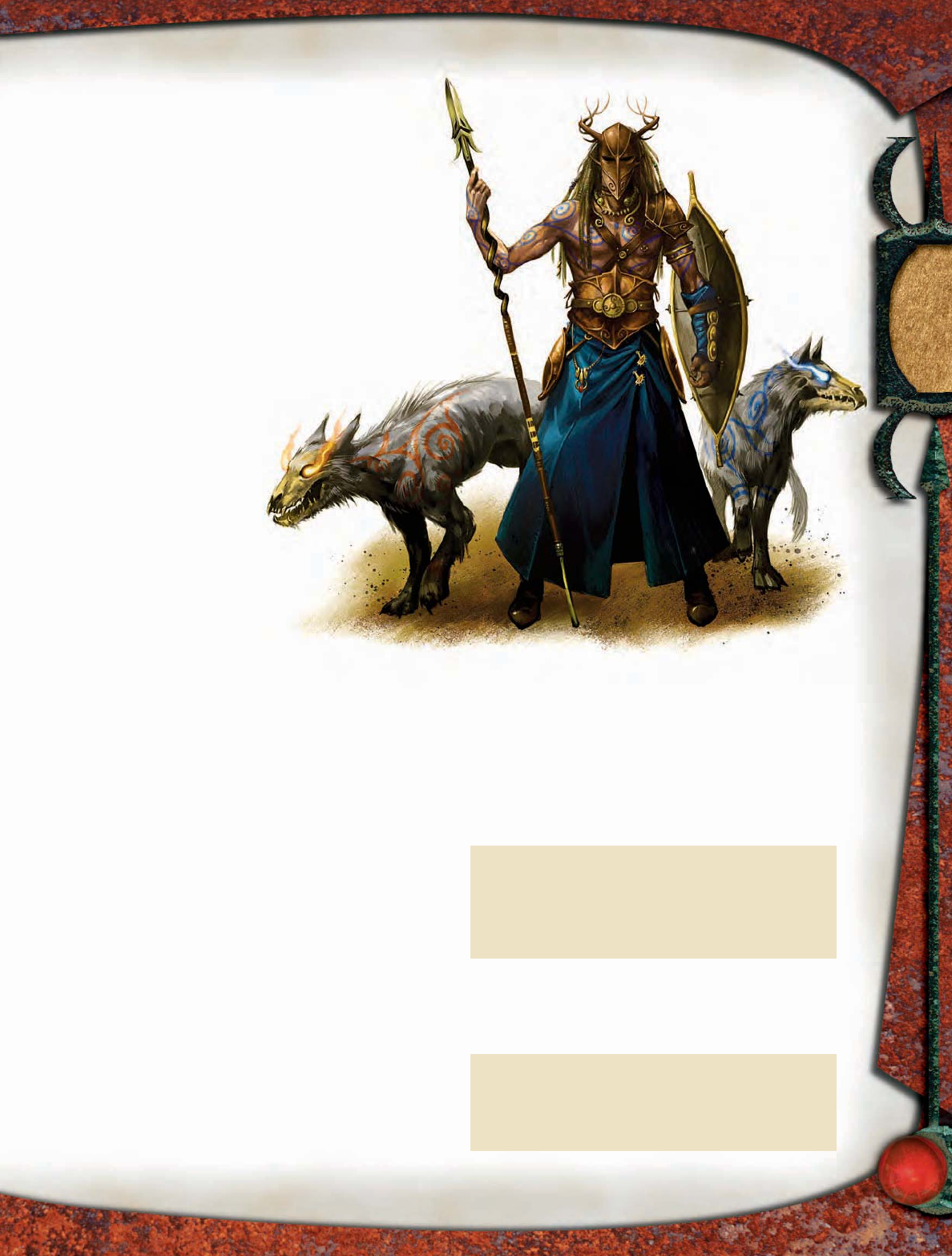
203
The Wild Hunt sends the bravest heroes of the land fl ee-
ing before the master of the hunt and his hounds.
STRATEGIES AND TACTICS
A master of the hunt savors the hunting experience. He
chooses one highly skilled or mighty creature to stalk, then
runs that creature down in an exciting chase.
When his prey stands its ground or a master of the hunt
tires of the chase, he marks his target with the selected
prey ability. His hounds then charge in, tying up the victim
and its allies in melee. The master fi res arrows at his target to
kill it, then disdainfully dispatches others foolish enough
to stand against him.
SAMPLE ENCOUNTER
The Wild Hunt is a rare event that
usually occurs toward the end
of the year.
Night of the Hunt: In late
autumn, a master of the hunt
appears with four hounds,
stalking the land and slay-
ing the mighty. The hunter
eventually chooses a PC who is
particularly skilled at avoiding capture
as prey. That character’s allies oppose
the hunt at their peril.
ECOLOGY
Masters of the hunt were fey monarchs
who ruled their courts for centuries before the tedium of
existence drove them to hunt powerful mortals. Now they
spend their time searching for worthy foes. They are endur-
ing, tireless, and immortal.
The hounds of the hunt are ferocious canines made blood-
thirsty by centuries of training and magical alteration. They
are almost as durable as their masters.
Environment: The Wild Hunt can roam across an entire
world, but a master of the hunt prefers to stalk prey at night
in the wide outdoors.
Typical Physical Characteristics: Masters of the hunt
are lithe and regal elfl ike creatures, standing 8 feet in height
and weighing 300 or more pounds.
Hounds of the hunt are slavering monstrosities the size
of grizzly bears. Their coats glitter slightly as if covered in a
sheen of starlight.
Alignment: A master of the hunt is an amoral creature
that thrills in the pursuit and slaying of mortal foes. He isn’t
cruel, but he is certainly merciless. Those masters of the hunt
that aren’t chaotic neutral are chaotic evil.
TYPICAL TREASURE
Masters of the hunt care nothing for glittering gold or
sparkling jewels. The thrill of the hunt is all they lust after.
Their listed possessions are all they have.
pqqqqqqqqqrs
WILD HUNT LORE
Characters who have ranks in Knowledge (nature) can learn
more about the Wild Hunt. When a character makes a suc-
cessful skill check, the following lore is revealed, including the
information from lower DCs.
Knowledge (Nature)
DC Result
32 This large, elfl ike creature is a master of the hunt,
a cruel fey that seeks to prove his skill against the
mightiest foes. The four hounds that accompany
him are hounds of the hunt, magical beasts totally
loyal to their master. The master is an archer
of incredible skill, and the hounds are frightful
hunters with supernatural howls.
37 The moon is the eye of the Wild Hunt, and anyone
under its light is more susceptible to the attacks of
a master and his hounds. A master of the hunt can
summon a steed instantly, and he can mark a foe
as his quarry, making it easier to fi nd and slay that
creature.
42 A master of the hunt cannot be bargained with.
Only those who elude him for a night or slay him
can expect to survive. He is most vulnerable to
epic weapons crafted from cold iron, while the
hounds are vulnerable to cold iron weapons
imbued with magic.
pqqqqqqqqqrs
The Wild Hunt
WILD HUNT
Illus. by E. Widermann
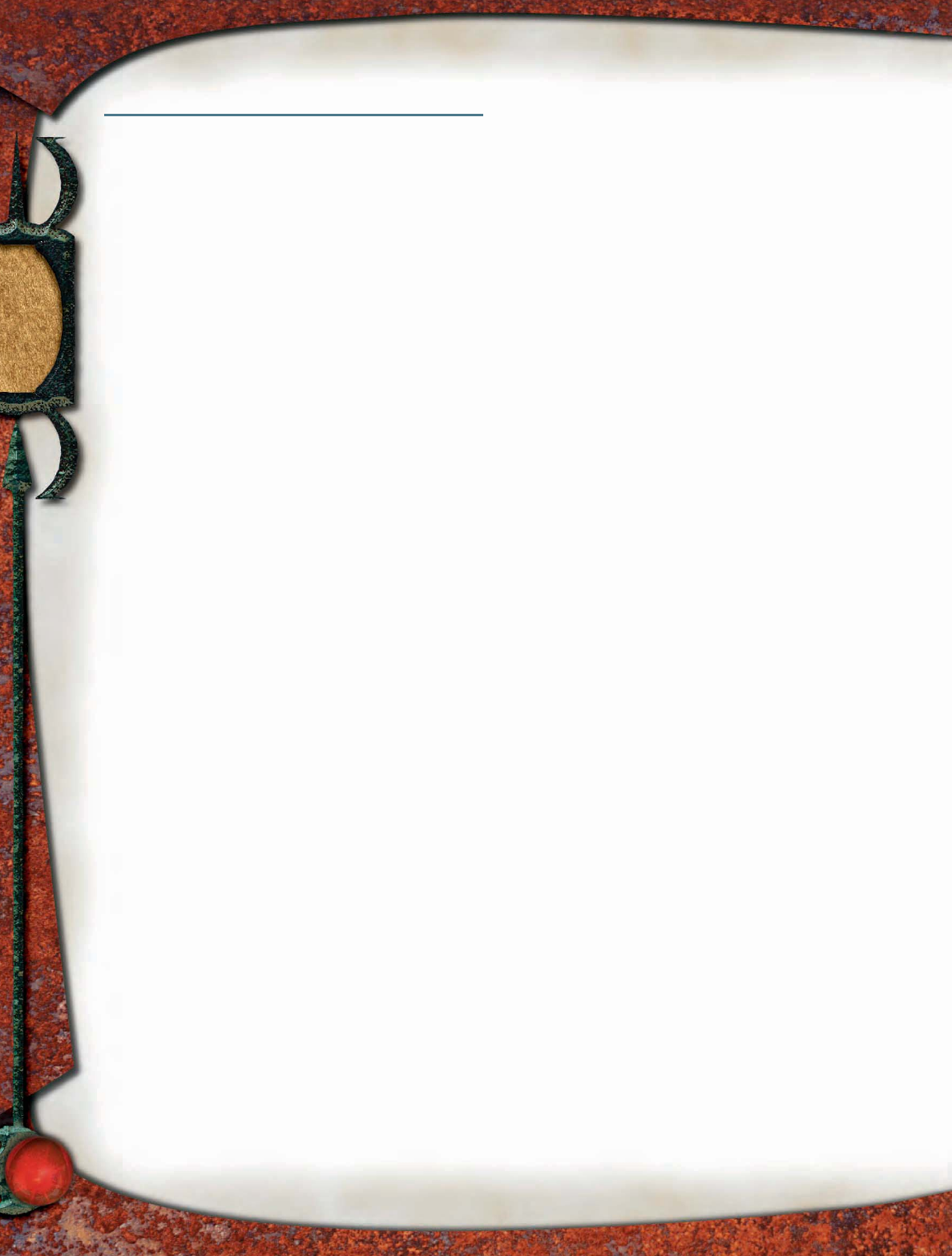
204
MONSTER FEATS
Presented here are feats used by monsters in this book.
ABILITY FOCUS
A particular special ability of a creature that has this feat is
more potent than normal.
Prerequisite: Special ability that allows a saving throw.
Benefi t: Add +2 to the DC for all saving throws against
the special ability on which the creature focuses.
Special: A creature can gain this feat multiple times. Its
effects do not stack. Each time the creature takes the feat, it
applies to a different special ability.
AWESOME BLOW
A creature that has this feat can choose to deliver blows that
send its smaller opponents fl ying like bowling pins.
Prerequisites: Str 25, Power Attack, Improved Bull Rush,
size Large or larger.
Benefi t: As a standard action, the creature can choose
to subtract 4 from its melee attack roll and deliver an
awesome blow. If the creature hits a corporeal opponent
smaller than itself with an awesome blow, its opponent
must succeed on a Refl ex save (DC equal to damage dealt)
or be knocked fl ying 10 feet in a direction of the attacking
creature’s choice and fall prone. The attacking creature can
push the opponent only in a straight line, and the opponent
can’t move closer to the attacking creature than the square
it started in. If an obstacle prevents the completion of the
opponent’s move, the opponent and the obstacle each take
1d6 points of damage, and the opponent stops in the space
adjacent to the obstacle.
Special: A fi ghter can select Awesome Blow as one of his
fi ghter bonus feats.
EMPOWER SPELL-LIKE ABILITY
The creature can use a spell-like ability with greater effect
than normal.
Prerequisite: Spell-like ability at caster level 6th or
higher.
Benefi t: Choose one of the creature’s spell-like abilities,
subject to the restrictions below. The creature can use that
ability as an empowered spell-like ability three times per day
(or less, if the ability is normally usable only once or twice
per day).
When a creature uses an empowered spell-like ability,
all variable, numeric effects of the spell-like ability are
increased by one half. Saving throws and opposed rolls are
not affected. Spell-like abilities without random variables
are not affected.
The creature can select only a spell-like ability duplicating a
spell of a level less than or equal to half its caster level (round
down) –2. For a summary, see the table in the description of
the Quicken Spell-Like Ability feat.
Special: This feat can be taken multiple times. Each time
it is taken, the creature can apply it to a different one of its
spell-like abilities.
FLYBY ATTACK
A creature that has this feat can attack on the wing.
Prerequisite: Fly speed.
Benefi t: When fl ying, the creature can take a move action
(including a dive) and another standard action at any point
during the move. The creature cannot take a second move
action during a round when it makes a fl yby attack.
Normal: Without this feat, the creature takes a standard
action either before or after its move.
HOVER
The creature can come to a halt in midair.
Prerequisite: Fly speed.
Benefi t: When fl ying, the creature can halt its forward
motion and hover in place as a move action. It can then fl y
in any direction, including straight down or straight up, at
half speed, regardless of its maneuverability.
If a creature begins its turn hovering, it can hover in
place for the turn and take a full-round action. A hover-
ing creature cannot make wing attacks, but it can attack
with all other limbs and appendages it could use in a full
attack. The creature can instead use a breath weapon or
cast a spell instead of making physical attacks, if it could
normally do so.
If a creature of Large size or larger hovers within 20 feet
of the ground in an area with lots of loose debris, the draft
from its wings creates a hemispherical cloud with a radius
of 60 feet. The winds so generated can snuff torches, small
campfi res, exposed lanterns, and other small, open fl ames of
non-magical origin. Clear vision within the cloud is limited to
10 feet. Creatures have concealment at 15 to 20 feet (20% miss
chance). At 25 feet or more, creatures have total concealment
(50% miss chance, and opponents cannot use sight to locate
the creature).
Those caught in the cloud must succeed on a Concentration
check (DC 10 + 1/2 creature’s HD) to cast a spell.
Normal: Without this feat, a creature must keep moving
when fl ying unless it has good or better maneuverability.
IMPROVED NATURAL ATTACK
The natural attacks of a creature that has this feat are more
dangerous than its size and type would otherwise dictate.
Prerequisite: Natural weapon, base attack bonus +4.
Benefit: The damage for one of the creature’s natural
attack forms increases by one step, as if the creature’s size
had increased by one category: 1d2, 1d3, 1d4, 1d6, 1d8, 2d6,
3d6, 4d6, 6d6, 8d6, 12d6. A weapon or attack that deals 1d10
points of damage increases as follows: 1d10, 2d8, 3d8, 4d8,
6d8, 8d8, 12d8.
MONSTER
FEATS
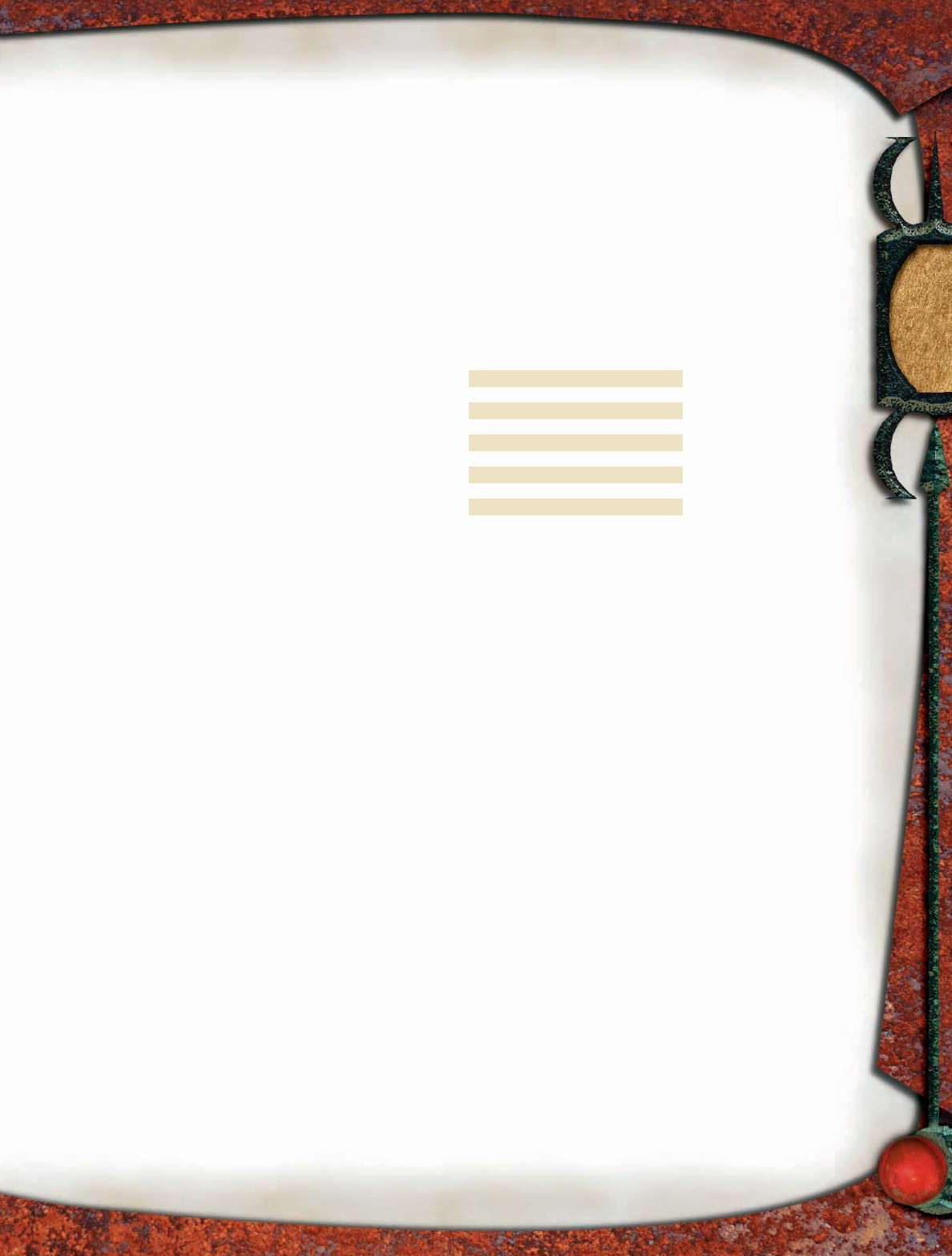
205
IMPROVED TOUGHNESS
A creature that has this feat is significantly tougher than
normal.
Prerequisite: Base Fortitude save bonus +2.
Benefi t: The creature gains a number of hit points equal
to its current Hit Dice. Each time it gains a Hit Die (such
as by gaining a level or advancing), it gains 1 additional hit
point. If it loses a Hit Die (such as by losing a level), it loses
1 hit point permanently.
Special: A fi ghter can select Improved Toughness as one
of his fi ghter bonus feats.
MULTIATTACK
A creature that has this feat is adept at using all its natural
weapons at once.
Prerequisite: Three or more natural attacks.
Benefi t: The creature’s secondary attacks with natural
weapons take only a –2 penalty.
Normal: Without this feat, the creature’s secondary attacks
with natural weapons take a –5 penalty.
POWERFUL CHARGE
A creature that has this feat can charge with extra force.
Prerequisites: Medium or larger, base attack bonus +1.
Benefit: When the creature charges, if its melee attack
hits, it deals an extra 1d8 points of damage (if it is of
Medium size). For Large creatures, the extra damage is
2d6 points; for Huge, 3d6; for Gargantuan, 4d6; and for
Colossal, 6d6.
This feat works only when the creature makes a charge. It
does not work when the creature is mounted. If the creature
has the ability to make multiple attacks after a charge, it can
apply this extra damage to only one of those attacks.
Special: A fi ghter can select Powerful Charge as one of
his fi ghter bonus feats.
QUICKEN SPELL-LIKE ABILITY
A creature that has this feat can employ a spell-like ability
with a moment’s thought.
Prerequisite: Spell-like ability at caster level 10th or
higher.
Benefit: The creature can use one of its spell-like abili-
ties as a quickened spell-like ability three times per day
(or less, if the ability is normally usable only once or twice
per day).
Using a quickened spell-like ability is a swift action
that does not provoke attacks of opportunity. The crea-
ture can perform another action—including the use of
another spell-like ability—in the same round that it uses
a quickened spell-like ability. The creature can use only
one quickened spell-like ability per round.
The creature can select a only spell-like ability duplicat-
ing a spell of a level less than or equal to half its caster level
(round down) minus 4. For a summary, see the table below.
For example, a creature that uses its spell-like abilities as a
15th-level caster can quicken only spell-like abilities that
duplicate spells of 3rd level or lower. In addition, a spell-like
ability that duplicates a spell with a casting time of greater
than 1 full round cannot be quickened.
Normal: Normally the use of a spell-like ability requires a
standard action and provokes attacks of opportunity unless
otherwise noted.
Special: This feat can be taken multiple times. Each time
it is taken, the creature can apply it to a different one of its
spell-like abilities.
Quicken Spell-Like Ability
Spell Caster Level
Level to Quicken
0 8th
1st 10th
2nd 12th
3rd 14th
4th 16th
5th 18th
6th 20th
7th —
8th —
9th —
SNATCH
The creature can grab opponents much smaller than it and
hold them in its mouth or claw.
Prerequisite: Size Huge or larger.
Benefi t: The creature can choose to start a grapple when it
hits with a claw or bite attack, as though it had the improved
grab special attack. If the creature gets a hold on an opponent
three or more sizes smaller, it can squeeze each round for bite
or claw damage. A snatched opponent held in the creature’s
mouth is not allowed a Refl ex save against the creature’s
breath weapon (if any).
The creature can drop an opponent it has snatched as a
free action or use a standard action to fl ing it aside. A fl ung
opponent travels 1d6×10 feet, and takes 1d6 points of damage
per 10 feet traveled. If the creature fl ings a snatched oppo-
nent when fl ying, the opponent takes this amount or falling
damage, whichever is greater.
WINGOVER
The creature can change direction quickly while fl ying.
Prerequisite: Fly speed.
Benefi t: A fl ying creature that has this feat can change
direction quickly once each round as a free action. This feat
allows it to turn up to 180 degrees regardless of its maneuver-
ability, in addition to any other turns it is normally allowed. A
creature cannot gain altitude during a round when it executes
a wingover, but it can dive.
The change of direction consumes 10 feet of flying
movement.
MONSTER
FEATS
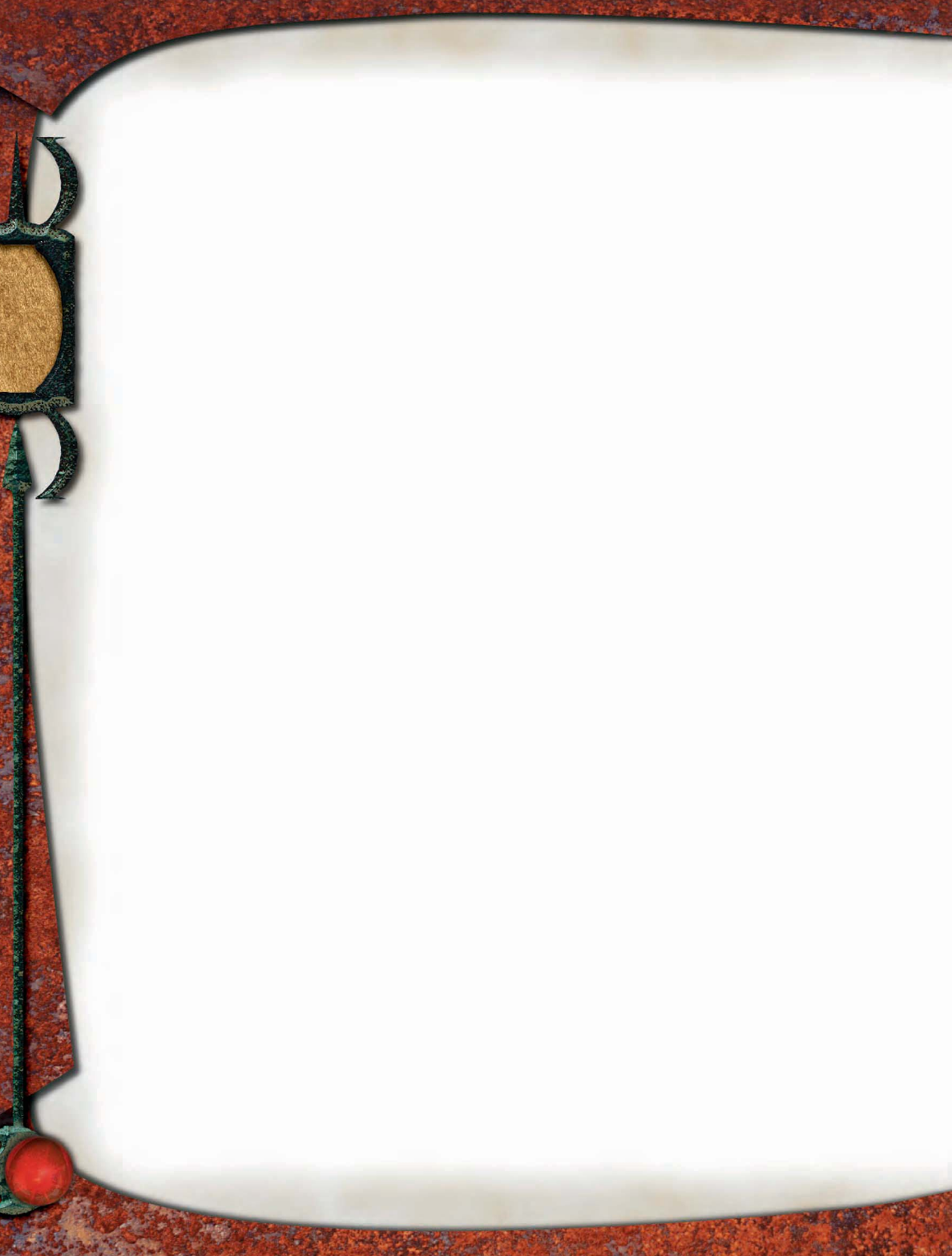
206
GLOSSARY
Glossary
This section provides defi nitions and descriptions of mon-
ster characteristics. If you come across a term earlier in
this book that you’re not familiar with, this is the place
to find out more. These entries are presented as general
rules that might have exceptions when applied to a specific
creature—if a specific creature’s entry differs from the
rules provided in this section, that creature’s ability is as
an exception to the general rule. Statistical specifics of a
particular creature’s abilities, such as save DCs, are defined
in that creature’s entry.
Aberration Type: An aberration has a bizarre anatomy,
strange abilities, an alien mindset, or any combination of
the three.
Features: An aberration has the following features.
—d8 Hit Dice; good Will saves.
—Base attack bonus equal to 3/4 total Hit Dice (as
cleric).
—Skill points equal to (2 + Int modifi er, minimum 1) per
Hit Die, with quadruple skill points for the fi rst Hit Die.
Traits: An aberration possesses the following traits.
—Darkvision out to 60 feet.
—Profi cient with its natural weapons. If humanoid in
form, profi cient with all simple weapons and any weapon it
is described as using.
—Profi cient with whatever type of armor (light, medium,
or heavy) it is described as wearing, as well as all lighter types.
Aberrations not indicated as wearing armor are not profi cient
with armor. Aberrations are profi cient with shields if they
are profi cient with any form of armor.
—Aberrations eat, sleep, and breathe.
Ability Damage (Su): This special attack damages a
specifi c ability score. If an attack that causes ability damage
scores a critical hit, it deals twice the indicated amount of
damage—if the damage is expressed as a die range, roll twice
the normal amount of dice. Ability damage returns at the rate
of 1 point per day per affected ability.
Ability Drain (Su): This special attack permanently
reduces a specifi c ability score. If an attack that causes abil-
ity drain scores a critical hit, it deals twice the indicated
amount of damage—if the damage is expressed as a die
range, roll twice the normal amount of dice. A draining
creature gains 5 temporary hit points (10 on a critical hit)
whenever it drains an ability score, no matter how many
points it drains. Temporary hit points gained in this way
last for up to 1 hour.
Some ability drain attacks allow a Fortitude save (DC 10 +
1/2 draining creature’s racial HD + draining creature’s
Cha modifier). If no saving throw is mentioned, none is
allowed.
Air Subtype: This subtype usually is used for elementals
and outsiders with a connection to the Elemental Plane
Air. Air creatures have fl y speeds and usually have perfect
maneuverability (see Movement Modes, page 215).
Alternate Form (Su): A creature that has this special
quality has the ability to assume one or more specific
alternate forms. A true seeing spell or ability reveals the
creature’s natural form. A creature using alternate form
reverts to its natural form when killed, but separated body
parts retain their shape. A creature cannot use alternate
form to take the form of a creature that has a template.
Assuming an alternate form results in the following changes
to the creature:
—The creature retains the type and subtype of its original
form. It gains the size of its new form.
—The creature loses the natural weapons, natural
armor, and movement modes of its original form, as well
as any extraordinary special attacks of its original form
not derived from class levels (such as the barbarian’s rage
class feature).
—The creature gains the natural weapons, natural armor,
movement modes, and extraordinary special attacks of its
new form.
—The creature retains the special qualities of its original
form. It does not gain any special qualities of its new form.
—The creature retains the spell-like abilities and super-
natural attacks of its old form (except for breath weapons
and gaze attacks). It does not gain the spell-like abilities or
supernatural attacks of its new form.
—The creature gains the physical ability scores (Str, Dex,
Con) of its new form. It retains the mental ability scores (Int,
Wis, Cha) of its original form.
—The creature retains its HD, hit points, base attack bonus,
and base save bonuses, although its total attack and save
modifi ers might change due to a change in ability scores.
—The creature retains any spellcasting ability it had in its
original form, although it must be able to speak intelligibly to
cast spells with verbal components and it must have human-
like hands to cast spells with somatic components.
—The creature is effectively camoufl aged as a creature of
its new form, and it gains a +10 bonus on Disguise checks if
it uses this ability to create a disguise.
—Any gear worn or carried by the creature that can’t be
worn or carried in its new form instead falls to the ground
in its space. If the creature changes size, any gear it wears
or carries that can be worn or carried in its new form
changes size to match the new size. (Nonhumanoid-shaped
creatures can’t wear armor designed for humanoid-shaped
creatures, and vice versa.) Gear returns to normal size
if dropped.
Aligned Strike (Su): Attacks made by a creature that
has this ability are treated as aligned for the purpose of
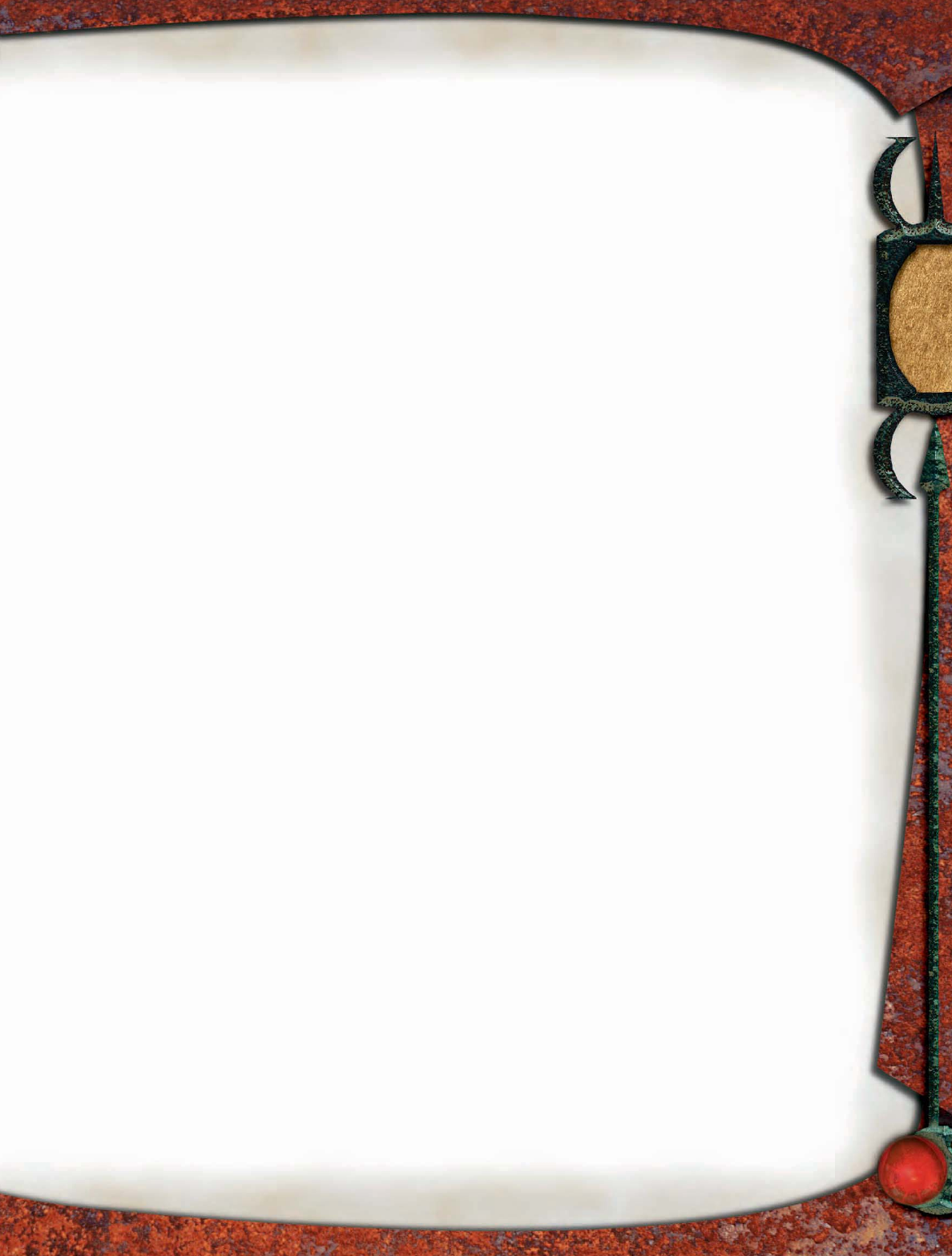
207
GLOSSARY
overcoming damage reduction. When it applies, “aligned
strike” appears in the Atk Options line of a creature’s statistics
block, followed in parentheses by a specifi c alignment or
alignments (chaotic, evil, good, or lawful).
Alignment: This line in a monster entry gives the align-
ment that the creature is most likely to have. Entries that
detail a general creature, rather than a specifi c individual,
include a qualifi er that indicates how broadly that alignment
applies to all monsters of that kind.
Always: The creature is born with the indicated alignment.
The creature might have a hereditary predisposition to the
alignment or come from a plane that predetermines it. It
is possible for individuals to change alignment, but such
individuals are either unique or rare exceptions.
Usually: More than 50% of these creatures have the given
alignment. This could be due to strong cultural infl uences,
or it might be a legacy of the creatures’ origin.
Often: The creature tends toward the given alignment,
either by nature or nurture, but not strongly. A plurality
(40–50%) of individuals has the given alignment, but excep-
tions are common.
Animal Type: An animal is a living, nonhuman creature,
usually a vertebrate with no magical abilities and no innate
capacity for language or culture.
Features: An animal has the following features.
—d8 Hit Dice; good Fortitude and Refl ex saves.
—Base attack bonus equal to 3/4 total Hit Dice (as
cleric).
—Skill points equal to (2 + Int modifi er, minimum 1) per
Hit Die, with quadruple skill points for the fi rst Hit Die.
Traits: An animal possesses the following traits.
—Low-light vision.
—Profi cient with its natural weapons only. A noncomba-
tive herbivore uses its natural weapons as a secondary attack.
Such attacks are made with a –5 penalty on the creature’s
attack rolls, and the animal receives only 1/2 its Strength
modifi er as a damage adjustment.
—Profi cient with no armor unless trained for war.
—Intelligence score of 1 or 2 (no creature that has an
Intelligence score of 3 or higher can be an animal).
—Alignment: Always neutral.
—Treasure: None.
—Animals eat, sleep, and breathe.
Aquatic Subtype: These creatures have swim speeds
and thus can move in water without making Swim checks.
An aquatic creature can breathe underwater. It cannot also
breathe air unless it has the amphibious special quality.
Augmented Subtype: A creature receives this subtype
whenever something happens to change its original type.
Some creatures (those with an inherited template) are born
with this subtype; others acquire it when they take on an
acquired template. The augmented subtype is paired with
the creature’s original type. For example, a wizard’s raven
familiar is a magical beast (augmented animal). A creature
that has the augmented subtype usually has the traits of its
current type, but the features of its original type. For example,
a wizard’s raven familiar has an animal’s features and the traits
of a magical beast.
Baatezu Subtype: Many devils belong to the race of evil
outsiders known as the baatezu.
Traits: A baatezu has the following traits.
—See in Darkness (Su): All baatezu can see perfectly
in darkness of any kind, even that created by a deeper
darkness spell.
—Telepathy.
—Immunity to fi re and poison.
—Resistance to acid 10 and cold 10.
—Summon (Sp): Baatezu share the ability to summon
others of their kind (the success chance and type of baatezu
summoned are noted in each monster description).
Blind: A blind creature has no visual senses and is thusly
immune to gaze attacks, visual effects, illusions, and other
attack forms that rely on sight. Such creatures usually have
blindsense or blindsight.
Blindsense (Ex): Using nonvisual senses, such as acute
smell or hearing, a creature that has blindsense notices
creatures it cannot see. The creature usually does not need
to make Spot or Listen checks to pinpoint the location of a
creature within range of its blindsense ability, provided that it
has line of effect to that creature. Any opponent the creature
cannot see still has total concealment against the creature
that has blindsense, and the creature still has the normal
miss chance when attacking foes that have concealment.
Visibility still affects the movement of a creature that has
blindsense. A creature that has blindsense is still denied
its Dexterity bonus to Armor Class against attacks from
creatures it cannot see.
Blindsight (Ex): This ability is similar to blindsense,
but is far more discerning. Using nonvisual senses, such
as sensitivity to vibrations, keen smell, acute hearing, or
echolocation, a creature that has blindsight maneuvers and
fi ghts as well as a sighted creature. Invisibility, darkness,
and most kinds of concealment are irrelevant, though the
creature must have line of effect to a creature or object to
discern that creature or object. The ability’s range is speci-
fi ed in the creature’s descriptive text. The creature usually
does not need to make Spot or Listen checks to notice
creatures within range of its blindsight ability. Unless noted
otherwise, blindsight is continuous, and the creature need
do nothing to use it. Some forms of blindsight, however,
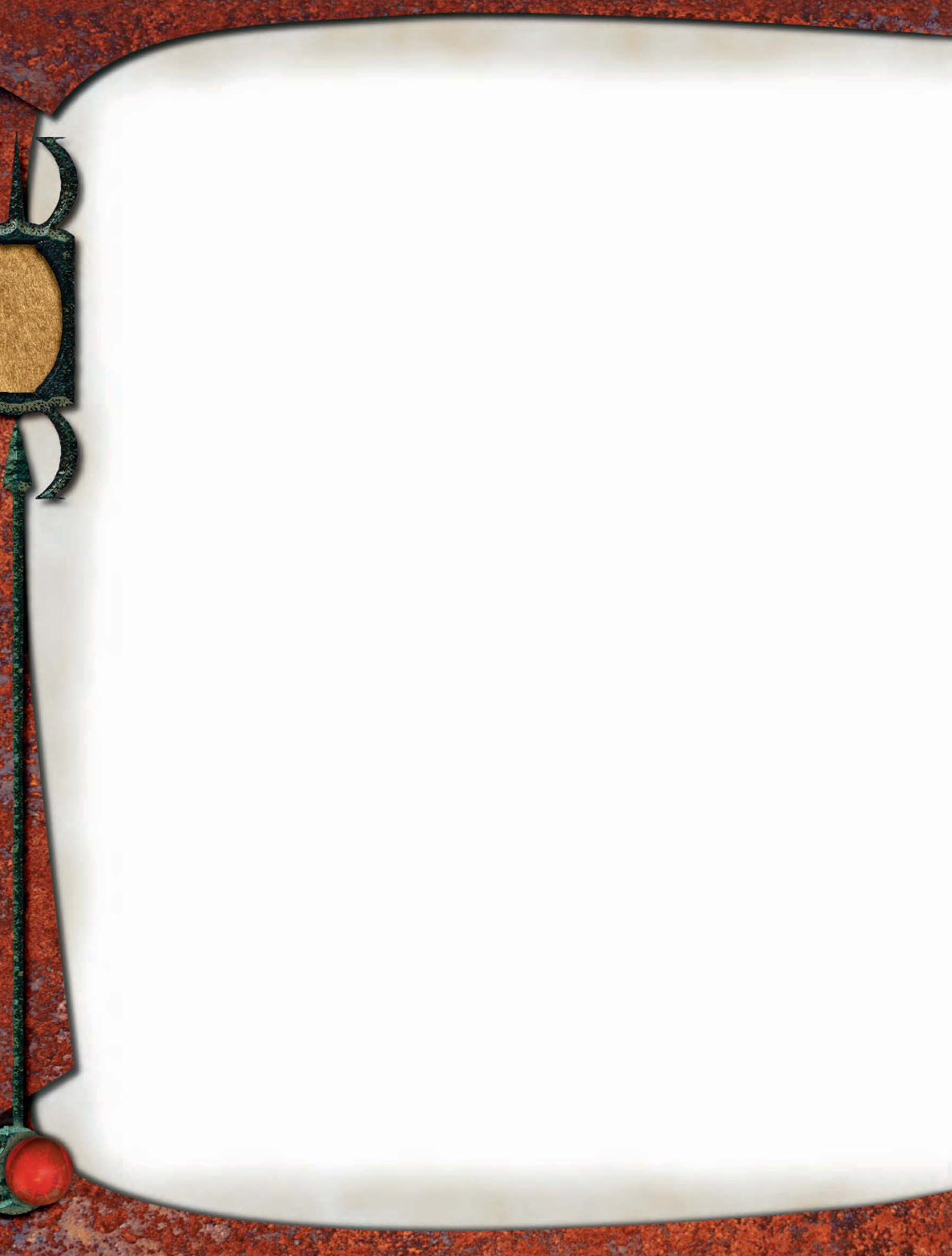
208
GLOSSARY
must be triggered as a free action. If a creature must trig-
ger its blindsight ability, the creature gains the benefi ts of
blindsight only during its turn.
Breath Weapon (Su): A breath weapon attack usually
deals damage and is often based on some type of energy
(such as fi re). Such breath weapons allow a Refl ex save for
half damage (DC 10 + 1/2 breathing creature’s racial HD +
breathing creature’s Con modifi er; the exact DC is given in
the creature’s descriptive text). A creature is immune to its
own breath weapon unless otherwise noted. Some breath
weapons allow a Fortitude save or a Will save instead of a
Refl ex save.
Chaotic Subtype: A subtype usually applied only to
outsiders native to the chaotic-aligned Outer Planes. Most
creatures that have this subtype also have chaotic align-
ments; however, if their alignments change they still retain
the subtype. Any effect that depends on alignment affects a
creature that has this subtype as if the creature has a chaotic
alignment, no matter what its alignment actually is. The
creature also suffers effects according to its actual alignment.
A creature that has the chaotic subtype has the aligned strike
(chaotic) ability. It overcomes damage reduction as if its natu-
ral weapons and any weapons it wields were chaotic-aligned
(see Damage Reduction).
Class Skills: Any skill in which a monster has acquired
at least one rank or in which the creature has a racial bonus
is considered a class skill for that kind of creature. Some
monsters, such as the true dragons, have their class skills
explicitly defi ned. Other monsters’ class skills can be deter-
mined from their statistics blocks.
Skills shown in an entry merely because of synergy with
another skill are not class skills. For example, a banshrae’s
class skills are Balance, Bluff, Climb, Disguise, Escape
Artist, Hide, Jump, Knowledge (nature), Listen, Move
Silently, Perform, Spot, and Tumble. Diplomacy, Intimidate,
Survival, and Use Rope are mentioned in the creature’s
statistics block because of the synergy benefi t granted by
other skills. The only exceptions to this rule are creatures
that have a climb speed, which have Climb as a class skill,
and creatures that have a swim speed, which have Swim as
a class skill.
Cold Subtype: A creature that has the cold subtype has
immunity to cold. It has vulnerability to fi re, which means
it takes half again as much (+50%) damage as normal from
fi re, regardless of whether a saving throw is allowed, or if the
save is a success or failure.
Constrict (Ex): A creature that has this special attack
can crush an opponent, dealing bludgeoning damage, after
making a successful grapple check. The amount of damage
is given in the creature’s entry. If the creature also has the
improved grab ability (see page 212), it deals constriction
damage in addition to damage dealt by the weapon used
to grab.
Construct Type: A construct is an animated object or
artifi cially constructed creature.
Features: A construct has the following features.
—10-sided Hit Dice; no good saving throws.
—Base attack bonus equal to 3/4 total Hit Dice (as
cleric).
—Skill points equal to (2 + Int modifi er, minimum 1) per
Hit Die, with quadruple skill points for the fi rst Hit Die,
if the construct has an Intelligence score. However, most
constructs are mindless and gain no skill points or feats.
Traits: A construct possesses the following traits.
—Darkvision out to 60 feet.
—Low-light vision.
—Because its body is a mass of unliving matter, a con-
struct is hard to destroy. It gains bonus hit points based
on size: 10 for a Small construct, 20 for a Medium, 30 for
a Large, 40 for a Huge, 60 for a Gargantuan, and 80 for a
Colossal construct.
—Cannot heal damage on its own, but it can often be
repaired by exposure to a certain kind of effect or through
the use of the Craft Construct feat (MM 303). A construct
with the fast healing special quality still benefits from
that quality.
—Immunity to ability damage, ability drain, critical hits,
death effects, disease, energy drain, exhaustion, fatigue, mind-
affecting spells and abilities, necromancy effects, nonlethal
damage, paralysis, poison, sleep effects, and stunning.
—Immunity to any effect that requires a Fortitude save,
unless the effect also works on objects or is harmless.
—Not at risk of death from massive damage (PH 145).
Immediately destroyed when reduced to 0 hit points or
fewer.
—Since it was never alive, a construct cannot be raised
or resurrected.
—No Constitution score.
—Proficient with its natural weapons only, unless
humanoid in form, in which case profi cient with any weapon
mentioned in its entry.
—Profi cient with no armor.
—Constructs do not eat, sleep, or breathe.
Damage Reduction (Ex or Su): A creature that has
damage reduction (DR) ignores some of the damage from
weapons and natural attacks that don’t meet certain cri-
teria. Wounds heal immediately, or the weapon bounces
off harmlessly, and the attacker knows the attack was
ineffective. Damage reduction doesn’t reduce the damage
from energy attacks, spells, spell-like abilities, and super-
natural abilities.
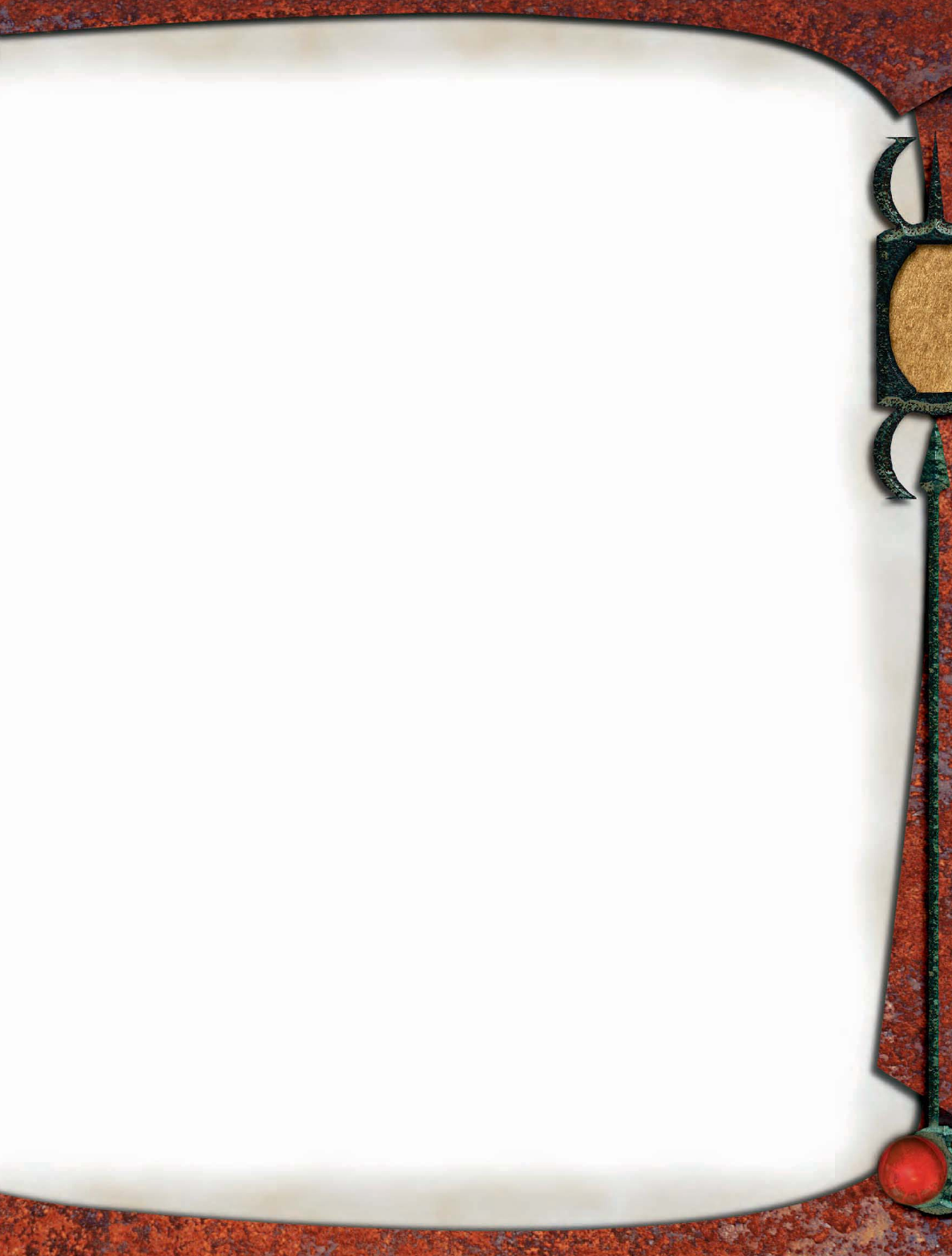
209
GLOSSARY
The DR entry starts by denoting amount of damage
ignored (“X” in the following examples, but usually 5 to
15 points) followed by a slash and the type of damage,
material, or magic that overcomes the ability. If a weapon
or attack doesn’t have the indicated quality or qualities,
that attack has its damage reduced by the number before
the slash to a minimum of 0 points of damage. Possible
ways to overcome DR include:
Aligned: Some damage reduction can be overcome by
chaotic-, evil-, good-, or lawful-aligned weapons, such as
with the entry DR X/lawful. Other than the inherent
abilities of some magic weapons, an aligned weapon can
be acquired through an align weapon spell or from an
alignment subtype (see Aligned Strike). Damage reduc-
tion that can be overcome only by aligned weapons is
supernatural (Su).
Damage Type: Bludgeoning, piercing, or slashing damage
can overcome some damage reduction. A humble club, which
deals bludgeoning damage, overcomes DR X/bludgeoning.
This type of DR is extraordinary (Ex).
Epic: Epic weapons are arms that have a magical enhance-
ment bonus of +6 or higher, and such weapons are required
to harm the mightiest monsters. If a creature has DR X/
epic, it also has the epic strike ability (see page 210). Damage
reduction that can be overcome only by epic weapons is
supernatural.
Magic: When magic can overcome a creature’s damage
reduction, a weapon with a +1 or higher magical enhance-
ment bonus is required. If a creature has DR X/magic, it
also has the magic strike ability (see page 214). This type
of DR is supernatural.
Nothing: When a DR entry has a dash after the slash (DR
X/—), no weapon can overcome it. Insurmountable damage
reduction is extraordinary.
Special Material: A special material, such as adamantine,
alchemical silver, or cold iron, is required to overcome other
forms of damage reduction. For example, potent fey have DR
that can be overcome by cold iron (DR X/cold iron). Damage
reduction that is overcome only by adamantine is extraordi-
nary, but DR that can be overcome only by cold iron or silver
is supernatural.
Special Situations: A few forms of damage reduction can be
overcome by more than one factor. Such DR appears with the
word “or” between qualities, as in DR X/cold iron or good. A
cold iron weapon or a good-aligned weapon can overcome
such DR.
Other forms of damage reduction can be overcome only
by attacks that combine qualities. Such DR appears with the
word “and” between qualities, as in DR X/silver and good.
A weapon that falls into one category but not the other is
of no help in overcoming such damage reduction—it must
have all the indicated qualities to be effective.
In these cases, the damage reduction is supernatural if
any quality required to overcome it is considered part of a
supernatural form of DR. Otherwise, the damage reduction
is extraordinary.
Darkvision (Ex): A creature that has this special quality
can see in the dark, out to a distance given in the creature’s
entry. Darkvision is black and white only, but it is otherwise
like normal sight, and a creature that has darkvision can
function just fi ne with no light at all.
Dragon Type: A dragon is a reptilelike creature, usually
winged, with magical or unusual abilities.
Features: A dragon has the following features.
—12-sided Hit Dice; good Fortitude, Refl ex, and Will
saves.
—Base attack bonus equal to total Hit Dice (as fi ghter).
—Skill points equal to (6 + Int modifi er, minimum 1) per
Hit Die, with quadruple skill points for the fi rst Hit Die.
Traits: A dragon possesses the following traits.
—Darkvision out to 60 feet.
—Low-light vision.
—Immunity to sleep effects and paralysis effects.
—Profi cient with its natural weapons only unless human-
oid in form, in which case profi cient with all simple weapons
and any weapons mentioned in its entry.
—Profi cient with no armor.
—Dragons eat, sleep, and breathe.
—Dragons qualify for classes, prestige classes, racial
substitution levels, feats, powers, and spells that require the
dragonblood subtype.
Dragonblood Subtype: A creature that has the dragon-
blood subtype has a strong affinity to dragons—which
means that spells, effects, powers, and abilities that affect
or target dragons also affect it. The subtype qualifies
a creature to use magic items normally usable only by
dragons, and it qualifies the creature to take feats that have
the subtype as a prerequisite. The dragonblood subtype
also makes creatures subject to harmful effects that
affect dragons.
The dragonblood subtype does not confer the dragon type
or any traits associated with that type. For instance, it does
not give a creature frightful presence.
If a creature that has the dragonblood subtype somehow
acquires the dragon type, it loses this subtype.
Earth Subtype: This subtype usually is used for elementals
and outsiders with a connection to the Elemental Plane of
Earth. Earth creatures usually have burrow speeds, and most
earth creatures can burrow through solid rock.
Effective Character Level (ECL): This number repre-
sents a creature’s overall power relative to that of a character
from the Player’s Handbook. A creature that has an ECL of
10 is roughly equivalent to a 10th-level character. A creature’s
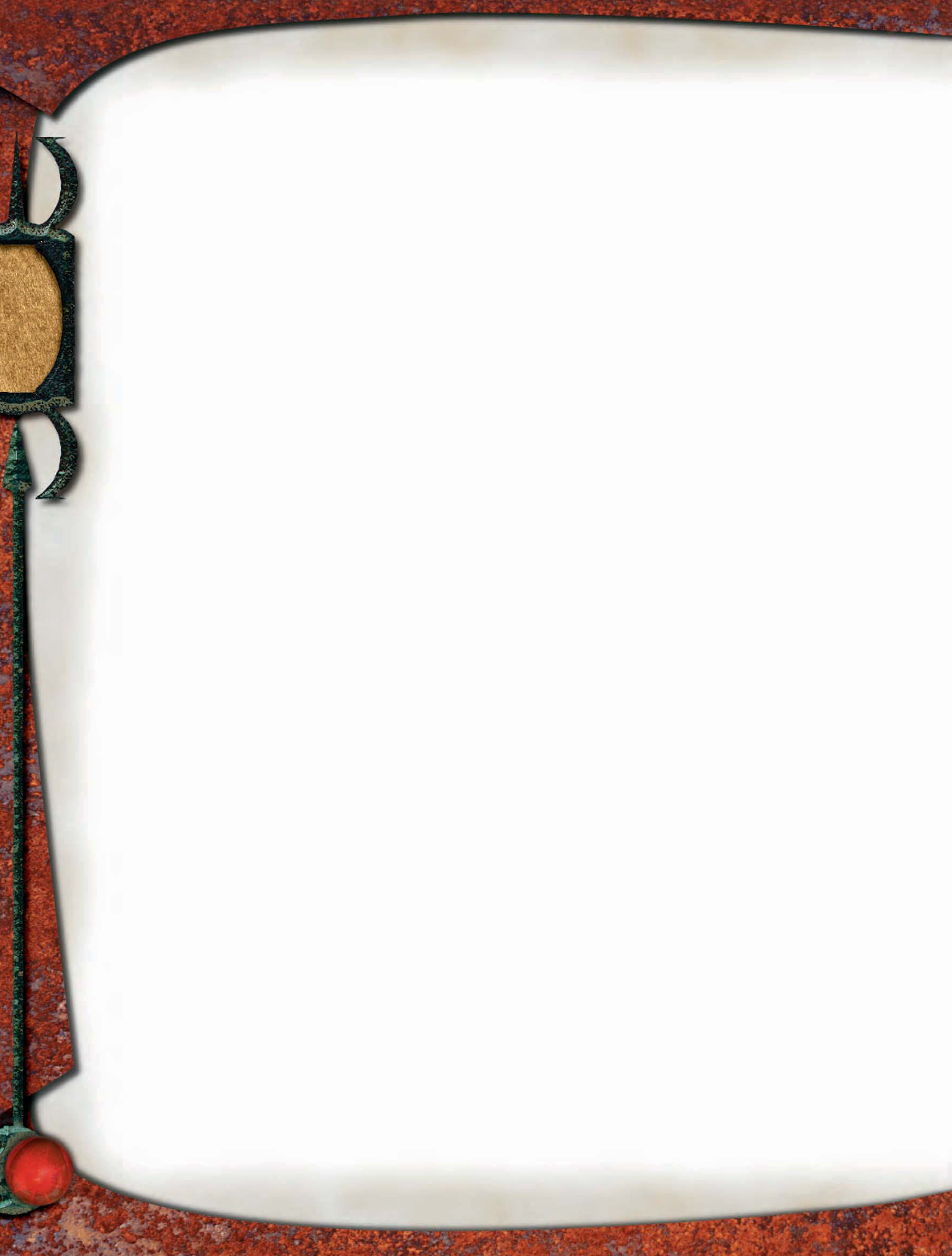
210
GLOSSARY
ECL is the sum of its Hit Dice (including class levels) and
level adjustment. For instance, a kuo-toa exalted whip has
10 HD and a +4 level adjustment. It is the equivalent of a
14th-level character.
Elemental Type: An elemental is a being composed
of one of the four classical elements: air, earth, fire, or
water.
Features: An elemental has the following features.
—8-sided Hit Dice; good saves depend on the element:
Fortitude (earth, water) or Refl ex (air, fi re).
—Base attack bonus equal to 3/4 total Hit Dice (as
cleric).
—Skill points equal to (2 + Int modifier, minimum
1) per Hit Die, with quadruple skill points for the first
Hit Die.
Traits: An elemental possesses the following traits.
—Darkvision out to 60 feet.
—Immunity to critical hits, paralysis, poison, sleep effects,
and stunning.
—Not subject to fl anking.
—Unlike most other living creatures, an elemental’s
soul and body form one unit. When an elemental is slain,
no soul is set loose. Spells that restore souls to their bodies,
such as raise dead, reincarnate, and resurrection, don’t work
on an elemental. It takes a different magical effect, such as
limited wish, wish, miracle, or true resurrection to restore a slain
elemental to life.
—Profi cient with natural weapons only, unless humanoid
in form, in which case profi cient with all simple weapons
and any weapons mentioned in its entry.
—Profi cient with whatever type of armor (light, medium,
or heavy) that it is described as wearing, as well as all lighter
types. Elementals not indicated as wearing armor are not
profi cient with armor. Elementals are profi cient with shields
if they are profi cient with any form of armor.
—Elementals do not eat, sleep, or breathe.
Energy Drain (Su): This attack saps a living opponent’s
vital energy and happens automatically when a melee or
ranged attack hits. Each successful energy drain bestows
one or more negative levels. If an attack that includes an
energy drain scores a critical hit, it drains twice the given
amount. A draining creature gains 5 temporary hit points
(10 on a critical hit) for each negative level it bestows
on an opponent. These temporary hit points last for up
to 1 hour.
An affected opponent takes a –1 penalty on all skill checks
and ability checks, attack rolls, and saving throws, and loses
one effective level or Hit Die (whenever is used in a die roll
or calculation) for each negative level. A spellcaster loses one
spell slot of the highest level of spells she can cast and (if
applicable) one prepared spell of that level; this loss persists
until the negative level is removed.
Negative levels remain until 24 hours have passed or
until they are removed with a spell, such as restoration.
If a negative level is not removed before 24 hours have
passed, the affected creature must make a Fortitude save
(DC 10 + 1/2 draining creature’s racial HD + draining
creature’s Cha modifier). On a success, the negative level
goes away with no harm to the creature. On a failure, the
negative level goes away, but the creature’s level is also
reduced by one. A separate saving throw is required for
each negative level.
Epic Strike (Su): Natural weapon attacks made by a
creature that has this ability are treated as epic for the
purpose of overcoming damage reduction. When it applies,
“epic strike” appears in the Atk Options line of a creature’s
statistics block.
Evil Subtype: A subtype usually applied only to outsiders
native to the evil-aligned Outer Planes. Evil outsiders are also
called fi ends. Most creatures that have this subtype also have
evil alignments; however, if their alignments change, they
still retain the subtype. Any effect that depends on alignment
affects a creature that has this subtype as if the creature has an
evil alignment, no matter what its alignment actually is. The
creature also suffers effects according to its actual alignment.
A creature that has the evil subtype has the aligned strike
(evil) ability. It overcomes damage reduction as if its natural
weapons and any weapons it wields were evil-aligned (see
Damage Reduction).
Extraordinary (Ex) Abilities: Extraordinary abilities
are nonmagical, don’t become ineffective in an antimagic
field, and are not subject to any effect that disrupts magic.
Using an extraordinary ability is a free action unless other-
wise noted.
Extraplanar Subtype: A subtype applied to any
creature when it is on a plane other than its native plane,
including the Material Plane. A creature that travels the
planes can gain or lose this subtype as it goes from plane to
plane. However, no creature has the extraplanar subtype
while on a transitive plane (the Astral Plane, the Ethereal
Plane, and the Plane of Shadow). This book assumes that
encounters take place on the Material Plane, and every
creature whose native plane is not the Material Plane has
the extraplanar subtype. Such creatures lose this subtype
while on their home plane, just as creatures native to the
Material Plane gain the extraplanar subtype while on
other planes.
Every extraplanar creature in this book has a home plane
mentioned in its entry. These home planes are taken from the
Great Wheel cosmology (DMG 147–167). If your campaign
uses a different cosmology, you must assign different home
planes to extraplanar creatures.
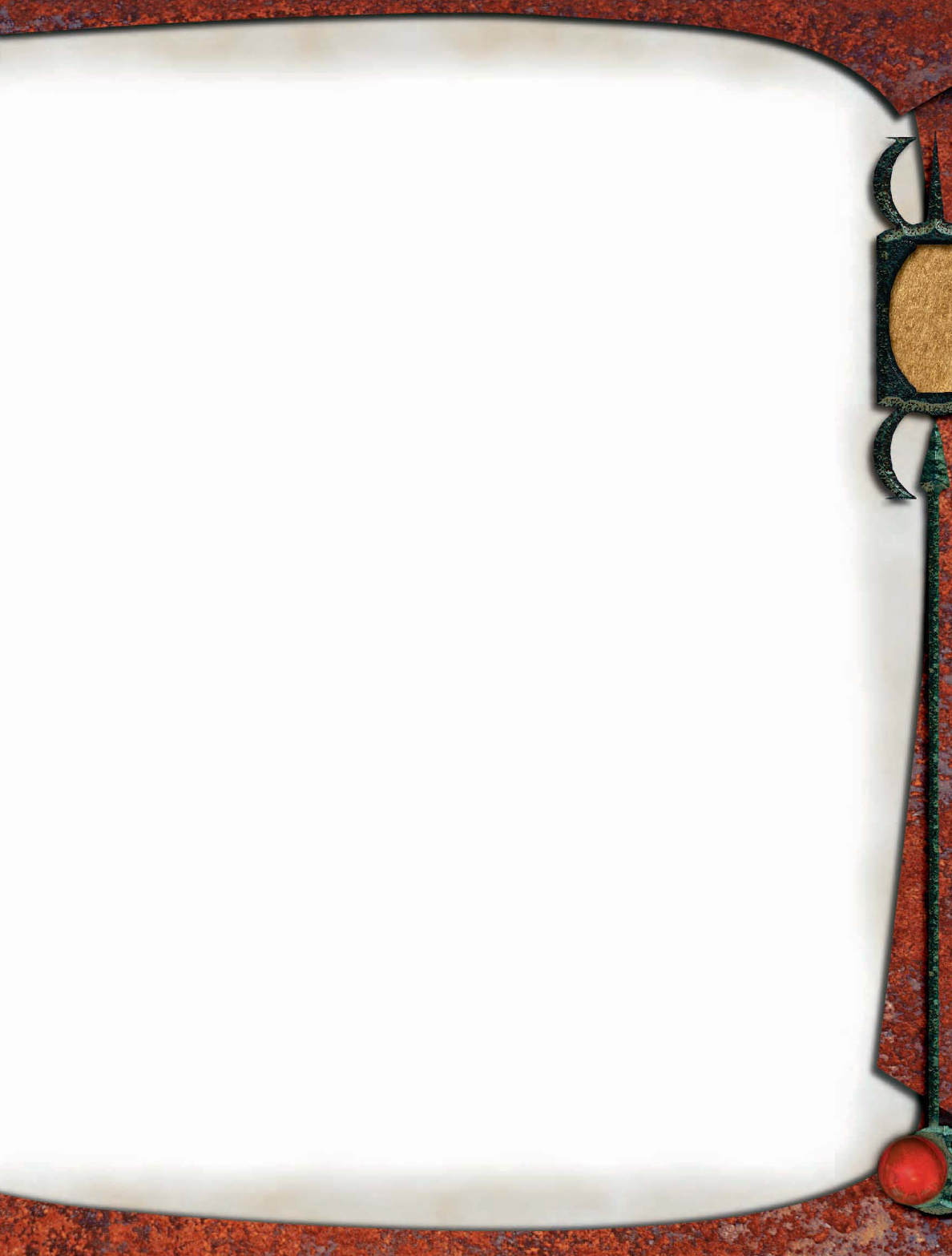
211
GLOSSARY
Fast Healing (Ex): A creature that has the fast healing
special quality regains hit points at an exceptionally fast
rate, usually 1 or more hit points per round. Except as noted
here, fast healing is like natural healing (PH 146). Fast heal-
ing does not restore hit points lost from starvation, thirst, or
suffocation, and it does not allow a creature to regrow lost
body parts. Unless otherwise stated, it does not allow lost
body parts to be reattached.
Favored Class: A monster that takes levels in a class
(or more than one class) has a favored class, just as player
characters do. In addition, a monster’s racial Hit Dice also
count as a favored class. If the monster becomes a multiclass
character, neither its favored class nor its racial Hit Dice
count when determining whether the creature takes an
experience point penalty.
Fear (Su or Sp): Fear attacks can have various effects. If
a fear effect allows a saving throw, it is a Will save (DC 10 +
1/2 fearsome creature’s racial HD + creature’s Cha modifi er).
All fear attacks are mind-affecting fear effects.
Fear Aura (Su): The use of this ability is a free action. The
aura can freeze an opponent or function like the fear spell,
among other effects. A fear aura is an area effect.
Fear Cones (Sp) and Rays (Su): These effects usually work
like the fear spell.
Fey Type: A fey is a creature that has supernatural abilities
and connections to nature or to some other force or place.
Fey are usually human-shaped.
Features: A fey has the following features.
—6-sided Hit Dice; good Refl ex and Will saves.
—Base attack bonus equal to 1/2 total Hit Dice (as wizard).
—Skill points equal to (6 + Int modifi er, minimum 1) per
Hit Die, with quadruple skill points for the fi rst Hit Die.
Traits: A fey possesses the following traits.
—Low-light vision.
—Profi cient with all simple weapons and any weapons
mentioned in its entry.
—Profi cient with whatever type of armor (light, medium,
or heavy) that it is described as wearing, as well as all lighter
types. Fey not indicated as wearing armor are not profi cient
with armor. Fey are profi cient with shields if they are profi -
cient with any form of armor.
—Fey eat, sleep, and breathe.
Fire Subtype: A creature that has the fi re subtype has
immunity to fi re. It has vulnerability to cold, which means
it takes half again as much (+50%) damage as normal from
cold, regardless of whether a saving throw is allowed, or if
the save is a success or failure.
Flight (Ex or Su): A creature that has this ability can
cease or resume flight as a free action. If the ability is
supernatural, it becomes ineffective in an antimagic fi eld,
and the creature loses its ability to fly for as long as the
antimagic effect persists.
Frightful Presence (Ex): This special attack makes a
creature’s presence unsettling to foes. It takes effect when
the creature performs some sort of dramatic action, such
as charging, attacking, or snarling. Opponents within
range who witness the action might become frightened
or shaken. The range is usually 30 feet, and the duration
is usually 5d6 rounds.
This ability affects only those opponents with fewer Hit
Dice or levels than the creature has. An affected opponent
can resist the effect with a successful Will save (DC 10 +
1/2 frightful creature’s racial HD + frightful creature’s
Cha modifier). An opponent that succeeds on the saving
throw is immune to that same creature’s frightful pres-
ence for 24 hours. Frightful presence is a mind-affecting
fear effect.
Gaze (Su): A gaze special attack takes effect when oppo-
nents look at the creature’s eyes. The attack can have almost
any sort of effect—petrifi cation, death, charm, and so on.
The typical range is 30 feet.
The type of saving throw for a gaze attack varies, but it is
usually a Will or Fortitude save (DC 10 + 1/2 gazing creature’s
racial HD + gazing creature’s Cha modifi er). A successful
saving throw negates the effect. A monster’s gaze attack is
described in abbreviated form in its description.
Gaze attacks can affect ethereal opponents. A creature
is immune to gaze attacks of others of its kind. Allies of a
creature that has a gaze attack might be affected. All the
creature’s allies are considered to be averting their eyes from
the creature that has the gaze attack (see below). The creature
also can veil its eyes, thus negating its gaze attack.
Passive Gaze Attack: Each opponent within range of a
gaze attack must attempt a saving throw each round at the
beginning of his or her turn in the initiative order. Only
looking directly at a creature that has a gaze attack leaves an
opponent vulnerable. Opponents can avoid the need to make
the saving throw by not looking at the creature, using one of
two methods.
Averting Eyes: The opponent avoids looking at the
creature’s face, instead looking at its body, watching its
shadow, tracking it in a reflective surface, and so on. Each
round, the opponent has a 50% chance to not need to make
a saving throw against the gaze attack. The creature that
has the gaze attack, however, gains concealment against
that opponent.
Closing Eyes: The opponent acts in a way so it cannot see
the creature that has the gaze attack at all—closing its eyes,
turning its back, or even wearing a blindfold. The creature
that has the gaze attack gains total concealment against such
an opponent.
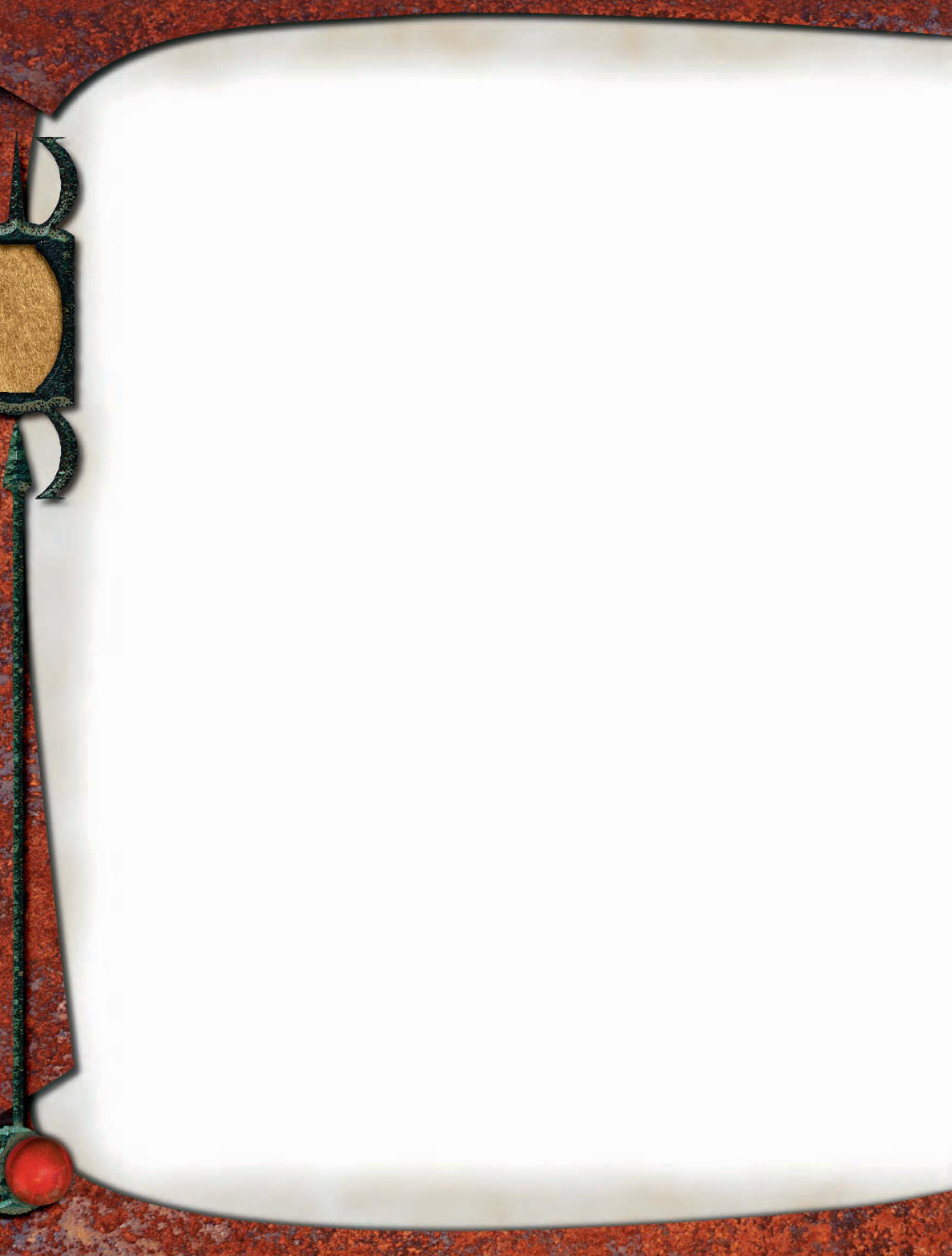
212
GLOSSARY
Active Gaze Attack: A creature that has a gaze attack can
actively gaze as a standard action by choosing a target within
range. That opponent must attempt a saving throw but can
try to avoid this as described above. Thus, it is possible for
an opponent to save against a creature’s gaze twice during
the same round, once before the opponent’s action and once
during the creature’s turn.
Giant Type: A giant is a humanoid-shaped creature of
great strength, usually of at least Large size.
Features: A giant has the following features.
—8-sided Hit Dice; good Fortitude saves.
—Base attack bonus equal to 3/4 total Hit Dice (as
cleric).
—Skill points equal to (2 + Int modifi er, minimum 1) per
Hit Die, with quadruple skill points for the fi rst Hit Die.
Traits: A giant possesses the following traits.
—Low-light vision.
—Profi cient with all simple and martial weapons, as well
as any natural weapons.
—Profi cient with whatever type of armor (light, medium
or heavy) it is described as wearing, as well as all lighter types.
Giants not described as wearing armor are not profi cient with
armor. Giants are profi cient with shields if they are profi cient
with any form of armor.
—Giants eat, sleep, and breathe.
Goblinoid Subtype: Goblinoids are stealthy humanoids
who live by hunting and raiding. They all speak Goblin.
Good Subtype: A subtype usually applied only to outsiders
native to the good-aligned Outer Planes. Most creatures that
have this subtype also have good alignments; however, if their
alignments change, they still retain the subtype. Any effect
that depends on alignment affects a creature that has this
subtype as if the creature has a good alignment, no matter
what its alignment actually is. The creature also suffers effects
according to its actual alignment. A creature that has the good
subtype has the aligned strike (good) ability. It overcomes
damage reduction as if its natural weapons and any weapons
it wields were good-aligned (see Damage Reduction).
Humanoid Type: A humanoid usually has two arms, two
legs, and one head, or a humanlike torso, arms, and a head.
Humanoids have few or no supernatural or extraordinary
abilities, but most can speak and usually have well-devel-
oped societies. They are usually Small or Medium. Every
humanoid creature also has a subtype, such as elf, goblinoid,
or reptilian.
Humanoids with 1 Hit Die exchange the features of their
humanoid Hit Die for the class features of a PC or NPC class.
Humanoids of this sort are presented as 1st-level warriors,
which means that they have average combat ability and poor
saving throws.
Humanoids with more than 1 Hit Die (for example, gnolls
and bugbears) are the only humanoids who make use of the
features of the humanoid type.
Features: A humanoid has the following features.
—8-sided Hit Dice, or by character class; good Refl ex saves
(usually; a humanoid’s good save varies).
—Base attack bonus equal to 3/4 total Hit Dice (as
cleric).
—Skill points equal to (2 + Int modifi er, minimum 1) per
Hit Die, with quadruple skill points for the fi rst Hit Die, or
by character class.
Traits: A humanoid possesses the following traits.
—Proficient with all simple weapons, or by character
class.
—Profi cient with whatever type of armor (light, medium,
or heavy) it is described as wearing, or by character class.
If a humanoid does not have a class and wears armor, it is
proficient with that type of armor and all lighter types.
Humanoids not indicated as wearing armor are not profi cient
with armor. Humanoids are profi cient with shields if they
are profi cient with any form of armor.
—Humanoids breathe, eat, and sleep.
Immunity: A creature that has immunity to an effect is
never harmed (or helped) by that effect. A creature cannot
suppress an immunity to receive a benefi cial effect.
Improved Grab (Ex): If a creature that has this special
attack hits with a melee weapon (usually a claw or bite
attack), it deals normal damage and attempts to start a
grapple as a free action without provoking attacks of
opportunity (see Grapple, PH 155). No initial touch attack
is required.
Unless otherwise noted, improved grab works only against
opponents at least one size category smaller than the creature.
The creature has the option to conduct the grapple normally,
or simply use the part of its body it used in the improved grab
to hold the opponent. If it chooses to do the latter, it takes a
–20 penalty on grapple checks, but is not considered grappled
itself; the creature does not lose its Dexterity bonus to AC,
still threatens an area, and can use its remaining attacks
against other opponents.
A successful hold does not deal any extra damage unless the
creature also has the constrict special attack. If the creature
does not constrict, each successful grapple check it makes
during successive rounds automatically deals the damage
indicated for the attack that established the hold. Otherwise,
it deals constriction damage as well (the amount is given in
the creature’s descriptive text).
When a creature gets a hold after an improved grab
attack, it pulls the opponent into its space. This act does
not provoke attacks of opportunity. It can even move (pos-
sibly carrying away the opponent), provided it can drag the
opponent’s weight.
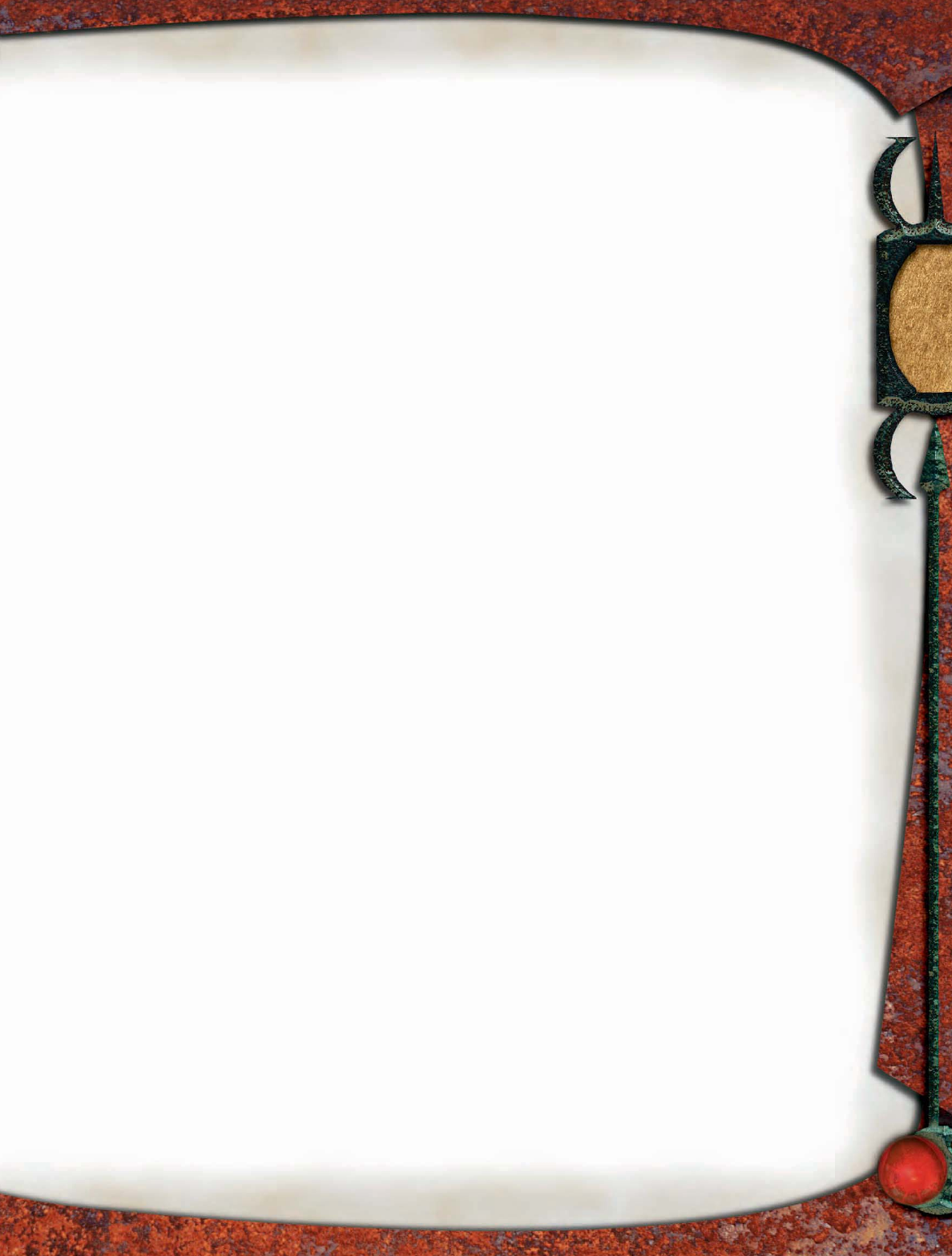
213
GLOSSARY
Incorporeal Subtype: Some creatures are incorporeal
by nature, and others (such as those that become ghosts)
can acquire the incorporeal subtype. An incorporeal crea-
ture has no physical body. It can be harmed only by other
incorporeal creatures, magic weapons or creatures that
strike as magic weapons, and spells, spell-like abilities, or
supernatural abilities. It is immune to all nonmagical attack
forms. Even when hit by spells (including touch spells) or
magic weapons, it has a 50% chance to ignore any damage
from a corporeal source (except for positive energy, negative
energy, force effects such as magic missile, or attacks made
with ghost touch weapons). Nondamaging effects affect
incorporeal creatures normally unless they require corpo-
real targets to function (such as implosion) or they create a
corporeal effect that incorporeal creatures would normally
be unaffected by (such as web or wall of stone). Although it
is not a magical attack, holy water can affect incorporeal
undead, but a hit with holy water has a 50% chance of not
affecting an incorporeal creature.
An incorporeal creature’s attacks pass through (ignore)
natural armor, armor, and shields, although deflection
bonuses and force effects (such as mage armor) work
normally against it. Nonmagical attacks made by an
incorporeal creature with a melee weapon have no effect
on corporeal targets, and any melee attack an incorporeal
creature makes with a magic weapon against a corporeal
target has a 50% miss chance, except for attacks it makes
with a ghost touch weapon, which are made normally (no
miss chance).
Equipment worn or carried by an incorporeal creature is
also incorporeal as long as that equipment remains in the
creature’s possession. An object the creature relinquishes
loses its incorporeal quality, and the creature loses the
ability to manipulate the object. If an incorporeal creature
uses a thrown weapon or a ranged weapon, that projectile
becomes corporeal as soon as it is fi red and can affect a
corporeal target normally (no miss chance). Magic items
possessed by an incorporeal creature work normally with
respect to their effects on the creature or on another target.
Similarly, spells cast by an incorporeal creature affect corpo-
real creatures normally.
An incorporeal creature has no natural armor bonus, but
it has a defl ection bonus to AC equal to its Charisma bonus
or +1, whichever is higher.
An incorporeal creature cannot pass through a force
effect. It can enter or pass through solid objects, but it
must remain adjacent to the object’s exterior. So it cannot
pass entirely through an object whose space is larger than
its own. It has an innate sense of direction, allowing it to
move at full speed even when it cannot see. Although an
incorporeal creature inside an object can sense the presence
of creatures or objects in a square adjacent to its current
location, such objects or creatures have total concealment
(50% miss chance) against its attacks as long as it remains
inside the object. To see farther from the object it is inside
and attack normally, the incorporeal creature must emerge.
While inside a solid object, an incorporeal creature receives a
+2 bonus on Listen checks. An incorporeal creature inside an
object has total cover, but when it attacks a creature outside
the object, it only has cover.
An incorporeal creature can pass through and operate in
water as easily as it does in air. It cannot fall or take falling
damage. It cannot make trip or grapple attacks, nor can it
be tripped or grappled. In fact, it cannot take any physical
action that moves or manipulates an opponent or that foe’s
equipment, nor is it subject to such actions.
An incorporeal creature moves silently and cannot be
heard with Listen checks if it doesn’t wish to be. Further,
it has no weight and cannot set off traps that are trig-
gered by weight. It has no Strength score, so its Dexterity
modifier applies to its melee attacks and its ranged attacks.
Nonvisual senses, such as scent and blindsight, are either
ineffective or only partly effective with regard to incor-
poreal creatures.
Lawful Subtype: A subtype usually applied only to outsid-
ers native to the lawful-aligned Outer Planes. Most creatures
that have this subtype also have lawful alignments; however,
if their alignments change, they still retain the subtype.
Any effect that depends on alignment affects a creature that
has this subtype as if the creature has a lawful alignment,
no matter what its alignment actually is. The creature also
suffers effects according to its actual alignment. A creature
that has the lawful subtype has the aligned strike (lawful)
ability. It overcomes damage reduction as if its natural
weapons and any weapons it wields were lawful-aligned (see
Damage Reduction).
Level Adjustment: Certain monsters can used as the basis
for interesting, viable player characters. These creatures have
a level adjustment entry, which is a number that is added
to the creature’s total Hit Dice to arrive at its effective
character level. A creature that has multiple special abilities
is more powerful as a player character than its Hit Dice
alone indicate. For example, a kuo-toa’s level adjustment +3
indicates that a 1st-level kuo-toa wizard is the equivalent
of a 3rd-level character.
Level adjustment is not the same as an adjustment to a
creature’s Challenge Rating because of some special quali-
ties it possesses. Challenge Rating refl ects how diffi cult
an opponent is to fi ght in a limited number of encounters.
Level adjustment shows how powerful a creature is as a
player character or cohort in campaign play. For instance,
a drow receives a +1 adjustment to its Challenge Rating
to account for its special abilities, indicating that it’s
tougher in a fight than its Hit Dice would suggest, but
its level adjustment is +2 to balance its abilities over long-
term play.
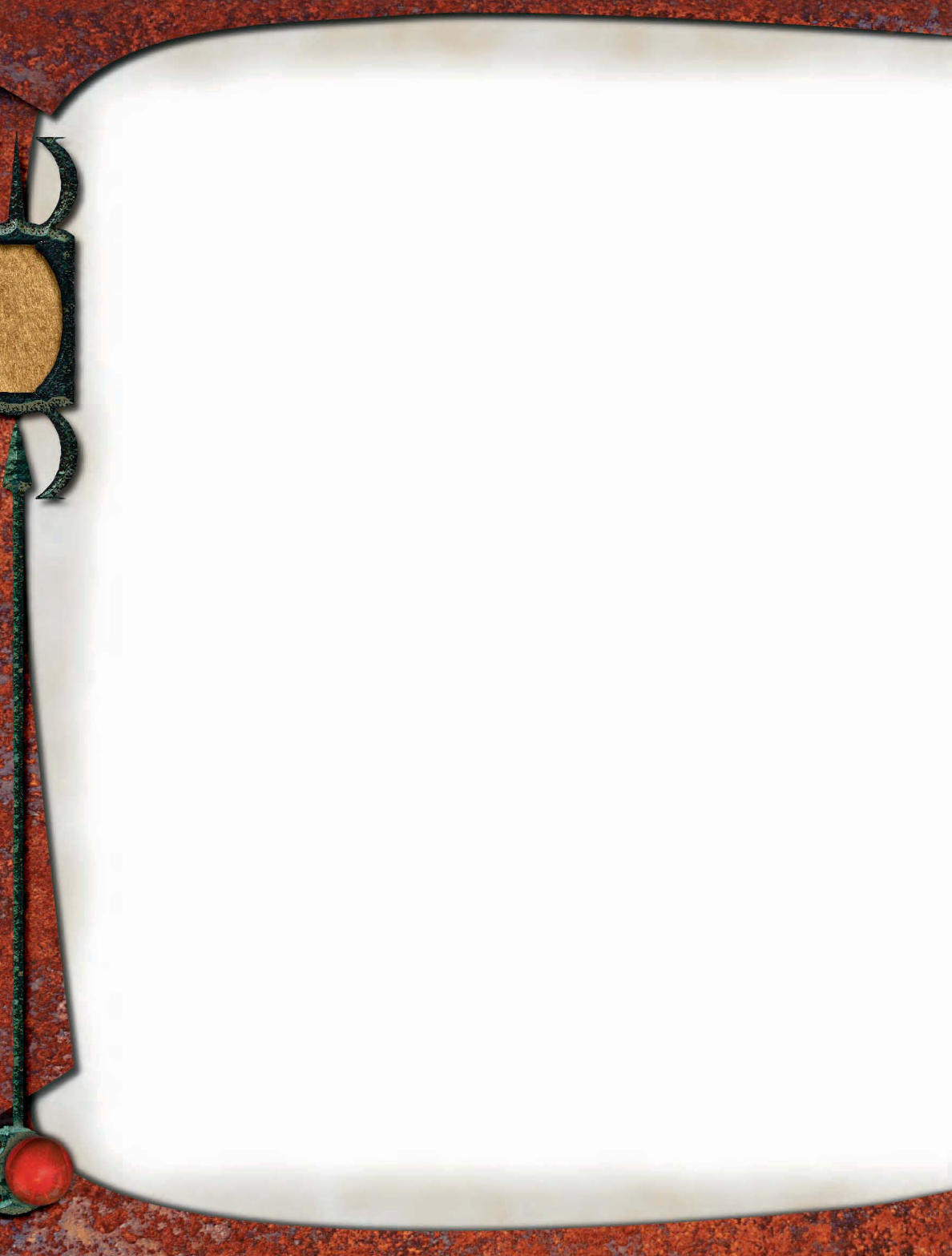
214
GLOSSARY
Living Construct Subtype: A living construct is a new
subtype of construct, a created being given sentience and free
will through powerful and complex creation magic. Living
constructs combine aspects of both constructs and living
creatures, as detailed below.
Features: A living construct derives its Hit Dice, base attack
bonus progression, saving throws, and skill points from the
class it selects.
Traits: A living construct possesses the following traits
(unless otherwise noted in a creature’s entry).
—Unlike other constructs, a living construct has a
Constitution score. A living construct does not gain bonus
hit points by size but gains (or loses) bonus hit points
through a Constitution bonus (or penalty) as with other
living creatures.
—Unlike other constructs, a living construct does not
have low-light vision or darkvision.
—Unlike other constructs, a living construct is not
immune to mind-affecting spells and abilities.
—Immunity to poison, sleep effects, paralysis, disease,
nausea, fatigue, exhaustion, and energy drain.
—A living construct cannot heal damage naturally.
—Unlike other constructs, living constructs are subject
to extra damage from critical hits, effects requiring a Forti-
tude save, death from massive damage, nonlethal damage,
stunning, ability damage, ability drain, and death effects or
necromancy effects.
—Unlike other constructs, a living construct can use the
run action.
—Living constructs can be affected by spells that target
living creatures as well as by those that target constructs.
Damage dealt to a living construct can be healed by a cure
light wounds spell or a repair light damage spell, for example,
and a living construct is vulnerable to a harm spell. However,
spells from the healing subschool provide only half effect to
a living construct.
—A living construct responds slightly differently from
other living creatures when reduced to 0 hit points. A living
construct that has 0 hit points is disabled, just as a living
creature is. He can take only a single move action or standard
action in each round, but strenuous activity does not risk
further injury. When his hit points are less than 0 and greater
than –10, a living construct is inert. He is unconscious and
helpless, and he cannot perform any actions. However, an
inert living construct does not lose additional hit points
unless more damage is dealt to him, as with a living creature
that is stable.
—Can be raised or resurrected.
—Does not need to eat, sleep, or breathe, but can still
benefi t from the effects of consumable spells and magic
items such as heroes’ feast and potions.
—Does not need to sleep, but must rest for 8 hours before
preparing spells.
Low-Light Vision (Ex): A creature that has low-light
vision can see twice as far as a human in starlight, moonlight,
torchlight, and similar conditions of shadowy illumination.
It retains the ability to distinguish color and detail under
these conditions.
Magical Beast Type: Magical beasts are similar to
animals but can have Intelligence scores higher than 2.
Magical beasts usually have supernatural or extraordinary
abilities, but sometimes are merely bizarre in appearance
or habits.
Features: A magical beast has the following features.
—10-sided Hit Dice; good Fortitude and Refl ex saves.
—Base attack bonus equal to total Hit Dice (as fi ghter).
—Skill points equal to (2 + Int modifi er, minimum 1) per
Hit Die, with quadruple skill points for the fi rst Hit Die.
Traits: A magical beast possesses the following traits.
—Darkvision out to 60 feet.
—Low-light vision.
—Profi cient with its natural weapons only.
—Profi cient with no armor.
—Magical beasts eat, sleep, and breathe.
Magic Strike (Su): Natural weapon attacks made by a
creature that has this ability are treated as magic for the
purpose of overcoming damage reduction. When it applies,
“magic strike” appears in the Atk Options line of a creature’s
statistics block.
Manufactured Weapons: Some monsters employ
manufactured weapons when they attack. In essence, a
manufactured weapon is any weapon that is not intrinsic
or natural to the creature, including “natural” items such as
rocks and logs. Creatures that use manufactured weapons
follow the same rules as characters, including those for
additional attacks from a high base attack bonus and two-
weapon fi ghting penalties.
Some creatures combine attacks with natural and manu-
factured weapons when they make a full attack. When they
do so, the manufactured weapon attack is considered the
primary attack unless the creature’s description indicates
otherwise, and any natural weapons the creature also uses
are considered secondary natural attacks. These secondary
attacks do not interfere with the primary attack as attacking
with an off-hand weapon does, but they take the usual –5
penalty (or –2 with the Multiattack feat) for such attacks,
even if the natural weapon used is normally the creature’s
primary natural weapon.
Monstrous Humanoid Type: Monstrous humanoids are
similar to humanoids, but with monstrous or animalistic
features. They often have magical abilities as well.
Features: A monstrous humanoid has the following
features.
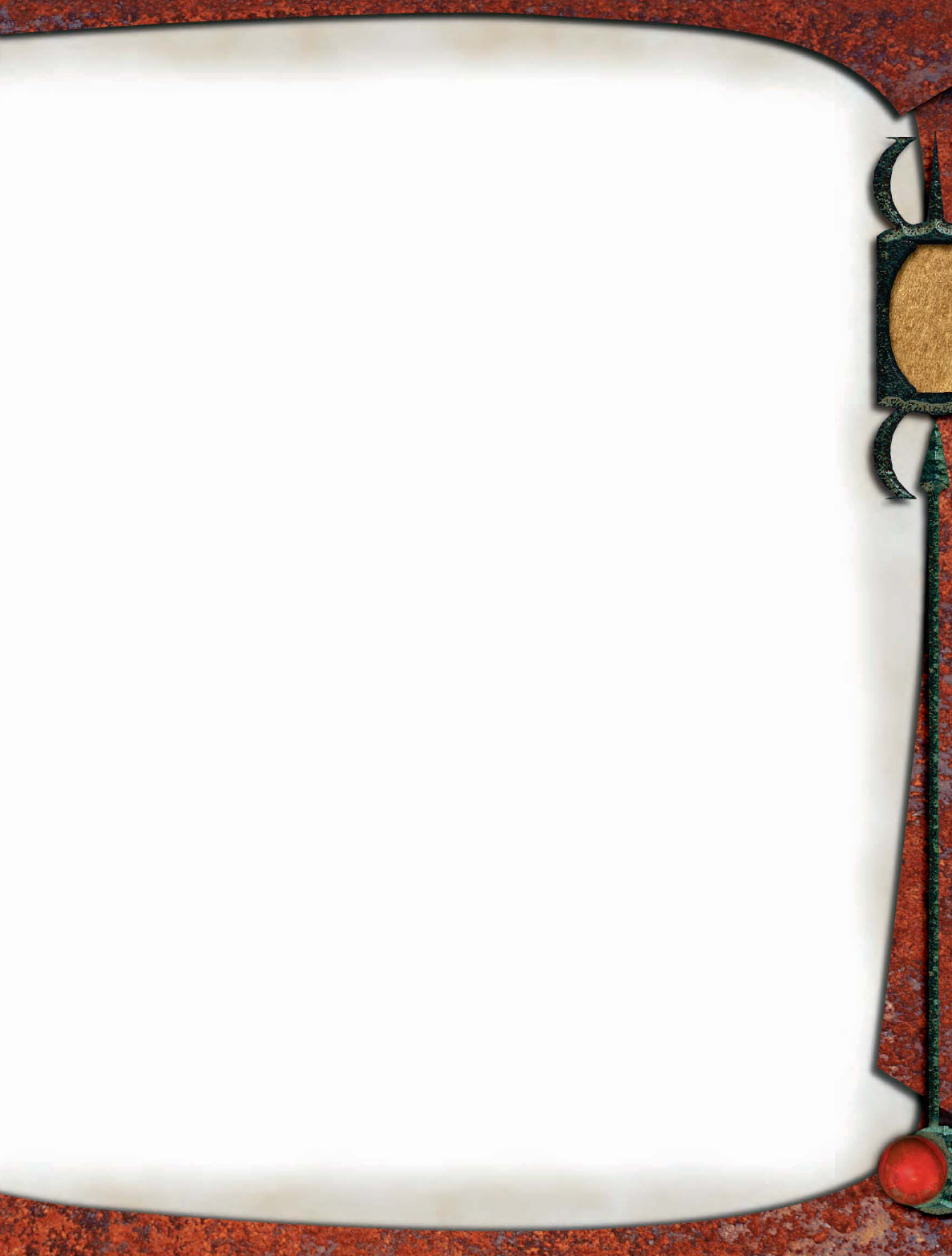
215
GLOSSARY
—8-sided Hit Dice; good Refl ex and Will saves.
—Base attack bonus equal to total Hit Dice (as fi ghter).
—Skill points equal to (2 + Int modifi er, minimum 1) per
Hit Die, with quadruple skill points for the fi rst Hit Die.
Traits: A monstrous humanoid possesses the following
traits.
—Darkvision out to 60 feet.
—Profi cient with all simple weapons and any weapons
mentioned in its entry.
—Profi cient with whatever type of armor (light, medium,
or heavy) it is described as wearing, as well as all lighter
types. Monstrous humanoids not indicated as wearing
armor are not profi cient with armor. Monstrous humanoids
are profi cient with shields if they are profi cient with any
form of armor.
—Monstrous humanoids eat, sleep, and breathe.
Movement Modes: Creatures can have modes of
movement other than walking and running. These are
natural, not magical, unless specifically noted in a mon-
ster description.
Burrow: A creature that has a burrow speed can tunnel
through dirt, but not through rock unless the descrip-
tive text says otherwise. Creatures cannot charge or run
while burrowing. Most burrowing creatures do not leave
behind tunnels other creatures can use, either because
the material they tunnel through fills in behind them
or because they do not actually dislocate any material
when burrowing.
Climb: A creature that has a climb speed has a +8 racial
bonus on Climb checks. The creature must make a Climb
check to climb any wall or slope with a DC of more than
0, but it can choose to take 10 (see Checks without Rolls,
PH 65), even if rushed or threatened when climbing. The
creature climbs at the given speed when climbing. If it
chooses an accelerated climb (see the Climb skill, PH 69), it
moves at double the given climb speed or its base land speed,
whichever is lower, and makes a single Climb check at a –5
penalty. Creatures cannot run when climbing. A creature
that has a climb speed retains its Dexterity bonus to Armor
Class (if any) when climbing, and opponents get no special
bonus on their attacks against it.
Fly: A creature that has a fl y speed can move through the
air at the indicated speed if carrying no more than a light
load; see Carrying Capacity, PH 161. Medium armor does not
necessarily constitute a medium load. All fl y speeds include
a parenthetical note indicating maneuverability (DMG 20),
as follows:
—Perfect: The creature can perform almost any aerial
maneuver it wishes. It moves through the air as well as a
human moves over smooth ground.
—Good: The creature is agile in the air (like a housefl y or
a hummingbird), but cannot change direction as readily as
those with perfect maneuverability.
—Average: The creature can fly as adroitly as a small
bird.
—Poor: The creature fl ies as well as a large bird.
—Clumsy: The creature can barely maneuver at all.
A creature that fl ies can make dive attacks. A dive attack
works like a charge, but the diving creature must move a
minimum of 30 feet and descend at least 10 feet. It can make
only claw or talon attacks, but these deal double damage. A
creature can use the run action when fl ying, provided it fl ies
in a straight line.
Swim: A creature that has a swim speed can move through
water at its swim speed without making Swim checks. It has
a +8 racial bonus on any Swim check to perform some special
action or avoid a hazard. The creature can choose to take
10 on a Swim check, even if distracted or endangered. The
creature can use the run action when swimming, provided
it swims in a straight line.
Native Subtype: Creatures that have this subtype are
outsiders native to the Material Plane. Such creatures have
mortal ancestors or a strong connection to the Material Plane,
and they can be raised, reincarnated, or resurrected just as
other living creatures can be.
Unlike true outsiders, native outsiders need to eat and
sleep.
Natural Weapons: Natural weapons are weapons that are
physically a part of a creature. A creature making a melee
attack with a natural weapon is considered armed and does
not provoke attacks of opportunity. Likewise, it threatens
any space it can reach.
Creatures do not receive additional attacks from a
high base attack bonus when using natural weapons. The
number of attacks a creature can make with its natural
weapons depends on the type of the attack—a creature can
make one bite attack, one attack per claw or tentacle, one
gore attack, one sting attack, or one slam attack (although
Large creatures that have arms or armlike limbs can make a
slam attack with each arm). Refer to the individual monster
descriptions.
Unless otherwise noted, a natural weapon threatens a
critical hit on a natural attack roll of 20.
When a creature has more than one natural weapon, one
of them (or sometimes a pair or set of them) is the primary
weapon. All the creature’s remaining natural weapons are
secondary.
The primary weapon is presented fi rst in the creature’s
Melee or Ranged entry. A creature’s primary natural weapon
is its most effective natural attack, and the creature uses its
full attack bonus with that weapon. Attacks with secondary
natural attacks are made with a –5 penalty on the attack roll,
no matter how many the creature has. (Creatures that have
the Multiattack feat take only a –2 penalty on secondary
attacks.) This penalty applies even when the creature makes
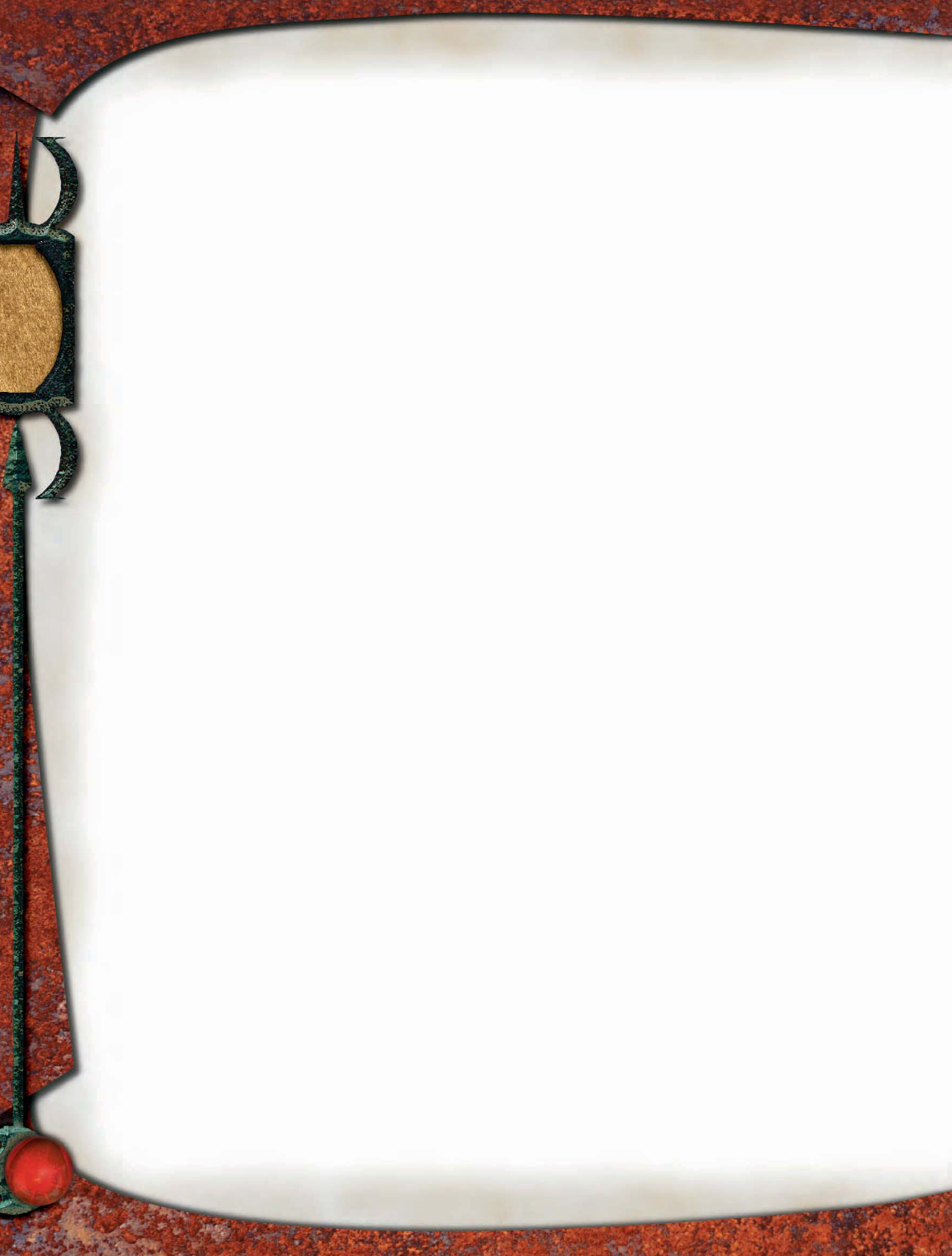
216
GLOSSARY
a single attack with the secondary attack as part of the attack
action or as an attack of opportunity. A creature applies half
of its Strength bonus (if any) to damage dealt by a secondary
attack, even when the secondary attack is used alone as a
single attack.
Natural weapons have types just as other weapons do. The
most common are summarized below.
Bite: The creature attacks with its mouth, dealing piercing,
slashing, and bludgeoning damage.
Claw or Talon: The creature rips with a sharp appendage,
dealing piercing and slashing damage.
Gore: The creature spears the opponent with an antler,
horn, or similar appendage, dealing piercing damage.
Slap or Slam: The creature batters opponents with an
appendage, dealing bludgeoning damage.
Sting: The creature stabs with a stinger, dealing piercing
damage. Sting attacks usually deal damage from poison in
addition to hit point damage.
Tentacle: The creature fl ails at opponents with a powerful
tentacle, dealing bludgeoning (and sometimes slashing)
damage.
Nonabilities: Some creatures lack certain ability scores.
These creatures do not have an ability score of 0—they lack
the ability altogether. The modifi er for a nonability is +0.
Other effects of nonabilities are detailed below.
Strength: Any creature that can physically manipulate
other objects has at least 1 point of Strength. A creature
that has no Strength score can’t exert force, usually because
it has no physical body or because it doesn’t move. The
creature automatically fails Strength checks. If the creature
can attack, it applies its Dexterity modifi er to its base attack
bonus instead of a Strength modifi er.
Dexterity: Any creature that can move has at least 1 point of
Dexterity. A creature that has no Dexterity score can’t move.
If it can perform actions (such as casting spells), it applies
its Intelligence modifi er to initiative checks instead of its
Dexterity modifi er. The creature automatically fails Refl ex
saves and Dexterity checks.
Constitution: Any living creature has at least 1 point
of Constitution. A creature that has no Constitution has
no body or no metabolism. It is immune to any effect
that requires a Fortitude save unless the effect works
on objects or is harmless. The creature is also immune
to ability damage, ability drain, and energy drain, and
automatically fails Constitution checks. A creature that
has no Constitution cannot tire and is thusly immune to
fatigue and exhaustion.
Intelligence: Any creature that can think, learn, or remem-
ber has at least 1 point of Intelligence. A creature that has
no Intelligence score is mindless, an automaton operating
on simple instincts or programmed instructions. Such a
creature is immune to mind-affecting spells and abilities
and automatically fails Intelligence checks.
Mindless creatures do not gain feats or skills, although
they can have bonus feats or racial skill bonuses.
Wisdom: Any creature that can perceive its environment
in any fashion has at least 1 point of Wisdom. Anything with
no Wisdom score is an object, not a creature. Only objects
have no Wisdom score, and an object that has no Wisdom
score also has no Charisma score.
Charisma: Any creature capable of telling the difference
between itself and other creatures and objects has at least
1 point of Charisma. Only objects have no Charisma
score, and an object that has no Charisma score also has
no Wisdom score.
Obyrith Subtype: A number of demons belong to the
primeval race of evil outsiders known as the obyriths.
Traits: An obyrith has the following traits.
—True Seeing (Su): An obyrith is under the constant
effect of true seeing, as the spell. This effect cannot be
dispelled.
—Telepathy.
—Fast Healing (Ex): All obyriths have fast healing in an
amount indicated in each creature’s entry.
—Immunity to poison and mind-affecting spells and
abilities.
—Resistance to acid 10, cold 10, electricity 10, and
fire 10.
—Form of Madness (Su): Obyriths are so noxious and
horrific that their presence produces madness. When an
obyrith comes within 60 feet of a creature, that creature
must succeed on a Will save (DC 10 + 1/2 the obyrith’s HD +
its Cha modifi er) or fall victim to a form of permanent insan-
ity as indicated in the specifi c obyrith’s description. The
insanity is permanent until cured by greater restoration, heal,
miracle, or wish. A creature that successfully saves cannot be
affected again by that same obyrith’s form for 24 hours, and
a creature that fails can only be affected once until cured.
Chaotic evil outsiders are immune to this ability. This is a
mind-affecting ability.
Ooze Type: An ooze is an amorphous or mutable creature,
usually mindless.
Features: An ooze has the following features.
—10-sided Hit Dice; no good saving throws.
—Base attack bonus equal to 3/4 total Hit Dice (as
cleric).
—Skill points equal to (2 + Int modifi er, minimum 1) per
Hit Die, with quadruple skill points for the fi rst Hit Die, if
the ooze has an Intelligence score. However, most oozes are
mindless and gain no skill points or feats.
Traits: An ooze possesses the following traits.
—Blind.
—Blindsight to a range indicated in the creature’s entry.
—Immunity to critical hits, paralysis, poison, sleep effects,
polymorph, and stunning.
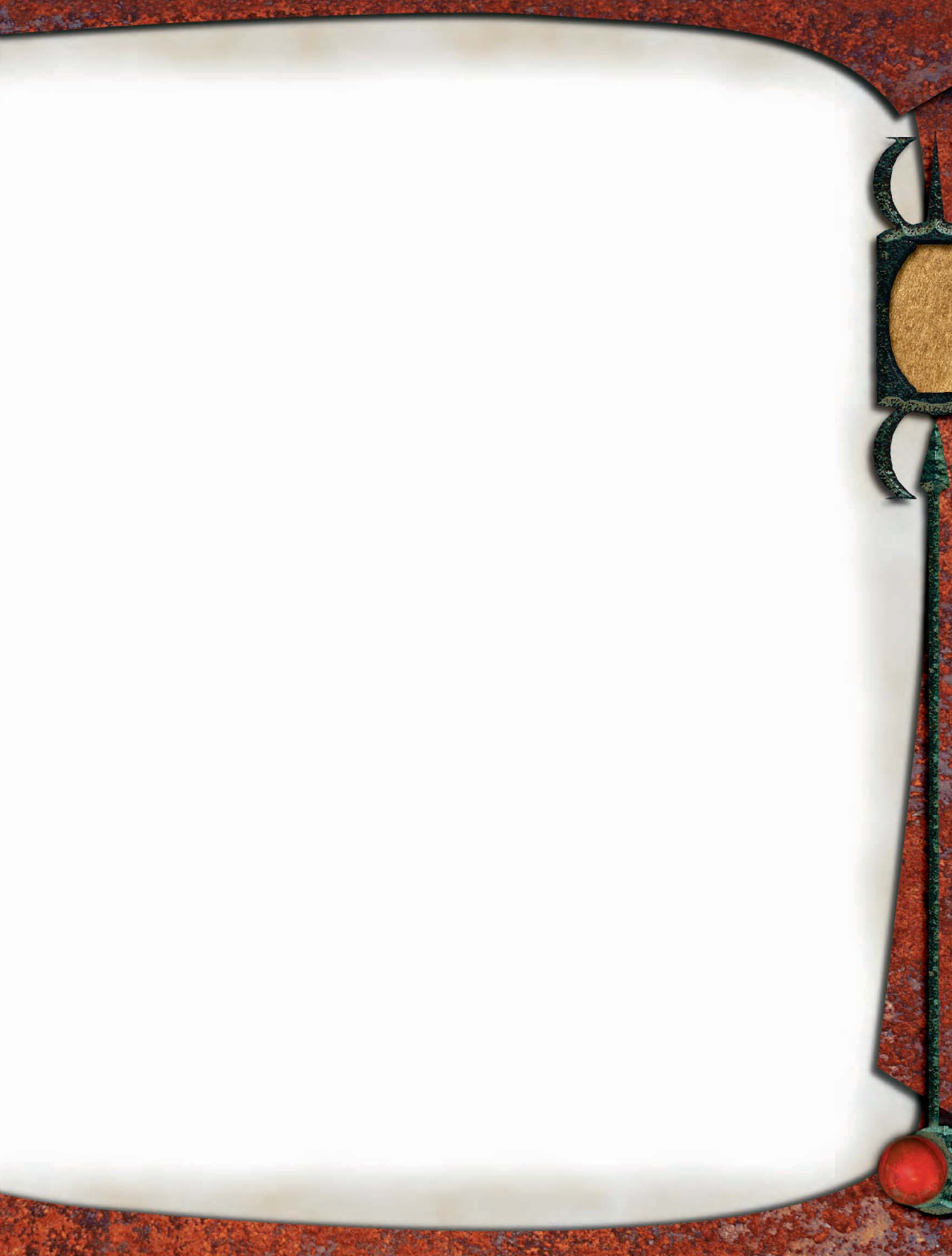
217
GLOSSARY
—Not subject to fl anking.
—Some oozes have the ability to deal acid damage to
objects. In such a case, the amount of damage is equal to
10 + 1/2 ooze’s HD + ooze’s Con modifier per full round
of contact.
—Profi cient with its natural weapons only.
—Profi cient with no armor.
—Mindless: Oozes have no Intelligence score, along with
the traits associated with that nonability.
—Oozes eat and breathe, but do not sleep.
Outsider Type: An outsider is a creature at least partially
composed of the essence of some plane other than the Mate-
rial Plane. Some creatures start out as with another type and
become outsiders when they attain a higher (or lower) state
of spiritual existence.
Features: An outsider has the following features.
—8-sided Hit Dice; good Fortitude, Refl ex, and Will
saves.
—Base attack bonus equal to total Hit Dice (as fi ghter).
—Skill points equal to (8 + Int modifi er, minimum 1) per
Hit Die, with quadruple skill points for the fi rst Hit Die.
Traits: An outsider possesses the following traits.
—Darkvision out to 60 feet.
—Unlike most other living creatures, an outsider’s soul
and body form one unit. When an outsider is slain, no soul
is set loose. Spells that restore souls to their bodies, such
as raise dead, reincarnate, and resurrection, don’t work on an
outsider. It takes a different magical effect, such as limited
wish, wish, miracle, or true resurrection to restore a slain
outsider to life. Outsiders that have the native subtype are
exceptions to this rule.
—Profi cient with all simple and martial weapons and any
weapons mentioned in its entry.
—Profi cient with whatever type of armor (light, medium,
or heavy) it is described as wearing, as well as all lighter types.
Outsiders not indicated as wearing armor are not profi cient
with armor. Outsiders are profi cient with shields if they are
profi cient with any form of armor.
—Outsiders breathe, but only native outsiders need to eat
and sleep.
Paralysis (Ex or Su): This special attack renders the
victim unable to take physical action. Paralyzed creatures
cannot move, speak, or take any physical actions. The
creature is rooted to the spot, frozen and helpless. Paralysis
works on the body, and a character can usually resist it with
a Fortitude saving throw (the DC is given in the creature’s
description). Unlike hold person and similar effects, a paraly-
sis effect does not allow a new save each round. A winged
creature fl ying in the air at the time that it is paralyzed
cannot fl ap its wings and falls. A swimmer can’t swim and
might drown.
Plant Type: This type comprises creatures composed of
vegetable matter that have Wisdom and Charisma scores.
Plants that lack Wisdom and Charisma scores are objects
even though they are alive.
Features: A plant creature has the following features.
—8-sided Hit Dice; good Fortitude saves.
—Base attack bonus equal to 3/4 total Hit Dice (as
cleric).
—Skill points equal to (2 + Int modifi er, minimum 1) per
Hit Die, with quadruple skill points for the fi rst Hit Die,
if the plant creature has an Intelligence score. However,
some plant creatures are mindless and gain no skill points
or feats.
Traits: A plant creature possesses the following traits.
—Low-light vision.
—Immunity to critical hits, mind-affecting spells and
abilities, paralysis, poison, polymorph, sleep effects, and
stunning.
—Profi cient with its natural weapons only.
—Profi cient with no armor.
—Plants breathe and eat, but do not sleep.
Poison (Ex): Poison attacks deal initial damage, such as
ability damage or some other effect, to the opponent on a
failed Fortitude save. Unless otherwise noted, another saving
throw is required 1 minute later, regardless of the fi rst save’s
result, to avoid secondary damage. A creature’s descriptive
text provides the details.
A creature that has a poison attack is immune to its own
poison and the poison of others of its kind.
The Fortitude save DC against a poison attack is equal to
10 + 1/2 poisoning creature’s racial HD + poisoning creature’s
Con modifi er. A successful save negates the damage.
Pounce (Ex): When a creature that has this special attack
charges, it can still make a full attack, including rake attacks
for creatures that have the rake ability.
Powerful Charge (Ex): When a creature that has
this special attack makes a charge, its attack deals extra
damage in addition to the normal benefits and hazards of
a charge.
Psionics (Sp): These are spell-like abilities that a creature
generates with the power of its mind. Psionic abilities are
usually usable at will.
Racial Hit Dice: These are Hit Dice a monster has by
virtue of what type of creature it is. Hit Dice gained from
taking class levels are not racial Hit Dice. For example, the
kuo-toa monitor described in this book is a 6 HD creature
because of its four levels of monk, but it has 2 racial Hit
Dice (the same number as a typical kuo-toa without any
class levels).
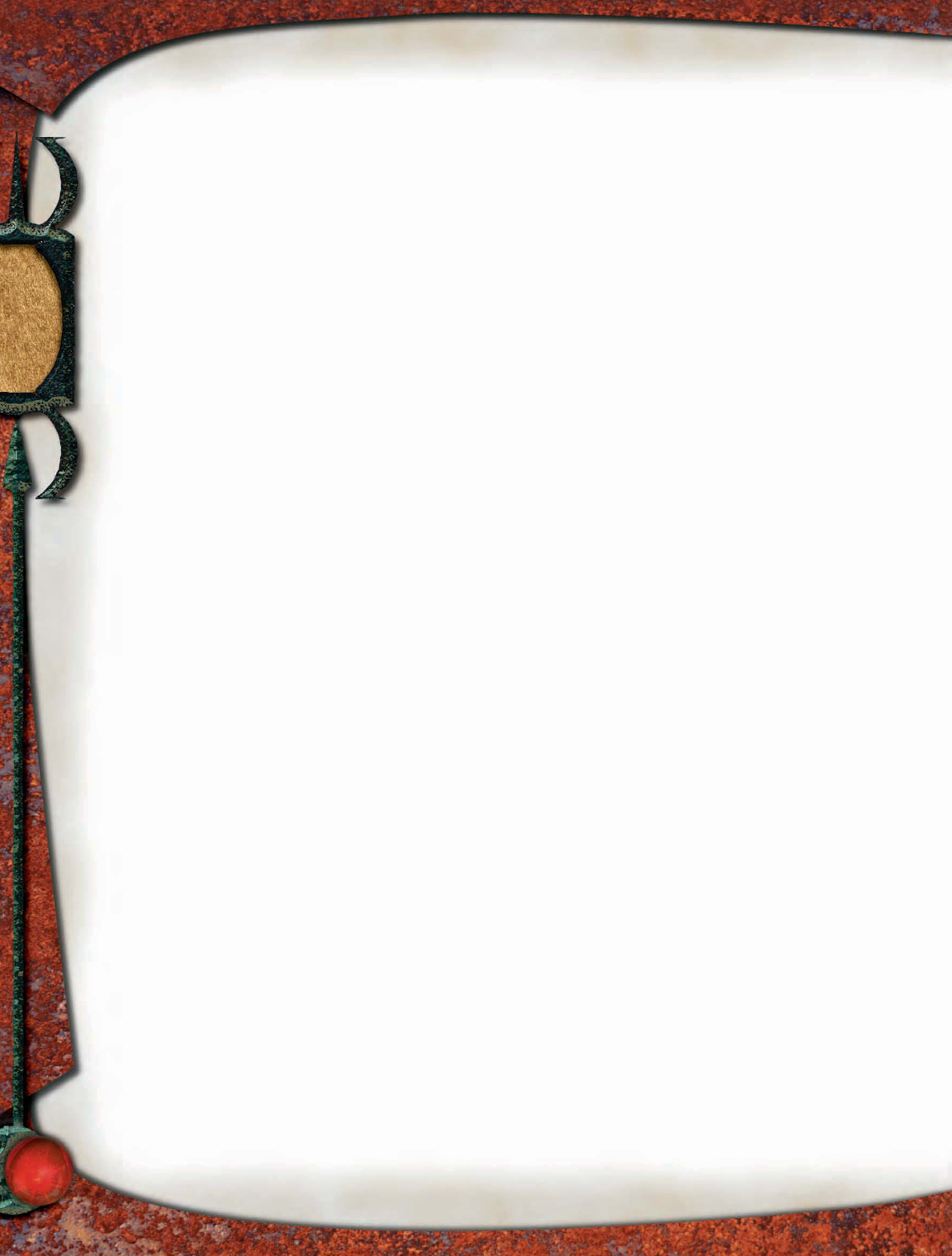
218
GLOSSARY
Rake (Ex): A creature that has this special attack gains
extra natural attacks when it grapples its foe. Normally, a
monster can attack with only one of its natural weapons
when grappling, but a creature that has the rake ability
usually gains two additional claw attacks that it can use
only against a grappled foe. Rake attacks are not subject to
the usual –4 penalty for attacking with a natural weapon
in a grapple.
A monster with the rake ability must begin its turn grap-
pling to use its rake—it can’t begin a grapple and rake in the
same turn.
Ray (Su or Sp): This form of special attack works like a
ranged attack (see Aiming a Spell, PH 175). Hitting with a
ray attack requires a successful ranged touch attack roll,
ignoring armor, natural armor, and shield and using the
creature’s ranged attack bonus. Ray attacks have no range
increment.
Regeneration (Ex): Damage dealt to creature that has
this ability is treated as nonlethal damage. The creature
heals nonlethal damage at a fixed rate per round, as given
in its entry—for example, a creature that has regenera-
tion 5 recovers 5 points of nonlethal damage per round.
Certain attack forms, typically fire and acid, deal a
regenerating creature lethal damage, which regeneration
can’t heal.
A regenerating creature that has been rendered uncon-
scious through nonlethal damage can be killed with a coup
de grace (PH 153). If the attack used to deliver a coup de grace
is of a type that regeneration converts to nonlethal damage,
the coup de grace fails to kill the regenerating creature.
Attack forms that don’t deal hit point damage ignore
regeneration. Regeneration does not restore hit points lost
from starvation, thirst, or suffocation.
Regenerating creatures can regrow lost portions of their
bodies and can reattach severed limbs or body parts. Severed
parts that are not reattached die and wither normally.
A creature must have a Constitution score to have the
regeneration ability.
Rend (Ex): If a creature that has this special attack hits with
the specifi ed natural attack, it latches onto the opponent’s
body and tears the fl esh. The rend attack deals damage equal
to that dealt by the creature’s natural attack + 1-1/2 times its
Str modifi er.
Reptilian Subtype: These creatures are scaly and usually
cold-blooded. The reptilian subtype is used only to describe
a set of humanoid races, not all animals and monsters that
are truly reptiles.
Resistance to Energy (Ex): A creature that has this
special quality ignores a specifi ed amount of damage of the
indicated type each time it takes damage of that type. The
entry indicates the amount and type of damage ignored. For
example, Dalmosh has resistance to fi re 10, so he ignores the
fi rst 10 points of fi re damage dealt to him anytime he takes
fi re damage.
Scent (Ex): This special quality allows a creature to detect
approaching enemies, sniff out hidden foes, and track by
sense of smell. Creatures that have the scent ability can
identify familiar odors just as humans do familiar sights.
The creature can detect opponents within 30 feet by
sense of smell. If the opponent is upwind, the range
increases to 60 feet; if downwind, it drops to 15 feet. Strong
scents, such as smoke or rotting garbage, can be detected
at twice those ranges. Overpowering scents, such as
skunk musk or troglodyte stench, can be detected at triple
normal range.
When a creature detects a scent, the exact location of
the source is not revealed—only its presence somewhere
within range. The creature can take a move action to note
the direction of the scent. Whenever the creature comes
within 5 feet of the source, the creature pinpoints that
source’s location.
A creature that has the Track feat and the scent ability can
follow tracks by smell, making a Wisdom or Survival check
to fi nd or follow a trail. The base DC for a fresh trail is 10,
no matter what kind of surface holds the scent. For each
hour that the trail is cold, the DC increases by 2. The ability
otherwise follows the rules for the Track feat, but creatures
tracking by scent ignore the effects of surface conditions and
poor visibility.
Size: The nine size categories, in ascending order, are Fine,
Diminutive, Tiny, Small, Medium, Large, Huge, Gargantuan,
and Colossal. A creature’s size provides a modifi er to its
Armor Class and attack bonus, a modifi er on grapple checks
it attempts, and a modifi er on Hide checks. The Creature
Sizes table provides a summary of the attributes that apply
to each size category.
Sonic Attacks (Su): Unless otherwise noted, a sonic
attack follows the rules for spreads (see Aiming a Spell, PH
175). The range of the spread is measured from the creature
using the sonic attack. Once a sonic attack has taken effect,
deafening the subject or stopping its ears does not end the
effect. Stopping one’s ears ahead of time allows opponents to
avoid having to make saving throws against mind-affecting
sonic attacks, but not other kinds of sonic attacks, such as
those that deal damage. Stopping one’s ears is a full-round
action and requires wax or other soundproof material to stuff
into the ears.
Spell-Like (Sp) Abilities: Spell-like abilities are magical
and work like spells, though they are not spells and so have no
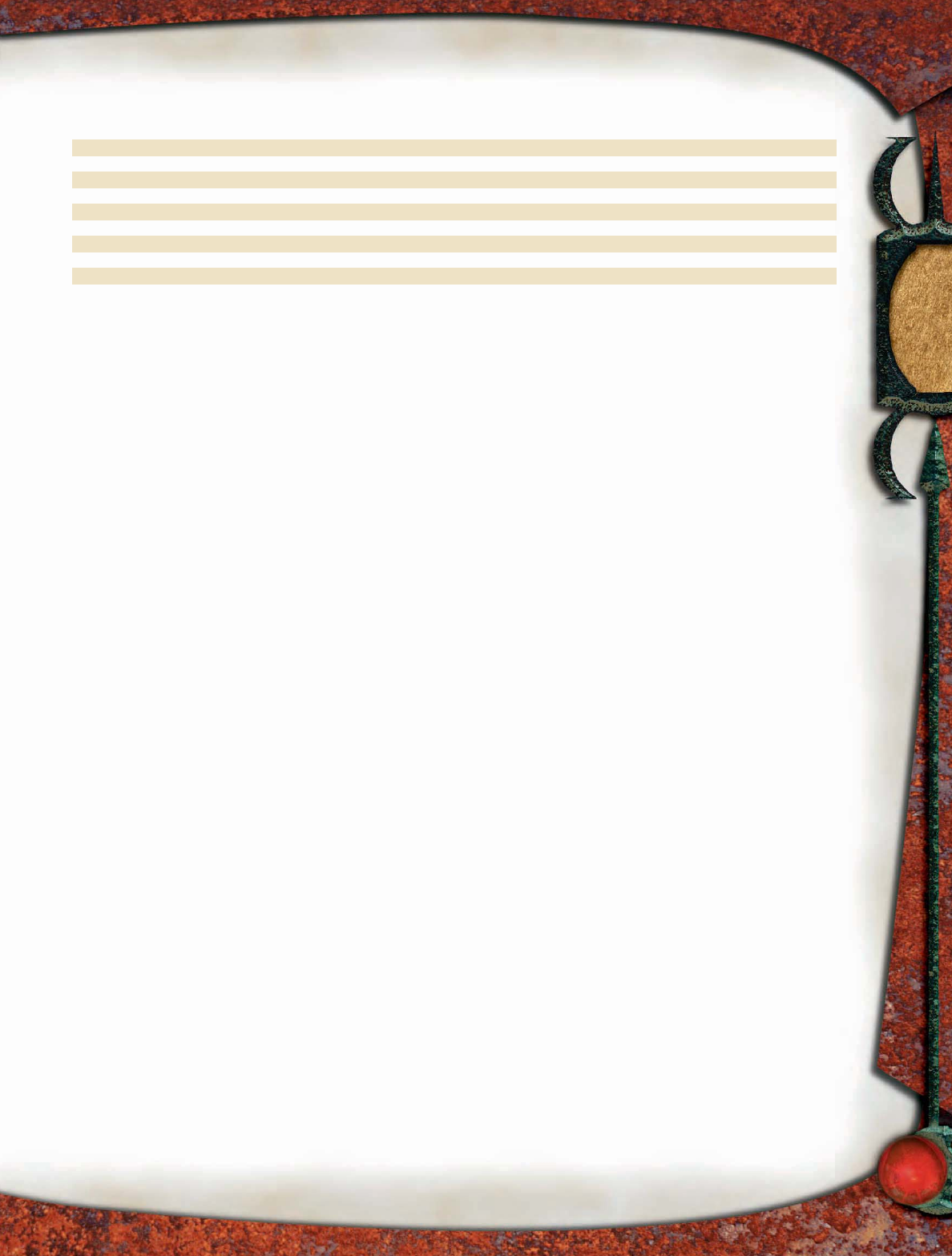
219
GLOSSARY
verbal, somatic, material, focus, or XP components. They go
away in an antimagic fi eld and are subject to spell resistance if
the spell the ability resembles or duplicates would be subject
to spell resistance.
A spell-like ability usually has a limit on how often it
can be used, but one that can be used at will has no such
limit. Using a spell-like ability is a standard action unless
noted otherwise, and doing so when threatened provokes
attacks of opportunity. It is possible to make a Concentra-
tion check to use a spell-like ability defensively and avoid
provoking attacks of opportunity, just as when casting a
spell. A spell-like ability can be disrupted just as a spell can
be. Spell-like abilities cannot be used to counterspell, nor
can they be counterspelled.
For creatures that have spell-like abilities, a designated
caster level defi nes how diffi cult it is to dispel their spell-like
effects and to defi ne any level-dependent variables (such as
range and duration) the abilities might have. The creature’s
caster level never affects which spell-like abilities the creature
has; sometimes the given caster level is lower than the level
a spellcasting character would need to cast the spell of the
same name. If no caster level is specifi ed, the caster level is
equal to the creature’s Hit Dice.
The saving throw (if any) against a spell-like ability is 10 +
the level of the spell the ability resembles or duplicates + the
creature’s Cha modifi er.
Some spell-like abilities duplicate spells that work dif-
ferently when cast by characters of different classes—for
example, true seeing. A monster’s spell-like abilities are
presumed to be the sorcerer/wizard versions. If the spell in
question is not a sorcerer/wizard spell, then default to cleric,
druid, bard, paladin, and ranger, in that order.
Spell Resistance (Ex): A creature that has spell resistance
can avoid the effects of spells and spell-like abilities that
directly affect it. To determine if a spell or spell-like ability
works against a creature that has spell resistance, the caster
must make a caster level check (1d20 + caster level). If the
result equals or exceeds the creature’s spell resistance, the
spell works normally, although the creature is still allowed
a saving throw.
Spells: Sometimes a creature can cast arcane or divine
spells just as a member of a spellcasting class can (and
can activate magic items accordingly). Such creatures are
subject to the same spellcasting rules that characters are,
except as follows.
A spellcasting creature that lacks hands or arms can provide
any somatic component a spell might require by moving its
body. Such a creature still needs material components for
its spells. The creature can cast the spell by either touch-
ing a required component that is not in another creature’s
possession or having the required component on its body.
Sometimes spellcasting creatures utilize the Eschew Materi-
als feat to avoid some material components.
A spellcasting creature is not actually a member of a
class unless its entry says so, and it does not gain any class
features. For example, a creature that casts arcane spells as a
sorcerer cannot acquire a familiar. A creature that has access
to cleric spells must prepare them in the normal manner
and receives domain spells if noted, but it does not receive
domain granted powers unless it has at least one level in
the cleric class.
Summon (Sp): A creature that has the summon ability
can summon specific other creatures of its kind, as if it
were casting a summon monster spell, but it usually has
only a limited chance of success. Roll d%. On a failure,
no creature answers the summons. Summoned creatures
return whence they came after 1 hour. A creature that has
just been summoned cannot use its own summon ability
for 1 hour.
Most creatures that have the ability to summon do not use
it lightly, since it leaves them beholden to the summoned
creature. In general, they use it only when necessary to save
their own lives.
An appropriate spell level is given for each summon-
ing ability for the purpose of resolving Concentration
checks and attempts to dispel the summoned creature.
Summoned monsters are part of the summoning creature’s
Challenge Rating and worth no experience points (see
DMG 37).
Creature Sizes
Size AC/Attack Grapple Hide Space Reach (Tall) Reach (Long)
Category Modifi er Modifi er Modifi er Dimension* Weight** (in squares) (in squares) (in squares)
Fine +8 –16 +16 6 in. or less 1/8 lb. or less 1/2 ft. (1/100) 0 ft. (0) —
Diminutive +4 –12 +12 6 in.–1 ft. 1/8 lb. – 1 lb. 1 ft. (1/25) 0 ft. (0) —
Tiny +2 –8 +8 1 ft.–2 ft. 1 – 8 lb. 2-1/2 ft. (1/4) 0 ft. (0) —
Small +1 –4 +4 2 ft.–4 ft. 8 – 60 lb. 5 ft. (1) 5 ft. (1) —
Medium +0 +0 +0 4 ft.–8 ft. 60 – 500 lb. 5 ft. (1) 5 ft. (1) 5 ft. (1)
Large –1 +4 –4 8 ft.–16 ft. 500 – 4,000 lb. 10 ft. (2 × 2) 10 ft. (2) 5 ft. (1)
Huge –2 +8 –8 16 ft.–32 ft. 2 – 16 tons 15 ft. (3 × 3) 15 ft. (3) 10 ft. (2)
Gargantuan –4 +12 –12 32 ft.–64 ft. 16 – 125 tons 20 ft. (4 × 4) 20 ft. (4) 15 ft. (3)
Colossal –8 +16 –16 64 ft. or more 125 tons or more 30 ft.+ (6 × 6+) 30 ft.+ (6+) 20 ft.+ (4+)
* Biped’s height, quadruped’s body length (nose to base of tail).
** Assumes that the creature is roughly as dense as a regular animal. A creature made of stone weighs considerably more.
A gaseous creature weighs much less.
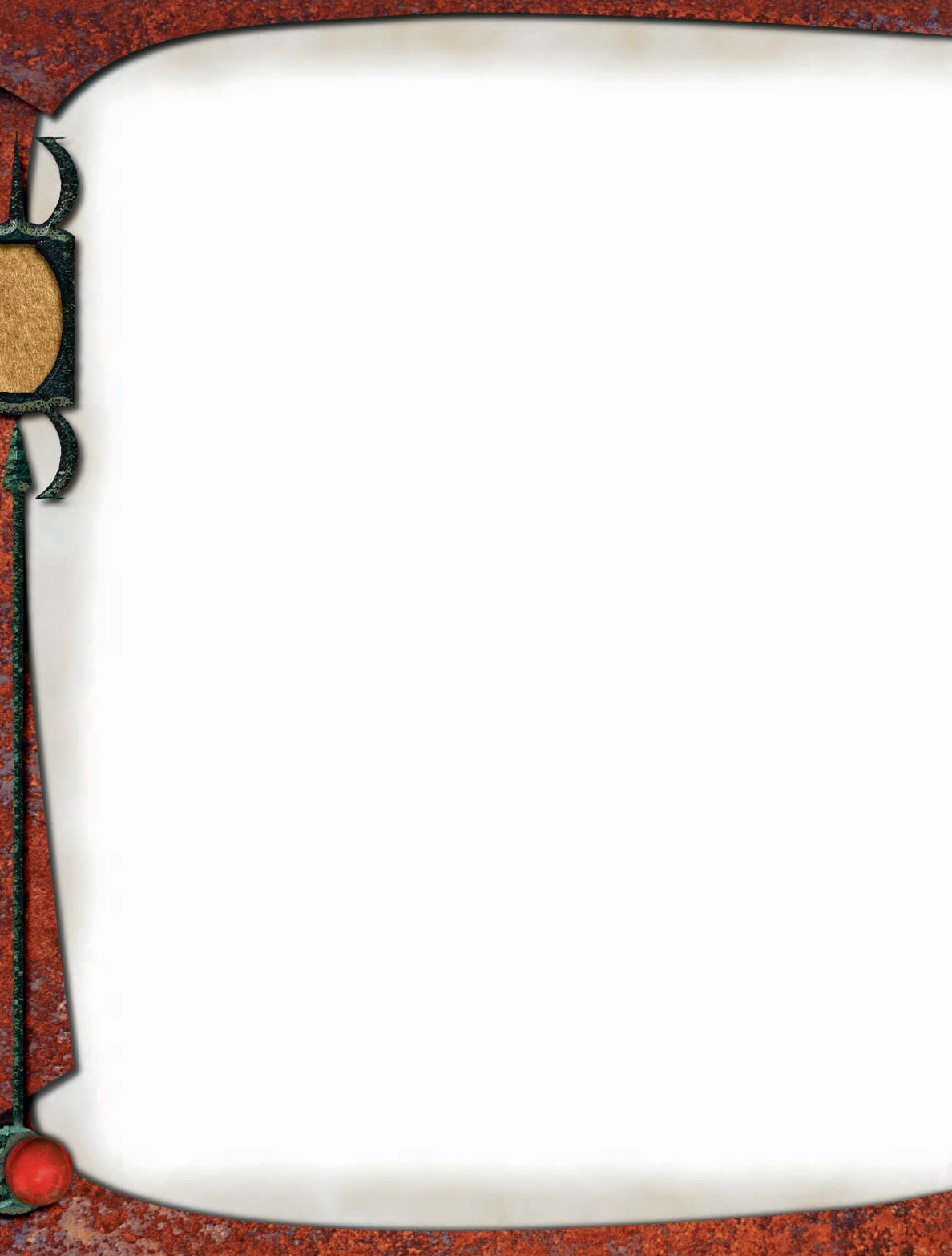
220
GLOSSARY
Supernatural (Su) Abilities: Supernatural abilities are
magical and go away in an antimagic fi eld, but they are not
subject to spell resistance. Supernatural abilities cannot be
dispelled. Using a supernatural ability is a standard action
unless noted otherwise. Supernatural abilities might have a
use limit or be usable at will, just like spell-like abilities.
However, supernatural abilities do not provoke attacks of
opportunity and never require Concentration checks. A
supernatural ability usually has an effective caster level equal
to the creature’s Hit Dice.
The saving throw DC for a supernatural ability is 10 + 1/2
the creature’s HD + the creature’s ability modifi er (usually
Charisma).
Swallow Whole (Ex): If a creature that has this special
attack begins its turn with an opponent held in its mouth, it
can attempt a new grapple check. If it succeeds, it swallows
that foe, dealing normal damage for a bite. The opponent
must usually be smaller than the swallowing creature.
Being swallowed has various consequences, depend-
ing on the creature doing the swallowing. A swallowed
opponent is considered to be grappled, but the creature
that did the swallowing is not. The swallowed opponent
can try to cut its way free with any light slashing or pierc-
ing weapon, or it can try to escape the grapple. Inside a
creature, its Armor Class is normally 10 + 1/2 its natural
armor bonus, with no modifiers for size or Dexterity. If
the swallowed opponent escapes the grapple, it ends up
back in the attacker’s mouth, where it can be bitten or
swallowed again.
Swarm Subtype: A swarm is a collection of Fine,
Diminutive, or Tiny creatures that acts as a single crea-
ture. A swarm has the characteristics of its type, except
as noted here. A swarm has a single pool of Hit Dice and
hit points, a single initiative modifier, a single speed, and
a single Armor Class. A swarm makes saving throws as a
single creature.
A single swarm occupies a square (if it is made up of
nonflying creatures) or a cube (of flying creatures) 10
feet on a side, but its reach is 0 feet, like its component
creatures. To attack, it moves into an opponent’s space,
which provokes attacks of opportunity. It can occupy the
same space as a creature of any size, since it crawls over or
flies around its prey. A swarm can move through squares
occupied by enemies, and vice versa, without impediment,
although the swarm provokes attacks of opportunity if it
does so. A swarm can move through cracks or holes large
enough for its component creatures.
A swarm of Tiny creatures consists of 300 nonflying
creatures or 1,000 flying creatures. A swarm of Diminu-
tive creatures consists of 1,500 nonflying creatures or
5,000 flying creatures. A swarm of Fine creatures consists
of 10,000 creatures, flying or not. Swarms of nonflying
creatures include many more creatures than could nor-
mally fit in a 10-foot square based on their normal space,
because creatures in a swarm are packed tightly together
and crawl over each other and their prey when moving
or attacking. Larger swarms are represented by multiples
of single swarms. The area occupied by a large swarm is
completely shapeable, though the swarm usually remains
in contiguous squares.
Traits: A swarm has no clear front or back and no dis-
cernible anatomy, so it is not subject to critical hits or
flanking. A swarm made up of Tiny creatures takes half
damage from slashing and piercing weapons. A swarm
composed of Fine or Diminutive creatures is immune to
all weapon damage.
Reducing a swarm to 0 hit points or lower causes it to
break up, though damage taken until that point does not
degrade its ability to attack or resist attack. Swarms are
never staggered or reduced to a dying state by damage.
Also, they cannot be tripped, grappled, or bull rushed,
and they cannot grapple.
A swarm is immune to any spell or effect that targets a
specifi c number of creatures, including single-target spells
such as disintegrate, with the exception of mind-affecting
spells and abilities if the swarm has an Intelligence score
and a hive mind. A swarm takes half again as much damage
(+50%) from area spells and area effects.
Swarms made up of Diminutive or Fine creatures are
susceptible to high winds such as that created by a gust
of wind spell. For the purpose of determining the effect
of wind on a swarm, treat the swarm as a creature of the
same size as its constituent creatures (see Winds, DMG
95). Wind effects deal 1d6 points of nonlethal damage to
a swarm per spell level—or Hit Dice of the originating
creature, in the case of effects such as an air elemental’s
whirlwind. A swarm rendered unconscious by means of
nonlethal damage becomes disorganized and dispersed,
and does not re-form until its hit points exceed its non-
lethal damage.
Swarm Attack: Creatures that have the swarm subtype
don’t make standard melee attacks. Instead, they deal
damage to any creature whose space they occupy at the
end of their move, with no attack roll needed. Swarm
attacks are not subject to a miss chance for concealment
or cover. A swarm’s statistics block has “swarm” in the
Melee entry, with no attack bonus given. The amount of
damage a swarm deals is based on its Hit Dice: 1–5 HD,
1d6; 6–10 HD, 2d6; 11–15 HD, 3d6; 16–20 HD, 4d6; and 21
HD or more, 5d6.
A swarm’s attacks are nonmagical, unless the swarm’s
description states otherwise. Damage reduction suffi cient
to reduce a swarm attack’s damage to 0, incorporeality, and
other special abilities usually give a creature immunity or
resistance to damage from a swarm. Swarms can have special
attacks in addition to swarm damage.
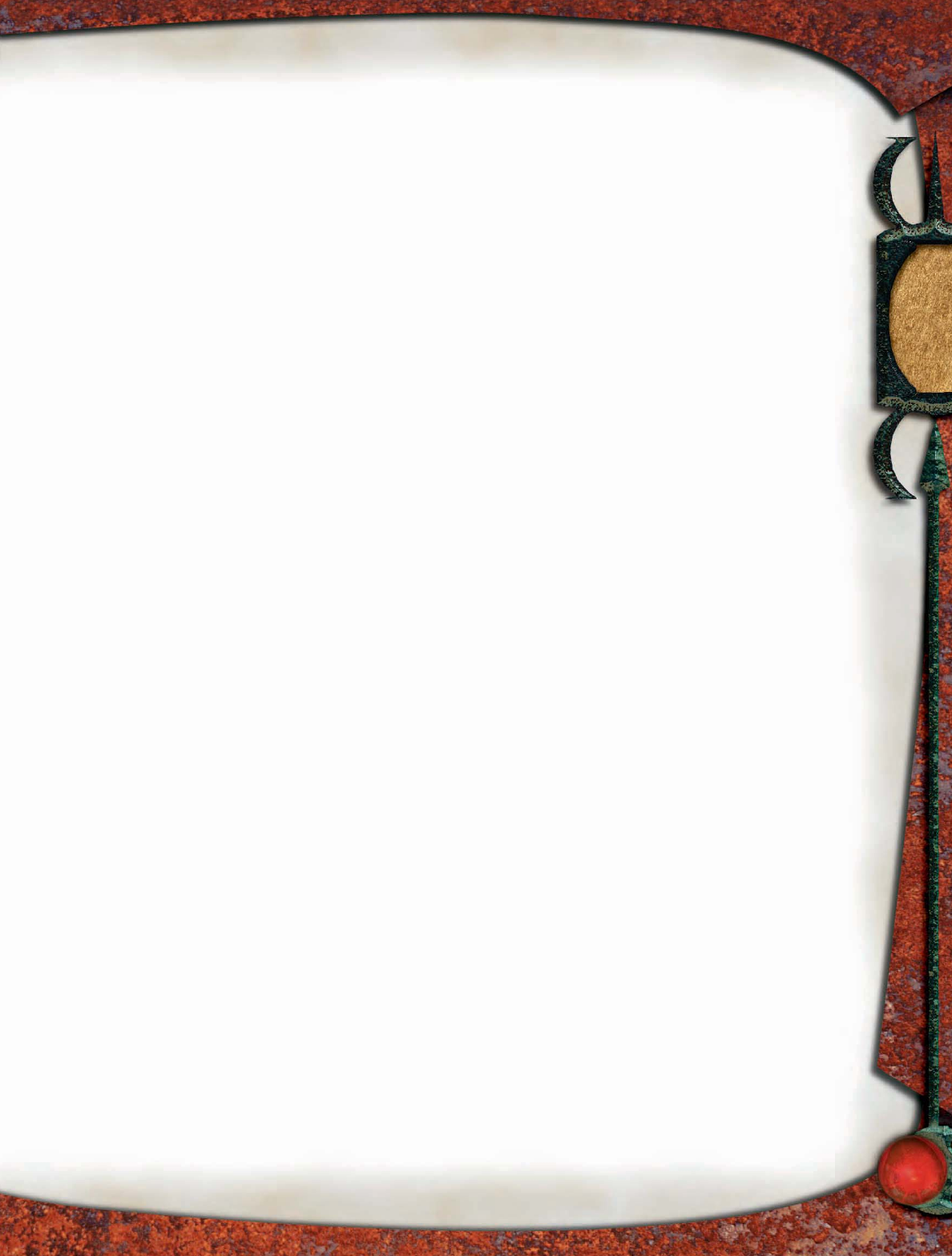
221
GLOSSARY
Swarms do not threaten creatures, and they do not
make attacks of opportunity with their swarm attack.
However, they distract foes whose squares they occupy,
as described below.
Distraction (Ex): Any living creature vulnerable to a
swarm’s damage that begins its turn with a swarm in
its square is nauseated for 1 round. A Fortitude save
(DC 10 + 1/2 swarm’s HD + swarm’s Con modifier) negates
the effect.
Spellcasting or concentrating on spells within the area
of a swarm requires a Concentration check (DC 20 + spell
level). Using skills that involve patience and concentration
requires a DC 20 Concentration check.
Tanar’ri Subtype: A large number of demons belong to
the race of evil outsiders known as the tanar’ri.
Traits: A tanar’ri possesses the following traits.
—Telepathy.
—Immunity to electricity and poison.
—Resistance to acid 10, cold 10, and fi re 10.
—Summon (Sp): Tanar’ri share the ability to summon
others of their kind.
Telepathy (Su): A creature that has this ability can com-
municate telepathically with any other creature within a
certain range (usually 100 feet) that has a language. It is
possible to address multiple creatures at once telepathi-
cally, although maintaining a telepathic conversation with
more than one creature at a time is just as difficult as
simultaneously speaking and listening to multiple people
at the same time.
Trample (Ex): As a full-round action, a creature that
has this special attack can move up to twice its speed and
literally run over any opponents at least one size category
smaller than itself. The creature merely has to move over
the opponents in its path; any creature whose space is
completely covered by the trampling creature’s space is
subject to the trample attack.
If a target’s space is larger than 5 feet, it is considered
trampled only if the trampling creature moves over all
the squares it occupies. If the trampling creature moves
over only some of a target’s space, the target can make an
attack of opportunity against the trampling creature at a
–4 penalty. A trampling creature that accidentally ends
its movement in an illegal space returns to the last legal
position it occupied, or the closest legal position, if there’s
a legal position that’s closer.
A trample attack deals bludgeoning damage (the creature’s
slam damage + 1-1/2 times its Str modifi er).
Trampled opponents can attempt attacks of opportunity,
but these take a –4 penalty. If they do not make attacks of
opportunity, trampled opponents can attempt Refl ex saves
to take half damage. The save DC against a creature’s trample
attack is 10 + 1/2 creature’s HD + creature’s Str modifi er
(the exact DC is given in the creature’s descriptive text). A
trampling creature can deal trampling damage to each target
only once per round, no matter how many times its movement
takes it over a target creature.
Tremorsense (Ex): A creature that has tremorsense is
sensitive to vibrations in the ground and can automatically
pinpoint the location of anything that is in contact with the
ground. Aquatic creatures that have tremorsense can also
sense the location of creatures moving through water.
Turn Resistance (Ex): A creature that has this special
quality (usually an undead) is less easily affected by clerics
or paladins (see Turn or Rebuke Undead, PH 159). When
resolving a turn, rebuke, command, or bolster attempt, add
the indicated number to the creature’s Hit Dice total. For
example, a forest haunt has 12 Hit Dice and +2 turn resis-
tance. Attempts to turn, rebuke, command, or bolster treat
the forest haunt as though it had 14 Hit Dice, though it is a
12 HD creature for any other purpose.
Typical Treasure: This entry in a monster description
describes how much wealth a creature owns. (See DMG 52–56
for details about treasure, particularly Tables 3–5 through
3–8.) Most monsters keep their treasure in their lairs, leav-
ing it behind if they travel. Intelligent creatures carry useful
portable treasure, such as magic items, with them.
Undead Type: Undead are once-living creatures animated
by spiritual or supernatural forces.
Features: An undead creature has the following features.
—12-sided Hit Dice; good Will saves.
—Base attack bonus equal to 1/2 total Hit Dice (as
wizard).
—Skill points equal to (4 + Int modifier, minimum 1)
per Hit Die, with quadruple skill points for the first Hit
Die, if the undead creature has an Intelligence score.
However, many undead are mindless and gain no skill
points or feats.
Traits: An undead creature possesses the following traits.
—Darkvision out to 60 feet.
—Cannot heal damage on its own if it has no Intelligence
score, although it can be healed. Negative energy (such as
an infl ict spell) can heal undead creatures. The fast healing
special quality works regardless of the creature’s Intel-
ligence score.
—Immunity to ability damage to its physical ability
scores, ability drain, critical hits, death effects, disease,
energy drain, exhaustion, fatigue, mind-affecting spells
and abilities, nonlethal damage, paralysis, poison, sleep
effects, and stunning.
—Immunity to any effect that requires a Fortitude save,
unless the effect also works on objects or is harmless.
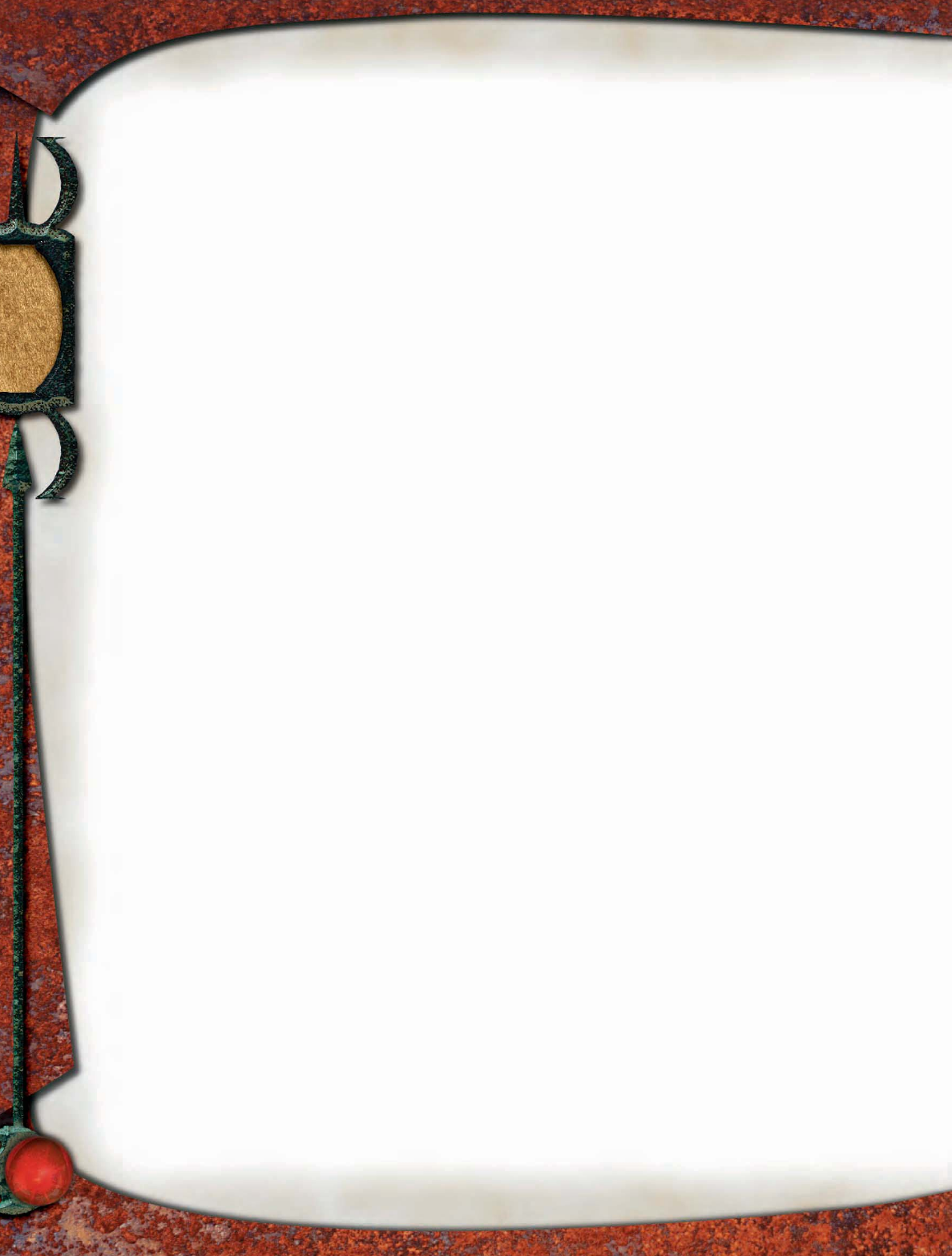
222
—Not at risk of death from massive damage (PH 145).
Immediately destroyed when reduced to 0 hit points
or fewer.
—Not affected by raise dead and reincarnate spells or
abilities. Resurrection and true resurrection can affect undead
creatures. These spells turn undead creatures back into the
living creatures they were before becoming undead.
—No Constitution score.
—Uses its Charisma modifi er for Concentration checks.
—Profi cient with its natural weapons, all simple weapons,
and any weapons mentioned in its entry.
—Profi cient with whatever type of armor (light, medium,
or heavy) it is described as wearing, as well as all lighter types.
Undead not indicated as wearing armor are not profi cient
with armor. Undead are profi cient with shields if they are
profi cient with any form of armor.
—Undead do not breathe, eat, or sleep.
Vermin Type: This type includes insects, arachnids, other
arthropods, worms, and similar invertebrates.
Features: Vermin have the following features.
—8-sided Hit Dice; good Fortitude saves.
—Base attack bonus equal to 3/4 total Hit Dice (as
cleric).
—Skill points equal to (2 + Int modifi er, minimum 1) per
Hit Die, with quadruple skill points for the fi rst Hit Die, if
the vermin has an Intelligence score. However, most vermin
are mindless and gain no skill points or feats.
Traits: Vermin possess the following traits.
—Darkvision out to 60 feet.
—Mindless: No Intelligence score, and immunity to all
mind-affecting spells and abilities.
—Profi cient with their natural weapons only.
—Profi cient with no armor.
—Vermin breathe, eat, and sleep.
Vulnerability to Energy: Some creatures have vulner-
ability to a certain type of energy. Such a creature takes half
again as much (+50%) damage as normal from effects that
employ that energy, regardless of whether a saving throw is
allowed, or if the save is a success or failure.
Water Subtype: This subtype usually is used for elemen-
tals and outsiders with a connection to the Elemental Plane
of Water. Creatures that have the water subtype have swim
speeds and can move in water without making Swim checks.
A water creature can breathe underwater and can usually
breathe air as well.
GLOSSARY
pqqqqqqqqqqqqqqqqqqqqrs
MONSTERS BY TYPE
(AND SUBTYPE)
Aberration: Ethereal defiler, madcrafter of Thoon, shadow
flayer, spirrax, Thoon disciple, Thoon elder brain, vivesector.
(Air): Ken-sun (elemental mage), ruin chanter.
(Aquatic): Kuo-toas (all).
(Baatezu): Gulthir devil, remmanon devil.
(Chaotic): Dalmosh, demons (all).
(Cold): Morlicantha,
Construct: Force golem, magmacore golem, merchurion,
scouring slinger, scouring stanchion, scyther of Thoon, shard-
soul slayer, slinger scorpion, stormcloud of Thoon, Thoon hulk,
Thoon soldier.
Dragon: Chorranathau, Morlicantha.
(Dragonblood): Greenspawn zealot.
(Earth): Ken-kuni (elemental mage), ruin chanter, ruin
elemental.
Elemental: Ruin elemental, spawn of Juiblex (all).
(Evil): Dalmosh, demons (all), devils (all), ember guard,
Illurien.
(Extraplanar): Arcadian avenger, Dalmosh, demons (all),
demon thorn mandrake, devils (all), ember guard, ethereal
defiler, garngrath, Illurien, siege beetle, spawn of Juiblex (all),
spirrax, steelwing.
Fey: Banshrae, frostwind virago, jaebrin, master of the hunt,
ruin chanter, shaedling.
(Fire): Ember guard, ken-li (elemental mage).
Giant: Bladerager troll, elemental magi (all).
(Goblinoid): Hobgoblins (all).
(Good): Arcadian avenger.
Humanoid: Hobgoblin duskblade, Nozgûg (god-blooded
orc), Singh the Immense.
(Incorporeal): Haunts (all).
(Lawful): Arcadian avenger, devils (all), ember guard.
(Living Construct): Merchurion.
Magical Beast: Deadborn vulture, garngrath, gem scarab,
guulvorg, hound of the hunt, malastor, mockery bugs (all),
rylkars (all), steelwing, Thrym hound, tirbanas (all), tusk
terror.
Monstrous Humanoid: Greenspawn zealot, hobgoblin spell-
scourge, hobgoblin warcaster, hobgoblin warsoul, kuo-toas
(all), Thoon infiltrator, Thoon thrall, ushemoi (all).
(Obyrith): Draudnu demon.
Ooze: Graveyard sludge.
(Orc): Nozgûg (god-blooded orc).
Outsider: Arcadian avenger, Dalmosh, demons (all), devils
(all), ember guard, Illurien.
Plant: Burrow root, demonthorn mandrake, fetid fungus,
verdant reaver, vinespawn.
(Swarm): Rylkspawn swarm (rylkar).
(Tanar’ri): Adaru demon, gadacro demon, solamith demon.
Undead: Blackwing, bonespur, bridge haunt, forest haunt,
Kugan (phantom ghast), sanguineous drinker, serpentir, skull
lord, spectral rider, taunting haunt, vampires (all), deadborn
vulture zombie.
Vermin: Siege beetle.
(Water): Spawn of Juiblex (all).
pqqqqqqqqqqqqqqqqqqqqrs
